Drawing On The Conflict Perspective, Sociologist Howard Waitzkin Suggests That ________.
The post Stress Management Techniques to Reduce Stress at Work appeared first on Foundr.
]]>Of course, some of the factors listed above are what can make the entrepreneurial life so appealing. It's a thrilling rocket ship ride that pits your tenacity and creativity against a range of unforeseen challenges. When times are tough, the burden falls directly onto your shoulders. And when your business triumphs, there are few things in life that bring so much satisfaction.
That's the double-edged sword of entrepreneurship. The highs are incomparably high, while the lows can be brutal.
Learning stress management techniques is essential if you are going to maintain health and wellness throughout your ever-changing career. Consider these startling statistics:
- 72% of entrepreneurs face mental health challenges
- Entrepreneurs experience depression twice as often as the general population
- Entrepreneurs are 3 times as likely to struggle with addictions
These statistics shouldn't steer you away from entrepreneurship, but should instead reinforce the importance of knowing how to deal with stress at work. With the right stress management skills, you'll be able to navigate the inevitable lows of your career, setting you up for a happier and healthier life.
Understanding the Unique Challenges of Entrepreneurship
The mental health aspects of entrepreneurship have been ignored for too long. This is partly because it's been viewed as much as a "sufferfest" as a career path. Proponents of this martyr-like approach throw around damaging mottos such as "sleep is for losers" and "rise and grind." They foolishly proclaim that if you're not beating yourself up, you're not going to be able to beat the competition down.
Furthermore, there's an insidious trend that suggests successful entrepreneurs also must sacrifice their relationships. Thus, business owners stop seeing their friends and become strangers even to their own families. Marooned on their entrepreneurial islands, the proponents of the sufferfest mentality will tell you that these business owners can now finally get down to business.
Don't buy into this rubbish.
Yes, running a business requires sacrifices. You won't be able to go golfing with your friends nearly as often as you'd like. You'll definitely miss some of your family member's events, such as dance recitals and soccer games. Meals will be skipped. There will be plenty of late nights where sleep becomes an afterthought as you struggle to fit all your obligations into a 24-hour period.
But there is NO reason that pursuing your entrepreneurial dreams should come at the expense of your health and happiness. Your wellbeing still matters, as do your relationships with others.
Remember, this isn't an exclusionary dilemma where everything else must go for the business to thrive. That's merely a "bro culture" rally cry embodied by icons who work 120 hours a week and sleep at the office. For people like this, personal relationships and health are placed upon the altar of success like some offering to an all-consuming deity of entrepreneurship.
But there's a major flaw in this approach: depriving yourself isn't a sustainable path. You can't make good business decisions when your brain is operating on 30 minutes of sleep a night. You can't conjure up brilliant ideas when you haven't laughed in several months. You can't form meaningful business partnerships when you're toiling in your entrepreneurial dungeon. And, ironically, you can't even enjoy your successes when you're beaten down to a zombie-like state.
Your wellbeing can actually be your entrepreneurial superpower. When you take the time to recharge your batteries, the obvious result will be more energy for crunch time. When you take time to enjoy life, you'll be able to stay connected to the purpose that compelled you to take the entrepreneurial path in the first place.
The tragedy that's played out again and again is that entrepreneurs lose sight of their purpose and become addicted to their obligations. It's a rotten way to live. And, as mentioned earlier, it's unsustainable.
As humans, we're just as conditioned for joy as we are for enduring difficulties. So we can't just shut down an entire side of our lives and expect things to go smoothly.
Your journey as an entrepreneur will involve copious amounts of stress. As you learn stress management techniques, you'll be able to ride out the toughest times without succumbing to them. And you'll be able to stay closer to your personal wellness and relationships, leading to a more fulfilled life.
We are going to say this one more time to ensure there is no confusion: Your business is at its best when you are at your best. So you've got to take time for self-care.
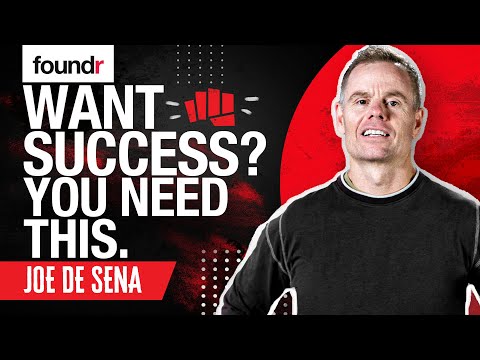
Approach Entrepreneurship Like a Gymnast
There are many ways that gymnastics and running a startup business are similar. Case in point, did you know that Simone Biles makes about $5 million a year with her various business endeavors and sponsorships? In many ways, she represents the nexus between the 2 pursuits.
For starters, gymnasts must master the art of balance. It doesn't matter if their specialty is vault, uneven bars, or pommel horse, a gymnast must anticipate and adjust to the various forces operating against them. Balance is non-negotiable in gymnastics, as poor performance and injury are the inevitable outcomes when it's lacking.
Another way that these 2 pursuits are similar is that gymnasts don't just train for the specific functions of their event. For example, a gymnast who competes on the uneven bars will only spend a portion of their training on the bars. The rest of their time is spent working on their flexibility, coordination, agility, endurance, and power.
In order to achieve balance in your life and succeed at managing stress at work, you can't just focus on your professional pursuits. If writers only work on writing, designers only work on designing, and inventors only work on inventions, they'll find themselves trapped in a box of their own design.
By preparing a wide range of tactics to help you prevent and reduce stress at work, you'll be able to improve your own flexibility, coordination, agility, endurance, and power. Most importantly, you'll be able to balance all the competing demands that cry out for your time and attention.
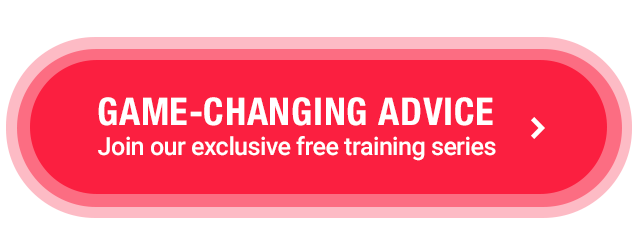
9 Tips for Reducing Stress at Work
We're now going to provide you with a variety of tools for managing stress at work and improving your overall wellness. Many of these suggestions are basic and will be easy to implement in your life. Others will require a bit more effort.
But all these suggestions can likely help you to some degree. A good approach would be to choose the most relevant 3 and start working on them immediately. As those tactics become part of your routine, you can move on to additional stress management skills.
Your tandem goals are to proactively do the right things to prevent stress from building up to an unhealthy level, while also having actionable solutions for the times when it does reach a tipping point. Because we all know that even the savviest entrepreneur can't fend off stress all the time.
With no further ado, here are 9 tips for managing your stress:
1. Be Okay With the Word "No"
There are plenty of things in our business lives we have no control over. A few things that come to mind are interest rates, supply chain issues, and the actions of your competitors.
But there are also many elements that you can regulate. And this control often starts by saying "no" to something that isn't essential. For example, let's say a business partner asks you to assist with a big event she is planning. You're in the middle of a particularly busy stretch of work, but also want to strengthen your partnership. In order to protect your health and performance, you might need to politely decline the request.
The same situation often arises with freelancers who have no control over the flow of projects they receive from clients. If you're a freelance designer and 4 clients reach out within a 48-hour period with projects, you might need to override your inherent desire to accept all quality projects and ultimately pass on a couple of them. It might be painful to do so, but it's a lot less painful than having a breakdown a week later due to the strain brought on by the unmanageable workload.
2. Don't Let Perfectionism Lead You Into Trouble
We sometimes fall into the trap of viewing work quality as either the Just Do It (JDI) level of mediocrity or the premium level where you're able to finesse the details and deliver a work of art. But quality is a spectrum, and it's often the right decision to avoid the quest for perfection and instead be satisfied by a solid performance that lands somewhere between the middle point and the crest of perfection.
Yes, there will be projects that require you to spend immense amounts of time until you can deliver with precision. Don't let them become the norm. Save your energy for these crucial moments (as dictated by the 80/20 rule) and then reasonably allocate your remaining time to solid performances that completely make the grade while not aspiring for perfection.
3. Don't Let Tradition Lead You Into Trouble
This tip shares a lot of DNA with the discussion on perfection. You probably have all kinds of processes established for the way you do business.
It's great to have routines and processes, but don't let them get in the way of efficiency. If you can save time and reduce stress by doing something differently, then embrace it. Stress reduction is the mother of invention, while adherence to tradition can be a contributor to the feeling of being overwhelmed.
4. Make Time for Your Hobbies
Carving out time for hobbies is an investment. Sure, you'll lose some precious time that could have been otherwise spent attacking your professional to-do list. But the rejuvenation you experience while doing an activity you love will enable you to come back smarter and stronger, more than compensating for the initial work time you lost.
If you don't currently have a hobby, it's time to remedy this situation by finding at least one activity you can add to your weekly or monthly routine. The best hobbies for entrepreneurs are easy to carry out and don't require a lot of technical equipment, allowing you to spend time doing the activity and then return to your work without extensive interruptions.
5. Find an Escape Hatch
Sometimes you'll need a release, but it's just not feasible to take a timeout for hobbies. Maybe you're feeling overstimulated and what you need most is just a calm setting. Somewhere you can decompress.
For this reason, it's wise to have an easily accessible escape hatch. This might be a comfy armchair that you keep in the corner of a seldom-used room. Or the tree-surrounded bench across the street from your office. Wherever you choose, make it somewhere that you can get to whenever the world begins to feel daunting.
6. Seek Strength in Numbers
You are a wonderfully unique person, but your stress-related challenges are anything but. There are definitely other entrepreneurs in the same situation.
Consider connecting with other business leaders as a method for how to deal with stress at work. Occasionally, these meetings might turn into a commiseration party. That's okay. It's important to feel like your concerns have been heard and validated by a colleague.
At their best, your connections with other entrepreneurs will provide ideas that can save you headaches or even heartache. The secret element here is empathy, as your colleagues will understand what you're going through. By learning from their experiences, you can find new stress management techniques and become a better version of yourself.
7. Seek Edification in Numbers
Another type of connection that will reap rewards for your stress management is with loved ones. Whether it's catching up with an old friend on the phone, taking your child for a walk in the park, or just ducking away from your workstation long enough to get a reassuring hug from the love of your life, these interactions are essential.
So the next time you feel as though dark clouds are forming over your head, let a little light shine through via your loved ones. They know you and your business challenges best, and their unique roles in your life can help put your frustrations into perspective and reconnect you to your greater purpose.
8. Don't Forget to Fuel Your Body
When work gets stressful, many entrepreneurs go into survival mode. Indulgences such as food and water are ignored to allow total mental commitment to the problems at hand.
The issue with this approach is that food and water aren't indulgences. They are required elements of life. And by ignoring your body's needs, you'll only compound the challenges you're facing.
You can help ward off stressful scenarios by proactively staying fueled with healthy food and properly hydrated. And when, despite your best efforts, things still go haywire and you find yourself stretched to the limit, still make time to take care of yourself. Because a well-fed and hydrated entrepreneur is a capable entrepreneur.
9. Control What You Can
Stress often arises when we feel that things have spiraled out of our control. So one way of mastering how to handle stress at work is to tackle one issue you know you can manage. Once you've finished this single task, move on to the next.
This technique isn't intended to solve all problems and give you a clear path forward. Rather, it provides a manageable path. You'll simultaneously feel the satisfaction that comes from solving a problem, while also scratching another item from your list of stressors.
These 9 stress management techniques are really just the tip of the iceberg. As you make personal wellness a priority and proactively seek ways to reduce stress at work, you'll discover new tactics that are unique to you. Perhaps you'll find that these tailor-made solutions are the most powerful and effective of all.
We provide a vast selection of free masterclasses that provide proven strategies for making your life easier and achieving better business results. Topics range from financing to negotiating to increasing sales to overcoming obstacles. Browse our selection today to see which courses could address your current pain points and potentially bring some peace of mind to your entrepreneurial pursuits.
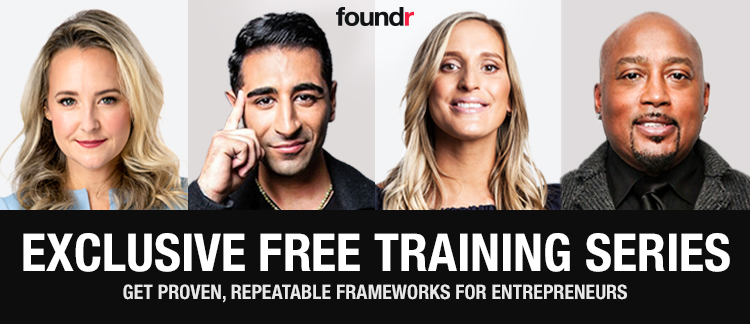
The post Stress Management Techniques to Reduce Stress at Work appeared first on Foundr.
]]>The post Types of Leadership Styles: A Step-by-Step Guide with Examples appeared first on Foundr.
]]>In its most simplistic form, a leader is someone who gets other people to do things. But leadership isn't defined by a job title—anyone can lead.
There is plenty of research attempting to label leadership styles, like the six styles of leadership outlined by Daniel Goleman, but the best type of leadership style is the one that aligns with your personality and is most effective.
Universal Leadership Principles
Leadership in the business world can look and be executed differently but there are universal principles that every leader must adhere to, no matter the profession or industry.
- Setting the Tone: Whether you're a CEO speaking at a keynote or a restaurant owner instructing a wait staff, as a leader, you set the tone for your business. How you speak, act, dress, and do your work sets an example for all to see.
- Defining Success: Leaders set the expectations for their teams. For most businesses, this means defining success for your organization and individuals.
- Knowing Your Impact: How people react when you walk into a room is critical to understanding your impact as a leader. Are you a second-generation business owner that everybody in the plant has known since you were in diapers? Are you starting a leadership position in an industry you know little about? Are you leading a team you once were a part of? Knowing your impact will guide your attitude and decision-making.
- Motivating Your Team: Each team is a collection of unique individuals and processes. Understanding your team and how to motivate them will make you successful in your role.
- Delegating: All leaders delegate work—it's part of the job. But how you delegate will speak volumes about what you value and how you want your team to function.

Types of Leadership Styles
Remember the artist and public television personality Bob Ross? Before each painting, he had a palate of defined oil paint colors. As his painting started to take shape, Ross would mix paint together with his palette knife to create new colors that articulated the vision of the landscape he was creating.
Each business goal is a different painting, whether it's hitting the next quarterly financial target or building your company culture from scratch. Just like Bob Ross, the below leadership styles will need to be adapted to achieve your goal. Your personality may lean to one style, but understanding all of them and how to utilize them is critical to becoming a well-rounded leader.
1. Authoritarian Leadership
Sometimes referred to as autocratic leadership, this style has a connotation of the toxic work environments recently exposed in tech companies or film studios. These traditional models tend to emerge in startups or organizations defined by a singular figurehead. An authoritarian leader is confident in their decisions and expects every facet of the business to reflect their thought process.
This may seem like a type of leadership style of the past but, if structured correctly, authoritarian leadership allows your team to know exactly what is required of them. There's also efficiency and clarity when everyone understands who has the final say.
Authoritarian leadership is best utilized for entrepreneurs at the beginning stage of business or industries that require high-pressure decision-making. The problem many authoritarian leaders face is transitioning this style appropriately once the business grows to a point where they can't be in every meeting.
Benefits of Authoritarian Leadership:
- A clear understanding of business objectives
- Consistent outcomes, language, and expectations across an organization
- The ability to make quick decisions during emergency or time-sensitive situations
Downsides of Authoritarian Leadership:
- Most of the business responsibility is put on the leader's shoulders
- Lack of accountability for the leader's behavior and decisions
- Lack of protections for team members
- Lack of diverse ideas and solutions
Examples of Authoritarian Leadership:
- Bill Gates, cofounder of Microsoft
- Roy Halston, American fashion designer
- Lorne Michaels, creator and producer of Saturday Night Live
2. Servant Leadership
In contrast to the authoritarian style, servant leadership is focused on giving back and leading by example. Servant leaders tend to have humble personalities or have come up through the ranks of an organization. This style of leadership suits businesses that are solving complex problems that require patience, commitment, and have a value-based mission statement.
Servant leadership encourages employees to work more efficiently by example and creates a "flat-level" organization where everyone is expected to lead. Servant leadership is best utilized in large organizations, service-based companies, or mid-level management. Many CEOs of stable, long-term companies adhere to this model (although you've probably never heard of them because of it).
Benefits of Servant Leadership:
- Creates a culture of unity, transparency, and stability
- Encourages everyone to play a part in the organization's purpose
- Motivates employees to model behavior across teams
- Customers and partners feel valued and connected to the organization
Downsides of Servant Leadership:
- Difficult to build a strong brand off of the leader's personality
- Talent retention can be poor because of a lack of growth pathways
- Slow decision making and overcomplication of problems
- The leader's focus can be easily distracted
Examples of Servant Leadership:
- Jonathan Reckford, CEO of Habitat for Humanity
- Brené Brown, author and professor
- Dan Price, founder and CEO of Gravity Payments
- Tony Dungy, American football coach
3. Laissez-Faire Leadership
Often referred to as the "hands-off" approach, laissez-faire leadership is more than just giving freedom to employees. This type of leadership style believes that employees are the key to success, not the C-suite. Laissez-faire leadership is all about empowering talented individuals and getting out of the way.
Typically, laissez-faire leadership is best utilized in businesses that require expert talent and need innovative solutions to be successful. The best laissez-faire leaders provide resources for their team to get the job done while protecting them from outside influences that may slow them down. This style is typically seen in the technology, investment, media, or startup industries.
Benefits of Laissez-Faire Leadership:
- Empowers employees to think creatively and innovate
- Motivates employees to work for themselves instead of working for a boss
- Cultivates a culture of independence and free-thinking
- Allows for leaders to focus on high-level objectives instead of monitoring employees
Downsides of Laissez-Faire Leadership:
- Can be challenging for individuals that seek gratification from leadership
- Can create confusion and inconsistency with business processes
- Does not work well for employees who require constant direction
- Leaders can appear aloof or lack understanding of the team's needs
- Projects can easily get off course
Examples of Laissez-Faire Leadership
- Warren Buffett, chairman and CEO of Berkshire Hathaway
- Barack Obama, 44th President of the United States
- Hans Zimmer, film composer
4. Visionary Leadership
In business, no other figures are celebrated as much as visionary leaders. They are the people that see things differently. Visionary leaders have a product, solution, or workflow that changes the way our world works. But to be a visionary leader doesn't mean you need to revolutionize the assembly line or invent the lightbulb—sometimes being a visionary leader is about seeing the potential of your people and business.
You've probably read, listened to, or watched visionary leaders—especially at Foundr—that changed "the game" in a respective field. Visionary leaders tend to offer compelling stories and ideas that inspire others. This style can be utilized in any business but is best suited for startups or companies seeking to be on the cutting edge of their industry.
Benefits of Visionary Leadership:
- Innovative ideas and creative solutions
- Capitalize on being first-to-market or ahead of the competition
- Provides purpose and long-term direction of an organization
- Adds energy and excitement to day-to-day work
Downsides of Visionary Leadership:
- Puts more workload on teams to live up to the vision
- Often can suffer from "shiny object syndrome"
- Can be less focused on the bottom line
- Decisions can be disruptive and controversial
Examples of Visionary Leadership:
- Elon Musk, CEO of Tesla, Inc. and SpaceX
- Richard Branson, founder of Virgin Group
- Jeff Bezos, founder of Amazon
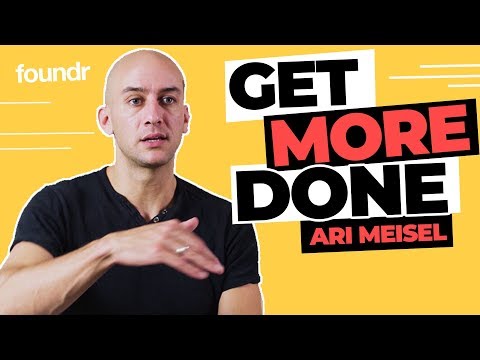
5. Coaching Leadership
American cinema defines the archetypal sporting coach as a person who gives speeches set to inspirational orchestral music. The coaching leadership style isn't about getting your team hyped for a conference call, it's about maximizing each individual's contribution for the betterment of the organization.
Coaching leaders have a deep understanding of what makes their team tick and can replicate winning formulas year after year. This type of leadership style is best suited for middle management, small teams, or consultants. Most startup leaders need to be coaches at some level in order to maximize every ounce of talent. You may not be able to hire an experienced marketing coordinator but "coaching them up" to becoming a marketing manager is what makes this style so valuable.
Benefits of Coaching Leadership:
- Turning weaknesses into strengths
- Identifying growth opportunities
- Developing loyal talent
- Creating and implementing strategies
Downsides of Coaching Leadership:
- The larger the team, the less impact the leader has
- Easily turns into micromanaging
- Takes energy away from high-level strategy
- Can be perceived as picking favorites
Examples of Coaching Leadership:
- Tony Robbins, author and speaker
- Simon Sinek, author and speaker
6. Democratic Leadership
Named after the governmental system, the democratic leadership style is focused on bringing employee voices to the table while creating a unified business framework. Participation leadership is used interchangeably with this style because of the value found from the collective over the individual.
This type of leadership style is most successful when an organization has structures built into place to receive feedback from their teams. This could be achieved through monthly town hall-style meetings, anonymous employee surveys, or daily stand-ups. Organizations in the manufacturing or IT fields might utilize this style of leadership through an organizational process like Lean manufacturing or SAFe agile. Democratic leadership creates a balanced and informed consensus and puts ownership on mid-level management and employees as much as the CEO.
Benefits of Democratic Leadership:
- Creates continuity through systems and processes
- Allows for employee involvement in decisions
- Builds "checks and balances" between departments and team members
- Can be replicated within the organization
Downsides of Democratic Leadership:
- Can cause slow decision making
- Overprocess of tasks and teams
- Can stymie creativity or bold ideas
- Not well suited for fast-paced or quickly evolving industries
Examples of Democratic Leadership:
- Indra Nooyi, former CEO of PepsiCo
- Kiichiro Toyoda, former CEO of Toyota (see The Toyota Way principles)
- Abraham Lincoln, 16th President of the United States
7. Pacesetting Leadership
Just like a runner jumping out to an early start at an Olympic track event, pacesetting leadership is all about pushing ahead while others try to keep up. Also known as trailblazing leadership, this style can create high-achieving teams in any industry. You can describe pacesetting leadership as "the squeaky wheel gets the grease" or "if you're second, you're last." Either way, you can probably spot these leaders in a crowd.
Pacesetting leadership is most common in sales or fundraising organizations, where showing others how to perform is more important than telling. If you're an entrepreneur, you'll probably have pacesetting leadership in your skillset or need to develop it. Pacesetting leaders aren't afraid to ask tough questions, set audacious goals, or be first to say "yes" or "no."
Benefits of Pacesetting Leadership:
- No goal is too daunting
- High performance is the standard
- Can generate fast growth and expand resources
Downsides of Pacesetting Leadership:
- Not suited for long-term stability
- Can alienate team members that can't keep up with demands
- Tends to cause conflict internally and externally
Examples of Pacesetting Leadership:
- Grant Cardone, author and speaker
- Jack Welch, former CEO of GE
- Michele Romanow, author and speaker
8. Transformational Leadership
Do you remember when your local Starbucks barista first said "what can I get started for you?" When Chrysler resurrected their brand with a Super Bowl commercial featuring Clint Eastwood? Or when Bumble started becoming a lifestyle app instead of just dating? All these business evolutions came from transformational leadership.
This style is traditionally found in CEO positions of large corporations where they are brought in to transform or save a brand. Silicon Valley giants like Google, Apple, and Uber have transformational leadership built into their DNA. This allows them to stay relevant and adapt to ever-changing technology and societal challenges.
But this doesn't mean transformational leadership is only for boardrooms or Fortune 500 Companies. Transformational leadership can be utilized in any industry or company that needs a change or is tackling a shift in a market.
Benefits of Transformational Leadership:
- Brings innovative ideas to a traditional or new business
- Can execute complex change within an organization
- Can shift public perception of a brand
- Can lead into the unknown with confidence
Downsides of Transformational Leadership:
- Can initiate costly projects without guaranteed success
- Requires a drastic change in historical personnel or processes
- Can confuse employees or customers if changes aren't clear
- Executing a transformational vision requires a majority buy-in
Examples of Transformational Leadership:
- Patrick Doyle, former CEO of Domino's
- Whitney Wolfe Herd, founder and CEO of Bumble
- Marc Benioff, founder and CEO of Salesforce
What Is Your Type of Leadership Style?
Did you just start a company and need to decide your leadership style? Or are you making a critical business decision and finding it difficult to approach? This step-by-step model will help you define what style of leadership to use at a macro level or a case-by-case scenario.
Step 1: Define Yourself
Understanding your personality, motivations, triggers, and skills is the first step in defining how you want to be a leader. Take a personality test like The Enneagram, DISK, or StrengthsFinder to understand who you are and how you deal with positive and negative situations.
Understanding your dominant traits and blind spots will better equip you to lead and work with those around you. If you're a stellar vision caster but not good at systems work, hire a freelance project manager. If you love working one on one with people but hate public speaking, find a cofounder that thrives in the spotlight.
Step 2: Define Your Goals
By defining your goals, short-term or long-term, you'll be able to employ a leadership style that best achieves success. Reducing a department for cost savings may take an authoritarian approach while a laissez-faire style is better suited for your next brainstorming session.
Your goals will dictate a necessary type of leadership style, and you probably won't be able to do it alone.
Step 3: Define Your Team
In order to achieve a goal, you need a team to help you. That could mean a team of 5 part-time contractors or a team of 50 experts in your field. As a leader, knowing the personalities, strengths, and opportunities within your team will help you make effective decisions.
For example, if you recently hired a new marketing director with 15 years of experience, then you can focus your leadership efforts on vision-casting for your company. Or if you have a newly promoted manager in a department, you may have to employ a coaching style to help them get up to speed.
Leadership is all about people. Knowing and understanding your team will be a consistent practice and force you to utilize different styles as your business grows and changes.
Step 4: Refine and Develop
Leadership isn't static. It's always changing as you and your business change. We've interviewed hundreds of successful founders that have all grown and adapted their type of leadership styles as their businesses and industries have evolved.
Defining your leadership style is just the beginning. Becoming a successful leader takes effort, experience, and the willingness to change.
Ready to Lead? Learn From the Best.
Are you a self-starter looking to build the skills necessary to start or grow your business? We have free training for everything from copywriting to ecommerce that can help you create a business worth leading.

The post Types of Leadership Styles: A Step-by-Step Guide with Examples appeared first on Foundr.
]]>The post The Entrepreneur's Guide to Company Culture appeared first on Foundr.
]]>Entrepreneurs can't execute on that. Whether you're just starting out with your side hustle or looking to scale from millions to billions in revenue, you need actionable intel. So, we're breaking down company culture so that you can understand what exactly it entails and how you can create a strong culture. Then we'll top it off with some examples of corporate culture that are so sweet we had to save them for dessert.
What Is Company Culture?
Company culture is defined as a set of shared values, goals, practices, and attitudes cultivated by a business. Company culture is often set by leadership, with organizational founders playing a key role in how people feel about the company, the work they do, and where they see the business going.
Every organization has a company culture—whether you deliberately cultivate it or not. Building an organizational culture with intention can be the difference between a strong, healthy company culture and a toxic culture. So let's get intentional about it.
The Components of Company Culture
The core components of organizational culture are vision, values, practices, people, brand story, and space.
Vision
Company culture begins as an act of imagination. Starting a business is the first step in turning that act of imagination into action. This is where company culture starts—with a mission statement or a clear description of your company's purpose. Not sure what we mean? These questions can help you narrow down your vision:
- What are you hoping your business will achieve?
- If your company could have one impact on the world, what would it be?
- Imagine your business in 5 years. What does it look like? What have you achieved? How do people feel working with you? How do they describe your company to their friends and family?
Values
Your company values provide an outline for what you want your company culture to be. If your mission is what you hope to achieve, your company values outline what you want the journey towards your mission to look like. Organizational values provide guidelines for how you want your team to approach their work. It encompasses the ethos and behaviors you want to cultivate.
Practices
Your practices are what you actually do to live our your company culture. A solid mission statement and beautiful values won't get you very far if you don't have the practices to back it up. Ideally, your practices should be an extension of your company's core values. If you value "employee development," for example, look for ways that your practices can support that—from giving a new employee with the training materials they need to succeed from the get-go to offering tuition reimbursement, skill development programs, or other opportunities for more senior employees to continue to grow.
People
Corporate culture is a collaborative creation, and the people you hire will either make or break your organizational culture. Hire people who either share your company's values themselves or are willing to embrace your values.
Brand Story
Human brains are hardwired for stories, and the story you tell about your business has the powerful ability to influence your corporate culture. So when you tell your brand story, ask yourself how you want people to feel and whether or not your brand narrative supports or detracts from your desired culture.
Space
The physical location in which people work also contributes to your workplace culture. Does your company value flashy office space with tons of amenities? Are you looking for a pared-down office? Or is embracing remote work an integral part of your company's culture? Look for ways that you can support your desired work environment through place.

The Benefits of a Positive Company Culture
The ROI on investing in positive company culture is real and measurable. When you invest in building a strong organizational culture, you can expect to reap some clear benefits.
Everyone Works with a Set of Shared Expectations
When your company culture is clearly outlined, everyone within the organization has a clear roadmap they can point to. This sets clear expectations for the behaviors and spirit you're trying to cultivate within each team.
Increased Employee Engagement
An organizational culture that galvanizes your team will improve employee engagement, which in turn directly benefits the business's bottom line. A 5% increase in total employee engagement can result in a .7% increase in a company's operating margin, and companies with stronger employee engagement have experienced a 22% higher profitability than those with low engagement rates.
A study from the Harvard Business Review found that inspired employees significantly outperformed their colleagues. Your company culture can lay the groundwork for inspiring employees, increasing their commitment to the team and the caliber of work that they deliver.
Lower Turnover
A company culture that centers the employee experience can greatly reduce your turnover. A 2020 report from LinkedIn revealed that companies rated highly in "purposeful mission" saw 49% lower attrition rates. Businesses with highly-rated "employee training" offerings saw 53% lower turnover.
Improved Talent Acquisition
An enticing culture attracts talent, and negative company culture will repel it. More than one-third of workers have reported that they would pass on the "perfect" job if the culture was not a fit. On the other hand, we can consider another key finding from the 2020 LinkedIn Report: businesses with flexible work arrangements, a growing draw for Millennials and Gen Z workers, saw 137% higher headcount growth than competitors.
How to Build a Strong Company Culture
Entrepreneurs and employers can follow these steps to create a corporate culture that reflects your company's values and makes you more likely to rank on one of those fancy "best places to work" lists.
1. Do Some Research on How Other Businesses Have Done It
You can learn a lot about what makes a great company culture by studying how others have approached it. Read through examples of organizations with good company culture to get a sense of what will and will not work for you. (Don't worry, we've rounded up some of our favorite examples below, so you won't have to go far.)
2. Assess What Your Current Culture Is
If you're looking to more clearly define organizational culture for an existing business, you want to begin by taking stock of what your current culture is. You can use employee surveys, exit interviews, and conversations with engaged employees to give you a sense of what is working.
There's also a chance that you may dig up some toxic practices or negative habits that you've unconsciously cultivated. If this happens, take a deep breath. Building a business is hard, and you're bound to make mistakes. It's okay if your culture isn't where you want it to be, as long as you don't get stuck there. You can use your discoveries to help guide a culture change.
3. Get Specific What You Want Your Company Culture to Be
The more specific you get about what you want your company culture to look like, the easier it will be to execute. Is your vision specific or general? This is the time to narrow it down with a clear vision statement and company values that support it. If you need help getting specific, these questions can help.
- What single, overarching goal is most important to your business? (Hint: this is your mission statement)
- In your mind, what does or should drive employee motivation?
- What does a strong culture fit look like?
- How does diversity play a role in your corporate culture?
Still stuck? Write a list of companies you want to emulate. Head to their website and check out the "company" or "careers" page to see how they list their company values. It can be a great opportunity for inspiration.
4. Take Concrete Steps to Create a Positive Company Culture
Vision is nothing without execution. To make sure that your company culture has a measurable impact on criteria like job satisfaction, employee retention, and productivity, you need to take clear, concrete steps to implement your organization's culture.
Steps That Cultivate a Positive Culture
- Hire people who support your company's core values
- Deliver on what you promise in your company values. If you say you support teamwork, how are you going to do that? Write it down and figure out how to put it into practice.
- Enact regular team building.
- Work with human resources to find out what's causing employee turnover and what you can do to improve.
5. Lead by Example
Leadership drives company culture. If you want your whole organization to embrace a certain set of values, they'll want to see you lead them. Ensure everyone at the highest levels of leadership is setting an example for your desired culture.
6. Cultivate Buy-In from Your In-House Influencers
Company culture may require leadership from the very top, but you can't do it alone. Look for help from your in-house influencers. Happy employees are a great place to start. Find ways to enlist them—whether it's asking them for input on team building or feedback on how the company's core values, as they've been written, reflect the day-to-day experience of life at your organization.
7. Listen to Feedback
Embrace feedback even, and especially, when it's hard to hear. Exit interviews and surveys can give you insight into the reality of your company culture and where you might be falling short in a way that's contributing to employee turnover. On the flip side, feedback might also bring your attention to some unexpected drivers of employee happiness.
8. Make Adjustments
You're never gonna hit it out of the park on the first try. Company culture is a practice, and it's normal to continue to adjust as you understand what works and what doesn't.
9. Change with the Times
As the world changes, the strongest organizations will change their culture with it. Many businesses are changing in the wake of the pandemic to embrace a shift to remote work, in response to increased demand from talent. This is just one example of how your business or organization might change with the times.
Ultimately, the work of company culture is continually evolving. It's a practice that you live every day.
3 Company Culture Examples You'll Want to Replicate
These companies are killing it in the company culture game.
Gravity Payments
Gravity Payments CEO Dan Price made headlines a few years back for pledging to pay every employee a minimum of $70,000/year. Believe it or not, it just gets better from there. Gravity Payments continually lives out company culture #goals to the point that when the pandemic hit, Price asked employees to volunteer if they were willing to reduce their pay (and by how much) to avoid layoffs…. And the whole company stepped up. They choose people and purpose above profits time and again, only to have the profits follow suit.
Sweetgreen
Sweetgreen, the fast-casual health food chain, has put strong company culture at the center of how it views success. They've supported specific initiatives to boost morale and increase employee engagement throughout the company, including offering a family fund (financial assistance for employees in times of need, like needing to travel to care for a sick loved one), offering opportunities to work on projects that impact the community, and hosting a "Gratitude Night" to thank employees for the positive impact they have on Sweetgreen customers.
Chani
Chani, an astrological company founded by astrologist Chani Nicholas and based out of LA, is a queer/POC/woman-led business, and you can tell through every aspect of their company culture. In addition to robust support for employees who need family leave, Chani also offers forward-thinking benefits like "gender-based violence paid and protected leave" and "unlimited menstrual leave for people with uteruses." Oh, and if you think they forgot about closing the wealth gap, they address that, too, with a stipend to help employees build wealth.

The post The Entrepreneur's Guide to Company Culture appeared first on Foundr.
]]>The post What Is the 80/20 Rule? A Simple Guide to a Life-Changing Principle appeared first on Foundr.
]]>No, it's not a math question. And we're not referring to the 80/20 celebrity diet that took Hollywood by storm in 2016. We're talking about a life-changing principle that the world's best and brightest entrepreneurs seem to understand intuitively.
The 80/20 rule, also known as the Pareto principle, is by far one of the most influential time-management and self-improvement mantras around. Believe us when we tell you that it pushes you to grow as an entrepreneur.
So what is the rule? How does the rule apply to business? And what does it have to do with someone growing peas in their garden?
Come with Foundr as we explore the 80/20 rule from the ground up. We will give you examples of how the 80/20 rule can improve your business (and life) using a fail-proof framework and a little elbow grease.
Who Created the 80/20 Rule?
Like any good origin story, the 80/20 rule has a rather humble beginning: pea pods and math.
Influential Italian economist Vilfredo Federico Damaso Pareto was born in Italy in 1848. Both an avid mathematician and gardener, legend has it that Pareto noticed that 20% of the pea plants in his garden were responsible for 80% of the peas produced.
This was Pareto's lightbulb moment: if there was uneven distribution in his pea production, could there also be uneven wealth distribution in Italy?
Diving headlong into research and economic data, he found that 80% of production typically came from just 20% of companies. Applying this rule to macroeconomics, Pareto went on to publish his first book, Cours d'économie politique, showing that 80% of the wealth in Italy was owned by 20% of the population.
Not bad for someone with a green thumb and a love of numbers.
What Is the Rule?
In a nutshell, the 80/20 rule states that roughly 80% of consequences (outputs) come from 20% of the causes (inputs).
The 80/20 rule helps direct your time, money, and resources towards things that "yield the highest and best results with the most efficient effort possible…the more focused the inputs are, the better the outputs, in other words" says Steve Surdez of StoryCore.
According to Investopedia, the 80/20 rule should be used as "a guide for how to allocate resources efficiently… simply put, it can give you a window into who to reward or what to fix."
Here are some real-life 80/20 rule examples as defined by Forbes:
- 20% of customers account for 80% of total profits
- 20% of manufacturers supply 80% of the market
- 20% of sales reps generate 80% of total sales
In 2002, Microsoft famously applied the 80/20 principle and allocated resources to patch only the top 20% of bugs impacting their software.
"One really exciting thing we learned is how, among all these software bugs involved in the report, a relatively small proportion causes most of the errors," former Microsoft CEO Steve Ballmer wrote in his three-page memo. "About 20% of the bugs cause 80% of all errors, and—this is stunning to me—1% of bugs caused half of all errors."
You may not know it but you have been unconsciously using the 80/20 rule in your everyday life.
Peek into your wardrobe. Notice that you have 10 pairs of shoes but rarely stray from your sneakers and flip flops? Do you rarely deviate from your usual coffee order at a coffee shop? How many apps do you have on your phone, and how many do you actually use?
That's the 80/20 rule in action.

Applying the Rule to Business
So, how does the 80/20 rule work with business and management?
Applying the 80/20 rule helps you focus on vital areas of your business where you should be spending the most time. For example, if we apply it to sales: 20% of customers are responsible for 80% of sales. Therefore, your efforts should be focused on the 20% of customers giving you the highest sales.
If you're a freelancer, 20% of your clients are responsible for 80% of your profits. This means that you need to focus your time and efforts on strengthening your relationships with these clients.
This doesn't mean that you should ignore or neglect your other clients. What the 80/20 rule means is that if you find yourself overwhelmed, you can prioritize and dedicate your efforts to the 20% and still make bank.
Ground-breaking, isn't it? But wait, there's more! Not only can the 80/20 rule be applied to business—it can also affect how you do business:
Power-Up with the 8/20 Rule
Level-Up Your Productivity
Let's apply the 80/20 rule to something that most entrepreneurs struggle with above all else: productivity.
Choncé Maddox for Calendar.com says that the key to 80/20 productivity is to identify your critical 20% tasks and let the other 80% of tasks fall by the wayside.
Begin by creating a list of everything you do during the day, including time spent and any returns. "This provides the perfect opportunity to look at your calendar and be completely honest about what you're doing with all your time," she says.
For each task, ask yourself:
- Should this task be labeled as high-priority or urgent?
- Is it possible to outsource it?
- Is this a high-return task? Does it bring me closer to my business' core mission?
Let's pretend you work in sales. Every week, you spend three hours preparing for upcoming sales pitches, and three hours sending invoices. Preparing a next-level sales pitch has the chance to bring you profit. It's something you cannot outsource, and it's highly time-sensitive.
Yes, sending an invoice is high-priority because invoices are how you get paid—but if you can outsource it, then you have suddenly opened up an extra three hours in your week to focus on your sales pitch. Therefore, your sales pitch is in your 20%.
As you work through analyzing your task list, you'll get a feel for your 20%. Becoming a productivity machine is all about identifying what matters most and focusing on that first.
Don't Be Afraid to Delegate
Kevin Kruse, CEO of LEADx and author, interviewed hundreds of self-made millionaires, Olympic athletes, and high-achievers to find out what makes them unique.
"For them, handling every task that gets thrown their way—or even every task that they would like to handle—is impossible," he says. "They use Pareto to help them determine what is of vital importance. Then, they delegate the rest, or simply let it go."
If you find you're spending your time micromanaging every tiny aspect of your business, you're not only being inefficient with your time, you're also holding yourself back from growing your business further.
"Business owners tend to do everything, which isn't practical as you grow," says Forbes Council member and business coach Nick Leighton.
"You're bogged down with processes and this leads to burnout and prevents your business from growing. Instead, do what you love, outsource the rest."
Leighton has a method for successful outsourcing and delegating:
10/80/10 Success Factor For Outsourcing:
- 10% of outsourcing is on you to plan the required work and set clear expectations and goals
- 80% is on the person you've delegated the task to
- The final 10% is on you to conduct a thorough review, suggest changes, and add the finishing touches
Do those numbers look familiar? Leighton's method is a key example of the 80/20 rule in action.
Find Your 80/20, and Get 100% Out of Your Day
So, what does your 80/20 look like?
The 80/20 rule is useful for optimizing productivity and allows you to better manage yourself as an entrepreneur. Remember that the 80/20 rule is not designed to make you work less—it's designed to help you work smarter. With only 24 hours in a day, you need to use your energy wisely.
Whether you're ramping up efforts with your 20% customers, delegating tasks to devote more time to your highly profitable digital marketing, or just nurturing your flourishing pea plants, the truth remains the same: your vital 20% will get you closer to your goals.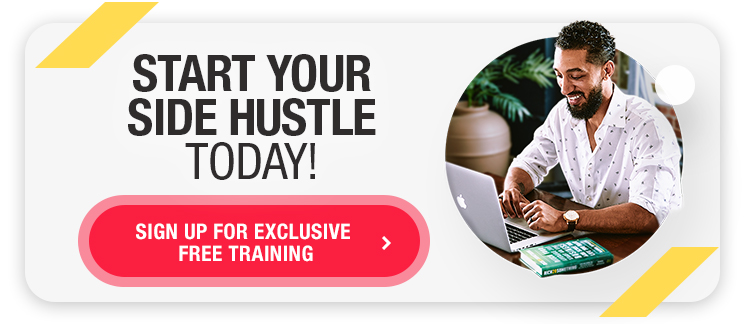
The post What Is the 80/20 Rule? A Simple Guide to a Life-Changing Principle appeared first on Foundr.
]]>The post How to Be Confident: 7 Data-Backed Ways to Give Yourself a Boost appeared first on Foundr.
]]>The Effects of Confidence
The effects of confidence on job performance and competency can be difficult to measure because, surprise, people with higher-self esteem tend to rate their attractiveness, likability, and job performance higher than those with lower-self esteem. Yet, lab studies have failed to show that high-self esteem causes better task performance.
That said, there are some correlative benefits that make confidence a worthwhile pursuit. Confidence and high-self esteem have a strong relation to happiness, and happiness can help ward off and prevent burnout. So while confidence can't directly prevent burnout, it can be a useful tool in maintaining healthy work-related energy levels.
Confidence can also boost your initiative. People with higher self-esteem are more likely to speak up in groups and to contradict the group's approach. This can be beneficial when it's necessary to bring another perspective that the group has not yet considered, but it's important to consider that the willingness to contradict the group doesn't necessarily mean you're right.
This is related to another side effect of confidence: People with higher confidence levels are also more prone to confirmation bias, the tendency to accept new information that confirms already-held beliefs and reject new information that contradicts those beliefs. It makes sense that people who feel confident would also be confident in their beliefs.
If you're committed to growing and coming from an informed place of confidence, rather than confidence for confidence's sake, then this confirmation bias is unlikely to limit your growth because you're doing the work of continuing to educate yourself (and continuing to learn, in turn, is one practice that will build confidence).
A Note on Imposter Syndrome
Imposter syndrome describes the feeling of "not being good enough" in a given work environment. The term was coined in 1978 when women and People of Color entered the workplace to find very real hostilities. Over the years women especially have been said to suffer from imposter syndrome at higher rates. Recently, some have also pointed to the fact that imposter syndrome may actually reflect a recognition of unequal treatment in the workplace. This is to say that "changing your mindset" may not be the biggest challenge… but, since it's something that you can more easily control, we're going to give you the tools for how to do that.
Imposter syndrome also took a pretty common feeling—anxiety and worry about performance—and pathologized it. Which is to say, almost everybody feels it at some time or the other. Knowing that this is a pretty common experience may help you move through it faster.
And if you're struggling with low confidence, there are many ways to help you overcome insecurity and feel more comfortable.
How to Build Confidence
Social science has given us at least 7 data-backed ways to build confidence. Whether you're looking to find success—or to just be able to enjoy it more when you achieve it—these tips will have you feeling more self-assured in no time.
1. Embrace a Confidence-Inspiring Wardrobe
How you dress might affect your self-confidence and your job performance. In a study published in Social Psychological and Personality Science, participants in casual clothing were outperformed by those who wore formal clothing when performing a series of tasks. This was especially true when it came to creative and organizational problems. Not only were the formally dressed participants more confident but they also demonstrated more focus.
If you're having a hard time getting your creative juices flowing or you're facing a high-pressure situation at work, try dressing up for the occasion. You'll likely experience a confidence boost and you may even find that you're able to complete the task at hand more easily.
2. Set Some Goals
Goal-setting can lead to higher self-esteem, confidence, autonomy, and increased motivation, according to a 2006 study. Without goals, we can feel directionless and at times listless. Setting some goals can help guide you towards a specific path with specific, planned outcomes. Not only does this have the benefit of guiding your work, but it can also be easier to identify your successes, which in turn can help increase overall confidence.
3. Take Action
According to psychotherapist Amy Morin, the biggest mistake people make is to expect confidence to come first. She suggests that many of the people she works with would be better served by taking action first and seeing if the confidence follows. If you're suffering from low confidence, it can be especially challenging to take a risk—but if you're serious about overcoming these negative feelings, then do something. Try your hand at painting. Start the business or side hustle you've been dreaming of for years. Do the thing you think you would do if you felt confident. You might be surprised how confident it makes you feel.
So… what would you do if you felt more confident? Go do it. If you don't know how to do it, find a class. Virtual learning has made developing new skills and proficiencies easier than ever. Many entrepreneurs have taken our Start Your Side Hustle mini-course to learn the ropes. The free course was just what they needed to build the knowledge base to help them start their business with confidence. Sometimes, it doesn't take a lot. It just takes a step. Take the step.
4. Think Positive
Positive thinking can help you build greater self-confidence. The Mayo Clinic recommends these strategies for cultivating positive thoughts:
- Practice hopeful statements.
- Forgive yourself.
- Avoid statements that use the word "should" or "must."
- Consider what you've learned.
- Rename negative thoughts.
- Encourage yourself (You're working hard. Give yourself a little credit!)
- Look for the silver linings.
Some of us have a tendency toward negative thinking because it "feels true" but the truth is that it's often a skewed version of reality. Often a negative thought can just be a limiting belief in disguise. Make a concerted effort to reframe negative thoughts in a positive way. You might be surprised by the confidence that follows.
5. Try Meditation
Meditation, the practice of quieting the mind, has been shown to ease anxiety, help manage your inner critic, and promote overall well-being. It can also help with building confidence. A study at Stanford found that participants who engaged in meditation by directing their attention to their senses in various activities (lying down, breathing, walking) experienced a reduction in anxiety. They also tended to think of themselves more positively.
It's never been easier to start a meditation practice. Apps like Headspace and Calm can help you retrain your brain through daily meditation. You can start with shorter meditations and work your way up. There are meditations specifically geared toward different situations in life, so whether you want to overcome shyness, social anxiety, fear, or if you just want help being a bit more present, there's likely a meditation for that.
6. Change Your Posture
The way you hold your body may affect your confidence. While power postures are one of the more controversial topics in confidence-related behavioral science, there is continued evidence that your body posture may contribute to the level of confidence you feel.
So what kind of postures make you feel more confident? Expansive postures, those where you allow your body to take up space. Stand with your feet on the ground in an open, wide stance. Roll your shoulders back and allow your arms to remain loose, instead of crossing them. Keep your hands out of your pockets. Make eye contact.
You may have noticed that many of these confidence-related poses are primally vulnerable. In a very physical sense, the front of our bodies is where we are most vulnerable. There's a reason Brené Brown, renowned vulnerability expert, often repeats the words. "Strong back, soft front, wild heart." Confidence and vulnerability have a connection here, in that vulnerability is necessary for confidence. Confidence, in turn, can also make you more comfortable with vulnerability.
7. Invest in Your Relationships
Have you ever noticed that people who have a support network of strong relationships tend to exhibit more confidence? Well, that's because they are. It turns out that the reverse is also true: strong relationships make you more confident and confidence can lead to stronger relationships.
After analyzing more than two decades of research, the American Psychological Association found that positive relationships can contribute to confidence, and vice versa. According to the authors of the study, "The reciprocal link between self-esteem and social relationships implies that the effects of a positive feedback loop accumulate over time and could be substantial as people go through life."
So if you've been struggling with confidence recently, you might benefit from taking some time to invest in the other relationships in your life. This is part of the ever-important work-life balance. Sometimes, the answer to feeling more confident at work is to spend your energy investing in your personal relationships.
It Gets Easier
Some of the ways you can build confidence have reinforcing feedback loops. Positive affirmations can help you feel more overall confidence, which in turn makes it easier to find positive thoughts. Strong relationships build confidence, which builds strong relationships.
The good news is that as you begin your confidence-building practice, it will get easier. Even if you don't see seismic gains at the beginning, keep going. True self-confidence is built over time through practice.
The post How to Be Confident: 7 Data-Backed Ways to Give Yourself a Boost appeared first on Foundr.
]]>The post The Hands-Down Best Entrepreneur Advice from Our First 100 Issues appeared first on Foundr.
]]>What began as a one-person digital magazine eight years ago has turned into a global publication with 20+ courses, 40+ employees in 5 continents, and a community of millions of entrepreneurs from all walks of life and from every corner of the industry.
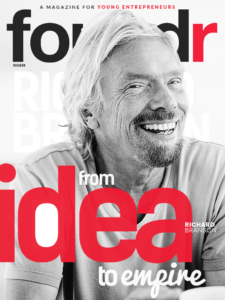 Our magazine has featured some of the greatest entrepreneurs of our generation, including industry giants like Arianna Huffington, Tim Ferriss, Mark Cuban, Bobbi Brown, and Sir Richard Branson.
Our magazine has featured some of the greatest entrepreneurs of our generation, including industry giants like Arianna Huffington, Tim Ferriss, Mark Cuban, Bobbi Brown, and Sir Richard Branson.
Yes, THAT Sir Richard Branson.
As a celebration of our 100th issue and the infinite library of advice and lessons from our hero entrepreneurs themselves, we've decided to share some of our favorite moments from our interviews over the years.
The Best Entrepreneur Advice and Insights From Over 100 Magazine Issues:
Issue 24: Marie Forleo, Founder of Marie Forleo International
Our 24th issue of Foundr Magazine featured an entrepreneur like no other. Not only does Marie Forleo run an 8-figure business and have a readership of more than 275,000 readers in 193 countries worldwide, but Oprah called her a thought leader for the next generation.
And Marie's secret to building an 8-figure business? "Build a business with heart!"
How to Build an 8-Figure Business with Heart
Lead With Your Heart
"Pick one channel, one way to get your message out that you can become really good and consistent at, and then let yourself build from there," Forleo says. "Figure out what's your perfect fit…decide what can be a good consistent schedule for you to put out high-quality content that really matters to people and is true to your voice."
Give Yourself Time Off
Forleo happily admits how hard she worked and how hard she pushed herself, but warns that burnout can completely take you down. "Make sure to carve out quality time, even if it's just a little for your family, friends, and health."
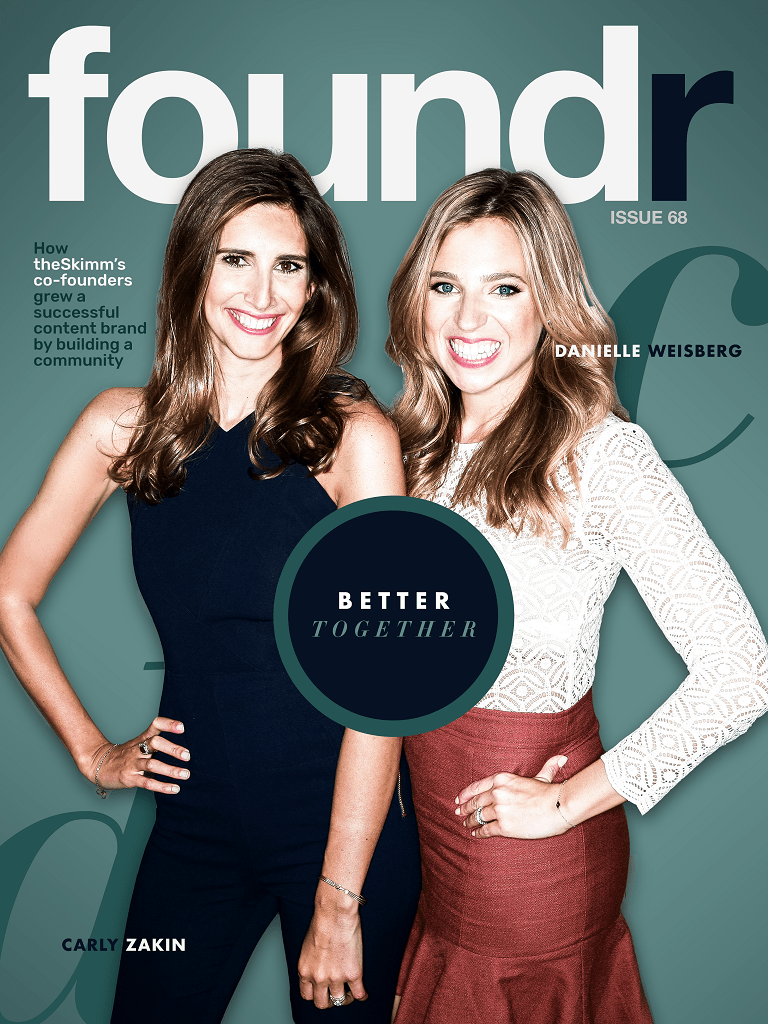 Issue 68: Danielle Weisberg & Carly Zakin, Co-founders of theSkimm
Issue 68: Danielle Weisberg & Carly Zakin, Co-founders of theSkimm
In our 68th issue, theSkimm co-founders Danielle Weisberg and Carly Zakin discussed how entrepreneurship can be a lonely road and how you need all the community support you can get.
Not only have these close friends supported each other through almost a decade of business, they've also "succeeded in surrounding themselves with a community that ardently believes in the value of what they do" through their content.
theSkimm Co-founders' Tips for Growing a Content-Based Business
Build a Community
Weisberg and Zakin are huge advocates for authentic community building. When it comes to making a decision between money and an audience, they say that monetization can come later, but an enthusiastic, loyal audience is irreplaceable.
Grow With Your Audience
"We always say, 'You can age into theSkimm, but you can't age out,'" Zakin says. "What we've seen is that we're a must-read or must-have brand for a younger audience, but we also have been able to start to expand with our audience and help them go through the next phases of their life."
Issue 70: David Heinemeier Hansson and Jason Fried, Founders of Basecamp
For our 70th issue, we spoke with the founders of Basecamp, David Heinemeier Hansson and Jason Fried, to find out how they're achieving the holy grail of office culture: a healthy work-life balance.
The Basecamp duo offer a new perspective on the modern-day entrepreneurial hustle and the importance of fostering a "no-overworking" office culture. "[We believe] work should be a pleasurable experience," Hansson says. "Success to us means we set our own agenda, control our own destiny, and have a sense of independence."
Basecamp's Rules for a Healthy Work-Life Balance
Have Fewer Meetings
Outside of social communication and quick check-ins, keeping in touch can be a huge distraction for employees. "The idea of chat as a primary means of communication inside of a company, I believe it to be a very toxic idea," Fried says. "I think that, right now, chat is why work is more hectic for more people".
Watch Out for Overwork
Basecamp has enforced a 6-week project budget to avoid overwork. This time limit forces employees to make decisions about workflows and weigh tradeoffs. "We don't do overworking," Fried says. "We'd rather reward someone who works normal hours and gets a lot done…someone who protects and manages their time".

Issue 80: Suzy Batiz, Founder of Poo-Pourri
If there's one thing we love to say, it's this: the entrepreneurial journey is incredibly challenging but that doesn't mean it shouldn't be fun. Just ask our 80th-issue featured guest Suzy Batiz, who knows a thing or two about making a splash.
Batiz went bankrupt twice before launching the now multimillion-dollar Poo-Pourri brand, and has this reminder for our readers: "What's worse than losing everything is losing everything and realizing you didn't even have fun to begin with."
How To Stand Out From The Crowd, The Poo~Pourri Way
Stop Worrying about What Other People Are Doing
Batiz learned this the hard way. After finding out that a competitor was launching a new product, she panicked. In a competitive fit, Poo-Pourri rushed production and ended up with 500,000 faulty units, losing millions of dollars and three-quarters of a year in creative energy.
"It was a really good lesson for us to keep our blinders on and stop worrying about what other people are doing," Batiz says. "Sometimes the best lessons cost us a lot of money or time or energy. The key is to learn."
Get the Word Out
"When you have an idea that is great, people tell other people about it," she says. "I see a lot of people in founder stages stop at a good idea. And if you just have a good idea, it's like pushing a train uphill. But when you have a great idea, people will stand on the rooftops and shout to other people about it."
Issue 83: Alexa von Tobel: Founder and CEO of LearnVest
In our 83rd issue, Alexa von Tobel gives this piece of advice for budding entrepreneurs: "If you're living for tomorrow, you can't think long term."
As the founder of digital financial planning business LearnVest and manager of the $200 million investment firm Inspired Capital, von Tobel knows how to avoid running into financial struggle—and that's why we chose her as the instructor of our Finance For Founders course.
Alexa von Tobel's Tips for Building a Successful Business
Word-of-Mouth Marketing
Sometimes the best marketing is word-of-mouth. "Word-of-mouth marketing is free," she says, and often "more effective than traditional marketing for startups".
Embrace the Learning Process
Always be open to criticism and make sure you learn from your mistakes. "I think the best founders are learners," she says. "They are comfortable with negative feedback. They want to make it better, and they are constantly just listening and learning obsessively."
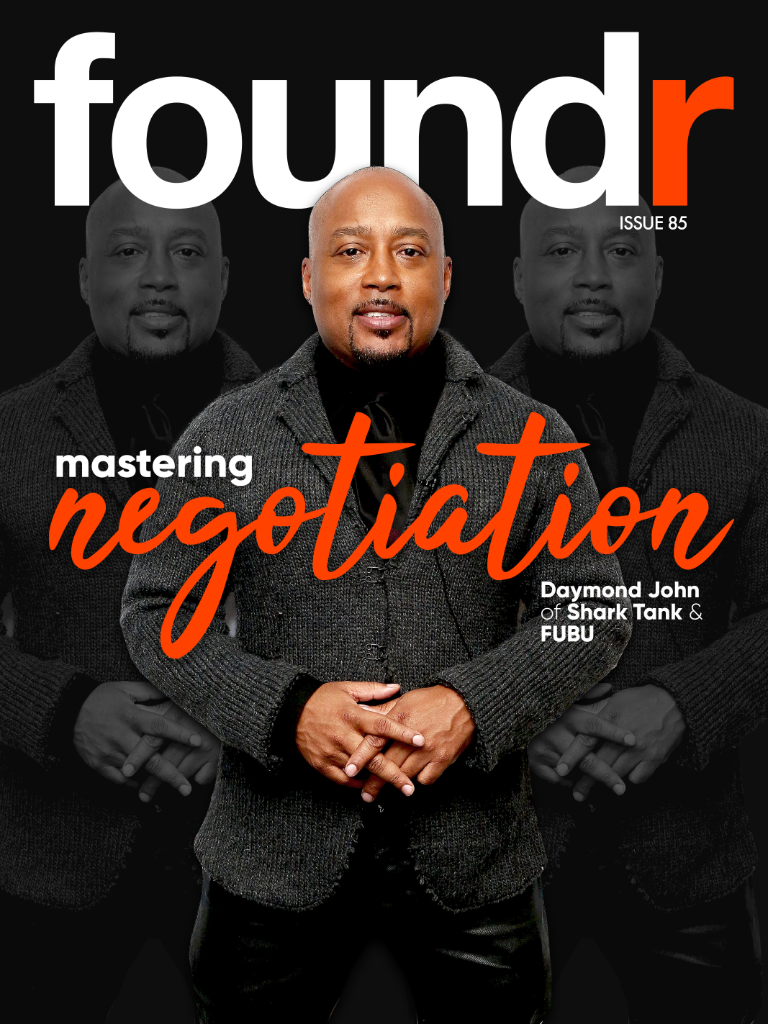
Issue 85: Daymond John, CEO of FUBU
In 2020, we partnered with Daymond John to create Deal Flow, a 100% free and actionable mini-course where he teaches you his 3 must-have skills to transform any situation, close any deal, and achieve any outcome you desire (even in today's changing economy).
This ability to put together winning deals is something that John has mastered in his business empire and also understands extraordinarily well from reviewing 1000's of pitches and business deals on ABC's Shark Tank every week.
In our 85th issue, John gave us a sneak peak at his fail-proof approach to negotiating business deals with ease:
Daymond John's 3 Stages of Negotiation
Before the Negotiation
John says you need to identify the other party's motivations and make a list of questions you want to ask. Make sure to prepare clear answers to every question you think they'll ask you, and "identify your deal breakers".
During the Negotiation
"Look the other party in the eye, give a firm handshake, speak in complete sentences, let the other party speak in complete sentences, and mind your body language and facial expressions," says John.
After the Negotiation
Make sure to nurture the relationship to keep the door open for opportunities and future dialogue down the road. "This includes landing on a deal that benefits everyone, not just you."
Issue 88: HubSpot Co-Founder Dharmesh Shah
In light of the COVID-19 pandemic, more and more companies adopted a decentralized structure to allow team members to work more safely from their homes.
To further understand how to best navigate the new normal workspace, our cover feature for Issue 88 was an in-depth interview with Dharmesh Shah of HubSpot. He offers these words of wisdom for businesses operating with a decentralized structure: it's all about culture.
Shah's Guide to a Consistent Culture across a Decentralized Team
Write it Out
As Shah puts it, an abrupt global shift to remote work revealed that most companies "cannot communicate culture through osmosis." Instead, companies should write down the most important tenets of their culture code, just as he did with HubSpot's infamous 128-slide Culture Code. Consider what matters most when it comes to your company values and write it out for your team.
Repetition, Repetition, Repetition
Repeat the core message of your culture code over and over again to your team. Shah himself repeats their code at every single company-wide meeting.
"This part is often painful for founders, myself included. I'll say the same things over and over again to the point where I can't believe I'm going to say it again. As you're growing, you forget the fact that at any given point in time, most people at the company have never heard you say those words."

Issue 90: Katia Beauchamp, Co-Founder and CEO of Birchbox
In our 90th issue, Beauchamp says she believes the most important part of business is creating a trustworthy brand, because it may be your saving grace if you run into trouble.
In the early days of Birchbox, Beauchamp recalls when she accidentally mailed out tens of thousands of expired products and had to do major damage control including refunding every customer, costing her thousands. Thanks to the trusting relationship that Beauchamp had crafted between brand and customer, most customers were thankful for her apology and Birchbox avoided a huge PR disaster.
Katia Beauchamp's Secret Recipe For Creating A Trustworthy Brand
Face the Music, and Own Up to Your Mistakes
If you make a mistake or fail to meet expectations, Beauchamp says that the best thing you can do for your brand is to take ownership and admit fault. "Mistakes are the biggest moments and what you do with them, how you face them, and how you take responsibility is a really big part of it," says Beauchamp.
Inspire Your Customers to Want You to Win
Beauchamp leaves us with some wise wisdom for entrepreneurs: that having loyal customers is the only true competitive advantage you have in today's business world.
"Consumers wanting you to win, caring about you, the reciprocity of care; it's unstoppable… you can really miss and you have another chance because there's care on both sides. That's what a relationship means. It isn't just about trust on our side, it's reciprocal."
Issue 92: Yancey Strickler, Co-founder of Kickstarter
The framework that Strickler introduces in our 92nd issue of Foundr Magazine is called "Bentoism". This simple 2×2 matrix helps entrepreneurs to make important decisions.
"This came from a personal desire to be better. And knowing that it's hard to act that way all the time. For hard things, we need tools. So this is simply a tool to help us find better decisions and—I truly think—a better world," Strickler says.
Yancey's Decision-Making Bentoism Framework

Now Me
This section examines what you want right now, such as a need for profitability, security, and sustenance. However, Strickler says that if you only focus on this square, you'll fail to meet your full potential.
Future Me
This square represents the future version of yourself—the one that made all the right choices. What does this version of you need?
Now Us
This is the section for the people you rely on and who rely on you, and their expectations. For businesses, this can be investors, employees, or customers.
Future Us
This represents the community of the future. It represents your vision and where you want the world to be in 10 years.
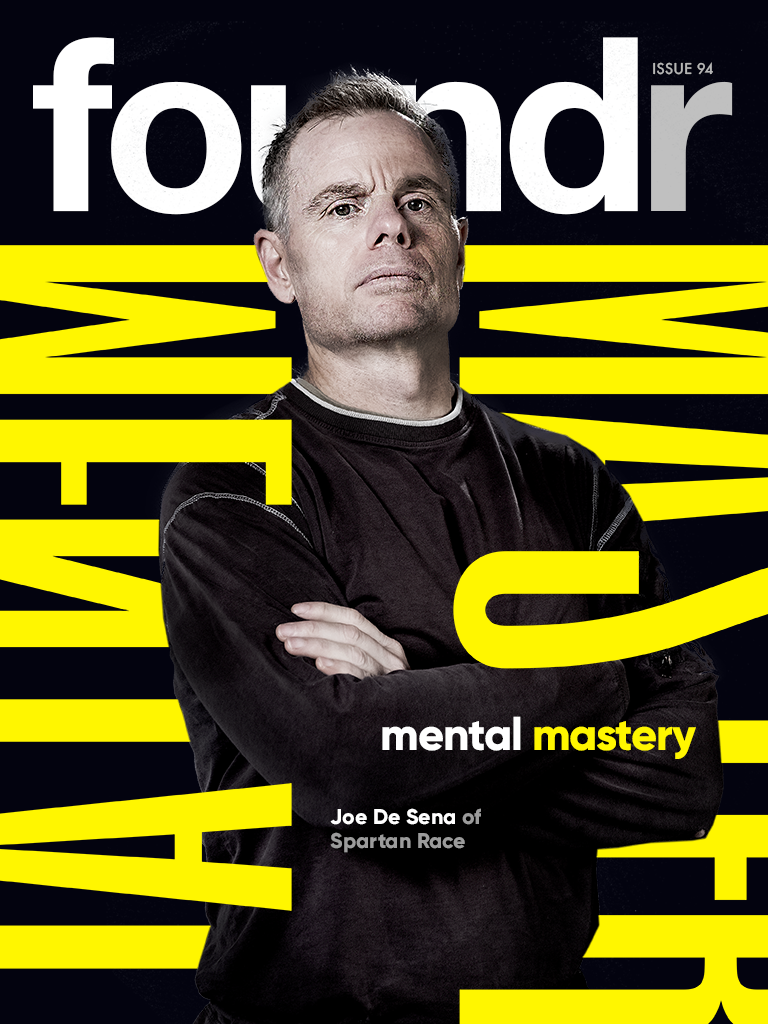
Issue 94: Joe De Sena, CEO and Founder of Spartan Races Inc.
To celebrate the launch of our newest course, Mental Toughness, our 94rd issue featured the toughest entrepreneur in the game: Spartan Races' Joe De Sena.
In one of our craziest interviews to date with the man responsible for the Spartan Death Race, De Sena gave us his famous morning routine that he credits with being the foundation for his mental toughness.
Joe De Sena's Guide to Succeeding at Anything
Reflect and Plan
De Sena says that the secret to a successful day is jotting down a quick list of the things you have to do tomorrow. "Winning the day starts the night before" says De Sena.
Ask yourself:
- What can I improve on tomorrow?
- What did I achieve today?
- Did I face any blockers?
- What are my top 3 priorities for tomorrow?
Nourish Your Body
De Sena says you need to "nourish your body, nourish your mind."
- Wake up early
- Drink at least 2 glasses of water
- Break a small sweat ("earn your breakfast!")
- Take an ice-cold shower to get the blood flowing
Prioritize and Execute
Now that your mind and body are awake and alert, you need to tackle your top 3 priorities that you wrote the night before, and only after they're complete do you tackle the smaller tasks.
"If you're looking to fill a bucket with as many rocks as you can, you put the big rocks in, and then you fill in the voids with the little rocks."
Ready to Celebrate Our Next Magazine Milestone?
Now that we've crossed the 100 issue milestone, we can't wait to see what incredible content we publish in the next 100 issues!
Foundr Magazine is on a mission to distill the lessons and advice from the best of the best in business. As an independently published global media and education company, we are beyond proud that we are giving you access to some of the greatest founders of our time.
For more incredible content, subscribe to Foundr Magazine to start building the future you've always dreamed of.
The post The Hands-Down Best Entrepreneur Advice from Our First 100 Issues appeared first on Foundr.
]]>The post 20 Time Management and Productivity Techniques To Win Back Your Day appeared first on Foundr.
]]>Time management can be a serious challenge for any busy founder, especially when the lines are more frequently blurred (or vanished) between work hours and home life.
However, with the proper tools and tactics, you can overcome that challenge and be more productive than ever — even during some of the most chaotic times in modern history.
Here are 20 time management tactics to help you win back your day.
1. Don't Multitask (It's Impossible)
Do you ever feel physically and mentally exhausted at the end of the workday, but didn't actually get any of your work done? If you've ever found yourself complaining that you don't have enough time in the day, it's likely you've been trying to multitask.
When you think you're multitasking, you're actually just cutting into the focus pie of each task, and stealing hours from yourself. You only have a certain finite amount of energy in a given day, and if you are one of those entrepreneurs who wants to give 100% to everything that you do, the math just doesn't add up. In reality you end up giving 10% here, 20% there, 5% on a dozen other tasks, and then another 10% of your focus going toward the endless barrage of notifications and social media posts.
This creates a whole lot of switching costs, which eat up more time than you'd think.
Harvard Business Review reports that "after a notification has forced us to switch between tasks, it can take us about 23 minutes to get back to the task at hand, according to a study from University of California, Irvine."
Let's say you checked your Facebook notifications four times. That's up to an entire hour lost.
Do you check your email inbox or Slack every time a little red circle pops up? You're losing more time than you're actually working.
What's more, the quality of work diminishes, while the timeline drags out. It will feel like things are taking you longer and longer to complete — because they are. And since you've already spent a full day's energy switching between tasks, your tank is empty by late afternoon.
2. Single-Task Instead
When was the last time you focused on only ONE thing for 30 minutes? Or even 10 minutes? Without looking at notifications or emails?
Whatever you're working on, shut off all distractions and focus on only that one thing for a specific chunk of time. Set a timer if you have to. Block off your calendar as "DND" (Do Not Disturb). Adjust your Slack settings to "Pause notifications." Close all 27 browser tabs that you have open, or simply click "New Window". Put on your favorite lyric-less chill music to get you into the zone. And just… start doing the thing.
New York Times bestselling author Daniel José Older recommends the timer method in his Skillshare class when it comes to overcoming writer's block. "Set your timer for 5 minutes, maybe 10 minutes, and commit to writing words on the page for those 5 or 10 minutes nonstop, without thinking about it, and without trying to do it 'right.'"

3. Set Artificial Limits for Yourself
One of the most powerful ways to increase your productivity and improve time management is to set artificial limits. What does this mean? Fake deadlines.
Setting artificial limits keeps you from falling into the trap of Parkinson's law, which states that "work expands so as to fill the time available for its completion." You've likely seen it before. Someone in your team has three tasks and an eight-hour workday in which to complete them, and they manage to stretch out those tasks from 9am to 5pm. When you know first-hand that those three tasks should've only taken 90 minutes max.
What if they only had a 90-minute workday in which to do it? I'd bet a Tesla Cybertruck that the work would've still gotten done.
Ari Meisel, serial entrepreneur and author of Less Doing, More Living and The Replaceable Founder, experienced this powerful productivity strategy first-hand when his Crohn's disease became really debilitating. Ari's condition was so painful that he could only muster up the energy to work for about one hour each day. How do you run a business in only one hour a day? Well, Ari figured out how to do so, because he had to.
The work-from-home environment caused by the COVID-19 pandemic has made it even easier to fall into the trap of Parkinson's law. With no commute time, and no bookends to the workday to get you to mentally clock out and head home, you can really drag things out.
The best way to beat Parkinson's law, and stay productive today, is to set artificial deadlines. Fabricate a time limit in which to complete a given task — even set a timer for yourself.
One of Foundr's team members has been known to follow this technique as well using his surroundings as built-in time limits. When he's traveling for a shoot (back when people could do that sort of thing), he only ever purchased the 30-minute or 60-minute WiFi on the plane. Then, he challenged himself to complete as much work as humanly possible during that 30- or 60-minute timeframe, and he would not upgrade the internet after the timer was up.
Anything that happens after the WiFi cuts off, has to happen offline on desktop. This keeps you focused on the task at hand, and keeps you from distracting yourself with various tabs, notifications and emails.
You'd be amazed at how much you can get done when you set fake limits and create a mini-sprint.
4. Use the Pomodoro Technique
The Pomodoro Technique is a specific time management method from the late 1980s which uses a timer to break down work into small, hyper-productive mini "sprints." These are typically 25 minute intervals separated by short breaks.
LifeHacker outlines the play-by-play steps on how to use the Pomodoro Technique effectively:
- Choose a task to be accomplished
- Set the Pomodoro to 25 minutes (the Pomodoro is the timer)
- Work on the task until the Pomodoro rings, then put a check on your sheet of paper
- Take a short break (5 minutes is OK)
- Every 4 Pomodoros take a longer break
You can even use online tools like Tomato Timer or a plethora of apps to make this tactic even easier.
Try it out and let us know in the comments how it worked for you!
5. Try the Zeigarnik Effect
There's a psychological theory that an activity that has been interrupted may be easier to recall and go back to. This is called the Zeigarnik Effect. The thinking is that you have a higher chance of remembering an unfinished task, than a completed task.
Lithuanian psychologist Bluma Zeigarnik discovered this effect while observing the behavior of waiters in a cafe. According to the study, waiters seemed to have a higher chance of remembering details of the tabs that were open, more so than the customers who were already paid up.
How can the Zeigarnik Effect be used to boost an entrepreneur's productivity? Well, if you're struggling to power through a given task, or finding yourself procrastinating to solve a particular problem, take a break. Walk away from it for five minutes. Then come back to it.
You may just find yourself refreshed and able to work through it more effectively, now that you've left the ticket open and had a chance to think on it subconsciously and without pressure.
6. Find Your "Six-Pack"
No, we're not talking about a kicking back with a cold one to decompress. The "Six-Pack" is an aviation term which refers to the main flight instruments dashboard in the cockpit of an airplane. Even though there are a million things to juggle simultaneously while you're in flight, there are typically six instruments that provide the most critical data (airspeed, altimeter, etc.). A pilot can focus on these six gauges to keep things going smoothly.
Ari Meisel is also a trained pilot. He advises to think of your business like an aircraft when it comes to maintaining focus.
"As a founder, what you need to do is try to find your version of the Six-Pack. That thing that, no matter what else happens, you will be focusing on driving your business forward, even by one percent."
What's your Six-Pack in your business? That is what you should spend your energy on. For anything else that doesn't contribute to that goal or KPI, simply eliminate the distraction.
7. Put Your Phone in the Other Room
You may convince yourself that you are not addicted to your smartphone, but let's be honest – every entrepreneur is. This little tool is potentially one of the most powerful for running an online business that ever existed. Keyword: potentially.
In reality, smartphone addiction is a nuisance and a detriment to productivity.
Even just checking your phone for two seconds and processing a new notification requires up to 23 minutes to get your focus back.
A surefire way to eliminate this constant distraction is to leave your smartphone in the other room.
Try it for a few hours when you start work tomorrow. By lunchtime, you'll be pleasantly surprised at how focused and accomplished you feel.
8. Master Asynchronous Communication
Asynchronous communication (or "Async," for short) is a highly underrated productivity behavior that can fundamentally change the way you run your business. It means communicating with your team NOT in real-time, but by "passing the ball back and forth."
The Doist blog sums it up best: "Simply put, asynchronous communication is when you send a message without expecting an immediate response."
- Async Example 1: You send an email to someone. They respond back the next day when they can best deal with that task.
Async Example 2: You send a Loom video briefing a team member in a different timezone, during their sleep hours. When they wake up and start working, they watch the Loom and start working on the project – commenting with any questions. Then you can proceed to answer their questions asynchronously at your earliest convenience.
Of course, there are some communications that still need to be synchronous (aka "Sync") – when the person you're speaking with responds immediately in real-time.
Many people still believe that creative collaboration and problem solving is still best done "in the same room." However, now that in many places around the world we quite literally can't be in the same room due to quarantines and social distancing, many entrepreneurs are having to rethink their communication strategies.
- Sync Example 1: A live meeting in the same room (or video conferencing tool).
- Sync Example 2: A real-time back-and-forth conversation in Slack chat.
It's important to think about which comms in your workday could potentially become asynchronous, and cancel those meetings from your calendar. And only schedule synchronous communication when absolutely necessary.
Every time a Google Calendar meeting gets canceled and replaced with an asynch message or 5-minute Loom video, an angel gets its wings.
9. Avoid Decision Fatigue
In fact, avoiding decisions in general will grant you back a ton of brainpower.
Jack Dorsey, co-founder of Twitter and Square, has a notable aversion to making decisions and often empowers his team to make key decisions without him. "A former Square employee said Dorsey 'thought the perfect meeting was one in which he doesn't have to say a thing.'"
As an entrepreneur, you probably find yourself making decisions all day long. And by the time you're faced with a truly important challenge, you've already spent all your decision-making energy on small tasks and menial decisions.
Decision fatigue is real. It may feel like there's no more fuel in your mental tank by the end of the day, and your brain is strained by even the notion of yet another thing that you're in charge of.
Try making fewer decisions, and putting the onus on your team (especially those being groomed for leadership roles) to own more of those decisions.
You may be asking: "But how do I trust people to make the right decisions without me?"
Here's a guiding principle you can use, to prioritize the decisions that you can let go of, vs. the (smaller number of) decisions that you can maintain ownership of.
10. Categorize Decisions as Reversible or Irreversible
If you absolutely must make a decision yourself, take a moment to think about how important this decision is to spend mental energy on. It's highly possible that the majority of decisions in a given day could be made quickly in a few seconds without any risk. In other words, you probably spent too much time worrying about it.
Farnam Street unpacks this principle of Reversible and Irreversible Decisions, illustrating a grid of how you should think about each decision.
If a decision is reversible — for example, a social media post that you can quickly and easily delete, or a blog article draft that you can always edit — then you should spend minimal time mulling it over. Just "move fast and break things," and you will have saved yourself the mental strain of worrying about something that can easily be undone.
If a decision is irreversible — for example, sending an email to 2 million subscribers — you may want to spend some of your energy on making sure it's right. What's more, if a decision is irreversible AND consequential — such as signing a major contract or a five-year office lease — you definitely want to spend some time on it.
Jeff Bezos digs into this decision-making approach in one of his shareholder letters:
"Some decisions are consequential and irreversible or nearly irreversible – one-way doors – and these decisions must be made methodically, carefully, slowly, with great deliberation and consultation. If you walk through and don't like what you see on the other side, you can't get back to where you were before. We can call these Type 1 decisions. But most decisions aren't like that – they are changeable, reversible – they're two-way doors."
According to Bezos, this second type of decision "can and should be made quickly."
Try thinking about your decisions this way, and see how fast you can make the reversible ones.
11. Own Your Calendar
Chris Dixon, partner and investor at a16z, once said: "Your email inbox is a to-do list created by other people." Too many people treat their G-Suite account in a reactive way, not proactively.
It's time to take control. Say "No" to that next calendar invite. Defer unimportant emails until a later date you can best action them. Use "The 3 D's" to get to inbox zero, and keep your Google Calendar clear of unnecessary meetings that you don't need to be involved in.
This tip is very simple but nonetheless important. Own your calendar and own your time. It belongs to you, and nobody else.
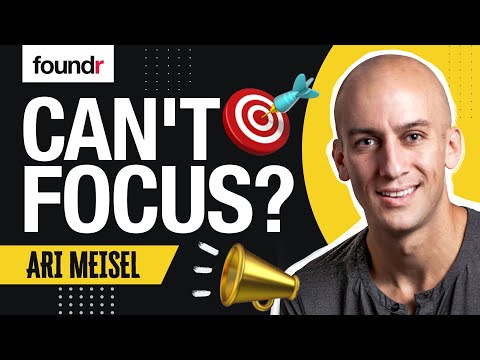
12. Don't Eat the Frog
Some productivity advice says you should tackle the most difficult, daunting task first thing in the morning so that everything else is easier from there – an expression known as "eating the frog." This is actually not recommended for optimum productivity.
Eating the frog has a high chance of draining your energy early in the day, which will set you up for failure in the afternoon.
Instead of doing the most challenging task first, you should do the thing that you are holding up the most. Is there a task that you are procrastinating on, and slowing your team down? Do that thing first, and get it out of your head.
After that task is done, you can take back control of your own priorities and time.
13. Forget Complex Morning Routines and Big Healthy Breakfasts
You don't have to eat a big breakfast or make a complicated smoothie you saw on Instagram every morning.
Another misconception about productivity is that you need to get up early and have a solid morning routine in order to motivate yourself. While morning routines do help you set up your day for success, because you've already ticked a few boxes on your to-do list (e.g. making your bed, showering, brewing coffee, getting some fresh air or exercise), it's not essential to have one.
If having a consistent morning routine unlocks productivity for you, by all means, continue to do it. But some founders find that a nighttime routine can be just as effective instead.
14. Try a Nighttime Routine Instead
A nighttime routine involves getting yourself set up for the next business day so that you can jump right into an efficient workflow in the morning. This could entail cleaning out your inbox and Slack, setting your top three priorities for tomorrow, meditating for 30 minutes, and even setting a bedtime reminder in your calendar for when to turn off your devices and decompress.
Rather than logging on in the AM and spending the first hour of the day wrapping your head around what your priorities are, you'll already have them mapped out, and you can spend that hour actually getting things done.
What's more, having a consistent bedtime improves sleep quality so you can wake up feeling more refreshed and ready to tackle the day.
15. Find Your Peak Time
Are you a morning person or a night owl? Do you ever feel guilty about not being "on" during the typical 9-to-5 business hours? You're not alone.
Everyone has a different "peak time" or "flow time", which is the 60-90 minute period during the day when you're at your absolute best. Your brain is firing on all cylinders, you're laser-focused without effort, and you simply can't be messed with.
For some, peak time may happen early in the morning. For others, maybe it's mid-afternoon. Others may find themselves at their best at 11pm until just after midnight, getting more done in that hour-long period than they did the entire day prior.
You can find out what your peak time is by doing the CNS Tap Test (Central Nervous System). To learn more about how to do this, check out Foundr's course Productivity Machine.
In the meantime, do a bit of reflection on what times of day you typically find yourself "in the zone," and try not to schedule any menial tasks or meetings during those times.
16. Don't Dress for Success
The old adage says "dress for success." Nowadays in the post-COVID world of remote work, it's more important to dress for comfort instead.
This is becoming an even more integral part of work-life especially now the majority of people are working from their homes. Pajamas, hoodies, shorts, flip-flops — whatever enables you to get in the zone to achieve your best work. (Of course, if you have an important video call with a potential client or partner, you may want to wear something presentable from the shoulders up).
Keeping your wardrobe simple also helps avoid decision fatigue, a concept mentioned earlier.
For example, Former US President Barack Obama admittedly only wears two types of suits: gray or blue. He goes on to explain: "The simple act of making decisions degrades one's ability to make further decisions… You need to focus your decision-making energy."
In addition to freeing up energy, you'll also free up time. Every minute less that you spend worrying about what you're going to wear, is an extra minute you could be getting something important done.
This concept works in so many ways beyond just clothing, in order to maintain focus and win you back your brainpower. Minimize the amount of decisions you have to make in a given day, and you'll be much more effective.

17. Separate Your Workspace from Home Life
Sometimes it's not enough to use digital tools to compartmentalize your time and focus. Especially when working from home, you may need to physically separate yourself from stressful distractions.
You see the dishes piling up in the sink. The dirty laundry stares you down from the corner of the room. The daily news cycle blares "in the background" on TV. These distractions chip away at your attention span, to the point where you've now effectively added a bunch of Sunday household chores to your workday to-do list.
In these instances, it's best to physically change rooms, and create a separate workspace that's distinct from the rest of your home life.
There are a lot of tips for creating the perfect at-home workspace for freelancers and entrepreneurs. All you need right now is to make a decision to actually do it — create a unique workspace that puts a wall between you and the dirty dishes, or at least points you away from the kitchen.
18. Get Three Things Done Before Lunch
This productivity tip comes from Michael Karnjanaprakorn, co-founder of the online learning platform Skillshare and more recently the founder of Otis, a blockchain-based investment tool for alternative assets. At Skillshare, one of the daily mantras under Karnjanaprakorn's leadership was to "get three things done before lunch." They didn't have to be big things – just something that was on your to-do list to move the needle forward.
It's easy to find yourself reading articles or getting lost in your inbox for the first half of the day, and then by lunchtime, you may feel unaccomplished. After that, the pressure is on, and you feel behind through the afternoon. The "three things before lunch" method eliminates those feelings, because you've already checked off some of your tasks, and then rewarded yourself with a meal and a break.
19. When In Doubt, Just Get Something Done
Still not convinced that these productivity techniques are right for you? Do you continue to feel unproductive? When in doubt, just get something done. Action is better than perfection.
Studies have shown that the brain gets a dopamine hit from checking off a task. All the more reason to break down the work into smaller chunks using a kanban system, so that you can get little bumps of achievement each time you move a Trello card forward or mark an Asana task as "complete."
One hour of doing something is more valuable than 10 hours of thinking about it.
20. Optimize, Automate, Outsource
Some founders would argue that a collection of tips and tactics isn't the answer to productivity – and that you actually need a whole step-by-step system to win your time and focus back. Ari Meisel is one of those entrepreneurs, and his O.A.O. method (Optimize, Automate, Outsource) has proven to change lives.
The O.A.O. Framework in a nutshell:
- Optimize – Audit all your systems and processes and optimize them to the point where anyone on your team can do them so that you don't have to anymore.
- Automate – Then, automate everything that you possibly can, now that the systems and processes are all mapped out. There are countless no-code tools available to do this, like Zapier.
- Outsource – Lastly, after you've optimized and automated, now you can outsource anything that's left. This involves hiring a virtual assistant or delegating to a team member, and Ari's system unpacks exactly how to do this effectively.
If you're interested in learning more about the Optimize, Automate, Outsource system you can enroll in Foundr's course, Productivity Machine taught by Ari Meisel, which dives into detail on each of these three steps, with 20+ video lessons and an accompanying workbook to boost your productivity and win back your time.
You can also learn more productivity tips from Ari Meisel by subscribing to Foundr's YouTube channel.
These tips and techniques are designed to help you work smarter, not harder, so you can reduce stress while working from home, and get more of the right things done. Cheers to a productive week ahead!
The post 20 Time Management and Productivity Techniques To Win Back Your Day appeared first on Foundr.
]]>The post How Oprah, Jeff Bezos, and Spartan's Joe De Sena Turned Failure into Success appeared first on Foundr.
]]>All great entrepreneurs have something in common, something that sets them apart from everyone else, something that helped them climb to the top of their game and stay there.
When you look up at your heroes it can be easy to get caught in the trap of thinking that they got to where they are in life without any turbulence.
Sure, some of them were born into money or influence, maybe some had an easier start than others or were just born lucky.
But being born with a headstart doesn't automatically equal success. After all, business is not a sprint – it's a marathon. And you can't win a marathon if you don't have the strength to push the pain barrier.
So, what is the number one trait that pushed these greats to the forefront of innovation? What's the secret to success?
Some people say that these great entrepreneurs have unnaturally high IQs, or that every single one of them starts their workday at 4 am, or that they each were born with a unique ability to only sleep 2 hours a night and work around the clock.
The real answer?
The common trait that all successful people share:
They are all tough.
That's right.
When we say tough, we don't mean that they fight polar bears or eat glass for dinner, although who knows what goes on behind closed doors. Instead, we mean toughness in the mindset sense.
These entrepreneurs are unstoppable because they're tough. And that's why you need to be, too.
EXCLUSIVE FREE TRAINING: This New Free Masterclass Will Make You Unstoppable
What is Mental Toughness, And Why Do Entrepreneurs Need It?
Mental toughness goes by a lot of different names; grit, strong, focussed, dedicated, resilient – but they all mean the same thing. It means you have a psychological edge over other people.
As an entrepreneur, that psychological edge is what will set you apart from the entrepreneurs.
Angela Duckworth, a leading professor of psychology and a somewhat authority on the matter, has dedicated her life to understanding mental toughness and grit.
Speaking with Business Insider, Duckworth said: "what I do know is that talent doesn't make you gritty…In fact, in our data, grit is usually unrelated or even inversely related to measures of talent."
Her research began with a study of cadets at the U.S. Military Academy where she investigated whether grit was a factor in explaining why some
cadets who were supposedly talented failed during basic cadet training.
She developed what is now known as the "Grit Scale", a test that helped to identify traits that might predict success. The cadets were assessed prior to training to establish where they sat on the grit scale.
This training, known as the Beast Barracks, is a 7-week hardcore program designed to test the cadets and weeds out the weak.
Duckworth and her colleague's research suggested that talent alone not be a sufficient predictor of the likelihood of a West Point Cadet succeeding under the punishing physical and emotionally demanding conditions of Beast Barracks 17-hour training days. Those that remained had something more than just talent, they had grit.
What they found was that cadets that showed a "standard deviation higher in grit than their peers had 54% greater odds of making it through this initiation period without dropping out".
"My research focuses on two traits that predict achievement: grit and self-control. Grit is the tendency to sustain interest in and effort toward very long-term goals" says Duckworth. "Self-control is the voluntary regulation of impulses in the presence of momentarily gratifying temptations. On average, individuals who are gritty are more self-controlled".
A real-life example of this at play could be entrepreneurs who are early risers. Waking up at 4 am is a perfect example of "voluntary regulation of impulses in the presence of momentarily gratifying temptations", in other words, it's not a lot of fun at first. But this ability to self-regulate is a sign of how gritty or mentally tough you are.
An entrepreneur's success is rooted in their ability to self-control and stay disciplined, and they need that underlying grittiness to keep the course.
Because when the going gets rough, and on the entrepreneur's path you can bet your bottom dollar that it is going to get rough, mental toughness will be the key characteristic that lets you sink or swim.
Let's have a look at some of the greatest entrepreneurs of our time, and pinpoint exact moments in their career and journey that showcase their ace card: their mental toughness.
READ MORE: How To Win The Day The Spartan Way
Oprah Winfrey
There's a reason why we have a giant mural of Oprah in the Melbourne Foundr HQ office. As a USA Today journalist put it: "There is perhaps no better example of someone who turned adversity into strength, and failure into success than Oprah Winfrey."

Battling through a difficult start in life including impoverished home life, sexual abuse, and teenage pregnancy, but ultimately Oprah hasn't let anything hold her back.
Possibly her most formative time, the period in her life that she herself credits as the most transformative and challenging times of her life, was her first big break at age 20 working in Baltimore for WJZ alongside veteran anchorman Jerry Turner as co-anchor on the 6 pm news. The station wanted to appeal to a broader audience, and so they began an aggressive marketing campaign which ultimately set Oprah up for failure.
"I was on the back of buses. I was on billboards," Winfrey says. "And what happened is that when I arrived, people were expecting this big something. The buildup was so strong. And I'm just a colored girl with a lot of hair sitting next to Jerry Turner, and everybody's like, 'Whaaaaaaaaattttt? That's what an Oprah is? She's not all that?' I could not live up to the hype."
On air, Oprah said she quickly realized that she didn't have the skills to connect with the audience. To make matters worse, her co-star Turner who was the top dog in broadcasting was incredibly vocal about how unhappy he was working with her. Oprah has said in recent interviews that the first problem was that he didn't want a co-anchor in the first place, especially not one who was "green behind the ears" like her.
The station's ratings plummeted, her co-anchor Turner pulled some strings, and Oprah was dropped from the 6 pm news to the "morning cut-ins", a role that was virtually invisible in the 1970s.
"I was removed from the 6 pm. news exactly April 1, 1977…as you know, when you're humiliated that way, you never forget," Winfrey says. "The general manager called me upstairs, and I thought it was an April Fool's joke when they told me… they told me 'We have bigger plans for you; we're going to put you on the morning cut-ins.'
"I was devastated," Winfrey says. "I knew it was a horrible demotion, and Jerry Turner was saying, 'I didn't know anything about it, babe,' when, in fact, they had been planning for weeks to replace me [with Al Sanders]."
Most people facing this kind of humiliation and dejection would have given up, decided that this career wasn't for them, and accepted that they just weren't cut for it.
But Oprah's has that grit, that all-important mental toughness. Instead of quitting, she stayed and decided to learn as much as she could. While she wasn't comfortable doing television news, she discovered that her strength lay in hosting more personal interviews.
Her pivot from just a newsreader to a talk show host, something she found more authentic, is why we know Oprah today.
With an estimated $2.6 billion, Oprah still credits her time in Baltimore as the best and worst job she ever had. Her ability to see the opportunity for growth in a crisis is just one of the marks of her mental toughness. Rather than wallow in self-pity or allow the rejection to define her capability, she brushed herself off and kept going.
"My goal at that particular phase in my life was to learn as much as I could," she says. "I looked at Baltimore as a learning opportunity, as a 'teach me' school for life. I learned the absolute most about myself there. It was my first time away from home starting out as my own true self—not with any family member—and learning how to negotiate in the corporate world. I look at those years as how they made me into the woman I am now."
READ MORE: The Science-Backed Qualities of Good Leaders – And How To Apply Them To Your Business
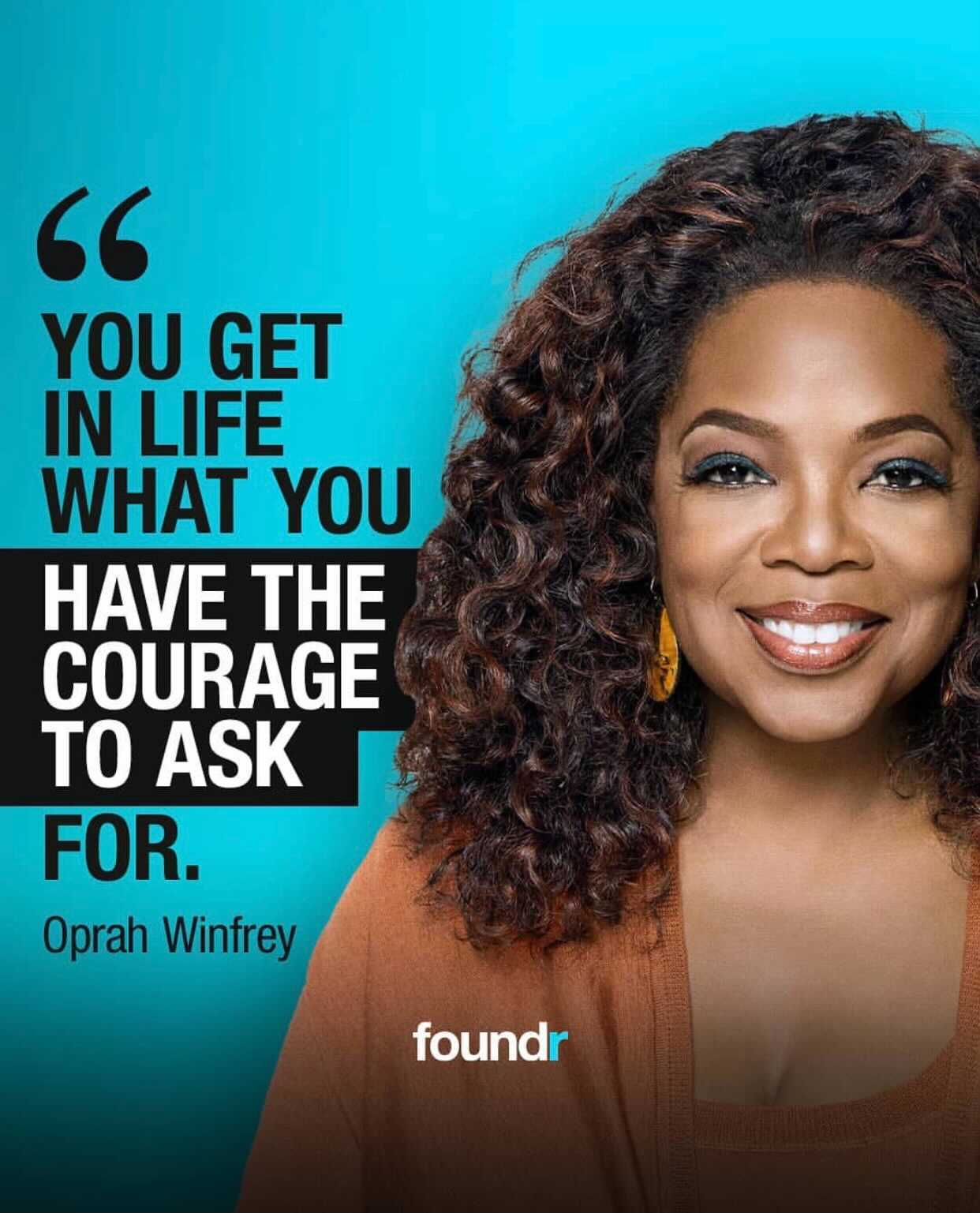
Ariana Huffington
Everyone has heard about J.K Rowling facing 12 rejections and bankruptcy before she got Harry Potter published, but an even more impressive example of tough perseverance is none other than Ariana Huffington.
It's hard to believe that the founder of The Huffington Post, author of 15+ books, and CEO of Thrive Global, and listed in Time Magazine's list of the world's 100 most influential people, Huffington would have a hard time selling a book to publishers.
But back in 2019, Huffington wrote about how she was once rejected by 37 publishers.
Working as a journalist with a single book published, Huffington was desperately looking to secure a publishing contract while living in London.
"I wouldn't call it despondent, but one of the low points in my life was when I was shopping my second book around. It ended up being rejected by, yes, 37 publishers. After the 25th rejection, I remember running out of money and walking, depressed, down St James Street in London, where I was living at the time, and seeing a Barclays Bank. I'm not sure why, but I walked in and asked to speak to the manager. And I asked him for a loan. Even though I didn't have any assets, the banker—whose name was Ian Bell—gave it to me."
Most people give up after one or two rejections, but even with a grand total of 25 rejections, Huffington put everything on the line (and more) and literally hedged her bets on future success by taking a loan.
This small loan from the bank was the little leverage she needed to keep going on her journey, and luckily her bets paid off (after even more rejections!).
"It wasn't much, but it changed my life because it meant I could keep things together for another 12 rejections, and finally an acceptance!"
If that doesn't take guts and self-belief, then what does. Instead of running from the fear, Huffington leaned into it by adding another level of pressure. If she didn't keep going, it would be for nothing.
READ MORE: How To Be A Better Public Speaker
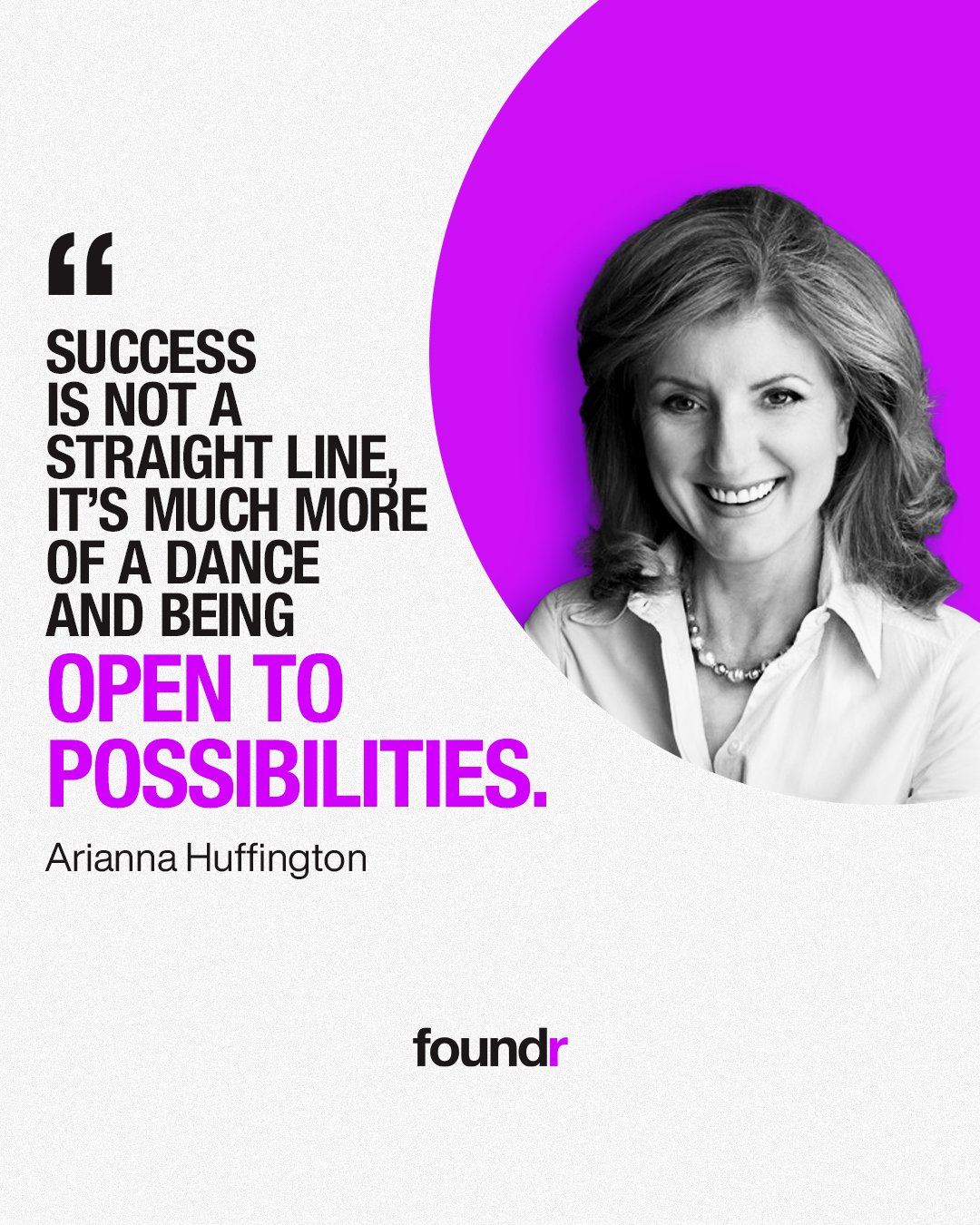
Jeff Bezos
One of the world's richest men, Jeff Bezos, wasn't born with a silver spoon in his mouth. Bezos didn't build his empire on a legacy or luck, he built his empire on his pure tough mindset and refusal to let fear take the reigns.
At a summit in 2017, Jeff was interviewed by his own brother to discuss what he credit's as the secret to his success, the "regret minimization framework".
Interestingly, Bezos started developing this framework around the same time he started building Amazon. Back in 1994, Bezos was faced with the decision whether or not to quit his comfortable Wall Street job to chase the internet boom of the 90s.
He says that he decided to step back from his day-to-day activities at work for a few days to just imagine what it would be like to start his own company.
In those few days, Besoz realized that while the threat of failure was loud, his determination to chase his dreams was louder.
"The best way to think about it was to project my life forward to age 80," and then take the path that "minimized my regrets."
Rather than give in to fear, he acted on this "regret minimization" framework and took the plunge.
With a net worth of $182 billion, it seems the risk was worth the taking.
When his brother asked him what he would've done if Amazon failed and never managed to make it beyond the garage, Bezos simply said "if it failed, I would be very proud when I was 80 that I tried."
Courage and overcoming fear are key components of mental toughness and grit, says Margaret Perliss for Forbes:
"The supremely gritty are not afraid to tank, but rather embrace it as part of a process…they understand that there are valuable lessons in defeat and that the vulnerability of perseverance is requisite for high achievement."
Bezos' framework is just that. It's embracing the fear and accepting the risk. It gives us a little insight into how one of the world's richest people approaches life. It takes courage to be able to block out the voice that says what if.If Besoz had listened to that voice if he'd stopped and worried about what could happen if he quit his job to hedge his bets, where would he be today?
Not with the title of "Richest Man In Modern History", that's for sure.
READ MORE: How To Stop Procrastinating And Smash Your Goals

Elon Musk
From building PayPal and SpaceX, to running "one of the world's most disruptive automobile companies", Elon Musk is a game-changer.
Musk is a key figure in entrepreneurialism and business for his relentlessness and his incredible memes. He has also suffered more failures and cost his company more money than we can even imagine.
While on a honeymoon with his wife, he was kicked out of PayPal. He has had three major failed Space X rocket launches that cost him billions, and multiple issues with the Tesla line to the point where the first model almost made zero sales. In 2008, both Tesla and SpaceX faced bankruptcy and has had multiple failed experimental drone ship landings.
When it comes to failing, and Musk is someone who has not only failed time and time again but failed with the consequences of billions of dollars lost, what does he say?
"Failure is an option here. If things are not failing, you are not innovating enough."
Every single one of Musk's new venture seems to be met with a chorus of naysayers, and every other day it seems that there are whispers of his empire crumbling. But Musk's mindset is focussed on the future, and there's no room for doubt or disbelief when you're that tough.
If we look to history, former President of the United States Teddy Roosevelt dubbed the "Grand Sire of Grit", once spoke about the importance of overcoming fear and managing vulnerability during his 1910 speech,The Man in the Arena:
"It is not the critic who counts; not the man who points out how the strong man stumbles, or where the doer of deeds could have done them better. The credit belongs to the man who is actually in the arena, whose face is marred by dust and sweat and blood; who strives valiantly; who errs, who comes short again and again, because there is no effort without error and shortcoming; but who does actually strive to do the deeds; who knows great enthusiasms, the great devotions; who spends himself in a worthy cause; who at the best knows, in the end, the triumph of high achievement, and who at the worst, if he fails, at least fails while daring greatly, so that his place shall never be with those cold and timid souls who neither know victory nor defeat."
Musk has dealt some pretty heavy blows, imagine how he felt watching that first rocket implode? But rather than taking a seat next to his critics, his mental toughness shines through as he continues to push his businesses into new territories, and literally into the cosmos.
In a Time Profile in 2013, Sir Richard Branson himself wrote that "whatever skeptics have said can't be done, Elon has gone out and made real." We're not sure if anyone specifically told Musk he couldn't launch his car into orbit while playing David Bowie'sSpace Oddityon repeat, but nevertheless, it's just one more boundary he's decided to test (and succeeded).
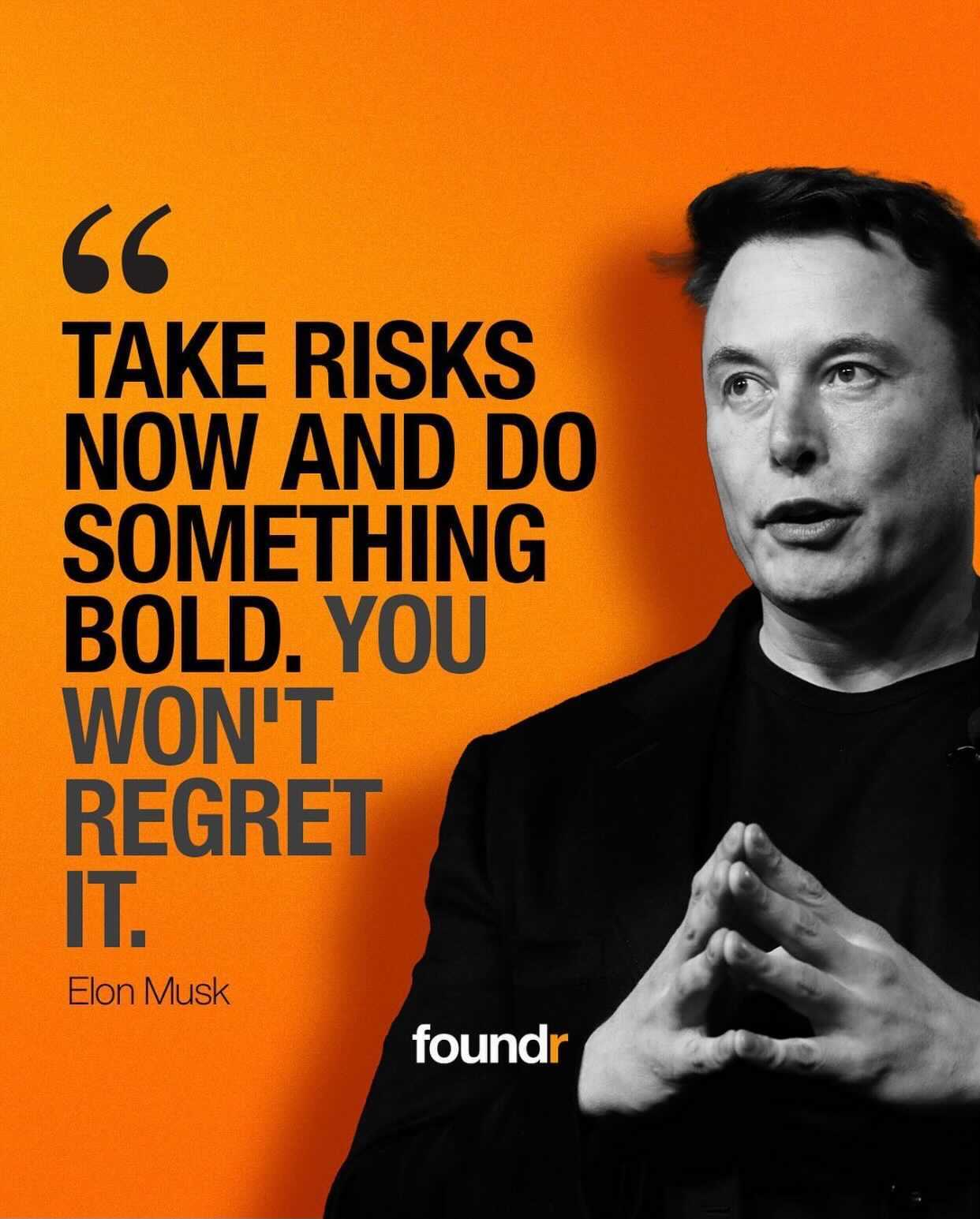
Sir James Dyson
You probably recognize his surname, and maybe you even have a few of his branded products lying around your home.
In school and college, Dyson found his love for interior design and furniture. This love was fuelled by a teacher who showed him the possibilities of combining drawings with the engineering of inventions and ignited the curiosity spark that we see so often in product pioneers.
Dyson began inventing.
His first invention, the "ballbarrow", was just a regular wheelbarrow with a ball in place of the wheel, but the concept led to the invention of a cyclone-like system for bagless vacuums.
Dyson became obsessive. Creating prototype after prototype until he could make it work. It took a grand total of 5,127 different prototypes over 15 years for Dyson to get a vacuum prototype that he could pitch to British retailers. All of which rejected the idea.
When asked about this period in his life by Forbes, Dyson says "I was living off the bank when I had the idea back in 1979. I had no money to start with; In fact, I was in debt, and had been ever since I was a student."
Nevertheless, Dyson's belief in his product eventually pushed him to launch the product through catalogs in Japan. The product became an instant success and took off on a global scale. All of Dyson's previous inventions fed into new ideas, creating hair styling tools, bladeless fans, hand dryers, even a Sea Truck that was picked up by the military.
In 2020 Bloomberg estimated his net worth to be reaching $27.3 billion.
So, what characteristic does Dyson have that helped him to push through decades of failure and thousands of failed prototypes?
Have a look at this excerpt from a 2006 interview:
"I wanted to give up almost every day. But one of the things I did when I was young was long-distance running, from a mile up to ten miles…I was quite good at it, not because I was physically good, but because I had more determination. I learned determination from it."
"More particularly, I learned that the moment you want to slow down is the moment you should accelerate. In long-distance running, you go through a pain barrier. The same thing happens in research and development projects, or in starting any business. There's a terrible moment when failure is staring you in the face. And actually, if you persevere a bit longer you'll start to climb out of it.
It takes a helluva lot of mental toughness to run a marathon, and it's that same toughness that keeps you chasing your dream.
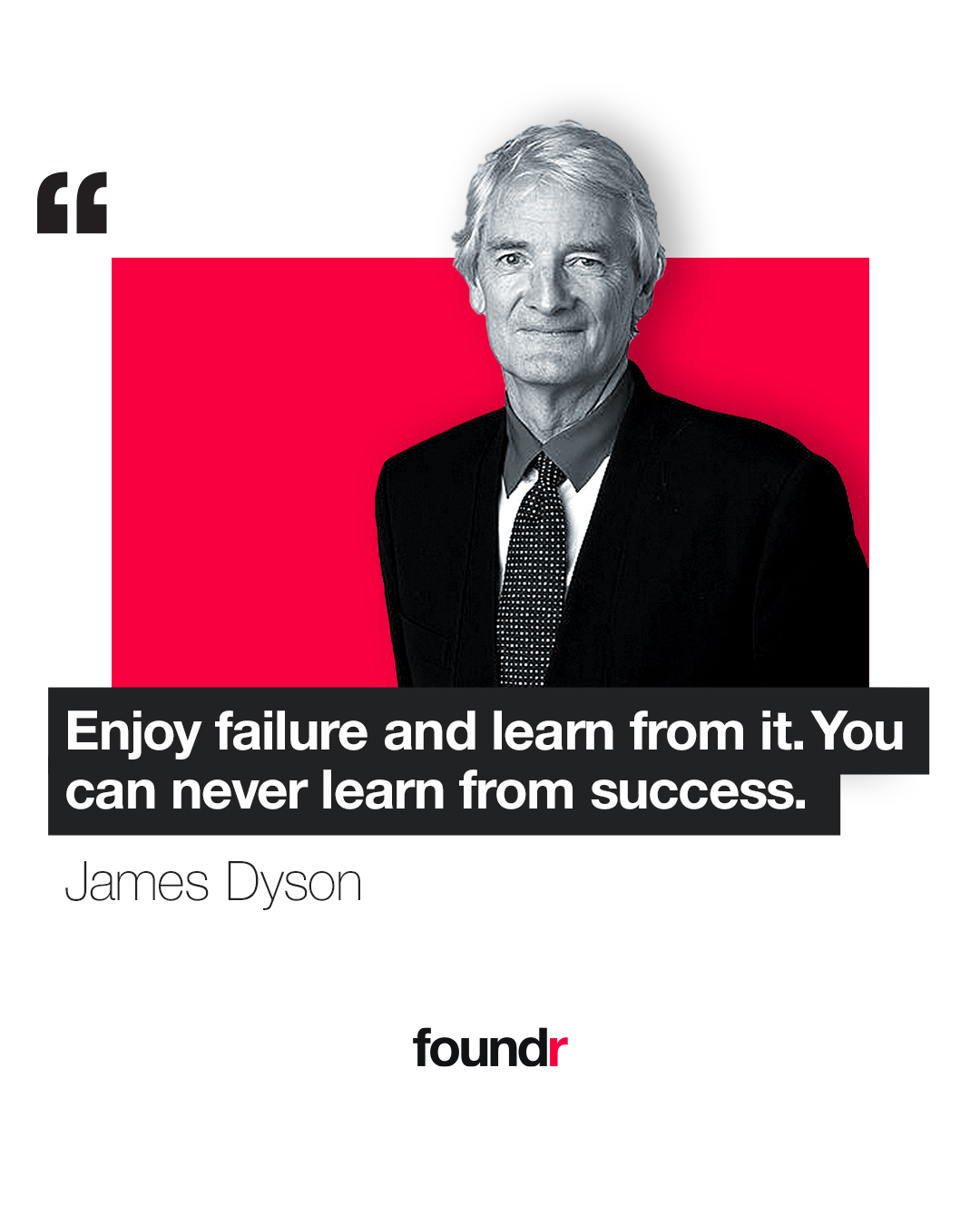
Sir Richard Branson
A cover boy of Foundr magazine, founder of the Virgin Group which now controls 400+ companies, and a net worth of $5 billion, and an actual knight, Sir Richard Branson is a lesson in dedication, perspiration, mental toughness, and a hardcore lesson in not taking yourself too seriously and staying the course.
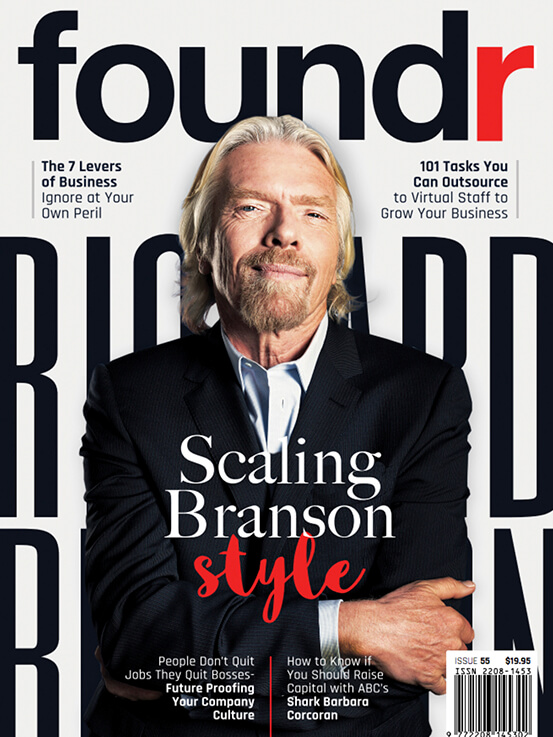 Branson's ability to overcome personal challenges is best framed by his struggles with dyslexia.
Branson's ability to overcome personal challenges is best framed by his struggles with dyslexia.
As a boy, Branson struggled so badly in school due to his dyslexia and even wrote a touching letter to his younger self in 2018, saying: "I know you're struggling at school and I wanted to give you some advice on how to become the best you can be, even when it's difficult and you feel like the world is against you. You should never see being different as a flaw or think that something is wrong with you. Being different is your biggest asset and will help you succeed."
Arguably the person who had the greatest effect on Branson's bold approach to life was his mother, Eve Branson.
When Branson was little, he and his mother were traveling home from a shopping trip when Eve decided to pull the car over and leave Branson on the side of the road. She gave him basic instructions on how to get home and drove away.
Branson was just 5 years old.
"[It was] about three miles through the countryside [to get home]" he says. "She was punishing me for causing mischief in the back seat, but she was also teaching me a larger lesson about overcoming my disabling shyness and learning to ask others for directions."
While we don't advocate abandoning anyone in the countryside, let alone a small child, the lesson Eve taught a young Branson a lesson of the importance of developing mental toughness.
When Branson was asked for his number one career advice for others, INC.com summarised his answer well:
"'Never look back in regret…move on to the next thing.' The best advice from one of the most successful entrepreneurs of all time has nothing to do with securing funding, or trending on social media, or hiring the perfect team…it's about mindset…"
Branson dropped out of school in 1967, at the age of 16, to start his first business, the now infamous: Student Magazine which almost sent him broke and forced him to pivot the company to a much more successful route: music. His mail-order discount record business was launched to support his magazine and eventually blossomed into the billion-dollar recording empire called Virgin Records.
From failure to failure, Branson has stayed true to what his mother taught him and stayed the path. Failed ventures included Virgin Cola (an attempt to take on Pepsi and Coca-Cola), Virgin Cars, Virgin Brides, Virgin Digital, and even the almost-catastrophic first flight of Virgin Atlantic Air which came close to crashing on its first flight.
"I can't count the number of stressful situations I've found myself in since I launched my first business over 50 years ago," he says. "Stress and business go hand-in-hand, and that's not a bad thing; high-pressure situations can certainly be motivating".
So, what's Branson's big advice to others who need a good dose of toughening up? "Screw It, Just Do It".

Howard Schultz
Most of us would probably panic if we realized we had somehow lost $60 in 3 hours. Now imagine costing your company $6 million in 3 hours during a global financial crisis.
If that makes you feel a little uneasy, you're not alone. But that's exactly what Howard Schultz did in 2008 to help reinvigorate a struggling Starbucks.
In 2008, mid-GFC, Starbucks' was facing a dilemma. Howard Schultz had left the company 8 years ago, faced with the global recession, plummeting stock prices, and a general perfect storm of chaos for a coffee chain, Schultz was brought back to the company to do what he does best.
"We were drifting a bit towards mediocrity and kind of losing our voice. I needed to come back," he said.
Jumping into the captain's seat of his beloved company again, on February 26, 2008, Schultz made the impossible and slightly eccentric call to close down its 7100 stores across the US to train its baristas and store managers on how to prepare a perfect espresso.
For 3 hours across the country, all Starbucks stores hung a sign that said: "We're taking time to perfect our espresso. Great espresso requires practice. That's why we're dedicating ourselves to honing our craft."
The company was already in a precarious position hemorrhaging money in an economy that was tightening its belt, and losing $6 million in 3 hours was a gutsy decision that naysayers would have scoffed at. Luckily, Schultz didn't listen to them, and the $6m was well-spent.
Schultz's dedication to brand values and personal beliefs is astonishing. Time and time throughout his journey, his mental toughness has allowed him to make difficult and impossible decisions based on his own beliefs.
Losing his company $6m has been described as an act of courage, and a "signal to the customers, partners, competitors, and media that the company would not settle for anything but the best, and change starts right at home. How many companies do you know of would take such a radical step for employee training?"
As of 2019, the company website reports a total number of 30,000 stores across 80 markets., and there's a running joke about a Starbucks on every corner of the globe. The company has had its ups and downs, scaling issues, and marker-oversaturation, but Schultz's commitment to retaining the company's core is the real story. It even became the byline for his aptly named memoir Onward: How Starbucks Fought for Its Life without Losing Its Soul.
Mental toughness is being sure of what you believe and never allowing anything to tilt your compass. It can be relatively easy to fix a company from scratch, but it is much more difficult is to retain its core and build around it. That takes guts.
And, Schultz's advice to budding entrepreneurs?
"Grow with discipline. Balance intuition with rigor. Innovate around the core. Don't embrace the status quo. Find new ways to see. Never expect a silver bullet. Get your hands dirty. Listen with empathy and overcommunicate with transparency. Tell your story, refuse to let others define you. Use authentic experiences to inspire. Stick to your values, they are your foundation. Hold people accountable but give them the tools to succeed. Make the tough choices; it's how you execute that counts. Be decisive in times of crisis. Be nimble. Find the truth in trials and lessons in mistakes. Be responsible for what you see, hear, and do. Believe."
Might as well be a to-do list for improving your mental toughness.
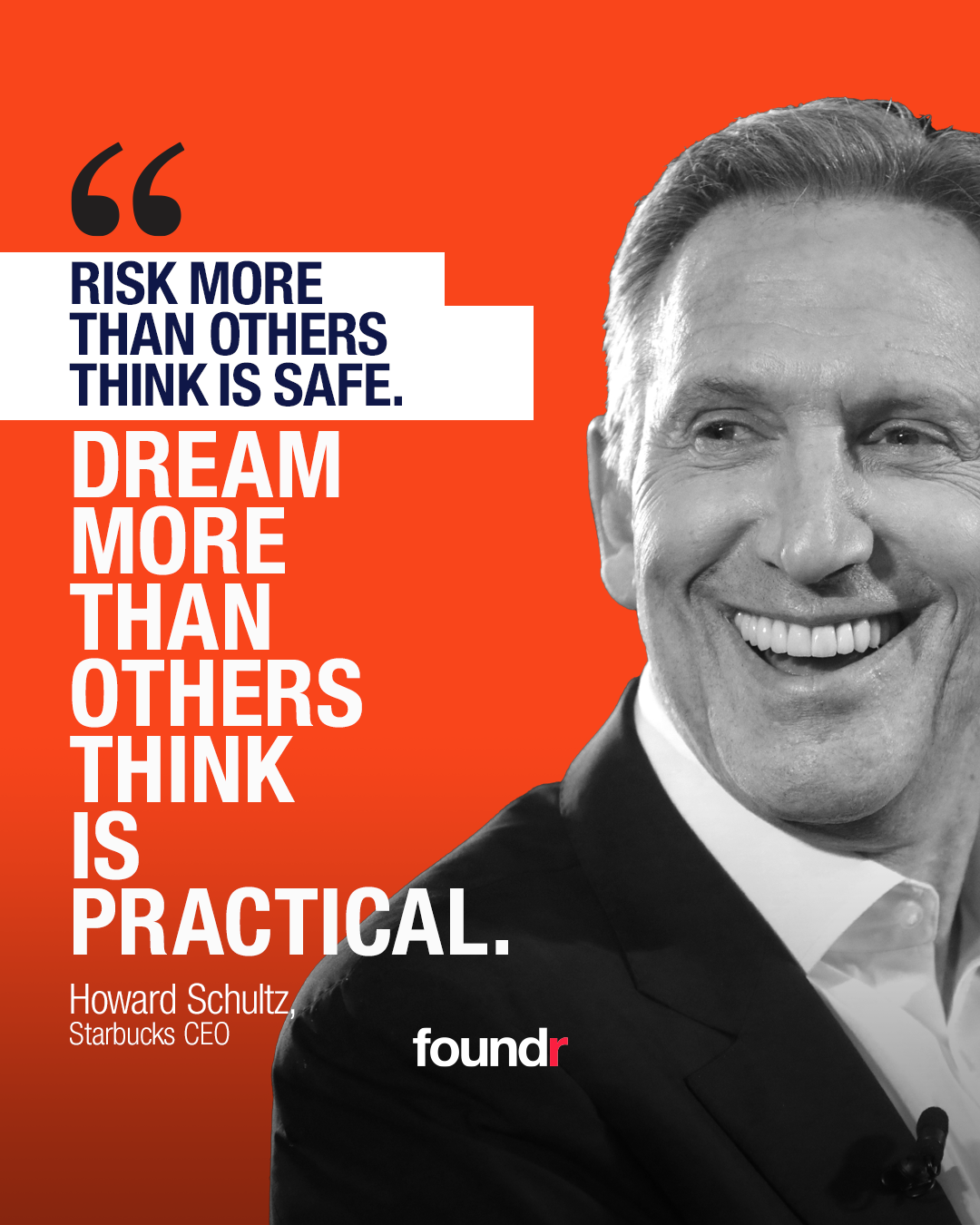
Joe De Sena
When the Olympic wrestling team needed to take their mental game up a notch, the coach sent them to Joe De Sena. When several billionaires found their kids on drugs and heading down the wrong path, they sent them to Joe De Sena. When the military needs to whip their cadets into shape, they send them to Joe De Sena.
Joe De Sena, Spartan CEO and author of the New York Times best-seller of Spartan-Up: A Take-No-Prisoners Guide to Overcoming Obstacles and Achieving Peak Performance in Life, might be the toughest person on the planet.
He has managed to rip 7 million regular people off the couch and pushed them past their limits to achieve "impossible" goals across 45 countries. He has completed over 40 ultra-endurance events including a 365-mile, 6-day race in Canada in the dead of winter, plus the Lake Placid Iron Man, The Vermont 100 (100 miles), and the world's toughest foot race, the Bad Water Ultra Marathon (135 miles in extreme heat and cold). All of this in the same week.
When a resume reads like the script of a Mission impossible film, you best bet that they have a bit of grit. But how does this unstoppable mindset translate to business?
The answer: pretty darn well. In fact, Joe De Sena is killing it.
In an exclusive interview with Foundr, and arguably one of our wildest ones to date (click here to listen!), Joe De Sena reveals the mountains of failure in business he's overcome over the years.
Back when the toughest man on earth wasn't hosting hardcore obstacle races, he was working a 9-5 with the dream of one day living on a farm and organizing tough events.
Working a job he wasn't passionate about, De Sena spent"I'm a big believer in 'fire, ready, aim'. So, I fired the gun and put on my first event…. and my first event was a disaster. But I just kept going. And I kept going and going, and I created the job I have now, from scratch."
That disaster that De Sena mentions during his first event was losing one of the competitors during the race, and borrowing Sir Richard Branson's helicopter to find them a week later marooned on a desert island. Imagine not letting that hiccup slow you down?
But most impressive is that De Sena and the Spartan brand did not turn a profit for the first 15 years. It's crazy to think that for 15 of the races he lost money on them—$8 million to be exact.
"Anyone in their right mind wouldn't have continued. But I don't like to quit because I'm a crazy person. I got so buried financially that I didn't have a choice but to make it work. And that's the difference between success and failure," De Sena says.
The ability to see challenges in the right perspective is a key component of mental toughness and something that the Spartan warrior has a good grip on.
The Spartan brand struggled in 2020, as did most companies globally, but it hasn't affected De Sena's mindset in any way.
Covid and the cancellation of multiple events and lost sponsorship forced De Sena and his company to furlough a lot of their employees, but De Sena puts it in perspective by comparing this struggle to soldiers in the Vietnam war.
"They would crawl for three days on the side of their body so as not to create a trail that the enemy would see to come after them. And I think [2020] is not that bad. It's bad, but it's not that bad."
Not many people can take physical beatings and financial hardship like De Sena and brush it off, but when it comes to being in business, De Sena says you gotta be prepared to.
"Everything that can go wrong will go wrong. And it's really going to be up to you and your reaction to those things. You're not going to change the environment. Bullets are going to be flying stuff's going to be going wrong, your competitor's going to take over some of your business, you're going to steal your best clients, your factory's going to burn down. You're going to run out of money, you're going to bounce checks.
"Everything that can go wrong will go wrong. And if you don't react to that the right way, you're out of business."
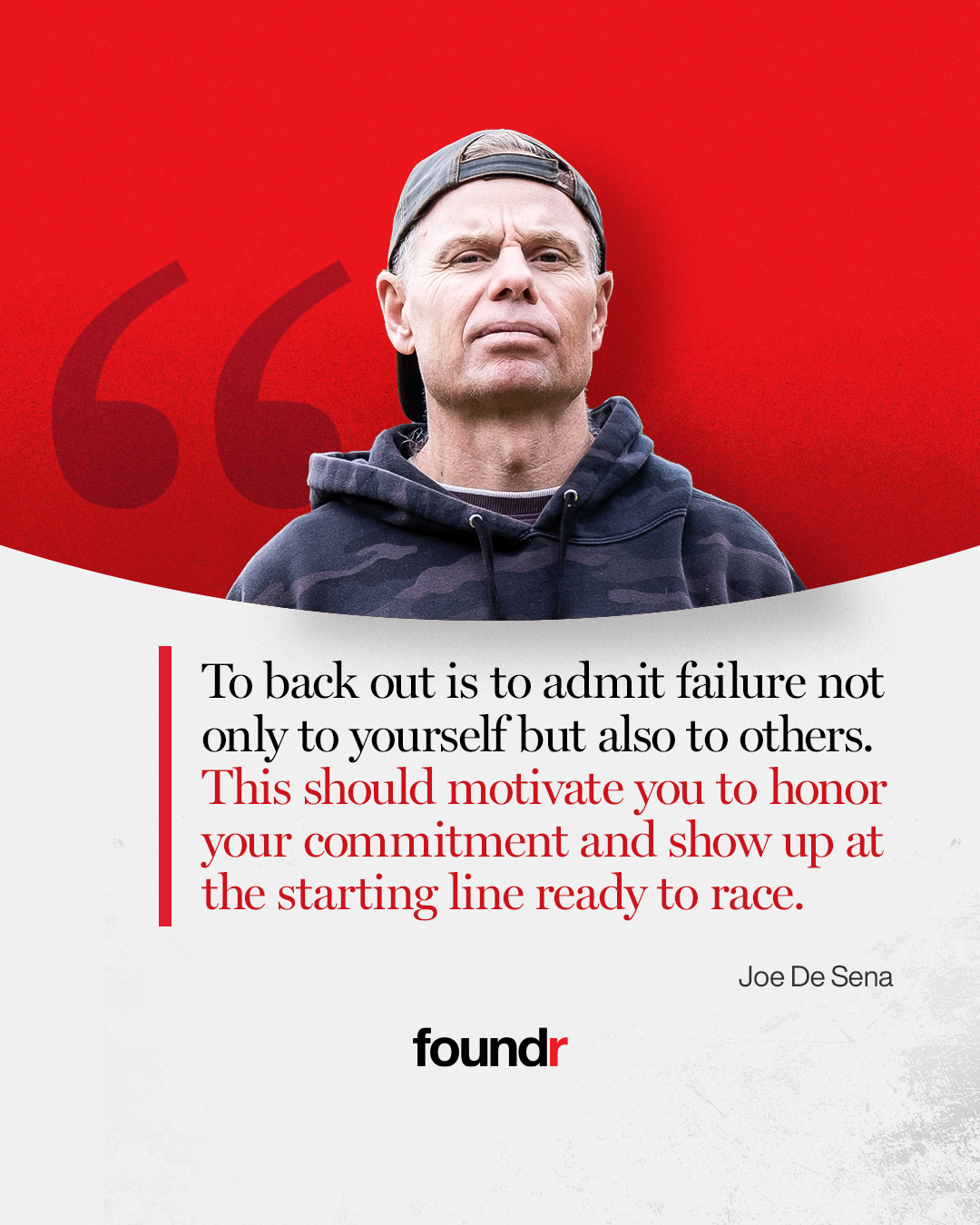
READ MORE: How To Win The Day The Spartan Way
In Summary
It's a strange thing when you realize the big secret to success.
We spend so much of our time assuming that our hero entrepreneurs are smarter than us, are more cunning, have some secret sauce to winning in business.
We think that the only way to reach the top is by being born with that special talent, that unique flair that sets you apart. You need to have the charisma of Oprah or the mad-scientist energy of Elon to get to where you wanna go.
You tell yourself that if you ain't got it, you ain't going to get anywhere.
But the proof is in the pudding when it comes to success: the way to get to where you wanna go is your mindset. You need that bulletproof mindset that allows you to keep pushing the boundaries, and ignoring the naysayers.
In other words, you gotta have that mental toughness if you want to be unstoppable.
If you want to become the best of the best, the toughest entrepreneur out there, and rise above the fear of failure, then Foundr's new course with none other than the man himself Joe De Sena is for you:
EXCLUSIVE FREE TRAINING: This New Free Masterclass Will Make You Unstoppable
Who do you think is the toughest entrepreneur out there? Let us know in the comments below.
The post How Oprah, Jeff Bezos, and Spartan's Joe De Sena Turned Failure into Success appeared first on Foundr.
]]>The post How to Stop Procrastinating and Smash Your Goals: A Psychology-Backed Plan for Entrepreneurs appeared first on Foundr.
]]>Maybe you took one of our premium courses. Maybe you've read all of our posts, and even a handful of bestselling business books. Whatever the case may be, you have the knowledge you need to get started.
But you can't seem to get yourself moving. You simply can't stop procrastinating.
There's always something that gets in the way of your goals—meetings with friends, hobbies, sports, not to mention your day job.
"Maybe I'm not cut out to be an entrepreneur, after all," you say to yourself in desperation.
Before you throw in the towel, hear me out. Regardless of the goal you're trying to achieve, you have the power to stop procrastinating—if you know how to structure your work.
No one is born with perfect motivation. What separates successful entrepreneurs from those who never do anything about their dreams is that the former know how to get moving and let their momentum guide them to where they want to go.
If you want to learn how you can stop procrastinating once and for all, this post is for you. I'll outline a simple master plan that will help you stay motivated and keep taking action, day in and day out.
Sound like something you need? Let's get started.
READ MORE: Join the VIP waitlist for Foundr's Most Awaited Course: Mental Toughness with Joe De Sena. WARNING: After this course… you will NOT be the same.
How To Stop Procrastinating
Procrastination is the act of postponing action towards a goal. It's when you feel restrained from doing something, despite the fact that you want to do it.
You want to go to the gym but you postpone joining one because "something" happens, so you never start and your goal of losing weight never gets checked off your list.
You want to start getting consulting clients, but you can't find the time to cold call prospects, so your consulting business never grows and stays a dream forever.
Procrastination isn't a weakness or a problem you have. It's perfectly normal to procrastinate. We all do it, even successful people. The difference is that the latter know how to avoid the root cause of procrastination.
So what it?
It's the fact you invest more weight into your present than in the future costs of your actions (or lack thereof).
Such is the definition that George Akerlof, the 2001 Nobel Prize winner in economics, explains in a famous paper on the subject.
Procrastination occurs when present costs are unduly salient in comparison with future costs, leading individuals to postpone tasks until tomorrow without foreseeing that when tomorrow comes, the required action will be delayed again. – George A. Akerlof, May 1991
When you feel like going to a friend's party matters more than working on developing a prospect list for your consulting business, or a supplier list for your ecommerce store, then you're putting more weight in the former than the costs of not doing the latter.
The keyword here is salience, that is, the act of placing too much weight on the things you can see and not on the ones you can't. You can see your friend texting you telling you how fun it's going to be; you can't see the money you haven't earned in six months by blowing off important work.
It's psychological myopia; a mental quirk of evolution that, sadly, we all have. We could get all anthropological and start talking about how our ancestors benefitted from such myopia when they were living in the African savannas 10,000 years ago, but we don't need to get into all that.
The fact is that you can't cure yourself of procrastination and you can't entirely solve this problem. But you can outsmart it by, among other things, playing in the direction of your psychology, gaining clarity of thought, and getting help from others to keep you from procrastinating.
In the rest of this guide, you'll take a look at each of these solutions in greater detail.
READ MORE: The Art Of Prioritizing: How To Pick Which Frog To Eat First
Outsmart Your Own Psychology
Procrastination can feel like a problem that's bigger than yourself. You can't control it; it just happens, and when you realize it, it's too late. While the previous definition explains the nature of procrastination, it still doesn't explain why you do it, so let's get specific.
According to a study by William J. Knaus, there are two possible reasons you procrastinate:
- You believe you are inadequate to do the task you're putting off
- You believe the world is too difficult and demanding
But wait, there's more!
Other studies have found a multitude of other reasons:
- You have a fear of failure (B. L. Beck, Koons, & Milgrim, 2000)
- You have a perfectionist attitude (Burka & Yuen, 1983)
- You have high self-consciousness (Ellis & Knaus, 1977)
- You're anxious (Schlenker & Weigold, 1990)
Procrastination is clearly a multi-faceted problem too complex to fix with a magic wand. Still, you can work on some of these issues one by one, depending on whether you actually suffer from any of them.
Let's take an example common among most entrepreneurs: cold calling. No untrained salesperson likes to cold call people; it's stressful and hard for anyone who's not used to getting rejected often.
It would be no surprise if you tend to procrastinate around cold calling. But if you know that a feeling of inadequacy could be the reason you postpone your cold calling, that's what you have to work on before you can stop procrastinating.
Take a deep look at this issue and ask yourself the following questions:
- Do you feel like you can actually cold call (or whatever it is you're procrastinating)?
- Do you feel you have the knowledge to carry out such a task?
- What's your immediate "gut feeling" cold calling gives you? Is it anxiety? Fear of rejection? Fear of failure?
- Are you a perfectionist? If so, could it be that your tendency of wanting to control everything is stopping you?
- How do you view the situation? Do you feel like it overwhelms you? Does it scare you?
Answering these questions will help you get a grasp on the psychological reasons you procrastinate. With these answers, now you can face each of these problems one by one.
If you feel like you lack the knowledge to cold call, then read a book, start a training program, or get a coach. If you're afraid of failure, reframe the situation to one of learning and skill acquisition. Talk to someone who's done this before so you can visualize and feel the realities of cold calling.
Your psychology exists for a reason: to give meaning to the world around you and to protect you so you can live your life with the most comfort possible. If you feel like it's preventing you from achieving something, then recognize it and play by its rules, but do it in a way that benefits you.
READ MORE: How To Win The Day The Spartan Way
Have a Clear Goal
If you have a goal, and at least a broad idea of what you need to do—like starting your ecommerce store or software business—but you lack the capacity to take action, you are procrastinating.
From there, you need to investigate whether you lack a clear and specific goal, which makes it much easier to procrastinate. It's not the only reason, but it's a big one that helps you avoid taking action.
The goal of "starting an online business" is more of a wish than a goal, sort of like wanting to make a million dollars. While such a broad goal can push you towards learning about entrepreneurship, you must get more specific before you can develop a plan to start that dream business.
A useful model you can use to improve the clarity of your goals is the "SMART" system, as explained by Steve McLeod, the instructor of our course Triple Your Business. In the course, he explains that a SMART goal is:
- Specific
- Measurable—it must have a number
- Achievable/accountable
- Realistic
- Time-bound
With this model, your goal of starting an online business could be defined as:
Launching your ecommerce store by January 1, 2020.
If you compare this goal with the previous one, you can see that it meets the S.M.A.R.T. attributes:
- It's specific – you want to launch a business by a date.
- It's measurable – you have a clear action to complete.
- It's actionable and accountable – "launching" connects with the idea of making your store live instead of "starting," which could be many things. You can also ask someone to keep you on track of achieving such a goal.
- It's relevant – it's connected with your broader goal of "starting an online business."
- It's time-bound – it has a specific date.
In order to stop procrastinating, you need to have a clear goal that motivates you into taking action, and the SMART model will be the first step to overcoming procrastination.
READ MORE: How To Stop Procrastinating And Smash Your Goals
Define Actionable Steps
With SMART goals, you will know exactly where you want to go. But you need something more tangible along the way. That's where putting actionable steps in place will help you avoid procrastination.
An actionable step is any task that you define that will move you into taking action towards a goal. If your goal is to launch your store by January 1, 2020, then a set of actionable steps that get you closer to the goal would be:
- Researching the best ecommerce platforms
- Opening an account with any of these platforms
- Installing a theme
- Defining a product to sell
- Writing the product description
Actionable steps are easy to identify because you can ask yourself whether you've done each of these steps and answer such questions with a simple yes or no. There's no in-between step around installing a theme; you either install it or not. Thus the step "install a theme" is actionable.
Actionable steps on their own, however, won't help you much if they don't connect with your ultimate goal of starting a business.
The key difference between defining actionable and useful steps from irrelevant steps is that the former stem from the goal, whereas the latter are randomly assigned.
A common process used in the business world is to reverse engineer your steps from the goal. In this context, reverse engineering means you break a goal into pieces and recreate it from scratch knowing how all the pieces (the action steps) will fit.
In the example above, the actionable steps I've defined are all tied together to the goal of launching an online store (it helps that I've launched one and am familiar with the steps required).
Take your SMART goal and break it down as granularly as you possibly can. Make each step SMART as well, so you can measure your progress and even get help from others.
Once you have all your actionable steps in place, it's only a matter of organizing them. A to-do app will help you put all your action steps in one place so you only need to open it and see what's next.
READ MORE: How To Be A Better Public Speaker
Measure Your Progress
Lack of motivation can be a sign that you have a perfectionist attitude or, similarly, have a strong tendency for self-criticism.
A study done by Shahar, Kalnitzki, Shulman, & Blatt (2006), found that people with high self-criticism tend to show lower levels of self-reported "present goal progress" and "future goal expectations."
Now, I know it's easy for me to sit here and write that you "should take it easy" and "be good to yourself." But let's be honest, no one criticizes themselves on purpose; it's a problem that runs very deep.
In order to overcome your own self-criticism, which is highly subjective, you can track the progress you make, which is highly objective.
If one of the main tasks of launching a business is to open a store with an ecommerce platform like Shopify or BigCommerce, then the fact you did that is an undeniable sign of progress. You can criticize yourself all you want, but once progress is made, there's no need for self-loathing. You've done it, and now you can start populating it with products.
Make a list of all the actionable steps you previously defined and add them to a spreadsheet. In the top row and leftmost column, add the task, and in the following columns, add a weekly date.
![]()
Assign each task to a specific date—you can set out to define your business name next week, buy your domain the week after, and open your store the week after that.
If you're inexperienced in most of the tasks you have on your list, assign a conservative date. You don't want to push yourself too hard and then watch yourself fail, which will demotivate you.
As you fill the dashboard, you will be developing a plan of action that will take you closer to your ultimate goal of launching a business (or whatever your goal is). Most importantly, you will be able to track your results and put yourself in a positive motivation loop.
The dashboard you'll be filling out is quite similar to Steve McLeod's (the instructor of our course Triple Your Business) "traffic light reporting system," which helped Foundr triple our growth in one year.
With such a dashboard, there will be no space for self-loathing and criticism—the progress will be right in front of your eyes.
READ MORE: The Science-Backed Qualities of Good Leaders – And How To Apply Them To Your Business
Get Accountable
Success rarely comes from working alone. There's a reason why almost all famous, successful companies had more than one founder.
Most successful companies, especially tech firms like Microsoft, Intel, Facebook, and HP, had at least two founders.
Not only did these founders tap into each other's strengths—Paul Allen's technical acumen and Bill Gates' business skills are one good example of such synergy—they also were able to use the other person as an accountability partner.
If you don't have a business partner, don't despair; you can still get an accountability partner and reap the benefits of having a co-founder, without actually having one.
There are many places you can look for an accountability partner, including:
- Facebook groups (including Foundr's)
- Reddit's entrepreneur subreddit
- Mastermind groups
- Local business groups
Look for people who are having trouble making progress and who need help. Search for potential synergies, like in the example from Steve Allen and Bill Gates. If you are experienced in marketing and the other person knows a lot about design, and both lack the other's skills, then both can help each other and, at the same time, keep each other accountable.
Eat That Frog
All the points shared above can help you keep yourself motivated. Eventually, however, you will have more food on your plate than you can handle. Your to-do lists will become filled with tasks and ideas. You'll likely get confused and overwhelmed. What do you do first? What's truly important?
There are many frameworks for prioritizing ideas, and the simplest one is to "eat the frog first."
According to Jack Canfield, a famous author and motivational speaker who came up with this concept, eating the frog mean that if you have two important tasks, start with the biggest, hardest, and most important task.
You can't and shouldn't do anything else until you've finished that task.
Each morning, start with that one task that scares you but will make all the difference in your business.
READ MORE: Join the VIP waitlist for Foundr's Most Awaited Course: Mental Toughness with Joe De Sena. WARNING: After this course… you will NOT be the same.
Call that business partner as soon as you open your computer.
Launch that promotional campaign right after you wake up.
Develop the financial plan that will help you model your future progress.
It won't be easy—no one likes to eat frogs, hence the name! But if you stick to it, you will develop the discipline it takes to become the successful entrepreneur you know you can be.
And you will never have to worry about procrastination again.
Now we want you to hear from you. What's something you're putting off today, and what will you do to stop procrastinating? Share your thoughts in the comments below!
The post How to Stop Procrastinating and Smash Your Goals: A Psychology-Backed Plan for Entrepreneurs appeared first on Foundr.
]]>The post The Art Of Prioritizing: How To Pick Which Frog To Eat First appeared first on Foundr.
]]>That quote is commonly, apocryphally attributed to Mark Twain, but whether Twain himself said it or not, it makes a lot of sense from a business perspective. The fact is, at the start of each day, we've all got a frog or two that we need to eat—those often unpleasant tasks that we really need to get done. But what happens when we've got more frogs than we can possibly handle? Which do we eat first?
When you're outnumbered by frogs, the only sensible thing you can do is to try and create order from chaos and learn how to prioritize. Believe me, I've tried all the alternatives, and the least painful solution has always been to just try and create some sort of semblance from the mess. But let's be honest…it isn't always a piece of cake.
READ MORE: Join the VIP waitlist for Foundr's Most Awaited Course: Mental Toughness with Joe De Sena. WARNING: After this course… you will NOT be the same.
Tip 1: Know the Difference Between 'Urgent' and 'Important'
When we started figuring out how to prioritize tasks, the first thing we found was that pretty much everybody had a different idea about what frogs they should eat first, and what frogs they should save for later on in the day. And this was the basis of the entire problem, that as a business we weren't able to properly get ourselves organized because we weren't able to agree on what tasks should take priority.
While prioritization is essential for organizing, the organising is also essential for prioritization. It's a bit of a chicken-and-egg scenario, and you can't really have one without the other. So the first step should always be to ensure that everyone is on the exact same page regarding what's a priority, and what isn't.
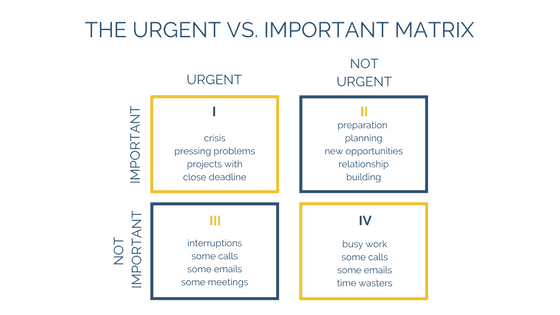
To do this, we used President Dwight Eisenhower's urgent/important matrix, which helps to separate the tasks that are vital to immediate business operations (the urgent) from the tasks that would help us to grow and develop, but wouldn't necessarily cause an entire office shutdown if not completed (the important). Once we had an actual guide to understanding what needed to be prioritized, we could stop procrastinating!
An important task, for example, might be creating your plan for the week ahead. Or planning your next social media campaign, which could be done at a later date without sacrificing a time-sensitive opportunity.
Although both are important and contribute to your goals, they don't need to be completed right now, or else. No one's gonna die.
An urgent task, on the other hand, might be an email that needs to be sent to an important client at the risk of losing them. Or, it could be a piece of copy that needs to be added to your website to coincide with a promotion that's just about to launch and ends within 24 hours. OK, no one's gonna die, but you will lose money if urgent tasks don't get done.
As you can see in the matrix, some tasks are both important and urgent, some are one but not the other, and some are neither. Once you understand the distinction, you'll find it easier to divide your tasks up and prioritize. To get into more detail on how to apply this priority matrix to your tasks, check out this in-depth guide.
But this is just part one of the process. In order for the urgent/important matrix to work, businesses need to stay organized, keeping track of the tasks that come in so that they can easily be placed into one of the four urgent/important boxes. One of the big problems that we had was that, although we knew how we were classifying tasks, they were coming in so fast that it was often hard to manage.
Josh Bersin, founder of Bersin by Deloitte, said that "with mobile phones, email, text messages, global teams, conference calls, social media, and pretty soon even watches talking at us, there is so much stuff coming at us, we are constantly flooded and can't get our work done, and we feel less productive than we were in the past."
That's something that we felt deeply and needed to sort out. We found that the best way to manage was by using collaboration software that offered a full task overview for whoever wanted to see it; it was important that we all had access to necessary information in order to prioritize tasks effectively.
Which frog should you eat first?: Eat the one that it makes the most sense for you to eat, based on importance and urgency. Eat the frog that you NEED to eat to survive. Not the one you WANT to eat because it tastes good.
READ MORE: How To Be A Better Public Speaker
Tip 2: Delegate Effectively
One of the first obstacles that we hit when learning how to prioritize tasks was that, before long, everyone had gone from having too many frogs to having too many urgent frogs, which meant that we were pretty much back to square one in terms of knowing which frog to eat first. This was a major concern, especially as research shows that increasing workloads are the biggest contributor to workplace stress.
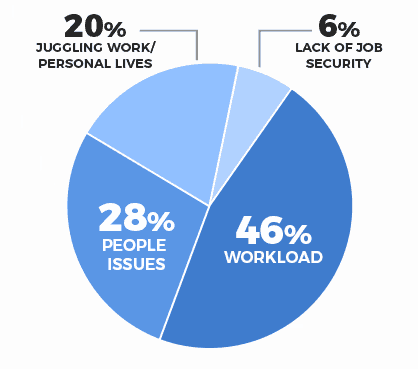
Effective delegation is essential in task prioritization, minimizing the "aaaarrrgghhh" feeling and making sure nobody on the team feels so overwhelmed that their levels of productivity suffer. But delegation isn't always easy, particularly at a time when flexible work policies are on the rise, and you can't always tell who will be available when.
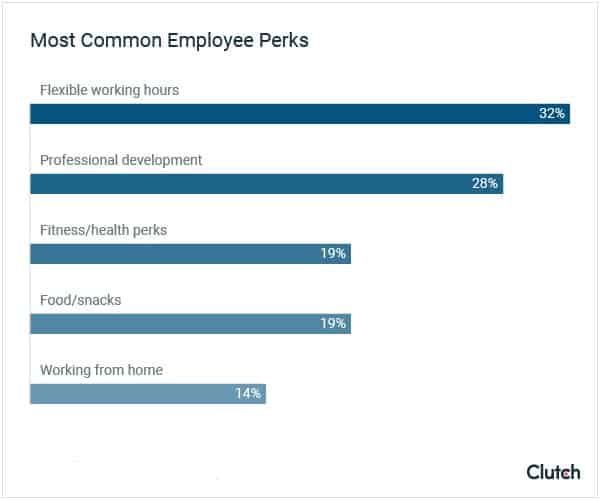 Source
Source
You need to take a look at your task list and ask yourself what tasks will slow you and your company down if you tackle them yourself, and which tasks will make the whole operation more efficient if you delegate them.
When deciding which tasks to delegate, ask yourself these questions:
- Which tasks are most urgent, and which ones are most important right now?
- Which tasks will cause me to procrastinate if I decide to tackle them?
- Which tasks evoke the most feelings of stress and anxiety?
- Which tasks will cause a bottleneck if I continue to work on them without outside help?
When high priority tasks cause you stress, and cause you to procrastinate, it's a smart idea to hand the reins over to a capable team member.
To delegate effectively:
- Establish who you should delegate a task to – Does an employee have the right knowledge and skills for this task? Or do they need to be trained up? Especially for important tasks that tie into your company's long term goals and values, make sure these goals and values align with individuals' goals and values. Even when you choose the right person, remember to be patient as the person you're delegating to learns and adjusts.
- Delegate with clarity – State the desired outcome. Explain why this task is urgent and/or important and clarify everything from accountability to responsibility. This is important because, while an employee becomes responsible for a task, you are still the ultimate authority. That said, it's important that you involve people in the delegation process. Remember, teamwork makes the dream work.
As a final tip here, it's worth mentioning that the delegation of tasks simply cannot happen if there is no sort of absence tracking system in place. Absence tracking is important because employees will get sick and take time off work. When this happens, those urgent takes that need completing may not get done. And suddenly, you're even further behind!
Effective absence tracking means complete clarity and transparency in internal communications, across the organization. After all, tasks can't be delegated if there's no one to delegate to, and if there's no delegation then you can pretty much wave effective prioritization goodbye.
Your tasks won't get completed on time, and all those efforts you've made to prioritize and complete them will be for nothing. Along with being prioritized by their urgency and importance, tasks must also be prioritized by whether they can be done.
Which frog should you eat first?: Why eat just one? Delegation essentially eradicates the need to choose just a single frog. With the help of a few other willing stomachs, multiple frogs can be eaten all at once!
READ MORE: How To Stop Procrastinating And Smash Your Goals
Tip 3: Organize Your Lists
So what happens when you've separated your urgent frogs from your important frogs, and you've given a few frogs away to other people, and you're still not sure exactly which frog to eat next? That's when creating a more detailed task list comes in handy. But this isn't just any old task list. This is a task list that includes all the available information about a particular task, helping you to determine if it's doable or not.
You see, there can be urgent frogs that still aren't ready to be eaten, so prioritizing based on urgency alone doesn't always work. The amount of information that's known about a task should also be taken into account.
For example, you may have an urgent task to edit a landing page on your website because some of the information is outdated and your customers are complaining, causing you to lose sales. But in order to complete this task, you need the third-party landing page software to make a change before you can edit it. Having this information attached to your list will help you better prioritize.
Starting a task—particularly an urgent one—without having all the information you need is an excellent way to ensure you make mistakes, and then have to start over from scratch. If an urgent frog isn't ready to be eaten, move it down the line until it is. It's as easy as that.
READ MORE: The Science-Backed Qualities of Good Leaders – And How To Apply Them To Your Business
How to organize your important and urgent tasks
So let's take a minute to talk about how to better organize your urgent tasks:
- Include two distinct parts – Any good task list should have two distinct parts: a to-do list, and a project backlog list. The to-do list should contain any urgent task that can be completed right now. The project backlog list should contain any important (but not urgent) tasks, along with urgent tasks that are waiting for additional information. Having these two lists helps to keep the team chilled out by allowing them to essentially filter tasks and only see what they absolutely need to see, leaving the less urgent stuff out of the way to avoid overwhelmed staff.
We found that there were lots more advantages to creating multiple lists (like a to-do list and backlog list), and it's a method we've fully incorporated into our workflow. Availability planning (planning when someone is available to do tasks) especially has been impacted in a positive way by creating backlogs, as we've been able to move both urgent and important tasks confidently to the "back burner," knowing that they can be dealt with by the most relevant people when they're available.
- Keep it simple – If you've got too many urgent tasks, it could cause stress and overwhelm. Take a closer look at those urgent tasks and see if you can slice them in half. The absolute high priority ones can be done today or tomorrow, while the rest can be shifted to a third list. Sometimes what feels urgent isn't always as urgent as you think once you see another task that seems more urgent.
- Make it helpful for team members – For the project backlog section, the last thing you want is a team that's scrambling around trying to gather all the required information. To this end, include as much information as you can right now, including the names of team members who have access to certain information, the numbers of people who need to be called, where certain information can be found, etc.
- Include time estimates – Even after you've trimmed your list down, a task list can still cause stress, anxiety, and overwhelm. To this end, it's a really smart idea to add time estimates next to each task. If your team has a general idea of how long a task will take to complete, stress levels go down and time management improves. The more you complete tasks, the more accurate your time estimates will be.
Visibility helps, too. Research by Deloitte suggests that almost three quarters of employees struggle to find information they're searching for on their company's systems. While the beauty of creating multiple lists is to prevent employees from seeing all information at once, it's still essential that they have access to this information as they need it in order to prioritize.
Which frog should you eat first?: Eat the frog that's ready to be eaten. There's no point trying to eat a frog that isn't yet "ripe," as it will taste much worse. Eat the one that's next on the "use by" date list.
READ MORE: How To Win The Day The Spartan Way
Tip 4: Play to Your Strengths
Now picture another scenario: You've got multiple frogs that are all equal, in every single way. Now how do you decide between them? At this stage, personal preference has to enter into the equation. Let's get back to the underlying message of the frog analogy. Essentially, the idea is to get the worst part of the day over with early on, leaving you with nicer tasks for the afternoon. It's a bit like eating all your vegetables first, leaving just the juicy steak left on your plate.
Personal strengths and preferences play a bigger role in task selection than many people think. So take a moment to consider what you love about your job, and which tasks fill you with dread. By completing the worst task at the start of the day, your mind is freed up, and you may be surprised at just how much a clear head can impact your levels of productivity. Mental health and wellbeing is something that we're beginning to focus on a lot more, so this has been a very important aspect for us to consider when we're trying to prioritize our tasks. Our motto: get it done, and move on.
Or, in other words—eat the ugliest frog first.
So how do you decide which is the worst task?
Define worst
What does "worst task" mean to you? It could be the hardest task, or it could be the least important. For some, the least important task is the one they procrastinate on the most, while for others the hardest task leads to procrastination. So you need to figure out the kinds of tasks you typically procrastinate on and put them to the front of the queue. Getting them out of the way first will create a huge relief and you'll be ready to kick ass all day long. Momentum will be built.
Choose your ugliest frog the night before
Don't wait until the morning to choose your ugliest frog because that itself will cause more procrastination and hesitation. Pick your ugliest, meanest frog before you go to bed and attack it ASAP in the morning
READ MORE: How To Win The Day The Spartan Way
Make it a habit
Make killing the ugliest frog first a habit. Pretty soon, you'll be so into the swing of things that you're getting more done than everyone else. Your team members, inspired by your enthusiasm, should hopefully follow suit.
Allow me to be completely honest here for a moment.
Even with the best processes for prioritization, we've still found that it's not always possible to do it all. Sure, we're getting through our urgent tasks, but there's still a number of important tasks that we're not meeting deadlines for.
And guess what…it's OK. One of the most important lessons that we've learned is that we need to be OK with letting things go. It definitely wasn't easy at first, especially for the perfectionists on the team. But by following these processes we know that as long as we're getting the urgent tasks completed, anything else is just gravy.
Which frog should you eat first?: Always eat the one you personally dread the most, leaving the nicer ones until later. And if you don't manage to eat them all, don't worry! The frogs are sure to be back again soon!
READ MORE: Join the VIP waitlist for Foundr's Most Awaited Course: Mental Toughness with Joe De Sena. WARNING: After this course… you will NOT be the same.
Learn How to Prioritize: Nothing is Set in Stone
Have I made the art of prioritization look easy? Well, I'm going to let you in on a little secret…it's not! In fact, choosing which frog to eat is more often than not one of the most challenging things you'll ever need to do in the workplace!
The problem, of course, is that there's really no right or wrong answer. The best frog for you to eat will often be a completely different one than what you competitor eats. It varies for each business. The best thing that you can do is to implement the tips I've shared above, and start coming to grips with some digital tools and software to help you stay organized in the workplace.
Overall, nobody can tell you what frog to eat. But we can share great advice that has helped us to become more organized and significantly boost productivity, resulting in better business processes, more motivated employees, and a well-defined avenue towards further growth and development in future.
Has this article helped you with prioritizing tasks or just made you want to try fried frog legs? What is your team's biggest issue when it comes to dealing with too many tasks? Do you have a priority list or decide on the go? Share in the comments!
The post The Art Of Prioritizing: How To Pick Which Frog To Eat First appeared first on Foundr.
]]>The post How To Win The Day The Spartan Way appeared first on Foundr.
]]>We set goals and resolutions for ourselves. We tell ourselves that this time, this time we are going to stick to those 6 am runs. We are going to start eating better, working harder, and finally start climbing our mountain. We are totally going to become a productivity machine that is made of pure grit and dedication so we can become the best entrepreneur we can be. A few days later, we lose motivation or slip up. And then before we know it, our goal is shelved untill next year (rinse and repeat).
But what if this time, things could be different?
What if this year, you managed to stick to your goals and achieve everything you wanted to? What if you managed to have that grit, that determination, that ability to wake up every morning one step closer to where you want to be in life?
After all, science says that failure doesn't come from the wrong choice of goals, failure is actually found in the path you take to reach those goals. You need to change the way you chase your goals, and the way you choose to chase your goals all comes down to mental toughness. After all, that's what separates a great entrepreneur from a good one: you need to be made of grit to be great.
So, how do you make that leap from good to great? Simple. You start winning the day (the Spartan way).
READ MORE: Join the VIP waitlist for Foundr's Most Awaited Course: Mental Toughness with Joe De Sena. WARNING: After this course… you will NOT be the same.
Meet Joe De Sena
If there's one person who knows about grit, it's Joe De Sena.
After making his millions on the stock market, De Sena moved to Pittsfield, Vermont to operate an organic farm, a bed and breakfast, and a general store for hikers. It was here that he found his passion for ultramarathons, adventure races, and endurance events. His racing resume is the stuff of legend – over 50 ultra-events overall and 14 Ironman events in one year alone.
Here, under the beautiful backdrop of Pittsfield, De Sena created what the BBC once dubbed the "obstacle race from hell": The Spartan Race.
De Sena has now made it his life's goal to tear 100 million people off their couches by creating the "Spartan lifestyle": a mindset that favors grit, commitment, consistency, and the Spartan warrior attitude.
If anyone knows how to get the most out of their day and finally smash those goals once and for all, it's him. And that's why Foundr is proud to say that our newest course instructor is none other than the Spartan-man himself, De Sena.
We sat down with De Sena to find out his secret to kicking ass in business, and how to become an elite entrepreneur before breakfast.
As De Sena says, "business is war, and I'm going to help you prepare for it… no matter what the day, you need to have your battle plan."

READ MORE: 7 Legit Methods to Teaching Yourself Any Skill
Why You Need To Win The Day
So, you might be asking yourself why you even need to attempt to "win the day".
You're an entrepreneur, you don't have time for this kinda stuff. You're busy writing emails and drafting projects, and the idea of winning the day seems like something completely unrelated to hustling.
But in actual fact, winning the day isn't the end goal. When you set up to win the day, you're building grit and mental toughness, and it's these skills that will propel you forwards in life.
De Sena has this to say:
"Entrepreneurs have a moving finish line – in fact, there is no finish line. You will continue to have these problems and continue to practice these things. They don't go away. This is life."
This is where entrepreneurs find themselves floundering and eventually throwing up their arms to say "I give up!" When they cross one hurdle and find another, they think they've done something wrong. The second hurdle shouldn't be there, you worked hard on the first leap, so where's the finish line? Where's your trophy?
"Entrepreneurs get trapped in their own heads," says De Sena. "And if you're in your own head, you're behind enemy lines."
This is why you're well-intentioned resolutions and goals fail every time: you're looking at the picture of a cake and trying to judge how much flour you need to measure out to replicate it. Without the recipe and the right steps, you're not going to be baking a cake anytime soon.
READ MORE: How To Stop Procrastinating And Smash Your Goals
The Secret Recipe To Success
De Sena has created and honed the "secret recipe" to success: the mindset blueprint that will take your life from zero to hero.
This blueprint will take you through a series of tests, and it's these tests that are going to help not only your mindset and attitude to life exponentially but also your business.
De Sena cannot stress this more: "This is what business school should be teaching".
With this blueprint in place, you'll begin to notice that you're changing for the better. Suddenly, you've got more:
- Drive
- Clarity
- Focus
- Positive mood
- Perspective shift
- Energy
This blueprint is what will help you win the day. And, when you win the day, you go on to win the week. Then the year. And then: you win at business.
"To win at business," says De Sena. "You gotta treat yourself like an Olympian."
Olympians don't just practice once a week. They don't do an intensive 3-day training course in 100m sprints and then go on to win gold. If it was that easy to be the best, everyone would be signing up for a weekend intensive and coming home with gold. Good days and bad days, they show up for training, whatever the weather.
This is where entrepreneurs often slip up. They let one bad day derail all their future goals.
When it comes to not winning the day, we've all been there before.
It's that sinking feeling when we climb into bed. That little voice whispering that if only we were mentally tough enough we could've done better work. If we had the discipline, we would've done better.
"When we have a day where we didn't win," says De Sena, "we often fall into a downward spiral."
De Sena is here to show you how winning your days, even just winningsome of your days is what will get you back on track to achieving your goals.
How To Eat An Elephant
"Somebody said to me years ago: how do you eat an elephant?" says De Sena. "Well, you eat an elephant one bite at a time."
Don't worry, De Sena is not advocating breaking into a zoo to eat the elephants anytime soon.
What he is a big advocate for is focussing on the first step on the ladder rather than the top of the roof. Stop looking at the top of the ladder and spiraling yourself downwards because you can't yet reach that top rung.
Nadia Goodman of Ted says that we have the tendency to "fixate on that magical ending when we've reached the goal and everything is better…" and that instead "we have to inch toward them, one choice at a time".
That's why the Blueprint is so crucial. It is the key to helping you to nail down your first ideal day.
"Focus on winning one day, and then before you know it you've nailed your week and then your year," he says.
One bite at a time, one day at a time.
READ MORE: How To Be A Better Public Speaker
Joe's Blueprint For Winning Every Day
1. Reflect And Plan
Winning the day starts the night before.
Before going to sleep, jot down a quick list of the things you have to do tomorrow. Make this list as long as you want, as short as you want, but make sure you list everything.
A study by professors Baumeister and Masicampo from Wake Forest University showed that "while tasks we haven't done distract us, just making a plan to get them done can free us from this anxiety."
De Sena says that it doesn't matter how late it is in the night, doesn't matter how tired he is, he always makes his list.
Referencing a study by Dr. Gail Matthews in a 2015 study by the Dominican University of California, De Sena says that:
There is a "42% likelihood of achieving your goals if they're written down", which is incredible. Just think about that: your goals are made 42% more achievable just if you write them down in a to-do list.
If jotting down every task for the morning ahead seems too stressful, an easier way to begin making these lists is to answer the following:
- What can I improve on tomorrow?
- What did I achieve today?
- Did I face any blockers?
- What are my top 3 priorities for tomorrow?
Use a Note app on your phone, scribble the answers down on a scrap of paper, even write them on your hand (if you're sure they won't rub off during the night). Just get tomorrow's battle plan nailed down before you sleep.
READ MORE: How To Create The Perfect Founding Team
2. Nourish Your Body
De Sena says you need to "nourish your body to nourish your mind".
Think of your body and being like your engine. You gotta get that engine running at maximum efficiency to perform at an elite level. The blueprint to nourishing your body is to:
Wake-Up Early
We're not your parents giving you an early bedtime, but we are going to emphatically remind you that you need to get to bed on time.
De Sena says "early to bed early to rise makes us wealthy and wise."
De Sena is in good company with this one.
There's a reason why successful people wake up before the sun.
By waking up early, you'll be giving your body the time to wake up before you start your workday.
BusinessInsider says that if you roll out of bed every morning at 8:30 am and start working at 9 am, you're not giving yourself the chance to be alert. "Getting up early gives your body a chance to reach peak wakefulness naturally (which means you won't have to depend on that triple shot of espresso to do your thinking for you)."
Studies have shown that night owls are often suffering from some form of sleep disorder. Their bad habits take over, and soon they can't identify with anything other than waking up minutes before they have to be at work. You probably know of, or you probably are one of those people who constantly tell others how you "couldn't imagine getting up early for work!" or that your brain "doesn't start functioning until after your 11th coffee!"
The good news is that none of that behavior is biological, it's all habit. And habits can be broken to give way to new and healthier habits.
The easiest way to break this cycle is to start thinking like a Spartan, and waking up to your early alarm. No snooze, no excuses, nothing. The way to get that elite early-bird sleep pattern is not by going to bed early, it's by waking up early. And then staying awake that entire day (no napping!).
Come nightfall, you'll naturally fall asleep earlier.
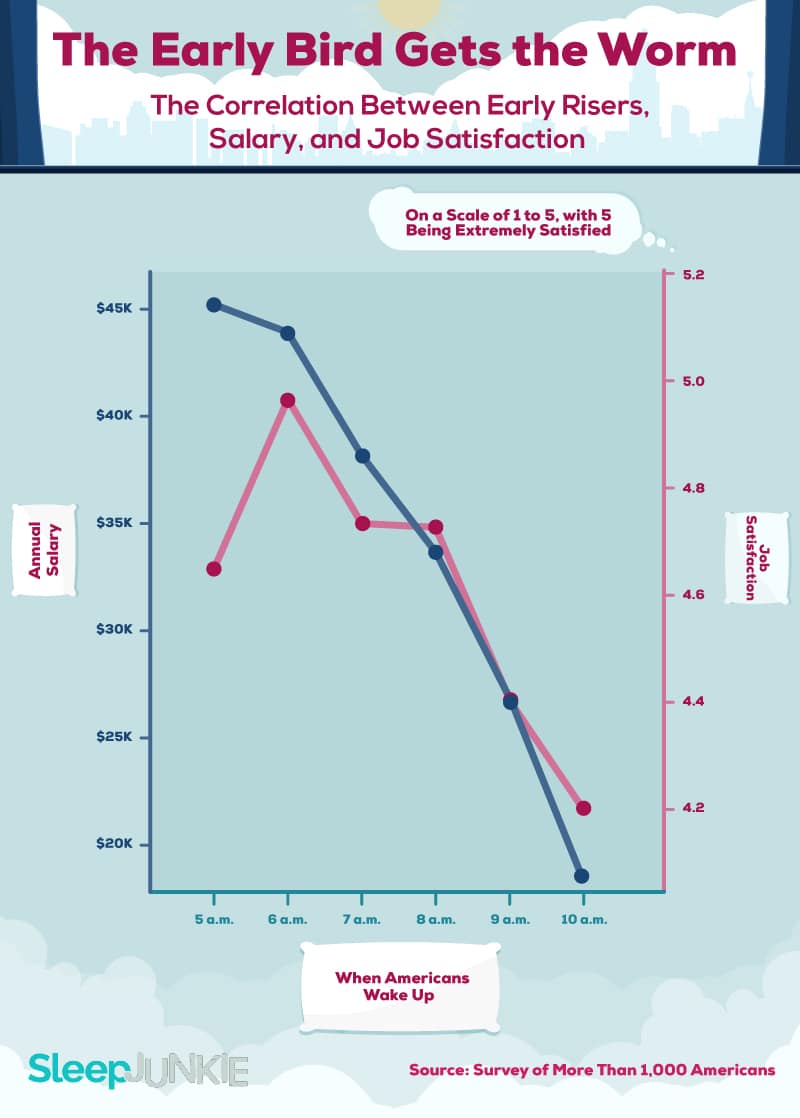
READ MORE: 4 Online Business Ideas to Consider During a Pandemic
Drink a lot of Water
After you've climbed out of bed, immediately drink 2 big glasses of room temperature water (not including your coffee or tea) which De Sena notes will lead to an increase in brainpower.
In an interview, renowned nutritionist and the author of "The One One One Diet" Rania Batayneh, MPH, supports this concept of a water brainpower boost.
"One of the biggest indicators of lethargy or low energy is that you are dehydrated," Batayneh says.
"After a long period without anything to eat or drink, the first thing you consume in the morning can be a shock to the body. If that first thing is…water, it will get the body working and can boost your alertness and low energy levels," she says.
Remember: you can't conquer the day if you're dehydrated.
Hydration is one of those essential habits that people tend to skip over. If you're someone who struggles to hydrate consistently, these 2 glasses in the morning will help set the table for a life-long hydration habit. Aside from mental clarity, water has these added benefits for the body:

READ MORE: The Science-Backed Qualities of Good Leaders – And How To Apply Them To Your Business
Break a Small Sweat
"If the body is not healthy and not performing optimally, then the brain is not performing optimally."
De Sena says that the key to success is to sweat in the morning and to think of it as earning your breakfast.
Start off your day with 10-15 minutes of any kind of exercise. This can be anything from some push-ups, yoga, a quick HIIT session, or even just a brisk walk around the block. Any exercise is fine, says De Sena, as long as you break a sweat and your heart-rate goes up.
Even if you plan to do a bigger workout later in the day, it's those 10-15 minute sweat sessions in the morning that will help you win that day.
Studies have found that after just a 10-minute workout, your brainpower is boosted for a short time. In this study, researchers found that participants that rode a stationary bike at a moderate pace for 10 minutes managed to answer questions 50 milliseconds faster than they did before exercising.
That's a neat 14% increase in cognitive performance, and all it takes is a little morning sweat.
READ MORE: 28 Successful Founders Share Their Advice on How To Start a Startup
Take an Ice-Cold Shower
After your workout, you're going to have an ice-cold shower.
If the thought of having an ice-cold shower has you shuddering with disgust, you're not alone. De Sena knows that this is the least pleasant part of the blueprint:
"Ice-cold shower: it's going to suck. You're going to kick and scream. But you gotta do it".
From a scientific standpoint, a cold shower in the morning will help your blood to draw away from the skin and rush towards the brain and other vital organs. It also activates the sympathetic nervous system and increases beta-endorphins and noradrenaline in the brain.
In layman's terms, a cold shower puts minor stress on your body. Minor stress is essential for human health, whereas excessive stress is not.
An ice-cold shower in the morning is going to be pretty brutal, but as De Sena says, "it's gonna kick start your day".
READ MORE: Psychographics 101: Everything You Need to Know; How It's Used in Marketing
3. Prioritize & Execute
Take The Top 3
Now that you've got that cold-shower out of the way, you're going to get started on your priority list. Those top 3 priorities that you listed out the night before are going to be your sole focus. Tackle those top 3 priorities, and then later tackle the smaller tasks.
De Sena uses this analogy to help you understand why you need to tackle the big stuff first. While you're invigorated from your early morning workout and cold shower, tackle the big things you don't want to do.
"If you're looking to fill a bucket with as many rocks as you can, you put the big rocks in, and then you fill in the voids with the little rocks."
De Sena uses himself as an example. Something he doesn't enjoy doing is anything to do with finances ("It's like nails on a blackboard for me").
So, what does he do? He tackles it first thing in the morning after he gets out of the shower.
Attack those three priorities, and the rest of the day will be a breeze.
4. How To Become Consistent (Or Get Back on Track)
Assume your priorities are essential and non-negotiable
Remember: the key to success is consistency.
The one thing that ultimately helps elevate all your efforts and smash goals using this blueprint is consistency. Taking what you've done on day one, and repeating it day after day until it becomes second nature.
The way to hit that level of seamless consistency De Sena says is to assume that everything is a must-do.
This is where that Spartan mindset comes in. You need to start telling yourself that the list is non-negotiable. When there's no room to wiggle, there's no give.
"We are trying to build world-class businesses…we need to start training like world-class athletes".
For example, if you made a promise to yourself to start the day by reading 10-pages of a self-help book, you cannot start dropping back to 8 pages a day or even skipping some reading days. It's these little allowances that will inevitably lead to a downward slide.
If you start allowing your priorities to become negotiable, they quickly become optional.
READ MORE: What These 4 Startup Case Studies Can Teach You About Failure
Imagine the Outcomes of Different Consistency Levels
This one requires a little moment of reflection and imagination, but it will help you to decidehow you want your future to look.
Start by taking stock of your current levels of consistency.
Using your current levels of commitment to your goal as an example, how close do your future goals look?
Let's say you want to learn Mandarin so you can communicate better with international manufacturers, so you commit to 30 minutes of practice every morning. How well can you see yourself confidently chatting with someone if you decided to only practice for 20 minutes a day? What about 5 minutes? What about if you barely did any practice at all? You'd spend most of the calls in silence, probably silently cursing yourself for not learning how to say "how are you?" in Mandarin.
De Sena is a good example of someone who doesn't just do half-ass commitments. You can't be someone who inconsistently goes for morning runs, and then just assume an ultramarathon is on the cards. De Sena succeeded in all his races and competitions because he set himself up for success by being highly consistent.
Keep consistent by reminding yourself that the effort put in now will equal a more guaranteed success in the future.
READ MORE: 3 Ways to Express Gratitude to Your Team
The Olympic Mindset Hack: Commit to Doing Small Portions
The Olympic mindset hack is an easy one: when you don't feel like doing what you're supposed to be doing, commit to a small portion of it instead. You'll often find that once you start doing the task, you'll slowly find the motivation to keep going and suddenly you've completed the whole thing.
Every morning, De Sena does his ritual of 300 burpees.
"When I don't feel like doing my 300 burpees, I say 'alright, I'm just going to do 10 burpees'. And then those 10 burpees lead to 20, and into 30. And before I know it, I've done my 300".
The great advantage of committing to small portions is that even if that motivation doesn't kick in, at least you can say you've done something.
De Sena says that "something is better than nothing… if you only do 40%, 60%, then that's better than nothing."
Even if you only make it 10% of the way, the worst thing you can possibly do is tell yourself that because you didn't hit 100%, you should give up.
Entrepeneur.com has a great analogy for when it comes to slip-ups or failure: "there are 260 workdays a year. Consider a car salesperson who sells four or five cars a month. At 48 sales a year, she "fails" the other 212 days. Similarly, a realtor may sell two houses a month, or 24 in a year, which means he "fails" more than 90 percent of the time."
When it comes to winning the day, week, month, or year, you'll find that it's easier to continue a winning streak than it is to get out of a rut or start again.
Take that 10% achievement, and tell yourself that tomorrow you'll double it.
READ MORE: Join the VIP waitlist for Foundr's Most Awaited Course: Mental Toughness with Joe De Sena. WARNING: After this course… you will NOT be the same.
Key Summary
Start winning tomorrow by starting today.
Joe De Sena is living proof that commitment, grit, and an Olympic mindset starts with the right battle plan. After all, business is war, and to win in war you need a plan.
By adopting the Mindset blueprint into your everyday routine, you're already setting yourself up for success. Start by jotting down tomorrow's to-do list the night before to obliterate any chance for anxiety or forgetfulness to take over. When you write it down, you're making a commitment to yourself that is like a legally binding contract, especially when it comes to your crucial top three tasks.
Get out of bed early, whether that's before the birds or the sun, and get your blood pumping with some exercise and a cold shower. The top 3 tasks you set for yourself the night before will be easier to smash out first thing in the morning, and once they're out of the way you can focus on the smaller pebbles in your bucket.
As De Sena says, "if you're on a hike and you find yourself going off track, do you lie down and give up? Do you start walking in a completely new direction? No! You put one foot in front of the other, and you keep going. Doesn't matter how fast or slow you go, the most important part is that you keep on walking".
So, does winning the day like a Spartan mean you have to go from zero to 300 burpees before breakfast? For De Sena, that's exactly what a winning morning looks like. But for you, it means taking one step at a time, every day, the same way, until you get where you need to go.
Don't worry about eating the elephant in one go. Instead, fix your mindset: one day at a time, one bite at a time.
The post How To Win The Day The Spartan Way appeared first on Foundr.
]]>The post What These 4 Startup Case Studies Can Teach You About Failure appeared first on Foundr.
]]>Failure hurts.
Watching something you've poured endless amounts of time and energy in, only to see it crumble before you will hurt like hell. It'll be like a physical punch to the gut, and it will paralyze you. It's no wonder that entrepreneurs avoid failure like the plague.
A startup can go under for a variety of reasons. While founders can stand around and point fingers at each other, attribute it to forces outside of their control, or just blame bad luck. The reality is that startup failure is from a refusal to acknowledge problems until the ship is already sinking.
The reality of the situation is you are more likely to fail than you are to succeed. If you're defining startup failure as the inability to deliver on the projected return of investment, then 95% of startups are failures.
But there is no greater teacher than failure.
If you're going to be an entrepreneur then you better get used to failing, it will become an inevitable part of your life. Don't run from it, embrace it, and see what lessons you can learn from it.
By analyzing the post-mortems of various failed startups here are the expected and not-so-expected reasons why they failed and what you can learn from their mistakes. Watch out for those icebergs.
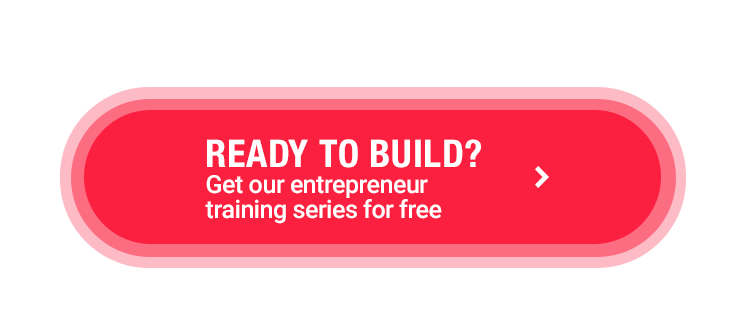
Be Wary of the Pivot

Fab was once known as 'the world's fastest-growing startup' and was valued at over at $1 billion before it ultimately crashed.
Fab underwent a variety of changes from an LGBT social network, to a daily flash sales site, to 'the world's design store', before finally being sold off to PCH, for a reported $15 million in cash and stock.
Fab is both a success story and a cautionary tale to entrepreneurs about the risks of pivoting. A pivot generally means that a business is looking to find a fresh perspective and vision to prevent itself from growing stagnant.
Hypothetically a startup should constantly be evaluating data: measuring the market, contemplating new strategies, testing new products. A pivot allows a business to forge ahead in a new direction when either the opportunity is clear, or the current strategy is failing.
"Once we made the decision to pivot, we committed to doing one thing and doing it well. No distractions." – Jason Goldberg, cofounder and CEO of Fab.
Fab was originally known as Fabulis an LGBT social networking site before pivoting wonderfully into a daily flash sales site for independent artists. Cofounders Jason Goldberg and Bradford Shellhammer admitted to themselves that Fabulis wasn't turning out to be the success that they hoped, being stuck at 150,000 users for the last few months. It was time to pivot.

The data they had gathered from Fabulis illuminated a real hole in the design market. People were looking for an easy and accessible way to purchase unique and interesting designerwear.
So, they pivoted and became a daily flash sales site for designer housewares, accessories, clothing, and jewelry. The move paid off with Fab growing to over 10 million users and reportedly generating more than $200,000 every day.
Two years later after the initial pivot, despite a shaky business model, Fab decided to pivot again. This time looking to become a designer alternative to Amazon and IKEA. Coupled with a failed attempt to expand into the European market, Fab began its spectacular fall.
READ MORE: Is Your Business Not Making Enough Money? Here's How to Fix It
The first and foremost requirement for a pivot to truly succeed is it must solve a major problem. At the time Fab was a hugely successful company, despite the fact that the daily flash sales model wasn't sustainable in the long-term, choosing to drastically scale down their product offerings moved too far from their identity as a designer store. Fab ultimately created another problem while prematurely trying to solve another.
It's only natural for a struggling startup to pivot, especially when the alternative is to remain stagnant and unprofitable. However as Fab demonstrated, pivoting for the sake of pivoting, or to expand on a shaky business model will almost always guarantee disaster for any entrepreneur out there. No matter how much money you've raised.
READ MORE: How Competitive Collaboration Can Boost Your Business
Too Ambitious, Too Fast
 Webvan was the biggest flop during the dotcom era of startups.
Webvan was the biggest flop during the dotcom era of startups.
At its peak, in 1999, it was valued at $1.2 billion. Two years later they filed for bankruptcy, laid off 2000 employees, and closed up shop. Webvan could potentially be considered a startup ahead of its time, their vision was a home-delivery service for groceries, where customers could order their groceries online, but that's not where the problem lies.
15 years later it's still being studied by business schools around the world as a forewarning against excess and ambition.
Webvan can also be considered a product of its time, the result was that it followed the 'Get Big Fast' (GBF) business model that every other startup was religiously following at the time. In 1999 Webvan announced they would expand to 26 major cities.
The following two years became a logistical nightmare with Webvan ultimately losing a total of $830 million before filing for bankruptcy.
"Webvan committed the cardinal sin of retail, which is to expand into new territory before we had demonstrated success in the first market. In fact, we were busy demonstrating failure in the Bay Area market while we expanded into other regions," said Mike Moritz, former Webvan board member, and partner at Sequoia Capital.
READ MORE: How to Make Money With Your Email List
At some point, every successful startup will have to start scaling up and expanding their business. It seems like common sense, but expansion should only be undertaken when a business model has first proven to be successful.
A few rules of thumb are that a scalable business model should be flexible to be able to adapt to different market conditions, core users and customers are evaluated and understood, and the business model should be able to operate without your direct supervision. Common sense right?
Yet according to the Startup Genome Project's survey of over 3200 startups, 74% of startup failures can be attributed to premature scaling. Another key finding was that startups, on average, need 2-3 times longer to validate their market than the founders expect. This underestimation of appropriate timelines applies unnecessary pressure on founders to scale prematurely.

Despite early validation, Webvan failed to consistently evaluate the data. If they had paid closer attention then they would've seen that their business model was shaky and could not possibly support their desired plans for expansion.
It's only natural for entrepreneurs to want to grow their business. But as Webvan learned, it's important to grow your business for the right reasons. To pay attention to the data at hand, and never grow for the sake of growth.
Be Wary of Who You Get in Bed With
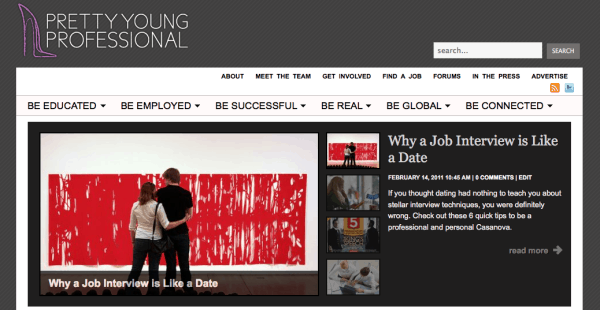 Many readers will be familiar with The Muse an online business dedicated to helping female entrepreneurs by offering mentorship, advice and career opportunities. What you probably won't be familiar with is Pretty Young Professional the predecessor to The Muse and Kathryn Minshew's first startup that fell apart due to bad communication, legal issues, and infighting among the team.
Many readers will be familiar with The Muse an online business dedicated to helping female entrepreneurs by offering mentorship, advice and career opportunities. What you probably won't be familiar with is Pretty Young Professional the predecessor to The Muse and Kathryn Minshew's first startup that fell apart due to bad communication, legal issues, and infighting among the team.
Pretty Young Professional was founded by four colleagues at McKinsey, a global consultancy firm, who noticed the lack of resources for young women in the world of entrepreneurship.
It had a simple vision, to provide a weekly newsletter and cultivate a community for young female entrepreneurs. All four were coworkers, friends even, who shared a similar passion and vision. A meeting was held; positions and equity were decided amongst themselves and written on a notepad. And that's when the trouble began.
READ MORE: How to Build a Profitable Marketing Strategy
Kathryn Minshew, co-founder, and CEO of Pretty Young Professional said that "it came down to some pretty fundamental differences of opinion around where the business should be heading. I think, naively, we assumed that if we kicked the can down the road on some of those things, we'd be able to sort them out."
Despite the years you've shared together and the many years of in-jokes you have, conventional wisdom dictates that it's a bad idea to mix business with friends.
A study by the University of Auckland Business School found that while maintaining strong friendships with co-workers generally improves work productivity and morale it also creates a dilemma when trying to reconcile personal relationships with professional decision-making.
In business, it's required that you have to make the logical and necessary decisions in order to benefit your company, even at the cost of personal friendships.
11 months in, the four founders of Pretty Young Professional had split into two camps due to differences in opinion, and a coup was staged. The legality of the original document was called into question, Minshew was hit with a lawsuit and called to step down as CEO, and the editorial team of Pretty Young Professional had their site and email access cut. The company quickly collapsed despite calls from excited investors and a thriving user base.
While it is possible to work with friends and family, it requires completely honest communication, both parties must understand that it really is nothing personal, and, perhaps most importantly, vest your ownership. It's always best practice to ensure that you legally protect yourself and your assets, a promise between friends rarely holds up in the court of law.
READ MORE: 5 Best Sales Funnel Software Tools to Power Your Business
The Double-Edged Sword of SEO
 Tutorspree was launched in 2011 out of startup incubator Y Combinator and was touted as the 'Airbnb of tutoring'.
Tutorspree was launched in 2011 out of startup incubator Y Combinator and was touted as the 'Airbnb of tutoring'.
The premise was simple, to help parents find tutors for their kids online. By 2013 they had over 7000 tutors signed up on their platform and has raised an estimated $1.8 million. Then the rug was swept out from under then and they closed down a few months later, after 3 years in operation.
It appeared that Tutorspree was doing everything right, it had managed to raise an impressive amount of capital from heavyweight investors like Sequoia Capital and Lerer Ventures. They were scaling at a decent pace, albeit not as fast as they wanted, and the business model was proving to be profitable.
However, it fell apart in March of 2013 when Google changed its algorithm and Tutorspree found their traffic reduced by 80% overnight. While this normally wouldn't cripple a business, it was a catastrophe for Tutorspree. SEO was baked into their business model from the very start and almost all of their customer acquisitions originated from SEO.
"Nor is the largest lesson for me that SEO shouldn't be part of a startup's marketing kit. It should be there, but it has to be just one of many tools. SEO cannot be the only channel a company has, nor can any other single-channel serve that purpose." – Aaron Harris, co-founder, and CEO of Tutorspree.
READ MORE: How to Develop Powerful Business Core Values and Mission Statements
There are many different types of SEO practices, but SEO is essentially improving the visibility and authority of a website by having it rank higher on search engine listings. The entrepreneurial community itself is very divided on the merits of SEO.
The issue with Tutorspree wasn't whether or not it used SEO effectively or ineffectively. The issue was that due to its effectiveness, the founders became blind to other models of customer acquisition and developed an overreliance on a model they had absolutely no control over.
Google's algorithm constantly changes and there's no telling how it will ultimately affect your website's ranking. Google has consistently proven to burn anyone that chooses to rely on SEO as their main strategy.
It should go without saying that you shouldn't be putting all your eggs into one basket. Entrepreneurs should invest half their marketing into a high-risk strategy, and the other half in a proven consistent strategy, albeit with a lower return on investment. When it comes to business, you can either live or die by the sword or just be smart and carry a shield.
READ MORE: Building the Perfect Sales Funnel for Your Shopify Store
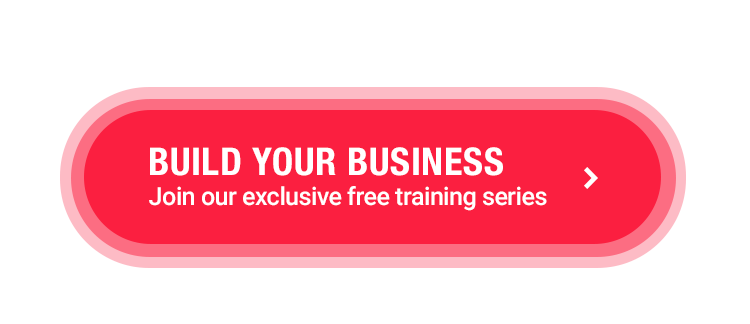
Summary
Failure is difficult to handle, but there is no better teacher. Although every business listed failed spectacularly, all of their founders got back up, dusted themselves off, and forged ahead to eventual success.
While it's easy to see all the mistakes you made in hindsight, don't let yourself get to that point. Failure can be seen a mile away if you're paying close enough attention, even if it means asking yourself some uncomfortable questions. A lot of businesses could have been saved if just the smallest amount of preparation was undertaken, or if founders had just a little bit more patience.
Is there a bigger startup failure that you've heard about? We love case studies! Let us know in the comments below.
The post What These 4 Startup Case Studies Can Teach You About Failure appeared first on Foundr.
]]>The post The Ultimate Guide To Creating The Perfect Founding Team appeared first on Foundr.
]]>A startup can have all the potential in the world, but nothing can derail things faster than its "people problems." In a study about startup performance, venture capitalists attribute 65% of company failures to problems within the startup's management team.
Make no mistake, more than anything else, startups live and die by the people that bring them to life.
Ideas can pivot and evolve as they grow, funding can always be found somewhere else, the market will always change with a never-ending supply of competitors. But the team that brings it all together forms the company's DNA.
So, let's get down to it, let's break down what makes the perfect founding team!

Why You Need a Team
While there's nothing wrong with being a solopreneur, you have to realize that you're playing with a handicap from the get-go.
According to the Startup Genome Report, solo founders, on average, take 3.6 times longer to scale when compared to startup teams of two or more. It also found that teams were more likely to attract investors and experience success in comparison to solo founders.
Why is that? Well for one thing, to investors, it's a vote of no confidence.
It doesn't matter how hard-working or talented you may be, or how brilliant your idea is. To investors, it looks like no one else but you believes in your idea.
But most importantly, you won't have a partner to help pick you back up when things go wrong. In the startup world, the highs are high, and the lows are low.
When you inevitably hit the trough of sorrow, it'll hurt, and picking yourself back up is a hell of a task. Having a friend to talk to, who understands exactly what you're going through, to be there when you need it makes all the difference in the world.
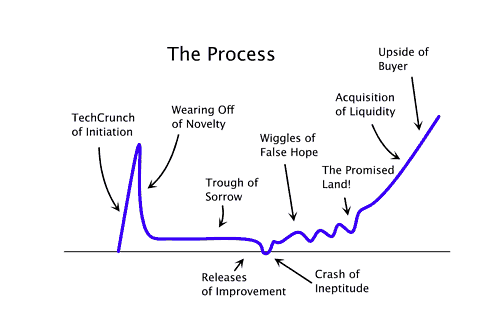 It's not impossible for startups to become successful with just one founder; Foundr itself is a testament to that. But have you ever noticed how there are only a handful of successful startups out there that were founded by only one person?
It's not impossible for startups to become successful with just one founder; Foundr itself is a testament to that. But have you ever noticed how there are only a handful of successful startups out there that were founded by only one person?
While undoubtedly the most famous, Steve Jobs was not the only founder of Apple. It took the collective efforts of Jobs, Steve Wozniak, and Ron Wayne to get Apple off the ground.
Bill Gates had Paul Allen, Richard Branson had Nik Powell, and while Arianna Huffington may be the editor-in-chief and face of The Huffington Post, it was a team of four founders that brought it to life.
It's not impossible to go solo but a startup is hard enough, so why go it alone?
READ MORE: 7 Legit Methods to Teaching Yourself Any Skill
The Magic Number
Here's an interesting bit of information. After analyzing a handful of successful startups, apparently, the perfect number of cofounders is 2.09. Others will argue that three is the perfect number. But it's generally agreed upon that four is pushing it, and any more than that is just inviting chaos.
The reason is that a founding team should be as lean as possible. Two is good because it allows you to distribute the necessary workload and trust is high. Three allows for more diversity of skill and specialized roles but introduces more opportunities for unnecessary drama. Four means you can, theoretically, get even more work done, but trust is generally lower and politics come into play.
Any more than four means you have a committee, and you're more likely to be focusing on power plays and egos rather than working together to build a great product.
But whether or not you choose to have a founding team of two, four, or eight, what really matters is the diversity of roles, experience, and responsibilities. Because if your cofounder is just a carbon-copy of yourself, then you've got a big storm coming.
READ MORE: How to Build a Profitable Marketing Strategy
What a Founding Team Should Look Like
The last thing you want your founding team to be is a collection of skills and abilities that don't complement each other. At the end of the day, the size of your team is nowhere near as important as the qualities that each individual member brings.
The perfect founding team will have these three roles: the visionary, the hustler, and the hacker. Together these three make up the golden triangle, the foundation of every successful founding team.
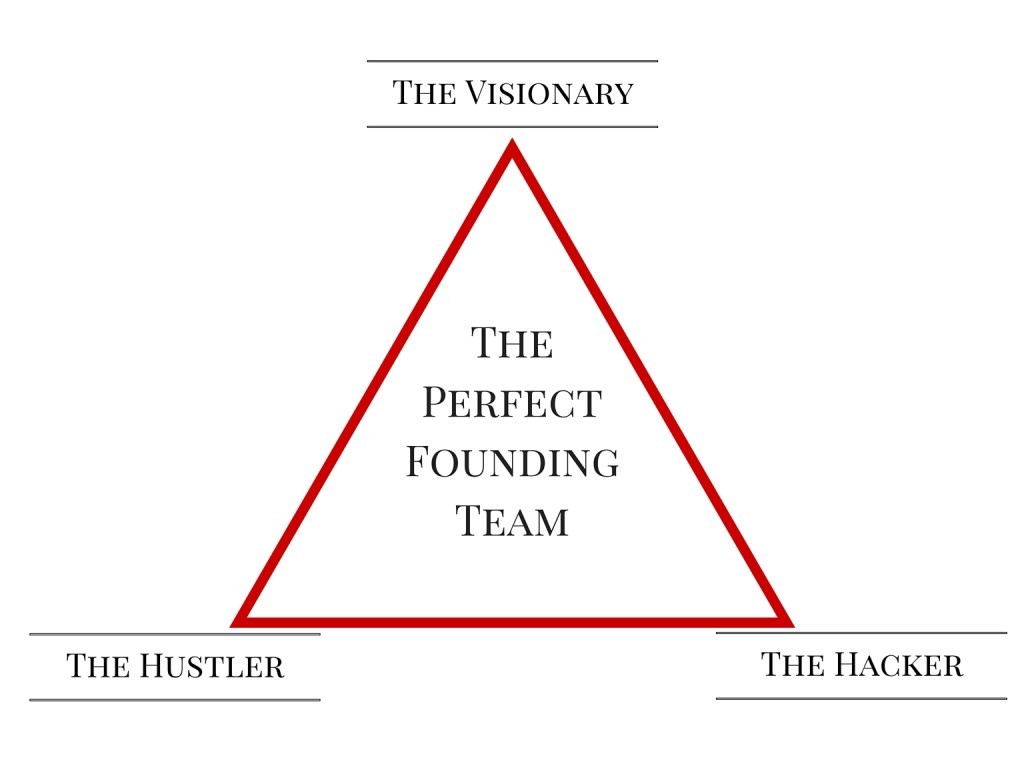
Regardless of a team's size, you need to fulfill these three roles if you want to succeed. Any other roles, while helpful, are unnecessary in the early stages. If you have someone on your team that isn't fulfilling any of these following roles, then cut them—they're not useful right now and will only slow you down. Remember you want to be as lean as possible.
Here's a breakdown of each of these three roles and why you absolutely need them.
READ MORE: How to Develop Powerful Business Core Values and Mission Statements
The Visionary
Often, but not always, the CEO, the visionary is the beating heart of the team. While everyone understands the overall goals and objectives, the visionary is the one with the stars in their eyes, the one who sees into the future. They have that unique ability to articulate that dream to others. To convince the skeptics among the customers, market, and investors, and inspire the rest of the team. Their job is, at all times, people-facing.
While not always the best at the detail-oriented stuff, the visionary is all about the big picture. Whether it's coming up with the overall strategy, recruiting and hiring the best talent for the company, or making sure that the right people are kept happy. They have the responsibility of working on their business, not just in it.
Visionaries keep their eyes on the prize and are always looking to capitalize on even the smallest of opportunities.
They're always looking to grow and expand the business, and are ready to adapt and pivot if the circumstances call for it. Even if it's through sheer force of character, visionaries refuse to let setbacks hold them back, and barrel forward, rallying the rest of the team as they go.
It's the visionary who organizes the rest of the team, and perhaps most importantly, inspires them.
READ MORE: How Foundr Created it's First Product Launch
The Hustler
If the visionary is the heart of the founding team, then the hustler is the arms and legs.
The hustler is simultaneously the doer and the taskmaster of the group, setting the pace and making damn sure everyone else keeps up. What they don't know they'll learn, and what can't be efficiently done they'll put in the hours to hammer it out. The hustler is not defined by position or title, but by attitude.
While hustlers can see and understand the bigger picture, instead they focus on the smaller scale of things.
All those detailed bits and pieces, the day-to-day operations that need to be done in order for the grand vision to happen. The visionary may set up the board, but it's the hustler that moves the pieces.
A background in either marketing, technology, business development, or financials would be ideal. But the hustler ultimately walks the middle road, they're the jack-of-all-trades competent enough to fill whatever role is necessary until a more suitable replacement can be found.
Bear in mind, that does not mean that the hustler is replaceable. In fact, finding someone with that right combination of driving force and willpower is rare in and of itself. Hustlers make sure that the visionaries and hackers stay grounded and working together. They keep their eyes on the bottom line and make sure the ship keeps driving forward.
READ MORE: 5 Best Sales Funnel Software Tools to Power Your Business
The Hacker
There is only one thing that the hacker focuses on: product, product, product.
The brains of the operation, their entire job is to make sure that the required tech and hardware is up to scratch. If it's a tech startup you'll need an amazing programmer; if the business is a restaurant then you need an amazing chef; if you're running a VC firm then you better have someone who knows the market.
Whatever your business is, you need someone who lives and breathes the product.
From the get-go, the hacker should be able to conceptualize what the design of the product should be like—what people should expect and why it's amazing. From there, they need to have a problem-solver mentality and always be looking for different ways to develop and improve the value of whatever it is they're working on.
In the early stages of a startup, the product is incredibly important, simply because without a product, there is no business. How well-made or valuable a product depends solely on the expertise of the hacker.
Make sure you choose your hacker carefully because the product starts and stops with them.

As you can see, each role is vitally important, and one cannot exist without the others. This demonstrates again why going solo is so difficult. It's almost impossible for one person to fulfill all three roles effectively.
That said, while it is better to have one person dedicated to each role, it isn't mandatory. For example, it isn't uncommon to have founding teams of two where one cofounder has the dual responsibility of being the visionary and the hustler, or startup teams of four where the role of the hacker is shared by two people.
Some founding teams favor more technical prowess, while others prefer having more business-oriented members. Overall, it depends on what kind of business you want to run and the agreed-upon priorities of the team.
Here's another interesting bit of information from the Startup Genome Report concerning the make-up of founding teams.
"Business-heavy founding teams are 6.2x more likely to successfully scale with sales driven startups than with product-centric startups. Technical-heavy founding teams are 3.3x more likely to successfully scale with product-centric startups without network effects than with product-centric startups with network effects. Balanced teams with one technical founder and one business founder raise 30% more money, have 2.9x more user growth, and are 19% less likely to scale prematurely than technical or business-heavy founding teams."
READ MORE:The 28 Essential Facebook Ad Terms You Need To Know
What Kind of Founding Team do you Need?
When it comes to figuring out your perfect founding team, Steve Blank recommends using the Business Model Canvas. It's a simple tool that allows you to focus on the nine essential elements of a business model, all arranged to represent how they influence each other.
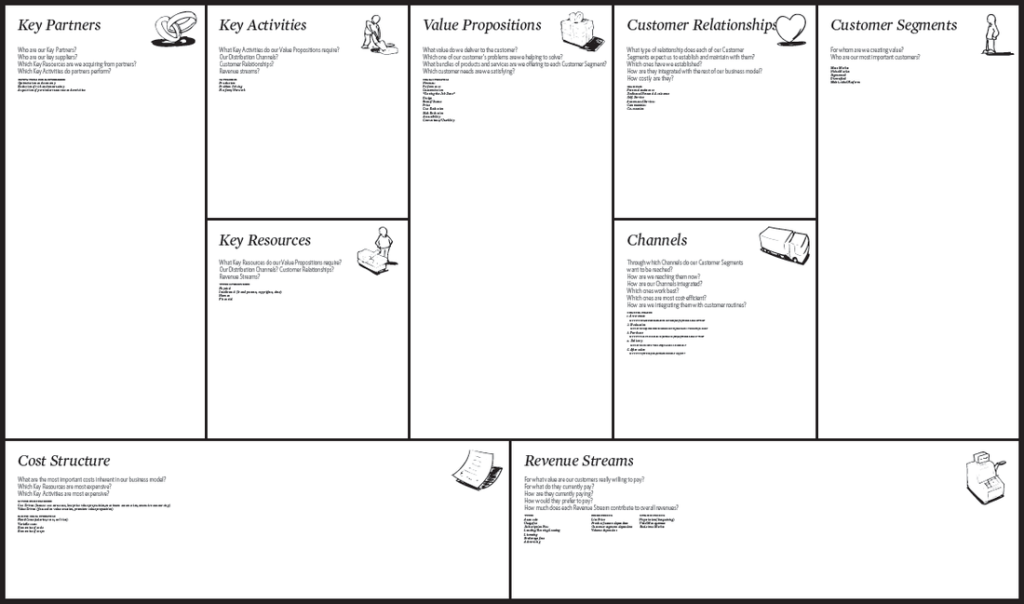
This surprisingly simple tool is all you need when it comes to finding the best founding team for your business.
First, the Key Activities box defines your product and how it's delivered to your customer. Then compare that to your Key Resources, where you'll list everything that's needed in order to execute those activities. Don't just list physical resources like money and infrastructure; be sure to note the expertise needed as well.
If there's a massive gap between what you can bring to the table and the expertise needed to get your startup off the ground, then you need to start looking for a cofounder to fill the need.
Before you start picking up people left and right and asking them to share equity with you, be sure to take a good, hard look at your resources. Ask yourself whether or not you can get by with a consultant or a contractor.
A lot of founders run into this dilemma when it comes to expanding their teams. On one hand, you can get a cofounder who will stay with the company long term, but you'll dilute your own equity. On the other hand, you could pay someone to do a specific job for you, and once the job's done or the money runs out, they're gone.
Some entrepreneurs don't want to share equity with anyone, so end up breaking the bank with contractors in order to fill the holes in their expertise. One of two things usually happens—either they lose it all in the early stages, or when the business starts to scale they realize that the contractors were only there for the short term and that they really needed a dedicated person.
Other entrepreneurs might panic and immediately share equity with someone, only to discover that in the long run their cofounder's skills aren't needed anymore. So, what do you do?
The short answer is, if there is a key resource that is absolutely irreplaceable, not just at the early stage of the startup but throughout the entirety of your business, then get a cofounder. If there are skills that are ultimately replaceable, take a look at your budget and figure out what you're willing to pay and for how long.
It's a tough decision, but remember, a founding team needs to be lean. Take full use of the Business Model Canvas and get your bearings. Just remember to surround yourself with people smarter than you.
READ MORE: 3 Ways to Express Gratitude to Your Team
The Perfect Team Has:
As any sports fan will tell you, even if your founding team is made up of first-round draft picks, there's no guarantee that your team will succeed. After all, what makes a team great isn't the individual talent of each member, but how well a team works together.
As talented as your team of founders may be, it won't get very far unless it has these three essential qualities.
READ MORE: How To Develop An Online Course
Trust and Respect
These two are the defining principles of any great relationship, let alone a great business relationship.
If you don't trust or respect the person you're working with, the one who you'll likely be seeing day-in and day-out for as long as your startup exists, then that's not a cofounder you need.
One thing startup founders hate with a passion is relinquishing control. Something many young entrepreneurs tend to do is micro-manage.
I'm sure we've all had that boss who somehow finds the nitpickiest of things to nitpick. It's annoying as hell, and you get mad because it feels like they don't trust you. That they don't respect your skills enough to leave you alone to complete your task.
Build a culture of trust and respect by listening to each other, really learning how to value their opinion if it's different from yours, and respect each other's contributions to the team. It's a two-way street, you can't get if you don't give.
Diversity
If you're in a startup team where everyone else is just the same as you, then congratulations! You've managed to multiply your weaknesses by the number of cofounders you have.
Make no mistake about it, diversity breeds success. Don't make the mistake of creating a team that looks just like you. Talent is talent, but you'll usually need to consciously seek out people who are different from you to make sure your team is well-rounded.

According to this study by the Journal of Business Strategy, there are three major ways in which cofounders can differ from each other: opinion, expertise, and power. The study concludes that winning teams are moderate in diversity of opinion, high in diversity of expertise, and low in diversity of power.
This means the perfect founding team consists of people willing to challenge and push each other, are not carbon-copies of each other in terms of skills and experience, and all are treated equally.
Communication
The perfect founding team's members are always talking to each other. It's not enough that cofounders agree to communicate, but they actually follow through with it. Open communication is the single most important factor in creating a positive working atmosphere and culture.
However, communication is more than just simply talking to someone and assuming they're listening. What you need is a proper conversation, where all parties feel like they're being listened to, rather than just being talked at.
The two words "information" and "communication" are often used interchangeably, but they signify quite different things. Information is giving out; communication is getting through. – Sydney Harris
READ MORE: How We Validated 12 Online Courses Without Spending A Cent
Where to Build Your Team of Founders
You've probably heard this analogy before, but your relationship with a co-founder is a lot like a marriage. Why? Because you're going to be dealing with that person day-in and day-out for as long as your startup exists. The stress and pressure will make you want to tear your hair out, and possibly each other's throats. Sounds a lot like marriage doesn't it?
A startup will take over your life, there's no way around it. So the person you choose to have as your cofounder better be someone you'd consider a life partner.
Finding such a person can be a tricky business. Going back to the analogy of a startup as a marriage, then finding a cofounder is a lot like dating. Just replace the honeymoon period with late nights at the office screaming at your partner that their ideas are stupid.
For those looking for a cofounder, the best place to look is your professional network. People you've gone to school with or worked together with, maybe even someone at your co-working space. Someone who you know you can work with.
You can also look into working together with family or friends. This does offer an advantage because of your shared history and a higher level of trust. But you have to remember to prevent that personal relationship from getting in the way of your professional one, and not many people are good at that.
Of course, you can always create a founding team with a complete stranger. Not always a good thing, but can be if you manage to find the right person. Just don't ask someone to be your cofounder if that person isn't someone you'd hire to be your employee.

In Summary
While the world might love the idea of a sole innovator, of some chosen one singlehandedly bringing about change, the reality couldn't be further from the truth. You can't become a leader if you have no one to lead.
While every startup team differs in size and shape, the three core roles of the visionary, the hustler, and the hacker remain the same with every successful startup. Chances are, you're not going to be able to do it all, so do the smart thing and give the job to someone else. As an entrepreneur, you have to be working on the business, not in it.
Surround yourself with smart people and let them do their job while you do yours.
But the perfect team is only perfect because of the bonds that tie them together, not the qualities of each individual. Because a startup will do to a relationship what a dog does to a sock, find every opportunity to tear it apart. Choose a co-founder that complements you, and you know you can trust.
Are you a visionary, a hustler, or a hacker? Why? Tell us your answer in the comments below!
The post The Ultimate Guide To Creating The Perfect Founding Team appeared first on Foundr.
]]>The post How To Be A Better Public Speaker appeared first on Foundr.
]]>On the one hand, public speaking helps you connect with a lot of new people, your audience, and other speakers. It's a fantastic way to network, to meet a potential client, a business partner, or even a long-lasting friendship. It's rewarding, it helps to boost your self-esteem, cement your brand, and build public image.
On the other hand, standing up in front of hundreds of people is scary. For most of us, public speaking is something we actively avoid at all costs. Standing in front of people, trying to remember what's on the slide behind you, wondering if you're boring the entire audience – there's a reason public speaking is a common nightmare.
Especially for freelancers and consultants, however, the pros are simply far too important to let these cons stop you. Which raises a question: How can you leave behind the fears that cripple so many people and reap the many benefits of public speaking?
How can you finally become the confident, charismatic public speaker you've always wanted to be?
READ MORE: How To Develop An Online Course
FREE TRAINING: How to Create a 7-Figure Course From Scratch Using Foundr's Never-Revealed "Rapid Course Formula"
How Public Speaking Can Help Your Freelance or Consulting Business
One of the most common challenges freelancers and consultants face is instability in their workflow.
There are weeks in which you've got more business than you can handle, and then there are weeks where your main task is to reload your email inbox, hoping to get a new email from a lead. That's when you realize you need to ramp up your marketing to get a more consistent pipeline of new leads and stop this emotional rollercoaster.
When you think about marketing tactics, you think about SEO, paid ads, and content marketing. But why not public speaking?
When you give a public speech, you're immediately seen as an authority, a crucial trait for any consultancy. Not only that, you have the full attention of dozens, hundreds, or even thousands of potential leads, often for long stretches of time. You can't say the same for most online marketing tactics.
What's more, you get to connect with a large range of businesspeople, many of whom represent untapped growth opportunities for your business. Public speaking, it turns out, is one of the best tactics for growing a freelance or consulting business.
Sure, it won't be a quick or easy tactic. As you will see, fear of public speaking and a lack of understanding of how to present information to an audience can stop many people from even trying it. But if you learn to overcome such fears and develop your speaking skills, you'll grow your business in ways you'd have never expected.
READ MORE: Are You Ready For A Digital Product Launch?
How to Overcome the Fear of Public Speaking
Fear of public speaking is one of the most commonly held phobias. What if people don't like your talk? What if they don't like you? What if you freeze? What if you panic? What if you say something wrong?
A lot of talks these days are being hosted remotely, which does take the edge off speaking in person, but still strikes fear into the hearts of many.
It's believed that a fear of public speaking is actually the fear of failure. Sure, the logistics of talking in front of an audience are intimidating, but really, we're afraid of doing a bad job and of people thinking poorly of us as a result.
To overcome this, here are three tips you can use:
1. Accept the Fear
Let's be honest with ourselves. You will feel fear. We all do. Humans are predisposed to fear of being ridiculed, and speaking in public increases your social vulnerability in an extreme way.
Your mind doesn't like it when you're vulnerable, so it panics.
Even if you have the most beautiful presentation, or you're unveiling Nobel Prize-worthy research, even if you know your speech like the back of your hand, you will always feel butterflies in your stomach before a talk.
Whatever solutions you use to lower that fear—counseling, coaching, meditation, or even medication—you will always feel some fear before giving a talk. Accept it.
The key, as Franklin D. Roosevelt said, is to remember that "courage is not the absence of fear, but rather the assessment that something else is more important than fear."
2. Practice
To give a successful talk—one where you are eloquent, engaging, and interesting—you need to be prepared. This requires you to practice a lot. There's nothing worse than watching a speaker who's clearly not prepared for a talk. The ideas may be fine, but the thoughts don't flow.
That's because the speaker focused too much on the ideas and not on the execution. The speaker forgot to practice.
Before you can practice your talk, however, you need to have it prepared weeks in advance. Take the time to define the topic, the structure, and the slides so you can then practice it for as long as you can. Practice will help you gain the confidence you need to give a wonderful talk without any hiccups.
What's more, it will expose any problems you may have with your presentation.
You can practice your talk in front of a mirror, with your friends and family, anyone.
Set up your phone and record yourself doing the speech over and over again in the days leading up to the real thing. You'll be able to pick up on twitches, awkward pauses when you're going too fast or too slow, or if you rely on the slides too much.
What matters is that you practice as much as possible.
3. Get a Coach
A speaking coach can give you valuable feedback that you'd not get otherwise. While a coach is an obvious solution when you are planning on becoming a professional speaker, they can still help you when you're just starting out.
What's more, a coach can give you "inside" tips from the trenches that would take you a long time to discover on your own.
READ MORE: How We Validated 12 Online Courses Without Spending A Cent
Mastering the Art of Public Speaking
Public speaking is more of an art than a science, but there are still steps you can take to develop your skills, and your career.
Step 1: Know Your Goal
If you have ever read anything from Foundr, you know we go big on the idea of finding purpose in anything you do. The reason for that is, when you know why you want to do something, everything else becomes easier and clearer.
The fear of public speaking can be daunting, but if you have a goal that's bigger than your fear, your fear won't stop you from speaking.
The "ultimate goal" refers to the final result that speaking in public would bring you:
- Do you want to generate leads for your consulting business?
- Do you want to become a paid speaker and live off your gigs?
- Do you want to help the world and spread your message?
Not only will knowing your goal give you a level of clarity unlike anything else, but it will also make your pitches and your presentations much more aligned with your goals.
For example, consider what you set to gain from your public speech. Aside from the money, consider that it may be a great opportunity for networking and lead generating reasons. This is because as you generally get to know other (influential) speakers, which gives you access to business opportunities few people would get.
Get this ultimate goal defined before you even choose or agree to an event.
READ MORE: Are You Ready For A Digital Product Launch?
Step 2: Define a Set of Speaking Topics
Before you even begin to research potential speaking opportunities, you have to have a set of topics you're interested in speaking about. Most likely than not, you already have an idea of them, you only need to have them written down.
If you're in doubt about your speaking topics, you simply need to pick one that fits the following criteria:
- You're passionate about or experienced at the topic at hand
- You can naturally speak about it in an engaging way
The first relates to the idea that people who give speeches know what they're speaking about. Just as you don't see random people giving talks at TED events, you won't get any meaningful speaking opportunities if you can't show some proof to the event organizer that you know the subject of your speech.
The second criteria mean you must give your speech in a way that's entertaining for the audience.
While a speaking gig isn't the same as stand up comedy, you always want to add a fun tone to your speech. What's more, you need to explain things in a clear way so your audience not only learns something new, but they get intrigued about what you talk about.
If you're an expert (or at least, you're passionate about your speaking subject), you will know what aspects of your speech will interest your audience more than anything.
READ MORE: How to Build a Profitable Marketing Strategy
Step 3: Start Talking at Small Events
When you're getting started, you want to start with small events. You'll progressively develop your skills, gain confidence, and find your own unique voice.
One way is to go to Meetup.com and look for events that are about a topic you've selected.
Let's say you want to speak about writing to see if you can drum up some more clients. By simply searching your topic, you can get a long list of events happening soon for which you can apply.

Meetup.com offers both in-person and digital sessions, so you have the option to search for talks being given on the other side of the globe. If there's a talk coming up in Scotland next year and you think you'd be perfect for it, then you can contribute.
Digital talks are an opportunity to practice public speaking, network, and grow your skills on a global market.
It's best to pick events that will be carried out in at least a month and have no announced speakers yet. Usually, event organizers develop meetings many weeks (if not months) in advance. The more time in advance the event is, the more time you'll have to practice your speech.
A good way to find out if you might be able to give a talk at an event is to check for the event's announcers. If it has none, or not all have been announced yet, you have a chance.
Once you've found at least two or three events, it's time to pitch the event organizer.
Step 4: Pitch the Event Organizer
When making a pitch for a speaking engagement, you want to be concise and clear about your goal. Don't beat around the bush. They know it and you know it, so why over complicate it?
On Meetup.com, you can see the event organizer's name right at the top and whether or not the talk is being held digitally or in person.

Then, send the person a message similar to the following:
Hey,
I'm [your name].
I see you're having your Creative Writing Exercise Workshop soon. While I've not had the chance to attend one of these events in the past, I've heard lots of great stuff about them.
Since you've not announced your speakers yet, I'd like to know if you'd be interested in having me give a talk about my experiences in writing [xyz].
Given your event is about creative writing, I've done [xyz].
What do you think? Would you be interested in having me talk at your event?
If so, let me know anything I need to know or do before it. If you want to talk to me in person, you can reach me [email or phone].
Talk to you soon,
Be sure to adapt it to your own style. Once you get a positive response, you can start working on your talk, but hold off until you get a confirmed opportunity with a defined topic.
READ MORE:The Ultimate List of Every Tool You Need To Create Your Online Course
Step 5: Develop Your Slides
While the quality of your speech matters, your slides should also be designed and structured in a way that entices your audience.
Often, amateur speakers add a bunch of data into their slides, hoping the audience will absorb the information and "get it." Or they add a bunch of bullet points, with the hopes that the audience will read them as the talk unfolds.
These slides are awful, just like the one shown below: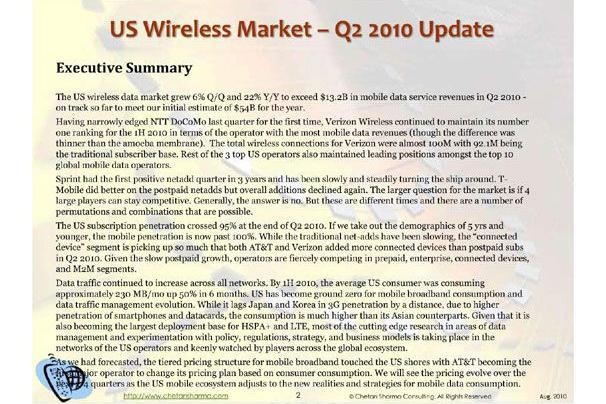
That may be acceptable if you're a professor at a university, but not if you want to master the art of public speaking.
Check TED talks and you'll see the slides are often minimalist, but still highly connected to the topic being presented.  You don't have to spend thousands of dollars with a designer to develop your slides, at least not when you're getting started. With a tool like Google Presentations, Microsoft PowerPoint, Apple Keynote, you can develop well-designed slides for free.
You don't have to spend thousands of dollars with a designer to develop your slides, at least not when you're getting started. With a tool like Google Presentations, Microsoft PowerPoint, Apple Keynote, you can develop well-designed slides for free.
Remember:
- Don't add a lot of text
- Don't read from your deck
- Use a simple design
Highlight just a little bit of text or an image that's related to the ideas spoken, but let your speech do the rest. The work isn't on the slides themselves but on the way they complement your speech.
Step 6: Structure Your Talk Like Aristotle
Aristotle is one of history's greatest philosophers, encompassing a wide range of topics including physics, politics, logic, ethics, and most importantly, rhetoric. Aristotle is known for developing one of the most common ways public speakers present their ideas, which consists of:
- Starting by giving your audience an idea of what they'll learn
- Giving the talk and engaging the audience in the process
- Closing it by tying all the ideas together
This three-part structure has been called the "Aristotle technique."
Most TED talks, like most popular presentations, start with the speaker giving a hint of their talk. They give some context, so the audience can prepare for what is about to come.
Then, they give the talk. Obviously, the speaker must continue to engage the audience throughout the entire speech, using a mix of humor, storytelling, facts, and more.
Finally, they finish by giving a quick overview of what they taught so the audience can leave with a clear idea in their heads.
Call it what you like, but your speech should respect this structure, so your audience can understand your ideas better and leave your speech having a clear idea of what they've learned.
Step 7: Learn to Tell Stories
Behind every successful talk, there's a great story.
Humans have been programmed to connect with stories. Imagine our ancestors from hundreds of thousands of years standing around a fire sharing knowledge, customs, and stories from the past. That's how humans explored spiritual narratives, theories that explained how the universe works, and recent events.
Whenever someone tells us a story, we listen. That's in our blood. If you can tell a good story, you will engage your audience.
Once again, check TED's most popular talks—from Sir Ken Robinson's "Do schools kill creativity?" to Julian Treasure's "How to speak so that people want to listen" to a favorite of many: Tony Robbins' "Why we do what we do"—and you will see they're all story-driven.
The knowledge they share is valuable, but as anyone who has ever been in a boring college class can attest, the ideas aren't as important as the vehicle through which they're told. That is, the narratives used to explain them—the stories.
Your stories don't have to be complicated or long. A story can be as long as War and Peace or as short as a tweet, what really matters is that the elements that make a story are there.
All stories follow a basic structure:
- A story starts by introducing the characters and their context (the beginning)
- Then the characters face a challenge, leading up to the story's climax (the middle)
- The challenge is overcome and we see how it changed the characters and their context (the end)
Your speech will likely be about one main argument—a hypothesis that you want to prove—and this will break down into different sections. In each section, try to explain the main concept through a story, and then tie them all together through the overall speech.
Let's say that the topic of your speech was about how cold-calling clients every day can make you a better marketer. In this case, the topic is the argument (cold calling = being a better marketer).
To explain this main argument, you would separate it into three smaller pieces:
- Cold-calling every day helps you to connect with potential leads
- It helps you communicate better
- It helps you become more confident with work
The entire speech would then be a story. For example, your first job cold-calling in a dodgy telemarketing company, but then that you realized you were confident enough to get a new job through a phone interview. You then discovered that cold-calling is a way to practice better communication.
Even if your ideas are clear and useful, your stories will make them compelling and easier to digest.
Step 8: Practice Makes Perfect
Just like any form of expression, public speaking is a craft you improve as you practice it. Speaking in front of your mirror helps, but to truly get good at this you need to speak in public. At first, your speaking gigs won't be that good.
Your stories won't be that engaging. You may not command the attention of the room very well. That's fine.
When you're getting started, your passion will trump your skills. People will get that and will forget your mistakes. As you continue to speak in public, you'll get better.
There's no special technique for practicing. You only need to start booking more speeches, regardless of the size of the audience or the money you make (if that's what interests you).
READ MORE: How Foundr Created it's First Product Launch
Step 9: Study the Greats
Practice and coaching are crucial, but another great way to improve your speaking skills is to study the great orators of the past.
You can even scan back through thousands of years of historic speeches, from Demosthenes' "On the Crown" speech to Abraham Lincoln's "Lyceum Address," to Winston Churchill's "This was their finest hour" speech. You'll learn how history's greatest speakers shaped our past.
You will also learn how they organized their ideas, how they presented them, and what words they used to maximize the power of their message.
Consider this studying, just as you studied arithmetic back in high school. It's a mental exercise that will help you absorb new techniques and improve your communication skills.
READ MORE: How to Create an Online Course Like Foundr
Step 10: Track Your Goal
Last but not least, you can't forget the goal you had originally defined in Step 1. You want to make sure you're getting the results from your speaking efforts.
After you give each talk, you need to see whether it's getting you closer to the results you desired.
For example, if you wanted to generate leads, how many leads did your speech generate? If you wanted to make money, how much did you get paid? If you want to get more people to join your cause, how many joined it?
This goes back to the organization and structure of your talk. If you wanted to get consulting clients, did you add a call-to-action at the end of your talk, like a link to your site? Did you stay in the event talking to people? Did you send any offers to your event's attendees?
You must keep track of your results, so your speaking isn't done in vain.
EXCLUSIVE FREE TRAINING: Successful Founders Teach You How to Start and Grow an Online Business
Say it Loud and Proud
Speaking in public is an art, no question about it. Like any art, you need to think about it as something you'll hone over time. It will take a while to master this art. You will have to face your fears and overcome setbacks. But there's a virtuous cycle behind this art; the more you practice it (both privately and publicly), the more confidence you will gain. The more confident you become, the easier speaking will be, and the better your skills will get.
As Leonardo da Vinci once said, "It's easier to resist at the beginning than at the end." Don't let that happen to you. Practice your skills and get up on that stage. The world needs you to share your knowledge; you only need to take the first step.
Have you done any public speaking? What's been your biggest fear or challenge, and how did you overcome it?'
The post How To Be A Better Public Speaker appeared first on Foundr.
]]>The post 7 Legit Methods to Teaching Yourself Any Skill appeared first on Foundr.
]]>Business strategizing, coding, graphic design, public speaking, writing a killer novel, playing the trombone, dog-grooming, jewelry-making, cooking; whatever you want to learn, you can teach it to yourself.
If you want to be a great entrepreneur, and we mean a really successful one, then you are going to need to be someone who is able to learn skills efficiently.
All of your great entrepreneurial heroes have more skills than you'll ever know. They didn't just learn "business", they understood that success comes with a collection of learned skills that compliment your business.
Take Elon Musk for example. He has knowledge of lots of different industries: rocket science, engineering, construction, tunneling, physics, and artificial intelligence.
Richard Branson wasn't born with sublime and timeless leadership skills, he worked hard and made it his mission to learn how to be a better leader along with his unique marketing and perseverance.
Heck, even Bill Gates is multi-talented enough to be able to run Microsoft and do a standing jump over an office chair. (It's amazing, Google it if you can!)
The secret to becoming a successful entrepreneur is mastering the most important skill of all: learning.
Learning is itself a skill that not many people have a good grasp on. It's a little odd that schools and colleges don't have "learning" classes, where you are actively taught how to approach new material in a way that makes it stick. Just imagine how easy algebra would have been if you had a method in place to learn it more efficiently?
If you want to be better in business, better in entrepreneurship, and better in life, then you need to start learning how to learn. You need to be someone who looks at a difficult task and says: I can teach myself the skills I need to turn it into an easy task.
Below, we outline 7 proven methods that will teach you any skill you want. Whether it's launching the next multi-billion dollar business, revolutionizing the world, or jumping over an office chair. Learning to learn is the only way to achieve it.
EXCLUSIVE FREE TRAINING: Successful Founders Teach You How to Start and Grow an Online Business
How You Learn and Retain New Skills
Before we launch into the juicy stuff, let's take a step back and examine what it is we want to achieve, and how we go about it.
In the simplest terms, the process of learning a new skill is made up of three stages:
- Encoding
- Consolidation
- Retention and Recall
The first phase is the one most people think of when they imagine skill acquisition. It's during this phase that your brain takes in new stimuli and stores it away.
The second phase, skill consolidation, is when your brain takes all that new knowledge and makes it available for you to use next time you need it. An unconscious process, skill consolidation happens outside of your training sessions, most often while you sleep.
Finally, retention and recall. This happens when you go back to your training and aim to recall the knowledge learned in the previous lessons, which proves whether your brain was able to retain the knowledge or not. This phase is where you see the effectiveness of your training, your practice, and your brain's ability to adapt to new circumstances.
Let's use a nice simple explanation to examine this process.
1. Encoding: In your first French class, your teacher tells you that "yes" in French is "oui". Your brain takes that information and encodes the knowledge: yes = oui.
2. Consolidation: Over time, your brain slowly begins to consolidate this knowledge
3. Retention and Recall: The next time you sit down for class, your teacher asks you to say "yes" in French. Your brain recalls it's consolidated information, and you proudly reply "oui!"
Let's say you didn't properly listen to your teacher or you didn't sleep well after class and as such, the information hasn't been given the opportunity to properly "sink in". When asked the same question, you find yourself drawing a mental blank.
The way to acquire new skills faster and more efficiently is by maximizing the time you spend encoding new information, then allowing enough time for your brain to consolidate and store it, so you can then retain and recall all your newly encoded ideas most effectively.
In the next section, you will learn the 7 ultimate ways to master any new skill. All these methods will help you to encode, consolidate, and retain as much information as possible in the least amount of time possible.
Ready to take your skills to the next level?
READ MORE: Checklist for Starting a Consulting Business
How to Learn New Skills Faster
Your Mindset is Everything
We all like to believe we're smarter than we really are. Don't feel bad, it's a scientific fact. This bias even has it's own name: "the overconfidence effect."
The bias can make us believe we're born with limitations to our talents. It makes us super confident with the skills we've nailed down, but makes us believe that we are somehow bad at learning new ones.
This pesky bias is something that can stop you from growing as an entrepreneur.
Before you can learn new skills, you need to adopt a new mindset that allows you to do so. You need to take on a growth-focused mentality, one that sees learning new skills as a growth process, and not one of failure.
According to Carol Dweck, author of the bestselling book Mindset, a "growth mindset is based on the belief that your basic qualities are things you can cultivate through your efforts."
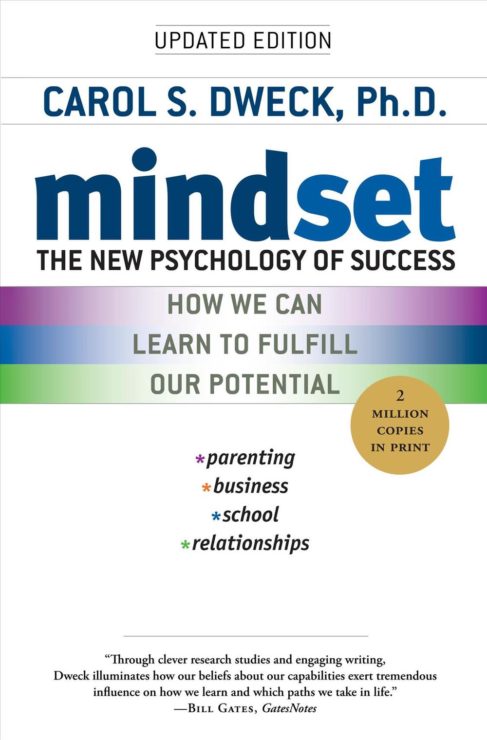
In other words, Dweck asks you to believe in your ability to grow and learn. You're not born with innate talents; rather, you're born with the ability to learn, nothing more.
To learn, however, you must be willing to fail. It's probably the least appealing part of the learning process, but all those scraped knees are actually the key step component in becoming a master of skills.
The growth mindset is a way to override the negative connotations associated with failure and become aware of the importance of making mistakes in the learning process. The passion for stretching yourself and sticking to it, even when it's not going well, is the hallmark of the growth mindset. This is the mindset that allows people to thrive during some of the most challenging times in their lives.
Remember, nobody is born as a skilled programmer, salesperson, or sportsmen. Every successful skilled person had to learn how to do what they now do so well. It's just that you can't see their entire journey, you only see their current success.
Feeling stupid is no fun. But being willing to be stupid and risk the emotional pain of making mistakes – that is absolutely essential. Because reaching, failing, and reaching again is the way your brain grows and forms new connections. When it comes to developing talent, remember, mistakes are just the guideposts you use to get better.
By adopting the growth mindset and be willing to make mistakes, you'll become an unstoppable learning machine.
READ MORE: How Much Should I Charge as a Consultant? A Consultation Fee Breakdown
Ace the 'Form to Leave Form' Methodology
When you first launch your business, you will realize quickly that you've got a lot of new things to do, most of which you can't do very well. Whether it's SEO, selling, programming, design, or management, you will be tempted to rush out and learn as many new skills as you can.
You start to read books, articles, videos, webinars, and pretty much any type of content that teaches you the basics of all of the things you want to learn. Not long after you start churning through all the information presented to you, you will inevitably get confused. Because you have put so much weight into the encoding phase and not enough into the consolidation phase, you won't retain much information, rendering your learning useless.
To avoid this information overload pickle, you can use the "form to leave form" methodology that Josh Waitzkin, author of The Art of Learning, developed during his journey to first become a chess master, and eventually a jiu-jitsu black belt:
A chess student must initially become immersed in the fundamentals in order to have any potential to reach a high level of skill. He or she will learn the principles of endgame, middlegame, and opening play. Initially, one or two critical themes will be considered at once, but over time the intuition learns to integrate more and more principles into a sense of flow. Eventually, the foundation is so deeply internalized that it is no longer consciously considered, but is lived. This process continuously cycles along as deeper layers of the art are soaked in.
If that was too much to absorb, he basically says that you need to master the basics before you move up to more complicated and abstract tasks. You have to learn to walk before you can run.
Also as a side note, Waitzkin is a chess-playing ninja author. How cool is that?
You should know the basics of whatever it is you are learning better than anyone else. That way, when it's time to learn more complex ideas, everything will be easier for you.
Let's say you were learning how to do technical SEO. By the time you get bogged down in the technical complexities of writing a robots.txt with regular expressions—a key aspect of technical SEO—you can always remember that the main point of a robots.txt is to tell the search engine robots which parts of your site they can access and which ones they can't.
That idea alone will save you hours of frustration and simplify the type of technical knowledge you need to acquire to create a robots.txt. You don't have to learn all the regular expressions; just by knowing how you can exclude a certain folder of subfolder will be enough.
Encode it, consolidate it, and recall it next time you practice a new skill.
Break It Down and Commit
If I told you that you could learn anything in just 30 days, would you believe me? And I am talking about anything. Want to learn Spanish? Done. Looking to be a whiz at web development? Bingo. Want to play the trombone? Sure, why not?
That's exactly what Josh Kaufman did back in 2013.
Kaufman, the author of The First 20 Hours, explains that he was able to do all of those things and more thanks to his specific "rapid skill acquisition" methodology.
According to Kaufman, the process of fast skill acquisition takes four steps:
- Deconstruct a skill into the smallest possible subskills
- Learn about each subskill to be able to practice intelligently and self-correct during practice
- Remove physical, mental, and emotional barriers that get in the way of practice
- Practice the most important subskills for at least twenty hours
The most important part of the entire methodology is to define the specific skill you want to learn, and the subskills that make it. If you are looking to learn sales, then "sales" isn't a skill per se. It's a topic, a subject if you will, but not actually a skill.
Cold calling, closing, and pitching are the skills that make a salesperson effective at their job. But such skills would still be too broad for you to tackle.
Cold calling, for example, can be broken down into the following subskills:
- Searching for potential call prospects
- Qualifying the prospects
- Developing a powerful sales script
- Creating an effective pitch
- Having the courage to call virtual strangers
These subskills can be broken down into further specific tasks, something that can make your learning process much easier. If you know exactly the tasks you need to implement to qualify a prospect, you can easily practice with a framework in mind that lets you improve the quality of your work done.
The point is that you must be crystal clear with the skills and subskills you're learning so you can master them individually.
When it comes to the methodology, the most crucial step to get ahead of is removing barriers that get in the way of your practice. The most common barrier we all face: time.
You may find yourself saying "I don't have time to learn this". Don't shoot yourself in the foot, making time for learning is the key to success. The deep work methodology is great to combat this, as it focuses on batches of dedicated work that let you get in the flow and implement the tasks needed to get whatever it is you want to get done.
Finally, you have the practice itself, which as Kaufman indicates, must be done for at least 20 hours to achieve basic mastery of the skill.
If you dedicate one hour of active learning on how to qualify your prospects for cold calling, then in three weeks you've become pretty good at it.
You may have heard of Malcolm Gladwell's 10,000 rule: that if you practice something for 10,000 hours you will become a master in it. Unfortunately, this rule is completely misconstrued and actually doesn't mean what many think it means.
When it comes to learning, its quality over quantity. 100 hours of active learning will outstrip 10,000 hours of passive learning.
Think about how long you've spent writing things by hand. Has your handwriting gotten any better? Probably not since you spent time in class as a young child actively practicing how to write. The same goes for any other skill, passive practice won't garner improvement.
At the end of the day, skill acquisition takes time, but not as much as you'd thought. It only takes a laser-focus and some time to practice to start seeing the results you wish to get.
READ MORE: How to Write the Perfect Consulting Proposal With The Best Tools and Templates
Gamify Your Learning
Gamers, rejoice!
The process of learning new skills requires many steps. You need to break down each subtask, learn about it, and practice. This process can be a bit dull to say the least, and you might find yourself getting irritated with the monotony of the task at hand.
Here's where gaming comes to the rescue.
Before you write off games as a bad tool for learning new skills, you need to reconsider the power of them.
Jane McGonigal, the author of SuperBetter, believes that skill acquisition can be as fun as playing a great Xbox game. The key lies in your dopamine, the neurotransmitter commonly associated with drug addiction.
Games, especially video games, have the power to create a rush in the brain as pleasurable as an intravenous drug. Gaming leads to a massive boost in the amount of dopamine, the "pleasure" neurotransmitter, in the brain.
Increased dopamine in the reward circuitry is not a sign of addiction. More commonly, it's a sign of increased motivation and determination.
Video games, it turns out, make your brain produce a lot of dopamine, something that if you use it properly, can make you highly optimistic and motivated towards the task at hand (which, in this case, would be to learn a new skill).
At first glance, this idea seems great. You only need to play some video games and all of a sudden you'll be motivated, right? Well, sorry to burst your bubble but it's not quite that.
The idea is that you use the effect of playing video games during your skill acquisition. Make your learning into an engaging and challenging game.
Here's how the process works:
Every time you consider a possible goal, your brain conducts a split-second, unconscious cost-benefit analysis of whether it's worth the effort to try to achieve it. How you conduct this analysis depends less on the facts of the situation than on how much dopamine is present in your brain.
When you have high dopamine levels in the reward circuitry, you worry less about the effort required, and you find it easier to imagine and predict success. This translates into higher determination and lower frustration in the face of setbacks.
Meanwhile, when dopamine runs low in the reward circuitry you weigh more heavily the effort required, often magnifying it, and you discount the importance of your goals. You also tend to anticipate failure rather than success, which can lead you to avoid challenges altogether.
McGonigal explains the way to level up in skills, you need to do three things:
- Challenge yourself: Set a goal that seems hard to achieve but still somehow realistic. If you want to learn web design, make your goal of learning how to design a simple social media banner, not an entire website from scratch.
- Ask yourself "What's the best that could happen?" Why are you being so hard on yourself and punishing yourself for something that hasn't even happened? Positivity is always a better process for learning. Frame your challenge as an optimistic process, not one of failure and fear.
- Power up: Define what actions make you feel stronger and use that to motivate yourself. This is similar to Tony Robbins' peak state methodology: If you feel that jumping three times and pumping your chest makes you feel better, do that whenever you need a motivation rush. Just make sure you move the furniture so you don't break anything.
As you start to level up in your new skills, you'll face harder challenges (just like in a videogame). Keep going, keep pushing, and make sure you go out of your way to make it fun.
READ MORE: The Complete Guide to Getting Clients for Your Consulting Business
Get Yourself a Mentor, Coach, or Master to Guide You
Luke Skywalker had Yoda, Harry Potter had Dumbledore, even Po had Master Shifu.
Never underestimate the importance of having someone to guide you through your learning journey.
The whole idea of mentorship isn't a new fad brought on by Disney as a means of subtle exposition. In fact, the first mention ever recorded of the term "mentor" comes from the ancient Greek tale of Odysseus who entrusted his son's education to his friend named Mentor.
Their recent popularity stems mostly from an almost "magical" aura they've taken on. Many successful entrepreneurs swear their success is owed to their mentors, leading others to believe that getting a mentor is a surefire way to hack the learning process.
While having a mentor is no silver bullet, it helps you to garner specific, highly relevant, useful feedback.
If you're learning a new skill solo, how are you supposed to know what to learn? You end up making mistakes and you don't even know it.
A mentor, just like a coach, can tell you the specific things you're doing wrong, the best ways to improve on them, and any other key information that will speed your learning process.
Anyone who's more experienced and knowledgeable than you at any given task can show you the path they've taken to get to that level.
Nathan Chan, Foundr's CEO and founder, is a big believer in mentors. When he started Foundr, his mentors helped him in his path to growing the site into one of the leading digital magazines on entrepreneurship.
As Nathan explained, the key to finding a mentor is to "serve first; ask later." Instead of asking someone way more successful than you to become your mentor, pay it forward with anything you can provide them.
If you know a lot about marketing and you see a potential mentor could improve on something, offer a friendly suggestion. Help them for free, without asking anything in return.
Only after you've proved yourself and become acquainted with the potential mentor can you start to develop a relationship in which both the mentor and yourself help each other.
There's a reason why professional sports stars still consult their coach even when they are at the top of their game: the learning process never stops, and external advice can help you to see the cracks.
Whether you get a mentor, a paid coach, or any type of advisor, getting fast and useful feedback will speed your learning process.
READ MORE: FREE TRAINING: Learn the secrets of starting a business from entrepreneurs who have actually done it!
Ignite Yourself
"I'm not talented enough."
"I can't do that because I'm not smart/strong/disciplined/talented/flexible enough".
Any of this sound familiar?
Lack of talent is one of the first excuses people turn to when struggling with a new skill. They take a few classes, read a few books, try a new skill, and when they fail they simply tell themselves that the failure made sense because they weren't smart enough.
As I noted earlier, none of us is born with talent. The reason people seem naturally gifted at something is that early on, they likely became "ignited" in the learning process, and kept their motivation high throughout as a result.
According to Daniel Coyle, who we mentioned before:
"Talent begins with brief, powerful encounters that spark motivation by linking your identity to a high-performing person or group. This is called ignition, and it consists of a tiny, world-shifting thought lighting up your unconscious mind: I could be them."
When you're first getting started, you want to achieve that ignition as quickly as possible. You want that fire to ignite within your mind and your soul, and to identify with success to power your intrinsic motivation.
A reason you want to start with small, achievable goals, is that these small wins will breed more success. A flicker of success will create neural pathways that encourage you to light a fire. You will see, feel, and taste success right at your fingertips.
When you've finished designing that social media banner you can use, or after you've finished the mockup of your new site, or after you've edited that video for your marketing campaigns, you will feel like you can become a skilled designer, programmer, or video editor.
With those small tasks completed, you're on fire!
Find successful people you'd like to emulate, read their stories, and even talk to them. You will soon see you're just like them; the only difference is that they took the time to master their skills.
After you do that, you will soon realize you could be like them. And that's how you ignite your learning process, something that will motivate you to learn.
Aim to Be Better, Not Good
Among the self-proclaimed self-help "gurus," a commonly shared idea is that "persistence is the key to success."
But is it true? How can you persist when you can't see beyond the forest that surrounds you? How can you see through the fog to where your future successful self stands? How can you persist when you never seem to get to where you want to be?
Everything you do never seems to be as good as you want it to be. You're never "there." You're always a step behind where you want to be.
According to Heidi Grant Halvorson, one of the many experts who participated in the book Maximize Your Potential, this is the wrong attitude to have. You can only adopt one of two attitudes:
"We all approach the goals we pursue with one of two mindsets: what I call the Be Good mindset, where the focus is on proving that you already have a lot of ability and that you know exactly what you're doing, and the Get Better mindset, where the focus is on developing your ability and learning new skills. You can think of it as the difference between wanting to show that you are smart versus wanting to actually get smarter."
The "Get Better" mindset is very similar to Dweck's Growth mindset, where learning is seen as a journey you can (and must) go through if you only put the time and effort.
Your journey is uniquely yours. It may take you longer than others. It may cost you more money. It may require more energy than others. But it's yours and yours only.
And when your only job is to become better than the day before, you will only see progress ahead. Above all, don't forget to celebrate improvement.
EXCLUSIVE FREE TRAINING: Successful Founders Teach You How to Start and Grow an Online Business
Start Small, Be Big
Learning a skill is tough, if it was easy then everyone would be a virtuoso, athlete, business mogul tycoon. We know it's tough, and we know it takes effort.
But the way to master the art of learning (and we mean really master it, have it down pat, be a whiz at it) is to change your approach towards it.
If your brain made it easy for you to absorb every single stimulus around you, you'd collapse in a second. You need to allow time for your brain to encode and consolidate your new skill.
Start small, take action, and grow. The sky's the limit.
What skills are you trying to learn? Share them in the comments below!
The post 7 Legit Methods to Teaching Yourself Any Skill appeared first on Foundr.
]]>The post The 3-Phase Strategy That Crisis-Proofed Our Fitness Business appeared first on Foundr.
]]> 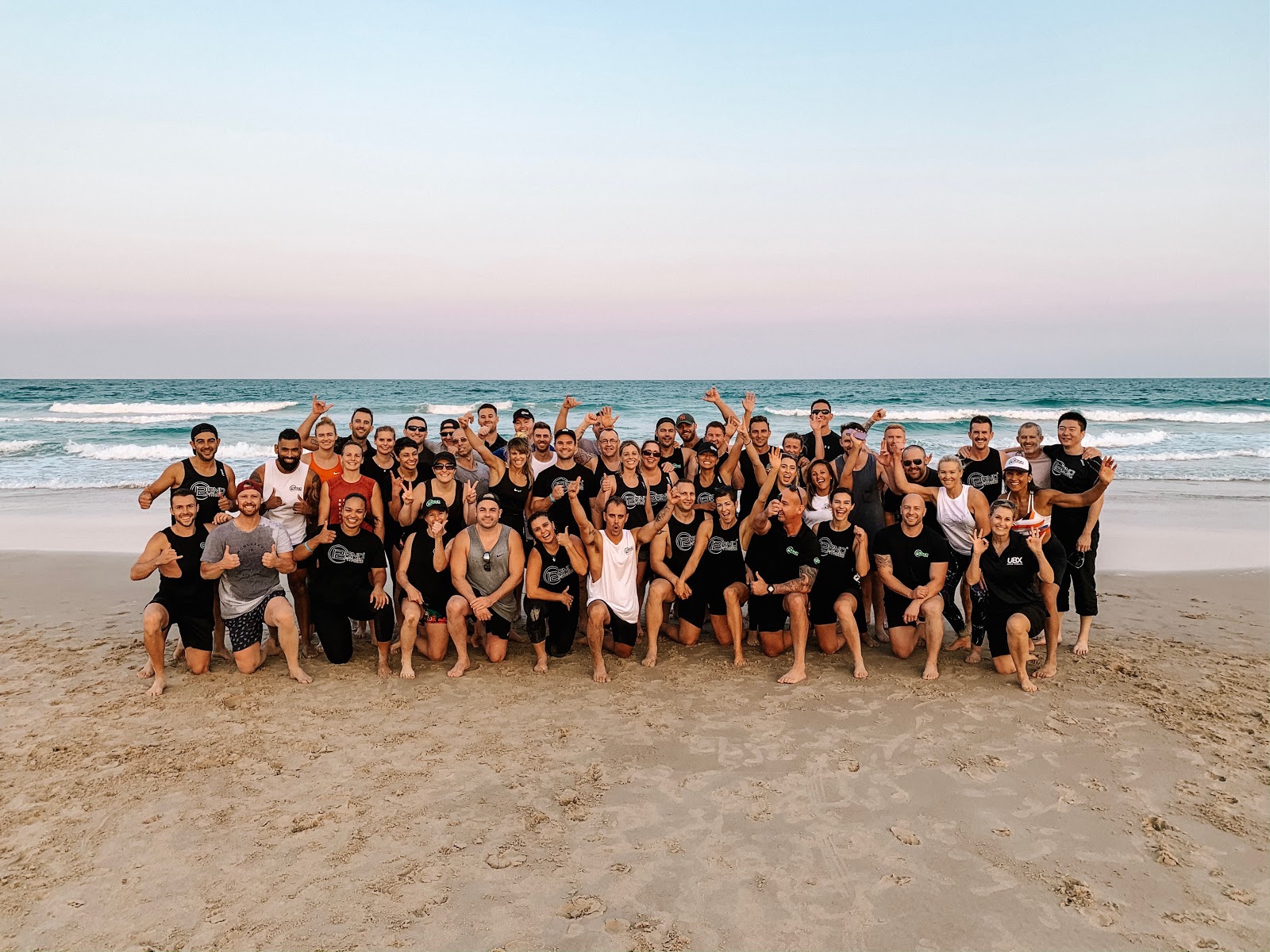
Our 12RND Fitness and UBX Training Franchise group at our 2019 Annual Summit
Covid-19 has had a major impact on many industries, and for the fitness industry it has meant forced closures globally and left many businesses in uncertainty. We were in a position as a franchisor where we needed to break through that uncertainty for the sake of our franchisees and continue pushing forward.
Just last year, on average, we opened a new club every 11 days; we expanded globally into New Zealand and Singapore, and were set to open in the UK this April. We had teams heading to the US, UK, Singapore, China, UAE and New Zealand to meet with prospective franchisees, and five new franchisees with a site ready, waiting to open their doors. Not only had this momentum ceased, but we had to find a way to help our existing franchisees keep, or at least maintain, as many of our 15,000 members as possible.
It all felt so surreal. It was all happening so fast. Adrenaline levels were high, as was the sense of responsibility. There was a lot of pressure knowing that so many people were relying on me and our team to literally help fight for their existence. There was no time to feel sorry for ourselves, or even feel scared. We just knew we had to scramble to battle stations and do what needed to get done.
We knew that as leaders, we needed to step up. And, knowing that good leaders execute with speed and accuracy, we were focused on providing the answers and the initiatives as quickly as possible, and on a regular basis.
But where did we start?

Our Executive Team: (Left to Right) Joshua Keszegi (Global Sales Manager), Jonah Hales (Chief Operations Officer), Tim West (Co-Founder and Managing Director), Michael Jordan (Chief Executive Officer), and Edrianne Javier (Head of Marketing and PR)
Formulating the Game Plan
We looked at what was happening globally, reached out to contacts in markets already affected and developed a plan. This plan was built on a three-phase framework, accompanied by a strategy that followed the sequence of global events resulting from the spread of Covid-19 we had observed, and how they would impact our business.
The first step was to decide on a framework. In order to communicate and plan effectively we knew we needed a framework that encompassed the most likely phases of the crisis. Then, with those phases established, we could clearly outline what challenges we would likely face, the information that would be required, and the necessary strategies. This is typical of most developments we embark on as a business.
Before we introduce new procedures across our franchise network, we develop a framework that maps out our implementation, and ensures a clear approach and allows us, as a team, to stick to the game plan. Most importantly, as a franchisor, we can keep our franchisees on track as well.
Given these were unchartered waters, we looked to experts in our industry and the broader economy to get a feel for what was coming. We needed a framework that was logical and easily understood, flexible enough to adapt to changing circumstances yet specific enough to know when to transition from one phase to the next. Then, we found this video from Dr Paul Bedford of Retention Guru who had developed a three-phase model based on the Covid-19 pandemic as applicable to the fitness industry.


Based on what Dr Bedford outlined, we tweaked the framework to suit our business specifically. We knew our business would need to adapt to government policies and social expectations, then our members would be required to isolate if the crisis worsened, in which case we would need a plan to reactivate our business once it passed.
So, our phases became: Adaptation, Isolation and Reactivation.
Once we had our framework in place, our next task was to outline a strategy. There was an immediate need to look at our communications and operations. How could we ensure that we were remaining sensitive to the global climate, and at the same time continue to instill trust in both our customers and our franchisees? Also, where could we cut costs and continue forward effectively, yet efficiently?
This meant breaking down the phases to create a clear narrative for the communication to members and franchisees while also inspiring confidence. We needed to provide a proactive strategy for franchisees to action.
To do this, we thought about the needs of both the member and the franchisee and how we could meet them quickly. We began to look at what we had under development that could be repurposed, and what resources could be re-allocated to develop immediate solutions.
This is an important exercise we look to do anytime we innovate. What do we have at our disposal? We brainstorm as a team and find the most efficient way forward. This was even more crucial as we embarked on addressing the crisis at hand.
To ensure that we always have a good understanding of the moving parts of our business at any point in time, we plan all developments through an annual roadmap. This roadmap includes all the developments we plan to deliver over a calendar year, how far developed they are and what resources they need to complete.

This has always been pivotal to our ongoing growth to ensure that we continue to innovate at the same rate that we expand.
Without this road map it would be harder to see the big picture, allocate resources and limit "scope creep," which is when you are continually at risk of expanding the scope of a project because you keep thinking of what else you can add on throughout the process. On one single page we can see the priorities of each department and the innovation pipeline which is critical to driving momentum.
It was very clear that a lockdown was inevitable. So, we looked at elements of the brick and mortar offering that could be translated to a digital offering. We identified suitable technology elements on our road map to piece together the solutions.
Fortunately, pre-Covid-19 we were already in the process of developing a suite of "smart club" solutions to improve the efficiency of the clubs. This included developments such as interactive screen technology, video content, member apps, and a performance hub for franchisees. We were able to repurpose many of these elements to quickly put together our new training app and create a central communication platform to get information to our franchisees quickly.
With a clearer vision of how we could pull this off, what would be involved, and a timeline of implementation that we could quickly pivot to suit changing government mandates, we began our first phase—the Adaptation Phase.

Phase 1: Adaptation
The Adaptation Phase involved adapting our operations to suit the changing government restrictions, adapting our communications strategy to keep our community informed, and leaning on suppliers to adapt their services to suit our changing circumstances.
This phase began as soon as the first social distancing restrictions were handed down.
We understood that members would be concerned about hygiene, and so we diligently prepared our franchisees with solutions to implement: we changed the workouts, and we reduced the number of members that could train at any one time. However, as soon as we implemented these changes, we were already planning for the next.
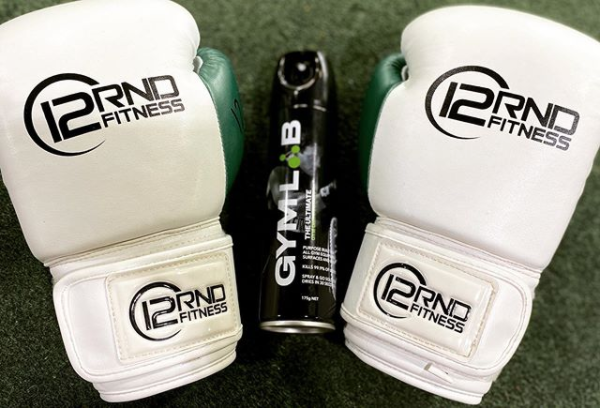
As we hesitantly anticipated, within a week, our clubs were closed but we could still run Outdoor Bootcamps, and so we did. Meanwhile, we fast tracked the release of our training app so that members had access to our workouts from home.
Throughout every change, we looked to our suppliers for expert advice in their relevant fields, and for financial relief or technical support under the circumstances.
Our legal team provided advice on the changes to legislation, clarity on what was or wasn't permitted and interpreted laws and new legislation.
Our accounting partners simplified information on the government's stimulus packages and initiatives to ensure we didn't miss out, we received insurance advice, reductions to subscriptions and renegotiated deals.
Moments like this, we really felt the importance of establishing strong relationships with trusted and reliable suppliers. We set out to do absolutely anything that we could to lengthen the runway for franchisees' businesses and passed these updates onto them in real time. And with the help of our suppliers, we could continue adding further support wherever possible to our franchisees under the circumstances.
Although our franchisees could continue running and servicing members with these adaptations, we still needed to address the club closures.
A big part of what our members pay for is access to our facilities, and the value that comes with that such as equipment, social interaction and face-to-face coach guidance. Without that club environment, would we truly be fulfilling the expected value of their membership fee?

An Unforeseen Industry-Wide Drama
Beyond all of the obvious effects club closures would have on our business, such as the immediate drop in active members and revenue, there was one unexpected issue that impacted many of our competitors and led to them losing thousands of members in an instant.
The issue was so simple yet so destructive. The Australian Consumer Law prohibits businesses from taking payments for goods or services when there are reasonable grounds to believe the services won't be supplied.
Our clubs were closed, therefore we could no longer provide training to our members in the same way we did before. And, in a knee-jerk reaction, many payment processing companies cancelled all direct debits agreements immediately, resulting in the businesses who rely on their services losing all payment information for their customers along with the authority to process payments in future.
This was a HUGE problem.
This meant that upon reopening their business, they would need to set each member up with a new membership, rather than simply reactivating their existing one. Essentially, once you terminate a recurring payment at the payment processor level you couldn't just turn this on again without written approval from the member.
This would be critical to our franchisees. We needed to ensure that they were in a position to receive immediate revenue as soon as business could resume as normal.
In a previous life I had developed a fintech business that processed payments for fitness businesses, and so I intimately understood that our own provider would see risk in processing payments during this time. In the uncertainty of whether the businesses they service may or may not reopen, naturally they were inclined to terminate existing agreements (as I would have done in their shoes).
Unlike other providers that were going into effective hibernation to see the crisis out, our plan would allow us to continue to trade with a modified digital offer and so I knew we would need these merchant facilities to stay active to process payments. So, I proactively reached out to negotiate the terms immediately.
Approaching these kinds of negotiations doesn't have to be complicated, messy or stressful as long as you identify the crux of the problem and offer an alternative solution that addresses the key needs of all stakeholders in the most straightforward way possible. In this circumstance, I was able to identify the risk to the supplier, consider what actions they would realistically implement to absolve that risk and propose an alternative plan that would meet the needs of both the supplier and our network.
In this case, that solution was to place a mass hold on all memberships using our Member Management System (MMS) to immediately pause all payments indefinitely. This action meant that no "debit requests" were being made against the customer accounts stored with the billing provider, hence negating the risk to the billing provider altogether. In our favor was the ability to completely control when the billing was restarted and the flow of funds restored. Thankfully, we also have strong relationships with our MMS provider and could initiate this quickly to meet the guarantee made.
One hurdle completed… one of many to come.
Then it happened – no more Outdoor Bootcamps, and it was time to adapt once again.
Phase 2: Isolation. How to Get More Than 80 Franchisees Online
After a late Sunday night Prime Minister address, we had to close all of our Australian clubs with fewer than 24 hours notice. It was hard to catch our breath with how quickly the situation was changing and impacting our business. Our team was working overtime. Our franchisees were understandably beginning to panic. Our members were confused and concerned. What was going on? And what would happen next?
We entered our "Isolation" Phase.
The Isolation Phase had been in development the moment there was a whisper of our clubs having to close. We had already begun to fast-forward any tech projects that had been sitting on our road map that could provide value in continuing to service members without our club environment. Now, we needed to figure out how to carry out that transition while maintaining as much of our membership base as possible.

But, we knew that we weren't alone. Our competitors were facing these same challenges. Every single fitness provider closed. All of our members would be searching for an at-home alternative for their training. So, why not keep them enjoying the same workout they know and love with us?
The primary goal was to target the "low-hanging fruit", our existing members who wanted to continue their training. We wanted to reactivate members who were automatically put on suspension after club closures and transition them on to a digital membership, while also targeting historic leads and members who at some point showed an interest in our product and perhaps now need a training solution in isolation.
Our team hustled hard to deliver a brand new ebook and fitness app to equip our franchisees with a high-value offering that would encourage members to maintain their paid membership, or at least part of it.
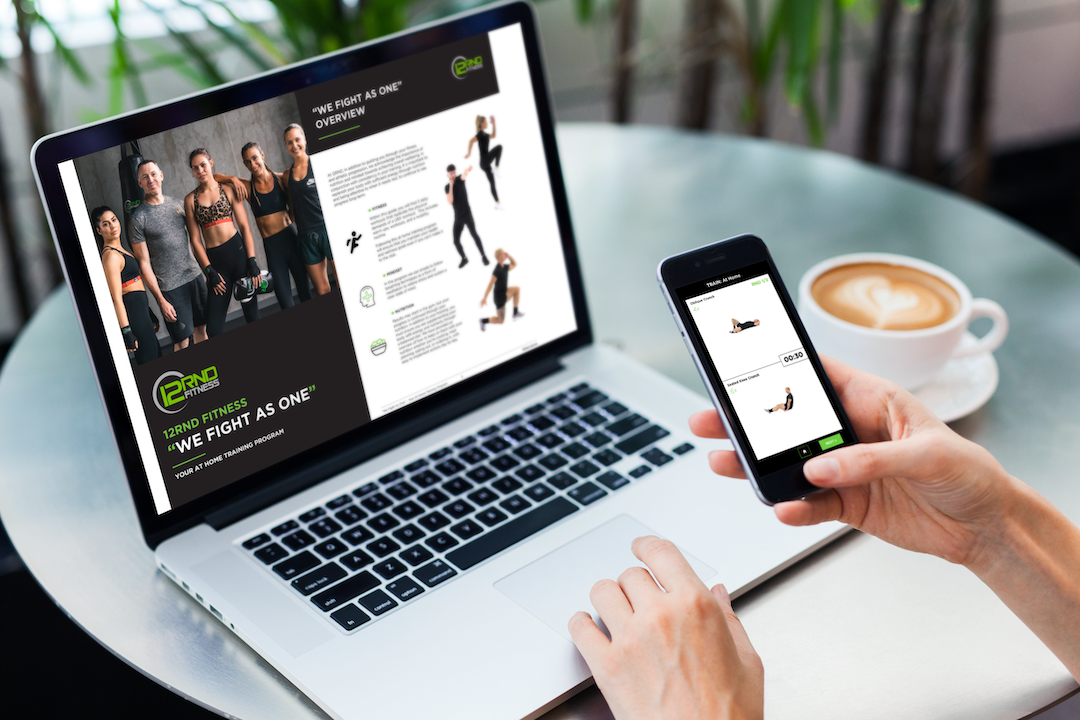
We continued building on this solution by providing a framework for delivering live daily workouts via video conferencing platforms, such as Zoom, and keeping members motivated and accountable through the use of a digital member tracker and one-on-one coaching calls.
The support we provided included call scripts, email templates, and step-by-step instructions on how to use various platforms to implement this solution because we knew we needed to provide both the strategy and the tools to execute.
The approach was to proactively consider any possible gaps in information that may result in uncertainty for franchisees where they would require support, and preemptively develop a resource that addressed it.
Similar to Elon Musk's approach of solving problems, we, as a team, constantly challenge each other to justify our work. Not in a criticizing way, but in a constructive way that productively pushes one another to ensure that whatever we produce has a purpose, and we can always identify ways to be more efficient, concise and "user-friendly" for our franchisees.
In this instance, that meant every time we set out to provide an additional service offering within our digital solution, we considered elements such as:
- How will franchisees teach their members how to use it?
- Do our franchisees have the capacity to implement this offering?
- What does the workflow look like?
- What guidance do they need to implement effectively?
Most importantly, we always ask, "Is it necessary?" and "What value does it provide?" This ensures everything we do contributes back to our initial strategy and towards our overarching goals.
After the process and operations were established and handed down to our franchisees, we needed to consider marketing and how we will let our audience know that we have made this transition. We had already identified that we would rely on our existing database as our primary market, but we needed to consider how those consumers' behaviors may have shifted.
Reconnecting with our Audience
Once clubs had closed and boot camps were ceased, we were left with "active members" who had continued paying a membership in exchange for our adapted digital services, and "inactive members" whose membership had been suspended during our bulk membership holds and had not chosen to reactivate for whatever reason.
However, now that our franchisees were fully equipped with a high-value solution to keep members on an active membership, we needed to also find ways to support our inactive members. How would we keep them engaged? How do we ensure that when we reopen, they are excited to restart their training? And on top of that, now that we have a product, how can we tap into additional markets and continue generating leads and revenue?
We started with developing a high-impact and concise marketing strategy that encapsulated all of our new products and services. The "12RND At Home Training Pack" was born. Simple, effective, and communicates immense value.

Rather than having to highlight each individual aspect at a time, we developed social media content, email marketing, call scripts and other digital graphics that outlined everything included in our pack to emphasize value and excitement with what you receive when you get started.
Having established this pack, we knew that we could begin marketing its value to new markets of people who may be in isolation, and whose gym or usual fitness provider may not be able to fulfill their fitness needs at home.
Confident that the additional elements we had developed within the pack fulfilled the expected value of the digital membership, we decided that we would activate a goodwill campaign and make our new ebook available for free to everyone.
We knew that once our members and franchisees were taken care of that we had the opportunity to extend some of the value we had created to the wider community who we knew would appreciate the content.
With a plan in place, a solution implemented and government mandates beginning to slow down, we found ourselves coming up for air and we wanted to begin looking forward.
We were no longer in those initial stages of having to be so intensely reactive every hour of every day. We, as a team, just like many others now working from home or self-isolating, started to settle into our "new normal."
We took this opportunity to prepare our business for a comeback.
Phase 3: Reactivation. Preparing to Come Back Stronger Than Ever
Rather than getting caught up in the setbacks we faced, or allowing ourselves to become complacent with the digital solution we had developed, we knew this was a time to emerge on the other side stronger than ever before. Times like these are the perfect opportunity for wholesale innovation.
We were past the point of reacting and now had the time to take decisive action to grow and get ahead.
We felt like we'd been given an opportunity to reimagine our business, explore new revenue models, improve efficiency, and unite the franchise group through shared adversity.
We had fast-tracked our business model evolution, and were forced to test new ideas—some of which we may not have had the courage to test.
Now, how would we continue this momentum for the foreseeable future while there was still so much uncertainty around when our clubs would reopen?
We very much expect that reactivation will unfold through the same sequence of events in which we found ourselves entering isolation but with longer transition periods, and so we now have the opportunity to make each of our initiatives even better.
We are finding ourselves back at the drawing board looking to enhance the entire process in any way possible. And not only processes that were established as a result of the crisis, but even our existing operations. What can we do to improve our brick-and-mortar business, adapt to the new norm and future proof?
With forced closures, cheap money and government stimulus available for many businesses, it's an opportunity for us to review our fitout and setup, and potentially introduce new equipment and further technology to fast-track our "smart club" progress.

We also now have a completely new service offering that we can continue to provide. Our digital solution will allow us to reach audiences in areas where we don't yet have a physical presence, and provide an alternative membership solution for those experiencing dramatic changes to their financial situation and lifestyles.
Notwithstanding many economic, social and competitive factors, we believe on balance there will be a greater demand for fitness coming out of isolation, for those who may not have been able to stay on top of their progress while away from the gym, lost their fitness provider due to business closure, or find they have a newfound motivation once restrictions are lifted and greater freedom returns.
Essentially, we are not slowing down.
Adversity is almost always accompanied by opportunity so it's important to get comfortable with being uncomfortable. Celebrate your wins, learn from your failures and move on.
No one expected that in 2020, the entire world would be forced into lockdown due to a pandemic. But many businesses have pivoted, stayed relevant and continued to offer value to their consumers, which means that we can expect a huge surge in innovation as a result.
If you have been sitting on an idea you now have a great opportunity to re-think it and adapt it to the post Covid-19 world, ask yourself: "What did the established businesses in the same markets as yours do to adapt?" "How successful were they at it?" And, "Could you do it better if you were designing the solution from scratch?"
This is a great opportunity to create new markets or take market share from incumbents so use this research and make the most of this opportunity to rebuild or redesign your business.
Put yourself in your prospective buyer/customer's shoes and consider if your offer gives them real tangible value and how you can continue to build on that value over time.
Most importantly, keep moving forward, act quickly and decisively, and intentionally foster a culture of innovation so that when the unexpected happens you have the ability to adapt.
If you want to know more about my background, what led me to start 12RND Fitness, or even have any ideas or thoughts on our framework and approach, just comment below.
The post The 3-Phase Strategy That Crisis-Proofed Our Fitness Business appeared first on Foundr.
]]>The post 304: Alex Osterwalder On Why Products, Technology, And Price Aren't Enough To Keep Your Company Competitive appeared first on Foundr.
]]>Subscribe to The Podcast on iTunes, Soundcloud, Stitcher and Spotify
Alex Osterwalder, Author, Entrepreneur, And Co-Creator Of The Business Model Canvas
Click here to Skip to the Podcast Transcription
Alex Osterwalder is primarily known for developing the Business Model Canvas, a template that helps startups develop and document new or existing business models.
In this interview, Osterwalder shares his best insights into the world of business models—ideas that are especially applicable now as entrepreneurs try to launch businesses during Covid-19. He explains why products, technology, and price alone aren't enough to keep your company competitive. Osterwalder also breaks down the innovative models that Apple, Netflix, and Nintendo have used to become industry leaders (and why even these behemoths aren't safe from disruption).
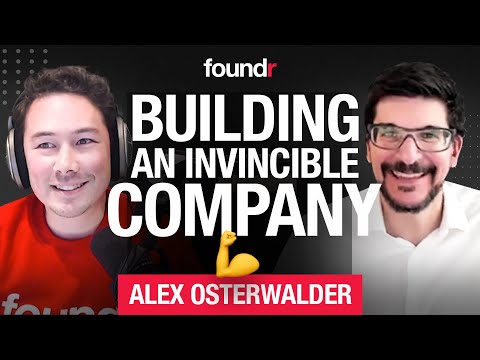
We also get a sneak peek into Osterwalder's latest book called "The Invincible Company." Not only does it contain an entire library of business models for companies of all sizes, but it also provides guidance on how startups can continuously reinvent themselves to stay ahead of the curve.
If there's any other content you'd like to see that would be valuable to you during this time, please don't hesitate to reach out at support@foundr.com.
Key Takeaways
- How Osterwalder came to study business models in graduate school
- Insight into Osterwalder's latest book, "The Invincible Company"
- Why companies can't compete on products, technology, and price alone (and why your business model can provide the ultimate competitive edge)
- The scalability of business models
- Why companies need to transcend industry boundaries
- The reason why Osterwalder urges entrepreneurs to test before they build
- How Apple, Netflix, and Nintendo are prime case studies of innovative business models in action—but why even they're not safe from disruption
- Osterwalder's stance on the "magic bullet" when it comes to business models (hint: there isn't one)
Full Transcript of Podcast with Alex Osterwalder
Nathan: The first question I ask everyone that comes on is how did you get your job?
Alex: I don't know if I have a job, I have a hobby that I really like doing. I started working on business models when I was still at university, did my doctoral dissertation on that. Then I just went on in this space, wrote a book and just always followed my passion. I was always interested in businesses, how do you create businesses? I wouldn't even call it a job. It's just I'm doing what I'm passionate about.
Nathan: Yeah, I love it. How'd you get into business models? What exactly piqued your interest there?
Alex: When I finished my studies in management information systems, I had a professor … who's now a long term friend and co-author, and he was looking for a doctoral student to work on the topic of business models that was in the year 2000. The idea was that if we can model business models, then we can make a software, like a drawing table, a computer aided design software for business people, like architects have or engineers have, that was the origin, and that's how the whole thing started.
I started in academia, but was always interested in practise and real companies. Then, I started applying this in the real world pretty much later on.
Nathan: Yeah, I see. A lot of people that are in our audience, they might be just about to start a business, or they're looking to launch a business, or they've been doing it for a few years? That's the majority of our audience. They're still fine tuning their model. I'm really excited to talk to you about your new book, The Invincible Company. What is the premise of the book and what compelled you to write it?
Alex: When we start a new book, the first question we always ask is, does the world need another business book? There's so many out there, and there's so many business books written. We really push ourselves to see, does it really make sense? There are two topics, I think, for this particular audience, and what we really wanted to bring to the table is better business model thinking.
I think competing on products, technology, and price alone is a battle you can only lose. You might… Yes, you have to come up with great products, yes, you might want to come up with new technologies, but the real competitive advantage is now in a better business model. We created… Part of the book is an entire library of business model patterns that help people compete on better business models, not just product price and technology. That's a big part of the book, that's the one that probably is most interesting for this audience.
Then there's another part of the book, which is more for companies that are established, could be small or large. You can start anywhere around, 10, 30 people. How do you constantly reinvent yourself? How do you stay fresh? Because once you have a business, you're always at risk of disruption. You can never fall asleep at the wheel, and you really have to reinvent yourself because it's harder than ever before, to stay ahead, to stay in the game. You need a great business model, but you also need to reinvent your business model all the time.
Depending on your journey, this book offers you different things. The reason we actually wrote this book is because we've seen some unsolved jobs in the market that people just really weren't really good at. Today, I still think most companies, they compete on products and technology, and that's not good enough because you can't stay ahead. Then the other aspect is very few companies are good at reinventing themselves.
Nathan: Interesting. I've always come from the school of thought that if you're in a market and you have the best possible product, generally, that takes care of a lot of your traction. What's your take there?
Alex: I think that's how you might have been able to compete 10, 20 years ago. I would say today, everybody expects great products. Nobody's buying crappy products anymore, because you compare them on the internet. You can't survive with a mediocre product. Everybody's trying to compete with the very best products.
Now, what really allows you to stay ahead is if you embed that great product in a superior business model… I'll give you an old example, but an interesting one, the iPod. Everybody saw Steve Jobs coming up with this new technology, and a new device. When he pulled it out of his pocket at the launch, he said, "Well, it's the first time we can put thousand songs in a pocket." Everybody saw product innovation and the technology innovation.
What most people don't know is that was actually a business model innovation, there was a very clear strategy that Steve Jobs had in mind in Apple, which was to get everybody to put thousand songs onto the iPod, into the iTunes software, so it would become very hard to switch. Because once you have your entire music library on a device in the software, guess what it's hard to switch.
That would lock customers in and they would come back to Apple for the next device they would buy it. That's a business model strategy. This is called… We call them gravity creators. They lock in customers. That is the superior aspect that they built around a technology innovation, around a great product. It's not that they didn't have a great product, but this strategy was not just a product strategy. They had to change a lot in the business model to even make that possible. They had to work with record companies, et cetera.
In particular, first time founders, they don't see those business small aspects. All they focus on is product. That usually is the recipe nowadays for very short lived success. You might be able to flip your company to a larger competitor that will acquire you, that's not bad, that's a strategy, but to outlive others, to out compete the others, for that, you really need a superior business model.
Great product for me is just a ticket to actually join the ride, but actually to stay on the ride and stay ahead of others. You need to weigh more, and I think it's just not good enough anymore. That used to be okay 10, 20 years ago.
Nathan: Yeah, interesting. When you talk about a superior business model and the companies that you're referring to, you're talking about category kings that last for a very, very long time, that is a business of true worth significance, truly sustainable over many decades, just for context.
Alex: Well, if you get there, that's obviously what we call an invincible company, and not that many companies get there, I think because many of them, A, don't understand business models and B, they don't reinvent themselves. There are companies that had a great business model, but they didn't reinvent themselves. But to illustrate this a bit more take GoPro. GoPro has great products and a great brand, but nothing in the business model protected them from competitors. There's nothing, there's no patents, there's no switching costs, there's nothing.
Guess what? They got into trouble because they grew very quickly, they became very big, but then it was very hard to stay ahead, because you're just competing on product, price and brand, and that for me, that's just not enough anymore. If you know how to do this, it doesn't mean you need to become super large, but you can be company makes 10, 20, 50, $100 million in revenues and you can still be an invincible company at that size. Not everything needs to be large. I don't believe in scale at any price, it's just around superior business models.
Think of the business model of one. If you're a comedian and let's say you have a stand up show, maybe even on YouTube or whatever, probably very popular now, they constantly reinvent themselves. They put 20% of their time of the show goes into new material. They might bomb with that material, but that's okay, because they have 80% proven material. Even in the business model of one, the idea of reinventing yourself is extremely important. If you can build a superior business model around even the product of one, that's great, you can sustain.
It's not just about large companies, it's about companies of all size. It's the mindset that counts. Reinventing yourself all the time, competing on superior business models. The last one I didn't mention is transcending industry boundaries. I think companies that see themselves in one industry, "Oh, I'm in gaming, oh, I'm in news. I'm in pharmaceuticals. I'm in banking." That's disappearing more and more, because most successful players these days, they transcend industry boundaries.
Just ask yourself Apple, what industry are they in? Entertainment, hardware is how they make money? But it's really across. Thinking about industries, it doesn't make sense anymore, it's about really, what arena are you playing in, and how can you build a great business model in that arena? That goes for business model of one, that goes for small and medium sized company, that goes for a large player, just different scales, but it's the same thing. It's the same attitude, the same tools, the same thinking.
Nathan: Interesting. Bringing it back for people that are listening and watching, and perhaps they're in a stage right now where they're looking for a market to enter, looking for a product to start with, what should people be doing? Because this thought process is very, kind of long term, right?
Alex: I think the challenge of a lot of entrepreneurs, in particular early stage or young entrepreneurs, young means first time, not necessarily young in age, is they overvalue the idea, the vision, and you just should get started. To use Blank's words, as he said, get out of the building and start testing.
Ideas are free, ideas are everywhere, opportunities are everywhere. The hard thing is to turn ideas into a value proposition that customers care about, and a business model that can profitably scale. It's all about shaping your idea quickly. I suggest you use tools for that. It's great products. Again, not enough. You can fail and go bankrupt with a wonderful product, but you can't make enough money for it, it cost more than you're in revenue. Then test it and adapt it all the time.
That attitude is super important. Again, this field has been evolving very quickly. Just by listening to a couple of podcasts, nothing against podcasts. Listening to a couple of podcasts, going to a couple of workshops is just not good enough anymore. This is now a real profession. Steve Blank, and Eric Reese and our team at Strategyzer, we really push the boundaries today to saying, "I'm testing a little bit." That's not good enough anymore. You really need to get serious about this. This is like a real job.
The analogy would be, the web in the early stages, everybody could make a web page. Now, you get a laugh if you say, "I'm making webpages." Really? Now it's about 20 different jobs at UX design, different types of coders, and all different kinds of things. That's where we're moving towards in entrepreneurship and innovation. We're getting very sophisticated, we can measure the reduction of risk and uncertainty.
Now, that doesn't mean you need to start simple. You just go out and start testing. But you need to inform yourself, how is testing done today? What are the best practises? How does this work? How do you measure if I'm actually making progress from idea to business? There are a couple of books out there that can help you with that.
Nathan: I see. When it comes to business models, just go out there before you even worry about that and just start testing and try and validate your product first, and then once you've got market fit-
Alex: No, no, no. The reason I'm pushing back is this misconception in the Lean Startup movement, where the process is called build, measure, learn. Guess what most people do in particular engineers when they hear, build, measure, learn? When you go and build something, forget the build for a second, it's about testing your idea. Often… Let's take it step by step. First thing you want to ask yourself is, when you have an idea, you shape the business model, you need to do this from the beginning to shape it. It could be wrong, doesn't matter, but just give it a shape. Customer segments you're targeting-
Nathan: Business model canvas.
Alex: All of that. But very quickly, just spend an hour or two, that's it. Then you need to ask yourself, this is the fundamental thing you need to do first, what needs to be true for this idea to work? What are the underlying assumptions, the hypothesis?
You first ask yourself, what are the biggest hypothesis? Do customers have this problem? Are customers willing to pay X amount of money? What are the costs? Can I produce at this particular cost? Come up with all of the assumptions, all of them underlying your business idea, your business model. Then you prioritise. That's extremely important, you prioritise. It's usually not a product assumption that is number one, it's often a desirability assumption. Do people have this particular job? It could also be a viability assumption, are they willing to pay for this thing?
You can test that without building anything. Never start with the product. It's actually very wrong, because if the product is what you have in mind, your customers maybe don't care. The supply chain maybe doesn't work. Ask yourself, what are the most fundamental assumptions? Prioritise those, and then you ask yourself, what's the experiment I need to design? I can do customer discovery interviews. Oh, I could do this thing called card sort where I understand the most important pains of my customers, where I can understand what are they willing to pay for most?
I can do Google ads to test customer interest. Building usually comes a lot later. Really, I'm pushing back on this because it's one of the biggest mistakes that people think they need to build something to test. No, they don't. The book we launched before actually, last fall was called Testing Business Ideas. David Bland was the lead author.
The big point we tried to make there is, you don't need to build something, there's a whole library of experiments that you can do first, that are a lot cheaper, a lot faster, before you build anything. Then the main thing there is just don't fall in love with your idea, don't try to build something which you think is a great idea, test, test, test. It's almost push yourself to almost prove yourself wrong.
If you can't find enough evidence that you're wrong, you're probably right. That's the attitude you need to gather as much evidence as you can. Building is not always required. Actually, it comes up often much later. You can start with product brochures, that doesn't mean building anything, you just make a PDF with the performance of your product. In B2B, you could do that, medical devices you can do that, that's a much better approach than building anything.
Speed of testing and learning, that's the essential thing you want to really focus on first. There is a moment where you need to build, but that's usually not at the beginning.
Nathan: Yeah, interesting. Talk to me around how do you know when you've got that traction, or like you said, you've proved yourself wrong? What holds your hypothesis true?
Alex: I think when people start with this and probably that's still a bit of… At the early stages of a profession, people think there's this lightning moment where the path will open up and you see candles left and right of that path. That never happens. Entrepreneurship is this mix between art and science. The art part is that you try to recognise the patterns, you try to see, you try to get a feel for it, and you test your vision constantly.
The science part is that you test but unfortunately, it's not just science, just like it's not just art. It's not the creative genius, and it's not just the scientist. You're always in between. You have to make bold bets based on, or some people call this taking a leap. Based on the evidence and how it shows up. But here's the thing, you actually need to run probably 20 to 30 experiments to start seeing those patterns. That people think, I'm going to build something, I'm going to test the market, adapt a little bit and then I got it. No way, you need to run 20 to 30 different types of experiments to really understand your customer deeply, to really understand if you're able to create value for your customers, to really understand the price points. That is the profession of testing today.
When you run 20 to 30 tests, you start to see the patterns. But it doesn't come from one experiment, it comes from 20 to 30. Then you start to see the patterns, you start to see the conflicting data, the contradicting data, and then you do another experiment to go down one path or another. The biggest thing, obviously, is that it's not a straightforward path. It's like you dive deep, you come up for air, you dive deep, you come up for air until you start being able to put the puzzle pieces together.
If you ever did a big puzzle, it seems unsolvable at the beginning, but there's never this clear thing coming up, there's always a struggle. But all of a sudden, it's wow, I'm getting there. I didn't know how this happened. It's the same kind of mystery when you put together a huge puzzle. There is no clear path. There is no clear moment where everything falls in place. It's a constant struggle, but all of a sudden you actually get there.
Nathan: I see. This is like product development 101. But what about sales? Let's just say you put up a landing page, you've got A, idea, you put up a landing page, you run ads to it. You get a really low cost per click from the ad, and then the opt-in is, you're paying $1 a lead, and it's just super cheap, and there must be interest. Then you have 10 different landing pages. And you can see which one hits a nerve. Then like-
Alex: I think the problem is, and this is what we've seen in practise a lot is people don't really… Actually, the art part is more there than the science part. When you are in deep natural sciences, which we're not talking about here, we're talking about social sciences. You actually know which variable that you're looking at. Often, people would put up a landing page with 20,000 things on there, and then they go and test with Google ads that have five different things in the ad in terms of value proposition, pricing, et cetera. You don't actually know what's working.
Let's think of the other way around, if you made your assumptions very clear, and you say, "Okay, for this idea to work, I need the customer to have this particular problem." Then the only question is, what experiment will help me validate if customers have this problem or not? Once you know they have the problem, okay, now I can go to the next thing. Now, I can start to do Google ads, because I know they have the problem, at least those people maybe that I talked to, now you are starting to ask yourself, is this on a larger scale? Is the wording of my Google ad right? But you've already proven that they have the problem.
You need to isolate some of the variables, which we call hypothesis, because you can't test 10,000 things at the same time. That's why you rarely should start… Yes, I think it's product management 101, but we see everybody screwing it up. They would come up with this product, they would put the product prototype in front of customers and ask, "Would you buy this?"
Everything is wrong about that. Number one, you just frame the conversation around your idea. Very few customers are going to say, "Look, that thing sucks. I really don't care." They're going to be friendly, and say, "Yeah, you know… " But they won't tell you what is the fundamental job they're really struggling with?
First thing is, you forget your prototype, and you start to understand, with the right testing methodologies, what are they struggling with most? Number one, you find evidence for that. You do one at a time. You can almost call it lazy, but I think it's not laziness, it's just people don't know better yet. They would put this whole product in front of people.
When I say whole product, what's the problem? There's 10,000 variables in that product. Their shape, their colour, their features, maybe their pricing? When they say no, you don't know what they're saying no to. Maybe they were just pissed off about the colour. Maybe it was the features. Maybe they like the feature there that could have been huge potential.
It's in the details. I think product management, to a certain extent is still in the early stages when it comes to really doing these things right. The challenge is, first and foremost, very few product managers and entrepreneurs or innovators, I don't see them first asking what needs to be true for my idea to work. I don't see them prioritising hypothesis.
Sorry for sounding a little bit like a teacher, but it's to a certain extent, on the one hand of frustration but on the other hand, I'm asking myself, what do I need to do better to get the product managers and innovators and entrepreneurs to understand this better? We write books, we do online courses, et cetera, because we want to elevate the profession.
I think slowly, slowly, we're getting there. Things change radically over five, 10 years. Steve Blank has done a lot, we're trying to do a lot and we only write new books when we think there's a need for that. That's why we wrote Testing Business Ideas, that's why we wrote The Invincible Company. But there is a little bit of frustration there, because it's a bit… People present things as a science, but they're not rigorous enough. But then others are too rigorous, and that's not good either. We were talking business here, not natural sciences. There's this fine line between being really good at it and being an amateur.
Nathan: No, this was great. It's cool to hear you just tell it straight, because I think there's always this aversion to testing, and there's this fun part of coming up with an idea and the creation side and the speaking to costumer side and the testing. That doesn't seem as fun as idealising something.
Alex: It's hard work. Let's put that first. If you look at early stage venture capital, only one out of 250 ideas is an outlier, is a breakthrough, unicorn if you want. Most ideas fail, six out of 10. Six out of 10, they don't even return once they get early stage venture capital, they don't even return capital, which means 60% of the people listening to your podcast now, they're working on something nobody wants or a business model that doesn't work. That's okay, because you actually get better at this over time.
You do it again and again and again. If you are, if you have the stamina, that's why a lot of people drop out, they do it once, "I'm not made for this." Well, yes, you're probably not, because those who really are good at this, they've done it several times, and they actually like the suffering to a certain extent. You need to be crazy to be an innovator, entrepreneur, and you need really persistence and grit that very few others have.
The fun part is the easy part, and that's usually… There's this term onetrepreneur, people who they stick with the easy parts and say, "If I just had the money, I'd launched it. Money is never the problem. I'm not trying to make fun of people, it's just that we need to understand this is hard, and it's hard work. The few who make it big, and we see on the cover of a magazine, you don't see the backstory, they went through a lot of hell. They went through suffering, and we need to tell that story because it's hard.
Nathan: I agree.
Alex: But I think once you start to get it, it actually becomes fun, but it never gets easy. It's always hard work. Just because you did it once, doesn't mean you're easily going to be able to do it twice, it remains hard work. The good news is, you do it five times, you're not going to make the stupid mistakes the fifth time around. That's why you want to join a startup first when you're young to watch. Maybe, statistics actually show that most successful entrepreneurs are after 40. I like that, because I'm 46. But it's true, the reason is that experience does matter. Not an experience in execution, and management but experience in a domain matter, experience in doing this as an entrepreneur, testing, this doesn't come easy.
It's really, really hard work. Good news is it's starting to be a profession, we have the tools, you can learn it. Some are better than others, but even if you're not great at it, you can actually learn it. But the biggest characteristic, I think of entrepreneurs and innovators, is they're okay with being humiliated day and night until they get it right.
The biggest thing that an entrepreneur can do is get up again and again, and again, you just get punched in the guts all the time. It's hard. The ideation part, the idea part that's easy, raising money even that's the easy part. Not saying it's easy, but it's easier than actually figuring out what do customers care about, and how can I create a business model around that, that scales and is protected?
Nathan: Yeah. Let's talk about the business model piece, because it can get complicated. You can put a lot of bells and whistles. I've actually fallen victim to that where you've got so many different ways to service a particular subset of market that you lose focus. What's your take there?
Alex: It's great what you're just saying is that's a big, big risk. You always want to keep it simple and ask yourself, is that a… Depending if you want to scale or not, is that a business more than I can scale, or am I trying to make something too particular for five different markets? You have to question your business model all the time. The limits of it, the strengths of it, the weaknesses of it, and you fix it all the time. One example I like, really like is Netflix because everybody knows it now, but when they started out, they didn't immediately work on streaming. We tend to forget that.
But when they started out, they had the vision of streaming in mind. But they started first with DVD delivery by mail, because they knew the infrastructure wasn't strong enough. They had this vision of where they wanted to go, but the steps they performed to get there were very different from their destination. What's usually pretty good as if you have a strong vision of where you want to be in five, 10 20 years, and you adapt the steps all the time, but you don't lose sight of the longer term vision, you just adapt the business model to get there, and you focus on what can really work.
You need to cut out the fat all the time of your idea because it's easy to actually get stuck with five different things. Usually, when a company has five to 10 different revenue streams, it's because they haven't found the one revenue stream that can scale. You can get stuck in doing too many things. I've been a victim of… I love creating stuff. Guess what, I create stuff all the time, but then focusing on that scalable part, and leaving everything on the side, that's a very strong skill that not everybody has, which part of what I'm seeing could really scale? Then leave everything else away. That's hard, that's not that easy, and that requires experience as well.
Nathan: That's interesting that you say around the five to 10 revenue streams. You believe if you're an early stage startup, let's just say you're making sub in the range of 10 to 50 million per year annual revenue. If you've got 10 to 15 revenue streams, like one let's just say advertising, another, magazines, another, digital courses, another, affiliates.
If you had like 10 to 15, you would say that you haven't found the one scalable model?
Alex: Look, it's always a choice. If you're comfortable with that, that's fine, but the challenge is the more different moving pieces you have in a business model, the more you're distracted, because then you need people who are good at advertising in your team. You just mentioned magazines, you need another group of people who are good at that.
What we're trying to do at Strategyzer goes in that direction. We have several different pillars of our business model, but we're a relatively small team. We're doing several things. That's pulling us in different directions. But it's a deliberate choice, because we believe those pillars; online training, software, coaching, all of those are needed in the longer term. That's a choice. As long as it's a deliberate choice, that's okay. But if you have five different revenue streams, and you don't think one could really allow you to focus, and those five, 10 things don't really fit together, then you're probably not on the right track yet.
But again, it's a question of choice. If you're comfortable with having… Some people like that, they like the diversity, and they don't care about scaling or so, that's fine, it's always a choice. But you need to make informed choices when it comes to the design of your business model. I think many people are getting really good at product choices, feature choices, et cetera, but they're not as good at business model choices, that is still a field where I think a lot of people can improve. But again, as long as it's an informed choice, there's no right or wrong business model. There's no right size. It's just you need to find something that works for you, as an individual, if you're a founder, as a company when you're moving in a direction, as long as it's a deliberate choice, you're fine.
I think that's important and you need to get to that as a founder. Some people, they say, "I want to scale." But they're not doing everything necessary to actually get to a scalable business model. Schizophrenic, that's not very good. Others, they want a tranquil life. They want to relax and so, but they're working on a crazy scalable business model, where you need to put 16 hours every day, and that doesn't work either.
Again, there's not one that's right, and one that's wrong, just try to align the business model you're focusing on and your objectives as an individual founding team or company.
Nathan: No, that makes sense. I guess, the reason I ask that question is just from my own personal experience with our company. From my experience, one way to scale is to bolt on other products. If you have a customer base, a customer base that you were servicing, and if you find other ways to service that customer base, you can rapidly increase revenue.
Alex: Sure. Think of the retail market stores or supermarkets, that was the initial idea that you're just saying. They just started adding categories, et cetera, or food companies, they start to add categories. That's okay, but that's one business model. You're actually not… More products doesn't mean you have more than one business model, if you're just making reselling-
Nathan: Many revenue streams, though?
Alex: No, it's the same revenue stream, you're making something and you're selling it. A different revenue stream for me is when it comes from a different customer segment, and it's different in nature. One is transactional sales, one is a subscription, one is negotiated based on sides or whatever, those are different revenue streams-
Nathan: Different selling cycle as well.
Alex: If you're just buying and selling or making and selling, it's the same revenue stream. The whole idea is a business model is not about the number of products, it's how you create, deliver and capture value. If you create value the same way, if you deliver value the same way, if you capture value the same way, you have one business model.
Take Amazon with eCommerce and Amazon Web Services, that's two fundamentally different business models with fundamentally different revenue streams. Now, what's interesting there is also a fundamental synergy between the two, which is the backbone, the infrastructure, so it can make sense, but it's a deliberate choice. I tell you, the stock market hated them at the beginning because they said, "You're crazy, you're branching out into B2B, it's not your business, you're in eCommerce." They said, "No, no, we're actually in growth."
They started to build a hugely profitable business in a completely different industry. Again, industry analysis doesn't make sense because it's the same basis with two very different business models, but synergy between the two." You need to, as a founder understand, are you in the same business model? Are you starting to diversify your business model? Another way to understand it, is do I require different resources and activities?
If you're building software and selling software, that's one type of resource and activity. If you're starting now, online courses, all of a sudden, oops, you just added a completely new activity, which is content creation, and probably you're creating a new resource, which is online courses. Now, if that's a deliberate choice, it's fine, but you need to be aware, and I think for founders that are starting out, at the beginning, having five business models you're exploring is usually dangerous, because you're going to die with all five-
Nathan: Because I talk to that focus, right?
Alex: It's all about focus. That's back to the basics, all about focus. But think again, as long as it's a deliberate choice, if you think you can build two business models at once, that's okay, but that's tough. You just need to be very aware that's tougher. Usually, that doesn't really work, so back to focus, build one then build a second one or think Netflix. Have one five, 10 year vision in mind while you're building your first one and you're always testing the second one. That's a very good strategy as well.
Nathan: Yeah, bullets versus cannonballs, right?
Alex: Cannonballs, that's very wasteful, let's put it that way, and you run out of cannonballs very quickly.
Nathan: I love Jim Collins' work as well. Awesome. Let's talk about, to you, what is the ultimate business model? Is it two sided marketplace? Is it B2B SaaS?
Alex: Because I'm rubbing my eyes if it does, everybody wants the magic bullet. I'll say, the magic bullet is there is no ideal and superior business model per se. What you need to build is this ability to design the right business model for the right opportunity at the right time. That is a skill, because if you just copy everybody else in, let's say the SaaS business model, there is no SaaS business model per se, because they're all different. Now, do they have similar characteristics? Yeah, they all have similar infrastructure, they all sell subscription. But guess what, somebody started that, and it was a disruption of the licencing model.
You could disrupt this SaaS business model as it is known today and come up with a completely different one. There are actually some people that at SAP, this is not the company's opinion, but they say, some of the leading thinkers there, they say subscriptions are the wrong thing for software, because it should be pay per use. Just like we have, maybe at Amazon Web Services.
You could today come up with a better business model. I think customers would actually be happy with pay per use, maybe, I don't know. Maybe it's for some industries. There is no one single business model. What you need to build is the skill to find the right one. To do that, just like… is if you're going to ask, what's the one right software for enterprise resource planning? There is no one right software. There will always be renewal, there will always be change because the problems change, et cetera. We need to develop this ability to come up with new business models. That's the key skill.
Are there some that perform better? That's why we came up with business model patterns. You were pointing in the right direction, for sure. Where you said platform model. Absolutely, it's harder to disrupt platforms models. That's the business model patterns. Is that the truth? No, because you can see platform models that start to add products back into it, or service business models that go back to sales or sales business models that go to service.
I just want to fight against this idea of a one true business model, but there are some that have better designs in certain instances. Let me give you an example. That was all very abstract., iPod again, let's go back to the early one. The iPod created switching costs and locked customers in because, they put thousand songs onto the iPod. Well guess what disrupted them, Spotify. Even a great business model at one moment can get disrupted.
Now, then you're forced to reinvent yourself. Think of it more like patterns in software or patterns in architecture or patterns in design. Some patterns make more sense in one situation or another. But there will always be reinvention, there will always be new ways of doing things in software, in architecture, et cetera. I think that inspiration, rather than searching for the best business model, just figure out based on your experimentation, what could keep me ahead of others, but don't focus on competition, focus on business model patterns and customer jobs, pains and gains. That was a lot of rambling, but because I feel very strongly about there is no right business model. What I do feel strongly about is their patterns, like the ones you mentioned, that can help differentiate for a certain amount of time.
But if everybody does that, you're probably going to get disrupted and have to come up with something else, right?
Nathan: Look, the reason I asked that question is because, I guess I can be a little bit selfish and ask from my own experiences, at our company, Founder, we've got an incredible community and I think of our community and our brand that we can serve as founders and entrepreneurs in many ways. We could create a two-sided mentorship marketplace. We already have some magazines, we already have online courses. I'd like more recurring revenue because I want some more sustainability and predictability.
It's like, okay, what can we do there? Then I think, okay, well, then, I want to get into SaaS one day too. It's just like all these different things. I'm like, it's fun to play with all these different models, and then that's where I said from past experience, we just did too many things, and it was crazy, and then I stripped it all back, and then I'm always thinking… I was just curious to get your take, because from my experience, when it comes to the ultimate business model, I personally believe it's got to be A, some sort of value delivered to a customer where there is strong lock-in and it causes serious pain. If you took that away with some sort of recurring revenue, in any way, shape, or form. I just think that that is from my experience where it's at.
Alex: I'd put that definitely as one pattern, that makes a lot of sense. But there will always be industries where you can't do that, or where doesn't make sense. The way I like to look at it is, think of these different patterns. That's why we created a pattern library, and then depending on the market situation you're facing, you come up with a new technology or you're in this particular space, Founders. Ask yourself, what does the market say, and what are the assets you already have?
Make a business model canvas, assess your strengths and weaknesses and start from there. Then can you design switching costs into that? Yeah, it could be, but maybe you can't, or maybe you can in the next five years, but you can keep that in mind in 10 years. I like having those options in mind all the time to build a stronger and stronger business model.
Take away the weight of what's the best business model and just try to improve every day. Every day you try to improve your business model a little bit, knowing what are the risks of some business models? When switching costs are low, the risk is your customers are going to leave, okay? You know that. You work around that and you just keep it in mind.
I like this path of just always, try to get better every day. As long as you do that, as long as you have the philosophy, the philosophy, focus on customers while everybody else is focusing on competitors, it'll be just fine. Customer focus plus business model focus usually is the best recipe. It doesn't matter what others are doing, just look at what you have, start from there, assess how you can build on top.
We have this business model library also that we call shift patterns. Take the business model that you have, and improve that one. It can be from niche to mass, it can be from mass to niche, mass market to niche. My favourite one is still and this is to show you that there is no one direction, think of a business model that went from high tech to low tech and disrupted an entire industry with inferior technology, what comes to mind?
Nathan: Got no idea, sorry.
Alex: Maybe you even played with it, Nintendo Wii. Have you ever played with a Nintendo Wii?
Nathan: Yep.
Alex: Guess what, when they launched the Nintendo Wii, it was an inferior technological platform. What did they do right? They had a different value proposition and a different business model. They targeted casual gamers with fun products, motion control. Motion control was an off the shelf technology. What does that mean? They could slash their technology costs enormously. They created more value for an underserved market with less costs. Guess what that means? That means an insanely profitable business model while everybody else was competing on subsidising their platforms, they actually disrupted the market by making money from each console they sold.
There is no one direction. Nobody thinks of inferior technology as superior business model. That's exactly what Nintendo did with the Wii. Nintendo turns out, they have a mixed kind of history of playing high tech and playing low tech. They always navigate between the two. Usually when they go to low tech is when they run out of money to do high tech. But they've disrupted markets with inferior technology, but superior value propositions and business models.
That's why I don't like dogma, because I think it usually leads you into the direction that everybody is going. I like this whole idea of use the creativity to design better business models at a certain moment in time. Take a business model from one industry, bring it into yours, that's creativity. Then with testing, you figure out if that could work, because what looks great on paper, oh, great, switching costs, makes sense. But nobody's coming and they actually rebel against your switching costs. Well, it's not going to work, so you have to adapt it. I really believe in this idea of art and science and not this dogma of going into one direction only.
Nathan: You make a really good point on switching costs. I was talking to one of my friends and he's really strong on the B2B sales standpoint, but he's product could sell well on the B2C space, but it's not his strength, so he just continues to double down because-
Alex: That's great.
Nathan: To understand going business to consumer is totally different, and it's very, very difficult-
Alex: That's exactly the point of focus. Could you diversify and go to another market? For sure. But again, B2C requires different marketing skills, et cetera. You're actually diversifying the business model, not just the customer segments. That's what usually you painfully learn, you'd never do it a second time. But then at one point, it might be a very smart choice to say, "I'm going from B2C, take Amazon, into B2B with Amazon Web Services. Again, that's a large player, but the same thing can happen at a very small scale.
But as long as it's informed choices, deliberate, informed choices, you know what you're getting into, you can manage it. I think many people get into these things without knowing what they're getting into, "New market, new revenues, B2C. Great." Well, think it through to somebody who's done it. The best thing is always to talk to five to 10 people who've already done it, who've made all the mistakes, then you make your informed decision, I'm going to go into this knowing what everybody else screwed up. But then you at least know that it's going to be hard.
I think again, it's informed choices, and then the testing will tell you if it's possible or not. Again, that's the art part of having that vision in what direction you go, and then the science part is doing it with manageable risk.
Nathan: I love that. Speaking to people is golden. Also, listening to podcasts where the founders talk about how they've grown. If you're looking to enter into a space or something like that, a lot of the time founders will tell you that.
Alex: That's great. I like the analogy with medicine. Imagine if you're a heart surgeon, just listen to podcasts of other heart surgeons, you'd freak out, right? Now, do surgeons actually have communities where they share their practises? For sure. But what we're missing I think in particular startup and entrepreneurial space is what surgeons go through until they become a surgeon, and that is hardcore schooling where they go and they really learn the profession, they snippet around on dead bodies before they become surgeons.
That's usually, in any kind of applied profession, that's what you have. You have it in finance and accounting, et cetera, that's the part I think we're still missing a little bit. It's a too much… I'm not saying it's a bad thing, I think you need that as well, it's too much based on anecdotes. These accelerators, they bring in a lot of other founders who tell the stories, stories are not enough. Again, imagine you're a heart surgeon coming in with hearing a lot of stories, you'd freak out. We need both. We need the community practise, we need to share what others have done, but you really need to learn the tools and the anatomy and the physiology, that will make a huge difference.
That's what we're trying to do. We're more on the plumbing side of strategy and innovation, we try to provide the tools that give you the anatomy and physiology of the business. That's very important. Then podcasts and communities of practise. Like yourself, you have one, EO, enterprise organisation with 14,000 founders around the world, that is absolutely essential. But that does not replace the tools and processes and the rigour that should come with it as well. We have it in management, but we don't necessarily have the same rigour in entrepreneurship. It's coming. It's changing. It's changing actually very fast.
Nathan: I agree. Look, we have to work towards wrapping up. Look, this has been a great conversation. I really, really enjoy the idea of building a sustainable business model for the long term or building a company that lasts the test of time. How can you build a company that can survive and thrive without you? I'm always thinking. I really like the idea of drawing inspiration from other companies, their business model in different industries to you. Look, where can people find out more about your latest book and your work?
Alex: Just go to strategyzer.com and look at The Invincible Company. The reason why I'm pointing you to the website, is you can get 100 pages for free. We've always had this freemium model, where you can get a quarter of the book for free, you can get the tools, or you can just Google, The Invincible Company and you'll get that. I believe, as you said, there's no one thing that's right. Even for the sustainable business models, if you're a founder who likes building and flipping, building and selling, that's okay as well, but it's a choice.
You need to know if you're a founder who wants to build for the long term, you want to create, almost like a legacy something that sustains, or you want to build to sell it, maybe for the money, but maybe just for the fun of starting something and then getting rid of it as fast as you can. I know founders who do that. For me, the big thing is always, there is no one way to do things. You need to figure out the right way that works for you as an entrepreneur, as a business person.
That's why listening to podcasts like yours, reading books is a great way to actually figure those things out. But there's no one truth. Everybody needs to find their own path. I think that's really, really important. Sounds kind of trivial and cheesy, but I don't think enough people spend time on asking themselves, what do you really want? What do you really want? Then design your life around that.
By the way, a friend of mine, Ayse Birsel wrote a book called Design the Life You Love. I think that should be a prerequisite for founders before they start.
Nathan: Yeah, I agree. Love it. Well, look, I'll let you go, Alex. Thank you so much for your time. This is a fantastic conversation and interview. We can wrap there.
Alex: Thanks for having me. Good luck with that future work and good luck to all the entrepreneurs out there.
Nathan: Thank you so much.
Nathan: Hey guys, I hope you enjoyed this interview. As you might already know, our mission at Foundr is to help tens of millions of people every single week with our content either start or grow their business, which is exactly why we're partnering with world class founders such as Daymond John Alexa von Tobel, Gretta van Riel, and so many more to teach crucial skills such as negotiation, finance, eCommerce, and so much more.
If you'd like to get access to these free exclusive trainings, please go to founder.com/free. These are 100%, we go super in depth on teaching a particular topic, and I know that you're going to love them if you enjoy this podcast. Just go to founder.com/free. All right guys, I'll see you in the next episode.
Key Resources From Our Interview With Alex Osterwalder
- Visit Osterwalder's website to access 100 pages of "The Invincible Company" for free
Subscribe to The Podcast on iTunes, Soundcloud, Stitcher and Spotify
The post 304: Alex Osterwalder On Why Products, Technology, And Price Aren't Enough To Keep Your Company Competitive appeared first on Foundr.
]]>The post 303: Ballsy's Adam Hendle Talks Community Engagement, Customer Acquisition, And Leaning Into The Pandemic appeared first on Foundr.
]]>Subscribe to The Podcast on iTunes, Soundcloud, Stitcher and Spotify
Adam Hendle, Founder, Ballsy
Adam Hendle's company, Ballsy, is eye-catching and humorous, which are some of the most defining characteristics of the brand.
But that doesn't mean he doesn't take his business seriously. On the contrary, Hendle is obsessed with producing the highest quality products and finding creative ways to take his company to the next level. This is exactly how he brought in over $10 million in sales in just two years. And now, during the Covid-19 pandemic, he is still finding opportunities to grow.
In this podcast episode, Hendle discusses his unique approach to everything from community engagement to customer acquisition. He also opens up about his most challenging moments in business and explains how he finds opportunities in unexpected times and places (such as during a pandemic). This is a conversation you don't want to miss!
If there's any other type of content you'd like to see that would be valuable to you during this time, please don't hesitate to reach out at support@foundr.com.
Want some training on ecommerce? Check out our free masterclasses:
FREE Masterclass: Start a Profitable Online Store (In 12 Weeks or Less)
FREE Masterclass: Discover the "5 Core Drivers" Behind Today's Fastest-Growing 7-Figure Stores
Key Takeaways
- What's changed with Ballsy since the last time we talked to Hendle
- An overview of Ballsy's growth from a sales, marketing, and team perspective
- How Covid-19 gave Hendle's brand an opportunity for growth
- The approach Hendle took to lean into customer demand for subscriptions and stocking up on products
- How Ballsy stays engaged with its community in fun and creative ways
- A deep dive into one of Ballsy's most unique customer acquisition channels: podcast advertisements
- Why it's important to test your assumptions
- Insight into some of the biggest business obstacles Hendle has had to face
- Why Hendle has Ballsy's influencers on a monthly retainer
- The reason why product quality is paramount to the Ballsy brand
Key Resources From Our Interview With Adam Hendle
- Reach out to Hendle at adam@ballsybrand.com
- Follow Ballsy on Instagram
- Visit the Ballsy website
Subscribe to The Podcast on iTunes, Soundcloud, Stitcher and Spotify
The post 303: Ballsy's Adam Hendle Talks Community Engagement, Customer Acquisition, And Leaning Into The Pandemic appeared first on Foundr.
]]>The post 6 Steps for Creating a Content Marketing Team That Scales Your Business appeared first on Foundr.
]]>And as you may have already discovered, it takes a village to execute a proper content marketing strategy.
So if your next plan of action is to build a content marketing team that lets you scale your content creation, and ideally your company, keep reading.
In this blog post, I'll explain why you should create a content marketing team, the pros and cons of hiring your own team or going with an agency, as well as how to build your own team from scratch, so you can scale your marketing efforts and make more sales.
EXCLUSIVE FREE TRAINING: Successful Founders Teach You How to Start and Grow an Online Business
Why Create a Content Marketing Team?
There are a few important benefits that come with building a content marketing team.
For starters, the content marketing approach itself has a lot to offer. It helps you connect with audiences by providing value and increasing engagement. Ad blockers are now more popular than ever (30% of internet users reportedly use one), so a content marketing team can help you reach your audience when traditional banner ads just don't deliver.
Having a content team can help you nail that approach while keeping in mind long-term company goals. Having people dedicated to brainstorming, producing, and distributing high-value content helps you deliver brand experiences that make a bigger impact on audiences.
While building a team may seem like a huge cost, it likely makes sense for your bottom line: content marketing efforts can cost up to 62% less than traditional marketing campaigns while delivering up to three times more leads.
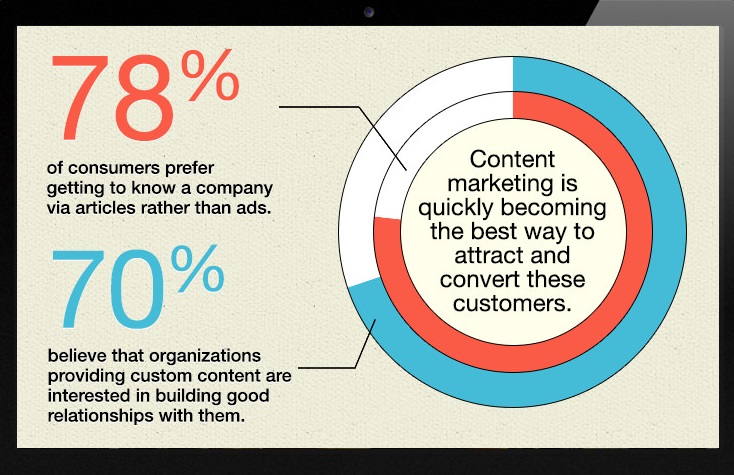
78% of consumers prefer getting to know a company through valuable articles than traditional ads. Source
Hiring Your Own Team Versus a Third Party
One question you might have wrestled with is whether you should you hire your own team, or a third-party content marketing agency instead? There are pros and cons to each, of course, so I'll discuss them and then give my personal recommendation.
Content Marketing Agency
Pros
- May be cheaper than hiring individual employees for the team
- Agencies already have teams of professionals in their field to do most content marketing responsibilities, saving you time in recruiting and onboarding
Cons
- Because they aren't your employees, you might have issues dealing with deadlines, as agencies typically have several clients and projects besides yours
- Not all content marketing agencies are created equal: some agencies have no experience in your niche and might not be able to deliver as in depth of content as you'd like
In-House Content Marketing Team
Pros
- Have a deep understanding of your company's goals, products, culture, and competition
- Can give updates on short notice
- All their working hours are dedicated to your company's projects
Cons
- Takes time and resources to hire and onboard
- May be prone to tunnel vision, or only seeing things from a certain perspective
Given these pros and cons, which one should your company choose?
My recommendation: co-sourcing.
What this means is you can hire key players to be full-time, in-house employees, while outsourcing certain roles and deliverables to agencies or freelancers.
This is the way to get the best of both worlds, by keeping the best talent as full-time employees while getting an agency's talent to fill in the gaps.
Steps to Create a Content Marketing Team
Ready to start building your own content marketing team? Here are seven steps to get started.
1. Choose Between In House vs. Remote
Because advancements in technology have allowed content teams the luxury of working remotely, you might have found yourself debating between letting employees work in house or remotely.
One advantage of letting employees work in house is being able to get updates as quickly as possible, while fostering better relationships within the company. When people are able to see each other at work, it's easier to brainstorm.
On the other hand, remote working can save you the overhead costs of maintaining an office. And because many candidates in the labor market today value the opportunity to work from anywhere, you may get access to better talent and retain employees longer.
In my content marketing agency, I've built a completely remote content marketing team with people from all over the world. To manage my business better, my team and I communicate regularly via Skype or Slack, collaborate on project management tools, and set clear deadlines and goals.
Here are a few questions to guide you as you decide whether to take your team in house or keep them remote:
- Can you afford office rent for your entire content marketing team?
- Do your team members live in the same city?
- Do you need to meet your content marketing team regularly (at least once a week)?
If you answered yes to most of these questions, you may benefit from keeping your team in house.
Some factors that will, of course, require a remote team are:
- Where your talent is located. Are they based all over the world or in different cities?
- Is your remote team made up of freelancers?
- How well can team members collaborate digitally instead of through in-person meetings? If your team consists of digital nomads, for example, they're more likely to be comfortable doing video conference meetings, responding to project updates via text, and using real-time collaboration tools like Google Suite or Asana.
2. Develop Your Team's Structure
To guide your hiring and onboarding process, create a team structure that assigns different goals for your content marketing team members. A solid team structure can help inform different roles and responsibilities.
Consider what sub-teams you'll need to report to different leaders and managers in your company. Make sure to keep the structure clear and organized, so that you don't risk overlap of responsibilities and cause internal confusion.
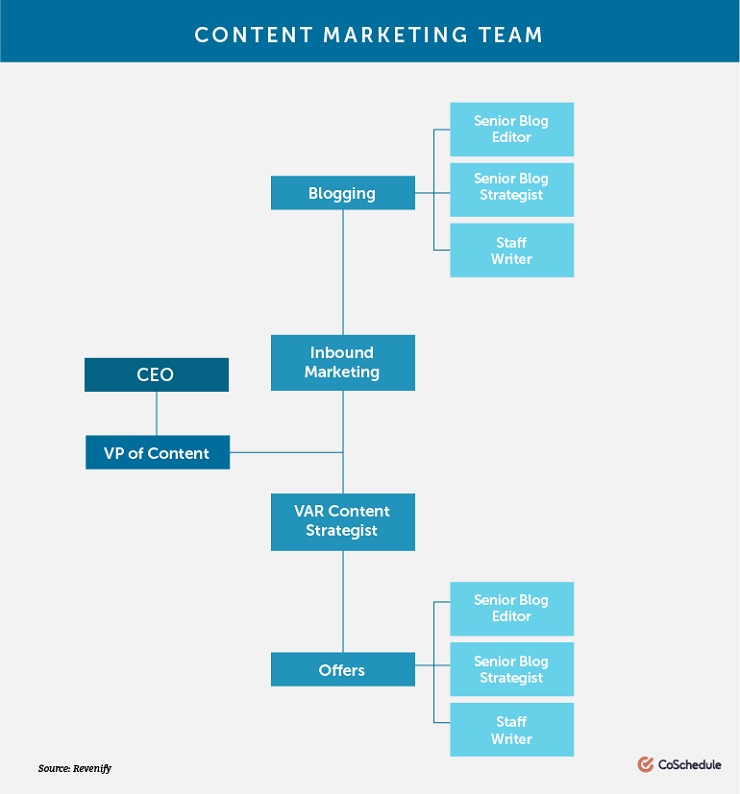
An example of a very simple modern content marketing team structure. Yours may vary depending on your industry and company goals.
Source
When you're building your content marketing team for the first time, the Content Marketing Institute recommends a T-shaped professional modelto start. This model suggests hiring people who have basic knowledge across a horizontal T but have comprehensive knowledge in one area, or the vertical T (see below).
So when you're hiring people to fill out roles on your team and assigning them to sub-teams, you want them to know how each sub-team operates. For example, a content writer has basic knowledge about social media promotion, visual branding, SEO, and like, but needs room to apply their own expertise—writing in-depth articles that provide value to readers and audiences.
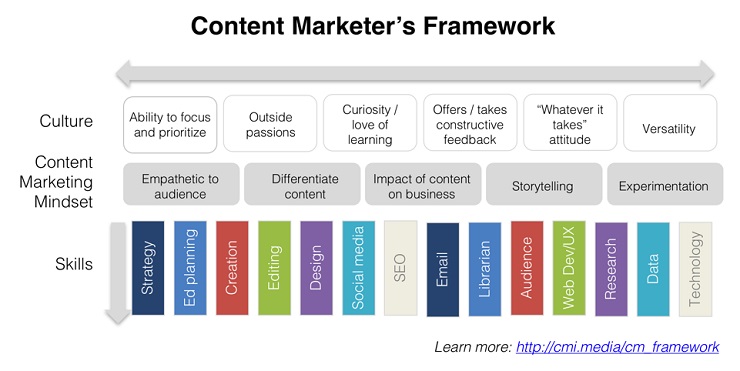
Source
Another thing you can consider as you plot out your structure: if you're only just starting your team or lack the budget to hire all at once, prioritize your managing editor, content writers, graphic designers, SEO specialists, analytics experts, and web developers before filling out more specialized positions.
3. Make a List of the People You Need
After determining the structure of your content marketing team, you'll want to list the specific people to go under each sub-team. These people will then each be assigned a specific role that helps them contribute to your content marketing goals.
It's important to keep roles as distinct as possible. When you give people the space to do one function well, you can expect better results than if you require everyone to wear multiple hats.
Below, I've included a list of people you may want to employ for your content marketing team.
But an important note first: Depending on your budget and goals, you may not be able to employ one specific person to handle each of these tasks. This list assumes an ideal scenario, where one person manages one role. Sometimes, you will meet brilliant minds who can assume two, maybe even three roles, especially when you're just starting out and can't afford talent for each of these.
That said, here are different content marketing team members you'll want to consider when building your team:
Chief Marketing Leader
You might already be in this role either as a Chief Marketing Officer or as company founder.
Whether or not this is an open role you want to fill in, the chief marketing leader is the person who aligns your marketing units and sales or business development units. This person should know the goals and targets of the company sales team so that they can make sure the marketing team—whose essential goal is to support sales—creates strategies and content that supports this goal.
The chief marketing leader also consistently keeps up with other company leaders. They essentially make sure that the entire content marketing team can help move the company in the direction they want to go, using on-point marketing campaigns and strategies.
Managing Editor
A managing editor's role is to oversee all the content being produced by the marketing team, from long-form blog posts to videos and other published work by the company. They make sure the volume of published content stays generally stable throughout the quarter.
The managing editor stays on top of the editorial calendar and directly manages team editors and contributors. They essentially are the liaison between content strategy and content creation, making sure both original and curated content serve the overall marketing goals of the company.
SEO and Analytics Expert
An expert in search engine optimization (SEO) and analytics can be key in making sure your content marketing pieces are optimized. This person is in charge of keyword research to shape the content calendar and SEO-related tests and experiments.
An SEO and analytics expert is also responsible for staying on top of data that can inform future marketing strategies and tactics. They might recommend to the managing editor to create more long-form posts about a particular topic if they find that said topic generates the most traffic and leads, or they can suggest creating lead magnets based on popular content.
This role is often outsourced or taken on as a consultant. But you may want to hire one in-house in order to train your team or to make sure your company keeps a data-first approach.
Editors
If your content—from blog posts to social media posts to newsletters—are riddled with typos and grammatical errors, this could make readers and subscribers doubt the quality of your content, regardless of how well-researched or even well-written it is.
Editors are the backbone of your content marketing tactics. They make sure everything that comes out is excellent and ready for audiences.
Depending on your desired team structure, you can have in-house editors reporting to the managing editor. Or you can hire freelance editors to do proofreading and polishing work per project. But if you plan on creating content consistently, it's best to hire at least one editor in house.
Content Writers
Writers are your people doing the bulk of the day-to-day content creation, especially for blog posts. In a perfect world, you have writers who are experts in subject matters related to your industry.
So if you're a real estate company, you'll want writers who have experience creating content related to that niche. These writers might not necessarily have any direct experience in the industry, such as being real estate agents or brokers.
But if they've written content for similar companies in your niche, you can be sure they've done enough research to have extensive knowledge about the field.
Multimedia Creators
Multimedia designers and creators are an important element in your content marketing team. These people create audio-visual content, graphics, branded collateral, and more to support your content marketing efforts.
They should have a thorough understanding of your brand's visual language to make content easier for audiences to consume. They're able to create beautifully-designed infographics, short videos, GIFs, and lead magnets that supplement the written word.
Multimedia creators may include graphic artists, video editors, or even photographers if your brand wants 100% original photos.
Content Distribution Teams
Last but not least, some important roles you can consider hiring once you've scaled are people to handle distribution of your content. Roles like email marketers and social media managers help you get your content out there and in front of a wider audience.
It's possible to outsource these tasks to a marketing agency, but for companies who want the most control over their distribution channels, you can hire dedicated people to fill these roles.
—
You may definitely have more people to consider for roles in your content marketing team, but consider this list a good place to start. Once you've covered the basic functions and assigned someone to each, you can think about other roles and expand from there.
EXCLUSIVE FREE TRAINING: Successful Founders Teach You How to Start and Grow an Online Business
4. Have the Right Tools in Place
To effectively manage your team and monitor your campaigns and goals, invest in the right tools. Use content management systems, such as WordPressor Joomla, for editors and writers, IDEs (Integrated Developer Environment) for web developers like Visual Studio Code or Bluefish, graphic and video-creation tools for multimedia creators like Adobeproducts or Final Cut Pro, and the like.
I mentioned previously that in my own company, I use Slack and Skype to manage communication between my team and myself, but we also use Asanafor managing our content calendar and seeing which stage every project is at.
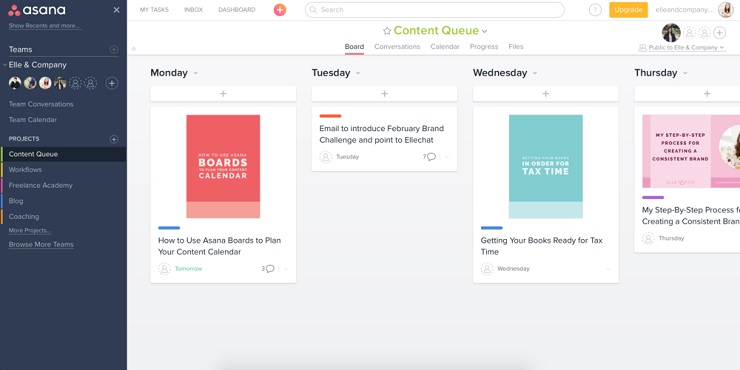
Asana can be a great tool for a content calendar.
Source
5. Create an Onboarding Strategy
Once you've hired your team, it's time to onboard them. As a best practice, create onboarding documents that you can store and send to leaders and managers to help them train new hires.
My company uses onboarding documents for new content writers. Some resources I give them are checklists to go through before submitting articles, as well as the main goals of our company.
To ease new hires in, you can send them these documents you've prepared and go through them together.
Here are a few practices to follow when onboarding new hires:
- Pre-onboarding, have necessary documents such as work contracts signed and filed.
- Create your onboarding document. This board template by Trello can serve as a great start, where you can help new hires remember things you may have oriented them on their first few days. It includes things like who to talk to for specific concerns and even reiterates company goals.
- Plan out each new hire's first day on the job. You may want to introduce them to the rest of your content team, inform them who they report to, and then help them jump into their first project as part of the team.
- After their first week, send an onboarding survey that can help you determine whether they're clear in their new position and how they're doing in your company so far.
6. Craft Your Content Marketing Playbook
Next, your content marketing team needs to have some kind of playbook so that all your content has a unified look and sound. Here are the elements you need to craft your own content marketing playbook.
Style Guide
A style guide helps inform designers and editors how to present your content and brand. These are typically visual elements, such as infographics and videos, but can also be applied to elements like blog post formatting.
Adobe has a comprehensive style guide that tells designers how to use its logo, the specific colors it uses across materials, as well as the kinds of images it uses across its website and brand collateral.
To create your own style guide, refer to this complete post by Canva.
 Example of a brand style guide for visual unity.
Example of a brand style guide for visual unity.
Source
Brand Voice
Even if you have a team of diverse writers, it's important to have a clear and consistent brand voice. This sets the tone for how writers ought to craft their pieces. Should they be formal or casual? Are they witty or serious?
MailChimp has a complete style guide hub that walks employees through writing goals and principles, formatting, and other writing mechanics that appear on branded MailChimp content, including blog posts and newsletters.
The brand voice guide is useful not only for staff writers but also for informing contributors as well. For example, here's Foundr's contributor guidelines that tell you their brand voice for guest article pitches.

Distributing Content
Finally, your playbook can be even more beneficial by including a distribution guide. Inside this guide is your plan to disseminate content, be it promoting a new blog post, boosting a new social media ad, or even sharing a new ebook. Essentially, this is how you make sure your content is seen by your audience. This guide can also help shape newsletters and social media posts, and may even include different websites and publications for link building.
Inside your distribution guide, you may include:
- Content type (ebook, blog post, social media graphic, etc.)
- Copy to accompany the content type
- Channels on which to promote the content type
- Publish date
- Promotion date on each channel
- Dates to send to influencers or thought leaders
- Dates for paid boosting
Key Takeaways
If you've been on the fence about building a content marketing team, I hope this guide helps to clarify your next steps and guide you along your way. From figuring out how your team can operate down to the specific members of your team, be sure to plan for success.
Over time, you'll soon have the content marketing team that scales your brand and your business, increasing customer engagement and boosting sales.
EXCLUSIVE FREE TRAINING: Successful Founders Teach You How to Start and Grow an Online Business
The post 6 Steps for Creating a Content Marketing Team That Scales Your Business appeared first on Foundr.
]]>The post 302: Serial Ecommerce Entrepreneur Rory Boyle On How He Survived (And Thrived) During The Pandemic appeared first on Foundr.
]]>Subscribe to The Podcast on iTunes, Soundcloud, Stitcher and Spotify
Rory Boyle, Co-Founder, Hampers With Bite, Promotions Warehouse, And Snacks With Bite
All three of Rory Boyle's ecommerce businesses were negatively impacted by Covid-19.
But thanks to his strategic—and insanely fast—pivot, two of his companies are now making double the revenue they were before and one (which historically made most of its money through conferences) is still pulling in around 50% of what it used to make.
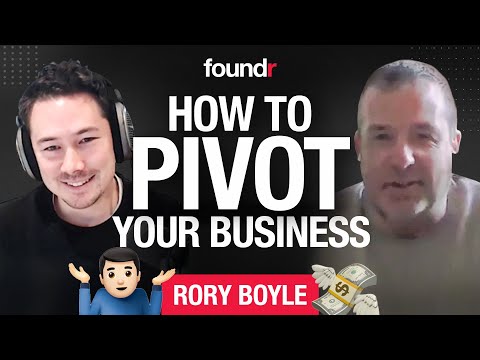
How did Boyle recover so quickly from the pandemic? In this interview, we were lucky enough to get a detailed analysis around his thought process and strategic decisions. Boyle takes us through how he shifted his sales and marketing tactics (which still includes getting on the phone) and explains how he's using this time as an opportunity to give back to his community and customers. He also shares tons of tips around scaling sales efforts, the art of cadence emails, and other tactics you can use to grow your revenue.
If there's any other type of content you'd like to see that would be valuable to you during this time, please don't hesitate to reach out at support@foundr.com to let us know.
Want some training on ecommerce? Check out our free masterclasses:
FREE Masterclass: Start a Profitable Online Store (In 12 Weeks or Less)
FREE Masterclass: Discover the "5 Core Drivers" Behind Today's Fastest-Growing 7-Figure Stores
Key Takeaways
- The origin stories of Hampers With Bite, Promotions Warehouse, and Snacks With Bite
- What Boyle means when he says to "control the controllables"
- How COVID-19 impacted all 3 of Boyle's businesses—and how he pivoted all of them at breakneck speed
- The approach Boyle is taking to sales and marketing during the pandemic (and why his team is still hopping on the phone to talk to customers)
- Why Boyle believes every ecommerce entrepreneur needs to be thinking about the next step instead of focusing on current performance
- How Boyle is giving back to his community and customers
- How he's planning around stocking challenges, especially for the upcoming holidays
- A super deep dive into Boyle's best sales tactics and strategies
- Why Boyle would encourage entrepreneurs to launch their business in today's climate
Key Resources From Our Interview With Rory Boyle
- Follow Boyle on LinkedIn
Subscribe to The Podcast on iTunes, Soundcloud, Stitcher and Spotify
The post 302: Serial Ecommerce Entrepreneur Rory Boyle On How He Survived (And Thrived) During The Pandemic appeared first on Foundr.
]]>The post 301: 8-Figure Ecommerce Founder Reveals His Best Insights For Ecommerce Entrepreneurs Struggling Through Covid-19 appeared first on Foundr.
]]>Subscribe to The Podcast on iTunes, Soundcloud, Stitcher and Spotify
Ashwin Sokke, Co-Founder, WOW Skin Science
Click here to Skip to the Podcast Transcription
Today, we're excited to share another valuable interview to help you overcome business challenges during the Covid-19 pandemic.
We had the opportunity to pick the brain of Ashwin Sokke, the founder of WOW Skin Science. His global 8-figure skincare and haircare business is extremely popular in India and across the U.S., and it has been a top-selling brand on Amazon for the last four years in those countries.
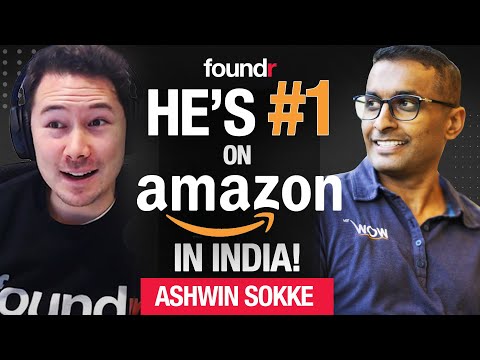
In this interview, Sokke shares how his company dealt with the impact of Covid-19 which shut down half of his business for several weeks. For businesses who are going through similar pains, he provides incredible insights across many topics—from how to communicate with customers (he believes we should be sending them more emails and texts during this time) to getting creative with your marketing tactics (remember giveaways?). Sokke even digs down into the nitty gritty and breaks down his thoughts on subscription models, ad investments, and SKUs.
We believe this conversation will be valuable for any entrepreneur to listen to, especially those with ecommerce businesses. If there's any other type of content you'd like to see that would be valuable to you during this time, please don't hesitate to reach out at support@foundr.com to let us know.
Want some training on ecommerce? Check out our free masterclasses:
FREE Masterclass: Start a Profitable Online Store (In 12 Weeks or Less)
FREE Masterclass: Discover the "5 Core Drivers" Behind Today's Fastest-Growing 7-Figure Stores
Key Takeaways
- How Sokke got into the health and beauty space
- The path to growing WOW Skin Science in India and the U.S. and becoming a top-selling brand on Amazon
- Why Sokke develops all of his products from scratch
- A glimpse into the company's incredible numbers: 8-figure revenue and 370% growth in the U.S. last year
- The impact that Covid-19 had on Sokke's global company
- Why Sokke believes companies should be sending more emails during this time (and how to be strategic about it)
- Why giveaways have been a successful tactic during Covid-19
- An overview on a winning stock keeping unit (SKU)
- Sokke's thoughts on how to win with subscription models
- The best advice Sokke can offer to the community during Covid-19
Full Transcript of Podcast with Ashwin Sokke
Nathan: The first question I ask everyone that comes on is how did you get your job? How'd you find yourself doing the work you're doing today?
Ashwin: Going back, I think I've been in the affiliate marketing industry for about 15 years now, since high school and eventually I graduated into the health and beauty space in the US around 2009. And then when I moved to the States and we were involved with the affiliate marketing industry. We did a lot of affiliate sales and eventually realised if you want to build something and take your ideas forward long-term and build a legacy brand, you have to do everything on your own. Obviously we had the marketing angle on all right, but we always saw things go downhill because we were dependent on sending our traffic or building blogs where traffic was sent to brands owned by someone else. We couldn't control the narrative.
So eventually, I think it was 2012 e-commerce in India was taking off. So I co-founded Wow with two of my high school friends and my older sibling. So the story of Wow is basically me and… it's a pair of two brothers, me and my older brother and two of my high school friends who are brothers too. So that's Wow was formed. And we initially started off with supplements in India and it took off became one of the highest selling brands on Amazon India. And then eventually we were looking at the growth on Amazon in India. We figured out, "Hey, why don't we also do skincare and eventually haircare." And that's how we've grown over the years, being the one of the top selling brands on Amazon India and the US for the last four years. We have the number one selling shampoo on Amazon or India, and in the US for last four years.
But as a company and as one of the most important ethos of our company is customer centric and being product driven. As marketers, it's easy to lose yourself with bad habits of just focusing on the marketing and not focusing on the products. And when we made the decision to build a product, we said we were going to do something that's a long-term, we're not just going to be another brand with just goes to a manufacturer and says, "I want this product made. Oh, you have the formulation. Just put a label on your bottles now." At Wow we do everything from scratch. Everything is proprietary right from the formulation of our products, the bottles we use, the pumps that we use, we own the moulds for our bottles. We own the moulds for our pumps. The packaging is unique. We do everything from scratch. And I think that adds tremendous value in the market where there are so many copycats.
I feel like especially in the health and beauty space it's so easy for anyone to go to a manufacturer and say, "I want to do this skincare product. Oh, you will have the formulation? Okay. I'll just take the bottles you have as a manufacturer, just put my… I'll send you the labels and the design." And now I think we separate ourselves that way. And that's actually paid off long-term. Yes, it's a lot of pain in the initial months. You can't launch products quickly, but once you get the process through and you have a big team, different stages of product development, you figure it out.
And it also gives you great feedback where you're able to take feedback that your customers give, which is actual feedback. Forget the feedback that you get from your own team members who say, "Oh, the fragrance on the skincare product is great," but you never know until it gets to the real market and the real world, and you get actual customer feedback, which is really random. And you take that feedback and you improve your product for over time. Iteration one, two, three. And then eventually you get to a stage where you have the perfect product, which is going into the real world and getting more feedback. The feedback can be anything. The font on the label is too small that people can't use instruction. The face scrub the ingredients might be in such a way that the particles are to take on the face scrub. The pump is not working in certain conditions. All these feedback since we own part for manufacturing factory back in India too, it gives us great flexibility to do a quick, rapid changes on a product line and continuously improve.
So right now my other partners manage all of India business. And even though we build strategy together, and I manage all the global player, which is US, Canada and so on, and India, which is a more significant business right now is managed by my co-founders who live and offer business startup India. But we are a company which was headquartered out of India, Bangalore India. So that's how we have structured our company right now.
Nathan: Interesting. So would you be able to share whatever you feel comfortable with just so people can get an idea of scale and size on what you're playing with, whether it's dollars, units, how often a product is sold, because we're not talking like… This is a decent size business.
Ashwin: Yeah. I would say we are in the higher eight digits per annum worldwide revenue, very close to nine digits. So we're there and we've grown about… We grew about 370% of the US last year.
Nathan: Yeah, wow.
Ashwin: This is crazy, right?
Nathan: Yeah.
Ashwin: And we grew about at the size we… And if you really look as a brand we've rapidly scaled about in the last three and a half years. But in India, we've grown about 170% last year, our India businesses is very large for a market like India, which is price conscious, quality conscious, value conscious we've made some great [inaudible 00:10:48]. We have won several awards, both in India and in the US. So we actually won the Bootstrap Startup of the year award last year and in India.
Nathan: Oh, wow.
Ashwin: So far so good. We've been blessed with great partners and great team members that we work with both in India and the US and we also have a small satellite office in Canada. So we are doing, I would say incredible things, highly competitive category of health and beauty. And we continue to believe the world will continue to evolve and smaller brands like us compared to the huge multinational brands will grow more quickly in terms of annual growth compared to think brands are growing probably four or 5% per annum. We will continue to at least for the next five, six years double digit growth.
Nathan: Okay. That's awesome. So tell me what's working right now, when this hit about four to six weeks ago, were you guys affected at all? Did you see sales dipped? What happened?
Ashwin: We're a story, I would say two sides of coin, right? Obviously in India, we had the complete lockdown curfew for about three weeks now. And I think the Indian government took the drastic step off, of course, for the safety of the country, of shutting down everything right. They had Amazon shut, all warehousing store, most of the logistics store shut, unless it was really, really critical like food and so on. Even then a lot of it was shut. So now I think starting April 20th, which is the following Monday, they're going allow e-commerce to open up. So, which is great, but otherwise for the last two and a half, three weeks, we were completely shut in India. But in the US, fortunately e-commerce was considered essential category and we are in the essentially category like shampoos, body washes. So we've been holding steady and I've actually seen a slight increase in sales. I think people are more comfortable and sort of going, and since we dominated so many categories on Amazon and we are in the public category, like shampoo and conditioners and body washes and face washes, we've actually done well.
And fortunately touchGOODS our warehouses across the US have stayed open. But it is not just the Amazon warehouses, but our own private 3PL warehouses and East Coast and West Coast, shout out to Cargo-Co that's the 3PL provider we use. So they're being able to service our needs during these tough times. And you know we have spared up and we've been able to service our customers. I think what's worked for us is just being honest, with our old customers too, we have been honest and told them, we're a small business and we've sent emails, SMS communications with them saying, "Hey, we operate safely, our warehouses are COVID-19 friendly, safe, we follow the rules and it will help small businesses like us during these tough times. If loyal customers like you can support us." We sent out a video message to an email, and that generated a lot of bars and your loyal customers we'll support you. Of course, we give them a discount.
We said as we… We have been able to stay open so far. So we request you to say using these discount code and order up and build up your inventory instead of trying to go out, your products will be delivered safely home. Things like that and that's generated a lot of sales, both on social media and on our email channel and Facebook ads.
But also I think a lot of… What's worked, I think is there's a lot more available ad inventory out there right now. People are at home and spending a lot of time online. So what's happened is I think we've seen an increase in performance on direct response ads, but CPMs and CPCs have dropped at least by 25%, because just there is so much more inventory. And I think some of the bigger DTC players or bigger mainstream brands, like the luxury products and airlines and hotels have dropped off. And so there's a lot of available inventory on that auction, be it Facebook, Google, or Snapchat that's working.
And I think also what's working is giveaways. When I say giveaways, we have taken the end a lot of stay at home, shop and we are doing giveaways of iPhones. And since we're in the women based industry, we giving iPhone 11, jewellery and handbags like part of the purchase. You get a chance to win in a giveaway, which should be announced at the end of the month. The more you buy, the more chances you have to win, things like that have obviously helped us differentiate our brand a little bit from everything else that's being promoted. Every morning, me and you wake up with 15 COVID-19 emails by the CEO or founders of companies. So I think it was we got this idea from a common friend, Juan. I'm not sure if you he's on the foundr network. He… CML for a men's, these are truck industry. These are trucks and accessories that's being sold online and they do large giveaway. They give out a truck per month and we had a conversation with him and he was able to give us that idea and so be it implementing that. So that's been great.
And also, I think one of the other approaches we took as… A lot of the user generated content style of ads are working a lot more now. When I say UGC, bid influences, or even our team members or employees within our team, are able to make these small raw videos, which is full of emotions, which are able to tell that COVID-19 strategies in the health and beauty niche. Like for us, we've been able to say, "Hey, since you are at home, strategies stay at home and have salon style, spot treatments at home, be it skincare." Day-to-day, you probably couldn't push these angles through in terms of marketing, where now you can say, stay at home, skin spa, three steps, 15 minutes of face mask, 15 minutes of different things, skin cream, treatments and angles, which are promoted with user generated, content is working really well right now. And I think people are able to resonate with that because they have so much time on their hands and they can sit while working, apply a face mask or a hair mask for 15 minutes, and they actually have the time to do that. So those are things that are absolutely working.
One of the other things we find interesting is how there was a limit on how many emails a brand could send per week and how much performance you could get. You could probably double the amount of cents per week on emails and still see actually an increased performance. Because people are on their phone or on their laptop all day. That mailbox a lot. Also, you won't have any unsubscribes. We hadn't seen any large unsubscribes on our… Obviously we don't send emails to our entire list, we try to send it to our engaged audience, but we're seeing a lot more performance on emails now. Same with SMS, push notifications. There's no limit to how many times you can send. I mean, you don't want to send two or three a day, but I would say one a day is all set and game right now. And it's actually working brilliantly. I think as brands we have to make use of this opportunity, that's being provided to us and we should engage with our customers.
And one of the smart things we try and use is, we ask questions in our emails like when we send something like a skincare tip while you stay at home, we say, "Share your personal tips and have a chance to be feature, give it a chance." And people respond to those emails, which in turn increases your emails score.
Nathan: Credibility, yeah.
Ashwin: So small things like that I think how working a lot, and I'd actually working a little better because people are reading a lot more of the emails, reading a lot more of their SMS. So things like that have worked so far. And we as a brand, even though we maintain consistency of manufacturing our products in India, we were lucky that we had stopped for four to eight weeks of a lot of our winning skews. So even though India was shut down for three weeks, we were lucky enough to maintain stock levels and continue to sell some of our products. And hopefully we can maintain a sales number over the next quarter.
Nathan: Yeah. Interesting. So lot of questions here to kind of dive a little deeper, let's go with the lightest one around stocking, four to eight weeks ahead of winning skews. What exactly does that mean? And how many skews do you have that are winning and how do you work out that if they're winning or not, like the 80-20 or in the 80-20?
Ashwin: Oh, we have about… As a global brand, I think in India, we have a lot more skews than in the US because it's easy to just launch and scale something. And if it doesn't work with low MOQ, since we own bought off a factory to launch scale that if something doesn't work, we shifted out of the circulation. So we are 175 to 200 skews in India. And about 70 skews in the US, I think we are… 90% of our sales are generated by about 15% of our skews. And the rest is all filling inventory.
Winning skew, we look at it two ways, obviously, volume of sales, but also repeat purchases. That's what qualifies as winning. So I would say when we talk of volumes, is it moving a minimum of 5,000 units every two weeks? Is a winning skew. And repeat purchases is if a customer is buying it at least two and a half to three times a year. You have to understand we as marketers, get confused with this idea that, "Oh, it needs to be a subscription model. I've [inaudible 00:22:52] every month." But when it comes to ………….., if you really look at household habits and what do families do, let's consider the shampoos. If you really look at the stats, people buy shampoo three times a year, two and a half times a year. If you ask your partner for example, or your wife or your girlfriend, it doesn't matter once they know what they like, they'll only buy it two or three times a year. It's not that you go out, buy a shampoo bottle every month, very rare, unless you're buying like really small, a 100ml travel sized bottles.
So for us as a brand, that's one of the big eye-openers to that, we understood buying habits and buying scenarios. What is considered great? What is considered not great? Supplements are different, right? We also sell supplements in a few categories in India, like biotech, or make a three and so on. Those are every month or every 60 days, depending on the size of bottles people buy. So that's what qualifies as winning skews. And why I say it's super important, depending on MOQs that you have with your manufacturing facilities, and also whether the manufacturing is local or off shore, that you maintain a minimum of four to eight weeks of inventory or sometimes even more. But let's say four to eight weeks is ideal in this new world.
So we do the assembly because we don't know if something like the coronavirus was going to happen, but it takes about 45 days for us to get after we issue a purchase order to a factory for our factories to make container, let's say for shampoo, get it to the port from India to the US, customs cleared and into our warehouses be it Amazon or our own 3PL warehouses.
Nathan: So six weeks?
Ashwin: So we all ………….. Yeah, because you don't want to move inventory of heavy products where cost of transport from one country to another is so huge if you bring it by air, or if you bring it by ocean freight, it's almost one 15th of cost. So there's no point from being to air freight, one litre bottles of shampoo, like just cost-wise as a brand is just what's going to kill you, take away all your profit. So we maintain that. We generally almost 98% of the time, unless it's some kind of an emergency, we always bring products by sea. So that is one of the reasons that we maintain four to eight weeks of inventory and also things can go wrong, whether it's at your port or at your factory, a ship sinks, it gets held up for an additional two weeks at customs in India, or in the US FDA holds it for extra x-ray scanning for another week. So you don't want to keep cutting ……….
And especially the way algorithms work with Amazon and so far and so on these days, it really affects you if you go out of stock on these big platforms. So we always try to maintain four to eight weeks of inventory and another important reason, I'm not sure if most sellers on Amazon are aware of this, because at least in the US Amazon wants this new thing, which is they want to deliver everything, same day or next day. Not two day prime, but same day or next day prime. So they want to spread your skews and warehouses all over the US which are owned by Amazon, where they are able to deliver within a day or same day. So the more inventory of your winning skews that you can maintain an Amazon ecosystem, you'll actually see an uptick and your sales of at least 15 to 20%, because the algos starts featuring you on listings, which are same day, next day, which actually is a psychology, especially for health and beauty products, "Oh I'm able to get it today or tomorrow. Okay. I want to try this product." You see what I mean? You're winning that buy box compared to other brands who might not have enough inventory.
We're not talking about… Listen, Amazon always sends, if you send a container which is let's say only three weeks worth of your sales, Amazon sends it to all the big cities, that is a given. But you want to win all America or UK or Australia is the smaller tyre two, tyre three cities and smaller towns and villages around the country like the countryside where people and consumers don't have options to go to a Walmart or Walgreens and buy whatever they want. You know what I mean? So now they are the ones who are willing to try new brands online. They look for certain keywords on Amazon, "Oh, I can get this product within a day or two. I want to try this other brand.'" You see what I mean?
Nathan: Yeah.
Ashwin: So it actually gives you this 10 to 15% edge where you're able to compete. And you'd be surprised how many people are going to buy a product, especially in the beauty space, if it's delivered to them quickly within the next day or two, compared to 15 days. They're like, "I don't want to spend $20 and wait 15 days," but if it's next day or two, and if it's on a platform like Amazon who they're trusted, they'll buy it. So those are some of the advantages to maintain long-term inventory. Obviously, I really wish and hope that another coronavirus doesn't happen. But it's important to maintain the sanctity of inventory management, because things do go down like I explained, whether it's your container being held at a port or customs clearance or FDA clearance always happens. We've seen this happen several times. So these are things that we've failed and learned over time, over the last three years by exporting things into the US market. So we just maintain four to eight weeks of inventory these days.
Nathan: Yeah, I know that makes sense. You mentioned subscription, so I was going to ask you that, I was thinking perhaps a product or some of the products that you have in your range, you would have subscription, you don't have subscription, or you do?
Ashwin: We do. In fact, I would say we don't force subscriptions on people. We truly believe we're not a brand that says, "Oh, you can only buy it as a subscription." In fact, that's not even a… If you go to a checkout, that's not even a default checkout option. You can buy it one time and if you're happy, next time you can come back and buy it a subscription. And we have that enabled even on Amazon. And I think about 10 to 15% of our customers take subscriptions and it shows value over time. And when you do subscriptions of health and beauty, it's easy to fall prey to this idea of, "Oh, I want to make it every 30 days," because it's subscription revenue building, but that's not really true. You don't want to be in a situation or become a brand, which is sending bottles every month. You walk into a person's house and you're, "Why do you have five sets of the shampoos?" "Oh I ordered on subscription. I forgot to cancel." You don't want to be that grand.
So we made the conscious decision of even in our subscriptions being able to do things like giving long-term options, like every 60 days, every 90 days, every 180 days and things of that. And more importantly, easy options of if customers contact you by phone or email, I will skip this coming month and send email reminders. We actually send I think about three email reminders before the next refill, the week before your subscription rebill happens, we send them three reminders saying, "Three days to go before your… One day to go, your subscription is going to be filled." And the email has a link where they can go change the subscription. Skip a month, change the date, things like that.
There are a couple of options, obviously if you're on Shopify recharge is a good option. But I think a couple of our friends have [inaudible 00:31:58] to opscibed.io which is a little more advanced and little more customizable. You get your own domain. So shout out to scibe.io and they do an incredible job of being not just for brand owners, but also customer side where customers are able to do incredible things when you log into the member portal to skip a month, ship it the same day. Sometimes you also don't want to wait another 30 days. Maybe your sister took your shampoo conditioner bottle, now you want to get it the same day and you don't want to go through the customer support, call an email, log into the portal ship today. Things like that, bill and ship today. So it has a lot of great features like that and great subscription analytics, right in the back end.
Most subscription apps don't build this for brand owners where they don't tell you attrition rate, rebill rate of different skews, what's working, what's not. And so scibed.io has done a great job. They're based out of LA. And we are big proponents of the subscription business model, but do it in a smart way where it's not overwhelming to customers because most people… It's easy to just keep sending bottles and piss off a customer. Now you have lost that customer for life. Once you lose faith in a brand, you're going to tell your friends and family about it. So the compounding effect of doing bad things as a brand will affect you long-term so being fair to the customer, issuing liberally refunds, liberally changing, A customer is not happy with a certain skincare product. Just send him another type of skincare or haircare product for free. You don't know the magnifying effects that it has long-term where a customer is, "Oh, this is the brand which let me try a different skincare product because this particular other skincare product from the same brand didn't adjust to my type of skin." There are so many types of skin, so many different types of scalp and hair. So we always do that for our customers.
And we see our brand loyalty growing exponentially because of these small things. And it's not too much, by the way, it just costs you about two or 3% more than extra refunds or reshipping fees. And it just makes incredible long-term brand value propositions with your loyal, VIP customers that we like to call who become brand ambassadors themselves. Who will continue to educate and talk about your brand for you at CPA costs.
Nathan: Yeah. Really smart. So talk to me about Amazon versus Shopify. So it sounds like you guys are quite strong on Amazon. What are your thoughts on having a branded store versus using Amazon and all that sort of things?
Ashwin: You have to be everywhere, right? We are not Amazon dependent brand at all. In fact, most of our marketing efforts, when we buy ads on Facebook and social media or any other prominent goes to our own Shopify store, by the way. So we have an equal split between marketplaces and our own Shopify. So we are not Amazon brand at all. In fact, majority of our sales happen on non-Amazon channels. In India, it's actually an incredible split because Amazon is not the number one player in India. There's Amazon, that's Flipkart, there's Snapdeal, there's nika.com. And then we have a… We are in a few thousand brick and mortar stores in India already.
Nathan: Oh retail too.
Ashwin: So we have a good, nice spread where your risk proposition as a brand is so much less. So you're not dependent on one platform. So that's very important to do. And I think people are scared to list on Amazon because brands are like, "We can't control the narrative of the story." For us, we actually saw our conversion rates on our own Shopify landing pages go up after we listed on Amazon, simply because people trust you as a brand because you are also selling on a trustworthy brand like Amazon, both in India and in the US we actually saw the conversions go up. And know what's happened over the years I think maybe 10 years ago? We would go to Google to do product research for the new brand or a new gadget we want to try. What's happened now is, people just opened their Amazon shopping app and just type in the brand name and product name and see if it's available. If there's enough reviews, they're going to check it out. They do product…
So there's actual case studies and data to show that Amazon has actually eclipsed Google when it comes to shopping discovery for new brands and products, people just discover new products and research new products on Amazon now. So it's super important to be actually present on Amazon. Don't sleep on walmart.com in the US, it makes up about six to 8% of our sales right now, a lot less competition than Amazon. So get on there.
Nathan: Interesting. Okay. So when it comes to, I guess what's working now, you talked a lot about email and SMS and not being afraid to perhaps send one email a day or one email every few days. One thing that I think people get hung up on with that is, perhaps they come over that barrier of not being afraid to email people, which we've all gone through. I'm sure you went through it in the early days. You don't want to annoy people. You don't want to be perceived like you're spamming people and you just don't email, right?
Ashwin: Right.
Nathan: Once you get over that, how do you know what to send every day? Are you guys doing content or giveaways?
Ashwin: It needs to be a really good mix. Let me be honest. It can be a coupon code and a product feature or a new release every day or every email or every week. So what's working during the COVID-19 strategy that we've come up with, like stay at home skincare tips, stay at home health care tips, features on an ingredient. Well, you're not even selling any product, you're just giving them content to consume. Be the video through email, to an YouTube link, an article, tell them about yoga, essential oils, meditation, just send them content like you would send. The communication style needs to be ready, family friendly, kind of like, how would you email a semi-formal friend tips on how to reduce stress? How can you do meditation, yoga, how to stay fit and that's what's working for us. And obviously we're not sending a promotional email every day, buy one, get one free.
Nathan: Man, I had no idea …… ask to make sure.
Ashwin: Yeah. It has to be like a nice mix. And that builds, "Oh, that was a great tip by this brand. Let me go check out." In the photo, we have a link to our Shopify store and people will go click on it and buy whatever they want, but you're providing value to people and just think differently. Everyone's trying to send an email about COVID-19, how it's affecting the brand. You can do one email of that, you can repeat that whole cycle again and again. So you'll have to think out of the box, send about… Like I said, it's really important to ask, "Hey, do you want to share with the…" For us, we think do things like, "Hey, if you want to share within the wide community of customers?"
The giveaway campaign was great and we say things like, "Hey best skincare tip wins, or share your homemade skincare tips, and the best one will win free month's supply a world product, share, respond, and let us know what is your secret made at home skincare or healthcare tip." And go out of the box and say, "What is your favourite homemade dish? Share it with us." Even though we are a skincare brand, people want to know what can you make at home? And what are the homemade secret recipes which are stayed in your family and you want to share it to the world? And once you open your platform to your customers, especially during these times, people want to engage with you. They're looking for different ways to communicate with friends and family and to the outside world. And because most people are stuck at home. They're not seeing their colleagues or coworkers or friends and families. So I think you have to differentiate yourself and spread your wings and be [inaudible 00:42:19]. And you'd be surprised how things work these days.
Nathan: Yeah. That's really interesting. So sending pure content emails and emails everyday, mainly content, maybe a promo, maybe giveaway. Just providing as much value, you've seen a massive increase in sales?
Ashwin: Yeah. Now when I say massive, probably 20, 30% spike, which adds on. Because people are looking at your emails, they'll look …….
Nathan: Do we market them? Like ……….
Ashwin: And then they see your ad on Facebook, "Oh, I liked the email they sent last week and I see that ad on Facebook, I'm going to buy now." So you're putting yourself in front of potential customers in a very different way than traditional brands. So that's what's working these days.
Nathan: Yeah. I love it, man. That's awesome. Okay. Well look, we have to work towards wrapping up. I'm super mindful of your time and it's getting late for you. So thanks for staying up, brother. So just kind of a couple last questions, one, any questions that I didn't ask you that you would've liked me to ask, anything you want else that I've missed to you want to share with the community on what they should be thinking about on when it comes to COVID if you have an e-commerce store that perhaps it's not doing that well, you're not sure what to do? And then after that, where's the best place people can find out more about yourself and your work?
Ashwin: I think one of the things that we're actually trying to engage right now is work on a mobile app for our Shopify store. I think I have been dropping a lot of names, but [Tapcock 00:44:07] is a great app. It'll take your Shopify store and help you put up a mobile app really quickly. So definitely use that. You can create a mobile app, just drag and drop kind of a setup. And now what you can do is buy traffic and for a different optimization scheme on Facebook or Google where you will buy instead of commercials or leads but you can target it for app installs.
Nathan: Yeah. Wow.
Ashwin: So you're now competing in an e-commerce app installed space, which has less competition on the auction compared to conversions, which the rest of the world is doing. So that is working. That's something that we're focusing on right now. And once you get someone to instal your app, don't over abuse it but unlike deliverability and so on and so forth, you can send mobile notifications when we …… free of costs. You see what I mean? So you're now again, have now that avenue where you can communicate with your customers where they're bound to see your notification at any point of time. And remember these notifications just doesn't need to be about sales. It can be, "We are featuring a live Facebook or YouTube live with your favourite in house cosmetologists, or hairstylists with healthcare tips, log on now." You'll get a lot more action with your customers because they're looking at it. The notification pops up on their phone and they can log in, live and participate on that live.
One, you can send notification, "One hour to go for this giveaway to end. One hour to go for the sale to end." You're not depending on Klaviyo or you're not competing in the same space of hundreds of emails who are emailing or SMS saying people and your clutter. Now you're separating and you're thinking ahead of the game. You're on the mobile app notification space and you're able to control that narrative. You don't have the answer for Gmail or Hotmail or your SMS provider about what kind of notifications or the content you're sending on notifications. So you're staying out of the code. I think it's important to be multi channel.
So I would also say one of the other important things is, don't be just Shopify dependent or Amazon dependent seller, multiple places. You'd be surprised like we sell on eBay. We sell on… We're trying to get on target.com. We are trying to get on… We are on Groupon, which has two or 3% of our overall revenue. All these additional marketplaces where there's less competition, definitely get on because there's obviously loyal set of customer, which only shop on certain market spaces and it adds additional value to you. So what was your final question?
Nathan: Where's the best place people can find out more about yourself and your work?
Ashwin: I'm not too active on social media. You guys can probably follow me on LinkedIn, I would say. I don't post much. This is probably one of the few places they can probably find an interview off me. So Foundr is probably a lucky feature that otherwise I do podcasts and so on with friends who are in the industry would request me to come on things like this. I would love to participate and share more knowledge, but I don't go to too many conferences, especially on the sales and marketing side. We differentiate ourselves as a brand. We actually go to a lot of ingredient conferences. As a brand, we go to conferences which are about manufacturing and packaging of beauty products, crazy thing, fragrances. Sam and I were brought up in a small town in France and things like that so we like to go to those things.
Nathan: What about Wow?
Ashwin: WOW can be followed on Wow Skin Science, Instagram and Facebook and Wow Skin Science, India for India Instagram, Facebook, Pinterest, Snapchat and TikTok too. TikTok's working really well. Sorry, I missed out. TikTok's working really well for us in a market like India, especially. So that could get on that really cheap CPMs. And obviously you have to work with TikTok influencers and let them create content and promote the content created by content creators. And that's what's working. So it's not typical create an ad, edit it the way you want and push it. So you have to be different with TikTok. So that's been good. That's it for me. I don't know. And obviously if some… I think I'm on your network, I'm on Facebook of Foundr. So that's one place people can find me, I guess. And if someone tags me on the Facebook group of Foundrs and ask me specific questions, I'm more than happy to answer. And I look forward to getting to know people in the Foundr network and exchange ideas and help each other grow.
Nathan: Amazing. Well, look, thank you so much for your time. Ash, you were very, very giving tonnes, I got a page of awesome notes. I'm going to give this to my partner that runs an e-commerce store. She's got a lot of work ahead.
Ashwin: Absolutely request her to hit me up………. can but introduce us by email too. Im absolutely more than happy to answer any questions within the Foundr network. I'm more than happy to go through the process. Absolutely.
Key Resources From Our Interview With Ashwin Sokke
- Visit the WOW Skin Science website
- Feel free to tag Sokke in the Foundr Facebook group with questions
Subscribe to The Podcast on iTunes, Soundcloud, Stitcher and Spotify
The post 301: 8-Figure Ecommerce Founder Reveals His Best Insights For Ecommerce Entrepreneurs Struggling Through Covid-19 appeared first on Foundr.
]]>The post How These 7 Companies Are Responding to Covid-19 with Kindness appeared first on Foundr.
]]>But no matter how hard your business may be hit by this (hopefully) temporary recession, your company can still take a positive approach to this difficult time by doing everything you can to help your audience overcome what they're going through.
A recent survey done by Kantars confirmed this when they found that the one thing consumers want from brands during this crisis is their help. The top ways companies can communicate this include:
- Talking about how the brand is helpful in the new everyday (77%)
- Keeping them informed about the brand's reaction to the new situation (75%)
- Offering a reassuring tone (70%)
Similarly, a study done by IPSOSfound customers want brands to:
- Give comfort to their customers
- Help people pass time
- Perform acts of kindness
- Avoid being seen as opportunistic
Hard times can bring the best and the worst out of us, and amidst the chaos caused by the pandemic, many brands have stepped up to offer comforting, helpful solutions, just as these studies recommend.
I know your business is probably going through a hard time right now, but it's important to remember that having a positive impact on others is an important way to cope with adversity, and to strengthen your bond with your community.
That's why today, we want to inspire you to help others by showing you seven examples of brands that are helping the world during this crisis.
Lush
One of the responses that health organizations have highlighted during the pandemic is the importance of washing your hands more often. Not only that, they have been educating the public on how to do it right and for how long (approximately 20 seconds).
UK-based cosmetics giant Lushtook this to heart as coronavirus began to spread globally, inviting the public into their stores to safely wash their hands for free.
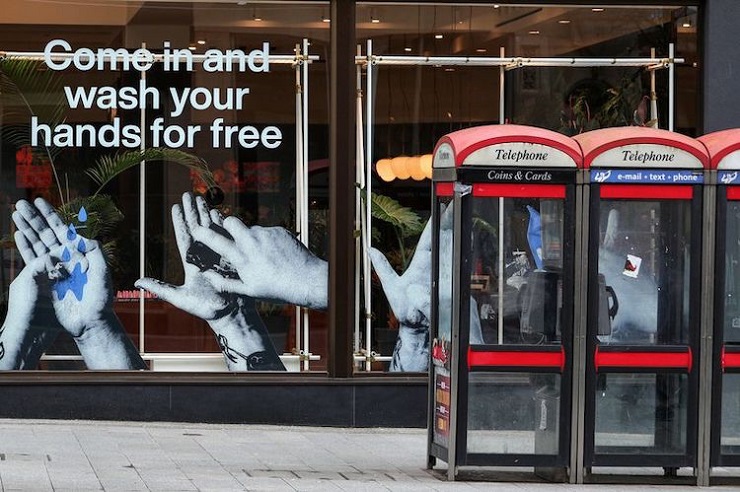
A Lush spokeswoman explained: "We thought that offering our shops gives somewhere for the public to do this without having to seek out public toilets (a diminishing resource these days)."
The company also used its shop windows to promote the hand-washing guidelines as advised by the National Health Service, the organization that manages the British public health system, and other international health organizations.
Their goal wasn't to make a profit from the sale of their cosmetics; all they wanted was to help build consciousness around the habit.
At the moment it is up to all of us to do what we can to prevent the spread of illness. The advice from authorities is to wash hands regularly, particularly before eating and to avoid touching your face. There will be no requirement to purchase anything – our soap, our sinks and our shops will be available for anyone to use as a free service.
Obviously, this type of approach does not only help their customers fight coronavirus; it also helps build trust and goodwill with their customers, something that may bring profitable results in the future. But by focusing on helping their customers, they ended up creating a wave of positive responses (the fact we're writing about them is a proof of that).

Sadly, Lush ended up having to close its stores not long after, along with most other businesses seeking to protect their employees and curb the spread of the virus, and due to government dictating a broader shutdown. Despite this fact, it was a touching example of a large cosmetics company—indirectly related to the health industry—using its resources to improve awareness of the issue to its consumer base and the broader public.
Mercado Libre
For those of you who have never traveled to Latin America, Mercado Libre may sound more like the name of a Mexican restaurant than the major tech company in the region. But this, my friend, is far from the truth.
Dubbed"the Ebay of Latin America," Mercado Libre boasts 280 million registered users out of 644 million Latin Americans and their product line includes the most popular online marketplace, the biggest payment processor, and more.
As the most influential tech company in the region, Mercado Libre discounted every pharmaceutical product on their platform. By doing so, they made sure no seller could take advantage of the crisis and increase their prices.
They also announced that they would forbid sellers to increase the prices on products in that category above the market value.
And they even took steps to delete all information on the site that indicated that hand sanitizer and face masks "prevent," "improve," or "cure" coronavirus.
Another sign of solidarity came from the company's new (and hopefully temporary) logo. Traditionally, Mercado Libre's logo is an image of shaking hands, but they changed it to reflect unity without shaking hands, a new behavior adopted to lower the chances of contagion.
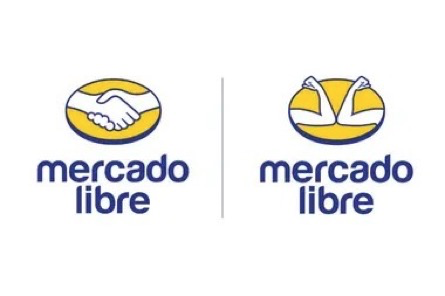
The change was accompanied by the message: "Together. Hand in hand, or not."
Postmates
One of the most effective precautions implemented by governments throughout the world has been social distancing.
All of a sudden, the entire foundation of modern society—built upon physical contact and proximity—was put on hold. Undoubtedly, this has had an economically destructive effect, but it has been proven to work to keep the disease in check (and save lives, which actually helps the economy in the long term).
Most brick-and-mortar businesses can't do anything about this—they're forced to close shop until the crisis is over. But some businesses, especially the online delivery companies that have seen major increases in app downloads and revenue, can still work while maintaining social distance.
The first large food delivery company to respond with new health and safety policies in its delivery service was Postmates.
On March 6th, weeks before the US Government called for targeted policies against the disease, Postmates introduced dropoff delivery options. This meant their customers were given the option to have deliveries left at the door.
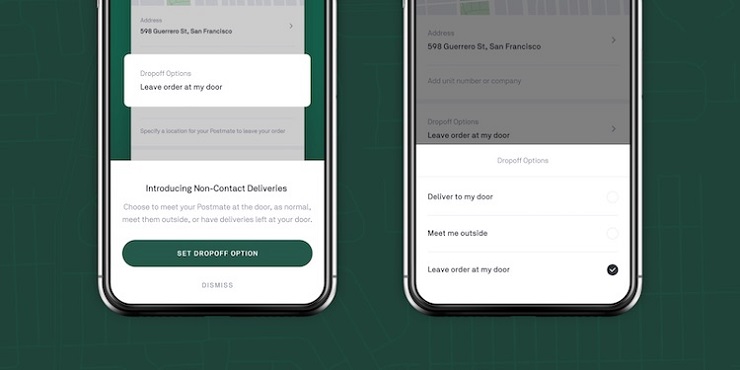
Soon after, all other food delivery services followed suit, including Deliveroo, Uber, and Takeaway.com. Thanks to their new delivery policy, consumers can still spend their money helping local restaurants while protecting their health.
Ever since the Cambridge Analytica scandal brokein early 2018, Facebook has been under fire over the way they manage their users' data. This crisis sparked a huge change in the perception of the company in the eyes of its users, going from the young startup everybody wanted to see succeed to a company openly distrustedby its own users.
In the midst of the pandemic, however, Facebook decided to step up and do the right thing, proving once again they can still be a socially responsible company that cares for its customers.
In the past few weeks, Facebookhas taken aggressive steps to help health organizations communicate with its user base. So far, Facebook has pledged unlimited ad credits to the World Health Organisation for related outreach as well as the Centers for Disease Control and Prevention (CDC), UNICEF, and national ministries of health.
Mark Zuckerberg has also pledged to match $10 million in donations to support Covid-19 relief efforts while also donating $25 million to support healthcare workers on the frontlines.

Facebook has also developed a $100 million grant program intended to help small businesses stay afloat.
As in many crises, there have been a lot of rumors and "fake news" being created and widely shared. This has represented a risk to both governments and health organizations.
For that reason, Facebook has ensured its users that they will have access to accurate information through the use of educational pop-ups on top of search results, which lead them to expert health organizations including the World Health Organization (WHO).
And finally, they implemented a new policy "prohibiting ads for products that refer to the coronavirus in ways intended to create a panic or imply that their products guarantee a cure or prevent people from contracting."

While it's hard to know whether Facebook will improve its overall public image, these actions will likely help win back the trust of some users, and even help in society's fight against the pandemic.
José Andrés
One of the worst short-term consequences of the worldwide lockdown is that there has been a huge increase in job losses, which by some dire estimates will reach almost 50 million in the US alone.
Most middle-class workers will make it through, just like they did 12 years ago during the financial meltdown. But the economically vulnerable are already having a hard time bringing food to their tables.
To José Andrés, a Spanish-American celebrity chef with over a dozen restaurants in half a dozen cities throughout the US, this was his call to action. Besides being a 2-Michelin Star restaurant owner, he's also a renowned humanitarian responsible for founding World Central Kitchen, a nonprofit that provides meals in the wake of natural disasters to those in danger.
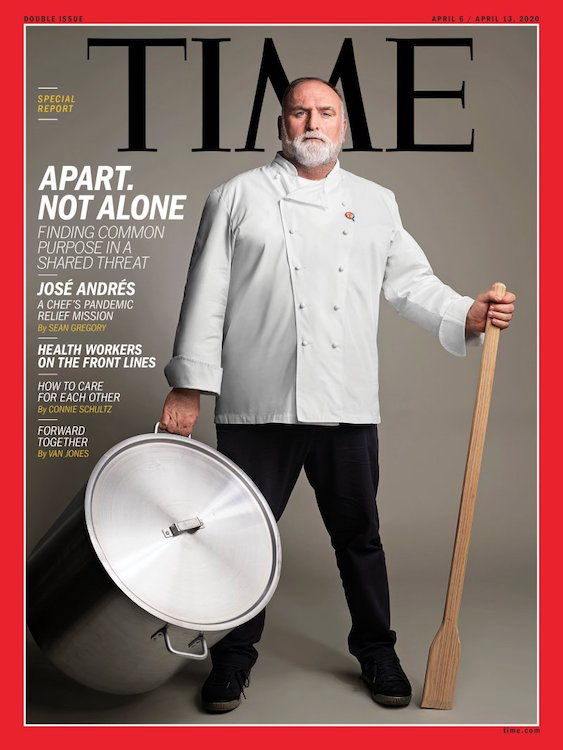
In the past, the organization has launched feeding missions in 13 countries, serving some 15 million meals with more than 45,000 volunteers involved. This earned him a nominationfor the 2019 Nobel Peace Prize and an awardfor the National Humanities Medal.
During this crisis, World Central Kitchen (WCK) was in charge of feeding the passengers of the infected Grand Princess cruise by forklifting fresh meals to both passengers and crew.

Andrés has also announced that he will transform eight of his New York and Washington, DC, restaurants into community kitchens for those struggling during the pandemic.
As of March 25, World Central Kitchen has worked with partners to coordinate delivery, via 160 distribution points, of more than 150,000 safe, packaged fresh meals for families in major US cities as well as Madrid.
A few days before, Andrés drove around DC giving out more than 13,000 N95 respirator masks to health care workers fighting Covid-19 in the trenches.
SevenZeroEight
The Covid-19 pandemic generated a spike in the demand of two rather uncommon hygiene products: face masks and hand sanitizers.
As always happens in these situations, consumers reacted with panic, hoarding these products en masse, which caused the prices to increase while the availability to decrease (and that excludes the common speculative moves from unkind people who are always ready to profit from these types of crises).
Both hand sanitizer and face mask manufacturers can't keep up with the demand, so to overcome this, certain companies have started to take the lead.
Hand sanitizer, while not hard to manufacture, requires alcohol, which has become hard to acquire. That's unless you actually manufacture alcohol yourself—and who else does that better than liquor distillers?
SevenZeroEight is an Australian premium gin manufacturer founded by the legendary sportsman, Shane Warne. Due to the shortage of hand sanitizers, Warne recently announced that he, along with the other two founders, had shifted their production towards medical grade, 70% alcohol hand sanitizer until further notice.
This is a challenging time for Australians and we all need to do what we can to help our healthcare system combat this disease and save lives. I am happy SevenZeroEight has the ability to make this shift and encourage others to do the same.

The company also announced that an agreement had already been made to provide a continuous supply to two Western Australia hospitals at cost.
Ford
Next to hand sanitizers, face masks are a key element for health practitioners to keep themselves from getting infected. And just as with hand sanitizer, face masks have been in high demand since the pandemic started.
An alternative solution, likely more effective in some situations and offering additional advantages, is wearing a protective shield. Such shields are used in many fields, from radiation-exposed workers to industrial workers. And one company that knows about industrial production is the American car behemoth, Ford.
Recently, Ford decided to mass 3D-print face shields. The first 1,000 shields shipped to local Michigan hospitals, while 5,000 others were sent to a California hospital.
From their initial estimation of 75,000 shields produced per week, their output ended up being 10 times that, as reported by CNBC. Not everything is bad news, after all.

Ford also had over 200,000 N95 masks—the most effective and therefore popular face masks—which it donated to the medical community.
Ford has also indicated that for US customers who purchased or leased one of its cars and have been impacted by Covid-19, the company will "discuss options if they are having payment difficulty. For example, they may be able to change a payment due date or delay a payment." Ford Credit, the financial arm of the company, is offering a similar program that gives its customers who buy new vehicles the option to delay their first payment for 90 days.
To bring calm in the face of financial stress, Ford accordingly shifted its product-focused American marketing materials (e.g., billboards) to brand communications promoting this credit relief program.
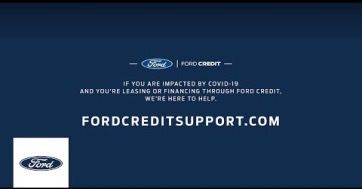
Ford wasn't the only car manufacturer using their scale and know-how to help with the crisis. Companies from General Motors to Lamborghinito Chinese-based BYDhave done the same, manufacturing face masks as well as ventilatorsand other key products to distribute in their countries.
This kind of situation hasn't been seen since WWII, when American car manufacturers shifted to manufacturing over 100 million artillery shells, 38,000 tanks, 206,000 aircraft engines, and more. What President Franklin Roosevelt called"the arsenal of democracy," somehave renamed "the arsenal of health."
This parallel between a time of war, when humanity was destroying itself, and a time when its descendants are now cooperating with each other to save lives is a beautiful way to think of how much society has progressed.
Wrap Up
Undoubtedly, there's a very long way to go before we recover from this crisis—and many steps to take to prevent future outbreaks—but for now, we can take some comfort in the selfless work happening in businesses like these.
As all these brands demonstrate, this is the time for businesses to do the right thing. It's a time to help others.
At the same time, be sure to maintain proactive and frequent communication with your customers. Be authentic in your interest in helping others. If you don't want to or can't help your customers—because your company is facing a harsh financial reality, because you are facing personal challenges—then don't do anything. But if you can—and you should—help others, then do everything in your power.
When this crisis becomes a thing of the past, your customers will remember those who stood by them and those who didn't. Make sure your brand is on the right side of history.
The post How These 7 Companies Are Responding to Covid-19 with Kindness appeared first on Foundr.
]]>The post How Founders Can Make it Through the Coronavirus Pandemic Stronger Than Before appeared first on Foundr.
]]>In difficult times like these, every business needs to take stock of where they are and where they're going, to become as strong and resilient as possible. But adversity also exposes new needs and opportunities, both of which entrepreneurs should be watching out for.
So how do you spot those opportunities? How do you avoid the danger zones in the economy right now? And how do you navigate these challenging times so you come out the other side unscathed, or only slightly scarred?
To answer these questions and more, our CEO Nathan Chan called in his personal advisor Steve McLeod to share some hard-fought wisdom with the Foundr audience.
Steve has turned his passion for helping people into a nationwide business, scaling his Fire and Safety Australia company to eight figures in 10 years. He has also worked with thousands of small, medium-sized, and large businesses over the years. And he's seen what it takes to make it through difficult challenges, stronger than ever before. In the video below, he's outlining critical strategies for every founder to follow right now so they can stay above water, and possibly even thrive in the face of one of the most sudden economic shifts in history.
Keep reading after the video as we unpack the key takeaways for you.
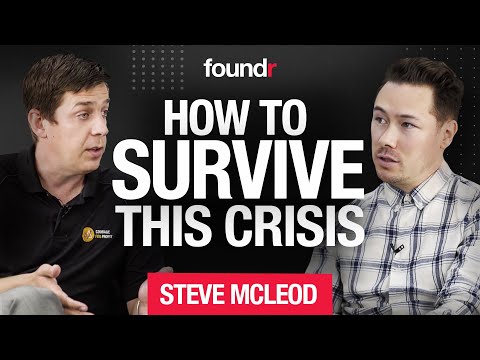
Immediate Actions for Founders to Take in Response to Covid-19
When the pandemic first started making headlines around the world, a lot of businesses carried on with a "business as usual" attitude.
But once entire cities began to shut down, countries started closing their borders, and nationwide quarantines took effect, it became clear this pandemic was not something you could simply ignore—no matter what line of business you were in.
"The worst thing you can do right now is put your head in the sand," Steve says. "You've got to think proactively and take decisive actions today so that you're prepared for whatever comes next. And there's a real chance that some industries may have their doors closed for six months. I want entrepreneurs asking what happens if that's the way this plays out. That's the only way to prepare for what's ahead."
For some businesses, like restaurants, hotels, and airlines, their sales have already fallen off a cliff. But there's a very real possibility that their sales will take a significant hit for the next 6-12 months.
That's why Steve says you should already be thinking about what that means for your business. The last thing you want is to be making choices around cutting staff, breaking leases, and filing for bridge loans to cover bills, all under the duress of needing to make a decision ASAP.
"I think every founder should start to say, 'If our sales decline by 50%, what does that mean for us?' Or on the flip side, 'What happens if our sales grow by 50% overnight? Can our suppliers handle that volume?' Because the reality is some businesses are doing well right now while others are struggling to stay afloat."
Walking through these kinds of scenarios is important because it gives founders and CEOs the most critical thing in Steve's eyes: Certainty.
"The biggest thing you want right now is certainty around the things you can control," Steve says.
The reality is, a lot is changing rapidly in the outside world, and founders need to give themselves as much clarity as possible around next steps for their businesses by doing a little bit of scenario planning.
Scenario planning will help you start to focus on the things you can control—like costs, conversations with employees around layoffs or hours needing to be cut, and treating your customers like gold—instead of just wondering "what if" all day.
But when you start going through these exercises, the one thing Steve cautions every entrepreneur against doing is slowing spending on marketing and advertising.
"It's tempting right now to want to turn off all spending," Steve says. "But that's an overreaction that can cost you more than you would imagine, especially if you pull back your spending on advertising and marketing. If you turn that off, that could be disastrous."
It's like Henry Ford said, "A man who stops advertising to save money is like a man who stops a clock to save time."
Steve says the first and most critical steps are to get a sense of where sales might go in the next 3-6 months, and then where you can cut costs—without eating into your marketing and sales budget. This kind of clarity can give you a major advantage in times of extreme uncertainty.
How to Effectively Pivot Your Marketing Messaging
In the wake of the pandemic, businesses across the globe are having to make extreme adjustments.
The reality is, if you were selling a course that showed people how to build a business that allowed them to to travel the world and work from anywhere, that messaging probably wouldn't work anymore, at least not for some time.
You'd need to adjust your messaging to a marketplace where travel isn't even possible at the moment. While freedom to travel might not be a selling point, perhaps flexibility and being able to earn income independent from a job is.
"You have to be aware of these changes in the marketplace and adjust your messaging accordingly. The reality is, this isn't a niche issue. This is a global issue, and if you aren't sensitive to it, your sales might suffer."
So you should pivot where necessary to keep your messaging relevant and sales coming in. But just make sure you're honest about the changes you make.
"Don't manipulate people or lie. People will remember what you say during these times, now more than ever," Steve says.
If you force your relevancy or outright lie, consumers will see through it in an instant.
For example, if you sell CBD oil, talking about the potential antiseptic qualities it has will come across as fearmongering and manipulative, as CBD oil is in no way a treatment against this virus. You would be doing a lot more harm than good.
However, talking about the potential for CBD to alleviate stress during these extra stressful times and running a sale on your products could be a way to deepen the bond with your customers.
The key is just being honest in your marketing. Steve says, "Honesty is always how you win, but it's especially true in these times."
The Mindset of Entrepreneurs Who Win the Battle Against Covid-19
If you've found yourself reading more news lately, you're not alone. According to some reports, traffic to news sites is up by more than 30% over the same period last year.
But Steve says, "If you're reading the headlines all day, that's just going to cause worry and fear. And when you're fearful, you're not going to operate your business from a place of strength."
Of course, with everything that's going on, it's not just impossible, but it's also irresponsible to completely unplug from the news. But if you're only focusing on news updates, you could miss opportunities that lie ahead. Or worse, you might not be dedicating your time where it's best spent.
When others are reacting to the news, you can be taking decisive actions to put your business in a position to grow and get ahead.
One of the most underestimated parts of growing any business is having your head in the right place. And Steve says that founders should focus as much as possible on their businesses instead of the latest news cycles.
Effectively Managing a Remote Team
 The challenges of remote work are real
The challenges of remote work are real
Source
As COVID-19 has spread, most employers have been forced to make their teams entirely remote.
Under ideal circumstances, both employees and employers would've had ample time to prepare, get educated around remote work best practices and have all the tools necessary to thrive.
But the situation is not ideal. Many people were tossed into this totally unprepared.
That's why Steve says, "The best thing you can do is to create some form of routine. Even if it's just a small daily meeting, that can be huge toward helping your team stay productive when forced into remote work."
While it might seem easy, working remotely comes with challenges and it's critical founders give their teams the tools and information they need to thrive during these times.
For many, this is the first time that they're being left to set their own hours and work from their couches. And a lot of people have no idea how to best structure their days. So if you're a team leader, it's critical that you teach them and ensure they feel equipped for the challenges of remote work.
Steve encourages teams and leaders to continue doing team activities like virtual happy hours and lunches if they can.
"You want people to be able to adjust to this situation and, in total isolation, we risk huge hits in productivity, team happiness, and more. Get your team together whenever possible, even when you're remote."
If you're looking for help with remote work best practices, you might want to check out Getting Real, an ebook on building a web app startup, by Jason Fried, the founder of Basecamp (a completely remote company). He's now giving away the book for free, and there's a bunch of info in there on managing a team.
Controlling Expenses Is Critical for Every Small Business Right Now
According to JPMorgan, "Half of all small businesses hold a cash buffer of less than one month. Moreover, 25% of small businesses hold fewer than 13 cash buffer days in reserve."
In other words, as we approach a couple of months into this crisis, more than half of small businesses could be left staring at a bank account dwindling dangerously close to a zero balance.
"Controlling costs right now is more critical than ever before," Steve says.
He recommends compiling a list of all expenses and labeling them as either "must have" or "nice to have."
Every item that's simply nice to have has got to go.
"Every dollar you cut is a dollar toward your survival. And some cuts will be brutally deep, but it's got to be done in the name of saving or extending the life of your business."
Contingency Planning for Sickness Among Your Team
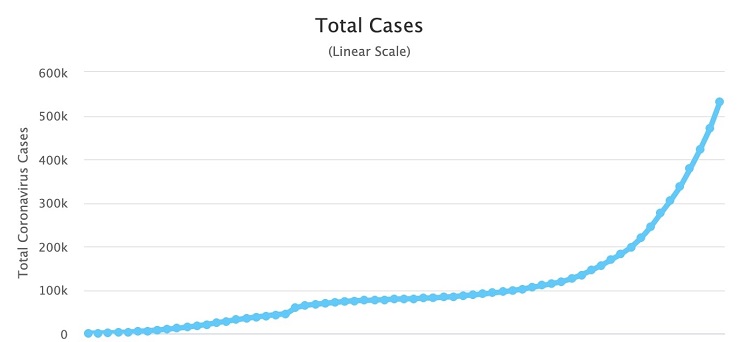
This graph gives you a sense of just how fast this virus is spreading, and by the time you see this, it will already be very outdated.
"The harsh reality is some of your team members will get sick. But instead of panicking if and when this happens, you should know what happens if key members get sick."
For example, if your head of IT were to become ill, would you be locked out of all your servers? Does anyone else know how to do this person's job? Who would step in and help?
"This kind of contingency planning is important, especially during these times," Steve says, "because you have people working from home and unable to access each other and their tools in the same way they normally would."
That's why Steve recommends that every key employee should create a simple one-page action plan with critical logins, contact info, and key tasks that others should carry out, should they get sick.
"This is how you avoid disaster scenarios getting even worse, by planning."
Can You Launch Products During the Pandemic?
One challenge that many businesses have run into is that they had a product launch planned for March, April, or May and are unsure how to proceed.
"Of course you want to be sensitive to the current landscape, but now is not the time to pull your foot off the gas pedal completely," Steve says. "Push forward, but possibly pivot your messaging."
In other words, keep selling, if you can sell.
For example, many in-person businesses, like personal trainers and counselors, have taken their practices online for virtual coaching. Some events that got postponed or cancelled pivoted to virtual summits.
"The key," as Steve says, "is to not stop your business activity entirely."
In fact, now more than ever, he recommends trying to launch some type of product that gives you recurring revenue.
For example, if you sell online courses, maybe now is the time to launch a monthly membership with weekly Q&As.
If you run a restaurant, maybe create a virtual happy hour club and send people weekly cocktail recipes for a few dollars.
If you run an ecommerce store, maybe run deeper sales than ever before or give amazing bonuses with your subscription products.
"Recurring revenue is especially powerful during these times. If you can create it, do it—100%, right now," Steve says.
Final Thoughts for Founders
These will be some of the most trying times for entrepreneurs in modern history. But there are calculated actions that every entrepreneur can take to keep their head above water and, possibly, even thrive during these times.
The biggest thing is to not be scared and to give yourself whatever certainty you can. Plan for the worst, hope for the best and be grateful for anything in between.

If you've been struggling or want additional help, be sure to subscribe to future Foundr videos and content. We'll be doing our best to guide founders through these challenging times with exclusive interviews, tips, and more.
Be well and be safe, Foundr family!
The post How Founders Can Make it Through the Coronavirus Pandemic Stronger Than Before appeared first on Foundr.
]]>The post 298: Serial Entrepreneur Josh Snow's Approach to Influencers, Recurring Revenue, and Paid Ads During a Pandemic appeared first on Foundr.
]]>Subscribe to The Podcast on iTunes, Soundcloud, Stitcher and Spotify
Josh Snow, Founder, Snow Oral Care
Click here to Skip to the Podcast Transcription
Josh Snow always finds ways to thrive in difficult situations.
Growing up, his family didn't have a lot of money, and he wanted to help them cover basic expenses. So Snow taught himself how to create websites at his local library, which is how he stumbled into entrepreneurship. He eventually took that knowledge and built a software company from the ground up, which he sold by the age of 21.
Now Snow runs multiple successful businesses—with the most prominent one being his nine-figure teeth whitening business, Snow.
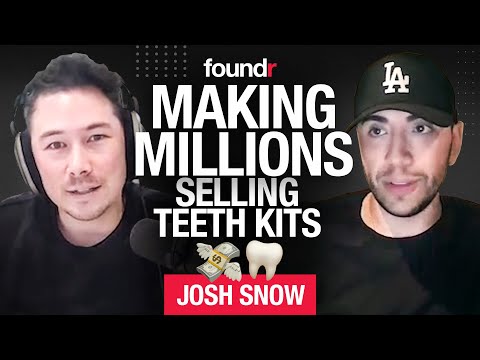
And he's still finding ways to overcome adversity. Just as most businesses have been impacted by COVID-19, Snow also took a huge hit in terms of sales, with its conversion rates cut in half when the pandemic first emerged. However, by making fast, strategic changes, Snow got his company through the temporary setback and is today seeing higher-than-average sales on its site.
In this interview, Snow shares exactly how he made the necessary changes to his business. He also provides advice to other online businesses on how to get through this time by adjusting everything from your subscription model to your approach to influencer relations strategy.
If there's any other type of content you'd like to see that would be valuable to you during this time, please don't hesitate to reach out at support@foundr.com to let us know.
Also, if you want to learn how to start a profitable online store in 12 weeks or less, check out our FREE masterclass taught by 4x multimillion-dollar ecommerce founder Gretta van Riel.
Key Takeaways
- How Snow stumbled into entrepreneurship through necessity
- The journey to selling his first software company at the age of 21
- Why Snow believes adversity gives you the opportunity to pause and reprioritize
- The inspiration behind Snow, and how it grew to be a nine-figure business
- How the company has been affected by COVID-19, and the changes Snow made to help his business bounce back and make more sales than before the pandemic
- Snow's recommendations on how to adjust your subscription products, influencer relations, and paid ads strategy during this time
- The importance of evolving and meeting your customer where they're at
- Why Snow believes you have to be an "everything" person if you want a successful business
- Advice on using Shopify vs. funnels
- The choice between hunting rabbits vs. elephants (metaphorically)
Full Transcript of Podcast with Josh Snow
Nathan: First question I ask everyone is, how did you get your job?
Josh: Yeah. I truly did stumble into what I'm doing and entrepreneurship in general. I'm sure a lot of people have a similar story so I won't harp on it too much, but growing up I wanted to be a doctor because I wanted to make enough money to help my family out. I'm the youngest sibling in my family and my brothers and sisters didn't have an opportunity to go to university. So I just wanted to help out my family. I come from very modest means. So I was like, I want to be a doctor because I want to make enough money, help people and I would like to earn the respect inside of the community, like be able to do charitable work or community work.
I figured being a doctor check those boxes off and it does. So I was just like, I've got to be a doctor, I've got to figure this out. I stumbled into entrepreneurship because times got a little bit tough for my family and I was looking for ways to make money really just to buy my own stuff. I was looking to buy my own underwear and socks. It wasn't like I was trying to… at 13 years old, 14 years old, I wasn't thinking like, oh, I want to buy a Lamborghini. It was like, at the time it was, I don't want my parents to have to struggle, or I don't want to be a burden to them for asking for things for school or whatever it might be.
Not that they made me feel that way, it was just in my head. I started looking for jobs to see if I could work somewhere to make some money and obviously nobody could hire me at the time because I was 13, 14 years old. So, I felt really stuck because nobody wanted to give me a job. I really wanted to help my family out. The economy started to turn the other way, 2007, 2008. Yeah, I was stuck and so I was looking for a job. So the job I have today was invented or I discovered it through necessity, through struggle, adversity. At the time I was hanging out at the library. My family didn't have a computer at home even. So, we didn't have internet or computer at home.
So I was at the library and back in the day with your library card you could get about an hour of usage on the computer. So I was reading books at the time because you're on books or computers, that's about it at the library. If I wasn't playing sports, I was at the library. So, I learned how to make websites. I didn't know what I was doing at the time. I didn't know what I was learning at the time. I was reading these books because I was taking comprehension tasks, getting points for every book that I read. Those points I could cash in for like baseball tickets and soccer tickets and all that type of stuff.
So I didn't know what I was doing, I was just reading books and I found the hack that if I read the reference books, like the For Dummies books, they were considered a 10 out of 10 points but they had a lot of pictures in them. So, I was able to rack up a bunch of points by reading these dummies books and I'd always been interested in computers even though we didn't really have them growing up, I was always fascinated by them. So, put two and two together, I started reading these how to build websites For Dummies books and I said, wow, this seems like something I could actually do. So I started building my first few little websites and blogs and I didn't even know really what I was doing, but I just was putting stuff out there and I was blown away that people started commenting and from all over the world, I didn't know where they were at.
So that just like, it blew my mind. I was like, "Whoa." Then once I found that I could make money from it, well, I could make websites for other people and they would pay me to do that, that's when it all clicked and it happened for me at a very early age. But that was what set the domino effect to today, running multiple brands and doing what I do today was, I want to help my family out. Can I make 500 bucks making a website for somebody? How can I be the best at making websites and then it progressed from there.
Nathan: Yeah, I see. So humble beginnings. Talk to us kind of fast forward to now, how many brands do you own and operate? How many companies do you have? It sounds like you got a lot going on man.
Josh: Yeah. So, I'm obviously known for Snow. At Snow is the Internet's most popular oral care brand. We've worked with all kinds of celebrities and all of that. That brand has really taken off. I think it's a refreshment in a dormant category, a very large category like oral care. It's traditionally very tough to break into an industry like that. I chose that market and that industry because I wanted difficulty. I had been going through some tough times again. So this was like a… it's funny how you get these realisations through adversity and speaking through with the time we're going through right now with adversity, I think it gives you time to pause and think sometimes and really prioritise what matters. For me, I had sold my software company at 21 years old and I had more money than I would ever imagine. To me, I was a billionaire, in my head, right? I was like, "Oh my gosh, I made it."
So, went and bought the Lamborghini and the Bentley and I thought I was on top of the world and I guess I was at the time. I had finished university, top of my class, first in my family to finish and everything was great. But when I sold my company, six months into it, I felt I didn't have a purpose anymore. I was like, okay, this is fun but what am I going to do next? Whatever I do next has to be that much bigger than what I just did, right? There was just all this pressure on me and most of it was in my head, I guess. But, I was looking for things that I wanted to… markets that I wanted to disrupt and two of my buddies were creating a mattress company, it was the first bed in a box company, went on to become one of the largest, one of the top three in the world and I was like, okay, what markets am I going to look at?
So today, I own and operate primarily two businesses. One in financial wellness, personal finances, and the other and obviously oral care. Those are the two main ones. I've been fortunate to invest and advise lots of other brands, a lot which are no longer around today where, like I said, when I sold my company I thought that I could buy my way to be an investor or something and so I just started throwing money everywhere, $250,000 here, 200,000 here, 500,000 here. You do that enough times and your pile of cash starts to disappear pretty quickly and there's no call back on that capital. So I realised that if I was going to… what I realised, I wasn't rich enough to be able to give the way I wanted to give in the aspect of being an angel investor and investing in lots of businesses. I felt that I was a little to restless too. I felt like I had to do something, I needed something to do.
I happened to be going through oral surgery at the time, jaw surgery and that's what allowed me to stumble into the oral care markets. Personal finances has always been something that I've been fascinated by because coming from an upbringing where we weren't wealthy by any means, I had to learn the hard way of letting people manage my money and stuff and getting screwed over. So, personal empowerment through personal finances or empowerment through personal finances is something I've always been passionate about because they don't teach enough about it in schools and university. So that has always been a background. But I'm most passionate about those two businesses. That's where I spend the majority of my time.
Nathan: Yeah, I see. So, what was your software company that you sold at 21? What was it and what did it do?
Josh: When I was 13, 14 I started programming, web development specifically, and then moved to design because again, I didn't know what I was doing. I was just like, oh, I need to design it? Okay, I need to figure out Photoshop. I can't afford Photoshop. How do I download a torrent of it because I can't afford it. It's just like one thing led to the other. So I built essentially an agency. I didn't know what I was doing until I was 15 or 16 years old, made my first million dollars at 17 or somewhere around there. You feel like there's this moment of like, oh, this parade all of a sudden it breaks out. In reality was in my head but I wasn't even satisfied because I was like, okay, that means there's so much more potential.
So to answer your question, what happened is between 17 years old and 21, I started to look at this agency business. Could I sell this type of business? What am I doing here? What's going on? I found that really what was unique about what we're doing was a software I had built in the background to automate a lot of stuff because I knew that the agency work was very high maintenance, very high touch and so I wanted to use my software and programming background, software development programming background to try to automate or at least semi-automate a lot of this stuff in terms of media planning, media distribution, particularly through media buying like Google Display Network.
Again, I didn't know a thing about anything I'm talking to you about. Everything I learned is from forums, communities, YouTube, Google and books. But Google has two sides of their platform and multiple sides. They have their search where you go to Google.com and then obviously the display side of things, which now includes YouTube. So display is, are those banner ads you see on every website. So when a client would come over, let's say like Apple let's say, and they're launching a new product, they say, okay, we want to allocate $10 million to relevant websites that are talking about the iPhone or talking about our competitors and we want to place banner ads next to those blog posts so that we can grab the attention of a relevant article.
So essentially what my software would do is, aggregate all of those websites that had Google Display Network on them and create banner ads that had a specific language based on that article. So in simple terms, let's say you sell ice cream cones and you have a new ice cream flavour coming out, vanilla. You're coming out with vanilla for the first time. You want to spend a million bucks promoting this new vanilla ice cream. Well, everywhere that is talking about vanilla or ice cream or desserts or your competitors, you want to be in front of. But if they're talking about vanilla in politics and then they're saying if someone's vanilla, they're very plain and basic, you probably don't want to show up there.
So, the contextual, which means finding the words vanilla and showing an ad next to it, it's not always the most accurate form of advertising. So all I did was… and the reason why I came up with this, was because I had overspent a client's budget like 40 or 50,000 bucks. It was bad. I just remember it was really bad. It's because we had the Google Display Network running, which is what we were getting known for but some of the negative keywords, which means don't show me for this weren't enabled. So we ended up spending like an extra 40 or $50,000 of the client's money and they had someone smart enough who was able to dig into it and had an idea of what happened and it was really… it wasn't on purpose, but the negligence was on purpose. It was obviously our fault. We were paid to manage the money.
So I was like, wow, there's a fault in Google's algorithm where they're not always showing the most relevant stuff. It's like if you're running a campaign right now with the Corona virus stuff going on, you have to be sensitive to what's going on and you don't want to seem, and hopefully you're not, but you certainly don't want to accidentally seem like you're profiting off of what's going on. So let's say you had an ad campaign running right now and it accidentally showed up and it made your company look like you were being insensitive to what's going on globally, that could hurt your brand. It can only waste your money, but it could hurt your brand big time. So there was a huge value to the software I'd built to traditional PR agencies, traditional media companies, because they worked with a lot of blue chip clients that couldn't afford to have that type of damage happen to Google Display Network.
So that's six years I'm trying to condense into five, 10 minutes to explain as best as I can. But that software was valuable. At the end of the day, it wasn't a very complex piece of software, if I'm being completely honest with you. I made it because I didn't want to lose clients money anymore and then I sold the shit out of it and I sold it by saying, "Look, you can go to another agency but they don't have the software we have. You might accidentally put an ad on a porn website and your brand could be ruined. It's up to you if you want to take that risk or you can come with us. We have perfect reviews, you can talk to all our clients. We work with the best people." So I used it as a sales tool and then as we started working with PR companies that were reselling our services, so they would have like Nike craft, whatever.
I couldn't get those clients myself, but they already had those clients but they would say, "Josh, you guys do all the digital media buy and we'll just mark it up. We'll give you 10% of the ad spend, we'll take 30%." I'm like, "Okay, sounds good." Well, I ended up signing that software, I piecemealed that software to those exact resellers because it was much more valuable for them to have versus their competitor to have. So it's important to break that down because that's six years of strategy and figuring stuff out as I took agency service side business, built a piece of software on accident, I guess, and then leaned into that software as our unique differentiator to charge more than everybody else and to keep our clients longer by scaring them in a sense. Then using that piece of software to go and sell to the people who were reselling our services and say, "Hey, either you're going to get it or your competitor is going to get it, only one of you is going to get it."
So I had to really like finesse that deal because I was working 16 hours a day, seven days a week. I had gained like 80 pounds running that business. I was working a lot. I'm in charge of a lot of people's money. I had an expensive office, lots of employees. It was really, really hard. I don't know if I didn't sell that business, it would have been really tough for me to keep going. Once I sold that business, six months later, I went through a burnout and depression. But that's from 13 years old to not knowing what I'm doing to 21 years old, multimillionaire and to depression/burnout, a delayed burnout to now, where I'm at now. It's been… lots has been going on.
Nathan: Yeah. Wow. Crazy. So, you started Snow and how long have you been running it? When we spoke offline, it's okay to share, right? You guys are like a nine figure business, annual revenue, right?
Josh: Yeah. Snow started actually… so, the first inkling of Snow started probably, oh yeah, so maybe six years ago. So, a while ago. That was the first inkling of it, of like, I bought the domain name, thought about… I remember at the time I had a business partner, another business and I wrote on the white… these big whiteboards in our office, I wrote down what I thought Snow could be. I had always been fascinated in beauty and a lot of our clients were in beauty and cosmetics and makeup, et cetera. So, I had this personal fascination with fashion and beauty products, cosmetics. So I wrote this out. My partner was a little bit more software-like, very business to business, very software focused. So when I wrote this whole thing out, he was like, it sounds cool, but I didn't really feel him jive with it all the way.
So, I just said, "All right, well, I'm going to buy the domain name and we'll see what happens. I don't know." So I bought the domain name, I just put it aside because I felt, not embarrassed, but I just didn't feel the energy coming from him about the idea. So I was like, screw it. Well then fast forward, two years past that, this is about four or five years ago now, I have jaw surgery, take out my jaw from my head, put it back in my head. I'm sitting there healing and I'm looking at all the products I bought and I'm like, gosh, they're so ugly. All these products are ugly. I would never post any of these stuff on Instagram. I was like, why can't oral care be exciting? Why can't there be exciting flavours, exciting ingredients, collaborations, celebrities? Why is it not here? Everybody has teeth as far as I know and I'm like, why is there not excitement in this industry?
As I was recovering from oral surgery, I had my jaw closed for two weeks. I'm sitting there researching and then I hit up my dentist, my orthodontist and my oral surgeon and I say, hey, will you guys help me like connect me to people. I want to get in initially the teeth, whitening space because teeth whitening was the only thing I could do without being a dentist or whatever like any procedure. So they're like, "Yeah, we'll help you out." I hadn't been helping about business and stuff and connecting them, they were just good friends by that time. They are like, "Yeah, we'll help you out, we'll connect you to who we can." That was the beginning of actually turning Snow into an idea.
But it first hit me about six or seven years ago and I don't know why, I don't know what it was that just excited me about it but I drew everything out on a whiteboard, I might even have pictures of it still. I was like, it's going to be called Snow boom, boom. Once I thought my business partner, he just didn't really like the idea that much as much as I did, I put it away. But if I would have went with it at the time, who knows what would have happened. I'm happy with where we're at regardless. But, who knows? We maybe we would have had a two year head start if I would have went with my gut.
Nathan: So fast forward to now and now in the current times, how are things going? Have you guys been affected from online consumer purchases and everything there. Talk to us about that.
Josh: So the first seven to 10 days, which was, let's see here, March, I don't know, like March 10th through the 20th, let's call it, March 10th to the 20th our conversion rates cut in half pretty much. People just were not buying, they were still visiting the website. We have about a million, million and a half shoppers a month. So, we were still around the same traffic numbers, but people just weren't buying. So, it made sense and I looked at myself and I was like, I'm over here, stocking up on food, stocking up on toilet paper and whatever, just kind of herd mentality and so everybody's in shock, of course, they're not thinking, how white are my teeth? They're thinking, how much toilet paper do I have and that type of stuff.
So, I was worried because I'm like, oh my gosh, if this lasts a long time, we're really going to have to look at what we're going to do. Do we pause the advertising? I don't know. So yeah, we were affected the first seven to 10 days, significantly, like cut in half or less. Then we started to look at, okay, what can we do authentically because our audience is 500,000 plus strong. They'll call us out whenever we do something that's not totally our brand, which is great. It's good to have that. Sometimes it's annoying because when you want to try something new, you know that they're already… they're just waiting there. But yeah, we changed our messaging a little bit. We reminded people that we're still shipping. We brought our spring cleaning sale 25% off. We brought it up to immediately. So 25% off sitewide, we're donating a percent of proceeds to small businesses affected by COVID.
One of our team members brought up the idea about Feeding America, that there are a lot of people without food. So we're changing our organisation next week to Feeding America. So we're going to give some money to Feeding America now. So we changed our verbiage. We said, if you're going to be at home you might as well be whitening your teeth. Come out of this smiling with the widest smile you've ever had. We started pushing some of our other products like our anti-ageing lip balm and lip scrub and floss. Then that 25% off discount, giving the charity aspect, reminding people that we're an American company, shipping from America, we're still in operation. We asked small business to be patient with us, we're shipping as fast as we can, order before we sell out, we don't know when we'll get inventory again so there's some urgency there. Some combination of that just clicked for us and over the last five or six days, we've had incredible sales days. I mean, it's like if not normal, it's better than normal, which has been really interesting.
Nathan: Interesting. So, do you have an element of recurring revenue and subscription with the whitening, with the refills?
Josh: So we just launched toothpaste and pre-order. So toothpaste will be a subscription product. Mouthwash will also be a subscription product. Then we just added subscriptions to all the products. Our customers, they wanted to subscribe to the lip balm, the lip scrub, the floss and the refills. The refills, the average customer is refilling every three to six months, more closer to the six month range. Toothpaste is every two months up to four months. So every two to four months they're restocking on that. The other products are in between. But yeah, there's a piece of it. By the end of this year, about half of our revenue will probably be coming from recurring customers.
Nathan: Yeah. I think during times like this recurring revenue is really, really important. What's your take on that for like ecomm businesses and where they should be thinking right now around even that or any of the changing up the messaging or yeah?
Josh: Oh man. I mean, the thing is right now there's a lot of uncertainty going on, uncertainty around jobs, uncertainty around health a lot. So, the more certainty you can provide on your website and in your ads and the more… you want to be sensitive to what's going on, you don't want to over hype it where it seems like you're doing too much and you also don't want to be oblivious to where it seems like you're insensitive. So I think being sensitive to what's going on, if you're still shipping or if you're still in operation, let them know that. Be very clear with what's going on. You don't have to send an email out like every 5,000 companies have sent me emails, I don't really care.
But, you don't have to send an email about what you're doing in COVID but it should be on your website very clear, we are still shipping through this madness or through these tough times. We are here for you. You can call us. We opened up our phone lines. We put our phone number top right on the website. We put our phone number in front of everyone, live chat because we want to be there with the customers. What we've found is that they're very understanding. They're very like, "Wow, you guys answered? You guys are working through this? That's amazing. I'm so proud of you guys." I'm like, "Oh no, don't worry about it. My shipment is late. It totally makes sense. Listen, you just stay safe." We are banding together as a… the entire world has banded together and said it's okay and our international customers are cool with it.
So we've been changing our messaging around subscriptions because subscriptions… profit cures all in a business and revenue cures all profit most importantly and recurring subscription income is the only thing you should be focusing on right now. Now, doesn't mean that every customer is going to do that or be open to that, there is subscription fatigue, there's a such thing and your business, I'm speaking generally, your business might not play well to subscription. My business is toothpaste and mouthwash. That makes a lot more sense. Toothbrushes like, yeah, but some of our other products don't play as well. Some of the other things we're doing just don't play well to subscription. That's okay. What you want to focus on though, the premise is recurring customers, retaining the customers. So, it's important more than ever for your email channels, your SMS channels, are you calling your customers even if you're B2B, are you picking up the phone, talking to your customers, to your clients?
So this is the time where you really got to step up that point of communication more than ever before. But I would be pushing if you are in e-commerce and it makes sense for your business to have a subscription format, if you're running advertising, I would be running all that advertising to a subscription offer, 50% off your first month, 50% off your first year, whatever that looks like. Try to build a Netflix or Amazon prime in your business of some sort because times like this is exactly why you want to have that, to be able to depend on that income versus let me wake up today. Too many businesses are Facebook Ad dependent and single product dependent or single offer dependent. Too many businesses.
So if I told you right now, hey, pause all your Facebook ads, would you go out of business or would you stay in business? Pause your Facebook ads for 90 days. If your sales will go to almost zero, you don't really have a business right now and that's okay, but you have an offer and you have an offer that might be doing well on Facebook, but you've got to diversify. I don't care how small you are, how big you are, you've got to diversify and you've got to build recurring income. Otherwise, you're in a hustle business, you're not in a business, business.
Nathan: Yeah, I agree 110%. So talk to me about discretional costs. Have you cut back on influencer marketing? I'd love to talk about that. You've been pretty legendary on the influencers that you've worked with. I think that's how, to be honest, I first heard of Snow was some of the big celebrities that you've worked with. Are those things you are cutting back on or Facebook ads, PPC? Are you getting more aggressive because costs are down by like 30%? CPMs are a little like really low now so compared to three months ago. So yeah, are you going on the front foot or what?
Josh: So, any of the discretionary stuff so, influencers definitely we've pulled back on. We're looking at everything. I mean, this is a great opportunity again, to detox, look at every software expense no matter how big your company is. I mean, the bigger we get, the more of a reminder it is to look at every single expense. So down to the water bottles, are we getting too fancy, to the software, to…? It's a principle. You might only save five bucks or 50 bucks on the software by cancelling but if you're not using it, you're wasting that resource and wasteful spending is a practise you want to prohibit against as much as possible. So we try to, as a team look at in every department, how many pieces of software are you paying for every month or are you using it? When's the last time you used it? Could you live without it?
Influencers, if anything's not driving bottom line, right now we're cutting it or we're trying to cut or we're putting it on pause. Then in terms of Facebook ads, all ads across the board, Google, Snapchat, et cetera have dropped about 30% for us as high as 50%. So we are as best as we can, tripling down. So, yeah, we're pushing really, really hard. I mean, April could be a 10 plus million dollar a month if CPC stay the same, if they stay low enough because we are getting much more bang for the buck. People are at home, they're on desktop. So if you're not opening up the desktop ads, open those up because people are on desktop more than ever right now. Like I said, I'm on this iMac, I'm on my huge desktop. I can open 20 tabs right here. So you want to hit me while I'm on the desktop because the conversion rate is so much higher on desktop, especially when you're selling a higher priced product, anything over a hundred bucks.
So, we are tripling down on all advertising. We are using the time right now to push our message forward, get in front of as many people as possible. Obviously convert as many to sales. But there's going to… we're also building our retargeting pools so, we're trying to get a million people to the website, only X thousand of them are going to buy, but we're building that 60, 90 day retargeting pool. We're building our email list so that when they feel ready to buy, because not everybody feels ready to buy right now, they're still worried, they're not sure what's going on, but as soon as we run a flash sale or as soon as they feel better in their position, we'll be there to convert them.
So it's a great opportunity for you to build your email list, put out content from your brand, run contests and giveaways, all of these things. So, we're like trying to triple down as hard as we can on all fronts in terms of advertising. You should be in your business as long as it makes sense and you're making money, you should be taking advantage of essentially a 30% discount right now.
Nathan: That's an interesting take. It's like, everyone knows Warren Buffett's famous quote, be fearful when others are greedy and greedy when others are fearful.
Josh: Stocks are the only thing people… stocks and a few things are the only things people run away from when they're on sale. If a purse goes on sale, you're running to pick it up. If a stock goes on sale, you're scared of it. So I think right now is when a lot of opportunities out there, if you're looking at it the right way, I think, Post and Kellogg's, Kellogg's came ahead of Post Cereal when Post Cereal was the number one cereal brand, they pulled back on advertising. Kellogg's was an upstart. They stepped it up. Post has never been able to catch Kellogg's since then. Volkswagen and Toyota in the '70s, same thing. Toyota stepped up, advertising Volkswagen pulled back. Volkswagen's been chasing Toyota ever since. There's an opportunity.
You look at 2008, 2009, all of the amazing companies that were built in a downturn or recession, there's opportunity there if you look at it the right way, but you've got to take things on a day to day basis. It's survival of the fittest, it's Darwinism. You've got to evolve very quickly. You've got to change your messaging. You've got to change your offer. You've got to be willing to discount things if that's going to get people over the edge. Right now you should be loading up. Even if you're breaking even, but you're able to pay salaries or you're able to keep just stuff moving. You want to keep stuff moving. Unfortunately, like I went today to a Vietnamese restaurant that we like, and he said sales… he was super happy. He was like, sales are about 35, 40% of what they normally are. So it's great.
In my head I'm like that sounds horrible. I was like 35% of what they normally are? So 70% discount on your day to day sales numbers. But then I thought about it, I'm like, well first of all, restaurants, nobody's going to restaurants. It's just not happening. He's not a big chain so he doesn't have a lot of money to back them up. So the fact that he's able to make 35 to 40%, call it almost half of what he used to make with half of his expenses cut down because it's only him and one other guy running the restaurant right now, that means he can put food on his family's plate, he can pay his bills, he can keep the restaurant alive. He can pay rent because rent is still going to be due. So I'm like, that's amazing. The fact that you can still make 40% of what you do as a restaurant, that's awesome.
So if he's happy, you should be happy with anything around there just so that you stay in business, you can pay your employees, if it's at all possible, take advantage of the cheaper advertising. It's almost like the Facebook gods dropped a little fairy dust out and said, for those who it applies to and who are fortunate to be that position, here's an opportunity to get a discount while things are tough and it's just supply and demand. That's just how it works. But my heart goes out to millions of small businesses around the world who… the average in America, small business has 26 days of savings. So 26 days go up, they're out and even if the government gives away who cares how much money, by the time the money comes in, the business is out of business.
So if you are working online, if you have an online business, whether it's digital, business to business, business to consumer, whatever it might be, find yourself very lucky and strike while the iron is hot. The opportunities in front of you, you've got to recognise it and you've got to strike on it because not everyone's as lucky as you.
Nathan: Yeah, I agree. It's very, very tricky. It's a crazy time because you don't… I know a lot of people would be self-conscious, right? They don't want to be seen like they're selling or profiting or capitalising of… all these people that are losing jobs and all these crazy things. What is your take on that?
Josh: Yeah. So you want to be sensitive to it, right? But you want to be as… take what you would normally do as a brand and a brand is built by what you say no to versus what you say yes to. There's a quick anecdote, this is part of brand building is, we had the opportunity to launch charcoal, charcoal toothpaste, charcoal this, charcoal that. Well, charcoal destroys the enamel over time. It's very bad for the teeth. So we decided, although it could be a multi-million dollar channel for us or product line, we decided against it. We still have not come out with charcoal toothpaste or charcoal whitener. We have a charcoal floss in between teeth, but that's the furthest will go with that stuff.
So, you have to choose as a brand, what is your moral compass? What is your ethical compass to say, what is right, what is wrong? What do I feel good about? Can I be proud of this two years from now? If New York times did a story on us about what we did during this time, would you be proud or would you not be proud? If you want to be proud and you have ethics and a moral compass, you're going to use that to guide all of your actions and your ideas. So for us, you've got to keep selling, I mean, first and foremost, unless you're like, if you're selling a crappy product or service or you're drop shipping and it's taking eight weeks now to get to people, you shouldn't be selling that stuff.
Have a common sense metre in the sense of, am I doing right by the customer? In a vacuum, would this be considered good or bad? Whatever it might be. But if you have a decent business, let's say you're selling keyboards for computers or you're selling webcams or whatever it is you're selling or nutritional supplements, I don't know, digital products, it is your obligation as an entrepreneur, as a business owner to continue to drive value. If you're actually driving value for your customers and is your obligation to stay in business and continue to do right by our customers, open up the returns, we do free returns, free shipping. We're opening up a lot of those lines. I told the customer support team, "Look, if somebody orders and they feel bad afterwards and they just want to refund, there's no reason, they just want to refund, just give them the refund."
Because here's the thing, yeah, it's 120 bucks but right now 120 bucks means differently than it did three months ago. 120 bucks three months ago it was like, ah, whatever, I'll make it back. Now it's like, if I'm not working, 120 bucks that's a week of food. I don't know if I… I changed my mind. I really wanted Snow because I saw a Kardashian use it but I changed my mind. So normally we would have like a down sale. We'd be like, hey, I understand you changed your mind. What if I told you you could get… we'll give you a $50 gift card or whatever it is. Now, we're backing off and we're saying, look, if you change your mind, you want to refund, got it. We're doing the 25% off sitewide so that we don't have to charge full retail for our product. Trying to listen to our customers, be understanding.
The truth is, people are at home right now and they want to whiten their teeth, they want to feel more confident, they're hopping on zoom calls, they want to be able to feel comfortable with their smile, they want to have something of normalcy in their life while all this stuff is going on. Something they can control. You can't go to the dentist here anyway right now, none of the dentist office are open. So, if you're applying to get your teeth whitened, sorry, it's not going to happen, you can't go to the dentist. You can't even go to the store to pick up strips. So, we're trying to be there for our customers to help them feel more confident. That's part of our brand is to help people feel more confident.
So the answer is like, if it's something that you are going to feel proud of, if it's something that you feel confident about, I can't answer that for everybody because you might not feel confident at all selling the products right now. You might not feel confident taking any money from people right now. We opened up our payment plans, so it's 25% off and then it's zero interest, zero fees on the payment plans. So it's literally, I think it's like 28 bucks for four months for the full system, zero interest, zero fees and you get the 25% off. So we're going above and beyond to meet the customer where they're at so that we can make it affordable if they really want the product. So it's 28 bucks instead of 150 bucks.
So, using Afterpay, Klarna, things like that, meeting your customer where they're at right now and putting that out there saying, hey, we're here for you. Here's our payment plan. Here's 25% off. You don't have to go and give 75% off your brand and do that. But it shows that you're being sensitive to what's going on and the customers will remember that. They have pretty good memories on both sides. You screw them over, you don't deliver on your promise, they remember. If you go above and beyond, you give them a phone call, you check on them, they will remember that.
Nathan: Yeah. I think that was an awesome answer man. Thank you. I think that was spot on. So, talk to me about drop shipping versus brand. Because I know you would see both sides of the table because you've been in… yeah, you've been in online space sounds like for 15 plus years so you know that world. What is your take drop shipping versus building a brand?
Josh: I think drop shipping just like… So, I started essentially building websites for the people. So I started as an agency and so that allowed me to find my footing over time and it took a long time. I started at 13 years old making my first website. By the time I sold a business, I was 21, so it was eight years. It was a long time. I'm talking… even though I was going to school at the time, it was eight years of like, all I thought about was this stuff. I got great grades in school and stuff for my family and all that but it's eight years of obsession. Now, I'm 27, tack on another six or seven years on top of that, which is just a different level of obsession of where I'm at now.
Drop shipping is great in the sense that, teaches you how to run advertising, teaches you how to write copy, teaches you how to do that stuff. That's awesome. I think that you have to break away from that one way or another. Obviously it's sales business, since day one we don't sell anything we haven't made from scratch. Anything else out there that looks like us is a counterfeit, send them my way, we'll take them down. Everything we've created is from scratch. That's just something I've chosen to do. I would do it again even if I had to take a loan out, even if I had to put it on credit cards. There's just something about shipping every product ourselves, touching every product ourselves, putting it in the package, seeing the name that's printed on the label.
There was a time where, in the very beginning I was still shipping out of that. Here I am, multimillionaire, shipping out every package myself, driving to the post office, 50 at a time. So I was touching everything. I designed the first website, wrote the first copy, wrote the first ads in AdEspresso, boom, boom, boom. I did everything myself. I called the customers myself on my cell phone. I did everything. But I did that because it's a principle. It's just what I do. It's all I know. When I started my first business at 13, 14 years old, I didn't know what I was doing, but I was doing everything myself. I was programming, oh, I need Photoshop, how do I learn Photoshop? Let me go to Google, how to learn Photoshop, or pick up a book. That's just all I know. All I know is how to get my hands dirty.
Now, I've learned delegation and having a great team because you can only do so much yourself. Nowadays I spend most of my time on the phone, in meetings, travelling to close deals. I spend time doing that but I can still get my hands dirty. I can go and… I can Shopify liquid develop, I can go write code. I feel like too many people are afraid to do those things. They're like, ah, I'm not a math person. Ah, I'm not this. It's funny because everybody is a money person when the money comes around, but nobody wants to be a math person and nobody wants to be a programming person and nobody wants… you've got to be an everything person if you want to do it well and you want to be big. If you want to be respected by your team, you have to kind of do it all.
Otherwise, you've got to be so brilliant in whatever it is you do. You either got to bring a tonne of money to the table where you can hire a huge team or you've got to literally be Albert Einstein or Elon Musk or I don't know, Elon Musk gets his hands dirty so I can't even point to him. But, yeah, I think drop shipping versus brand building, drop shipping is a great arena to learn things for sure. The problem is people get stuck there too often because I've learned in my life to chase difficulty. I chased the difficult things in my life. I thrive off of them because that's the only time I learn. If I take drop shipping, I'm learning a lot. I'm learning about logistics, I'm learning about customer support, like I'm taking a lot of it.
So it's a great, great learning ground. I'm not knocking it at all. But to go from that to building a brand, which I think is one of the hardest things to do in business, like the Olympics of business where you're printing every label, you're writing every ad, you're doing every day, maybe you don't do it forever. I did it for the first few months, then I started to build my team. But at least you can touch it, you can feel. There were days where I could feel in my blood, how much our sales were by the time I woke up. I mean, I could feel it and I would open Shopify I'm like, "Oh, I was really close." I could feel when something bad was happening. It's weird, you're so into it. I've worked with a lot of people and the ones who are like, I'm not a numbers person. I'm not a math person. I'm a nothing person. I'm a poor Hispanic kid that grew up with spit on my face. So like I'm a nothing.
So, for me to be able to build a multimillion dollar empire from scratch and build an amazing team around that, I'm a nobody. So, if I can figure that out, there's no excuse. So I think for me, sometimes I… particularly younger people including myself, I was victim of it, it's like I want success tomorrow. I want to be a billionaire tomorrow. I want to be a millionaire tomorrow. It's this need for now. So drop shipping gives you a little taste of that. It's dangerous though. Drop shipping is hunting rabbits. Building a brand is hunting elephants. Hunting rabbits, you could do it by yourself. It's very exciting. Rabbit, rabbit, rabbit, you feed yourself for the day, great. Hunting an elephant requires skill. It requires strategy, it requires a team, but you can feed an entire village and that's a more powerful skill because less people are hunting elephants.
Everybody's hunting rabbits. It's fun because you're running around, but you exert so much energy that you never can build up the fortitude to go after an elephant. People who hunt elephants don't want to hang out with people who hunt rabbits. It's just a different game. So you've got to choose what you want in your life. I got tired of hunting rabbits. I had exhausting. I was really good at it, but I got exhausted. I got burnt out of doing that and I was like, I don't care if I'm broke. I don't care if I never make a penny in my life, I want to hunt elephants. I want that side of it.
Nathan: Yeah. I love it man. Yeah, look, yeah, it is totally different. I think that was a great breakdown. I share your same sentiments there. Talk to me around something that no one ever talks about, but I found interesting when we got connected was around using Shopify versus having a funnel. You said that yeah, you guys have funnels in place. Are we able to talk about that?
Josh: Yeah, of course.
Nathan: So yeah, should people be using a Shopify store for their brand and running PPC to that cold traffic, retargeting traffic, whatever, or should they set up a funnel? From my experience, a funnel converts way better for an ecomm product or any product for that matter running through a funnel. But a lot of ecomm founders, they don't do that, man. They just go straight to Shopify. It kind of baffles me. I'm not really in that space, I know a little bit about it and I help my partner, she's got a really successful ecomm business and I come in on the side and help guide her, but yeah, it's crazy. Talk to me about that, what your take is.
Josh: Yeah. I mean we've been guilty of it too. I mean, but unless you have a serious brand, if you're… here's the thing, if you're Louis Vuitton, I remember for the longest time they had flash on their website, wouldn't even load on my computer. If you're Louis Vuitton, they don't care about their website. They want you to come in store anyway. You're going to… and look, if your wife is asking for that specific bag, trust me, you're going to find it or you're going to get a divorce. You're going to find the bag. So if you're Louis Vuitton, you can get away with that. If you're Joe's Protein Bars that just started on Shopify, I'm sorry sir, but you've got to court me before I become your customer. So you walk up to a girl you like and you say, "Hey, let's go to bed." She's like, "Well, what do you think I am?" Someone who says yes to that, is probably not someone you want to keep in your customer list aka get married to.
So, you want to court your potential customer, you want to hold their hand and think about sales since the beginning of time. It's like, you come on and say, "Hi Nathan, are you looking for a car or truck?" "Yeah, I'm looking for actually a van. My wife is expecting. We're expecting our third child." "That's amazing. Wow. You're expecting your third child. Wow. That's very, very awesome. Do you know if it's a boy or a girl?" "Oh, it's a girl." "Wow. That's amazing. You know, I just had a baby girl last year and I got to tell you, it's my first girl…" you're building rapport. You're building rapport. Then you say, "Hey look, Nathan, come over here. I'm going to show you something. I just came on the lot." So you're building excitement. I've got your attention.
Okay. Now I'm building the interest. "Come over here, I want to show you something. Okay. So this is my personal favourite minivan. The reason why is every other minivan looks like a soccer ball car. Here's the truth. She's saying… she's probably telling you it's for me, I'm going to be driving all the time. There are times where you're going to have to drive that. Heck when she's… you have to drive to the hospital and God forbid she's delivering, you're going to have to drive that day. Well, guess what? You're going to pull into that hospital in style. This is amazing."
Then you want to move into the next phase, the desire of like common formula. But the desire of you being in here. It's like, "Honestly, this is a chick magnet. I know you're already with a chick, you're never going to cheat on your wife or anything but I got to tell you, I drive this thing around on Sundays to go get coffee and stuff by myself and I cannot… I don't know what it is about this design, they hired someone from Aston Martin so I think they put a lot of… it's like the Aston Martin vans, I guess." So now building his desire. Then action, "If I could make this work for you, how much are you looking to spend? How much did you tell your wife your budget was?" "I told her I wouldn't get something more than $600 a month." "Okay. If I can make this Aston Martin van work for you for $600 a month, would you have a reason to say no?"
That's a funnel. What most e-commerce entrepreneurs are doing is, you're coming onto the car lot and they're throwing you right into a van. You're like, I wanted a car. I wanted a truck. Well, how'd you… I don't want a van. They're slamming you into it, and then they re-target you with the same van that you don't even want. You're like, why are you trying to throw me in this fricking van? I don't want a van. Eventually you wear them down. You spend all this money, your CPA goes really high, Cost Per Acquisition and finally you say, all right, I'll give it a try and they buy the van. Charge back rates are high, customer satisfaction is low and nobody's coming back. A funnel allows us to take someone and say, here's one weird trick to boost your confidence. Ooh, that sounds interesting. Then it talks about how your smile is your number one trait. So that's an advertorial.
So you can do this for free. You can literally just write somebody out, write a story. People like to hear stories. If you're selling a book, it's not about the book itself, it's about what the book has done for people. So chapter three of this book literally made me a millionaire. They were like, whoa, chapter three . I've got to check out this book. All right, let me click that. Oh, wow, I can download chapter three specifically, with just putting in my email. That's awesome. I could tell a story. So the funnel process is very important because it takes a cold traffic.
I mean, think of our brand, Snow. Snow was seen by about 90 million people last year. So our ads were seen by 90 million people. Out of that 90 million, only about 10 million came and visited our website. Shopify is not made to convert sales. It's made to accept sales. There's a difference. So you need to have something for, whether it's click funnels, whatever the heck you want to use, maybe it's just an advertorial. You can create a WordPress website or on Shopify blog on it so you can literally go inside the Shopify, if you are already there create a blog and put seven reasons why people are switching to blank, put your name of your brand and put the best seven things you can think of that I would care about as a stranger who doesn't even know who you are and send the traffic to that versus sending them straight to your product page, which is like throwing someone into a minivan who came in to buy a sports car and they're like, I don't even know what I want.
One of the best ways to do this, which we found success with is quiz funnels. So taking them through a quiz, do you drink wine? Do you drink coffee? Do you smoke? Do you brush your teeth? Are you in your 40s or in your 50s? We ask them 10, 15 different questions and then we say, based off of this, here's what we recommend to you, we recommend the extra strength because you told us that you smoke and you drink red wine and you're in your 50s, you're going to benefit most from our extra strain package. All of a sudden there's a little bit of customization. Even if you gave… even if you hacked it, and in the beginning you just gave everybody the same recommendation, you would have three times the conversion rate than just sending people to a page and then hoping that they buy. You have to take people through.
You can't propose to strangers on the street, you've got to take them on a date first and funnels are the best ways to take people through a date and allow you to tell your story and why you're different. Prop up your price before you even show them what the price is. That's why you need that process. I think we've… digital products have it, infoproducts have it but I think e-commerce, it just has never been a big thing. People are successful in spite of it, but now that Facebook costs are going up, all of a sudden people are saying, oh, what are funnels again? I think I need one of those.
Nathan: Yeah. No, it's interesting. So look, we have to work towards wrapping up, man. This is an awesome conversation I could talk to all day brother like just shooting it. Let's talk about influences. Yeah, I think I'd be foolish not to ask you. Obviously you've worked with which Kardashians?
Josh: I'm trying to think of whose posted. Kim, Kylie, Kris, I mean, we even had Caitlin posts as well. So we've had all of them I think except Kendall and obviously Rob and that's it. Kourtney I think posted. So anyway, we've had pretty much the whole family share our products and as far as I know, they actually use our products, which is really cool because that's a testament to the quality of what we built.
Nathan: When you work with these big celebrities like a Kardashian or a Jenner, what are you looking for? Because I think when people look at influencer marketing and they've tried it and they say it doesn't work because they spent, let's just say a couple of thousand dollars and they didn't get a return, is that what you're looking for? Or what is it that you're looking for when you work with these celebrities? What is your intention? What is your goal? What is it that you see the bigger picture? Because I think I know what it is, but I'm curious.
Josh: Yeah, I mean, back in the early days, you could pay the influencer… TikTok has it right now, like TikTok, if you have the right offer, the right product, you can pay 500 bucks for someone with a million followers and you'd be a fool not to at least make some type of money back from that. So TikTok is early enough that you can take advantage of some of the stuff if you have the right product, the right offer. Instagram used to be that way. It was like the heyday and you had all the weight loss teas and the weight loss bands and all this stuff. It opened the way to the more "" industries that are a little bit harder to get those customers to stand out but it was working. People could sell a product for 20 bucks, make five bucks on the product and get someone to promote it for five grand and they'd make 10 grand on it. It was literally hand over fist, people were printing money.
Well, as all things… as it always goes, supply, demand. So what happened is that over the last four years, there's been a spike and bigger brands have been getting into influencer marketing. Everybody thinks they're an influencer so there's been this surge of like, I want to do this full time. I had one brand that paid me 20,000 Josh so, that's my price. I'm like, well, I would love to pay $20,000 but that's just not the market anymore. So, because Instagram and Facebook have limited the reach of organic posts so much now, the value of an influencer is really around the content.
So the way we look at influencer marketing now is you're either our customer, which is free to get you to post it, we just have to have some type of incentive there and make it cool. So free or you're a small influencer we're paying 50 to maybe 500 bucks, but we're really paying not because we're going to make money on the post, we're paying because we think you fit a look that we're going forward to portray who's buying our products or we think you have an attribute that we think would stand out in an ad or… it's content. So we're paying for content and then everyone in the middle who used to work with, I spend millions of dollars in the middle, they're out. So if you've got between one to 10 million followers or even I would say 500,000 to 10 million followers on Instagram, we're probably not looking at you at all unless you are nationally or internationally recognisable.
So you might only have 3 million followers, but that's because you used to be the biggest TV star 20 years ago, but you still have appeal. Okay, maybe. But unless you're Nicki Minaj or we've done… worked with like Ashley Benson so she's got 21 million followers, unless you're Ashley Benson, Nicki Minaj or Kardashian or you're one of our customers or you're someone with just a few thousand followers, everyone in between has gotten squeezed, unless it is on YouTube because YouTube the content lives on and on and on. So if you're like a fashion influencer or you're a makeup vlogger that we might do some type of collaboration with you that make sense and the content is going to live there forever, okay, cool. But the days of every influencer driving a Range Rover and just working from home and posting pictures with some tea, those days are long gone and they're not coming back.
So, I urge entrepreneurs to focus on, follow the money, first of all, always follow the money. I don't care if it seems cool, you know someone who knows a celebrity and you want to become enamoured with it. The reason why I'm successful in celebrity deals is, I never get obsessed with any one deal. I'm willing to lose any deal at any time. I'm willing to wait. Okay, Nicki Minaj isn't ready for us? Okay. We'll talk in a year. Let me make sure she has product. Let me keep her updated along the way, we'll see what happens, next. It's like, oh, so and so doesn't want to do a deal, well, there's a hundred more, there's a hundred more. So I never get stuck to any one deal.
To answer your second part of question is really around brand equity. So what I'm looking at is, if I get the micro influencers, my customers to post, that's content, I can reuse that content on my website, on my ads. Their sister might see it and want to buy it. It carries a lot of weight, great. If a Kardashian posts or Nicki Minaj or Floyd Mayweather or Rob Grownkowski, if someone posts like that, I'm leveraging that in retail. So now a retailer or maybe you have a small gym reselling your protein bars or you got the laundromat down the road that you want to sell your products, you come in and say, "Hey, did you know, so-and-so Kardashian posted us? Check it out." All of a sudden they're like, "Come right in, sir. Wow, you want to speak with me? That's very nice of you. What can we do to work together? Oh my gosh."
So, you're leveraging it. Do not kid yourself and think that you're going to go and spend even a hundred thousand bucks on, I don't care who you have and that you're going to make the a hundred thousand back, it's just not going to happen. It's not going to happen. If you use a coupon code, it's going to look very promotional. They're going to hate you for it. Let alone celebrities don't ever want to post on their newsfeed anymore, they only want to do story posts, which is crazy. 25,000 bucks for 24 hours on a story post and only 10% of our audience is going to see, forget it. Take your money and go and spend it on Facebook ads where you can track every dollar, it's profitable. Take it on Instagram, every dollar is profitable.
Then once you have enough money coming through and if your goal is to be in retail or your goal is to have a globally recognised brand or household name and you have the money to do it and you're willing to lose it, then go and do that.But really right now, influencer marketing is just… they're really expensive trophies for the most part.
Nathan: I love your take around the brand equity and the content. I think that's, yeah, really smart and I think it really comes down, like you said, like with YouTube, you find… I don't know if you can comment, I don't know if you have the same experience, but from my experience, YouTube has seemed to have a much deeper and stronger relationship with their audience. So it's not just about the follower count, it's the relationship that they have with their community and their fans.
Josh: Oh. yeah. I mean it's the new TV. So, when you… for example, Friends, the TV show has been running forever and each of the cast members make 20 million a year just from the reruns. There's an affinity there. I mean, there's a deep, deep, deep connection with someone you watch every single day. Whether you're crying, whether you're lonely, you are sitting there and you know that person. In your head you're like, I know Kim Kardashian because I've watched her since I was eight years old. It's like, no, you don't, you've never met her. It's like I know her. I know what she likes, I know how she is. You see a large percentage of the population starts to look like a Kardashians. I mean, from… and it may not be directly but you see the eyebrows, they draw the trends.
So TV, which is now YouTube is very much in that similar fashion. People are obsessing over these bloggers, watching every single move, their mannerisms, they are buying their merchandise so when you get in front of that audience and you get a stamp of approval from their leader, which is the vlogger that they choose to follow and we have really like micro nichefied TV watching. So if you're into hunting, but you're also somehow a vegan, but you're also into makeup but you love Lamborghinis, you probably somehow can find a vlogger that matches all four of those random traits and you will say, that is my blogger. That is my celebrity. That's where I fall. I'm going to go to all their shows, I'm going to buy all their merch. If they tell me to buy snow, I'm going to buy snow because I trust this guy. I just trust him.
So you want to find those high affinity points. What I've found now is with the larger celebrities, they don't have that touch because they're not talking to their audience, they're just posting pictures and it becomes superficial. The vloggers make you laugh, they make you cry, they make you nervous. That's the ephemeral feelings like we want to go for that when we're trying to place our product into any type of video. So YouTube, if you're a YouTube influencer, you've got some time left, but you better be really strengthening that tie and figuring out what your angle is and growing your audience. Because I would love to talk to you if you have a very tuned in audience, I would love to chat with you. I'd rather work with you and spend a little bit more money to have content that's going to live forever and be highly engaging that I could reuse as well than to get a 24 hour story posts on someone that's never talked on video before to their audience.
Nathan: Yeah, I think that's spot on, man. Well, look dude, we have to work towards wrapping up. Two last questions. One, any just parting words of wisdom. You've shared so much gold, this was an incredible conversation and then two, where's the best place people can find out more about yourself and your work?
Josh: For sure. Yeah, I would… like I mentioned that earlier, chasing difficulty, adversity sharpens diamonds. I mean, what's going on in the economy right now, it's an opportunity to take a step back, take a pause, look at what you're doing, look at what you have been doing, what has been working, sticking to your guns. Look, if you have to shut something down, shut something down. I know it's painful, but from the ashes you will rise. I've had more… it's so cliche, but I've had more failures than I've had successes. It's just true. That's just how it works. You have to be willing to make those hard decisions right now. You have to cut costs. If you can keep selling, double down on advertising. If it makes sense for your business, stick to the core principles of what you're doing and then chase those difficult parts. This is an opportunity right now to learn some difficult skills.
If it makes you uncomfortable, as long as you're putting real effort behind it, you focus on it, you say, I'm going to turn off my phone, I'm going to block off distractions, I've got two hours to take this course or to learn this, I'm going to take notes, I'm going to take it seriously, and now I'm going to apply it, you can learn media buying, you can learn this web design, you can learn packaging design. I knew nothing when I got started and so I believe in you, I believe you can learn it. Now is a perfect example of opportunity to push yourself to go and learn those things. Maybe it's learning delegation, leadership, whatever it might be. So those are some parting words in terms of what's going on right now. The best place to find me is on Instagram @JoshSnow. Then Snow is on Instagram just Snow, S-N-O-W. Then the website is trysnow.com. T-R-Y S-N-O-W.
Nathan: Awesome. All right, well look, thank you so much for your time, man. As I said, you shared so much gold and really just, really insightful stuff and I learned a lot myself, personally. So thank you so much man.
Josh: Thank you. It's my pleasure.
Key Resources From Our Interview With Josh Snow
- Follow Snow on Instagram
- Visit the Snow Oral Care website and follow the company on Instagram
Subscribe to The Podcast on iTunes, Soundcloud, Stitcher and Spotify
The post 298: Serial Entrepreneur Josh Snow's Approach to Influencers, Recurring Revenue, and Paid Ads During a Pandemic appeared first on Foundr.
]]>The post 11 Ecommerce Business Processes You Can Automate From Your Couch appeared first on Foundr.
]]>If you're juggling running an ecommerce business from home while caring for (and getting snacks for, and cleaning up after, and getting more snacks for) your kids, know that there are steps you can take to ease the anxiety.Namely, y ou can automate nearly any business task.
Go ahead, let the robots do some of the dirty work. They don't need hand sanitizer.
Thanks to easy-to-use tools that connect your software applications, you can save yourself stress and hours of time as the apps will do the heavy lifting of tedious office work. It's exactly the kind of relief we could all use as we hunker down and let our businesses do their thing. And when we come out on the other side, we'll have made our workflows more streamlined and our companies stronger.
Here's a quick guide to some essential business processes that you can easily automate for your ecommerce store.
FREE Masterclass: Get Behind-the-Scenes Training For Scaling Your Existing Ecommerce Store To 7 Figures And Beyond
What Types of Tasks to Automate
Can you really automate any business process? Well, kind of. There are some factors to consider first.
Here are the best conditions for automation:
- A consistent personal touch isn't needed
- You can rely on a service or tool to handle what it's tackling
- There isn't a wide degree of variance based on changing factors on a regular basis that would affect the automation
As more innovations emerge thanks to artificial intelligence and machine learning, you might discover some truly ingenious applications for automation that would normally require a human touch.
For now, though, stick with automating basic, repeatable, outsourceable tasks that don't require much face-to-face interaction.
A Word About Automation Software for Ecommerce

There's a wealth of automation apps out there, and everyone has a favorite tool.
If you run an ecommerce storefront, chances are it's powered by an out-of-the-box platform like Shopify or Woo-Commerce or Marketo. These ecommerce environments have marketplaces full of apps designed to enhance your store and make doing business easier through automation. Many of the apps are similar in functionality but may vary in quality or user experience.
Additionally, you're probably using software outside of your ecommerce platform like Google Sheets or Excel for spreadsheets or Quickbooks for bookkeeping. Third-party connection tools like Zapier, OneSaaS, and IFTTT can connect different types of software to run sequences of actions for you.
For the purposes of this post, we'll focus on the business processes that can be automated using ecommerce platform apps or linked up using third-party tools. We'll also recommend some stand-alone automation products that handle complicated business processes beautifully.
Quick note: None of the companies mentioned in this post are sponsoring this article, nor are we receiving affiliate income from referrals to their websites.
Let's start in the back office first.
Office Management Automation

Bookkeeping
Unless you're a CPA, there's a good chance bookkeeping is at the bottom of the list of things you enjoy doing. But tracking your business income and expenses is at the top of the list of things that can impact your bottom line.
Here are the tasks that a bookkeeper typically accomplishes:
- Categorizing transactions
- Reconciling your bank accounts
- Preparing important documents (like W-9s or profit and loss reports)
You know, a barrel of laughs (yawn). The kind of stuff you burn the midnight oil over while your eyes go blurry staring at spreadsheets.
Luckily, the tech world has come up with some accounting and bookkeeping automation gems, and they can easily connect with your bank accounts and online store to keep track of the money that comes in and goes out.
What You Need
- An ecommerce platform account (e.g. Shopify, BigCommerce)
- An online bookkeeping tool
- Recommended: Bench. Bench touts itself as "online bookkeeping powered by real humans." You get the benefits of a professional bookkeeper at a price you can afford and powerful financial reporting software with zero learning curve.
How It Works
- Bench syncs directly with your bank and merchant account to bring your business transactions into the platform.
- From there, your bookkeeping team completes your monthly books and prepares your financial statements.
Accounting and Invoicing
If your online ecommerce biz runs off of invoices, it can be a pain to keep track of who owes you money and how much is scheduled to come in. But accounting is essential to keeping a steady revenue stream and accurate records of your business transactions.
If you have a Shopify store, the platform comes with its own invoicing app, but you still have to track outstanding payments and manually upload transaction reports to accounting software.
Instead, here's how to automate your accounting and invoicing:
What You Need
- Ecommerce platform account
- Accounting software
- Recommended: FreshBooks. Freshbooks is a super user-friendly accounting and invoicing tool for small business owners.
- Third-party connection app
- Recommended: OneSaas. One SaaS is a third-party connection app that helps you automatically share data between popular accounting, ecommerce, fulfillment, CRM, billing & invoicing and email marketing applications.
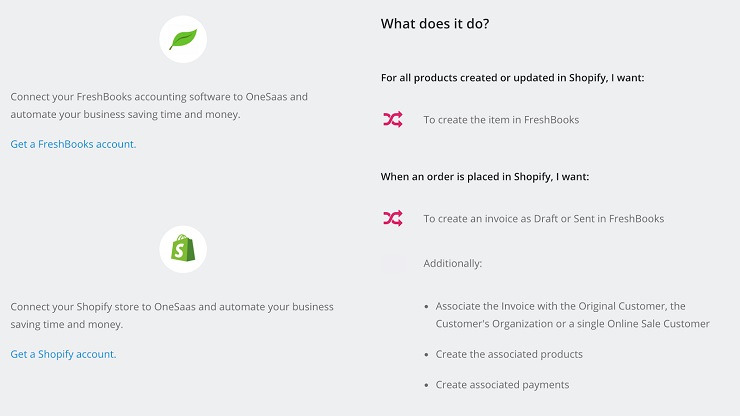
How It Works
- When a product is created or updated in Shopify, OneSaaS will automatically create the item in FreshBooks.
- When an order is placed in Shopify, OneSaaS will automatically create an invoice in FreshBooks (the corresponding client will be created and payment recorded).
Payroll/Scheduling
Taking care of your team in times of economic stress can put a lot of pressure on an entrepreneur. Make sure they're paid on time and that you're able to track the time they work with a payroll automation tool.
What You Need
- Gustoaccount (or other payroll software)
- Freshbooksaccount (or other accounting software)
How It Works
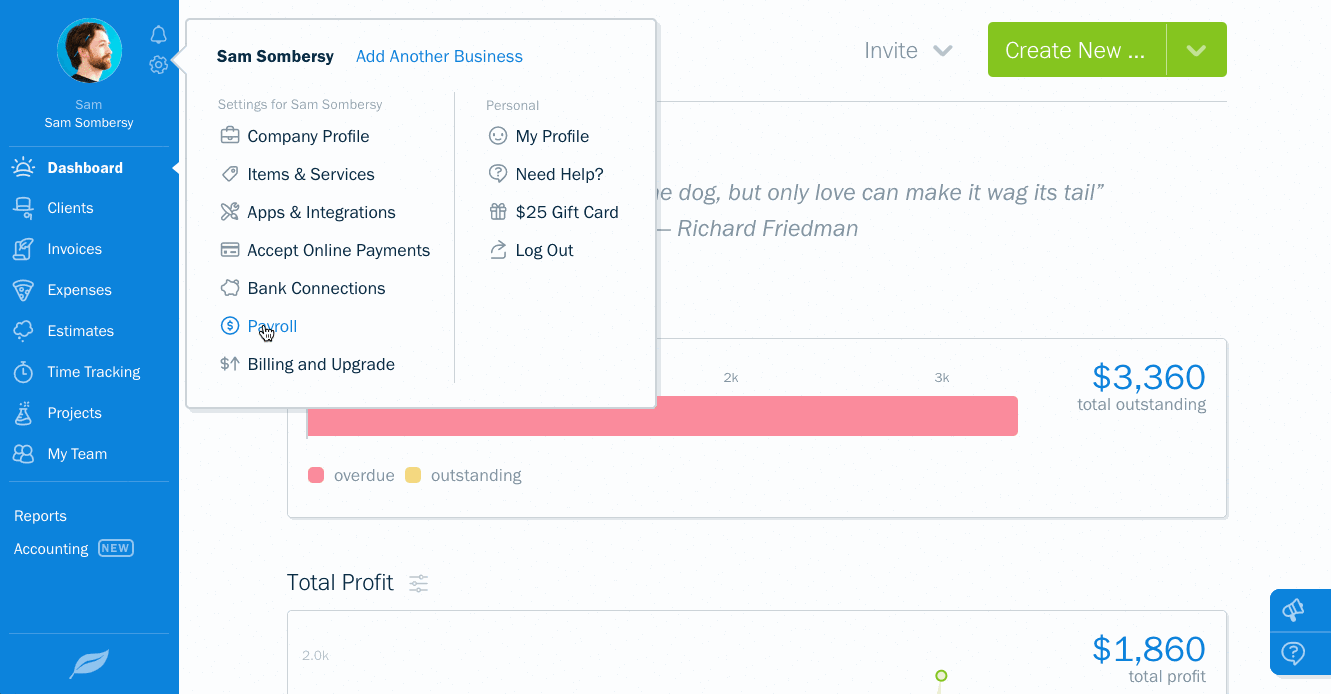
- Set up and run payroll online in minutes, from any web-enabled device. All government payroll taxes and reporting are taken care of automatically and paperlessly.
- Take it a step further by syncing your payroll software with your accounting software so there's no need to manually record payroll entries.
FREE Masterclass: Get Behind-the-Scenes Training For Scaling Your Existing Ecommerce Store To 7 Figures And Beyond
Automatically Fulfill Orders
This one may just be a life-changer if you're just getting started in the world of ecommerce. If you're selling a product that's fulfilled via drop shipper or a third party, you can automatically send orders to your manufacturer or fulfillment partners. All it takes is a toggle of a button in your ecommerce platform.
What You Need
- Ecommerce platform (we're using Shopify in this example)
How It Works
- From your Shopify admin, go to Settings > Checkout.
- Find the Order processing section
- Under the heading "After an order has been paid," select "Automatically fulfill the order's line items."
- You can also select "Notify customers of their shipment via email" if you want an email to be sent when the order is automatically fulfilled:
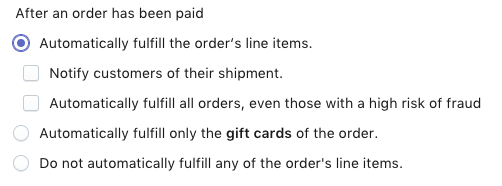
- Click Save.
There you have it. Selling stuff while you snooze.
Order Office Supplies
Never run out of printer ink or coffee filters again! You can easily have (home) office supplies shipped on autopilot. Here's how:
- HP Instant Ink account: With HP Instant Ink, your printer tells HP when it's running low on ink and they automatically send a replacement cartridge.
- Amazon Subscribe & Save: Choose from hundreds of office supplies that will be sent in repeat shipments on a monthly basis and get a nice discount. Are you a handicraft seller? This will save you money on essential arts and crafts supplies. If you have an Amazon Prime account, shipping is free.
Marketing Automation
Add New Customers to Your CRM/Email List
If your sales data isn't connected to your CRM and email marketing system, there's a huge gap in potential revenue you could easily recover by adding new customers to your email list.
Your CRM will not only keep your customer's contact information, but it will also track all interactions and transactions with your brand. Right now you might be creating contact records by hand, adding a lot of extra work to your day for no good reason.
Once that customer data is sent to your email marketing platform, it will segment your new customer into audiences based on the data from the CRM (past purchases, interactions, etc). That will set you up to attract repeat business through a variety of personalized campaigns including upselling, new product announcements, and seasonal discounts.
What You Need
- Ecommerce platform
- CRM: There are too many CRM products to list here, but you'll need one that's compatible with an ecommerce platform or a third-party connection app.
- Third-party connection app
- Recommended: Zapier. Zapier is connected with over 30 CRMs and dozens of marketing platforms, so there's a good chance you can zap customer info from your online store to your contact management and marketing tool of choice.
How It Works

- Whenever someone new buys your products, Zapier can keep your list up to date by adding the new customers to the list.
- Then, send regular emails to share new products and specials, and you'll have a group of people ready to buy and share whenever you have something new.
You can also check to see if your CRM or marketing automation tool already has an integration with your ecommerce platform. For example, here's how to connect a Shopify store to an ActiveCampaign account.
Edit Product Photos

Bad product photos are conversion killers. They scare potential customers away, they cheapen your brand, and they will undermine all your hard work to generate revenue. Even if you hire a professional photographer and have a well-lit studio for product shoots, your photo files often have to be resized to your ecommerce store's specs.
Thankfully, online photo editing services are a click away. And if you upload a constant stream of new products to your store, you can have your photos automatically optimized for your platform.
What You'll Need
- Ecommerce platform account
- Platform-compatible photo resizing app
- Recommended: Pixc Photo Resize. This app will analyze all your photos, let you know which ones need resizing and replace them all automatically.
- Photo editing service
- Recommended: Retail Ready Photos by Pixc. Pixc will take your product photos and edit them perfectly for you within 24 hours.
How It Works
- To get started, install the Pixc Shopify photo editor app to your own ecommerce store.
- Once you've got your product photos, simply select and upload your chosen photos via Dropbox or your own computer.
- Select the editing service you need (e.g. background removal), submit your photos and within 24 hours or less they'll send your photos back, ready for you to use in your store to make more sales!
Cart Abandonment – Multichannel Automation
According to Shopify, ecommerce customers who receive multiple abandoned shopping cart emails are 2.4 times more likely to complete the purchase than those who receive only one follow up email. And customers who receive multiple abandoned cart emails have a multiple transaction rate of 44% higher than those who didn't.
But why just stick to email?
Leads generally grow cold within the span of an hour, so your first communication should be triggered immediately after a cart is abandoned. Considering that SMS messages get opened within 90 seconds, compared to 90 minutes with email, texting your customer is a smart move.
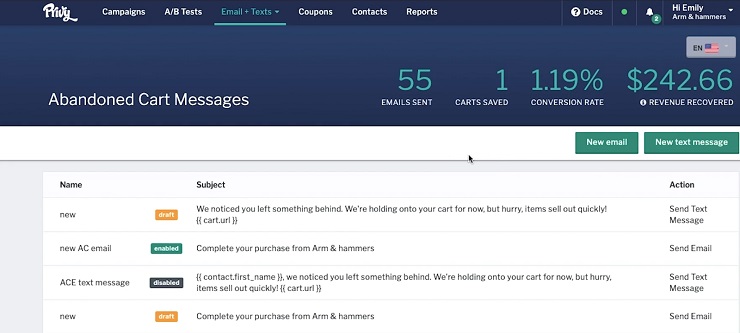
What You Need
- Ecommerce platform account (Note: although ecommerce platforms typically offer built-in cart abandonment emails that you'll need to turn on and configure, their email capabilities aren't exactly robust and don't do cross-channel marketing. But even a bare-bones cart abandonment email is better than nothing)
- Privyis a marketing suite created for ecommerce store merchants. In addition to email automation and text messaging, it also powers lead capture pop-ups with discount code and coupon offers.
Schedule Social Media Posts to Multiple Accounts
Sometimes it feels like social media marketing is just flipping from app to app to check your mentions. Sometimes you don't know the best time to post so you can attract the most attention for your products. Sometimes you need to step away from social media because all you see are conspiracy theories and sh*tposts.
That's where social media scheduling apps like Buffercome to the rescue. All you have to do is connect your various profiles to one central app, create your post, and add it to your queue. When you're setting up your Buffer account you can determine how often you want Buffer to publish posts for each social network and what times of day they should be published.
What You Need
- More than one social media account
- Social Media Scheduling App
- Recommended: Buffer
How It Works
It's as simple as that.
Share New Products on Social Media
But wait…there's more! Now you don't even have to create a social media post because you can have Shopify create one for you every time you add a new product to your store.
What You Need:
- Ecommerce platform account
- Zapier account
- Buffer account
How It Works
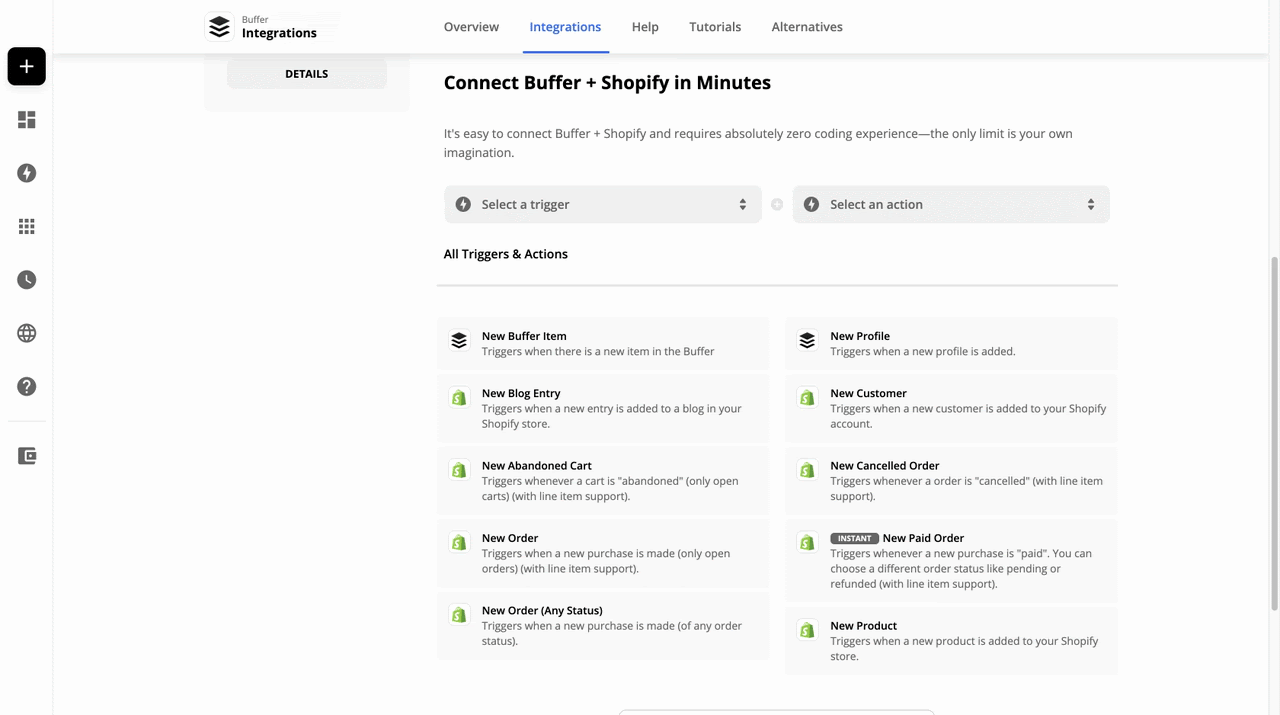
- In a matter of minutes and without a single line of code, Zapier allows you to connect Buffer and Shopify.
- Connect your Buffer and Shopify accounts in Zapier
- Select a Trigger: Shopify – New Product
- Select an Action: Send to Buffer
- Your new product post will be scheduled in your Buffer social media queue
Let's put it this way: if you can think of a marketing task or a business task, you can probably automate it. Once you get these basics up and running, no doubt you'll discover more nifty ways to power your marketing machine with tech tools.
Bonus: Automate Your PR Outreach
Good, free PR for your business brings awareness and legitimacy to your products and brand, helps your website gain better positioning in search results, and drives traffic and followers to your website and social media accounts. But reaching out to the right media contacts and coming up with a pitch that will grab their attention is soooooo time-consuming.
Fortunately, one enterprising founder named Ari Meisel figured out how to create a fully automated PR machine that will respond immediately to journalist requests. It takes absolutely no coding and only a few minutes to set up.
Check out how Ari has automated PR outreach, and how you can too:
How To Land Press Coverage While You Sleep: Automate Your PR Process in 4 Simple Steps
There you have it: a collection of automated business processes that can help you grow your online business, even while practicing social distancing.
Have any automation hacks that have saved you time and sanity in your ecommerce biz? Leave a comment and spread the love!
FREE Masterclass: Get Behind-the-Scenes Training For Scaling Your Existing Ecommerce Store To 7 Figures And Beyond
The post 11 Ecommerce Business Processes You Can Automate From Your Couch appeared first on Foundr.
]]>The post 297: Steve Blank's 3-Step Process to Help Businesses Cope With COVID-19 appeared first on Foundr.
]]>Subscribe to The Podcast on iTunes, Soundcloud, Stitcher and Spotify
Steve Blank, Serial Entrepreneur, Author, And Educator
Click here to Skip to the Podcast Transcription
Steve Blank is a legend in Silicon Valley. In addition to launching eight startups in 21 years, he's also a well-known author and educator at Stanford University, Columbia University, and the UC Berkeley Haas School of Business.
Having worked in the realm of entrepreneurship for so long, Blank has survived some of the worst recessions in U.S. history and has first-hand experience of what it's like to keep your business afloat under high-pressure circumstances—knowledge that's directly applicable to the COVID-19 global health crisis.
In this interview, Blank shares his three-step process for what every business needs to do right now to survive the pandemic. He breaks down everything from calculating your burn rate to reassessing the way you work with your team. Blank also shares his own personal experiences with the 2008 recession and dot-com bubble.
If there's any other type of content you'd like to see that would be valuable to you during this time, please don't hesitate to reach out at support@foundr.com to let us know.
Key Takeaways
- Why Blank believes today's entrepreneurs should listen to the advice of seasoned founders
- The three-step process Blank recommends to understand where your business is headed, from calculating finances to reassessing business models
- The biggest lessons Blank learned during the 2008 recession and dot-com bubble
- Why Blank believes in planning for the morning after
- The importance of high-level execution during times like today
- How to think about recalibrating in terms of retaining staff and hiring
- The importance of setting expectations—whether in your marketing or management
- Why this pandemic could be an opportunity to re-evaluate how you want to spend your life
Full Transcript of Podcast with Steve Blank
Nathan: So Steve, thank you so much for taking the time.
Steve: Thanks for having me. I wish it could be under better circumstances.
Nathan: Yeah, me too. So for those that are not familiar with yourself and your work, can you just give us a little bit of a background, like how did you get your job?
Steve: How did I get my job? Which one? I've had about three or four careers. I had my first career in the US Military during Vietnam. Most relevant for your listeners and viewers is I did eight startups in 21 years in Silicon Valley and box score was for IPOs in a variety of industries. And what was really most interesting and most valuable were two crater so deep, they left their own Iridium layer. In fact, one of them was the beginning of the learning that became customer development and then the lean startup.
And my last career has been as an educator, an adjunct professor at Stanford University, senior innovation Fellow at Columbia, and I've taught it at Berkeley as well. And so I now think, and write about, and teach the nature of innovation entrepreneurship. My classes at Stanford have become two US federal programmes. One called iCore or the Innovation Core, which our research universities use to commercialise science, and the other called Hacking for Defence, which our Department of Defence uses as the basis of innovation entrepreneurship. But besides that, I just been sitting at home eating chocolates.
Nathan: Yeah, wow. Well, look, I remember our last conversation. I'll never forget, I asked you a question and I said, "If you want to build a hundred million dollar company, is it possible working 40 hours a week," and your immediate response was no. Not possible. Not even possible. You have to be working 80 to 100 hours a week. Has that answer changed?
Steve: Well, you could be doing Bitcoin or dealing drugs. There are always boundary cases to every question. And so let's be fair, there are outliers where somebody will raise their hand and say, "No, you're wrong. This is how I did it on 10 hours a week." But I think your viewers are interested in the bell curve and usually, it takes a lot of work to make stuff happen because if you remember, a startup is creating something from nothing. It's an irrational act and it's usually an irrational act that requires passion, and violence, and aggression, and a lot of hard work and a lot of hard work of a dedicated team.
And the reason why is you're not only trying to solve a lot of unknowns, you're typically competing, if it's a good idea, with a hundred other people with the same good idea. And so it's not just your idea, it's your ability to execute and that operational execution is what matters. I still remember a good number of my startups. Finding product market fit was step one, but relentless execution was the rest of three and a half years. And so not understanding that and the amount of passion and commitment necessary, this isn't a sit-at-home-and-clip-coupons job. And as I said, you could probably have some great fascinating guests who broke that mould and I'd be interested in hearing those stories. But for the rest of you, after 40 years still haven't found any shortcuts to this.
Now, the good news, by the way, just let me add, for those of you who are listening and viewing who are founders, if you're treating this like a job, then you have to realise this is the world's shittiest job. Founding a company is not a job. Founding a company is a calling. Artists or religious people are called to a profession. And so if you're not called to be a founder of a company, if you just think this is an easy way to riches, those days, if they ever existed, are certainly over as per March 15. I mean, those days are gone.
Nathan: Terry got in touch with me. She shared with me your blog post around the survival guide to survive in these times if you are a startup founder. I also saw you post another blog post for CFOs, which I thought was interesting as well. So let's jump right in. During these times, you've got an incredible amount of experience to share because you've been through a recession before as a founder.
Steve: Yeah. Most of the time, if you're a young entrepreneur or just an entrepreneur, period, and a founder, the rule is to implicitly screw all those guys with grey hair. What the hell do they know? I'm inventing everything new and I've discovered sex and drugs and they've never heard of that stuff. This is the only time I would suggest to young entrepreneurs, you really, really, really want to pay attention to the people with grey hair who could tell you the mistakes they made, not their advice, but what did they get wrong during the last downturns that they wish they would have done.
And I got to tell you, and this showed up in the blog posts on my blog at steveblank.com, the biggest ones is the simplest is doing the math about your burn rate. That is how much are you spending every week and month and what's your runway? How much do you have left? And if you're a startup without revenue, that's the only math you need to know. There is no revenue coming in. There are other startups that actually have early customers or potential orders. We'll talk about that in a second. But for both cases, you want to calculate runway. That's your survival.
And it used to be, you thought, well, if you were cashflow negative, well, if I meet these milestones, I'll have another round. I don't know what world you're living in, but if all your assumptions are the same today as they were a month ago, you have your head stuck under a rock. Everything is now… it needs to be recalculated from first principles. Your burn rate is your burn rate, not really. So some of the things like rent, which we call fixed cost, they might not be fixed anymore. A month ago going to your landlord and saying, "I need a half price cut in my rent," they would have laughed hysterically because it would have been a line out the block for your building or office space. Those are reasonable requests to make.
So number one is you need to do an assessment of externally what's going on and internally what's going on. Stop me if none of this makes sense or you want to interrupt. But the number one thing to do in an assessment is, believe it or not, before even your burn rate and your cash left in your runway, is how long do you think this is going to last? Now, your guest is going to be as good as any expert, but is this downturn going to last for three months, six months, a year, three years? You need to have an opinion and that opinion will matter because if it's a short-term event, then you could just calculate this on a spreadsheet and not much needs to change other than slightly tightening down thing. But if you think this is going to affect your business for a year or more, then more extraordinary measures are going to be needed to be taken.
Number two is what's going on with your customers in your market. Not just the overall economy but if you were selling enterprise software, are your customers even in business? Were they in travel and hospitality or airlines or the ones that are obviously hit? I don't care what your VP of sales gave you as a forecast a week ago, none of it is valid. Or are your customers in retail or did you have a multi-sided market? No, we were getting lots of users, but we were dependent on advertisers. Well, are those advertisers still advertising or are they out of business or are they preserving cash?
So you need to do an external assessment and then you need to do an internal assessment. And I mentioned a couple of things is, what's your burn rate, what's our runway? Most importantly, do the customers we thought we have, are they still there? CEOs need to basically take a day with their exec staff and sit in a war room and say, "Okay, let's do some of the basic math. All right, VP of sales, how are our customers doing?" And if they're like any great VP of sales, they'll say, "It's okay. Everything is just… " You want to get on the phone with them and personally call the top 10 customers or potential payers or whatever and you want to hear that the check is in the mail. And if the check is not in the mail, you want to figure out is there anything you could do to accelerate early payments? Discounts, buy-ins, whatever, bundles.
Number two is your you want to check with your CFO to figure out what are additional sources of capital that you could draw down? Are there bank loans? Are there government recovery dollars being spent? Have you talked to your VCs? Are they writing checks anymore? If you're pre-seed, are people writing seed checks? If you're a seed, they still writing As? And don't take, "Oh, we're right behind you." We're right behind you is like either naïve, lying through your teeth or clueless because VCs themselves are going through a lifeboat strategy. They're also asking, "How long can this last and what are we going to do about our most valuable investments that are probably burning a tonne of cash?" How'd you like to be investors in Airbnb today who's burning a tonne of cash, thought they were going to go public and all of a sudden, their business and revenue drops to zero?
But if you're an investor, you can't afford to let that go out of business because that's a good chunk of your portfolio's value. Does that make sense? And then you want to take all that data and you want to call up your investors, either your seed investors or if you're lucky enough to have VCs and say, "Here's our assessment. What do you see in the rest of your other companies," because while you're seeing one company, hopefully, they're getting data from 10 or 15 and you want to correlate that data and all you want to do is check in and make sure that you're not off and share with them what you're seeing because then you want to go to step two, which is, okay, what's our new business model and what's our new operating plan?
And by business model, it might mean, do we need to find different customers? Do we need to find different channels? Again, clear example, if we were in brick and mortar retail, we clearly need to find a different way to get our products and services to customers. If we were selling to them, are there other targets we need to go to? Is there other parts of our business like our warehouse or supply chain or software that could be repurposed?
You know, one of my startups was doing onboarding for large companies. Well, for three quarters or seven-eighths of the world, that's not a problem right now. But it turns out for another part of the economy, like in retail for Amazon and big retail chains who are actually hiring hundreds of thousands of people in the US, that is a problem. So where do you move your business model? And while you're thinking about business model, the other thing you need to think about is cash management and that's the job of your CFO. You need to be thinking about how do we manage a new operating plant? For both new business model and how do we operate in the new world where the first assessment, step one, was done with a C-level only sitting in a room assessing what the world looks like. In step two, I would open this up to everybody in the company. All ideas are welcome.
Somebody has an , "How come we're not selling to X or how come we're not selling the Y? Or here's a way we could reduce cost or here." Everybody should have an all hands feeling that they're a part of this, but at the end, the decisions are going to be made by the CEO. But on this one, I would be getting the collective intelligence of the entire company because everyone's job is going to be dependent on figuring and this is survival in a lifeboat strategy.
And for the CFO, as I mentioned this, drawing down all kinds of resources and cash. And if you're big enough to have a head of HR, congratulations, they have a new job, and it's not job satisfaction, it's going to be handling layoffs, which is depressing. But it's going to it that is probably the most expensive part of your company and it needs to be done with compassion with as much kind of cash that you could afford to give them and, for god's sake, if you're truly running out of money, do not run it down to zero because that to me is a big X on any CEO's career. Oh, I thought it was going to turn around next week. It never does. Never run your payroll bounds to zero.
And if you happen to be in one of those companies that actually have opportunities to grow in this market, you want to understand that there's some world-class talent that's hitting the streets that you were never able to get in any other time and I would overstock that talent. Overstock because they ain't coming when… so think about it. It will be a morning after. There will be a recovery. So even if you're cutting back but you're not going out of business, I'd be thinking about what would I wish I would have kept when recovery happens? So if you're cutting, make sure you don't cut those people or projects that you might want to dial them down but how do I keep them so when the recovery does happen, I'm willing to… I'm able to grow or just out compete because I kept those resources. And if you have the ability to grow, lots of great people and lots of great resources are going to become available. How do I stock up on them in a way that no one else could grab them now? That's a huge competitive advantage.
And then the third and final step is, and this is the one if you ask most people my age, what you got wrong, it was the inability to execute quickly and take immediate action. It's clear this is not going to be better next week or next month and each country is going to deal with their economy as they see fit. But I think most people are agreeing that shelter in place and lock downs of businesses are going to continue for more than a while.
The biggest mistake I've seen people make is A, not executing quickly and B, if they had to do layoffs, not laying off enough people upfront. Oh, we'll lay off five, then we'll lay off 10, then we'll lay off 20 then we'll… that's the morale destroyer and productivity destroyer for a company because everybody is looking over their shoulder understanding that you haven't made enough cuts and wondering who's next. The alternative is to do it all upfront and people will feel miserable, like they should, but then they'll understand they have jobs and their jobs are going to be there and they just need to work hard to preserve the health of the company.
And at the same time, the last thing that I've seen companies fail at in these kinds of crises are not over communicating. You need to be sending out messages every day to your company. Every day. So when you were doing an assessment, hey, we're assessing what's going on, we'll get back you in a day. Then the next day, here was our assessment, we're now going to figure out what our new business model is and we'll have your input after three or four days. Here's our new business model, here's what we're going to be doing. And then when you're working through this every day, here are the key numbers, here are the key customers, here are the key orders, here's whatever, here's what we see going on, here's whatever. We're all in this together and we're going to come out better and stronger. But that needs to be communicated from the CEO either in writing or town halls or whatever format.
So the worst thing, just to summarise, is there's an axis, a spectrum of what a startup CEO could do. One is panic with your hair on fire, "Oh, the world is ending," and the other is, oh no, this will pass and let's not do anything. Both of those extremes, I think, are a real mistake. This is an event that's never occurred in probably the modern capitalism at all. This is not a downturn. This is an engineered downturn to save hundreds of thousands of people's lives. And we've made a conscious decision to crater our economies to do that. Therefore, it's happening overnight. It's not some gradual stock market's going down and unemployment is slowly going up. People work in one week and then entire industries are shut down the next. So that's my advice on the high level. Sorry about this soliloquy.
Nathan: It's all good. Look, I've got a tonne of notes here. So we're talking… in Australia, it's the 27th of March. You're in California, right? San Fran?
Steve: Yep.
Nathan: So it'd be the 26th of March. Do you think it's going to get worse before it gets better?
Steve: Last week in the United States, 3.3 million people applied for unemployment insurance. I think that's, I don't know, 20 times more than any week ever. If that continues for three or four weeks, there'll be more people unemployed than in the last 75 years in the United States. So I think we need to separate the worst in maybe three components. One, what's the stock market's going to do? Well, okay, that may or may not have some effect on your business. Two, is more importantly, what's the virus going to do to the health of our family, and our communities, and our country. The numbers for Italy and Spain and even the US aren't looking so good because they're still looking like one of these. And then three is, what's the state in the health of our local economy? And that is a self-inflicted thing we've done to preserve life and safety.
And so to answer your question, I think the trajectory for economies and layoffs or go in this direction that is downward as we're shutting industries now and those are going to have massive ripple effects because, let's just use an example is, other closing retail stores and restaurants in the United States and you could say, "Well, I'm not in that business. I sell to enterprises, so it doesn't matter to me." But you need to think about it, "Well, wait a minute, those people buy from my customers. They no longer have jobs. Well, how's that going to affect my customers? Oh, well, they might have to cut back because their customers aren't customers anymore." Does that make sense? And so, if you're a founder, you need to start thinking about ripple effects and when they're going to hit you. It might be oh, everything's just fine. I just got another order. Well, maybe your customer hasn't died, but their customers no longer have paychecks.
The other thing people, at least in the states, have yet to come to grips with is it's shutting down the gig economy. No one wants to stay in an Airbnb, so Airbnb is cratering. And no one wants to get in an Uber, in a closed car where 50 other people have been touching surfaces and the driver might be sick because if they're not driving, they don't have a paycheck. So all of a sudden, all these gig economy players are being hurt. So the answer is yeah, I think it's going to get worse.
Nathan: And when you talked about laying off staff, and runway, and the internal assessment, and cost to cut, and cash flow management, and burn rate, and runway, is that off the premise that you should have 18 to 24 months reserves?
Steve: Well, in a perfect world, you would. If you're an early stage startup, that's not what you have at all. Sometimes you might have it and congratulations if you do. two years is a great cushion at the current burn rate. But if it assumed the set of revenue numbers, behind that, you might not really have two years of cushion. But if you do, congratulations. Even if you have 18 months, congratulations. But if you're a normal startup, you may be running on six months, nine months or a year's worth of cash and you were making a set of assumptions about financing that happened after.
Let me emphasise that you're making some critical assumptions that fall on financing or some liquidity event might happen. I will contend that those statements are no longer true. Maybe that'll happen, but you cannot believe that your investor's math are still the same. You don't know. And so the first thing I would be doing is checking in and then checking in constantly. How are they doing? Are they writing new checks? What kind of startups? Are they changing their strategy? And in these first couple weeks, they might tell you no, nothing's changed. But you know what, if this continues, trust me that investors are going to be changing strategy. Does that answer your question?
Nathan: Yeah, it does. So take me back because you said you've done eight startups in 20 years. Any of those startups, any stories from previous recessions where you said you wish you had have cut from faster and did a bigger cut in terms of conserving cash and payroll? How long did it last and did you have to pivot? Can you share some stories there?
Steve: So the biggest one I saw was dot-com crash. I had just retired, so I got to watch this as an outsider. But I watched a company, which was Epiphany, that had 800 people, act like the downturn was just some transient problem. And the reason why in that company was pretty clear, in hindsight, is that we had hired a CEO who was a world-class executed, I mean, world-class. New process procedure and we had gone from zero to $125 million in real revenue in three years. I mean, we left a rocket ship.
Yeah, so it was a great company and he was a great guy to take it to a billion dollars. But our customers had disappeared. But it felt like he was doing… I don't know if you've ever seen the cartoon Roadrunner where the Roadrunner is running on the cliff and then the cliffs ending, but he's still running on air and doesn't understand that until he drops a tonne of bricks. Well, that's what happened to not only Epiphany but almost every other startup in that space. They kind of assumed that the world would continue in execution mode. But in fact, it required cutting the company… and I remember going through our venture capitalist at Kleiner Perkins and saying, "This thing needs to be cut back from 800 people to 80," and they kind of laughed. They said, "Oh, Steve, this is going to recover in 90 days. This is temporary phenomena."
Well, it was nuclear winter for three years. I mean, three years. And luckily, the company got a different CEO, our VP of sales, Karen Richardson, who managed to pick it up out of the rubble and at least sell it off for some reasonable price that wasn't embarrassing. But the lack of understanding that just because the last… for example, today, we've been in a bubble for the last decade, right? Everything's gone now. Unicorns and money and like if you had an idea, it was fundable. It's hard to imagine a world where that's not true. And the point is it's time to imagine that. Literally, in the US, there are millions of people this week without jobs. Millions. I'm sure that same effect is going to happen at scale in Australia. And so you need to imagine what that world looks like.
So to answer your question, the biggest one was just thinking that oh, this is a temporary blip and because we had been in this rocket ship, not understanding that the classic what come goes up sometimes needs to go down. But the other thing to remember is there will be a morning after. I mean, there will be recovery. It's not like everything's dead forever, but how you handle it will prescribe how you come out of it.
Nathan: So when you talk about execution and executing quickly, that's something that is, I think, of value to a lot of people, especially if they are having to pivot their business model or change who their customers are or work on a particular project that might have legs in this particular market because everything has changed. What advice would you share to rally your team to be able to execute at a really high level? Because everyone's remote now. Right now, everyone likely would be working remote and that's a new playing field in of itself for leaders.
Steve: Yeah. I think I'll go back to the thing I said earlier about communicate. So I think every morning or sometime during the day, maybe sometime during the day because people will now get up at 10 different times, but there ought to be a shared video or live town hall from the CEO. I would not make it very long, but I would make it a daily 20-minute hey, here's what we're doing. Here are the results. Here's whatever. And make sure there are some curated questions and by curated you don't want this to get out of control. So you want people to be able to send in questions, but you don't want the morale to be destroyed by a couple people who sometimes will do that if the town hall is large enough. But you want to constantly communicate and have people feel that that you're working hard.
And by the way, the other thing I didn't mention, in a startup, it's the C-level staff who's taking a regular salary, that needs to end. It's a big idea. They need to communicate that they're taking a haircut on their pay. And if you're not willing to do that, then you might as well quit and go home because you're really not committed to the survival of your company. And it shouldn't be 10%, it doesn't have to be 90%, but it should be something that's meaningful that you can announce to your staff because there are other people who aren't going to have jobs. And so the first thing before I will be laying off people is I'd be cutting the salaries of everybody by some percent to see if you could keep the people who could least afford it. If you're laying off janitorial staff and you're keeping 100% salaries for every engineer, you really ought to think about the social impact that those are the last people who are going to get work again.
And you might want to think about how do you support them versus how do you support someone who says, "Well, I deserve my current salary and you can't cut it." Those are the probably the people I would let go now because there will have to be lots of sacrifices by everybody and there will be some people who won't get their head around that. To be honest, I'd be figuring out how to jettison those people just to make a point is that we're all in here to be in here at the end. If we're all not going to make some sacrifices, then we're not going to make it together and you want to try to protect the most vulnerable of your company. So while the first instinct might be well, let's get rid of our janitorial services and we don't need X or Y, I'd be trying to figure out how to support some of those people. Does that make sense?
Nathan: Yeah. What about your A-players though?
Steve: So you got to understand, there are going to be a lot of A-players on the street. A lot. And so now's also the time to think about recalibrating your staff. We were in an environment where hiring was incredibly hard because there were a limited number of A and A-plus players and they were all being chased by not only the big guys, but other startups. That's no longer the market. I think a lot of people are going to get their expectations reset to what this new normal is and I think smart CEOs will figure out about how to reset that as well.
If people go, "Well, I'm special, you can't do that," the first time you jettison one of those, I think everybody will get the message that says, "This, ain't last week." Does that make sense? I mean, I would be truly thinking about how to send the we're in it together messages, we're going to do anything it takes to survive and keep everybody employed. But if we can't, we're going to protect the vulnerable and if you're not with me or if you think you know you deserve some special treatment, welcome to the new job market because we're going to change a bit here.
And you sometimes hear the phrase a wartime versus peacetime CEO. This is now wartime. Unfortunately, that gets the analogy kind of wrong because it's a little insulting to people who have served. In war, if you screw up, it's not that your salary gets cut or you get laid off. You measure that by killed in actions. But what they do do is they train for the fight all the time. That is they've been practising this their entire careers. You as a CEO are, for the first time, dropped into a wartime situation where you've had no practise, and you've run no simulations, and you haven't done battlefield drills before. But you need to act like that very quickly.
And so that same behaviour that worked in peacetime is oh, we have to have buy-in from everybody, and there has to be consensus, and there has to be open meetings, those days are over for now. And if you're not willing to act that way and communicate why, it's not that you want to be dick, but somebody has to say this is not normal times. We're going to treat everybody with respect, but we're going to operate with minimum latency and decision-making and we're all going to figure out whether we could get through at the other end and if there are people who are uncomfortable operating that way, this is now not the time to keep them in the company.
And by the way, this is one guy's opinion but I have seen companies try to juggle prima donnas when the plane's on fire. Those are the first people I'd push out the door. It's like either sit down and help me fly the plane or get out and take a parachute. Have a good time. But we're going to get this thing on the ground and we're all going to do it together or feel free to leave. And I don't mean to overemphasise that, but the behaviour of the CEO, the founders, and the employees all need to treat this seriously. It's not just the CEO's problem. It's everybody's problem. That's why I said brainstorming a new business model and seeing new opportunities and new opportunities to preserve cash is everybody's job.
Nathan: Yeah, I really like that. I'm curious around expectations of team during a time like this. Is it unfair to expect your team to work more than 40 hours a week?
Steve: Are you joking? I don't know any startup where the team is working 40 hours a week. Is Australia something different that I didn't know about? Is that a …? I thought you were going to say expect working more than 80 hours a week. Yes, that's unrealistic. Seriously, are you starting to get out unionised in Australia? Did I miss something?
Nathan: No, no, we got an office in New York. Since we spoke, we've been getting some good growth, Steve. So we've got a remote team in our office in New York. I'm just trying to be thinking and mindful of my listeners. Of course, you know what I mean. You know where I'm going with this.
Steve: Yes. Listen, I would expect people to work hard or harder than they were during the layoffs, but I would expect CEOs to be incredibly cognizant that they're doing it. Juggling a couple of kids, a wife who's going crazy, trying to keep bandwidth going and need to take walks and whatever. So yeah, I expect the work to be staggered in a way that gee, you all can't be there 9 AM because the kids have online lessons or you got one computer being shared by six people in the household and whatever. Sure, you need to accommodate that. But there still needs to be some output here that is commensurate with keeping the company afloat.
And so yes, you need to be sensitive to that, but the expectations also need to be how do you want to contribute here and how can you? And if you can't, then that's a set of decisions that need to be made. But I think the expectations for all employees is you're still at work though there are extenuating circumstances about how work itself might be arranged. I guess the general message is this is not business at all cost now. It's obviously you need to preserve your family, your health, your community's health, your country's health, et cetera.
But at the same time, if you're going to get paid, a company has to continue to exist and you have to decide as an employee whether you want to participate in that or not. And now more than ever, your full participation as much as you can as critical. And as a CEO, you need to have expectations that everybody's on boar, and we could put the little asterisk in any way they can. I would be incredibly loose about how they do it or did they get on the computer when the kids and family are asleep? Who cares if that's not critical? But they all need to be on board? Did I answer your question?
Nathan: Yeah, yeah, you did. So we talked a little bit about running remote. You talked about having like a daily stand up and, as a CEO and leader, really communicating where you're at almost every day if you can. Anything else there on running remote teams? Do you have any experiences you can share, just around the execute piece? Because I agree it is so important now whether you're in a business that needs to pivot and rework your business model or even you're in a business that perhaps has some opportunity. Execution is everything in this market.
Steve: Yeah. Just by the way to follow on and bridge your last question to this one, the other thing I've mentioned besides communication, I'd offer remote therapy to your company as well. That's a cheap benefit because there's a lot of anxiety for everybody, people who are dealing with children, you're worried about your parents, older family members and friends. And work life balance has gone out the window and things that you used to do to deal with stress like going to the gym or having social events, well, those have gone out of the window as well. And people who had drinking problems or drug problems, all the AA and NA meetings have been cancelled. So those who are in recovery now don't have a normal support system.
And so mental health is really crucial and I want to double down on what I said before is we're all in it for the keeping our jobs in the company, but we're not going to do this if we all melt down. And so CEOs ought to think that remote therapy and keeping your employees healthy and sane is equally important. And let me just add to that is for employees who have kids, getting a corporate account on some kind of virtual school, if they don't already have one, and making sure that you offer resources for their kids and their family, I would be doing that at the same time. And I'm sorry, did I answer your question or did I go back to the last one?
Nathan: You did, but still really love to know around any experience running remote teams when execution is so important.
Steve: No, I have not and I wish I did, but I don't have any personal experience doing it.
Nathan: Okay, that's cool. Thank you. Thank you for being honest, Steve. What about marketing? Talk to me around your marketing and your messaging. How should you change it? Should it change at all? Should you cut marketing? Some people say that you should keep it going. Now's not the time to stop. I read in your blog post that you should.
Steve: Well, the people who are saying that you shouldn't stop are the and your PR agencies. Of course, they should stop, but they should stop doing what they were doing a month ago. And so this goes back to assessment. Not stop all advertising. I mean, think about advertising, right? Number one job is to create end user demand to drive it into your channel. So, first of all, we got to make sure those end users are still around. So it's part of the assessment. What are they watching? Are they home? Are they now watching Netflix? What are the media I could reach them on? What blogs are they reading or what websites or what et cetera?
Two is do they even care about my product or service right now? And so, while you're advertising folks and your PR folks, when they tell you full speed ahead, please send us more checks, it's a lot more subtle than that of like, wait a minute, is this still relevant here? And the answer is for a good number of industries, it might be but maybe the messages are completely different. Maybe the messages are hey, we're on hiatus, but we're building ventilators for hospitals, if I was a large manufacturing company or, hey, we're still selling product. We don't want to sell you this, but we're giving out free masks or gee, we're supporting this food drive for laid off employees or whatever.
I mean, think about what message you want to communicate now, which might help you to build your brand or help your community or whatever. But the odds of your messaging being identical from a month ago, I find that really kind of glib. It might be some cases, but again, if you were Amazon or whatever, it might be you don't need any advertising at all. You're just trying to keep up the demand. Or if you're now, I don't know how it was in Australia, but telemedicine was really limited by our national laws. Those laws have all disappeared, where you now could do telemedicine in a way you never could a month ago. Gee, I would be doing advertising to tell people about new services that were available a month ago that they thought weren't possible. Does that make sense?
Nathan: Yeah, it does. When you talk about execution, because I really think this is an important piece, even selfishly for myself and our team and everything we're doing at Foundr, what are your thoughts… you said that at Epiphany, you had a really strong CEO that was really strong on execution, systems, processes. Do you think at this point in time, people should be focused on processes, and systems, and all that side of the business?
Steve: First, you have to have a model that you could operate a process against. I mean, you think about it, this is now the time where your crazy people actually need to be brought back into the company. And what I mean by that is on day one, in any startup, it was the founders who were trying to find product market fit and trying to testing X and testing Y and doing all kinds of crazy stuff until you found product market fit and you said, "Okay, enough of the crazy stuff. Now, we found how to do that, let's just build KPIs and OKRs, and people have jobs. It's repeatable. We could write job specs, et cetera." for a good chunk of startups right now, you're back to the crazy times because you need to find a new business model.
So the new business model needs to come first and then you build new processes. So if you think you have, in this new normal, a working set of product market fit that could scale and generate revenue and generate business, then yes, build the processes on top of that. But if those have changed, having old processes and old job specs are actually the things that are going to sink your company when people go, "Well, I'm just doing my job," and you go, "Your job is no longer relevant." Well, it says so right here in my job spec. Well here, give me your job spec. Rip, rip, rip. Good. Now let's find a new job for you. Does that make sense?
And by the way, here's the bad news, is that people who you hire for execution have a real hard time with uncertainty and you are in an uncertain time. Most people come to work for execution. Tell me what to do. Oh, there's my spec. I'll do that. I'll do the best job I can and I'll give you my 40 hours or whatever it is. But now you're going to tell them, "No, no, no standby. We're trying to figure out what the new job is." And that's going to discomfort a lot of them, but that is what's required now. But as long as you communicate, it's okay to be nervous. It's okay to feel a little… we are going to figure this out, but we can't be doing the same thing that we were doing last week, and so the jobs are going to change. Does that help?
Nathan: Yeah, it does, hundred percent. Well, look, we have to work towards wrapping up because we've been speaking for almost an hour, mate. I could talk to you all day about this stuff. It's funny how time flies and yeah, look, it's been an incredible conversation, a lot of gold shared and a lot of practical advice that people can take away in this current time and economic climate. Was there anything that I've missed Steve, anything that you would have liked me to ask you otherwise that you want to share with listeners and viewers?
Steve: Well, especially for your founders is when economies looked down, entrepreneurs look up. There's going to morning after here. It's going to recover. But it's going to be incumbent to you as the leaders to help figure that out. The other thing I'll suggest to every one of your listeners and viewers is that it's crisis like this that help people reevaluate how do you really want to spend your life. Is this what you want to do with the rest of your life? In the United States after 911, the terrorist attack on the World Trade Centre, a lot of people decided that giving back to the government, to their country, et cetera was actually a lot more important than building the next fart app or something else, and decided to make massive career changes.
I think as people are sitting at home and thinking about as they're trying to figure out what their job is remotely and founders are trying to figure out how to keep alive, there might be some bigger thoughts that are worth having about, you know, there's only so many days and hours left in the rest of your life. Is this how you want to spend it? And I think this is a good time to evaluate that because you never get a memo that says that. So we will get to the other side and I'm looking forward to speaking to you and your viewers in much more happier times.
Nathan: Yeah. No, that's really great advice. Thank you so much. Well, look, Steve, last question is where's the best place people can find out more about yourself and your work?
Steve: So I have a website called steveblank.com. Steve B-L-A-N-K.com. There's more articles and enticement good wherever wanted and it's my experience both as an entrepreneur and as an educator and just some fun stories as well.
Nathan: Amazing. Well, look, thank you so much for taking the time to speak with me and share all your experiences. I think this is going to really help people, so I really appreciate it and yeah, hope you stay safe in these crazy times, mate, and your family's okay.
Steve: All right. Stay safe, stay healthy.
Key Resources From Our Interview With Steve Blank
- Visit Blank's website
Subscribe to The Podcast on iTunes, Soundcloud, Stitcher and Spotify
The post 297: Steve Blank's 3-Step Process to Help Businesses Cope With COVID-19 appeared first on Foundr.
]]>The post 294: Responding to COVID-19: What Entrepreneurs Should Be Doing Right Now appeared first on Foundr.
]]>Subscribe to The Podcast on iTunes, Soundcloud, Stitcher and Spotify
Steve McLeod, Business Coach and Founder, Courage For Profit
Click here to Skip to the Podcast Transcription
We're all feeling a lot of stress and anxiety as the COVID-19 global health crisis unfolds. And if you're running a business, you're likely struggling with some additional, unique layers of concern. While we hope your business isn't being too heavily impacted, we want to let you know that we're always here for you and want to help in any way we can.
We've been mulling over how we could be the most useful to the Foundr community and decided it would be incredibly valuable to sit down and talk to Steve McLeod. McLeod is uniquely equipped to share advice about the current circumstances for many reasons: he's a business coach that has guided thousands of organizations through challenging situations (including Foundr); he founded his own company called Fire And Safety, which is now a $20 million business; and he's a former firefighter who dealt with many disasters during his eight-year tenure.
In this interview, we touch on many topics—from managing cash flow reserves to communicating with customers to adjusting your mindset—that we hope you'll find helpful as we navigate this unfamiliar territory together. Whether you're getting ready to launch a new business or are already running a seven-figure company, the contents of this interview should be applicable for entrepreneurs at every stage.
If there's any other type content you'd like to see that would be valuable to you during this time, please don't hesitate to reach out at support@foundr.com to let us know.

Key Takeaways
- How McLeod's background as a firefighter, founder, and mentor is allowing him to guide businesses today through the COVID-19 pandemic
- The importance of understanding where your business is today: positioned for growth or in survival mode?
- Why you need to be transparent with your teams, regardless of your current situation
- McLeod's advice: cut costs but don't stop your sales and marketing efforts
- Why you need to focus on your existing customers and how you can help them
- How to keep your mindset clear during this stressful time
- Why connection, discipline, and alignment are more critical than ever before
- An overview of cash flow reserves, and how much you should have in the bank now
- The reason why McLeod doesn't believe it's the right time for work-life balance
- How to be a good leader in unprecedented circumstances
- Why leaders need to be asking themselves the tough questions today more than ever
- McLeod's advice for businesses that are thinking about launching soon
Full Transcript of Podcast with Steve McLeod
Nathan: Yeah. So first question I ask, I've interviewed you before a while ago. How did you get your job? Just for context, for people.
Steve: Yeah. No worries.
Nathan: Why are you qualified to kind of share what people should be thinking about right now during these times?
Steve: So I'm not the typical business consultant. So I started off, I was a firefighter. So I spent eight and a half years full-time, dealing with life and death situations, lots of different disasters and challenges that happened across Melbourne and across Sydney. I then started a company called Fire and Safety Australia, well over 150 people now, building to a national successful business, revenue in the tens of millions of dollars per year. I then started working and mentoring people, because a lot of people wanted to grow their business.
So I started training for the Entrepreneurs' Organisation, where you and I first met.
Nathan: Yeah.
Steve: I would have trained nearly 1000 business owners, from 250,000 revenue to 15 million dollars a year. Fell in love with it, retired out of my CEO role day-to-day and my Foundr role, and now I work with about 20 small and medium businesses. So I've probably worked with 1,000 businesses in the last five years. We've done a pretty good job of it including with Foundr, about helping a lot of them to be able to grow. And I've really been spending the last two weeks since this sort of crisis has happened, working through my home business and making sure that we've got the right measures in place and working with about businesses day and night, from 6:00 in the morning to… you and I were text messaging in at 1:30 AM or something last night.
Nathan: Yeah.
Steve: So hopefully, I can help your audience today with some key things to think about with this current crisis, knowing that I've helped a lot of businesses in the last couple of weeks and for many years, with my background.
Nathan: So yeah, with your background and everything that we're thinking about and the stuff that you think that is really, really important, I had to get your comment and share because I think you can provide a lot of value to people. So first of all, if anybody has a business, no matter where their revenue is at, let's just say they're working on it full time, they generate sales hopefully every day, sub let's just say 100K, all the way up to tens of millions, hundreds of millions a year. What should be… let's say sub 100K to a couple of million a year, what should people be thinking about, whether they have a team or not, or they're solopreneur, what do people need to be doing right now?
Steve: So to give this some context, I'm going to approach this the same way a chair of a couple of boards with business well over 100 million dollars, with the same way if a business is at 100,000 dollars, right?
Nathan: Yeah.
Steve: Which is, I think business owners, now more than ever, need to understand first of all, where they're at. Right now, is this an opportunity for them to grow, or they sort of getting beaten around their head a little bit at the moment and going backwards? So the first thing is to understand, well where am I up to, and is it opportunities then we need to look at, or is it actually protection we need to make sure, and survival?
So then I'd to understand more the different scenarios. So we can't predict the future. It's more an uncertain time than ever, probably in the history of the world, but what are the different scenarios and impacts, and what does that look like? So if our sales went back 10%, or 30%, or 50%, what does that mean for us? Does that mean we need to look at our cost more harshly and understand where do we spend money, or does it mean that the opportunity is for us to grow and to look at where we're going to invest money to grow?
The next thing is I think they're going to be transparent with their team. If I've got a team, I think you've got to be open and say, "This is where the business is up to. We're either fighting and we're fighting to stay alive and survive, or this is an opportunity for us to be able to grow the business." But I think the worst thing they can do is put their head in the sand. I found a lot of business owners in the last couple of weeks that I've worked with, they're going through this huge period of uncertainty, and they're really confused around what to do.
And I think if you're a leader, whether you're a leader of oneness with yourself, or a leader of hundreds of people, you've got to have, well what's the certainty? What are the decisions that we can control? We can't control what the government does, we can't control anything about the virus, but what we can control is our plans, how aggressive we are with our plans internally in the business and what decisions we make. So I'm really trying to get businesses to almost bin their next months of plans.
Whatever we thought 2020 was going to be is not going to be. It's going to be different. It's going to be better, or it's maybe going to be worse. But what are the key things we need to do over the next 90 days? What are the key sort of three things for us to focus on? Whether it's we need to drastically reduce costs because our revenue has fallen off a cliff, now let's go in and look at it hard to make sure we got survival. Or maybe there's opportunities for us to be able to grow. There's opportunity for us to be able to grow. How do we invest better in sales and marketing, delivering on our promises, helping a lot of people?
But I think the most important thing is they've just got to get straight with where are they today, and then have a plan around, how can we create certainty? Certainty for ourselves for our team, and what are those key things we need to do to bring the business back?
Nathan: So one thing that I found interesting when this all started happening I didn't… you said I was one of the last clients of yours to call you and more because I was kind of… I wasn't really paying that much attention, we're doing okay, and one thing you said was obviously, cut costs, right? Work on cost-cutting, which we were doing bits and pieces there, but then you also said that, "Don't stop sales and marketing."
Steve: Yeah.
Nathan: Why?
Steve: So good points, right? So I think we've got to be spending money in the right reasons. So when I say cut costs, you probably have to have a view, which is, "Do we have an opportunity to grow during this, or is our focus on survival?" If our focus is on survival, then we have to look more at our cost going, what's nice to have, versus, what do we have to have? Have to have our masks to operate the business? Don't go and cut those things. But if we're in a business and survival, we've got to make sure that we get aggressive with cost early.
Most business owners that I've worked with in the last few weeks, and with different challenges around turnarounds in the past, they're way too slow. So right now, we need to model and say, "If we're doing 20% less revenue, 30%, 50%, what decisions do we have to make? How are we going to get our costs under control? But the reason that I talk about investing in sales and marketing is because most businesses going through this, that have a negative revenue impact, that's how they're going to get back.
Sales is king. A lot of people don't like sales and say sales is a dirty word, but for most businesses going through this, sales is what's going to get them through. Costs might be able to lean it out a little bit more and maybe give us more opportunity, but we've got to be out there. So from what I've seen with businesses lately, it's cheaper to get in front of customers now online than what it was a month ago. Every industry might be different but that's what I've found recently.
So how do we get in front of our customers? I think the other thing is to actually think about, where is my focus going? Right now, unless you've got a business which has in-demand products and services due to the current coronavirus crisis, it's going to be hard to get in front of cold traffic and to get more people in. Most people forget about their existing customers. If I look at all the businesses that I've worked with, all of them that have been able to really dig down deep on their existing customers have always been able to do well.
So right now is the time for us to look at our existing customers and say, what industry segments, if we're in a business-to-business sales environments, or without consumers, what are the key things that they need from us right now? How can we help them, and what products or services can we do to try and get them through it?
So I think generally, unless you've got an in-demand product or service with the current environment, harder with new customers, but we've got to go all in on existing customers. Let's not give our existing customers any reason to not be happy with us. Let's have 10 out of 10 service. Let's support them, let's help them, let's even actually just reach out to them and say, "How are you going?" And really use the personal connection to try and build a relationship with them, because maybe our customers are doing it tough now as well.
Nathan: Yeah. And what are your thoughts around changing positioning messaging for this point in time? Because I've spoken to a few founders already and we're going to do a whole series on this stuff. We're speaking to founders of all varied levels of businesses. What are they doing and just… because this is what everyone is talking about, and we need to provide content to help people.
I've noticed quite a few are changing their messaging and finding that that's actually landing. So sales might have gone down, but now they've changed their messaging and things are starting to come back online.
Steve: Good point. So I think what's been amazing to actually see in the last few weeks, and I would have spoken to at least 30 different business owners, from 200,000 up to 150 million dollars, and this has caused people to really innovate. Those businesses that are really suffering, you've got to innovate harder than ever before. You've got to think, "What are the problems my customers are trying to solve?" What are those… your term is painkiller products. What are the things I can use to help them to really get through this?
Now my only caution on that would be, we need to think about our brand and any business that tries to use this as a targeting way, and which could be seen as a way to profit from this. Can be seen really poorly. So previously, natural disasters in Australia, I've seen people do that, and it's really brand damaging. So I want to make sure that our messaging is: how can we help people? So maybe there's free content. Maybe there's product demonstrations or trials, or maybe there's something we can do to help people. Let's not go and take advantage of people. Let's make sure we help people with the areas they really need.
So I think making sure our message is clearer than ever before, particularly with the existing customers to say, "This is how we can help you. This is how the current environment has changed our business, therefore this is how I'm going to pivot to really get you through it.
Nathan: Yeah. No, I love that because that kind of brings me to my next point is if you your messaging right now isn't landing, which that might happen to people. They might need to change it up to show why their product or service is needed and is going to help that person or business. I think what's going through some people's heads is being scared just to go out there and sell.
Steve: Yeah.
Nathan: But then also not only that, but really kind of thinking… because people are getting angry. Because people remember who was there for them during this time, and who actually did care, versus… but then you have to worry about getting your own business and house in order. It's very tricky.
Steve: Yeah. Good point. Look, I think that now more than ever, it's important, and this during any times of crisis is what's helped me in my history as well. But going back to our purpose, which is why are we actually in business? Because events like this actually shape the reason why a lot of us are in business. And a lot of us are in business to help people. And I love working with Foundr because you're there to help people. All of my businesses that I operate are actually there to help people, and this is a great opportunity to say, "Well, how we're going to help people with what our product or service is?"
So there's nothing wrong with selling. Every business and every person sells something. As long as we're selling it in the right way, which is trying to help people, and by delivering on our promises and giving people value for money, we need to be more out there and aggressive with sales than ever. Because if we just decide to sit on our hands and wait for things to change, we could be too late. And unfortunately I think there's going to be a lot of businesses that aren't going to make it through this, because they're not going to have the hustle, they're not going to have the sales because they're not going to have the activity.
So now is more important than ever. Be in contact, whether it's phone, whether it's email, whether it's video calls, being in front of our customers now is so critical because they'll remember us and they'll be there with us. But if we forget about them now, they're going to go somewhere else. So we need to make sure that we're in front of them and helping them with what their challenges are, and talking to them. Some of the business that I've worked with in the last week have done. So I've actually reached out and talked to 10 customers to understand what's going on? How does this affect your industry? Does this affect your business? How can I help you?
Now a lot of businesses are probably learning now, they should have been doing this months ago, which is actually out talking with people, or emailing people, or on the phone. But now they have to do it. If we don't understand our customers' mindset, if we don't understand what their pain points are and how to help them, we could go out of business.
Nathan: Yeah. So talk to me around mindset, because I know it's something you're really big, on myself too, and I think there's a really big trap around your own bias. Like I was sharing with you just before offline, on a Saturday, I don't really pay much attention to the media and the news, and on the Saturday I went deep. And it absolutely just fucked with my head, and I went into panic mode, and I was like, "Oh my God," and I just realised what it was doing to my mind, so I think you can be really optimistic and have your head in the sand, not paying attention, and I like you said, thinking everything is going to be okay, or you can be in panic mode and I think it's got to be somewhere in between around controlling the controllables, but what should people be thinking about when it comes to mindset and getting their head right? Because it's all about those decisions you make.
Steve: So look, I think it's more important than ever to actually have some real certainty within the business, within the teams we lead. So there are huge pressures for a lot of us at the moment, trying to keep businesses alive and survive, those who are going through tough times, or actually try to keep up with demand for those that are actually going through some better times. What I found a lot of business owners and they're in a state of fear at the moment. And the state of fear is completely understandable. And if we had no fear whatsoever, there's probably something wrong with us.
But the best thing we can do for ourselves and our business is get some certainty. It's uncertain what's going to happen in the world, but within your four walls of your business, within your community, let's get some certainty, which to me is, what does success look like over the next 30 days? What are the key decisions we need to make? Maybe we need to go and do some more sales activity. Maybe we need to pivot our product. One of my businesses relies heavily on face-to-face training.
Even a lot of my consulting is face-to-face, so it's about doing more on video, or doing more over the phone and doing it a different way. So we're going to think about our product and pivoting it, and we've got to think about how do we actually keep our team knowing that we're going to get through this? So I found a lot of business owners really struggle. The businesses that are suffering at the moment, should I be honest with my team? Do I sort of pull the curtain shut and just close my door? And my advice is not that at all. I think we've got to be straight up and honest and say, "You what, team? We haven't faced something like this since our generation. 80 years ago, World War II was probably the last time that the world was in a state it is now."
So it's even more important than ever to be honest with our team, but to say, "This is the way forward. This is how you can help us. This is how we're going to get back." And a lot of businesses that I've been in, whether it's in person, or even virtual last week, I'm seeing founders crush it out with their teams, more discipline than ever before, more work ethic than ever before, because actually right now, they know that failure is not an option.
So I think by actually going and saying, "How are we're going to get this right? What levers do I need to push or pull? Keeping it to two or three, that's going to get things going." Also for me, I'm looking at the news once a day. If you're just on your phone back and forth all the time, listening to all the bad news in the world, it will affect your state. So try and get rid of that shit. Leave it to the end of the day. I was just sharing with you offline. I look at it once a day, 6:00, 7:00 PM, once I'm done, and before I start working for the night shift, and just try and stay away from that stuff and worry about what you can control. Try and not worry about what you can't control, but go all in. 10 out of 10 work ethic on what you can control.
I said this to a group of founders yesterday: right now, if you're not working 15+ hours a day, if you're in an area that has opportunity and the business has opportunity, and you're not working that time to really seize the opportunity, or if you're in a business that's suffering that could die, you got to be going all in. Relentless discipline day after day, every day, you got to get in with you and your team and that'll get you through it. Putting your head in the sand is going to get you nowhere.
Nathan: My next question is around kind of a lot of people working from home, or they're sending their teams home and everyone's working remotely now like the Foundr team. Thankfully, Charlie is in and is able to shoot right now, but yeah, look, he's made that sacrifice and I'm truly grateful for that so we can put out this content for the community, but a lot of people sent their team home, working remotely. What should people be doing there, especially around trust, that might be a new thing for people, especially around accountability, especially around leadership and actually getting things done? What-
Steve: So, I think this is a great example, where you have to have more discipline and alignment than you had in the past. Because you may not, if you've decided to have some people working at home, have the opportunity to do a stand-up meeting. But there's no reason we can't be doing that virtually, so connection is more important. We don't want to leave people who are on their own, away from their leaders and away from their team. A lot of people do their best work and get energy from connection to their team. So I think more important than ever, I would be looking at some sort of daily contact.
Nathan: Yep.
Steve: So if you're running a small team, say less than eight people, some sort of daily contact. It might be a quick online meeting for 15 minutes, or it might be a phone call if your staff a remote. But something to keep everyone there every day. The daily huddle type of format. In terms of alignment and accountability, ideally each person has an understanding about, well, what do they need to do to help the business move forward?
Nathan: Yeah.
Steve: So more than ever, what are those key three or four things that each person can do to really move the business forward during this tough time? So I love the idea of having a dashboard. What are those key KPIs, key tasks everyone dialling in a video meeting and doing that once per week? I talked to you at Foundr and a lot of other businesses about this, but I love this concept of relentless discipline. Relentless discipline is what moves businesses forward and gets them through difficult times. So get your team together, 30 minutes, 60 minutes once a week, talk about those key priorities on how to move the business forward, and that's what's going to help the alignment.
I do think you have to have more trust that what people might have had before, but let's try and not micromanage people. Let's go and say, "Here are our goals over the next week. If you can get this done, this will really help us either improve on our situation, or seize the opportunities available for us today. But have a regular discipline. A regular rhythm. There's daily or weekly, but don't have it less than weekly.
Nathan: Yeah. So like right now, we're just doing 15-minute daily huddle: what have you worked on between now and last meeting? What are you working on between now and next? And do you have any blockers?
Steve: Yeah, great. So just short and sharp, right?
Nathan: Yeah.
Steve: Short and sharp, but keeping it regular, then you're getting some contact, and the idea is that just as a team, you go, "What are the critical things we need to solve?" And then you as the CEO of the business, you can catch up with people individually afterwards.
Nathan: Yeah.
Steve: I also think that there is going to be a real trap with people working remotely, and they're just going to be emailing everyone every day. And so I think that can really lose personal connection. And if I look at a lot of the challenges where I've had business partners that have gone into conflict, or senior teams that are not doing well, the reason is because they actually stopped talking to each other.
So if there's one thing I can highlight from that, stay away from the email. Email is a great follow-up tool, it's a pretty shitty communication tool.
Nathan: Yeah.
Steve: But actually, speak to people on the phone, speak to people via video meeting, you're going to be able to accomplish it so much better. Stay away from email.
Nathan: Yeah, so one thing I think I'm going to do, because yeah, in some ways we were kind of trained for this at Foundr, because we had to work from home Thursdays, and… yeah, well that's a whole another story, but anyways, we do the 15 minutes without thinking, "I'm feeling a little bit kind of that disconnection myself as well," and I was thinking after the 15-minute daily standup, it's usually about 11:55, we can just come in to lunch, and if anyone wants to stay on they can just hang out. So I agree that they're going to kind of tweak that piece there, because I think that's important.
Steve: One of the other things that I'm pretty sure you've got at Foundr, is the virtual coffee, or the virtual catch-up. So maybe you could look at… because I know how many people get energy from their teams.
Nathan: Yeah.
Steve: And if you go and put them on their own in front of a computer, they might not be doing their best work. So maybe think about, is there a rhythm or a structure? So to me, rather, than you going and mandating and saying, "This is what you'll do?" Next time you're on a huddle with your team, ask them and say, "You know what, team? I'm not sure that we're going to be able to wok at our best, because we're so used to joking around and having fun together. What could we do? What's something we can do today? What's something we can do this week to get that communication flying, and actually to still have some fun together?"
I don't know. Maybe people are into video games, or there's something cool that they could have as a challenge with online video, or something like that.
Nathan: Yeah, that's a cool idea. I like that one. Let's talk about cash-in-bank, cash-flow reserves. In times like these, how much should you prepare for? Because right now it's the 20th of March, so depending on when people are listening to this, you kind of see what kind of stage we're at with all this virus stuff. So it kind of really hit the fan I'd say a week ago, right?
Steve: Yeah, I reckon last Friday, in Australia anyway.
Nathan: Yeah.
Steve: I reckon last Friday, they cancelled a few very large public events, and that's where I think the world changed for people living here. I know overseas, it might have been before then. Every country has been a bit different.
Nathan: Yeah. So we're about a week in, give or take, I know people might have been experiencing it a little bit a week before, but yeah. So for us it's online, so it kind of varies. But yeah, so in the Western world for us yeah, I think predominantly it was last Friday. So it's been a week in, I know a lot of people are trying to prepare for winter, because I think it's going to get much worse before it gets better.
So let's talk about cash-flow reserves. What should people be thinking about during times like this? What kind of goals should they have? Is it three months? Is it six months? Is three months operating expenses? What are your-
Steve: Yeah, good question. I think it's a really difficult question, but I'll give you some thoughts on it. I mean most people talk about three months of operating expenses, which is, if you switched off revenue tomorrow… so if you're a product business and you switched off revenue, you're not paying cost of goods sold. You're not going and buying more inventory. You're not buying more raw materials. But what are actual operating expenses?
Nathan: Yeah.
Steve: So let's say you've got a business, it's a million-dollar business, and you've got operating expenses of $200,000 a year, or something like that. About 16 grand a month.
Nathan: Yep.
Steve: To me I'd be trying to have 50 grand in the bank as a minimum. Now not every business is going to be at that point. A lot of businesses that have previously gone through a high-growth point, and as businesses get bigger, it's very hard to have that amount of cash flow reserves once you get about five million, 10 million, 50 million, 100 million, just because the amount of cash that you have to have. So they might have debt facilities, or loan facilities of lines of credit, or similar. So ideally three months but to be honest cash is king.
In this current environment, the more cash that you've got in the bank, the more opportunities that you've got to either survive. If you're in a really difficult industry right now that's getting hammered, that's going to give you more runway, it's going to give you more opportunities to live and to continue fighting. If you're in an industry that's going well, it means you can continue to invest in growth. Invest in marketing, you can have your sales teams. You can actually look at how to actually continue to grow.
So to be honest, cash is king right now. Different governments around the world have done different things for businesses as well, and I know that there's some loans available, there's some tax relief. So I'd encourage you to go to a reputable source in your country and go, "What's available to us as business owners?" Because whilst I think most governments are too slow to react, and they don't really think about small businesses enough, there are some things available.
But cash is king right now. So the number one thing that I've said to businesses that I've worked with, that are generally on the larger side is: every dollar of expense that we save is a dollar towards break even If they're not doing well or a dollar in profit and a dollar in cash. So if you literally think about every single dollar that you go and spend right now is the difference of a dollar cash in the bank. So I know at Foundr and many other businesses I've worked with them to try and say, "Where are we spending money that is nice to have, but we don't have to have?"
And I think the needs versus wants is the most critical thing a business owner can do right now. What do you need to have? If you're a product business, you need stock to sell. You need to be able to market to customers. You probably need some team members, or you need an ability to communicate with customers. But what are the luxuries? What are the things you can live without? So I'm all-in for investing in sales and growth, provided that customers are buying and continue to buy, but think about how can we do that a bit smaller? What the fact that we can trim out in the business?
What are the discretionary expenses, and how do we tighten up? Now every business will be affected by this differently, and most businesses would always do better by thinking about what should they spend versus what's a luxury, but I think it's going to help them now.
Nathan: Yeah. Look, I have a question that… just kind of come to me around that piece, and it's like, sometimes when… and this is unfortunately going to happen to many businesses. It's terrible, and then some people are going to get sick. It's really bad. I really feel for people, but sometimes, you hear these stories of people where they're in this situation where their business is going under, right?
Steve: Yeah.
Nathan: And things aren't good, but they tip more cash in, or they go get a loan from the bank, or they go raise some capital from outside-
Steve: Friends and family.
Nathan: Friends and family or whatever, right? And it's kind of good money after bad.
Steve: Yeah.
Nathan: So what do people do there? How do you know when to let go?
Steve: Yeah, it's a really hard question, but a great question. Look, I think you've got to have a view which is, what can you control, and what can't you control? There's a lot of businesses now that are doing it tough, but I also know that there's business owners and founders that are working harder than before to go, "What does my customer need?"
So I want us to go really deep and say, "Who is our ideal customer? Who have we been serving?" So maybe for example now, our current product or service isn't right. But consumers have gone crazy for silly items like toilet paper. So how do we become and sell the toilet paper example in our industry? The best way to do that is to understand who our customers are, so speak to them. Everyone loves to email their customers, but they never get a true window into how their customers are feeling. So speak to them. Ring them up. Ask them how they're going. Ask them what they need. If you can solve their problems now, you'll have a relationship with them for the rest of their life.
But you've got to go really deep on understanding your customers and what they need, and how you can help them through it. Good money after bad is really tough. I think it depends on how long this is going to last. But my view is still very optimistic in terms of the world. I don't believe this is going to be like this for the rest of our lives. They're like, "It's winter." But after winter comes spring and summer. So I have a view which is, you've got to gut it out. If we have to cut it out for the next six months, if our revenues shed and we've got to work it through, we've got to survive at all costs for those businesses that are in hard industries.
You got to push forward, you got to work harder than you've ever worked before, you've got to pivot your product but you're going to stay alive and you're going to do the greatest good for the greatest number. So I talked a lot about this in the last week, which is Triage, and Triage was from my emergency services background, and what it means is greatest good for greatest number. So you might not be able to save every employee in the business even though you try really hard.
You might not be able to save every contractor. You might even be able to save every client, but doing the best you can for as long as you can with as many people as you can, that's the only thing you can do. You want to get through the other side of this going, "I did everything that I could. I left nothing on the table. Everything that I could have done, I would have done."
If you go and truly fall at the end of this after giving everything 100%, no one else could have done any better.
Nathan: Yeah, no, really inspirational. I think times like this, I know you're working around the clock. You said you're super tired. What about balance though, man? You looking after yourself?
Steve: So look, I mean, I've got pretty strong views about this is the best of times. So growing my business from one person to 150 people, I would have worked really hard. And I don't really know how many hours I worked. I just worked for as long as it took for as much as it took.
Nathan: Yeah. Me too.
Steve: And you do exactly the same. Out of all the business I work with, you'd be in the top couple of hardest-working people that I've worked with, right? And it's an honor because you're always gutting it and getting it done. So I talk about relentless discipline, and relentless discipline means doing whatever it takes, over and over, day in day out, week in week out. That's what helps companies grow and be successful. It's what helps Foundr grow. It's also what helps get you through the tough times.
So I feel now more than ever, if you're not… Yesterday as an example, I reckon I went to bed at 2:30 AM I was up at 6:00 AM and you know what? I've probably done that for five days this week, helping businesses that I work with, my own businesses, and making sure that everyone's got support. I know you and I were texting between 12:30 AM and 1:30 AM last night. Whatever was happening three months ago when business was nice and stable, sure. But right now, you're going to get all in. So the four-hour workweek is probably not the strategy for founders at the moment.
Nathan: Yeah.
Steve: Right? It's probably the 20-hour work day, or something like that at the moment. How do we gut in, how do we lead our teams through it? I want your teams at the moment to see that you're going all in, you're taking the advantage of the opportunities that are there, or you're doing whatever it's taking to seize the opportunity that's there, to businesses going backwards. But yeah, you got to work harder than ever.
Nathan: So let's talk about leadership, because that's one thing I've learned a lot about from you. To be honest, and I've never told you this. I've never thought in the early days of Foundr, that leadership mattered, or was important. And over time, I've just begun to realize it's just everything, because you can't grow your company to a certain stage unless you have a team and incredible people around you. And then the reflection of that company's growth, a majority of it is from the team, right? What is the mindset, or what should people be doing as a really great leader during these difficult times?
Steve: So I think a couple of things come to mind, and I think these things at difficult times, they're just a magnification of what you should be doing during normal times. But the first one is I think you've got to be transparent with your team. Don't bullshit them and tell them everything's great if it's not. Go and tell them that, "We're dying," if we're not, just be honest and say, "This is where we're up to." Give them some certainty.
If you're a leader, you have a responsibility to your team to talk to them about what the key priorities are in the next 30 or 90 days. So don't get them… try and avoid them be stressed about things we can't control, and just go, "What can we do today to move the business forward? How many calls can we make? How many people can we do a video call with? How many emails can I send? How do we pivot our product?"
We need to be clearer than ever around like the top three priorities for the next even days. Because people want leadership if your team are coming in the office not knowing what's going on, not knowing what we're doing about it, not knowing about the business, they're probably looking at news around the world and going, "This could be really bad." They're then fearful about their roles, they're then fearful when talking to customers. They're fearful around the team, and that fear is going to propagate.
I'm not saying go out tell and them that it's all roses, but be honest with them and say, "This is how you can help us with this, at this point in time. These are the things that I need from you."
One of the things I always talked about is courage. I think courage is something that's not spoken about in leadership circles, and for me, it's generally talking about it in military and emergency services, but the reason I love to talk about courage is as a leader, you've got to have the courage to move the business forward. The courage to make difficult decisions. And right now, I think leaders need to be extremely decisive. As much as I love a consultative management style, and I love asking people for opinions, my fire brigade experience tells me when things are burning down, you've got to make decisive quick decisions.
My favourite quote around this is the George Patton quote. It says, "A good plan executed violently now is better than the perfect plan next week." So let's work out those key priorities, let's align our team, let's tell them how it is: not better or not worse and let's go and execute on those priorities violently. Doing that and having the courage to follow it through, the relentless discipline to do what needs to be done that's what's going to see as through.
Nathan: So you talk about certainty and control the controllables and modelling. What work should people be doing there around costs and everything that's happening?
Steve: So I think right now, it's more important than ever to understand what our numbers are. So if you're in an industry right now, or a business that's going backwards, and revenues come back up a bit, more than ever you need to understand: well, what's my real state of play? What's my breakeven in the business? And actually model it out. So I've done a lot of sessions with business owners in this last week, saying, "Let's say we've got a business that does $50,000 a month."
Nathan: Yeah.
Steve: And there's three people in that business. What about if sales come back 20%, and they're in an industry that could come back. What if they come back 50%? What are the decisions? Now most people just look at me like, "Why would we want to think about that? That's worst-case." I'm not trying to say that worst case will happen, but I'm trying to get a plan. So each of those founders, I've sat down with them and their team, and I've said, "Show me the model and how the business will survive 50% less. Show me what you would have to do." And they plot out the numbers, they look at their revenue, they look at their expenses and then they say, "This is our negative result."
And then I say, "Well what decision would you have to make? If we're back here in a week and we're 50% less in revenue, what decisions are you going to make?" And most people would really find that very difficult. But I say to them, "Look if you actually know the decisions you're going to make, if you actually list down those decisions and you have a scenario that says, "You know what? I can survive. If we're about 10%, this is what I do. I bring in these three costs, and I might remove one person. If we come back 50%, this is what I would do. If I come back 70%, what would I do?"
To actually have something, your sort of scenario-planning that says, "If this, do this, and we know we'll get through it," that's what's going to help you. So I've had a lot of founders that have used that and they've felt a sense of freedom. I've even had a fonder that's gone through some really difficult times this week, and he said, "Steve, I actually now feel that I know what to do." So if the world comes back and he's 50% less in revenue, he's 70% less in revenue, he actually knows what can be done. So I think certainty comes from knowing what actions were going to take.
Nathan: Yeah. I love that, man. What about for your team and planning, if they get sick, right? They get the coronavirus, they have to be out for a couple of weeks. What should people be doing there in terms of contingency?
Steve: I think this is a really good question. I'm going to use the example of what we did it at Foundr.
Nathan: Yep.
Steve: So one of the things that we did at Foundr, last week… actually, it was earlier this week. This feels like last week, it's been a big week, is we actually talked about if a key member of the team is off sick, who's the person that can take on that role. So we developed some documents which says here's the one pager. So if the head of marketing is off for two weeks, who's the 2ic? Who is the second in charge that's going to step in? If you were off for two weeks, who's going to step into the CEO role at Foundr? And I think from that, we have a good contingency around, again, creating some certainty. If this person is off, this is what I'm going to do.
I think that's in terms of the business side. In terms of actually helping our team, my view is that when people are in their darkest hours, we have to do whatever it takes to help them. Support them, be there for them. As a leader, show that we care and help them through this. Because they've got enough challenges. If they're going to get sick, we need to make sure we're there for them. And people will never forget that. Your team will never forget how you treated them when they go through their bad situations.
Nathan: Yeah. And when we talk about costs and stuff and controlling the controllables, I know some friends are trying to kind of ask for rental assistance, or kind of delay bills and all sorts of things. Thoughts there?
Steve: Yeah, so number one is understanding that current situation and have a bit of a cash flow projection.
Nathan: Yep.
Steve: I'm not talking months, I'm talking about 30 days and 90 days. What does our cash in the bank look like? But this is a good example of courage. I mean great businesses have always been trying to get the best deal for themselves, for the years and months before. But now if your business is going backwards, you don't have a choice. The ability for you to go and get your costs right and negotiate hard and go at all depending on the situation, actually go and say, "Look Mr. and Mrs. Supplier, this is where we're up to. I'd really love some support at this time to be able to get us through so we can keep buying from you, because I really appreciate our partnership and I want to continue."
So ask the question and put yourself in the shoes of the supplier and go, how could you actually make this a good deal for them? If your business is growing right now, if your business… and there are some industries right now that we talked about before our interview here, there's some industries that are growing more than usual. If you're in the food business, or if you're in some of the technology sectors around information technology, support or communications, you're probably doing pretty well right now. So this could be an opportunity to leverage down to say, "We're going to go and buy more. What sort of deal can you do for us?"
But if you don't ask, you don't get. So I want you to really think about every dollar. Every dollar that you save is a dollar in cash. Every dollar in cash gives you more life. It gives you more opportunity. Gives you more time to be able to pivot the business. So let's really knuckle down and look at what those costs are. I always talk to businesses about, I should be able to ask you right now at Foundr, and say, "Nathan, what are the top 10 costs in the business, line-by-line in the profit and loss statement?" And you know what? You'd know it.
Nathan: 110%.
Steve: But most business owners won't. And if most founders don't know that, then there's something wrong. So let's get a gut check and understand: what are we really spending money on? What's the state of play around our financials and all those top 10 costs, how can we negotiate harder? How can we reduce some of those costs? And how can we make sure we're giving ourselves all those scenarios, to say if we're down by 30%, these are the costs I'm going to go after. But it's a tough, mate. It's really difficult for people to do this.
A lot of founders find it difficult to actually ask these tough questions. But just know, the future of your business depends on it. If there's ever a time to have courage, if there's ever a time to know that you've got to ask these hard questions, you've got to do it for you and your team, now it's the time.
Nathan: Yeah. We're towards wrapping up question, some people watching this might be just about to launch something, or they've been working on something, or haven't launched yet or they're thinking about starting a business. What is your honest thoughts, if it's the right time or not?
Steve: Look, I have a view that it depends on the product in the market, but there's always opportunities. I mean it'd be good time to launch a toilet paper business right now, right?
Nathan: Yeah.
Steve: But just think about: where are the opportunities now? So if you go back to all who is my client? What problems do they have? What problems do I help them with? If we can still help those problems and those problems are still relevant today, then I think it's a great time to launch a business. The only advice that I would have is maybe bring back your growth projections a little bit. It's going to be harder to sell products and services that aren't solving specific and important problems for people right now. So if you thought you were going to grow 100% this year, maybe you still will grow a 100%, and maybe that's completely possible. But let's make sure that we have our costs on. If we only grow by 30% or 50%, that we model our cost the same way.
But I'm still investing in sales and marketing in the businesses that I work with. I think it's important because most businesses going in tough times will sell their way out of this. Costs will help a bit, but revenue in the door is going to be the biggest lever. So I think it's a great time to start a business, but if you cannot answer: who is my ideal customer? What is the problem that they have? This is how I solve it and help them, then I would say if you don't know that, then I wouldn't start on to the business.
But if you can get that and get some clarity on it, this could be an amazing opportunity for you.
Nathan: Yeah, I love it. Talk to me about recurring revenue. That's one thing I'm really big on, and I think during times this, it matters more than ever. Subscription revenue, recurring revenue. Would it be wise for people to launch a product, but they align a product that has recurring revenue or service? What are your thoughts there? What's your take?
Steve: Look, I think any ongoing revenue, whether it's recurring revenue or subscription revenue, or anything else which is regular is going to be really powerful. That doesn't mean that if things get worse, that it's just easy street. People who cut up their credit card and say, "I've got all these debits coming off, I'm just going to get rid of it, but if we've got something that solves problems for customers, that recurring revenue gives us a lot less problems.
So some of the businesses that I work with right now have really strong recurring revenue streams. They might lose a little bit more, have a bit more churn than usual, but they've got strength. They've got more certainty. They can look out three months from now and say, "This is likely what our revenue is going to be." Not all recurring revenue is created equal. Recurring revenue that is always one-year contracts, that people have to come back and reassign is not necessary created the same, as a monthly or weekly direct debit. But think about how you can pivot your business, your product or service into some sort of recurring revenue subscription or something that people are going to keep buying.
But give them incentive to do so. Lots of businesses go and say, "Here, subscribe to my product," but they actually don't give any real reason. So what's the reason? What's the benefit? How are you going to reward your loyal subscribers, or your loyal customers? To go back on something I said earlier, I find it really frustrating, even in good times, where businesses don't pay enough attention to their existing clients. I think it's a real failure of a lot of founders out there.
They're always chasing the new shiny object. They're always looking at new clients, and they're not paying enough attention to existing clients. Right now, existing clients, deepening your relationship with them, communicating with them, understanding their problems in helping them, that's what's going to get most businesses through. So recurring revenue product, understand our customers, and keep at it.
Nathan: So Steve, it's getting late, we have to work towards wrapping up. A couple last questions. One, if a client… if someone called you tomorrow and you've never met them before and they said, "I don't know what to do. I'm really lost." What would you say to them?
Steve: So I think first of all, my message is to founders, to say, "You know what? You got to where you are today. You know a bit about what you're doing. So I want you to connect with, what was your vision? Why? Why did you start this business in the first place? What was the impact you wanted to have on the world?" And then I actually want to talk about courage. I want to talk about survival. Businesses that are doing it really tough, I want to say, "You've got this, but how are we going to get through? Let's forget all the noise around the world, let's forget all the bullshit out there and just say, what are the three things I can control today? I can control what my team are working on. I can control how many customers I speak to. I can control how I spend my time, and the amount of time that I spend."
So I want to reassure founders out there, that if they continue to obsess about their customers' problems and helping their customers, if they go all in, if they can look back in three months and go, "I worked the hardest three months in my life. I've done whatever it took for as long as it took," that's what they need to be doing.
It's really uncertain times out there. I don't want everyone distracted on the news. I don't want everyone listening to all the crap. I want people going all in knowing, "I know that I got this." You're a smart person who got you to where you are today. You've done a lot of great things. It just means right now, there's a few more roadblocks. But you got to have the courage to push through. The courage to continue, knowing that you still be able to achieve your vision. After winter, spring and summer come. This could be the greatest opportunity, after all this has happened. So survive it, gut in, do whatever you need to do to get it done, and let's come out the other side.
Nathan: Last question. Look, this was really amazing, super valuable. I know anyone that's listening, wherever they're at with their business, they're going to get a tonne of value, so thank you for taking the time, Steve. Where's the best place people can find out more about yourself and your work? I know you have a little message to people, just… yeah, what would you like to say?
Steve: Yeah, no worries. So as you know, I'm pretty busy with a lot of business owners, and I'm not looking for any more clients or anything like that. So what I thought I would do is, recently, I've decided during these events just to give my book away for free. So I think tough times needs courage. So my website, courageforprofit.com has-
Nathan: Yeah, and you got a copy of the book here?
Steve: I've got a copy of the book, which is just… it's there as a free resource for people. I don't want any clients or business. It's there to help people. It talks about what I had to… some of the horror stories that I worked with about five years ago in my business. I hope it's something that gives a guide to your community and something that helps them during a difficult time. So it's just there to try and give back to the Foundr community and to help you guys.
Nathan: Awesome. Thank you so much, and look, it's an incredible book, guys. I've read it, Charlie has read it, and it really encapsulates all the principles that you've taught us, that it's really good business practice principles to grow your company, and to build a sustainable company and to build an incredible company, where you can really help a lot of people and you get your product or your service into the hands of many more people so, thank you so much, man.
Steve: No worries. You're welcome.
Key Resources From Our Interview With Steve McLeod
- Visit the Courage For Profit website
- Get a free copy of McLeod's book here
Subscribe to The Podcast on iTunes, Soundcloud, Stitcher and Spotify
The post 294: Responding to COVID-19: What Entrepreneurs Should Be Doing Right Now appeared first on Foundr.
]]>The post How to Manage a Freelance Team: Tips on Budgeting, Management, and Software appeared first on Foundr.
]]>Recent research from Gallup has found that remote freelance workers are substantially more engaged in their jobs than traditional counterparts who are stuck behind desks all day, and that they are markedly more productive.
In fact, research predicts half of the U.S. workforce will be at least partly freelance by 2022, meaning today's business leaders need to learn how to better manage off site employees in order to stay profitable.
EXCLUSIVE FREE TRAINING: Successful Founders Teach You How to Start and Grow an Online Business
Alongside these huge opportunities, moving to this model requires that entrepreneurs think carefully about how they will manage a freelance (and often remote) team.
The tools you need to meet these challenges can be broadly broken into two types.
The first and most obvious are the extra technical tools required to manage a freelance team. These will include online hiring platforms, time-tracking software, project management systems, and dedicated communication channels.
The second set of tools you will need is managerial. You'll need to teach yourself to rethink the way that you oversee your employees.
Unlike traditional staff, freelancers thrive when they are hired for very specific, tightly defined tasks, likemaking a marketing strategy or building an ecommerce community. Asking a freelancer to do general admin is less effective, because neither you nor your freelancer will have a clear idea of what you are expecting them to do on a daily basis.
Making the best of freelancers also means jettisoning the instinct to micro-manage staff, because freelance teams work best when you embrace the flexibility that this business model provides.
In this article, we'll take a look at requirements, both technical and managerial, for hiring and working with a great freelance team. This will include:
- Managing freelance teams
- Budgeting for freelancers
- Project management for freelance teams
- Tracking and monitoring your freelance team
Along the way, we'll give you quick breakdowns of the tools you can use to effectively manage freelancers, and also dispel some common misconceptions about freelance teams.
How to Manage Freelance Teams
The Freelance Mindset
First, let's tackle the biggest challenge entrepreneurs face when hiring and managing freelancers—understanding what makes them tick.
In traditional management roles, where your employees have desks next to yours, delegating tasks to them is as easy as leaning over and speaking to them. Projects can be broken down into small tasks, and the typical employee will have a to-do list of maybe a dozen items a day.
That approach doesn't work with freelancers. They chose this form of work because it affords them a high degree of flexibility, and you need to recognize this to make the most of them. Instead of asking them to write an email, give them control of your email outreach system. Instead of asking them to generate ideas for content, ask them to write a series of articles. The key here is to break your projects into larger chunks than you would in a traditional management environment, and give your freelancers the freedom to execute them well.
For many entrepreneurs, this can be difficult. If you have been in sole control of your company for a few years, ceding control over important business functions to an employee can be uncomfortable. But what you need to understand is that freelancers are best understood as "co-entrepreneurs" rather than as underlings, business partners rather than normal employees.
Thinking in this way automatically highlights several important practical principles of working with freelancers. Here they are:
Isolation and Communication
The freedom that comes with working with freelancers is a double-edged sword. Freelancers thrive when they are given responsibility for particular projects, and when they are not micromanaged. However, this lack of everyday oversight can lead to team members becoming isolated from each other, and from the strategic goals of your business.
Not only can this isolation make freelancers less productive, it also makes them less healthy. Research has shown that continuous isolation can lead to mental health issues and even increased mortality, and avoiding it is therefore key for those managing freelance teams. The key to doing that is to ensure that you have the tools necessary to enable continuous communication with (and between) your freelancers, while avoiding the temptation to use them to pile on tiny tasks.
Goal Setting
The importance of good communication doesn't just apply to everyday interactions, however. Working with freelancers also requires you to be clear about your business goals, and empower them to use their intuition to work towards them. Giving freelancers a good understanding of your strategic plans is one of the core techniques involved in growth hacking your startup, and is far more important for freelancers than for traditional employees.
Setting clear goals for your freelancers has advantages throughout the business cycle. A clear understanding of what you want your freelancers to do will help you to find the right hires. It will then allow you to communicate to your new team exactly what is expected of them. It will then form a clear framework for assessing their work, and their progress in terms of your strategic goals.
Setting goals is the area where entrepreneurs make the most mistakes with freelancers. As a business grows beyond the capabilities of a single individual, many small business owners will naturally gravitate toward the idea of hiring a freelancer, but without a clear idea of what this new employee will do everyday, and precisely what they will be responsible for.
In short, if you can't write a list of the tasks you will delegate to each of your freelancers, don't hire any just yet. Take the time to plan what needs to be done, and who can do it best, and then look for freelancers who fit that profile. You are hiring freelancers to do specific jobs, not looking for "someone" to "reduce your workload."
Honesty
Being honest with your employees about how they fit into your organization is important in traditional environments, of course, but exponentially more so when it comes to managing freelancers.
Beyond being honest when it comes to the expectations you have of your new employees, you should also be up front about how you are monitoring their work. Most freelancers will be happy to use timesheets and time tracking software, but will resist having you continuously monitoring their email inbox. Monitoring freelancers should be done against high-level business goals, and not everyday activities.
Rather than telling your outreach freelancers that they need to send three tweets a day, for instance, measure how many followers they attract per month. And, most importantly, tell them how you are going to measure their productivity. Dropping new KPIs on freelancers with short notice is a great way to get them to quit, and to undermine your reputation as an employer.
The Same But Different
If you've worked in traditional management roles before, the three principles above will not come as a surprise. In fact, you might be wondering why you need to be reminded of them at all. Aren't communication, clear goal setting, and honesty just the marks of any good manager?
Well, yes and no.
In truth, managing freelancers requires many of the same skills that managing "traditional" employees does. The difference is one of severity. Fail to apply these principles in a traditional environment, and your employees will tell you off in your weekly meetings. Fail to apply them with freelancers, and they will bail, taking your investment in training with them and potentially outing you as a bad employer.
In short, managing a freelance team means you have to be a better manager than the vast majority of your peers. If you're up for that challenge, here's more information on how to rise to it, broken into three core elements.
Budgeting For Freelancers
At this point, let's bust a widespread myth about freelancers. They are not a cheap alternative to traditional employees.
Or not necessarily, anyway.
There are, of course, some cost savings that can be achieved by moving to a freelance team, or by starting out with freelance employees. For some tasks, it is possible to hire workers from countries that have a dramatically lower costs of living than where you are based, and the pay rates they expect will reflect this.
It also costs between $10,000 and $20,000 per year to house an employee in an office in a major metropolitan area, and between $6,000 and $10,000 to do so in a smaller city. Moving employees out of your headquarters and into remote or home offices can therefore save you millions of dollars a year, depending on the size of your team.
But, unfortunately, these savings are not the whole story.
The Actual Cost of Freelancers
When it comes to budgeting for a freelance team, you need to take into account far more than just the hourly rate you are going to pay them. In reality, managing a freelance team comes with recurring costs that many entrepreneurs do not consider when they decide to go down this route. Here are the most common:
- Freelance marketplaces . Most will charge you a subscription fee, and most businesses will need to take out a long-term subscription to ensure ongoing capacity. Some of these marketplaces, notably UpWork, will also take a percentage of the money that you pay to your freelancers.
- Freelance Management software . This is a necessary part of managing freelancers effectively, and should be seen as the business cost associated with doing so.
- Training. If you plan to hire freelancers for short periods, and to complete particular tasks, you should recognize that every new employee will require on-boarding and training to get up to speed. That will take up your time, and we all know that time is money.
You Get What You Pay For
That might sound obvious, but it's a piece of advice that many entrepreneurs forget when they look to hire freelancers. Hiring workers from countries with lower costs of living can be a good way to cut costs, but only for certain tasks.
The most important factor to bear in mind when outsourcing to other countries is communication. If there are language barriers, effective online communication can be very difficult to achieve. This is obviously important when hiring copywriters and content managers, but it also applies to a number of tasks that don't appear to involve language at all.
It might seem, for instance, that the task of producing web analytics reports could be given to a freelance employee whose English is not great. You may realize that's not the case when you need to ask your new employee to tweak the report.
The truth is that the best freelancers know how much their work is worth to you, and will charge you for it. In fact, a freelancer quoting an extremely low rate for a complex task should be a huge red flag. Either they don't have enough experience to know what their skills are worth, or more likely, they lack a level of financial literacy that could ultimately harm your business.
Defining a Clear Budget for Freelance Teams
This means that developing a budget for freelance teams is a little more complex than hiring someone to do a boring task "more cheaply." Instead, you should take a more holistic approach.
Budgets for freelance teams should always start from the bottom line: the ROI you will achieve by hiring a new staff member. Calculating the ROI for online businesses can be tricky, but should inform every business decision you make.
When it comes to hiring freelancers, this approach means that you need to calculate the actual (monetary) benefit of each set of tasks you are planning to delegate to your new employees. If it turns out that some of the processes you are currently doing yourself aren't worth the time you are putting into them, all the better—either stop doing them, or delegate them to someone for less than the cost of your time.
From this starting point, you should then subtract the true cost of hiring freelancers. As above, this should include not only how much you will pay them, but also the cost of any extra software you will need to manage them, and the cost of the time it will take to train them.
These calculations will give you a clear idea of how much (or how little) you can spend on a freelance team, in other words, the maximum amount you can pay them and still achieve an ROI. In some cases, this number will be so low that you won't be able to hire a freelancer, so unfortunately you'll have to keep doing that task yourself. In other cases, you will find that your budget allows you to hire the most experienced, most professional freelancers out there, and still see a return on the money and time you invest.
Project Management for Freelance Teams
There is a fundamental difficulty when it comes to project management in freelance teams, and it stems directly from the considerations we've outlined above. You've got to strike the right balance between maintaining open communication and allowing independence.
These competing priorities can lead to a nightmare composed of endless GANTT charts, KPIs, and strategic briefings. Instead of your team members working independently toward a shared goal, they can end up spending the majority of their time working as project managers.
This outcome can be avoided by carefully planning project goals, by making use of software tools, and by recognizing the importance of independence for most freelancers.
Setting Goals and Timelines
In traditional office environments, checking in on progress tends to happen naturally. Because of the close physical proximity of team members to each other, timelines for the delivery of key tasks tend to be short term and focused on small tasks.
When moving into a freelance environment, managers need to take the time to set definite, achievable goals for each team member, and link these explicitly to a timeline for completion. Doing so will not only make managing your team more efficient, but will also streamline your business development plan. It also has benefits when it comes to assessing the work of team members or teams, which we will get to in the next section.
Setting clear goals and linking them explicitly to timelines is also an important part of another principle we mentioned above: honesty.
Ideally, a manager should schedule a meeting at the beginning of each project plan and ask freelancers to give their honest assessments of how achievable the outlined goals are. Keeping everyone on the same page is the most effective way of heading off potential problems with missed work deadlines and poor productivity.
EXCLUSIVE FREE TRAINING: Successful Founders Teach You How to Start and Grow an Online Business
Software
Project management software is a critical investment when it comes to managing freelancers. Software solutions that are specifically designed for remote work can be broadly broken into two types: those that facilitate communication, and those that aim to also organize tasks and projects.
The first category includes communication platforms like Slack, which has quickly become the go-to platform for freelance teams. The advantage of Slack over email or messaging is that it allows you to quickly and easily set up groups and channels to work on particular projects. Given the low cost, and how much easier they make freelancer communication, apps like Slack have become a necessity for managing freelance teams.
The second category aims to provide a full project management solution. There are many options available for freelancers today, the most popular being:
- Trello
- Todoist
- Wrike
- MeisterTask
- TrackingTime
- Lighthouse
- OpenProject
This list has been organized by the level of complexity and how many features it offers. Trello, at the top of the list, operates on a "card" system, and is a simple and effective way of managing simple "production lines" like those that are used in designing, producing, and reviewing marketing content. OpenProject, at the other end of the spectrum, aims to provide an all-in-one tool for managing the most complex projects, and is therefore the most complex to learn how to use effectively.
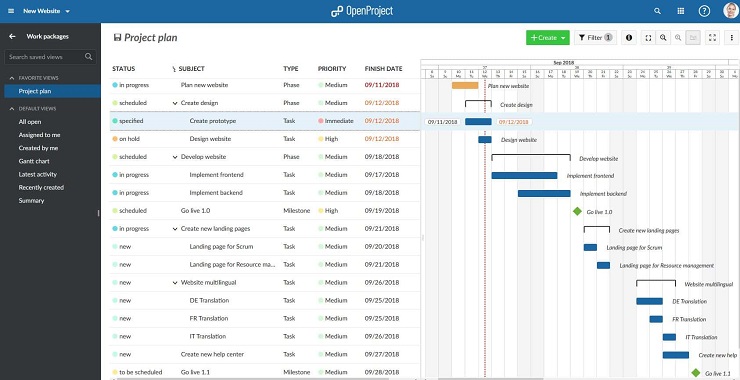
Which of these platforms you choose will depend on a number of factors. The primary ones are how many freelancers you plan to hire, and the complexity of what they will be doing. If you are hiring a couple of freelance writers to churn out blog posts, Trello will be fine.
If you are developing an app with freelance software developers, you'll want a more fully featured program. Just be aware that the more complex programs will require a faster than average internet connection, extra time spent training your staff, and a higher up-front cost.
Work Not Talk
Most of the pieces of software we've mentioned are designed to facilitate easier communication. But that doesn't mean that you should be scheduling online meetings every week.
That might sound counterintuitive, given all we've said about the importance of communication. But here's the thing: one of the huge advantages of hiring freelancers is that they are not distracted by an office environment. And keeping it that way involves scheduling as few meetings as possible.
Managers moving from traditional environments into one made up of freelancers are often frustrated with the limitations to setting up meetings with their new freelance staff—differences in time zones, language barriers, and simply finding a time when everyone is free. This frustration gradually gives way, however, to a powerful realization that you don't need as many meetings as you think you do.
Working with freelance employees forces you to consider whether a meeting is really, truly the best way to get something done. Especially when you are starting an online business, meetings can take valuable time away from getting tasks done: instead of convening a strategy meeting to consider the pros and cons of various approaches, you can spend the same time actually trying them.
In short, managing a freelance team is about giving your employees the capability of easy communication, and encouraging them to talk to each other, without burdening them with endless, unnecessary meetings.
Tracking, Monitoring, and Payment
No matter how motivated your freelance team members are, and no matter how invested in your business they appear to be, you will need to monitor how, and how much, they are working.
For managers new to freelancers, this can feel a little intrusive. However, it is a necessary part of managing a freelance team, not only because it ensures that you are getting your money's worth, it can also help you spot potential problems at an early stage.
In reality, freelancers who work too much are just as big a cause for concern as those who work too little. With no time off, workers who are pouring every waking hour into your business risk burning out, which is bad both for them and you.
When to Monitor Employees
The common move here is to set up time-tracking software, and we will explore options in the next section. Before we do that, though, it's worth taking a moment to point out that tracking time is not the only, and sometimes not the best, way to pay your freelance employees.
Freelance writing is an obvious example of this. Instead of paying by the number of hours a freelancer spends writing an article, which can be seen as an invitation to conduct endless "research," you can pay writers by the word. This encourages them to turn articles around quickly, rather than getting distracted coming up with the perfect structure for their content. Just make sure you monitor the quality of their work, as well, to avoid them getting sloppy.
Other types of freelance roles, and especially those that include ongoing engagement with customers and receiving payments, are better paid by the hour. In order to monitor employees in this way, the best solution is to make use of free software that integrates with most merchant services, so you can track payments received and time logged concurrently.
Popular Software for Freelance Monitoring
As freelancing has risen in popularity, the marketplace for employee monitoring software has become more crowded. Just as with the employee communication software, there is a tradeoff to be made here between complexity and features. However, this decision is arguably more important than your communication platform, because it is linked directly to the amount you will pay your freelancers.
One of the most popular options isTime Doctor. An early example of this kind of software, Time Doctor still provides all of the basic features you will need: integration with project management services, and the ability to create invoices straight from the application. On the other hand, Time Doctor is starting to show its age a little, and the user interface, in particular, looks a little dated. 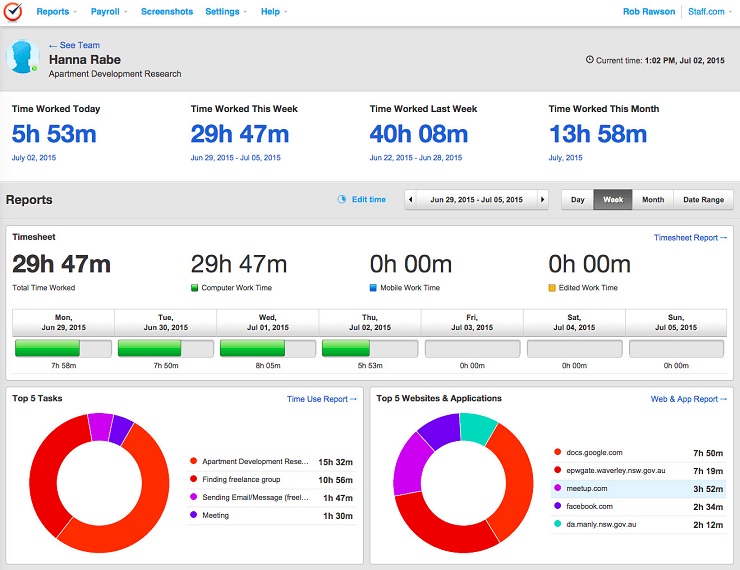 Source
Source
Another relatively simple solution, albeit a much newer one, is Hubstaff. Hubstaff offers screenshot and keystroke monitoring, as well as scheduling features that can help both you and your employees to plan workloads. What Hubstaff does, it does well. However, it does not come with the project management features of some more advanced monitoring apps.
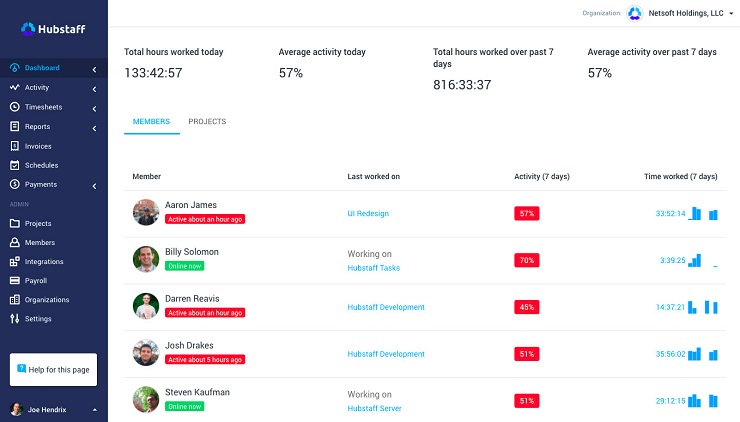 Source
Source
One of the more complex systems is StaffCop. This is a great solution for large teams, offering features that few other systems can rival. These include full audio and video monitoring, automated policies and triggers, as well as full text recognition capability on documents and screenshots. If you're managing a huge enterprise team remotely, StaffCop is for you. On the other hand, the system needs an on-premises server in order to function, and has no cloud-based admin interface. This makes it less than ideal for managing small, agile teams.
 Source
Source
A good compromise between these solutions is Teramind. This is a relatively new piece of software, so it's designed with the needs of contemporary freelancers in mind. Teramind offers the same intuitive user interface as Time Doctor and Hubstaff, but also includes a full automation layer that makes repetitive tasks much quicker.
 Source
Source
When choosing employee monitoring software, it's worth scheduling in a trial period. Most of these systems require a significant amount of time to set up, and migrating from one to another can be costly.
You should also be as clear as possible with your freelance employees about exactly what you are monitoring, and what you will do with this information. Some freelancers, and especially those who are highly paid, can take offense if you propose to check their every move, so make sure that you agree with them on what's fair.
Paying Your Freelance Staff
Last, but definitely not least, is the process of actually paying your staff. This might sound like an easy part of the process of managing freelance teams, but there are a few issues that can arise.
The first thing to say in this regard is that many employee monitoring tools automatically generate invoices, and some of the better ones include integrations with payment systems like PayPal, or popular alternatives like Payoneer and TransferWise. This can make the process of paying your staff a lot easier, and a lot more transparent, as long as your time-tracking software is configured correctly.
It goes without saying that, when it comes to payment, you should be as prompt as you expect your staff to be. Quibbling over small sections of an invoice can quickly lead to a break down in your relationship with your staff members, because they can feel that you do not trust them.
Finally, you should remember that your staff are likely to be less invested in your business than you are. No matter how motivated they are, you must recognize that for them, working for you is just a job. As a business owner, you might be willing to put in dozens of extra hours in order to set your business up for the next five years, but your freelancers are likely working on timeframes that are much more limited. For this reason, you should never expect them to work for free.
The Future
All of these processes are important aspects of managing a freelance team. They are important, in fact, in managing any kind of team, but for entrepreneurs seeking to grow their businesses, hiring your first freelancers brings both opportunity and risk. Getting it right the first time is critical, and with the tips above you should be able to do that.
In addition, you should think of the process of hiring your first freelancers as a learning opportunity. If you've never managed staff before, this is a great way to gain that experience. And if you have managed teams, but not remote workers, then you have equally as much to learn. These skills are hard to come by, and are in high demand.
For that reason, hiring freelancers is not only a good way of building up your business, it's also a great way to raise your profile. ThoughAI might undermine the importance of some freelancers in the next decade, for many tasks, businesses will be relying on human freelancers for many years to come. And if you play your cards right, you will not only get great employees, but you will also make contacts with the best in the business. These connections might pay off during the next phase of business expansion.
EXCLUSIVE FREE TRAINING: Successful Founders Teach You How to Start and Grow an Online Business
The post How to Manage a Freelance Team: Tips on Budgeting, Management, and Software appeared first on Foundr.
]]>The post How to Use the 6 Levels of Delegation to Scale Your Business appeared first on Foundr.
]]>Today, Meisel is a best-selling author, productivity coach, and co-founder of outsourcing platform Leverage. Based on what he personally learned and accomplished, he developed the Less Doing, More Living system that teaches founders how to optimize, automate, and outsource everything in their businesses. Meisel is also the instructor of Foundr's Productivity Machine course.
And lucky for us, Meisel agreed to join us for this brief video to share how he delegates so effectively. Check it out below, and then read on to get a detailed breakdown of this process:

EXCLUSIVE FREE TRAINING: Successful Founders Teach You How to Start and Grow an Online Business
Delegation: It's Not What You Think
As entrepreneurs, we're constantly being told to delegate, delegate, delegate. But do we actually know what it means? If you look it up in the Merriam-Webster dictionary, to delegate means "to assign responsibility or authority."
Those of us who struggle with trust issues or think delegation isn't for us probably misunderstand how to delegate as a leader. As Meisel stresses, delegation isn't black and white, meaning:
- You don't have to outsource an entire project.
- You don't have to outsource none of it either.
According to Meisel, there are six levels of delegation. "A lot of people, when they have hesitancy towards delegating, it's because they're stuck in one or the other," he says.
So let's break down the six levels and how entrepreneurs can use them to become less stressed and more productive.
The Six Levels of Delegation, According to Ari Meisel
Level 1: Do As I Say
The first and most basic level of delegation is "do as I say." But the problem is that entrepreneurs think this means they'll end up doing all the work anyway for a small task, such as buying a plane ticket, by having to describe exactly where to look and detailing the parameters. With this in mind, many entrepreneurs throw up their hands and say, "I'll just do it myself!"

But that would be a mistake. As Meisel points out, "do as I say" is meant for tasks that don't require much information or skill. For instance, "buy me a bath mat on Amazon" or "post this image on Twitter with this hashtag."
Yes, you do a little bit of the work upfront, but your assistant runs the last mile. With simple tasks like these, it's fine to work to a certain point and then let someone else finish it for you. That's still minutes saved that you could spend doing something that you're the best at.
Level 2: Look Into This for Me
Delegate a task with "look into this for me" when it's something you know nothing about. An example that Meisel gives is if someone recommends a certain CRM you've never heard of, then you might want to have someone on your team get more information about the software before you buy it.
"It's almost like a human Google at that point," he says, "and that's totally fine because you can just move on again. You don't have to worry about it. You don't have to think about it."
Your assistant can do the research for you, bring you the information, and you can make an informed decision from there.
Meisel says you can start at one level of delegation and move to another. For example, if you're thinking of getting a new car, you could tell your assistant, "Look into this for me." But if you already know you really like Subarus and need some in-depth research on different models, it's time to move on to the next level of delegation: "Give me your advice, and I'll decide."
Level 3: Give Me Your Advice, and I'll Decide
So with the Subaru example, you could tell your assistant, "Go do some research on the best models, come back to me with three options, and I'll pick one." They'll do the in-depth research, narrow down the results based on your parameters, and then give you the three best options. From there, you just make a decision.
If you're able to start delegating at this level, that's a good sign. Why? Because it shows you are trusting your assistant to do everything they can and explore all the options for you. You're letting go of a bit of control. Plus, reducing the information overload by trusting your assistant's advice helps you to make decisions more quickly. As a business owner, it's important to make fast, informed decisions and then move on to growing your business.
Level 4: Explore, Decide, and Check Back With Me
Now we're getting into the upper levels of delegation: In level four, you're going to let someone else decide for you and then check back with you before they execute it.
Let's go back to the CRM system example. There are hundreds of CRMs out there. None of them will be perfect for you, but it's not worth your time to go diving into the research on every single one. It's a better use of your time and resources to pick a person on your team (perhaps a marketing assistant or a salesperson) who uses CRMs a lot and knows about them. They will be the best person to make an informed decision about which software to buy.
"No matter how much time you spent, you're still not going to be in a position to make as good of a decision as somebody who's been working with that industry or those tools for a long time," Meisel says.
But what about those of us who are control freaks? How can we let go of a decision for a business that we own?
"A lot of times when you're trying to get comfortable with this level of trust," says Meisel, "what you have to weigh is the balance between the gravity of the project at hand and the expertise of the person that you're asking to do it."
So if you need someone to choose a bath mat for you, worst-case scenario, you get a bad product or spend too much money. But with something like email marketing, you shouldn't invest the time to decide. You need to enlist the help of someone with more expertise than you in that area. So it really depends on the type of task. If it's a weightier decision that requires more expertise, find the person with that expertise.
EXCLUSIVE FREE TRAINING: Successful Founders Teach You How to Start and Grow an Online Business
Level 5: Explore and Decide, Within These Limits
Meisel goes by this rule: "If it's a decision that doesn't involve more than $100, I don't want to know about it."
For example, when Meisel needed to set up a personal webpage, he delegated the decision to someone else. An hour later, a charge for $79 for about.me showed up on his phone. But because it was under $100, well beneath the threshold he had set, he didn't care. The person had done exactly what he had asked for.
So with these decisions, you can tell your assistant or team member that you don't even want to know about a decision up to a certain threshold.
Level 6: Just Get It Done
Alright, now we're at the final level of delegation—it's Meisel's favorite one! That's because this is true delegation, where you completely trust your assistant or team member to handle the task without needing to check in with you. Even so, he admits there are not a lot of situations where you would say, "Just get it done."
One example from his own life is when he had a motorcycle registered in his name that he and his father were using. One day, the registration had expired, but his dad wanted to use it.
Someone had to go to the DMV to get it renewed. It had to get done, but Meisel didn't want to waste time doing it himself. So he delegated this task to his assistant. A seemingly simple task turned out to be quite arduous, and by the end of it, when he found out how much effort it had taken her, he was grateful he hadn't done it himself. As a business owner, a personal task that draining would've derailed the projects he was working on.
Recap: The Six Levels of Delegation
As Meisel points out, a project can fall into any one of these six levels, and that same project can move through some of these levels.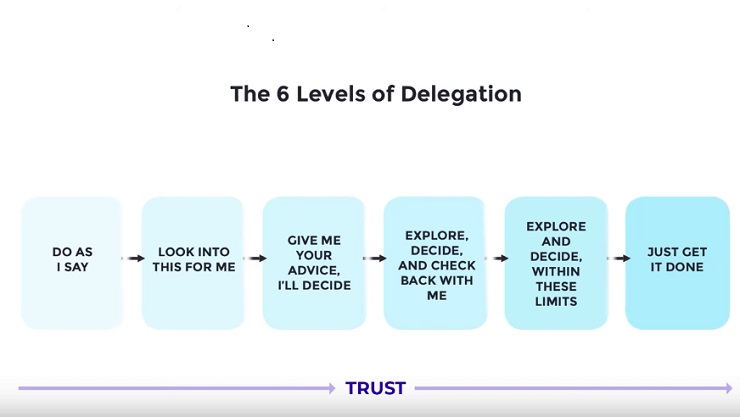
"While that may sound too fluid for some people, I want that," Meisel says. "I don't want you to get stuck in this idea that it's either 'give it to somebody' or 'do it myself.'"
Take Action! A Simple Exercise so You Can Start Delegating Today
Meisel gives us an exercise to get started on how to delegate effectively.
- Step 1: Write down 10 things you need to get done that you don't want to do or shouldn't be doing yourself.
- Step 2: Think of the six levels of delegation and notice that as you move through the levels, you move from outsourcing ("do as I say") down to true delegation (which is "just get it done"). Ultimately, you want to get to level six, "just get it done."
- Step 3: Take those 10 things and see which of the six levels they might fall under, and that will clue you in to where your issues are and which providers you may need to hire to get these things done.
Online Tools You Can Use to Delegate Tasks
If you're looking for virtual assistants and other professionals to hire so you can start delegating tasks, check out the following tools:
- Fancy Hands connects you with US-based virtual assistants who can help you complete personal or business tasks, from booking travel to paying bills. Their lowest plan is $29.99, and you can get five requests per month (typically up to 20 minutes of work per request). They also have options if you need a dedicated virtual assistant.
- Magic offers personal assistants for 50 cents per minute and business assistants for 59 cents per minute. Send a message through their app, and Magic will assign someone from their team of assistants to complete your request.
- Zirtual has a team of US-based assistants that can complete personal and business tasks such as email management, social media scheduling, and vacation research. Plans start at $449/month for 12 hours of task work.
- Design Pickle might be a good fit for you if you're looking to outsource graphic design tasks. This website will pair you with a dedicated graphic designer to do the skilled work for you. Plans start at $399/month for unlimited requests and unlimited revisions.
What Will You Delegate?

As a founder, it can be hard to let go of any part of your business. Sometimes we fall into the mental trap of thinking, "If I want it done right, I'll have to do it myself." This is false! If you do delegation correctly, the tasks will get done and by someone who's better suited to do them.
You can't scale your business if you don't delegate. There is only one you. Since you're the founder of your business, your time and select skills are highly valuable in the areas that you should be spending them in. For the tasks that don't grow your business or the tasks where you don't know what you're doing, you need to hand them off to someone else or risk slowing your growth.
Reviewing Meisel's six levels of delegation, notice how it goes from simpler to more complex tasks. If you're not at the true delegation level of six yet, it's okay. You can start with level one ("do as I say") and gradually move down the levels until you're a delegation master.
Which tasks will you start delegating? Share your top three in the comments below!
EXCLUSIVE FREE TRAINING: Successful Founders Teach You How to Start and Grow an Online Business
The post How to Use the 6 Levels of Delegation to Scale Your Business appeared first on Foundr.
]]>The post Do This First: Successful Entrepreneurs Share Their 5 First Steps for Starting a Business appeared first on Foundr.
]]>It's enough to make an entrepreneur give up before getting started.
But, as always, Foundr's got your back. We asked a group of trusted, successful business leaders: "What are the first five things a startup entrepreneur should do?"
While the vast majority of them affirmed the wisdom of surrounding yourself with the right information (which you've already accomplished by coming right here to Foundr), they also offered an amazing array of additional advice and thoughts to consider.
Here's what they had to say:
EXCLUSIVE FREE TRAINING: Successful Founders Teach You How to Start and Grow an Online Business
Ryan Sprance, Founder and Chief Strategist of Kaihatsu Media

Kaihatsu Media began in March 2016, and will cross the $1 million in revenue mark this year. In the past 18 months, recurring monthly revenue grew from $1,000 to over $80,000. Kaihatsu Media employs 10 people in four countries and supports the digital marketing efforts for 20 companies.
We are very proud of Ryan. He is one of our students who has worked hard to apply what he learned to get amazing results with his consulting business. Way to go Ryan!
Ryan's Recommended First 5 Actions for a Startup Entrepreneur:

1. Begin with the end in mind.
Don't be afraid to dream big. Mindset plays a role in your ability to succeed through the tough times. If you have a big enough goal, and you take time each day to reflect on what that goal is, you have a better chance at achieving it.
2. Define a routine.
Be sure to define a daily routine that includes planning, nutrition and proper sleep. (To see the morning routines of 15 successful entrepreneurs, read this.) The biggest mistake new entrepreneurs make is neglecting their own self care. The common approach is to hustle until you drop. The fact is that you will not be able to work at your peak performance unless you make time to refresh your body and rejuvenate your mind. It allows for creative thinking and efficient problem solving.
3. Invest in people.
Seek to invest in support before you need it. Start with freelancers and test them out on small projects. Do not be afraid to delegate. Start with smaller tasks and exercise your
"delegation muscle." The quicker you are able to remove yourself from the tasks that do not define your brand or drive revenue, the quicker you will be able to scale beyond a single-person operation.
4. Plan your financial runway.
In most startups, you will need to go 12-18 months before you can take a consistent paycheck. In order to alleviate personal stress on top of the stress of building a business, plan your personal finances out in advance and when you can, prepay things like your monthly car and insurance bills. Removing the worry about your personal finances will give you one less thing to stress about as you are getting your business off the ground.
5. Position yourself as a thought leader.
Take full advantage of social media platforms to document and share your journey. Don't be afraid to share your vulnerability, including the mistakes you make and hard times along the way. It only increases your authenticity and makes you more relatable.
Mike Grillo, CEO and Co-Founder of Gravity Products
The Gravity Blanket was named one ofTIME's Best Inventions of 2018, and Gravity Products has become one of Entrepreneur Magazine's 100 Brilliant Companies. Since Gravity Products' initial launch on Kickstarter in April 2017 (where the company raised more than $4.7 million in crowdfunding in the first 30 days), Gravity has generated more than $35 million in revenue in just over two years. Most impressively, more than 70% of the revenue was from the past year.
Mike's Recommended First 5 Actions for a Startup Entrepreneur:
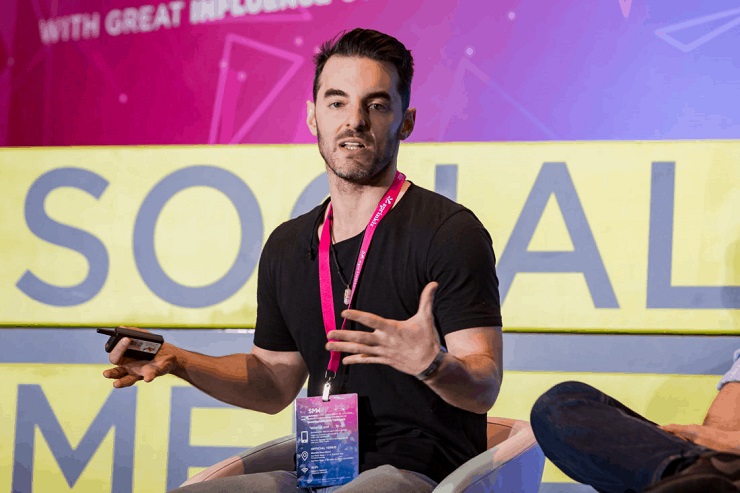
1. Get your finances in order.
If you don't come from a finance or true business background, find yourself an amazing financial leader right off the bat (they don't have to be full time). It will save you headaches down the road to have things set up properly from the start.
2. Explore trademarking your product/brand.
For Gravity, trademarking the term "Gravity Blanket" has allowed us to stand out among the hundreds of competitors using the term to try to piggyback off our popularity. Don't let copycats turn you into a victim of your own success. (For more info on how to trademark your ecommerce business branding, check out this article.)
3. Meet with other CEOs and entrepreneurs.
Take every meeting you can with other startup founders. Becoming part of your local startup community is a great way to get access to freelancers and partners, and learn from others.
4. Learn your unit economics inside and out.
Be sure you and your partners have accounted for all the costs associated with producing and distributing your products. Remember, cost of goods is only ONE component of total costs. Inbound freight, duty (if you're producing overseas), and last-mile fulfillment all impact costs. Having a firm understanding of this will dictate everything from promotions and discounts, to how much you can spend on marketing and what channels.
5. Think like you're bigger than you are.
Treat your brand with the same care that a Fortune 500 company would. Be religious about how your brand shows up in the world. It's always easier to make concessions down the road than to try to elevate the brand once you've established a sub-par baseline.
EXCLUSIVE FREE TRAINING: Successful Founders Teach You How to Start and Grow an Online Business
Jeff Proctor, Co-owner of DollarSprout.com
Bootstrapped by two people with no formal business experience, DollarSprout launched in 2015 and will reap over $2.2 million in revenue and $1 million in profit in 2019. They reach over a million readers every month!
Jeff's First 5 Steps for Startup Entrepreneurs Are:

1. Identify what problem you are going to solve, and for whom.
This is the classic first step for most entrepreneurs, but one that is commonly skipped. What pain point are you trying to address, and for what type of person? Fleshing out in-depth answers to these two questions are critical to getting things started on the right track.
2. Get a prototype, website, etc. up as soon as possible.
Don't get stuck in the rut of "perfecting" an idea. Get a Minimum Viable Product (MVP) done as soon as you can so you can start getting feedback from people in your space.
3. Start building an online community.
Regardless of business model, any entrepreneur starting a business in 2019 and beyond needs to understand the power of social media and search engines. The sooner you are able to build an audience, the better.
4. Make friends with business owners in shoulder niches.
A "shoulder niche" is a space that is similar to your business, but distinctly different. For instance, if you are starting a water bottle company, start connecting with gym owners, fitness influencers, and other health-oriented businesses. Get feedback from them. These connections will prove to be invaluable as you begin marketing your products and services.
5. Iterate rapidly.
You aren't going to get it right the first time (or even the second or third time). Take the feedback you've received plus any observations you've made, and make your product just a bit better. This applies to more than just your product or service itself, it also applies to your marketing!
Kerry Mellin, Founder of EazyHold.com
After a 35-year career designing for the motion picture industry, Kerry discovered while trying to sweep out her barn one day the lack of simple grip aids to help people with disabilities. In 2015, she and her sisters launched Mellin Works to design and produce inclusive products to help people with physical conditions that make it difficult to grip objects. They made history by innovating a new category of silicone grip aids for the healthcare and caregiving industries.
EazyHold, completely bootstrapped by the sisters, has tripled its revenue every year since. Now supplied globally to over 8,000 schools, hospitals, and therapy centers, EazyHold is included in university studies and academic textbooks. It has also just been named one of six finalists for the Amazon 2019 Women Owned Business of the Year.
Kerry's First 5 Things a Startup Entrepreneur Should Do:

1. Put a good team together that you trust, and if possible have a previous history with.
2. Use local resources (photographers, printers, postal services) so that they can be easily reached for efficient one-on-one services and delivery.
3. Reach out to all local newspapers and radio stations for interviews/articles early on to develop a relationship that will validate your progress throughout your journey.
4. Access your local Small Business Administration for consultations and mentorship. The information and one-on-one help is invaluable, and free!
5. Perhaps the most important: Find your community! Know not only who will benefit from your services, but how your company can be counted on to enhance and benefit other businesses, startups, and nonprofits through partnerships and community events. (Don't panic, introverts. Here's some help for how you, too, can network well.)
Nikolaj Nielsen, CEO and Co-founder of AvXperten.dk

Looking to make your idea a reality with no outside funding? Then you'll want to pay attention to Nikolaj Nielsen's advice. He and his brother Frederik started AvXperten in 2006. It's now the second-largest consumer electronics store in Denmark with a yearly revenue in the eight figures. The brothers funded the business themselves and have never taken investment money or outside capital.
Nikolaj's Advice on the First 5 Things Startup Entrepreneurs Should Do:
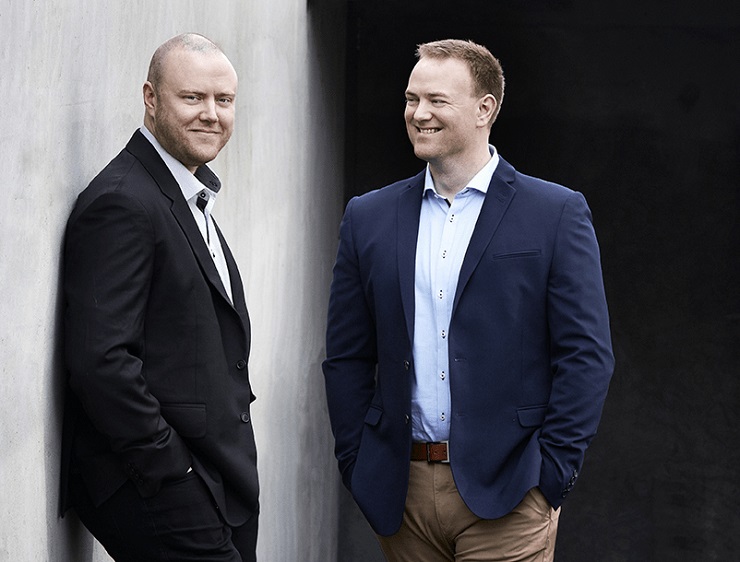
1. Be a penny pincher.
Do not start off with spending hundreds or thousands of dollars on a fancy logo. Get a freelancer on UpworkorFiverr to do it for you! Use beta software and free software such as Google Drive, Gmail, and Google Docs. Keep costs at a minimum, all the time.
2. Listen to everyone's ideas.
One day, one of our staff in the warehouse asked me if it was possible to have a picture of the item we were picking, right there on the packaging slip. This idea was implemented the same day, and this simple item has cut 16% of packaging errors. Listen to the people around you. Ideas for improving on your idea are everywhere.
3. Forget all about perfect.
Do not try to be perfect. Of course your software, website, or app needs to be adequate and capable, but the instant feedback from actual users that comes with a fast launch can help you iterate and integrate, instead of "thinking about" what might be the perfect solution.
4. Only spend money on growth.
For the first five years, every time we spent a dime we first asked ourselves, "Does this help us ship more products?" If not, we passed. We got our furniture from our mom's house, old desks for free from a business that purchased new for themselves and gave their old furniture to anyone who would pick it up. We literally did not spend money on anything other than selling product.
5. Meet others with the same mindset.
If you are a penny-pinching bootstrapped startup, it might be dangerous to surround yourself with fully funded startups. We chose not to get funding when we could have. If you are in the early phase of creating a startup, you can't burn through dollars like a company that just got millions in funding. You could end up being broke. Surround yourself with others who are not seeking outside funding so that you can collaborate and support each other through the tough times.
EXCLUSIVE FREE TRAINING: Successful Founders Teach You How to Start and Grow an Online Business
What are Your First 5 Things?
Now that you've heard from startup entrepreneurs who have successfully done what you're trying to do, what are your first five tasks to accomplish? Maybe you'll identify networking and mentoring opportunities, creating the prototype of your product, beginning to interview accountants and attorneys, or something else entirely.
If you need even more help in knowing how to start your business, we talked with 28 successful founders who shared their advice on how to start a startup.
Or perhaps you've already begun and have other "first five things" for startup entrepreneurs to consider. We want to hear from you! Please share in the comments below. (We really do read every one.)
The post Do This First: Successful Entrepreneurs Share Their 5 First Steps for Starting a Business appeared first on Foundr.
]]>The post The 19 Best Business and Management Books, Recommended by Jobs, Buffet, Branson and More appeared first on Foundr.
]]>It's not just the gazillion dollars in their bank accounts. It's not just fame or world-changing corporations they founded.
One big, important thing they all have in common is that they are voracious readers.
Best Business & Startup Books Recommended by World-Class Entrepreneurs
- Bill Gates
- Mark Zuckerberg
- Jeff Bezos
- Elon Musk
- Steve Jobs
- Warren Buffett
- Richard Branson
Reading books is crucial for them, and for so many other successful entrepreneurs, for the simple reason that they are constantly learning, hoping to expand their mental capabilities, looking to discover new ways to do things and improve themselves.
Considering these are some of the most accomplished entrepreneurs in history, not to mention how often I've heard other elite founders swear that they are die-hard bookworms, it got me thinking. What exactly do they read? 🤔
Are we talking Harry Potter or Game of Thrones? Ancient philosophy? Or do they churn through modern self-help and business theory books?
So I set out to build the ultimate entrepreneurship reading list, based on the habits of the world's greatest entrepreneurs. First of all, I wanted to know which business books they liked the most. Then, I looked at the overall topics they read about. Finally, I narrowed it down to just those that are relevant to management and business. (No offense, Khaleesi fans.)
Surprisingly, my research led me to discover that folks like Richard Branson and Warren Buffet don't read as many business books as I had imagined—at least those aren't the ones they recommended the most. The majority of their favorite books are in subjects as varied as spirituality (particularly Steve Jobs), biology, anthropology, and politics.
That alone is a big lesson to keep in mind. It seems that by keeping their minds open to new ideas from a wide and unrelated range of topics, they get to see beyond the narrow business world scope.
That being said, business icons have read a lot of business books, many of which they love and recommend.
Today, I want to share with you the list of the best business startup books and book about business and management that seven of the top modern entrepreneurs loved.
Business Book Recommendations from Bill Gates
Measure What Matters, by John Doerr
In the fall of 1999, John Doerr had made the biggest investment in his venture capitalist career—$12.5 million—to a recently founded tech startup from a couple of Stanford Ph.D. students. The startup was Google.
The company, which began with a paper written by one of the founders, a young man named Larry Page, was about to change the world.
To help the founders make the tough choices needed to survive the first few years of existence, Doerr taught them a management methodology that'd help them track relevant, timely data. Called Objectives and Key Results (OKRs), the ultimate goal of this approach was, as the name of the book suggests, to measure what matters most.
As Doerr explains in the book:
In this goal-setting system, objectives define what we seek to achieve; key results are how those top-priority goals will be attained with specific, measurable actions within a set time frame. Everyone's goals, from entry-level to CEO, are transparent to the entire organization.
OKRs have helped organizations like Google, IBM, and the Gates Foundation to focus their efforts around specific goals, foster coordination among different teams, keep everyone accountable to their tasks, and strengthen the entire company's mission and values.
Quotes:
- "We must realize—and act on the realization—that if we try to focus on everything, we focus on nothing."
- "Key results benchmark and monitor how we get to the objective. Effective KRs are specific and time-bound, aggressive yet realistic. Most of all, they are measurable and verifiable."
- "The hairier the mission, the more important your OKRs."
Get It Here
Bill Gates' Review
Shoe Dog, by Phil Knight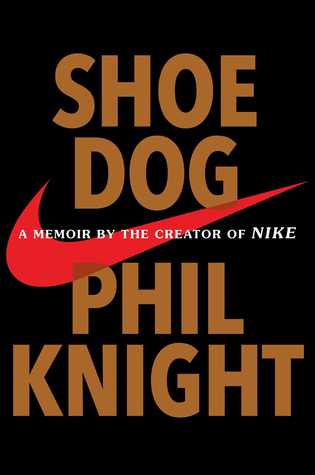
What can you do with $50? Buy a nice dinner for your loved ones. Pay for a yoga class. Get a gift for your best friend.
Why not found a $90 billion company? I know this sounds a bit crazy, but that was the money Phil Knight borrowed from his father back in 1962 to start his company, Blue Ribbon Shoes, with the simple mission of importing high-quality, low-cost athletic shoes from Japan.
Eventually, his little company would become Nike, hauling in annual sales above $30 billion, with 73,000 employees, and over 500 factories in 41 countries.
Personal, beautifully narrated, and sometimes melancholic, this memoir shares all the stories behind the start of the ultimate sports fashion company.
Quotes:
- "Don't tell people how to do things, tell them what to do and let them surprise you with their results."
- "Life is growth. You grow or you die."
- "So that morning in 1962 I told myself: Let everyone else call your idea crazy…just keep going. Don't stop. Don't even think about stopping until you get there, and don't give much thought to where 'there' is. Whatever comes, just don't stop."
Get It Here
Bill Gates' Review
The Checklist Manifesto, by Atul Gawande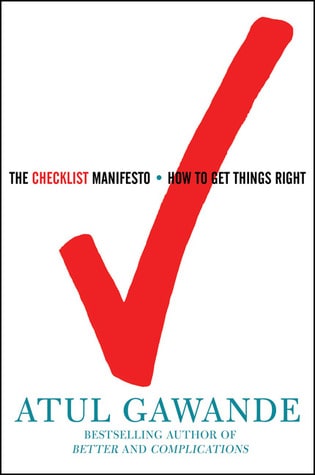
To say we live in a complex ever-changing world would be an understatement. We all know that, but the way professionals deal with this fact makes all the difference in their work life. The responsibilities of any professional, whether highly skilled or not, are constantly changing: New techniques to learn, new forms of competition that require quick adaptation, and modern technologies that change the way we do business.
In this book, acclaimed surgeon and writer Atul Gawande shares the solution to all these concerns through a simple old-school technique: thechecklist.
The checklist has helped professionals like pilots fly sophisticated aircraft and doctors respond to new epidemics in little time. Gawande even shows that checklists were responsible for lowering the fatality rates by more than a third in complex surgeries.
This book isn't just a manifesto about checklists, rather, it's about productivity, simplicity, and effectiveness. Better yet, it's a wake-up call to anyone who's facing mind-boggling challenges and lack of organization.
Quotes:
- "Good checklists are precise. They are efficient, to the point, and easy to use even in the most difficult situations. They do not try to spell out everything—a checklist cannot fly a plane. Instead, they provide reminders of only the most critical and important steps—the ones that even the highly skilled professional using them could miss. Good checklists are, above all, practical."
- "We don't like checklists. They can be painstaking. They're not much fun. But I don't think the issue here is mere laziness. There's something deeper, more visceral going on when people walk away not only from saving lives but from making money. It somehow feels beneath us to use a checklist, an embarrassment. It runs counter to deeply held beliefs about how the truly great among us—those we aspire to be—handle situations of high stakes and complexity. The truly great are daring. They improvise. They do not have protocols and checklists. Maybe our idea of heroism needs updating."
- "Checklists seem able to defend anyone, even the experienced, against failure in many more tasks than we realized."
Get It Here
Bill Gates' Review
Scale Your Business the Richard Branson Way! Click Here to Get a Copy of Our FREE Print Magazine, "Scaling Branson Style"
Business Book Recommendations from Mark Zuckerberg

Creativity Inc., by Ed Catmull 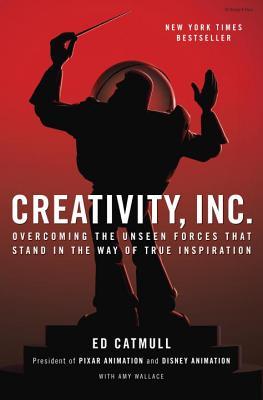
In the mid-1980s, Ed Catmull was a Ph.D. student at the University of Utah with the dream of making the first computer-animated movie. By mere coincidence, he got to work with George Lucas, director of the Star Wars trilogy. This partnership would eventually lead to the founding of Pixar with Steve Jobs and John Lasseter in 1986.
From the studios of Pixar, Ed Catmull would be behind the launch of a movie that would change the movie industry forever: Toy Story. What helped Pixar launch this and other 13 wildly successful movies was the development of a unique philosophy built around the creative process.
In this book, Catmull explains all the techniques the Pixar team created to help make it an admired and highly profitable company.
Quotes:
- "If you give a good idea to a mediocre team, they will screw it up. If you give a mediocre idea to a brilliant team, they will either fix it or throw it away and come up with something better."
- "Failure isn't a necessary evil. In fact, it isn't evil at all. It is a necessary consequence of doing something new."
- "If you aren't experiencing failure, then you are making a far worse mistake: You are being driven by the desire to avoid it."
Get It Here
Source
The Idea Factory, by Jon Gertner
The younger generation might not think of AT&T as a leader in innovation. But for much of the time between its founding in the 1920s until its eventual demise in the 1980s, its research and development wing Bell Labs was the biggest and most important laboratory in the world.
Consider some of the technologies Bell Labs was able to develop in the 60 years that it functioned:
- The transistor (you know, the little electronic thing that makes everything work, including your phone and computer)
- The laser
- Radio astronomy
- The Unix operating system (which is behind Linux and Apple's OS)
- The programming languages C and C++
We'd hardly be able to recognize the world we live in if we didn't have Bell Labs. The question we must then ask is, "What made Bell Labs so innovative?"
In The Idea Factory, Jon Gertner takes you through the story of Bell Labs, revealing the origins of some of the 20th century's most important inventions.
Quotes:
- "'You get paid for the seven and a half hours a day you put in here,' Kelly often told new Bell Labs employees in his speech to them on their first day, 'but you get your raises and promotions on what you do in the other sixteen and a half hours.'"
- "If you haven't manufactured the new thing in substantial quantities, you have not innovated. If you haven't found a market to sell the product, you have not innovated."
- "To an innovator, being early is not necessarily different from being wrong."
Get It Here
Source
Zero to One, by Peter Thiel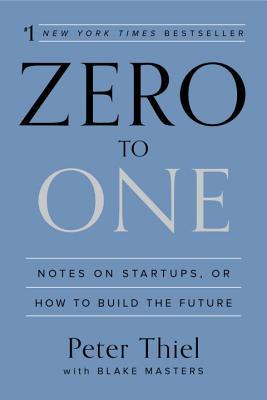
Peter Thiel, the founder of PayPal and early investor of Facebook, is an enigmatic man. He's well known for his conservative and libertarian views, his open support for Donald Trump, and his feuds with Gawker Media (which he eventually took down, as shown by Conspiracy ). Yet behind his problematic reputation lies a brilliant mind, one that was responsible for the growth of several multibillion-dollar, highly innovative companies.
In Zero to One, Thiel explains his philosophy and beliefs around technology. As he states in the book, there's a lot of innovation in the technology sector, but this could be achieved in any industry or area of business so long as its leader can think independently.
The most interesting concept in the book, which lends it its name, is the idea that innovation is when we go from 0 to 1. The next great innovation won't be a new, better operating system (which would be like going from 1 to 10), but a whole new concept altogether which we can't imagine yet—just like we couldn't imagine the operating system back in the 1970s.
The new innovators of the future will grow and succeed by escaping competition thanks to the uniqueness of their business. The key is to go from 0 to 1; to uncover the new innovations.
Quotes:
- "The best entrepreneurs know this: every great business is built around a secret that's hidden from the outside. A great company is a conspiracy to change the world; when you share your secret, the recipient becomes a fellow conspirator."
- "Tolstoy opens Anna Karenina by observing: "All happy families are alike; each unhappy family is unhappy in its own way." Business is the opposite. All happy companies are different: each one earns a monopoly by solving a unique problem. All failed companies are the same: they failed to escape competition."
- "What important truth do very few people agree with you on?"
Get It Here
Source
Business Books Recommended by Jeff Bezos
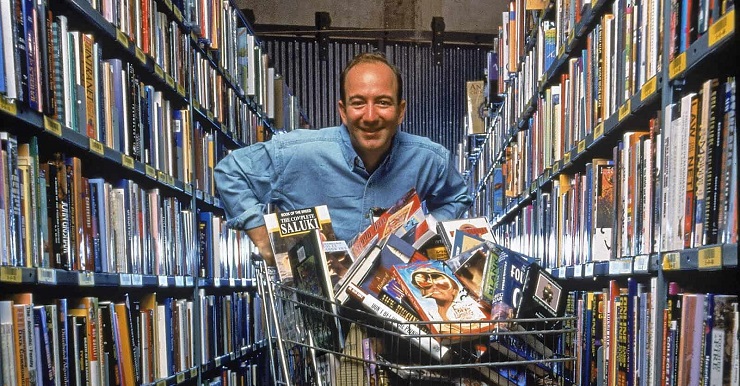
Built to Last, by Jim Collins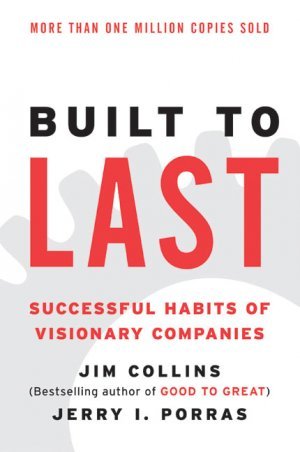
In contrast with most of the books in this article, Built to Last came to existence after a six-year research project developed by the authors, Jim Collins and Jerry Porras, professors at the Stanford University Graduate School of Business.
Their research took a deep look at 18 highly successful companies like General Electric, Walmart, and Disney, with an average age of around 100 years and whose performance has beaten the stock market by 15 times since 1926. The team studied each business compared with one of their top competitors to see what the former did differently.
Throughout their study, the authors asked, "What makes the truly exceptional companies different from other companies?"
They break through the clutter and explain how focusing on more than profits, developing almost cult-like cultures, and having big hairy audacious goals, among other things, has helped these businesses find rare success. In other words, they explain how they were built to last.
Quotes:
- "The test of a first-rate intelligence is the ability to hold two opposed ideas in the mind at the same time, and still retain the ability to function."
- "Visionary companies are so clear about what they stand for and what they're trying to achieve that they simply don't have room for those unwilling or unable to fit their exacting standards."
- "Visionary companies pursue a cluster of objectives, of which making money is only one—and not necessarily the primary one."
Get It Here
Source
Sam Walton: Made in America, by Sam Walton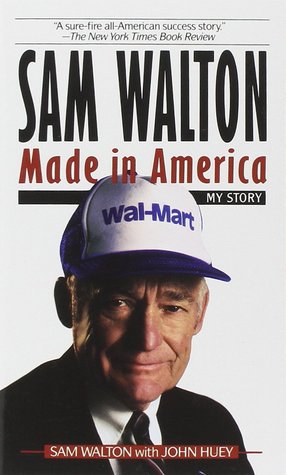
When you think about Walmart, you probably think about cheap prices, low wages, and bad customer service. Unfortunately, this was neither what Sam Walton represented nor what he wanted his company to be.
Walton founded Walmart as a rural kid who wanted to help the common consumer by selling products at low prices. He was a crusader for the common man.
In this autobiography, Walton explains the story of the founding of Walmart and the philosophy on which he built it. If you want to know the true story of the retail giant and learn more about the original idea from which it was born, you will love this book.
Quotes:
- "What we guard against around here is people saying, 'Let's think about it.' We make a decision. Then we act on it."
- "Great ideas come from everywhere if you just listen and look for them. You never know who's going to have a great idea."
- "Every time Wal-Mart spends one dollar foolishly, it comes right out of our customers' pockets. Every time we save them a dollar, that puts us one more step ahead of the competition—which is where we always plan to be."
Get It Here
Source
Data-Driven Marketing, by Mark Jeffery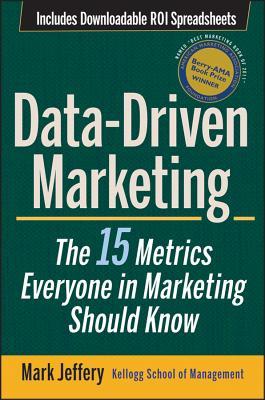
Analytics are paramount for any marketer's life. The only way to be a high-value member of your company is to have a clear idea of the results your efforts—and your department's efforts—bring. In other words, you need to think analytically, being able to tell how much money you're spending and how much revenue each dollar you spend brings your company.
According to a study by BlueVenn, data analysis is considered the most important skill a professional can learn, with 72% of marketers saying it's the most vital in the current job market.
Data-Driven Marketing is the ultimate book for marketers who want to uncover this often overlooked skill. This book, as the subtitle suggests, explains 15 key metrics every marketer should know and master. Spoiler alert, here there are:
- Brand awareness
- Test-drive
- Churn
- Customer satisfaction (CSAT)
- Take rate
- Profit
- Net present value (NPV)
- Internal rate of return (IRR)
- Payback
- Customer lifetime value (CLV)
- Cost per click (CPC)
- Transaction conversion rate
- Return on ad dollars spent (ROAS)
- Bounce rate
- Word of mouth
Based on original research from Kellogg School of Management, this book uses data from a rigorous survey on strategic marketing performance management of 252 Fortune 1000 firms, capturing $53 billion of annual marketing spending.
Quotes:
- "The overarching best practice is to focus, get early wins to build trust, and build momentum based on these wins."
- "The trick is to take a phased approach to gradually build the capability in your organization, realizing results at each stage and developing an actionable process that is easy to follow by employees."
- "You have to have a good marketing and business strategy, but this is not enough. You need sound work processes that monitor all marketing efforts against their objectives to ensure that these strategies work."
Get It Here
Source
Scale Your Business the Richard Branson Way! Click Here to Get a Copy of Our FREE Print Magazine, "Scaling Branson Style"
Business Books Recommended by Elon Musk

Screw Business As Usual, by Richard Branson
It's no secret that we love Richard Branson at Foundr. He's a charismatic entrepreneur who brings more than business acumen and a knack with people, but also a unique vision to everything he does.
In this book, the third he's written, Branson reveals his latest thoughts on the future of business. Specifically, he believes that we are at a time when business people should to turn capitalism upside down and shift our values, from a focus exclusively on profit to caring for people, communities, and the planet. It's an intimate journey through the bright mind of one of the most unique, likable, and charismatic business leaders in the world.
Get It Here
Source
The Wealth of Nations, by Adam Smith
There's no economist or business executive who hasn't heard of Adam Smith and The Wealth of Nations. A foundational book not only in economics, but on philosophy, politics, and sociology. So much so that it is the second-most cited book in the social sciences published before 1950, with 36,331 citations, right behind Karl Marx's Capital (to the dismay of many liberals 😅).
First published in 1776, The Wealth of Nations is a book that laid the foundation for much economic thought that followed. Whether it is John Keynes or Milton Friedman, Karl Marx or Friedrich Hayek, pretty much anyone who has studied economics has been influenced by it in some way.
In this book, Smith takes a deep look at the reasons behind the rise of modern capitalism, namely, the division of labor, productivity, and free markets.
Quotes:
- "Science is the great antidote to the poison of enthusiasm and superstition."
- "Nobody ever saw a dog make a fair and deliberate exchange of one bone for another with another dog. Nobody ever saw one animal by its gestures and natural cries signify to another, this is mine, that yours; I am willing to give this for that….But man has almost constant occasion for the help of his brethren, and it is in vain for him to expect it from their benevolence only. He will be more likely to prevail if he can interest their self-love in his favour, and show them that it is for their own advantage to do for him what he requires of them. Whoever offers to another a bargain of any kind, proposes to do this. Give me that which I want, and you shall have this which you want, is the meaning of every such offer; and it is in this manner that we obtain from one another the far greater part of those good offices which we stand in need of."
- "The subjects of every state ought to contribute towards the support of the government, as nearly as possible, in proportion to their respective abilities."
Get It Here
Source
Business Books Recommended by Steve Jobs

The Innovator's Dilemma, by Clayton Christensen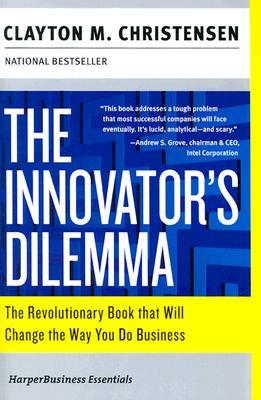
When I got involved in the startup community, I remember I used to see a book recommended over and over. That book was The Innovator's Dilemma.
The reason for the community's fixation on this book (along with some of the other books Steve Jobs recommended) is that it talks about a key aspect of a startup's life: the capacity to steal market share from the established, well-funded leaders in a given industry.
Clayton M. Christensen, a Harvard professor, explains that what killed companies like Kodak, Xerox, and Alcatel, among many others, was the prominence of new "disruptive technologies."
In order to avoid the dark fate of disappearance, successful companies need to work with managers to abandon traditional business practices and aim to innovate—before it's too late. New startups, on the other hand, needs to tap into those disruptive technologies in order to beat the existing giants.
Quotes:
- "Disruptive technologies typically enable new markets to emerge."
- "To succeed consistently, good managers need to be skilled not just in choosing, training, and motivating the right people for the right job, but in choosing, building, and preparing the right organization for the job as well."
- "Disruptive technology should be framed as a marketing challenge, not a technological one."
Get It Here
Source
Inside the Tornado, by Geoffrey A. Moore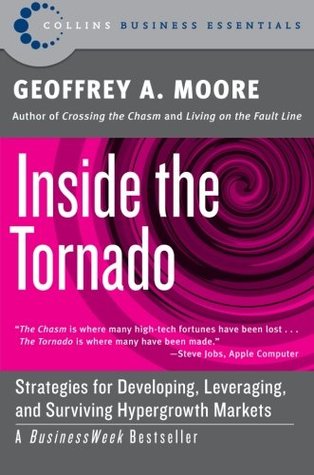
Along with The Innovator's Dilemma, another book that was recommended to me over and over within the tech entrepreneurial community was Inside the Tornado. According to its author, once a company "crosses the chasm," a concept he developed on another highly influential book, it needs to face the "tornado," a time where mainstream customers determine whether the product takes off or falls flat.
In this book, the author explains a diverse set of marketing strategies that will help you make sense of this chaotic time and take advantage of living inside the tornado.
Quotes:
- "The winning strategy does not just change as we move from stage to stage, it actually reverses the prior strategy."
Get It Here
Editor's note: We couldn't confirm 100% that this book was Jobs' favorite, but it's often associated with his philosophies.
Only the Paranoid Survive, by Andrew S. Grove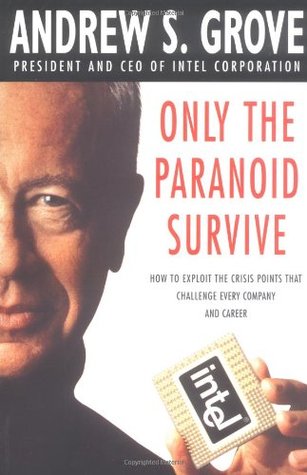
Nowadays, hardly anyone is aware of the key role Intel had in bringing the latest wave of thin laptops, smartphones, tablets, and wearables that you love so much. What all these devices have in common are their tiny yet extremely powerful microprocessors Intel developed for them.
The man responsible for pushing the microprocessor industry to the next level is Andrew "Andy" Grove, former CEO of Intel.
Source
In this book, Grove explains the philosophy of leading a company in a highly competitive industry where, as the book is appropriately called, "only the paranoid survive."
According to Grove, the critical moment every company needs to be aware of is the "Strategic Inflection Point," the point when the traditional rules of business go out the window. If you are able to make it to that point safely, your business will be able to win in the marketplace and emerge stronger than ever.
Quotes:
- "The Lesson is, we all need to expose ourselves to the winds of change."
- "Businesses fail either because they leave their customers or because their customer leaves them!"
- "People in the trenches are usually in touch with impending changes early."
Get It Here
Source
Business Books Recommended by Warren Buffett
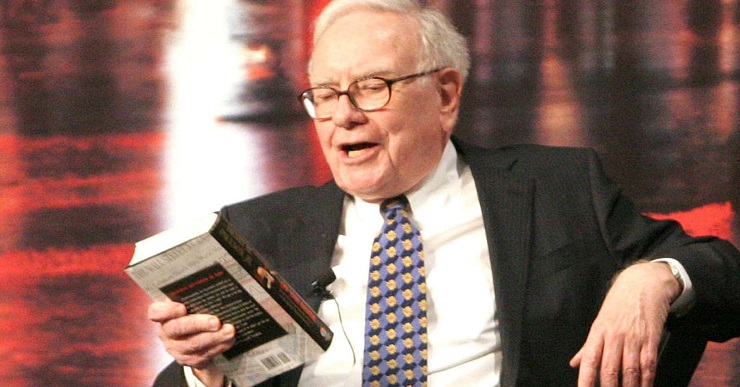
The Intelligent Investor, by Benjamin Graham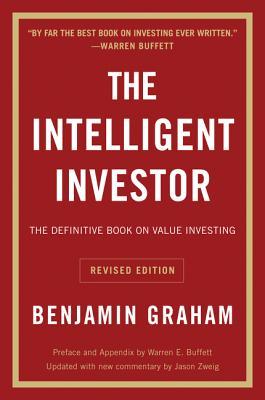
Before Warren Buffett became Warren Buffet, he was a young Columbia Business School graduate working for someone who has been called one of the greatest investment advisors of the 20th century, Benjamin Graham.
In this monumental book, Graham explains his philosophy of "value investing," an investment paradigm that consists of buying underpriced securities and holding them to maximize the long-term returns.
If you want to learn what Buffett learned from this book, then check out this video of the man himself:
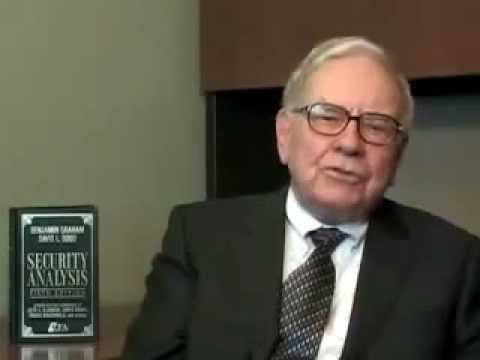
Quotes:
- "The intelligent investor is a realist who sells to optimists and buys from pessimists."
- "An investment operation is one which, upon thorough analysis, promises safety of principal and an adequate return. Operations not meeting these requirements are speculative."
- "Investing isn't about beating others at their game. It's about controlling yourself at your own game."
Get It Here
Common Stocks and Uncommon Profits, by Philip Fisher
Along with The Intelligent Investor, this book by a widely respected and admired investor has been incredibly influential in the world of finance.
In this book, Fisher explains how to increase an investment's value in the long term by concentrating on a few sets of outstanding firms with excellent management teams.
Fisher's investing philosophy is focused on investing in potential blue-chip stocks—the stock of a large, well established, and financially sound company that has operated for many years, like IBM or Apple—when they are still small. Once these stocks get to become a blue chip, you reap the results of your early investments. In order to get to see those stocks become blue-chip stocks, however, you need to play the long game, something Warren Buffett is famous for.
Buffett learned so much from this book that in the 2018 Berkshire Hathaway annual shareholdersmeeting, he called it a "very very good book," some of most enthusiastic words Buffett has ever shared publicly.
Quotes:
- "The greatest investment reward comes to those who by good luck or good sense find the occasional company that over the years can grow in sales and profits far more than industry as a whole. It further shows that when we believe we have found such a company we had better stick with it for a long period of time. It gives us a strong hint that such companies need not necessarily be young and small. Instead, regardless of size, what really counts is a management having both a determination to attain further important growth and an ability to bring its plans to completion."
- "Never promote someone who hasn't made some bad mistakes, because if you do, you are promoting someone who has never done anything."
- "One, which I mention several times elsewhere, is the need for patience if big profits are to be made from investment. Put another way, it is often easier to tell what will happen to the price of a stock than how much time will elapse before it happens. The other is the inherently deceptive nature of the stock market. Doing what everybody else is doing at the moment, and therefore what you have an almost irresistible urge to do, is often the wrong thing to do at all."
Get It Here
Jack: Straight from the Gut, by Jack Welch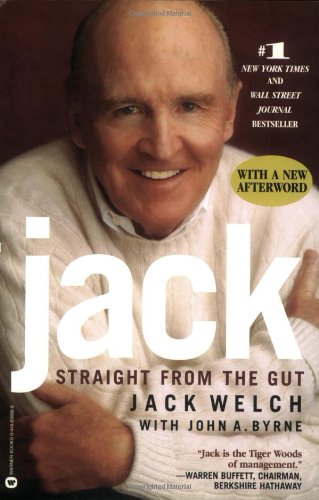
If you had to name a "traditional corporation," there's a decent chance you'd name General Electric. With more than 120 years of existence, this company is so old that in 1896, General Electric (GE) was one of the original 12 companies listed on the newly formed Dow Jones Industrial Average.
The author of this book was GE's CEO and chairman for 20 years, between 1981 and 2001. Considered by Fortuneas "The Manager of the Century," during his tenure, GE's value rose 4,000%. So yeah, he was a darn good manager.
Throughout his career, Welch defied the conventional wisdom prominent in the industrial behemoth and turned it into a lean engine of growth and innovation. This autobiography, while not a "how to" on running an enterprise, goes deep into the intricacies that what went on at GE that made it grow as much as it did.
Quotes:
- "Control your own Destiny or somebody else will."
- "Only satisfied customers can give people job security. Not companies."
Get It Here
Source
Richard Branson's Favorite Management Books

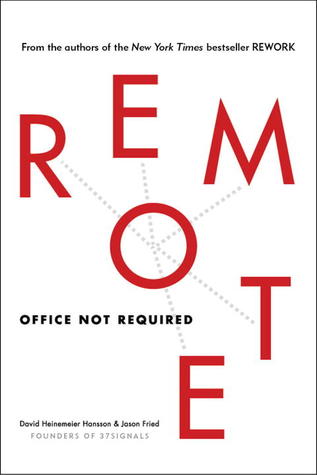
Remote: Office Not Required, by Jason Fried
At Foundr, we love remote work. As I write these words, I'm in Buenos Aires, while the rest of the team is distributed in cities as far as Boston, New York, Kuala Lumpur, and Melbourne, among many other cities around the world. The huge distances that set us apart haven't negatively impacted on our growth one bit—they have actually fostered it.
In this book, authors Jason Fried (Founder and CEO of Basecamp) and David Heinemeier Hansson (creator of the popular Ruby on Rails and partner at Basecamp) explain how the Industrial Revolution's "under one roof" model of conducting work isn't going to make it in the 21st century.
As they explain, companies should "move work to the workers, rather than workers to the workplace." By tapping the remote world, companies can increase their talent pool, reduce turnover, their real estate footprint, and improve the ability to conduct business across multiple time zones, just what Foundr has done.
Quotes:
- "You can't let your employees work from home out of fear they'll slack off without your supervision, you're a babysitter, not a manager. Remote work is very likely the least of your problems."
- "Meaningful work, creative work, thoughtful work, important work—this type of effort takes stretches of uninterrupted time to get into the zone. But in the modern office such long stretches just can't be found. Instead, it's just one interruption after another."
- "You'd be amazed how much quality collective thought can be captured using two simple tools: a voice connection and a shared screen."
Get It Here
Source
Start With Why, by Simon Sinek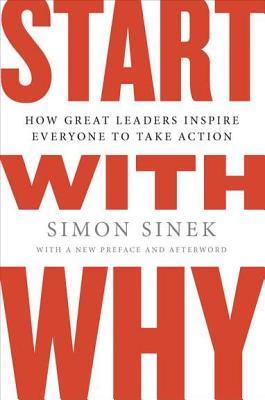
Have you ever asked yourself why you do what you do? If you haven't, then this book will ask you that so many times that you won't be able to avoid answering that question by the time you finish reading it.
Throughout this book, which was based on a popular TED talk, the author Simon Sinek explains how finding your why — your purpose — is what drives the success of all companies and entrepreneurs alike.
According to Sinek, people like Martin Luther King Jr., Steve Jobs, and the Wright Brothers all started with why, which is the reason they were able to change the world with little resources.
Some Amazon reviewers have said this book can be easily understood by watching the video above alone, but I believe reading through these pages will help you truly find your ultimate purpose. I know that, like Richard Branson, this book positively affected me in my finding my purpose.
Quotes:
- "People don't buy what you do; they buy why you do it. And what you do simply proves what you believe"
- "There are only two ways to influence human behavior: you can manipulate it or you can inspire it."
- "Great companies don't hire skilled people and motivate them, they hire already motivated people and inspire them."
Get It Here
Source
Scale Your Business the Richard Branson Way! Click Here to Get a Copy of Our FREE Print Magazine, "Scaling Branson Style"
To Thrive in Business, Cozy Up With a Great Book
If there's one habit you need to acquire to become a more successful entrepreneur, it's reading. You do have time to read, you only need to cut on the useless distractions—TV, social media, sports games—and devote even half an hour a day to reading.
These books have helped the modern era's most successful entrepreneurs step up their games, likely playing key roles in their successes.
Now that we're done with our list, here's what we recommend for you:
Pick three books from this list, buy, borrow, or check them out today (we have no affiliate links in here), and start reading them as soon as you have them. Your learning starts today.
What are your favorite business and management books? Share them in the comments below.
The post The 19 Best Business and Management Books, Recommended by Jobs, Buffet, Branson and More appeared first on Foundr.
]]>The post Can You Handle the Truth? Why Your Business Needs Some Brutal Honesty appeared first on Foundr.
]]>It brings up memories of confronting someone about a difficult situation or perhaps being confronted about something that made us feel deeply uncomfortable. We think of films and TV shows in which a little bit of untimely brutal honesty gets a character fired or dumped.
We imagine making a fool of ourselves or listening to harsh feedback we really don't want to hear. We imagine being called out or getting kicked when we're already down.
If all that sounds familiar, it's time to work through some of your fears and embrace the beauty of honesty.
In the entrepreneurial world, brutal honesty can be a powerful tool for taking your business to the next level. It is every bit as important as the "fail fast" startup mantra.
You can let yourself and loved ones live in a type of dream world, in which everyone smiles but nothing productive takes place, or you can get real and take monumental strides toward achieving your goals.
The difference comes down to your level of honesty.
In this article, we'll investigate two business scenarios in which brutal honesty is critical to success. By the end, you'll know why your business needs brutal honesty, and how to bring it into your workplace.
EXCLUSIVE FREE TRAINING: Successful Founders Teach You How to Start and Grow an Online Business
Two Directions of Brutal Honesty
There are many everyday situations that would be improved with a little more directness and honesty. But for the sake of providing actionable and specific advice in this article, we'll only dive deep into two.
- The first form of brutal honesty is with yourself. How do you take some of the bias out of your daily decision making? Are you really spending your time and strengths where they matter?
- The second form of brutal honesty is with your audience or customers. The more transparent you can be with them, the more closely they can connect with your vision.
Neither is easy. But with enough patience and practice with applying brutal honesty professionally, you can transform the way you live and run your business.
Let's dive into each form more thoroughly:
Being Honest With Yourself
We all know the moment in every drama film when a main character arrives at the conclusion that seemed painfully obvious to everyone else all along. I was wrong about ________ the whole time.
In the context of the film, the character usually has to go through some dark turn of events before they finally arrive at their moment of self-confrontation and self-realization.
In other words, life eventually forces the character to settle their score with the person in the mirror.
As an entrepreneur, it's inefficient to wait for life to break before you're jolted to awareness that there are problems to solve.
You should instead rely on checks and balances in your everyday that bring you to think honestly about situations, people, and decisions. It's the difference between betting the future of your business on deliberate, clear thinking versus waiting for serendipity or luck.
Here are some of those checks and balances you can put in place so you remain brutally honest with yourself:
Trade Serendipity for Systems
Ray Dalio, famed investor and one of the wealthiest people in the world, has become known in the business and finance world for many reasons. Perhaps the most peculiar is the way in which he implements brutal honesty as a system in his business.
Among his many keys to success, Dalio established systems for "radical transparency" among employees at his firm. If you read or listen to some of the stories of this radical transparency in action, it's hard not to feel embarrassed for everyone involved in almost every story. The straightforwardness sounds painful.
And the process of learning how to foster such blunt interpersonal communication was not easy. People working at his firm, Bridgewater Associates, often got their feelings hurt. Morale sometimes shot down.
What did Dalio do? He took patient steps to meet with each member of his company to find out the best way to communicate with them. These conversations transformed brutal honesty from one-off experiences to ongoing conversations. It became a mechanism people could expect rather than an occasional blip they never knew to expect.
Now, should you implement the same level of radical transparency as Bridgewater Associates?
For most workplaces, I'd argue that Dalio's are probably outlier practices. You can still have incredibly effective candor and straightforwardness without hurting feelings along the way.
Here's a rule to remember about brutal honesty: Invite it for yourself before you dish it out to others.
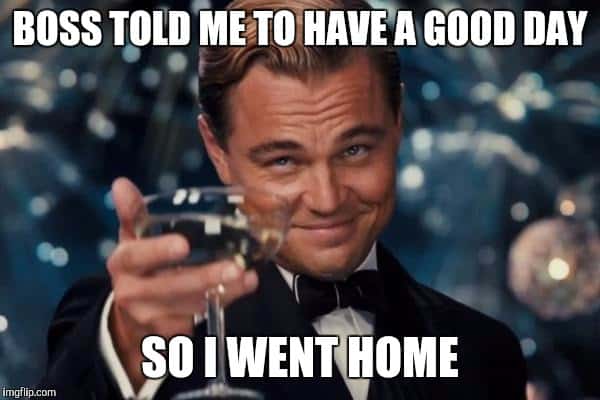 Source
Source
It's one thing to corner your employees one by one and say, "Let me tell you what I really think," and then start spewing unfriendliness out of nowhere.
Instead, you should begin by inviting brutal honesty toward yourself. What does this look like?
Check-in With Yourself
First, you need to be honest with the person in the mirror. But how do you muster that level of self-awareness?
With systems.
First, give yourself designated moments to check in. You can set a few alarms throughout the day. These will remind you to step back and consider what emotions are currently going on. Are you worried? Happy? Fearful? Angry?
Simply acknowledging the emotion gives you perspective for upcoming decisions. You'll have better awareness of where you're coming from in that moment. These can also interrupt projects and allow you to question whether you're the right person—with the right time and skill—to be doing this work.
Be Aware of Below-the-Surface Issues
Sarabeth and I are married and we run a business together. When one or both of us get upset during a conversation, we try to step back.
We ask ourselves: Am I actually upset about the topic at hand, or am I just hungry? Have I had enough sleep? Basically: what lizard-brain needs aren't being met?
Sometimes having basic needs unmet impacts the conversations we have and the decisions we make.
Remember the "You're not you when you're hungry" campaign from Snickers? The punchline is so funny because we all know it's true. Being aware of the emotions and the needs going on in your body can impact how you make decisions.
Be Specific
Making time for self reflection is important. But if you want to get the most out of these check-ins, you must be clear about what you're reflecting on. If you just ask how you're doing, in general, you're going to get general answers.
Instead, determine what you should reflect on.
- How am I doing with project allocation?
- Am I pulling my weight?
- Are my business and time priorities where they should be?
Hire a Personal Coach
A little self reflection goes a long way. But if you want to take your analysis to another level, you can hire a coach or find an accountability partner.
A good coach offers several benefits:
- Accountability on hard decisions and habits
- Performance feedback
- Regular check-ins to make sure you stay focused on what's important
Feedback Culture
Once you have the other elements in place, you can begin taking brutal honesty to work. Encourage employees to be brutally honest with you. You can do this by personally sitting down with each member of your team—like a kinder, gentler Ray Dalio—to tell them specifically the level of honesty you're looking for from them.

Being Honest With Your Audience or Customers
Authenticity is powerful. People are drawn to it. Many of us can tell when someone is authentic or disingenuous. As humans, we have a knack for noticing when we're being shown someone's true self versus when they have an ulterior motive.
If you can be authentic—brutally honest—with your customers, they'll notice the difference between you and your competitors.
Here's how that can play out.
Listening as a Content Marketing Strategy
Content marketing has become a very popular method for driving customers to buy products and follow brands. One of the underlying keys to successful content marketing is giving away as much value as possible for free to the reader or viewer.
How do you know what is valuable to your ideal reader or customer? You ask them.
Many people fear asking their subscribers such questions. They worry that by asking what their followers want—or why they follow you to begin with—readers will begin to question these things themselves, and ultimately unsubscribe.
Of course, this is a possible response when you're asking for brutal honesty. The honest truth might be that your brand doesn't really give them much value, so they tell you by unsubscribing.
But the more likely response is that you'll form a deeper connection with your reader. You're turning a monologue (your newsletter or blog) into a two-way conversation.
That conversation allows your followers and customers to tell you what they actually want to see or hear from you. Do they want additional courses about new subjects? Do they wish you offered white labeling in your software dashboard? Do they want to know the tactics and secrets you used to build your own company?
Until you ask, you'll never know what readers and customers want. But once you know, you can add exponentially more value to them.
Find Opportunities in Your Blindspots
Our natural tendency is to hide when we know something is wrong or when we've made a mistake. Asking for feedback after we've butchered something sounds like asking for further pain and punishment.
Yet often, the way out of mistakes is by proactively seeking feedback from others. Listening to others is how you choose your next direction.
Openness in Public Relations
One of the best examples of this type of communication came from Tylenol. In the 1980s, Tylenol ran into a public relations disaster. Someone had poisoned a few bottles of Tylenol in one city, resulting in multiple deaths.
Unsurprisingly, these deaths made national news. Johnson & Johnson (Tylenol's parent company) could have tried to weather the storm until the attention passed. They could have tried to lay low and remain silent while the world around their brand panicked, as many companies choose to do.
Instead, they took the literal opposite approach. Johnson & Johnson applied ample resources toward communicating with and listening to the public. They gave frequent press briefings, stationed people every day on the street to gather feedback from the public, and took product off the shelves globally.
What they learned: People felt unsafe buying Tylenol. This feedback sent Johnson & Johnson to begin experimenting with higher safety measures. The result was the three-tiered safety seals that are standard on almost all medicine today.
By listening to the brutal honesty of their customers during a hard time, Tylenol became one of the most popular painkillers on the market. They bolstered their brand by listening carefully to customers, even when times were very hard.
EXCLUSIVE FREE TRAINING: Successful Founders Teach You How to Start and Grow an Online Business
Communication is Key
To understand why your business needs brutal honesty, all you need to do is flip the script. Ask yourself: How do the companies I love, and gladly buy from, keep me so interested in their products?
For most of us, it's probably because these businesses make us feel understood, cared for, or listened to. These brands seem to go out of their way to improve our shopping or learning experience in ways that cater to our convenience and desires.
The secret is, these companies wouldn't know how to improve your shopping experience in these ways until they first stopped to learn what experiences you care about. In other words, the companies we love tend to invite brutal honesty from their followers because they know how critical that feedback is to their success.
Are you as honest as you could be in your life or business? Ever been too honest? Let's discuss in the comments.
The post Can You Handle the Truth? Why Your Business Needs Some Brutal Honesty appeared first on Foundr.
]]>The post Outsourcing Link Building? Where and How to Find the Best Partners for Your Growing Startup appeared first on Foundr.
]]>As the number of people searching for and buying products online continues to increase, it is almost impossible to grow your business if you have a weak online presence. This is why many startups use link building to increase their online visibility, improve their presence in search results, and gather prospects they can turn into leads and customers.
However, doing link building in-house often isn't a viable option for many firms that are still optimizing the core of their businesses, so they look to outsource link building to an agency.
And here's where the problems start.
There are more than 21,000 digital advertising agencies in the United States alone. How do you find the right partner to outsource something as sensitive as link building? How do you work with them to achieve success? Where do you even start?
If you stick with us until the end, in this article, we will teach you:
- the prerequisites for running a successful link-building campaign
- where to look for potential partners
- how to set up the review process
- how to work with a chosen digital agency to make the process as smooth as possible
EXCLUSIVE FREE TRAINING: Successful Founders Teach You How to Start and Grow an Online Business
Outsource Your Link Building to the Right Partner
Prerequisites for Running a Successful Link-Building Campaign
Where to Find Potential Partners
How to Set Up the Review Process
How to Narrow the Pool
Don't Settle Until You Find the Right Outsourced Link-Building Partner
Prerequisites for Running a Successful Link-Building Campaign
Before you start sending emails to link-building agencies asking them about their pricing options, there are a few important things you need to do to prepare.
Learn the Basics of Link Building
The reason for this is the same reason you need to know about cars if you are going to buy a used vehicle—so you do not get scammed.
Let's get one thing out of the way. Building links is hard, time-consuming work. There are many link-building agencies out there that are ready to cut corners to increase their profit margins.
To be able to recognize when some shady business is going on, here are the things you need to learn:
- the difference between on-page and off-page SEO
- the difference between follow and no follow links
- the most popular and effective link building strategies (if you are only interested in strategies, jump to chapter four)
- basics of SEO metrics used in link building (for evaluating sites worth getting links from)
For more general information on link building, read these in-depth guides hereand here.
You can't make a mistake with either, and if you want to be an overachiever, you can read both. You might have to clear your schedule to do it, but the return on this time investment will be well worth it in the long run.
Create Linkable Assets
If you carefully read any of the guides mentioned above, you will realize that, in order to successfully build links and increase your organic traffic, you first need to have content worth linking to.
If you have ever wondered why almost every website nowadays has a "guides" or "resources" section—this is your answer.
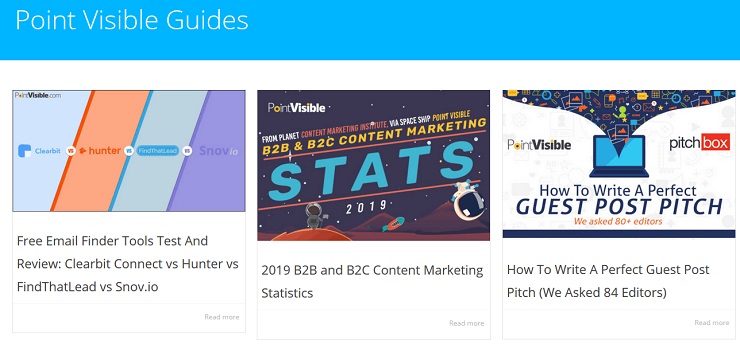 Here's a few examples of the kind of content we offer at my agency, Point Visible.
Here's a few examples of the kind of content we offer at my agency, Point Visible.
Editors and content managers love linking to content that offers valuable, relevant information.
However, many businesses want to just link to their service pages instead. While that technically can be done, it is usually a much more expensive approach, as people will ask for additional fees to link to your service pages. This also gets you in the realm of buying links, which goes against Google's guidelines and can result in a penalty.
To give you a better idea of why it is so important to have linkable assets, here is a brief outline of what an ideal link-building campaign would look like:
- Performing research to find keywords you can realistically rank for in search results. For some highly competitive keywords you need over 100 backlinks to one single page to get it into the top five search results, which can be a year's worth of backlinks for a small business. You obviously want to focus on something more achievable.
- Creating and publishing content (guide/infographic/resource list) that is optimized around the keyword you selected in the previous step.
- Building links towards that content. If possible, you should also look to promote it on social media, Quora, and other channels while you are working on link building.
If everything goes as planned, your organic traffic will increase, as people will find your resources while searching for answers that are related to your business. In many cases, this will be their first touch with your business and you will have to look for various techniques likelead magnets to pull them into your sales funnel.
As you can see, for maximum results, it is always a good idea to supplement your link building strategy with a content strategy that focuses on creating high-value, relevant content.
Get Into the Right Mindset
Link building is not a sprint, it is a mountainous hike. It takes a lot of preparation, the journey is long, and it takes time before you see the first results.
And here is the most valuable piece of advice you are going to get this week: Since link building is a long-term effort, the agencies you are going to test can't be evaluated based on the results of their work, only on their performance.

Does that freak you out a little? Let me explain.
Let's say you have $5,000 and you decide to test five link-building agencies, giving each $1,000 to build you a few links. With that budget, you can expect two to four backlinks on decent sites from each agency.
If you are focused on results, what do you plan to measure? How you're ranking in search results? Organic traffic? People mentioning your brand? Domain authority increase?
The answer should be none. That is because all of these metrics are influenced by numerous factors, and backlinks are just one part of the equation. It is almost impossible to evaluate and isolate the impact of two backlinks in the grand scheme of things.
If the sample is too small to measure results, what can you measure? Well, the whole purpose of this process is to find a legitimate and capable link-building agency, with an approach that matches your needs.
You do that by dissecting and evaluating an agency's link-building process. That is the mindset you need to have and that is something we will teach you how to do later in the article.
Where to Find Potential Partners
It would be nice if you could just Google "buy 100 quality backlinks," purchase what is offered in one of the first three results, and sit back and relax as your website traffic grows.
Unfortunately, this is not how proper link building works. Actually, if I had to make a list of the worst ways to outsource link building, this would probably be at the top because you need someone who can build you the links, not literally sell them.
So where does one start searching for agencies that offer link-building services? Finding agencies isn't that hard, choosing the right one is the tricky part.
Here are a few ways to make an initial list of agencies:
- Perform a Google search. You can search for phrases like "link building agency," "link building services," "outsource link building," "blogger outreach services," "guest posting services," and similar.
- Ask for recommendations. You often have business partners and acquaintances in the industry that are not your direct competitors. Everybody needs link building these days, so you can ask them if they know an agency they can recommend.
- Look for digital agency directories. Keep in mind though that most of the listed agencies here will be full-service marketing agencies, so there is a possibility that some of them don't offer link-building services in isolation. The screenshot below is from one such directory, called Digital Agency Network.
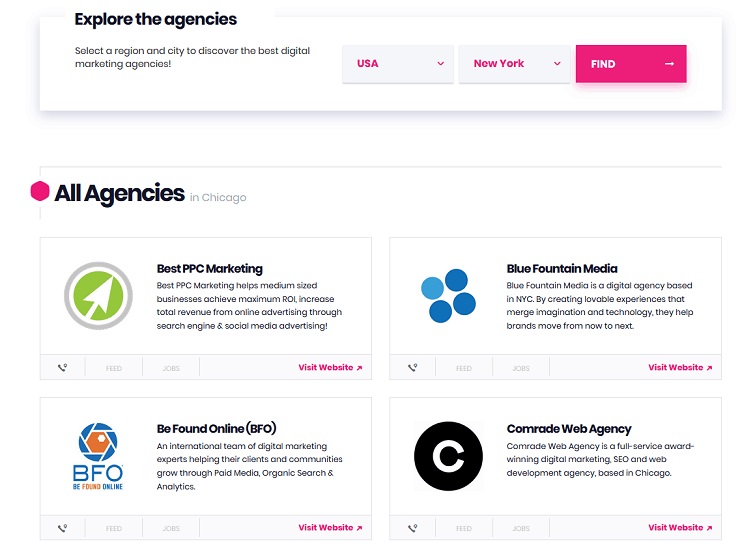
When you start your search, you might be confused by the variety of link-building services that are available and by the type of businesses that offer them. Here is a quick overview of those types:
1. Agencies offering exclusively blogger outreach/guest posting services
These are agencies that generally only offer a single type of link building called guest posting (also known as guest blogging and blogger outreach). This is not surprising as guest posting seems to be the most dominant link-building strategy for a few years now.
2. Link-building agencies
These agencies usually offer a wide variety of link-building strategies like resource page link building, infographic republishing, and broken link building. That being said, from our experience as a link-building agency, the vast majority of our clients want to focus on guest posting. As content creation is part of link building, a lot of these agencies can also create content for your blog if you're lacking in that regard.
3. Web design agencies that also offer SEO services
We've never had a chance to collaborate with this type of agency, but you will probably want to go with someone who has link building as a core service. A web design agency might be a preferred choice if the agency that designed your website can also do SEO and build links for you.
4. Full-service digital market agencies/content marketing agencies
Full-service digital agencies can cover all of your marketing needs. They often work on a monthly retainer that covers the whole marketing strategy. That includes content strategy, on-page and off-page SEO, paid advertising, social media management—basically everything that goes under the umbrella of marketing. As we mentioned earlier, some of them don't take clients that only need link building, so be sure to check that right away.
Now that you know where to look and what is on the market, let's see how to set up an efficient review process.
EXCLUSIVE FREE TRAINING: Successful Founders Teach You How to Start and Grow an Online Business
How to Set Up the Review Process
It is unlikely that the first agency you try out will be a perfect match. And with so many digital agencies around, you need to have a standard process for deciding if you should swipe left or right.
Set Up a Review Team
Every project manager will tell you that a task that doesn't have a due date and isn't assigned to any particular person is a task that is waiting to be indefinitely postponed.
We'll leave the scheduling up to you. And if you are one-person team, there isn't much to discuss here. However, if you are leading a small team and you have someone in charge of marketing, you and your marketing manager should both be on the review team.
You can, of course, include other team members, but make sure that everyone on the team has a basic understanding of SEO and knows what you are looking for.
Make a List of Things to Review
Preparing a list of questions you need answers to will accelerate your review process because it will ensure you have a standard workflow you and your review team can use to compare offers from different agencies and eliminate the ones that do not satisfy basic requirements.
There are a lot of things you can and should review, so we are going to discuss this in detail in one of the following chapters on how to make a shortlist.
Discuss and Define Your Budget (at Least Roughly)
When you go shopping for a new car, what is the first thing you use to narrow down your options? I bet it is the price.
The principle is the same here. By roughly defining how much you are willing to spend on link building, you can immediately eliminate services that are too expensive for you (or seem so cheap that you are pretty sure they offer subpar services).
Most agencies use pricing based on Domain Authority (DA). That means that you don't pay a fixed price per link, but that the price for a single link changes in regards to the "strength" of the website that is linking to your domain. So you will often find a pricing structure that looks something like this:
 Source
Source
As an agency that uses a similar pricing structure, here are the reasons we do this:
- It takes more time and effort to get published on higher authority sites. Sites with higher DA usually have more rigorous content guidelines and review processes, which means you have to put maximum effort into the quality of your content, be ready to do revisions if necessary, and spend a decent amount of time on back and forth communication. In some cases, you also need to submit a lengthy contributor application. All of this takes time, and time = money.
- Links from high DA sites bring more value. A few links from DA70+ sites can give a stronger SEO boost than five links from sites with DA ~30. On top of that, higher DA sites have much higher traffic, which means you often get more referral traffic and your brand gets bigger exposure.
- The pool of high DA sites is smaller. As you go up in authority, the number of available sites that could link to you shrinks significantly. When you exhaust the obvious choices, finding high authority, relevant sites that publish contributed content takes quite a bit of research, and that is partially reflected in the link-building pricing structures.
Besides deciding how much you are ready to pay for a single link, you should also decide on your available monthly budget. This is important because this will be one of the first questions an agency is going to ask you, as well as because some agencies won't work with you if your monthly budget is under a certain price point (the cutoff point often being at $1,000).
Lastly, having a monthly budget in mind will be an important part of the negotiations if you need other services alongside link building, like creating content (read linkable assets) for your blog.
How to Narrow the Pool
Let's discuss a few things you should ask the agencies you are in contact with, so you can properly shortlist the ones with the most potential.
1. Ask for Samples of Previous Work
Every agency should be able to show you some examples of their previous link-building campaigns. Even if they are fairly new, they must have been building links for their own site.
Check the following:
- quality of the sites given in the samples (domain authority, organic traffic)
- relevancy of those sites (do the topics seem like a match for the sites they are published on)
- quality of the published content (many agencies use cheap copywriters to reduce their content creation expenses)
If an agency can provide samples of different links they have built for other businesses in your industry, that is a big plus. Speaking from personal experience, when you lead a link-building campaign in a new niche, it takes some time to see what works and what doesn't.
2. Look at Their Reviews
If you are going to buy a new phone, you're probably going to read a few reviews first. There is no reason why you shouldn't do the same when researching someone you plan to outsource link building to.
You can look at the testimonials featured on their website, as well as reviews on consumer review sites like Trustpilot.
Keep in mind that some agencies will probably ask for reviews only from the clients they have good relationships with, which could mean their scores are somewhat inflated.
That being said, if someone was really dissatisfied with their service, they will probably go out of their way to leave a negative review. This means that even a few negative reviews can be a cause for concern.
3. Learn About Their Workflow and Link-Building Process
Just being qualified isn't enough. Finding someone you can efficiently collaborate with is a requirement for a long-lasting partnership.
It's like being on a date with a person that ticks all of your boxes, but you have no chemistry. Such a person can be a good friend, but will never be a perfect partner.
So how can you recognize if you are a good match?
Learn about their workflow and their link building process:
- Ask them to describe their link-building process – how they find good websites, how they come up with interesting topics, who writes the content…
- Ask how involved you're allowed to be – if you can pre-approve things like sites they reach out to, topics they plan to pitch, content they plan to publish…
- Ask how you can track the progress of the campaign – do they have a project management tool or something else you can use to track the progress of the campaign, do they offer detailed reports so you know exactly what your budget is being spent on…)
- Discuss any special requirements you might have
Getting answers to all of those questions should give you a good idea if the agency you're talking to is worth testing out.
4. Discuss Their Pricing
Last but not least, we have to talk about money.
We already discussed this to some extent in a previous section, so this will be quick.
One thing to watch out for when discussing pricing is long-term contracts. Some agencies will look to tie you down with six-month or one-year contracts. That may be fine if you've had the chance to properly test them first. Otherwise, stick to agencies that work on a month-to-month basis and don't ask you to sign any kind of retainers.
At the end of the day, most start-ups have fairly limited budgets for marketing purposes. If you can't afford someone's services, you obviously aren't a good match. If you have found someone you really like but they are just too expensive, keep their contact info and reach out when your budget grows.
Watch Out for Red Flags
There are a lot of shady link-building agencies that advertise themselves as doing everything by the book. In reality, many of them use private blog networks or have pre-developed relationships (know someone who regularly writes for the blogs they need links from) they leverage to build links for your site and just hope you don't understand that they are delivering poor service.
Here are some red flags you should watch out for during the review process:
- They do not want to jump on a call. If you are running a legitimate business, you have to be ready to jump on a voice chat and explain the details of your workflow.
- They offer insanely low pricing. When content creation itself costs between $30 and $150, anyone that offers links for less $100 has to cut corners somewhere. Quality has its price.
- They lack testimonials and case studies. Nine out of 10 marketers say that customer testimonials and case studies are the most effective content for influencing purchases. So if they have some, they would definitely display them.
- Their delivery time is crazy fast. Most reputable link-building agencies will tell you that your order will be fulfilled in one month. Target audience research, topic creation, finding relevant sites, pitching, creating content and waiting for the editor to find a place for it in his editorial calendar—it all takes time and some of it is out of your control. If the agency says it is doing manual outreach, it is impossible they can do all of this in just a few days.
- They offer you a list of sites you can get links from. If you are doing manual outreach, as many agencies swear they do, how can you be sure that the content will be accepted and published? The answer is you can't. That only happens if you have a preexisting relationship, which often means you are not following Google's guidelines.
- They say yes to every one of your demands. A good way to test an agency is to ask them if they can build you links on high-authority sites using keyword-rich anchors that lead to your money pages. If they say yes to this and every other demand without any reservations, this should be a cause for concern, because out there in the real world, editors have the final say on what gets linked.
EXCLUSIVE FREE TRAINING: Successful Founders Teach You How to Start and Grow an Online Business
Don't Settle Until You Find the Right Outsourced Link-Building Partner
Don't be hesitant to test multiple agencies. Quite the contrary, doing a round of testing will give you a better idea of what you can expect to get for different pricing.
As we mentioned above, link building is a long-term strategy. That is why it is important that you don't settle until you find a qualified partner you're comfortable with and can grow your business for years to come.
Did you have a chance to work with an agency you want to recommend? Maybe you want to share some bad experiences you had while testing different link-building agencies?
Start a discussion in the comments below and let other entrepreneurs know what they should expect if they decide to outsource link building for their business.
The post Outsourcing Link Building? Where and How to Find the Best Partners for Your Growing Startup appeared first on Foundr.
]]>The post A Guide to Choosing the Best City for Your Business (+ Customizable City-Scoring Spreadsheet) appeared first on Foundr.
]]>So if you are a young or otherwise adventurous entrepreneur deciding on where to start a business, you may be overwhelmed with possible choices. Maybe you want to move to a big, bustling city, but are concerned about the costs. Or you fear your hometown is too isolated. Then you meet someone who asks why you aren't in Silicon Valley, the mecca of the startup world.
You're not alone. This decision is causing a lot of people real anxiety.
That's why we're going to show you a decision-making tool you can use, on repeat, to score the compatibility of any city, for any business. You'll also get free Google Sheets templates you can tailor to score different cities, and we'll show you exactly how to use it.
EXCLUSIVE FREE TRAINING: Successful Founders Teach You How to Start and Grow an Online Business
Can You Decide Later?
You could, but changing your headquarters later is going to be costly. If you don't believe us, ask the guys at Grab, the ride-hailing unicorn.
Before acquiring Uber's Southeast Asia operations, they famously uprooted their headquarters from Kuala Lumpur, Malaysia, to Singapore. Imagine the cost and pain of moving your entire HQ to another city, a couple years after setting everything up. Ouch.
Let's take a look at our scoring system and how to fill out the spreadsheet so you can choose the best place to start your business.
The Core Principle and Concepts of Scoring Cities
The fundamental rule behind our scoring system is that a city's score on any criteria is a function of two things (Importance and Strength).
A city's score on any criteria = Importance x Strength

When you are going through each criterion for a city, you will score it based on these two parameters:
Importance
We use a 5-point scale to judge a criteria's importance, where 1 means this criteria is not at all important to your business, and 5 means it is very important.
Let's say you're developing a technology product and your business cannot take flight without a dedicated team of developers. If that's the case, then the access to talented developers in a city is very important. You'd give this criteria an importance score of 5.
Strength
How strong is a particular city in the same criteria? Again, we use a 5-point scale, where 1 means very weak, and 5 means very strong. You'll need to do a bit of research to give cities a strength score.
Let's say that you know that both City A and City B have vibrant tech scenes with large pools of talented developers. But what about salaries? An easy way to check this is to hop onto Glassdoor and compare the salaries of full stack developers in both cities.
After a bit of internet sleuthing, you have found that City A's large pool of talented developers have relatively affordable salaries—it gets a strength score of 5. City B also has a large pool of talented developers but they're more expensive—it gets a strength score of 4.
Multiply the importance and strength scores to get the city's score:
City A's Score = 5 (importance of criteria) x 5 (strength) = 25
City B's Score = 5 (importance of criteria) x 4 (strength) = 20
Your Criteria for the Best Cities to Start Your Business In
We recommend taking a couple of days to write down everything that comes to mind as possible factors that influence where you locate your business. These can be things like corporate tax rates or personal lifestyle factors like whether a city has a vibrant arts scene. We find stretching the process out over a few days helps ensure as many criteria as possible comes to mind.
When you're done, with a clear mind and a strong cup of coffee, go through the list. Try to do this within a couple of days, while your initial list is still fresh in your head. You might realize some criteria are repetitive, in which case, remove them, then segment the remaining criteria into two broad buckets.
Now let's go through each of the criteria that will help you score a city. They are organized into buckets.
Bucket 1: General Business Conditions
These are things that you should look at regardless of what your industry and business model is. We'll run through a few of these.
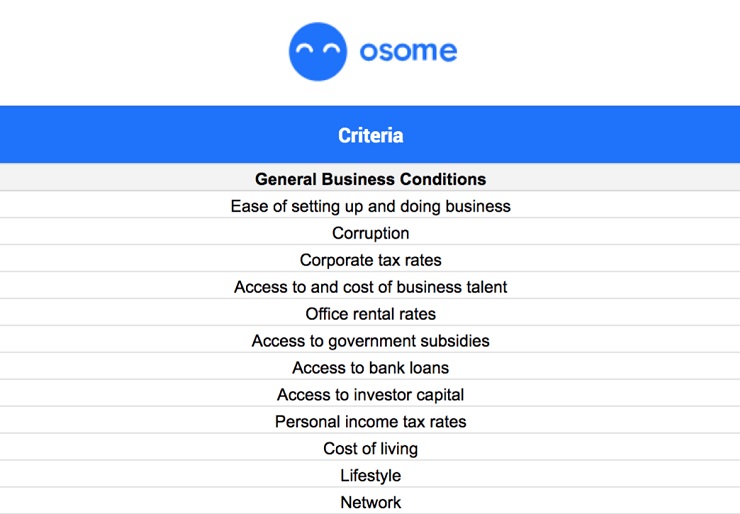
Ease of Setting Up and Doing Business
There are normally costs involved with registering and incorporating a company. Time taken to complete all the paperwork, license applications, and get approval also varies from city to city. The strength of a city's regulations and legal system also impacts business (based on how the courts apply the law and options for resolving disputes).
The easiest way to score a city on this criteria is to use the World Bank's Ease of Doing Business Index Rank. The index considers the ease of starting a business, getting credit, trading across borders, enforcing legal contracts, and so on.
Corruption
Corruption can cost your business time and money. Transparency International's Corruption Perceptions Index is a good way to get this information quickly. The index ranks 180 countries by their perceived public sector corruption, based on scores by experts and businesspeople.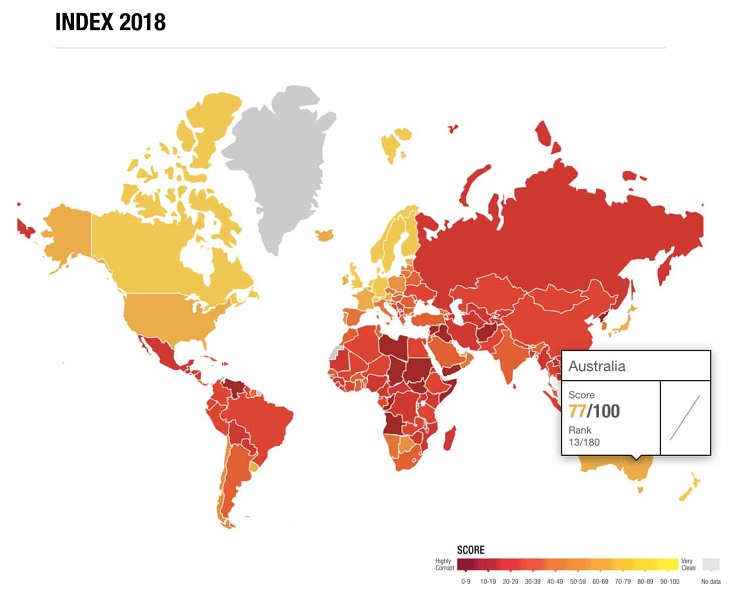
Transparency International: Corruption Perceptions Index 2018 Map
Corporate Tax Rates
This criteria needs no introduction and thankfully, not much Googling to find out.
Access to and Cost of Talent
We're looking specifically at talent for general business functions, like finance, marketing, etc. Good sources of information for salary rates are reports by recruitment firms, and Glassdoor.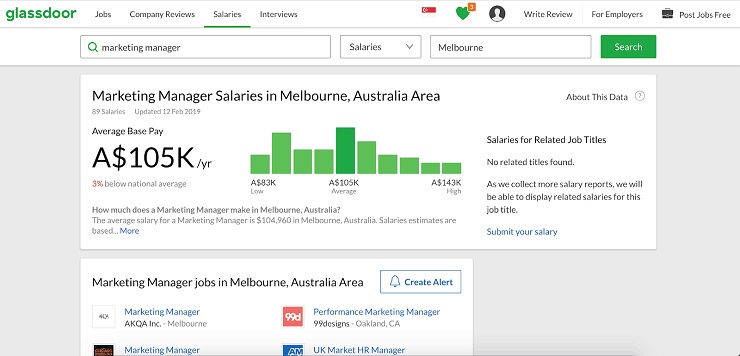
Glassdoor: Average Base Pay of Marketing Managers in Melbourne, Australia.
Office rental rates
Look into the cost of desks at a coworking spaces like WeWorkor at incubators that will provide space, training, and networking to get you on your feet.
Access to Capital
Lack of capital is one of the top reasons why businesses fail, so this criteria is likely to be high in importance. There are several ways you can raise funds for your business, but we'll look specifically at those that are impacted by your city choice—government subsidies, a bank loan and investor capital.
Access to Government Subsidies
Many cities have schemes and subsidies to support startups. Some may involve lots of checks, reporting requirements, and paperwork. Check if your business will be eligible, and if it's worth the extra effort.
Access to Bank Loans
Most banks provide financing for businesses, either working capital loans or funding. Working capital loans help you cover day-to-day operational costs, like wages. Funding from a bank works similarly to raising money from other investors—you'll need to share valuation details, a business plan, and a project report.
The easiest way to score a city is to take the top business loan, look at their requirements and terms, and score a city based on that.
- Check eligibility requirements: Some loans might require applicant companies to have minimum levels of revenue, and more.
- Maximum loan amount: This may vary depending on your industry.
- Maximum loan repayment period
- Costs of the loan: Loans typically come with interest, and a processing fee. Some loans will also have a penalty for early repayment.
Access to Investor Capital
This is especially relevant for startups that want investment from angel investors, venture capital (VC) firms, family trusts, institutional investors, and more. If that is the case, you'll want to be in a city that has more investors based there. Raising funds requires lots of wooing (think six months to a year).
You'll need to pitch to them in person, get an offer, negotiate, and so on. The process is challenging, even when you're in close proximity.
Do a quick search for VC firms in the city you're interested in.
Personal Income Tax Rates, Cost of Living, Lifestyle
Wait, aren't these personal considerations? They are, but they impact you and your employees' take-home income and quality of life. These all affect your ability to attract world-class talent.
From a practical standpoint, high tax rates might mean your business needs to pay your employees more so they get an attractive take-home wage and quality of life, and vice versa. A city with an attractive lifestyle or vibrant cultural scene can also help you attract talent from overseas, and compensate for the move or lower salaries.
An easy way to find out about the cost of living is to use comprehensive ranking, like this one by Mercer.
 Mercer: 2019 City Ranking based on Cost of Living
Mercer: 2019 City Ranking based on Cost of Living
Network
Launching and running a business is easier if you have a strong network. If you're new to a city, you can build up your network, but that means more time and energy needs to be spent on that.
Bucket 2: Business-Specific Considerations
Different business models require different criteria. For example, warehousing and logistics infrastructure probably matters to an ecommerce brand, but not to a mobile app developer.
In the following sections, we'll run through specific examples for an ecommerce empire and a SaaS startup. We will focus more on business-specific considerations for each scenario.
Each scenario's list of criteria is non-exhaustive, and while we've included scores for each city's strength, these are by no means "the law" and you should score each city's strength on your own too.
Feel free to skip around to sections you find most relevant.
Scenario A: Where to Launch an Ecommerce Empire
Here, we'll run through the process and templatefor a hypothetical ecommerce business that we'll call Acme Snaps.
Acme Snaps is deciding where they should set up—Melbourne or Hong Kong. The business is independently funded, with no interest in outside investment. They sell amazing snapback designs, working with designers globally, and manufacturers in China. To start, their target customers are streetwear lovers in Australia and Hong Kong. Founder Jon currently lives in Melbourne, and is passionate about fashion and streetwear. Living in a city with a vibrant culture and amazing food culture is important to him, personally. He also likes to stay active outdoors, and surfing and hiking help him relax.
We'll quickly run through the rationale behind how we scored general business conditions on importance, and spend more time on the ecommerce specific factors.
EXCLUSIVE FREE TRAINING: Successful Founders Teach You How to Start and Grow an Online Business
Deciding Which General Business Conditions Are Important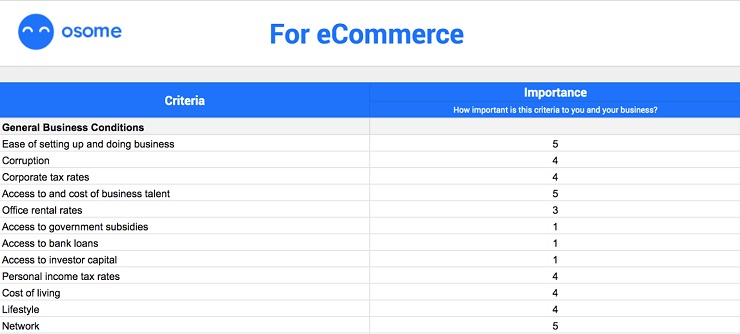
Scoring on General Business Conditions for Acme Snaps
Ecommerce is highly competitive, and when you combine that with fashion, you want to be able to move fast. The easier it is to get set up and going, the better for Acme Snaps.
Initially, Acme Snaps will run on a lean team and won't need a huge office, so office rentals are not a worry. Later, Jon will need business talent to help him and to scale the business. He'll want to have a large pool of talent to recruit from. If he needs to make overseas hires, it'll be easier to attract them if Acme Snaps is based in a fun city with reasonable personal income taxes and cost of living.
Being based in a city that has a strong fashion scene may also help Jon get traction with early adopters within the city and across the globe. On a personal level, a city's lifestyle is important to Jon (remember his interests: city life with outdoor activities and a great food scene).
Acme Snaps is independently funded, but Jon will still need to work with local business partners, key opinion leaders, and influencers in the city. It's easier if you already have a strong global and local network. Since Jon would be new to Hong Kong, the city scores weaker in this department.
Ranking Ecommerce-Specific Criteria:
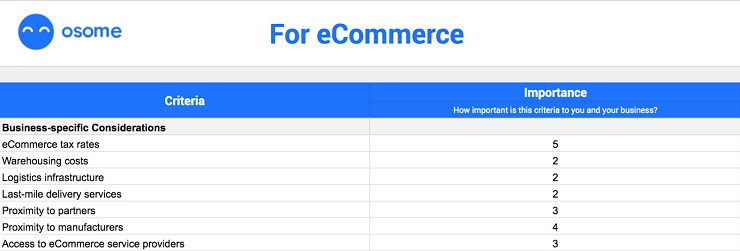 Scoring on Business-specific Considerations for Acme Snaps
Scoring on Business-specific Considerations for Acme Snaps
Ecommerce Tax
Some cities require ecommerce businesses to charge sales tax. This means that you may need to charge your customers extra or absorb the taxes. Either way, it will impact your operational costs or product price point. We think this is very important – 5.
Melbourne scores 2 and Hong Kong scores 5:
From 1 July 2018, non-resident ecommerce sellers have to register for GST with the Australian government, and charge 10% tax on any B2C sales to Australia, from overseas, if they have Australian revenue of over AU$75,000 per year. In contrast, Hong Kong does not have any VAT or GST.
Warehousing Costs, Logistics Infrastructure, Last-Mile Delivery Services
The importance of these factors varies depending on your exact business model.
In Acme Snap's case, they're adopting a drop-shipping model. Their manufacturer will take care of production, warehousing, and drop-shipping of the item to the end customer, once an online order has been placed. Acme Snaps might need to store some stock on hand, but they won't need to rent tonnes of warehouse space for that. That's why we've ranked these items as unimportant – 2.
On the other hand, if you are taking charge of warehousing and shipping, then you need a city with good warehousing options, reasonable costs, strong logistics infrastructure, and access to last-mile delivery services. These factors would all be very important, so more like a 5.
Melbourne scores 4 and Hong Kong scores 2 on Warehousing:
Melbourne has had 2 million square meters of warehouse space added to its arsenal since 2014, while Hong Kong is famously land scarce.
A quick check of business, self-storage rental rates revealed:
- Hong Kong: starts from A$5.69 per square feet in Kowloon City, per month
- Melbourne: starts from A$3.27 per square feet in South Wharf, per month
Melbourne scores 3 and Hong Kong scores 4 on Logistics Infrastructure:
Melbourne has great facilities. It is Australia's second-largest port and has a major airport to support air cargo services. However, Hong Kong is much stronger here, as it is a free port with massive connectivity to the rest of the world. They have a logistics hub on Lantau island, just two minutes from the airport and 40 minutes from China. Hong Kong International Airport is also one of the world's largest air cargo hubs.
Proximity to Partners
Jon works with talented designers from around the world, to produce amazing designs for Acme Snaps. Jon occasionally travels to meet with them but mainly uses communication technology—FaceTime, Skype, etc.—for discussions. We score this as neither important nor unimportant – 3.
Melbourne scores 4 and Hong Kong scores 5:
Both are major cities served by major airlines and have strong internet infrastructure. Hong Kong has a slight advantage as it's an important transit point for international flights.
Proximity to Manufacturers
Jon frequently communicates with the manufacturer using WeChat, and the production process for Acme's snapbacks requires trips to China every quarter to ensure design and quality standards are satisfactory. Being closer would make things easier, but isn't the most important factor. We score this as important – 4.
Melbourne scores 2 and Hong Kong scores 5:
Hong Kong is the clear winner when it comes to proximity to China.
Access to Ecommerce Service Providers
We give this a score of 3, neither important nor unimportant. Your access to ecommerce service providers like Squarespace, web hosting, payment processing services is not limited by geography.
Both Melbourne and Hong Kong score 5:
Your access to ecommerce service providers is equally strong in either of these cities.
Final Scores for Melbourne and Hong Kong
The templateautomatically calculates Melbourne and Hong Kong's scores on each criterion, so you don't have to do anything here.

You've done 90% of the work of deciding now. Each city's score is the sum of their score on every criteria. It's a tough fight but Hong Kong has slightly edged out Melbourne here. All Acme Snaps need to do now is to make a decision and get cracking on registering and incorporating their business!
Scenario B: A B2B Marketing Tech SaaS Startup
Now, let's imagine we are setting up a SaaS startup we'll call Magnificent. You can follow along again with the city scoring template.
Magnificent is a B2B SaaS startup co-founded by Maggie and Mike. After months of hard coding by Mike, they have an early prototype for their marketing technology. They're ready to incorporate and also raise funds from investors so they can build a full-featured product. The next stage will be to bring clients from across Asia Pacific on board and then grow, grow, grow! They have more network and connections in Sydney but are also considering starting up in Singapore.
We'll quickly run through the rationale behind how we scored general business conditions on importance, and spend more time on factors specific to a B2B technology startup.
Deciding Which General Business Conditions Are Important
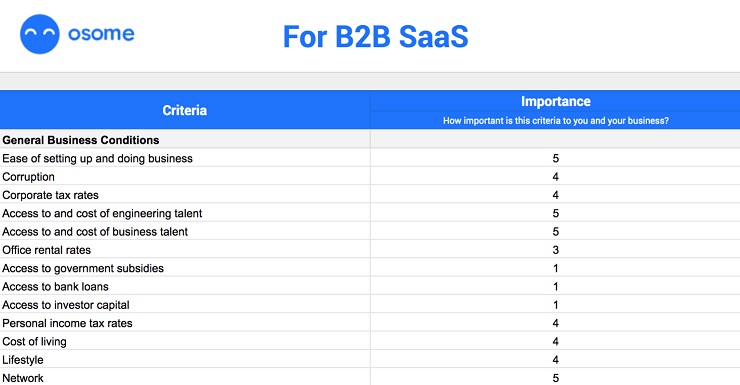 Scoring on General Business Conditions for Magnificent
Scoring on General Business Conditions for Magnificent
B2B SaaS is big business, and Magnificent hopes to be making deals with clients from all over Asia Pacific. Being incorporated in a city where it's easy to set up a business and there are strong legal and regulatory systems (in case of contract disputes) will be extremely important.
Magnificent is also going to need lots of capital to move forward. In particular, they're after investments from angel investors and VC firms, so access to investor capital is a deal-breaker.
Maggie and Mike will use the capital raised to beef up their tech and engineering team and build their product. Once their product is ready, they'll bring on new business talent to help market, sell, and grow.
That's why we've rated these factors as:
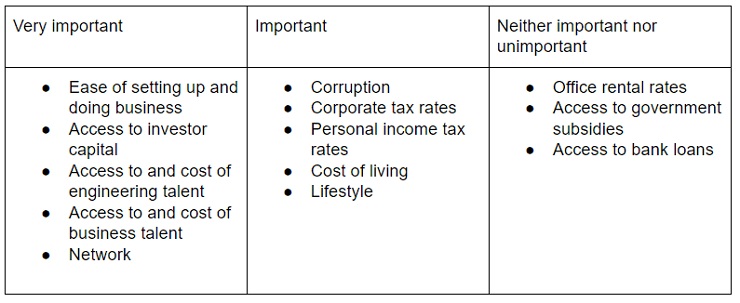
Ranking B2B SaaS-Specific Criteria
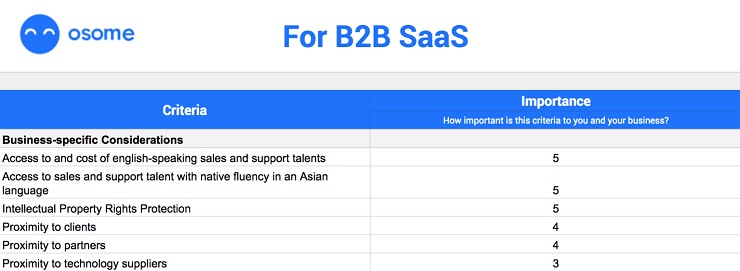 Scoring on Business-specific Considerations for Magnificent
Scoring on Business-specific Considerations for Magnificent
Access to and Cost of English-Speaking Sales and Support Talents
The importance of this factor depends on your exact B2B model—are you planning to have a self-serve SaaS model or a high-touch one? The latter requires a larger sales force, in which case, your access to quality sales talent is going to be a bottleneck.
Even in the case of the former, your self-serve model will probably start with a predominantly manual version and will still require supervision and intervention.
In this case, Magnificent is targeting clients in Asia Pacific whom they believe value that high-touch approach. This factor scores as very important – 5.
Sydney scores 5 and Singapore scores 4:
Both cities have plenty of English speakers. In terms of cost, the annual salary for Head of Sales roles in both cities seem generally well matched. Sydney scores a little higher because of its strength in quality customer support talents.
Access to Sales and Support Talent with Native Fluency in an Asian Language
The importance of this similarly depends on whether you have a self-serve or high-touch model, but is also dependent on your target consumer—are native-language speakers a must? Or are most of your target clients English speaking?
In Magnificent's case, they're targeting clients across Asia Pacific, including clients in China, Japan, Vietnam, Indonesia, Thailand, and more. They'll need sales and customer support talents with native-speaker fluency (who also speak English) to have any hope of clinching deals and keeping customers happy.
This factor gets a 5.
Sydney scores 4 and Singapore scores 5:
As one of Australia's largest cities and the capital city of New South Wales, Sydney is a diverse, metropolitan city. In fact, the most common languages spoken at home, aside from English, are Arabic (spoken by 4.4% of the population), Cantonese (3.4%), Mandarin (2.6%), Greek (2.2%) and Vietnamese (2.0%).
Singapore, however, is stronger in this criteria:
- 73.2% of its population speaks two or more languages, against 60.8% of Sydney's residents who only speak English.
- 34.9% of Singapore's residents speak Mandarin at home.
- Over 90% of its new citizens and Permanent Residents in 2018 came from Southeast Asia and Asia.
Intellectual Property Rights Protection
Since Magnificent is developing its own proprietary marketing technology, intellectual property rights (IPRs) like patents and copyrights are very important to them. It ensures that Magnificent can protect and benefit from their hard work, since it grants them a temporary, exclusive use of their patented technology, and prevents copycats.
Sydney scores 5 and Singapore scores 5:
According to the Intellectual Property Rights Index, Australia is ranked seventh globally and Singapore is ranked fifth. Both cities get a strength score of 5 – very strong.
Proximity to Clients
Once Magnificent gets their product up and running, they'll need clients and revenue. They're targeting mainly small- and medium-sized enterprises across Asia Pacific and also hope to clinch a few enterprise clients as well. Proximity to clients gets a 4.
Sydney scores 4 and Singapore scores 5:
Luckily, both Australia and Southeast Asia have vibrant startup scenes and plenty of unicorns and multinational corporations. Both Sydney and Singapore are major cities with plenty of international flights, however, Singapore scores stronger here because it's a significantly shorter flight away from other Asia Pacific cities.
Proximity to Partners
Magnificent is in the business of marketing technology, so it makes sense to be close to and have access to key players in marketing and advertising, from top agencies to the likes of Facebook. This get an importance score of 4.
Sydney scores 4 and Singapore scores 5:
As major cities, Singapore and Sydney provide access to heavyweights like Facebook, Google, and Apple. Singapore does however house the APAC headquarters for Facebook and Google and hence gets a stronger score.
Proximity to Technology Suppliers
We give this a score of 3, neither important nor unimportant. Your access to technology vendors or even a lead-nurturing tool is not dependent on your location.
Both Sydney and Singapore score 5.
Final Scores for Sydney and Singapore
The templateautomatically calculates Sydney and Singapore's scores on each criterion, so you don't have to do anything here.

You're almost done. Each city's score is the sum of their score on every criterion and this gets calculated automatically. In this example, Sydney edged out Singapore on general business conditions but Singapore scored higher when it comes to B2B SaaS-specific criteria.
All Magnificent has to do now is to make a decision and press on! Whether they decide on Sydney or Singapore, this exercise has one additional benefit. They now know how their startup location impacts their strengths and weaknesses as a business, and can make sure to address their weaknesses with planning and strategy.
EXCLUSIVE FREE TRAINING: Successful Founders Teach You How to Start and Grow an Online Business
Using This Template for Other Industries
This templateis completely customizable for any industry and any business. The same scoring principle of Importance x Strength can be used to help you with your decision-making process on the best cities to start a business.
Ready to find the best city to set up your business? Leave us a comment below once you've tried out our scoring template and let us know which city stood out for you, or if you have any other questions we can help you with!
The post A Guide to Choosing the Best City for Your Business (+ Customizable City-Scoring Spreadsheet) appeared first on Foundr.
]]>The post How to Find Product/Market Fit for Your Startup appeared first on Foundr.
]]>You see their reactions, their behaviors, and much to your dismay, you realize they're not interested in it. At all.
It's the tragedy of startups—an ambitious, forward-thinking entrepreneur spends months creating a product that nobody likes, needs, or cares for. Or maybe people do use the product, but they're not willing to spend any money on it, which is even sadder in its own way.
In order to avoid this issue, you have to understand the power of "product/market fit."
If you're not sure what this is, or exactly how you can leverage the concept to ensure you're launching a scalable, profitable startup—this article is for you.
Here, we'll clearly lay out what product/market fit is, how to achieve it, and how to know when you've got it.
Let's get started.
Find Product/Market Fit
Product/Market Fit, Defined by a Startup Legend
How to Find Product/Market Fit
How to Measure Your Product/Market Fit
Conclusion
FREE MASTERCLASS: How To Start a Tech Startup And Get Your First Customer In 60 Days
Product/Market Fit, Defined by a Startup Legend
Marc Andreessen is one of Silicon Valley's most respected and sought after venture capitalists. Responsible for founding two large and successful tech startups—Netscape and Opsware—in the late 2000s, he became an influential thinker in the space through his blog,pmarca.
In what's likely the most influential post he wrote, which he appropriately called "The only thing that matters," Andressen explains the most important thing that any new startup needs to have in place to succeed.
According to Andreessen, there are three possible answers to the question of what leads to success in a new startup:
- The team
- The product
- The market
Most entrepreneurs will say the team is the most important of those three. Without that, they'll say, you can't figure out what to offer, how to build it, and how to sell it to others.
Fair enough, but what about the product? Engineers tend to say the right product leads to success in a startup. Nail the product, and you can achieve success fairly easily, or so they say.
Andreessen didn't agree with either assessment. In his opinion, "the market pulls the product out of the startup." That is, given the right market—a market with lots of real potential customers—people will fulfill their needs with "the first viable product that comes along."
Instead of focusing on creating the perfect product for a given audience, Andreessen believes a startup founder needs to focus on developing, in the words of Eric Ries, "a minimum viable product"—or MVP for short.
As Andressen puts it, "The product doesn't need to be great; it just has to basically work. And, the market doesn't care how good the team is, as long as the team can produce that viable product."
As a startup founder, your job isn't to focus on building a great team or building a great product—those are great goals on and in themselves which you should eventually focus on. But when you're just getting started, you want to build the thing that makes people, in the words of Andreessen, "knock down your door to get the product."
He summarized this point in what he called Rachleff's Law of Startup Success: the #1 company killer is lack of market.
As a corollary to Rachleff's law, and the ultimate point of his article, Andreessen defined the only thing that matters for any startup founder is to get to product/market fit.
Your job is to find the market that wants the product you are building—not the one you've already built. As you build the product, you need to find the people who will use it, take their feedback, and make it better until the market can't live without your product.
In the simplest terms, "product/market fit means being in a good market with a product that can satisfy that market."
When you fail to achieve product/market fit, the market's answer will be clear:
The customers aren't quite getting value out of the product, word of mouth isn't spreading, usage isn't growing that fast, press reviews are kind of "blah", the sales cycle takes too long, and lots of deals never close.
On the contrary, when you've found product/market fit, Andreessen explains:
The customers are buying the product just as fast as you can make it—or usage is growing just as fast as you can add more servers. Money from customers is piling up in your company checking account. You're hiring sales and customer support staff as fast as you can. Reporters are calling because they've heard about your hot new thing and they want to talk to you about it. You start getting entrepreneur of the year awards from Harvard Business School. Investment bankers are staking out your house.
This is all easier said than done, as product/market fit isn't some clear metric you can total up, like revenue or user acquisition. This is where many startup founders get confused, and that's why we need to go over some ways you can achieve product/market fit and then how to measure how strong it is.
How to Find Product/Market Fit
Find Your Value Hypothesis
The core of product/market fit is value. If customers aren't finding any value from the offer of a startup, then the startup won't be able to sustain itself for long. Crystalizing the value the customer gets from a startup is understandably hard for entrepreneurs; value, after all, is an ambiguous concept that varies from person to person.
But Steve Blank, one of the godfathers of the startup movement, famous for his book The Four Steps to the Epiphany , and Eric Ries, another highly influential figure responsible for writing The Lean Startup , have developed a key concept that simplifies the process of finding a startup's value offer.
Ries says the two most important assumptions entrepreneurs make are the value hypothesis and the growth hypothesis. The former "tests whether a product or service really delivers value to customers once they are using it," whereas the latter "tests how new customers will discover a product or service."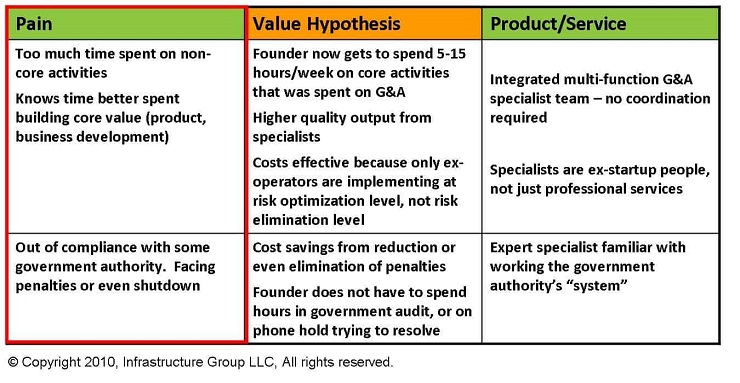
Source
On this note, Wealthfront CEOAndy Rachleff said: "Identifying a compelling value hypothesis is what I call finding product/market fit. A value hypothesis addresses both the features and business model required to entice a customer to buy your product."
In other words, find the value hypothesis, test it, and if it proves right, then you've found your product/market fit.
To test a value hypothesis, you first need to define it—a testable statement that can be validated or refuted when facing your users.
If Foundr was to develop a value hypothesis, we could say, "Foundr believes entrepreneurs need content that helps them launch and grow their online businesses."
To test this hypothesis, we'd need to create content and see if people find it useful in their journeys to launch their online businesses. The same could be applied to our premium courses. If people read our content, shared it, linked to it, commented on it, and bought our courses, then we'd be able to verify our value hypothesis.
In order to test your value hypothesis, you need to apply Steve Blank's concept of "getting out of the building."
In a startup no facts exist inside the building, only opinions. You need to leave guesswork behind and get "outside the building" in order to learn what the high-value customer problems are, what about your product solves these problems, and who specifically are your customer and user (for example, Who has the power to make or influence the buying decision and who will use the product on a daily basis?).
Talk to your customers one on one and discover how they react to your company. Write down what they tell you, record their reactions, and avoid pushing back. Honest customer feedback is the best ingredient for validation, regardless of how painful it may be for its founders to find their original hypothesis is no good.
You can also run experiments, like doing A/B testing and fast iterations of different features. These experiments work great because you can assess the true actions users take. What's more, you can use cohort analysis, which means you analyze how different batches of users from different markets are behaving.
Ries uses the example of a volunteering software tool to explain this idea:
We could find opportunities for a small number of employees to volunteer and then look at the retention rate of those employees. How many of them sign up to volunteer again? When an employee voluntarily invests their time and attention in this program, that is a strong indicator that they find it valuable.
Your value hypothesis will change over time. As you learn from your customers, you will improve it and refine it. The closer you get to the market's real needs and pains, the better the chances of getting to product/market fit.
Choose the Right Industry
Going out into the world to test out an innovative software company can be expensive and time consuming. So before you even get to the point of testing your value hypothesis, think about the industry you've chosen.
Andrew Chen, the famous VC and entrepreneur,recommendspicking an industry that fits the following criteria:
A Pre-Existing Product Category
Even when starting a highly innovative business, you want people to understand what it is right away. That's why businesses overuse the pitch, "It's the Uber of ."
The "uberification," asindustry experts have called it, has caused many new companies to start with the premise of disrupting an industry through the gig economy, just as Uber did for the taxi industry. Before Uber, startup founders used to say, "It's like for ," which also spawned a lot of new startups to try their luck at disrupting a particular field.
In either case, what entrepreneurs tried to do was take an existing category and use that as an anchor for a new startup. Regardless of theweird startups this approach has spawned, Andrew Chen believes it's a smart way of starting a new innovative company.
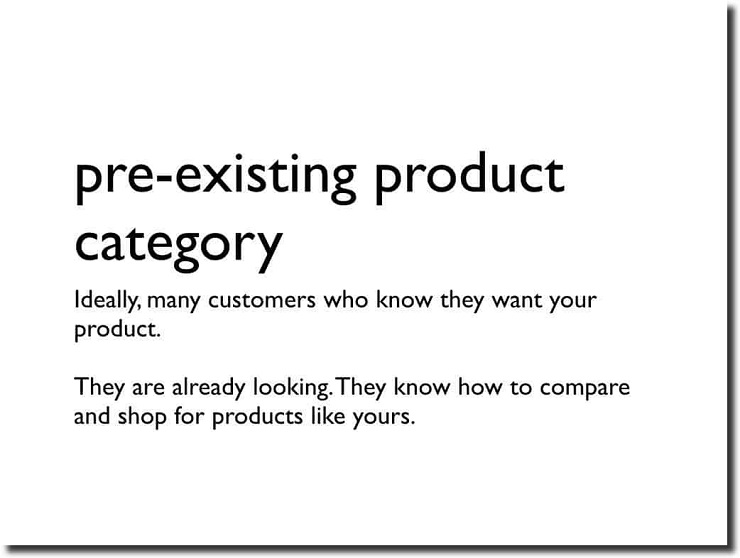
The key, according to Chen, is to start early within an existing category so it's easier to dominate it before other companies get to it:
Google was not the first search engine, Facebook was not the first social network, and Microsoft was not the first OS. However, those companies came to dominate those markets because they came in early, when the dynamics were still developing. And the markets grew and grew. But it was also clear what they offered, how they developed something killer.
Large Numbers of Interested Customers
Another benefit of starting a business within an existing industry is that you're guaranteeing there are customers who're willing to pay for what's on the market. Having a large number of interested customers means, as Chen said, "folks are actively searching for the product."
No matter how innovative your company may be, if there are no customers in your industry, you will be forced to pivot or close doors.
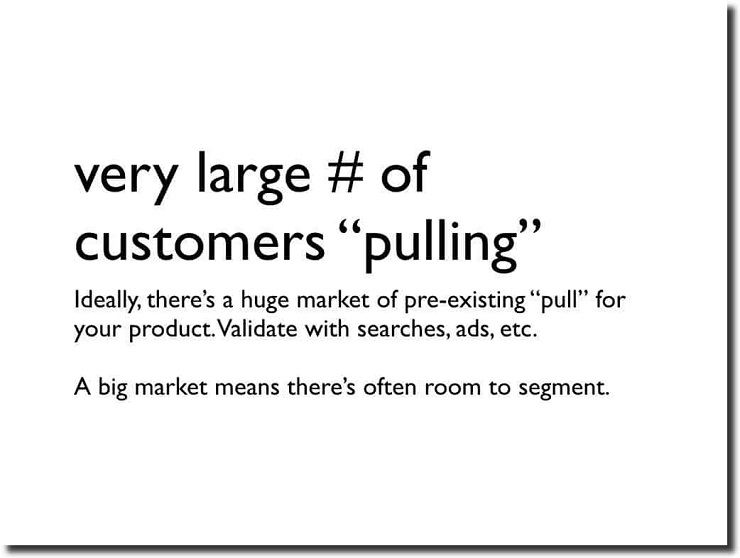
So before you decide to target a given industry, Chen recommends using a market analysis tool like Google Trends to see if customers are clicking on links that mention products in that category.
You can also use tools like Google Keyword Tools, JumpSeller (to find sales for Amazon products), and more to validate your ideas with greater depth.
FREE MASTERCLASS: How To Start a Tech Startup And Get Your First Customer In 60 Days
Lots of Successful Competition
Despite what some entrepreneurs may think, it's a good sign when there are competitors within an industry. As Chen puts it:
The best markets already have competitors. And maybe they are pretty decent. It's a good sign when folks can make a decent living building products in the space, but you just have to find a wedge to get in. Or maybe you have a clear thesis on why and how the market will get a lot bigger quickly.
If the demand is high enough, you could potentially sell a similar offer as the competition and start to make money. But if innovation is your goal, you can take the competition's offers as a proxy for demand, and then build something different—something that's cheaper, more efficient, more effective at solving a problem, and so on.
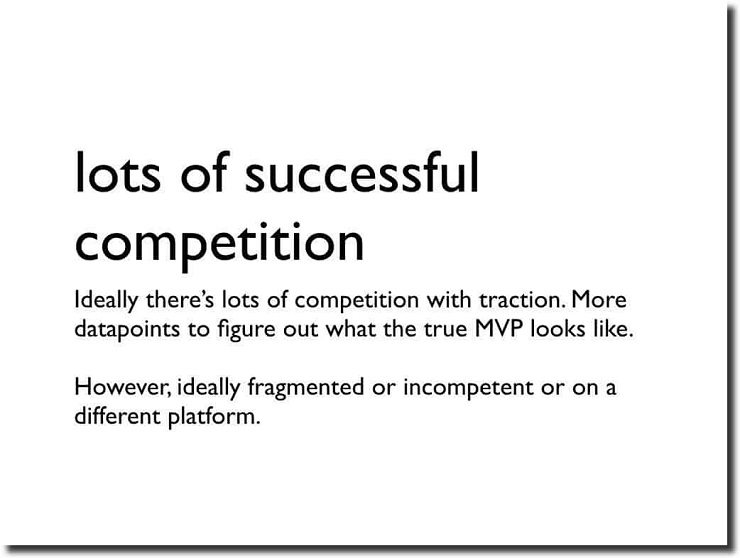
If you aren't sure whether a market is saturated with new competition or not, check how the competition is organized. If it's fragmented—that is, if everyone seems to offer different products and services that don't quite match with one another—it may be a good sign for you to enter and take the market.
A large, fragmented market suggests the competitors are not that competent, or there's something inherent in the field, like regulatory issues, that's keeping existing players from dominating.
Clear Axes of Competition
Regardless of the size of the market and the existence of competition, you need to have a strong understanding of how you're going to break in—you need a wedge.
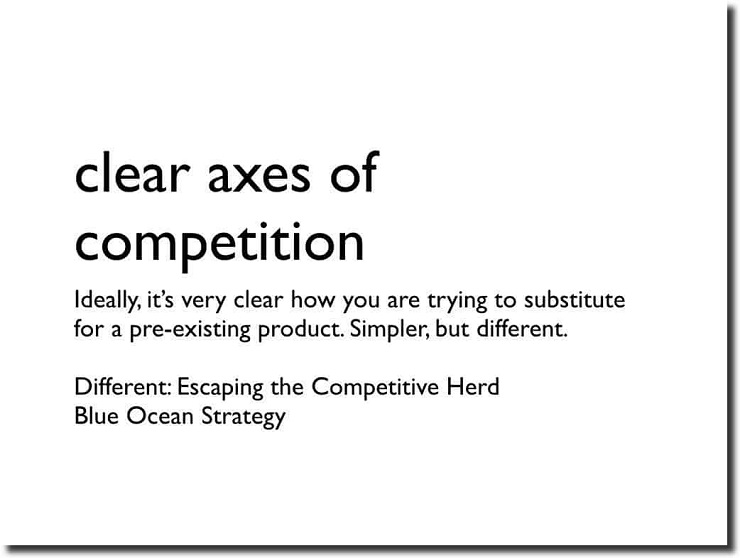
Different and Blue Ocean Strategy are books Chen refers to
Before you pick an industry, make sure you have spoken to enough customers, analyze the market trends, and check that you've got something that could potentially change it for the better.
Copy What Works
While the goal of this article is to help you find whether your startup has achieved product/market fit, the truth is such process takes time—Chen says it can take not only months, but years.
Yes, this whole process seems time consuming and soul draining, but it's worth it if you stick to a process of continual iteration until you find the right product for your market.
That being said, if you're impatient, or if you aren't sure you will ever achieve product/market fit with something radically innovative, Chen recommends an easy way out.
Pablo Picasso supposedly said, "Good artists borrow, great artists steal." Or, as Austin Kleon put it:
Source
Similarly, Chen says the easiest way to find product/market fit is by copying what works. This is the easiest short-term path, cloning something that already has product/market fit. If it's a big and growing market, users will still try out something new.
Keep in mind, by "copying what works," he doesn't mean you need to rip off exactly what others do. You don't want to be like the Samwer brothers who copycat startups all over the world.
The better (and more ethical) approach is to add your own twist. On the spectrum of pre-existing product to brand new product, pick a point in the middle. Build something that consumers fundamentally understand, but with a clear innovation that you can market around.

As Scott Berkun, the influential author and speaker said, "innovation is overrated."
When was the last time you, as a customer, called the support line for a product you own to complain about its lack of innovation? Or sent a meal back to the kitchen at a restaurant because it wasn't innovative enough?
It's perfectly fine that you want to "put a dent in the universe," as Steve Jobs said, but you don't need to put the cart before the horse. Innovation should be a secondary effect of what you're really trying to do, which Berkun said is to "profit by making good things."
How to Measure Your Product/Market Fit
Now that you have some strategies for getting to product/market fit, how are you supposed to know when your mission is accomplished and it's time to charge ahead?
The key question isn't to ask if you've reached product/market fit. Ash Maurya, the author of the classic entrepreneurial book, Running Lean , thinks a much more powerful question is to ask, "Have I built something people want?"
While there's no product/market fit metric, exactly, there are a couple of key stats to look at:
- High Net Promoter Score (NPS)
- Low Churn/High Retention
High Net Promoter Score
The Net Promoter Score is a simple survey that asks customers to rate from 1–10 how likely they are to recommend your product to a friend or colleague of theirs.
If people are very likely to share your product with others—which is often considered to be an NPS above 9—then it means it's something they truly need.
Source
According to theNet Promoter Network, the results can be segmented into three groups:
- Promoters: These are the people who scored your offer with a 9 or 10; they are loyal enthusiasts who keep buying and refer others, fueling growth.
- Passives: These are the people who scored between a 7 and 8; they are satisfied but unenthusiastic customers who are vulnerable to competitive offerings.
- Detractors: These are the people who scored between 0 to 6; they are unhappy customers who can damage your brand and impede growth through negative word of mouth.
Another similar approach is the oneSean Ellis developed, which asks people whether they'd be distraught if they couldn't have your offer anymore:
If you find that over 40% of your users are saying that they would be "very disappointed" without your product, there is a great chance you can build sustainable, scalable customer acquisition growth on this "must have" product. Those that were above 40% are generally able to sustainably scale the businesses; those significantly below 40% always seem to struggle.
In either case, your goal is to find how much they value your offer and leverage the information to base your decision, your pricing, and your growth strategy.
Low Churn/High Retention
Earlier in this article, you learned that one of the key aspects of verifying the value hypothesis is to run experiments and cohort analysis. The ultimate goal of both tactics is to find how people react to your offer and whether they stick to it, that is, continue using it over time.
Startup marketers call this "stickiness" or "retention," and the effect of people leaving the tool as "churn." Both metrics, which work together, are the key to finding the true value of your startup.
In his talk onHow to Start a Startup, Alex Shultz bases his definition of product/market fit on these two metrics:
Look at this curve, "percent monthly active" versus "number of days from acquisition." If you end up with a retention curve that is asymptotic to a line parallel to the X-axis, you have a viable business and you have product market fit for some subset of market.
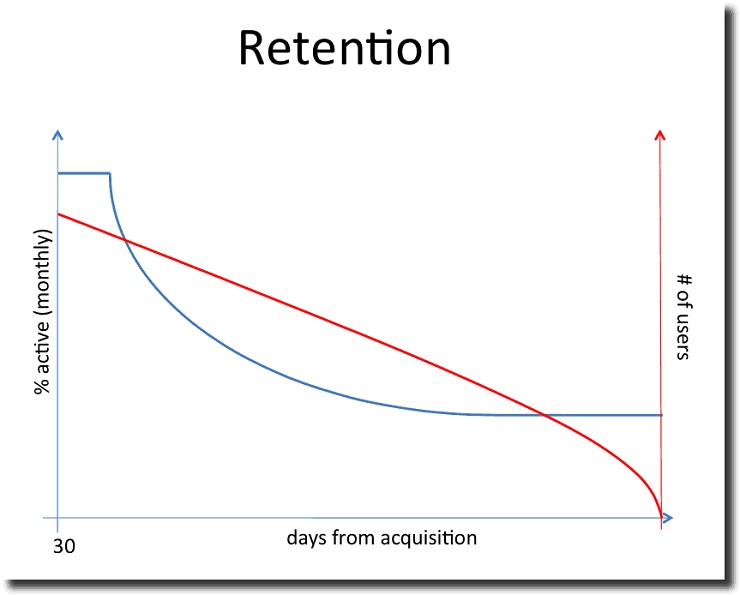
Andrew Chen made a more specific definition of this retention curve: "You want to see DAU/MAU at >25%. A world-class leading DAU/MAU would be over 50%."
In other words, if a quarter of your user base comes back to use your tool daily or monthly (depending on the type of offer you have), then it means there's product/market fit.
He also gives other examples of metrics that represent product/market fit:
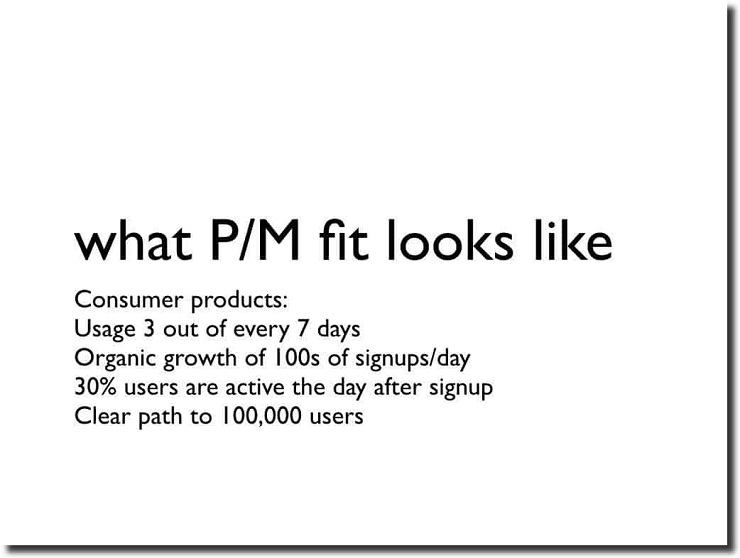
Actions speak louder than words, and actions are what you need to observe in order to find out if you have product/market fit.
FREE MASTERCLASS: How To Start a Tech Startup And Get Your First Customer In 60 Days
Here's How to Find Product/Market Fit
At the end of the day, Andreessen recommends a "rise-and-grind" attitude. That means you need to do whatever it takes to find product/market fit. Be relentless about it.
It's so critical, he even separates the life of a startup in two parts, what he calls "before product/market fit" (BPMF) and "after product/market fit" (APMF).
In BPMF, your only focus must be to obsess over getting to product/market fit. Get out of the building, talk to users, and refine your value hypothesis until the chips start to fall where they're supposed to—in your startup's growth engine.
One more piece of sage advice from Andreessen to part with:
Do whatever is required to get to product/market fit. Including changing out people, rewriting your product, moving into a different market, telling customers no when you don't want to, telling customers yes when you don't want to, raising that fourth round of highly dilutive venture capital—whatever is required.
Are you looking to find product/market fit for your startup? If so, what's been your experience so far? Let us know in the comments below. And tell us what you're building, we'd love to see your progress. 🙂
The post How to Find Product/Market Fit for Your Startup appeared first on Foundr.
]]>The post The Science-Backed Qualities of Good Leaders—And How You Can Apply Them to Your Business appeared first on Foundr.
]]>While the exact details of the story are contested (some say Jobs wasn't fired, but chose to leave), the tale tells us something about leadership. He didn't fit the stereotypical leader mold, perhaps, but he learned to be a stronger leader over time.
What few people realize is that Jobs was not CEO of Apple in its early years because, allegedly, the board of directors didn't think he was ready for it. It wasn't until after his return in 1997 that he took the helm as Apple's chief executive officer.
And while his legacy is riddled with stories of his tempestuousness and stubborn pursuit of his vision, I would argue that those very things are what made Steve Jobs, well, Steve Jobs. Even John Sculley, the CEO at the time of Jobs' 1985 departure, later called Jobs "the greatest CEO ever." On top of that, when Jobs stepped down as CEO in August 2011, he had one of the highest cumulative CEO approval ratings on Glassdoor—an impressive 97%.
If Jobs didn't start out as a good leader, then surely, he had to learn the skills that shaped him into one. So if you, too, aren't what people would call a "natural-born" leader, can you still be a good one? I believe the answer is yes, and years of scientific research backs that assertion.
Read on to find out the qualities of a great leader and how you can emulate them in your business and career.
EXCLUSIVE FREE TRAINING: Successful Founders Teach You How to Start and Grow an Online Business
What Is a 'Good Leader'?
First, how do we define a "good leader"? The answer may vary from person to person. In most of the studies I read, leadership was assessed by at least two major factors:
- The performance of the team they led
- Approval ratings or feelings the team members had toward their leader
Based on that, for the purposes of this article, I'm going to define a good leader as someone who helps their team succeed and has a good relationship with their teammates.
Are Leaders Born or Made?
Some research shows that there are certain inherited traits that can make one more likely to become a great leader. One study suggests thataround 30% of leadership is explained by one's genetic makeup. Additionally, in 2013, scientists discovered what may be a "leadership gene " (it's called rs4950) that gives some people that extra oomph to take charge.And Malcolm Gladwell famously pointed out that a disproportionate number of CEOs are over six feet tall—yet another trait that is out of one's control.
But just because tall men are more likely to be CEOs does not mean tall men automatically make good leaders. And as the research shows, if only 30% of leadership ability is determined by genetics, the good news is that, even if you're under six feet tall or you weren't born with the "leadership gene," there is still 70% of leadership ability that is completely under your control.
So how can you develop into a good leader?
The Qualities of a Good Leader, According to Research
Good leaders show empathy.
Whoa, hang on there! Empathy? I bet you didn't expect to see this one on the list. First, let's define empathy. The Center for Creative Leadership defines it like this:
Empathy is the ability to experience and relate to the thoughts, emotions, or experience of others. Empathy is more than simple sympathy, which is being able to understand and support others with compassion or sensitivity.
The CCL analyzed data from 6,731 managers from 38 countries and found that managers who showed more empathy to their team were seen as better performers by their bosses. It also found, however, that the importance of empathy differs by culture. The positive relationship between empathy and job performance was higher in cultures with high "power-distance"—defined as the degree to which people believe power should be concentrated at higher levels of an organization. Countries with high power-distance include China, Egypt, New Zealand, and Poland.
And if you feel like your empathy skills are lacking, don't worry—empathy can be learned! Here are some tips recommended by the CCL to show empathy as a leader by practicing better listening skills:
- Listen to what your teammate is telling you, and then paraphrase what you think they've said. The CCL suggests using a phrase like, "What I hear you saying is…"
- If you don't understand, say so. Try, "I'm not quite sure what you mean. Could you help me understand?"
- Notice nonverbal cues, too, such as tone of voice, facial expressions, and gestures.
The CCL also recommends practicing perspective taking, which is putting yourself in one's shoes. For example, if you're managing a team that's in conflict, try to see the argument from all sides of the situation before you speak or take action. This will help ensure that you handle conflict resolution in an empathetic and effective way.

Good leaders execute with speed and accuracy.
This trait perhaps isn't so surprising. Good leaders get sh** done—with speed and accuracy. Jack Zenger and Joseph Folkman looked at evaluations of more than 85,000 leaders and found that:
- Leaders who execute fast but not right have a 2% chance of being rated as an outstanding leader by peers, subordinates, and superiors.
- Those who execute right but not fast have a 3% chance.
- But those who execute with both speed and accuracy have a 96% chance of being rated as an outstanding leader.
If executing fast and right sounds like a tall order when you're already stretched thin, Zenger and Folkman propose that you can improve execution without putting in more hours. In their book, Speed: How Leaders Accelerate Successful Execution, they identify four behaviors that improve execution:
- Be clear and methodical. Rushing into a project to complete it as quickly as possible will not help with execution. Zenger and Folkman recommend having a clear plan of attack and ensuring your team is aligned with the goals and underlying strategy.
- Set deadlines and stretch goals. Good leaders don't just dole out deadlines; they encourage their team to hit stretch goals.
- Give more feedback, especially positive feedback. In their research, Zenger and Folkman found that leaders who excel at execution not only deliver feedback well but also give a lot more positive recognition to their team.
- Resolve conflict and build team unity. Leadership doesn't come without conflict. Your ability to resolve disputes among your team members will help everyone stay focused on the goal.
If you're wondering how you stack up in your execution speed, Zenger and Folkman offer a free Pace Assessment.
Good leaders are vulnerable.
When we think of great leaders, we might call to mind military generals who led armies to victory or brazen activists who fought hard to change policies. So, it stands to reason, doesn't being a leader mean arming up and charging into a fight? According to social science researcher Brené Brown, quite the contrary. She says being a brave leader means "taking off the armor." Here, the armor she refers to are "thoughts, emotions, and behaviors that we use to protect ourselves when we aren't willing and able to rumble with vulnerability."
Brown says being a good leader requires vulnerability. After conducting a seven-year study on brave leadership, she distilled the research into a new book, Dare to Lead, which covers these four skill sets:
- Rumbling with vulnerability
- Living into our values
- Braving trust
- Learning to rise
Though there are four skills, half of her book is dedicated just to rumbling with vulnerability. So why is this particular skill so important? I think we can all agree that a good leader displays courage, and according to Brown, courage and vulnerability go hand in hand.
To drive that point home, here's a story she often shares, which I'll quote directly from an interview conducted by Michael Gervais. Brown says:
I used to spend so much time trying to convince people that vulnerability is an essential part to courage, until I was at Fort Bragg one day and I was working with some Special Forces troops. I asked this question, I said, "The definition of vulnerability is uncertainty, risk and emotional exposure. That's what it means to be vulnerable. Can anyone here give me a single example of courage from your life or that you've witnessed in someone else, one example of courage that did not require uncertainty, risk, and emotional exposure?"
No one in the room could think of an example. One stood up and said, "There is no courage without vulnerability."
To bring vulnerability into the workplace as leaders, we first need to unlearn what we've been taught all our lives: the myth that vulnerability is weakness. Second, we need to be open about the challenges facing our organization. A survey of more than 27,000 executives, managers, and employees found that employees who reported that their organization "always openly shares the challenges facing it" were much more likely to recommend their company as a great one to work for than those who reported "never," "rarely," "occasionally," or even "frequently."
Mark Murphy, who launched the survey, writes of its findings: "Feel safe in being vulnerable by remembering that if an employee believes their company openly shares the challenges facing it (i.e. that their leaders are vulnerable), that employee is about 10 times more likely to recommend it as a great employer."
If you'd like to see where you can improve as a leader—including your vulnerability skills—consider taking Brown's free Daring Leadership Assessment.
EXCLUSIVE FREE TRAINING: Successful Founders Teach You How to Start and Grow an Online Business
Good leaders focus on people and relationships, not tasks.
A group of researchers in Canada conducted a comprehensive literature review that included 53 studies on leadership behaviors and outcomes for nurses and organizations. In it, 24 studies found that leadership styles that were focused on people and relationships were linked to higher job satisfaction. On top of that, productivity and effectiveness were higher in work environments with charismatic, transformational, and change-oriented leadership. On the other hand, 10 studies reported that leadership styles focused on tasks were linked to lower job satisfaction.
Based on this study, here are some ideas for building strong work relationships with your teammates:
- Have a mission and make sure your team knows it and believes in it. Your team doesn't want to follow orders and complete tasks mindlessly. As a leader, you must define the mission and rally your team around it. For every task you assign, try to tie it back to the mission. Otherwise, it will feel meaningless to your team.
- Introduce weekly, monthly, or quarterly all-hands. All-hands meetings are great because they're often the only way all of your team can meet at once. It can also be a great time to catch up with each other on personal lives too, rather than always focusing on work.
- Host team retreats. What better way to build team relationships than by getting away from the office and going somewhere fun? Some of the Foundr team recently went to Thailand for a retreat, and not only did they get in a ton of planning for the year ahead, but they also got to bond as a team.

Good leaders encourage participation.
In a seminal research study conducted in 1939, Kurt Lewin placed schoolchildren into one of three leadership groups to see how it affected their work, which consisted of several craft activities. The groups were as follows:
Authoritarian

In this group, the leader usually decided the work tasks and work partners of each member and dictated each step of the process. He did not actively participate in the activities except for demonstrating.
Democratic
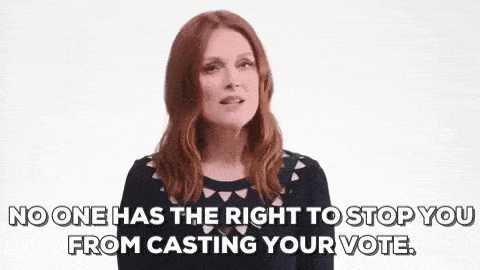
All policies and decisions were open to discussion within the group. The leader made suggestions that the group could choose from. The members were free to decide who they worked with and how to divide up the tasks. The leader participated in the activities.
Laissez-Faire

The leader did not participate at all (unless a group member asked him a question), and each individual was completely free to decide what to do.
In one of the experiments, hostility was 30 times as frequent in the authoritarian group as in the democratic one. In another experiment, the boys in the authoritarian group were much less aggressive, but the researchers posit that this was not due to a lack of frustration, but rather, it was because the boys were under the repressive influence of the autocratic leader. Lastly, researchers found that the subjects liked their democratic leader more than their authoritarian one.
How can you apply these findings to your everyday work life?
- Ask for suggestions and feedback, especially from the people on your team who tend to be shy or rarely speak up.
- Beware of scapegoats. In Lewin's study, in the authoritarian groups, scapegoats often cropped up. So if you see your team placing the blame on a particular person or group of people, it's time to reevaluate how you're leading them.
- Be an equal in the work. Democratic leaders participate equally in the work; they are not passive bystanders, nor do they take on the bulk of the work for the team.
- Offer guidance, but trust your team. As a leader, you don't need to constantly tell your team what to do. If they're skilled at what they're doing, you can give them some guidance and then trust them to make the best decisions.
As Steve Jobs told Rolling Stone magazine: "What's important is that you have a faith in people, that they're basically good and smart, and if you give them tools, they'll do wonderful things with them." To be clear, he was speaking specifically about why he had faith in people rather than technology itself, but I think the quote applies to leading a team too.
EXCLUSIVE FREE TRAINING: Successful Founders Teach You How to Start and Grow an Online Business
Becoming a Good Leader Doesn't Mean Changing Who You Are. It Means Integrating a Set of Science-Backed Behaviors
Critics can call Steve Jobs' leadership style what they will, but based on my earlier definition of a good leader, Jobs met both criteria:
- The team performed well under his leadership, as proven by Apple's growth and innovation.
- The team generally had good feelings toward the leader, as evidenced by Jobs' 97% Glassdoor cumulative approval rating.
And I believe Jobs didn't accomplish this by changing who he was, but by learning a teachable set of skills that helped him become a stronger leader.
So if you're struggling to be a good leader as a founder, trust the research that shows the vast majority of leadership can be learned. You weren't born pre-programmed to be a leader or a follower; you can choose to be either.
Yes, there are some basic qualities of a good leader that we all think of: bravery, integrity, vision, intelligence, and so on. But if you want to emulate the science-backed qualities of a good leader, here's what some of them are:
- Show empathy.
- Execute fast and right.
- Don't be afraid to be vulnerable.
- Encourage participation.
- Focus on people and relationships.
If you want to build a business with a lasting legacy, one that people look forward to working for, one where your teammates are close knit and like each other—then building your leadership skills should be at the top of your to-do list.
Who is someone you admire because they display the qualities of a good leader? Share with us below!
The post The Science-Backed Qualities of Good Leaders—And How You Can Apply Them to Your Business appeared first on Foundr.
]]>The post 5 Proven Ways to Find the Right Co-Founder for Your Startup appeared first on Foundr.
]]>You've got the plan, the desire, and the energy to start, but it's become very clear that you're missing something—you need a co-founder. Someone who can complement your skills, act as a sounding board or a voice of reason, and help you lift yourstartup idea into reality.
But you're low on connections, you're new to the startup world, maybe you live on a farm in the middle of Iowa. Basically, you're utterly, hopelessly co-founderless.
What can you do?
If you're at the point where you want to start your tech business, and all you need is a co-founder, congratulations, you're actually in a very good place. And you have a lot of options.
Today, you will learn five proven ways to find a co-founder for your startup.
Let's get started.

Leverage Your Network
Your network is the first place you need to explore when looking for a co-founder.
A startup is a long-term investment; you need someone who will stick with you through all the challenges lying ahead. A co-founder is the person who helps you set the vision for the company and then carry it out even in the tough times.
For that, you need someone who trusts you, and preferably likes you: could be a friend, an acquaintance, a confidant. Whatever you want to call it, a co-founder is someone whose trust and support will push you throughout the entrepreneurial journey.
Trust, like Stephen Covey once said, "is the glue of life. It's the most essential ingredient in effective communication. It's the foundational principle that holds all relationships."
When looking to people in your network, trust isn't the only key criteria that you need in a potential co-founder. You also need to look for someone who has the skills you lack.
An important reason you want a co-founder is to help you with the tasks you can't do. For example, if you're a technical person, you will need someone with the business-savvy to help you find investors, market your business idea, and hire people. The same applies if it's the other way around.
You may have found someone you trust, but if that person has similar skills as you, such a partnership will be of little use. One team of researchers foundthat having complementary skills was one of the main points several Harvard Business School alumni founders considered as key to starting a successful tech startup.
As one of the respondents said:
No 24-year-old engineer can acquire all of skills in five years. So, the crucial skill is learning how to form a founding team that can cover the gaps. A founder must be able to assess their own strengths and weaknesses and know how to recruit and motivate complementary founding team members.
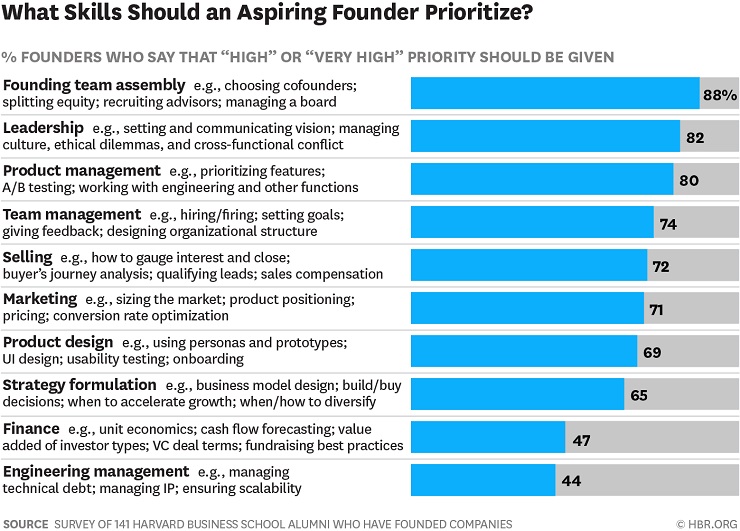
When you go out to research your network—whether that's through LinkedIn, Facebook, or your contact list—look for someone you really connect with, but also look honestly at the skills the people you're considering bring to the table.
Attend Networking Events
Your network is the easiest place to look for a potential co-founder. But what if you lack much of a network to start with? What if you haven't found anyone you trust who also has the skills you lack? What do you do?
Fortunately, you can still find a co-founder through the power of social networks.
Gone are the days when you had to rely on your local network. Nowadays, you can go to startup events to meet new people. In most large cities, these events pop up every few weeks, giving you lots of chances to meet new potential co-founders.
Meetup.com (owned by WeWork) and Facebook events are two sites where you can find the latest events in the startup world.
If you're located in an up-and-coming startup hub like Barcelona, Sydney, or Hyderabad, the high number of talented people seeking to start a company will make it much easier to find a co-founder.
 Source
Source
In other cities, you may have to look a bit more and go to more events to find a co-founder, but don't lose hope. Millennials are highly entrepreneurial, and the mythology around the successful startup built in a dorm room or garage remains a powerful motivator, as is the desire to say out of an office cubicle.
Besides these two sites, you can use more specific networks likeCoFoundersLab andFounder2be to find your potential co-founder.
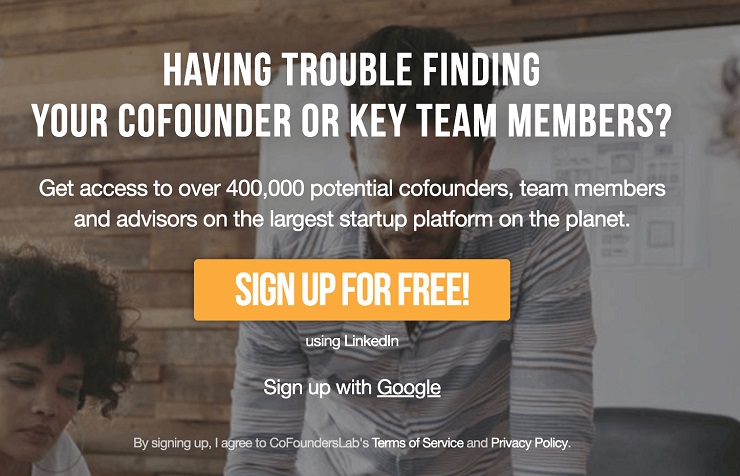
While such sites tend to have fewer people, the specificity of the networks can make it easier to find a co-founder.
A key aspect that will make your co-founder search process easier and more effective is to have a well-defined, powerful elevator pitch—that is, a pitch that summarizes your startup idea's value proposition and that helps people understand what your startup is all about.
A famous framework you can use to develop your elevator pitch is to use Geoffrey Moore's positioning statement, which goes like this:
- For (target customers)
- Who are dissatisfied with (the current market alternative)
- Our product is a (new product category)
- That provides (key problem-solving capability).
- Unlike (the product alternative),
- Our product (describe the key product features).
While this statement is geared toward existing companies, you can still adapt it for your startup. For example, if you wanted to start a software company that helped people track their weight loss, you could pitch your idea like this:
- For people who want to lose weight
- Who are dissatisfied with MyFitnessPal
- Our product is a weight loss motivation tracker
- That provides support and accountability
- Unlike MyFitnessPal
- Our product empowers people to feel good while they lose weight
Now that I think about it, this seems like a great idea. Who wants to start it with me? 😜

Go to a Founder Dating Event
This may sound a bit strange, but dating and finding a co-founder actually have a lot in common.
Earlier, I noted that one of the two most important qualities in a co-founder is trust. Dating is similarly about trust—the potential romantic partner you're trying to connect with needs to trust you on some level to go out with you, and you them. More so if you form a partnership.
Because of these similarities, some people have embraced the idea that you can connect with a potential co-founder the same way you might a romantic one—that is, through speed dating. Source
Source
In a speed dating event, you sit down with many potential romantic partners for one to five minutes each and see if you quickly connect with the other person. If you do, you get their phone number, and off you go on a real date.
In a similar vein, a founder dating event is like a regular networking event, minus all the pleasantries. Your job is simply to pitch your idea to others and see how they react.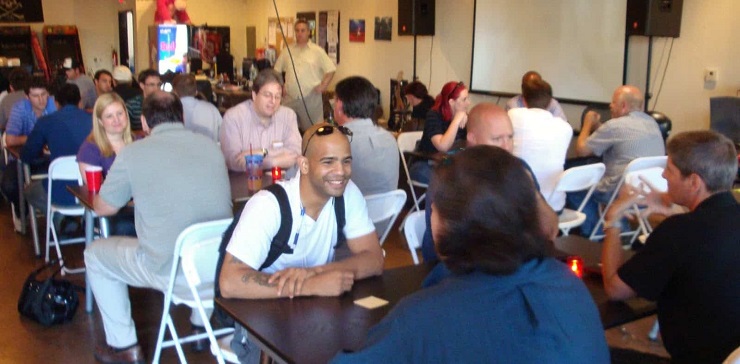 Source
Source
Your goal at a co-founder dating event is to leave with a list of people you'd like to continue talking with to explore a potential partnership.
A key element of these events is to let your intuition speak for you. As Malcolm Gladwell puts it in his book Blink : "There can be as much value in the blink of an eye as in months of rational analysis."
Outsource Specific Needs
When you think about co-founders, you might imagine famous duos like Bill Gates and Paul Allen, Sergey Brin and Larry Page, or Elon Musk and Peter Thiel.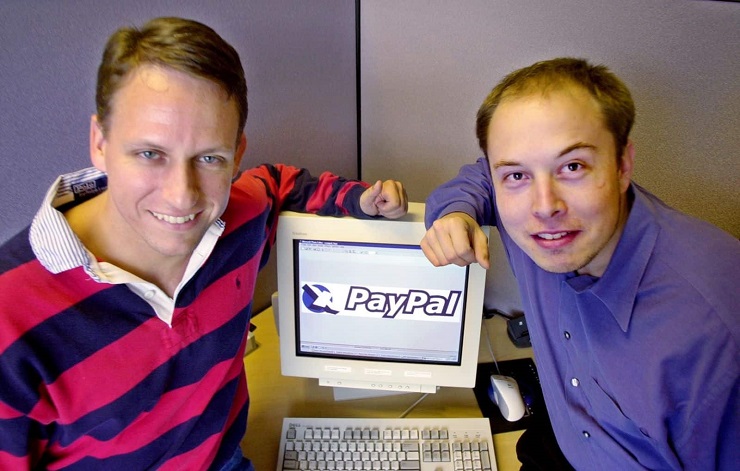 Source
Source
But let's be honest: you're not aiming to be like them (at least, not right now). You just want to start a company that serves an audience no one serves and solves a unique problem no one solves.
So if you have the idea and the passion, but lack a team, you can always hire one. As Robert Walser once said, "money moves the world."
By "hiring a team," I mean outsourcing the skills you lack to experts, rather than trying to find one partner to help you fill them in. Outsourcing is a good way to start building your company if you have the money.
When considering outsourcing, there are two options available:
- Hiring specific freelancers
- Hiring an agency
A site like Upworkis the perfect tool to find freelancers from a wide range of skills, budgets, and experience levels.

Because you're hiring specific people for specific tasks, the costs are often lower with freelancers. The problem with hiring individual freelancers is that if you need a complex or ongoing piece of work done, this may not be the best route.
An agency can also supplement your skills. If you're a marketer, you can hire a development agency; if you're a developer, you can hire a team to help you develop your business brand and marketing message.
Agencies can provide much more robust solutions; from building entire apps to developing a brand, and anything in between. Understandably so, the increased complexity means increased costs.
Costs aside, a local company that you can personally meet would be the best way to start, as makes it easier to communicate your ideas.
One problem that you may encounter when working with freelancers is that they may not invest 100% of their time and effort in your company, since they don't have any skin in the game.
Gray Skinner, CEO of Droplr, drove this idea home when he said:
Where consultants have gone bad for us is when we tried to entrust our entire marketing function to a consultant marketing company. The problem we found was that the consultants had a very topical view of our business, did not sit with us everyday, and did not have the same passion and zeal for our company that we as founders naturally had. After three months, we stopped using them and learned a very important lesson.
Outsourcing is most effective when you control the output. For example, if you want a logo, you can hire a designer to do that for you. You know what you want; all you need is someone to get it done for you.
When you're getting started, look to control the output of those you're hiring. That could save the future of your company, and at the same time, help you make progress.
Start Alone (but Get Help)
Entrepreneurs have a saying that goes, "Ask for money, and you'll get advice. Ask for advice, and you'll get money."
Similarly, if you go out chasing people to become your co-founder, there's a chance the wrong person is going to jump on board.
For example, there's that certain type of person who wants to launch a tech startup with dreams of becoming the next Evan Spiegel—a young billionaire living a life of glamour. Source
Source
Team up with someone motivated by the wrong thing, or at least a very different thing, and you'll end up working with someone who has very different values and goals than you do. That's a bad way to get things started.
For that reason, if you can't find a co-founder after a few months of searching, then your best bet may be to simply start alone.
You may not be able to build the next unicorn, but you will be able to start and make progress. Given your limited resources, your goal at this point is to build the MVP—your minimum viable product—to get user feedback and traction.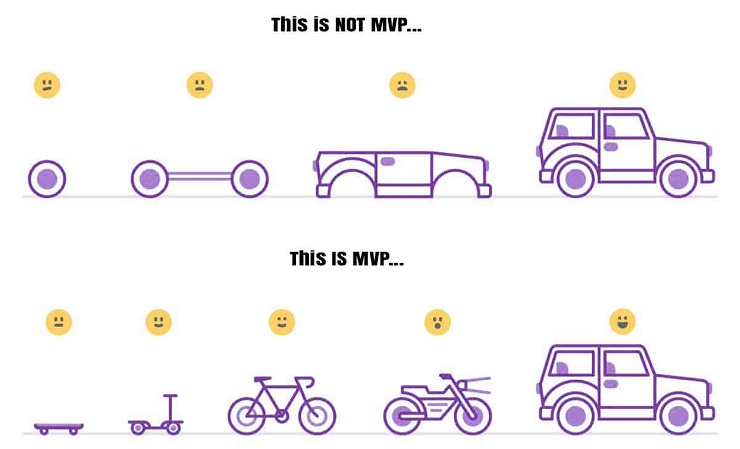 Source
Source
As explained before, consider hiring a few freelancers for a short period of time to develop the most basic tool your audience can use. You can also build a basic software tool with the help of a service likeAppyPieorShoutem.
While you build your MVP, ask for help. You can go out to events, get help in a relevant subreddit, or hire a coach throughClarity.fm. Also, reach out to people you think can help you—not a Gary Vee or Richard Branson, but someone who mentors entrepreneurs in your city or region.
If your value proposition is unique and the MVP you've created is truly useful, many of the people you contact will want to help you out. You may even get an investment offer, although that shouldn't be your goal at this stage.
Your goal is to get others to help you. Maybe someone who helps you build your MVP will even become your next co-founder.
Or their help will come in the form of recommendations. Those people you contact may not be interested in working with you or helping you with their time, but they'll happily point you to the people who can.
Before you know it, you will end up with the co-founder you've been looking for.

Here's How You Can Find a Co-founder
With these five roadmaps you've learned here, it's time to get started.
First, look at your network. Open your LinkedIn and Facebook accounts and see if you can find someone that you trust and who supplements your skills.
If you can't find anyone who fits that criteria, look for events in your city. Go out and start meeting people. Also, look for a startup speed dating event to meet as many potential co-founders as possible.
You will slowly build relationships that may end up helping you start your business.
While you look for your co-founder, consider outsourcing specific tasks that you can't do but you clearly know the output you want—think your logo, your initial website look, a functional MVP, and so on.
Finally, remember to ask for help from mentors and other experts; those people may end up introducing you potential co-founders.
Are you looking for a co-founder? If so, what has been your experience so far? Leave your comments below.
The post 5 Proven Ways to Find the Right Co-Founder for Your Startup appeared first on Foundr.
]]>The post How Foundr Tripled Its Business Using the 'Traffic Light Reporting System' appeared first on Foundr.
]]>There are, of course, many factors involved when a business starts to take off like this—a dogged CEO, a dedicated team, and the right set of products and services. Then there are the factors that are less glamorous than all of that—like implementing the right systems.
I know, I know, snore. But it's true. In fact, a while back, Foundr started applying one particular system that we know has had an outsized impact on the company's ability to grow to where we are now. Not only that, it helped us define our true vision, and even brought us closer together as a team.
It's called the "Traffic Light Reporting System."
It's been such a boon for us, that we decided to give the Foundr family a behind-the-scenes look at this exact process we implemented to help the business scale up—and outline how you can use it to grow your startup as well.
I'll start by describing the system itself, and then explain how Foundr used it to achieve such great results. Green light, let's go!
EXCLUSIVE FREE TRAINING: Successful Founders Teach You How to Start and Grow an Online Business
How to Organize Your Growth
Let's start with a silly but important question: What are traffic lights for?
The simplest answer is that they organize traffic. The system indicates to both drivers and pedestrians how they need to behave in relation to one another. Green means go, yellow means slow down, red means stop.
It's a very simple concept that we learn in grade school. Indeed, that simplicity is what makes the whole system work so well for everyone, and why it's used in cities around the world. No matter where you're from or what kind of experience you have, you can easily understand how to behave.

In a fast-growing company like Foundr, we always have multiple strategies moving at the same time. While Dave is working on new partnerships, Jenna is working on growing the blog, Ariel is working on finding influential people to participate in our podcast, and I'm creating new content and finding ways to get it in front of as many people as possible.
We have too many inputs managing multiple growth variables. You can see how we might get confused and overwhelmed. In the daily grind, it's easy to forget the big picture and miss our real growth levers for shiny objects that don't drive substantial results.
To keep us on the right path, we needed a system that, like traffic lights, organizes our efforts and helps us see how we're doing in relationship to our goals. We found such a solution in the "traffic light reporting system."
What's the Traffic Light Reporting System?
Foundr has Steve McLeod, our official business coach, CEO of Courage For Profit, and the main instructor of our flagship course Triple Your Business, to thank for the Traffic Light Reporting System.
McLeod is a fan of using the analogy of traffic lights in his management consulting, and he's introduced this particular system to more than 100 of his clients. And it works. It's the system we've personally used to triple our business in just nine months (hence the name of the course).
In its most basic form, the Traffic Light Reporting System consists of taking all your main business key performance indicators (KPIs)—the metrics that measure the progress you make towards a goal—and checking their progress with the use of colors.
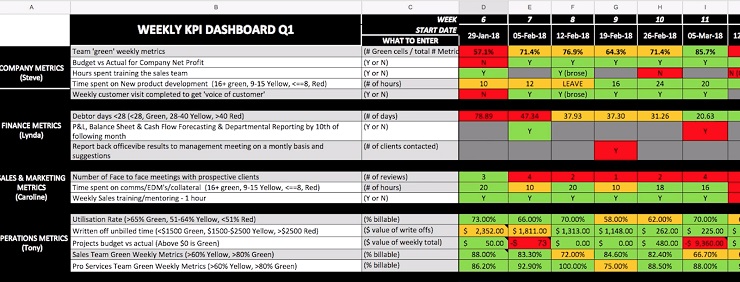
But that's actually jumping ahead a little. First, let's break down how you get to all of these KPIs in the first place, and how you know you're working toward the right goals.
Knowing Your Vision
One of the best insights Steve shares in our Triple Your Business course is his "success formula," which consists of having:
- A Vision
- Courage
- Discipline
- Thirst for Improvement
While the latter three are personality-related, the first one is the critical element that will drive all the results that come from your efforts.
Before you can set up your goals and KPIs (as you will see below), you need a compelling vision. The compelling vision is the North Star of your business—it's what success looks like in five, 10, or however many years from now.
How you develop a compelling vision is a very personal process. While some entrepreneurs dream of becoming the next Steve Jobs and "making a dent" in the world, others merely want to grow enough so they can have more time to spend with their families.
Some will have very ambitious visions, while others will make do with less money, recognition, and overall success.
The point is that your vision—whether it's small and humble or hairy and ambitious—will help you align your teams, map out the future of your company, and guide its growth.
In Foundr's case, our vision is to build a household name entrepreneurial brand that impacts the lives of tens of millions of founders on a weekly basis.
That means we succeed if you succeed, whether that's learning to launch your online business, grow your existing one, or sell it once it reaches a certain size.
We can only achieve such a vision if we develop the best content the entrepreneurial community has ever seen, including:
- Podcasts
- Magazine issues
- Videos
- Courses
- Guides
- Blog posts
With this vision in mind, we can develop our goals.
Goals
With the vision in place, your job is then to define your goals: What is it that you want to achieve in the next 12 months?
A goal can't just be to "launch your business." It has to be specific. As Steve explains, your goals must be SMART—that is, they need to be:
- Specific
- Measurable
- Actionable and accountable
- Realistic
- Time-bound
To make this scalable system work, define between three to five goals. Make sure to make them aligned with your vision so the former can get you closer to the latter.
What's more, these goals should be first measured on a yearly basis, and then, they should be broken down on a quarterly and weekly basis.
For example, if your yearly goal was to grow to $100,000 in monthly revenue—whether that's for your ecommerce store, your consulting agency, or your online business—in the following 12 months, you could break that down in the following manner:
- Quarter 1: Hit $25,000 in monthly revenue by the end of Q1
- Quarter 2: Hit $50,000 in monthly revenue by the end of Q2
- Quarter 1: Hit $75,000 in monthly revenue by the end of Q3
- Quarter 1: Hit $100,000 in monthly revenue by the end of Q4
Then, you'd break each quarterly goal down the same way for each month:
- Month 1: Hit $7,500
- Month 2: Hit $15,000
- Month 3: Hit $25,000
- And so on for each month from each quarter
In our case, our goals depend on the team to which they're assigned. While the sales team has the goal of increasing our sales, the operations team has the goal of hiring a certain number of rockstars every quarter, and the funnel team has the goal of building a certain number of funnels a month.
We define our yearly goals at the start of every year in our yearly retreat.
EXCLUSIVE FREE TRAINING: Successful Founders Teach You How to Start and Grow an Online Business
How to Organize Your Growth

In this retreat, we take a deep look at the results from the previous year. It's a tough meeting, because everyone has their own ideas, suggestions, and problems. What's more, not everything we discuss can be done, so we need to be able to hear each other and collaborate, so we can decide on a direction that best represents our vision.
At the end of these meetings, everyone ends up with a clear goal they need to help achieve for their team for the following year.
After we decide on the most important yearly goals, we discuss the goals to hit in the following quarter, and then, we break each one down even further on a monthly, weekly, and daily basis.
For example, Dave and Jesse, two of our key marketing and funnel experts, leave knowing they need to create a certain number of funnels in the following year to sustain the launch of the new courses we launch. Zack, our video producer, ends up with a different set of goals related to his video editing responsibilities that he needs to fulfill throughout the year, and the same applies to everyone.
Everything we track will come from these goals. More importantly, every KPI we track in our traffic light reporting system, as you will soon see, is tied to these key goals.
KPIs
KPIs, or key performance indicators, are the metrics you use to measure the progress you make toward your goals. While a goal can be "grow our revenue by 300%," the KPI that represents it would be "revenue growth."
KPIs alone aren't useful enough to track the progress made toward a goal. What matters is that you define a target that you aspire to hit. In the example above, a target would be to hit 50% revenue growth in one quarter. So the entire goal would look like this:
- Goal: Grow revenue by 300% in one year
- KPI: Revenue growth
- Target: Grow revenue 50% in Q1
The KPI will help you see if you're getting closer to your ultimate goal or if you're stuck in the process.
Just as you should have between three to five yearly, quarterly, weekly and daily goals, your KPIs and targets must follow the same structure. Each yearly target and KPI should be tied to each yearly goal, and each quarterly goal must have a similar quarterly KPI and target.
The Light Traffic Reporting Dashboard
After all this foundational work, we can finally create the traffic light reporting dashboard, where you can keep track of your quarterly, weekly, and daily KPIs. The simple idea is that you measure your KPIs using the three colors of a traffic light:
- When you hit a target for each KPI, you mark it green.
- When you almost hit one, you mark it in yellow.
- When you miss the target, you mark it in red.
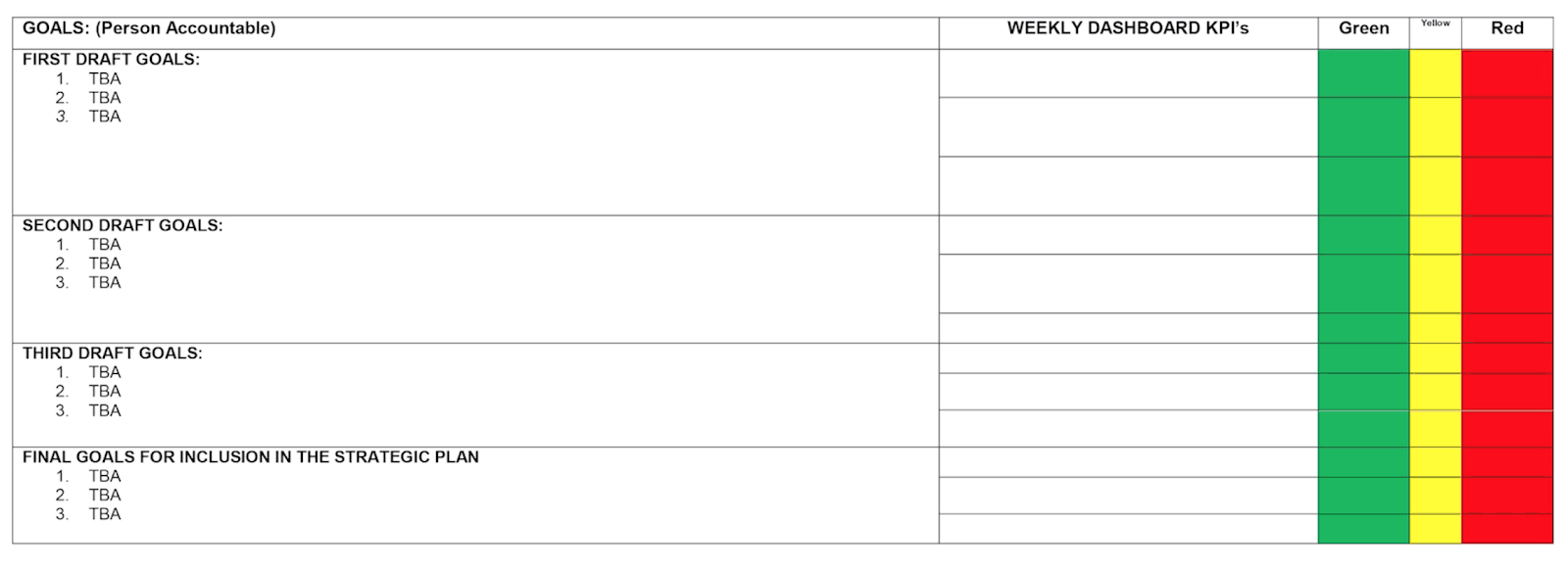
Because we have multiple goals for each team, we have separate dashboards for each team.
Each dashboard has weekly and, in some cases, daily targets to hit for each KPI. While some of the KPIs are project-based—one could be specific for the launch of a new course—the majority are time-based.
Every Tuesday, we have an all-hands meeting where we track the progress we make in relation to each KPI and target, and we then assign the corresponding color to each result.
(Fun fact: The reason we have the meetings on Tuesday and not Monday is that some of our team members, like Zack who's based in New York, have large time differences from our headquarters in Melbourne. Their Mondays are the Australia team's Tuesdays, so we have our meetings on the latter date. Isn't the world of remote working great? 😃)
When one team hits (or exceeds) their weekly target, we highlight it in green. When we get close to hitting it, we highlight it in yellow. When we get far off the target, we highlight it in red.
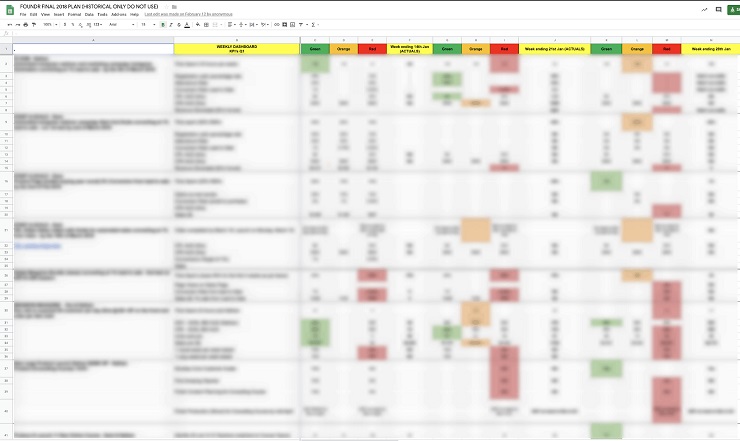
Just like on city streets, the key is simplicity. Whenever you want to check the progress toward your goals—the relentless discipline with which you attack each one—you open your KPI dashboard and check the colors.
When you see mostly green numbers, it means you're progressing. When most of the results are yellow or red, it means you're lagging behind your goals and you need to analyze potential solutions.
Simple, effective, and massively actionable.
Note: To get a deep understanding of how this whole system works, I highly recommend you sign up for the course Triple Your Business.
How Foundr Tripled Its Business with the Traffic Light Reporting System
A few years ago, Foundr was a promising startup with a lot of potential. We had already grown enough to have a functioning magazine, a few profitable courses, and an engaged audience.
The problem, as many startup founders can attest, is that we had too many possibilities. If there's such a thing as a good problem, this may be it.The obstacle this creates is that it makes it hard to prioritize the opportunities that matter; it's hard to pick between the ones that will have a massive positive impact in the future of the company and the ones that are just another shiny object.
For us, this meant that in one month we would launch an online course, while in the next we would have to launch a crowdfunding project, then a coffee table book, and then…well, you get the idea. We were everywhere, trying to catch too many golden eggs, which meant we weren't anywhere at the same time. The whole situation, while motivating and exciting, ended up being chaotic and pretty stressful.
We were already working with some business coaches, but in most cases, they can only give suggestions. They can't put their hands on the company to actually implement each suggestion. They were helpful, but not useful.
Then, we decided to bring in Steve. Little did we know that was going to be a decision that would change our path forever.
The first time we met him, Nathan, Dave, Zack (who had come all the way from New York shortly after being hired), and a few other members of the team, went to Torquay, a small but famous beach town an hour and a half from Melbourne.

The idea of the trip was to have a hands-on meeting with Steve so he could help us uncover our vision and goals. We thought that such a workshop would be a traditional 9-to-5 retreat that would eventually let us relax and enjoy the surroundings.
But we were wrong—by a long shot.
The workshop was incredibly intensive. The lack of a clear strategy meant we had to come up with something realistic and actionable right on that day, from scratch.
The whole event ended up going from 7:30 a.m. to past 9 p.m. It was so late that by the time the team got out, nothing was open for dinner. The team had to eat a lousy pizza, a meager reward for such an exhaustive day. 😅
Looking back, the workshop ended up being the breaking point that allowed us to zero in on Foundr's grand strategy—the vision that would drive our growth for the next 5 to 10 years.
From then on, there was no more space for new shiny objects; we had to get the discipline to fulfill our vision. There was no other way.

Thanks to Steve's guidance, last year Foundr tripled its business growth. Such outstanding results happened thanks to our relentless focus on the highest leverage growth tactics that would fuel our vision.
What's more, Steve taught us something deeper. Before this event, everyone seemed to be on everyone else's back. Steve showed us that to become a high-performance team, it's important to trust each other. Nowadays, the entire team is in the same boat (or car), traveling to the same destination.
EXCLUSIVE FREE TRAINING: Successful Founders Teach You How to Start and Grow an Online Business
How to Organize Your Growth
Find Your Vision, Chart Your Growth
In the information-overloaded world we live in, it's easy to get overwhelmed with all the potential possibilities out there. People forget that each tactic you pursue must lie within a strategy. And strategy is something that a lot of people never really define.
If you have a hard time figuring out what's truly important to you and you're always changing tactics before they have a chance to work, stop and define your larger plan.
Stick to your plan—like the one Steve helped us create—and you will get results.
The traffic light system then helps entrepreneurs overcome "shiny object syndrome" and focus on realistic and achievable goals, and their related milestones.
More importantly, the traffic light system can help you develop the discipline to execute your strategy week in and week out, making huge strides before you know it.
Now we want to hear from you: What's your true vision?Got any questions on Foundr's use of the traffic light system? Let us know in the comments below.
The post How Foundr Tripled Its Business Using the 'Traffic Light Reporting System' appeared first on Foundr.
]]>The post How to Motivate Yourself: Setting the Right Conditions for Peak Productivity appeared first on Foundr.
]]>Yes, you want to accomplish a lot of great things for yourself—break from the 9-to-5, become your own boss, make more money than you ever dreamed of—but you don't seem to have the motivation to do anything about it.
You likely feel lost, confused, overwhelmed, or some combination of the three. Where do you even start? Who can you talk to? Are you even the right kind of person to start a business?
If this sounds like you, fear not, there is hope.
There are a few relatively simple ways that you can motivate yourself to become a successful entrepreneur. All it takes is gaining a better understanding of psychology, and training yourself to carry out small-but-steady actions over time.
How to Motivate Yourself
Understand How Motivation Works
Step 1: Discover How to Access Your Peak State
Step 2: Structure Your Work for Maximum Performance
Step 3: Develop Healthy Habits
How Motivation Works
For most people, motivation is a strange beast. We all know what it is (the root of the word means "to move"), but it's hard to get it to show up when we need it. If we could know what it takes to get it to show up when the lights are on and the show is about to begin, we could probably achieve anything we wanted to.
The fleeting nature of motivation hasn't escaped psychologists, who have been studying its nature for the past 100 years. From Abraham Maslow's famous hierarchy of needs theory to more current ones related to willpower and many other multivariable approaches, psychologists have also had a hard time wrapping their heads around the concept.
One of the most famous models for understanding motivation is Deci and Ryan's model of intrinsic-extrinsic motivation (Deci & Ryan, 1976), which I explained in an earlier post.
Basically, this model says that people can either be pushed to do something through an extrinsic (external) reward or punishment, or through intrinsic (internal) means.
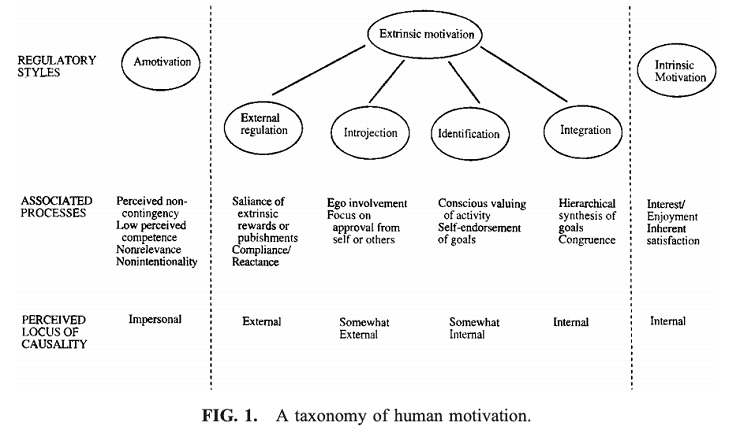
If you have ever had a hobby—whether that's a sport, video games, horticulture, whatever—your motivation for doing so was intrinsic. No one told you needed to start playing soccer, Fortnite, or planting tulips in your backyard. You did it because you wanted to.
On the other hand, when your mom told you needed to study hard to pass an important exam that would help you get into a good college, or when a boss told you had a short time to develop a presentation, your motivation was extrinsic.
This kind of motivational model is already quite old—the paper that first presented it was published back in 1976. This is around the same time the most famous motivational model up until then, Maslow's pyramid of needs, was being challenged (Wahba and Bridwell, 1976).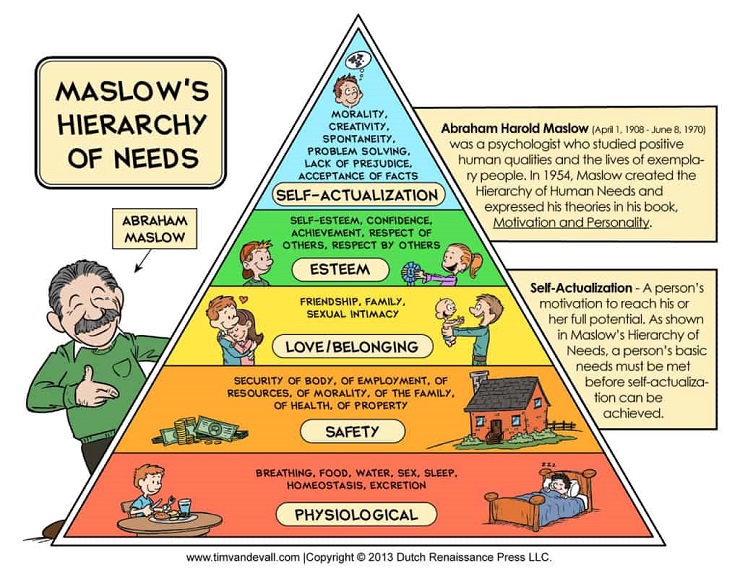
Source
This article, however, isn't a meta-analysis of motivational theories; you came here to learn how to motivate yourself, and that's what you will learn.
This is a topic I've personally struggled with over time, and I've devoted a lot of time and research into figuring out what works best for me. Over the years, after learning from motivational experts and the latest psychological research, I've found some very basic steps can have a big difference on my own motivation.
My approach, while unscientific, is simple: You want to find the right environment where you work at your best—where you are the most motivated—and then put yourself in that place over and over so you can motivate yourself without effort.
Intrigued? Great!.
Let's take a look at how this model works.
Want to Get MORE Done in Less Time? Download Our FREE Ebook, "The Ultimate Guide to Doubling Your Productivity in 30 Days"
Step 1: Discover How to Access Your Peak State
There are times where you seem to work like a machine. You just get things done without hesitating, without any hiccups. Compare that state to the days when you can't seem to get a single email out, and you might think you have some kind of problem. It turns out, you don't.
During your productive days, you unknowingly slip into a state of high performance, while on the unproductive days you…don't. This is a very common phenomenon. The challenge is in maximizing that state of high productivity, every day.
Tony Robbinscalls this state of high performance "peak state."
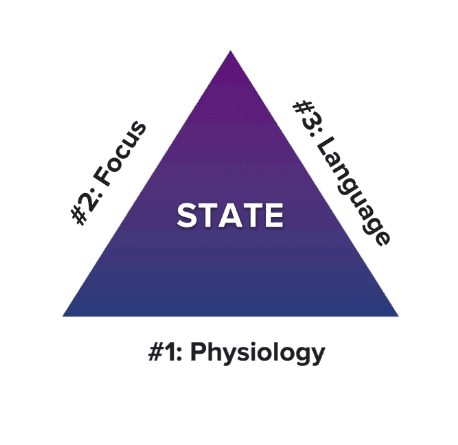 Source
Source
Following Robbin's theory, in order to get to your peak state, you've got to:
- Get into the right physiology
- Focus your intention
- Use the right language
While you may think your brain is what rules your energy and focus, your physiology—the way you manage your body's behavior—also plays a key role in helping you get motivated. That's why you need to get into the right physiology and use the right body language. That includes:
- Lifting your shoulders in an upright position
- Breathing through your belly, called "diaphragmatic breathing"
- Smiling and having optimistic facial expressions
- Moving energetically, which can include doing a small dance, jump, or bodyweight exercises such as squats and lunges
- Talking loudly or even screaming (just don't scare the people around you)
Your intention, on the other hand, is the energy you put into everything you do. If you put your mental focus on the bad things that could happen, guess what? You will most likely see them come to reality.
Race drivers often say that you need to focus your eyesight where you want to go, not where you are actually going (which may not be where you want to go in the first place). Using a similar analogy, if you put your mental focus on the positive results of your actions, you will reap those outcomes.
Finally, you need to use the right language. As Ludwig Wittgenstein, the father of modern linguistics, said: "The limits of my language means the limits of my world."

Pay attention to the language successful people use, compared to unsuccessful people, and you'll see that the former consistently talk in positive terms while the latter tend to be more negative.
For example, if you face a hard challenge that you think you might fail at, you could say, "I will learn a lot from this," instead of, "I'm going to fail; I can't do this."
When you see Tony Robbins speak, you'd think he's a natural—but he's not. Every time before he hits the stage, he goes through a routine that helps him hit the right physiology, as the following video shows:

See how he moves, claps, and even jumps on a small trampoline before starting his conferences; he's mastered the use of his physiology to become one of the world's top motivational speakers.
Whenever you feel like you need motivation, adjust your body language, your focus, and your language. Do a quick routine like Tony Robbins (adapting it to what feels right to you), focus your intention, and frame your challenge ahead positively.
With these three tips, you will start out with a lot of motivation to face any challenge. But remember, reaching your peak state is highly personal and introspective. Maybe it involves meditation, going for a jog, listening to a particular kind of music. These are good starting points, but be sure to turn inward and learn more about what peak state looks like for you.
Step 2: Structure Your Work for Maximum Performance
Our environment—the external stimuli that surround us—sculpt our mind as much as our physiology, mental focus, and language. Try to get into peak state in a loud bar and you will have a much harder time than in a quiet library. At least, that's the case for a writer like me; if you are a bartender, your situation may vary.
We could call this the "external peak state" (patent pending 😜): the environment that helps you get motivated.
Think about the last time you felt super motivated:
- Where were you?
- What were you doing?
- Who were you with?
These basic questions will give you some insights into the environment where you can become motivated with ease.
You can take this exercise even further and ask yourself the following questions:
- What was the time of the day?
- What was the temperature?
- Where you hungry or full?
- How rested were you?
- What was the light around you like?
The more granular you get, the easier it will be to adjust these variables each time you want to get motivated. You may realize you're at your best when you work alone in your house in your pajamas, or it may be that you work best in a loud coffee shop with no wifi.
If every time you have worked at your best was in the morning at your house, then develop a routine of working on the most important thing in the morning, while you're still at home.
The process of developing a routine means you need to be consistent. You need to have a schedule—a place and time—that you need to follow every day.
As the saying goes "If 80% of success is showing up, then 20% is following up." By knowing where to show up, it will be much easier to follow up.
Step 3: Develop Healthy Habits
When nothing seems to work—if you don't know when you work at your best or you feel like you've never worked at your best—it may have something to do with your lifestyle and daily habits.
You've seen how your body language affects your motivation. But no matter what you do, if you aren't giving your body the physical care it needs, it will be hard to muster the mental and physical energy to feel motivated.
While none of us are saints, too many unhealthy habits like smoking, drinking, junk food, and little sleep, will lower your energy levels. If this sounds familiar, it may be contributing to your low motivation.
Let's take the case of sleep, an often overlooked part of our lives.
A 2010 study observed over 4,000 workers at four large American corporations. The study found that the workers who lacked sleep had the largest productivity losses, spending nearly three times as much of their day on time management alone. What's more, the sleep-deprived workers lacked motivation, mental focus, and had a hard time remembering things and making good decisions.

A good target for nightly sleep comes from the Sleep Foundation, which recommends adults get between seven to nine hours of sleep every night to reap the full benefits.
While it may seem obvious to a grown up like yourself, it's important to make sleep a priority, and too many of us sacrifice it in order to squeeze more hours into the day. Ways to improve your sleep include avoiding coffee at least six hours before going to bed, making sure to remove all distractions and noises, dimming your bedroom lights, and getting a good mattress and pillow. Not a lot of science there. It's mostly common sense advice, but the little things make a big difference.
Next, think about eating habits. According to the Office of Disease Prevention and Health Promotion, three-fourths of Americans have diets low in vegetables, fruits, dairy, and oils. What's worse, most Americans exceed the recommendations for added sugars, saturated fats, and sodium.
A study by Brigham Young University science professor Ray Merrill looked at nearly 20,000 employees and found that those with unhealthy diets were 66% more likely to report having a loss in productivity.
What's more, the employees who had difficulty exercising during the day and those who rarely ate fruits, vegetables and other low-fat foods at work were 96% and 93% percent, respectively, more likely to have a higher losses in productivity.
There's no right or wrong diet per se—nowadays, you have low-carb, low-fat, vegan, paleo, and many more—what matters instead is that you eat most of your calories from natural sources, like meat, vegetables, and fruits, especially the organic ones which lack antibiotics and chemicals.
It's also important to stay hydrated, so always keep a glass of water, decaffeinated tea, or an electrolyte-rich beverage (like Gatorade) next to you at all times.
Finally, don't forget your mental and emotional health. This is especially important for entrepreneurs, who inevitably face touch challenges and setbacks. It's important to learn how to keep cool and persevere when things go awry.
While reading self-help books and carrying out exercises such as visualization and affirmations are three old-school ways of managing your emotions, meditation is an increasingly popular, and highly beneficial exercise.
Meditation has demonstrated many benefits that can help you not only to keep a positive attitude, but also relax and increase the quality of your life.
A study carried by David W. Orme-Johnson, Ph.D., and Vernon A. Barnes, Ph.D., found that transcendental meditation (a popular type of meditation) can have highly positive effects in individuals with high anxiety and stress levels.
The idea of having a healthy lifestyle is like a meta-exercise for productivity; it's the environment that encompasses your inner and outer world.
Want to Get MORE Done in Less Time? Download Our FREE Ebook, "The Ultimate Guide to Doubling Your Productivity in 30 Days"
Conclusion
Today you've seen that motivation is affected by both your inner and outer world. You saw that if you want to get motivated on the spot, you first can use Tony Robbins' peak state concept to help you nudge your body into a high-motivation mindset.
Then, you learned that manipulating your environment to increase your motivation also plays a key role.
Finally, you saw that carrying a healthy lifestyle will help you bring the energies from within yourself.
Now it's time to hear from you:
Are you currently facing low motivation? If so, which of the tips given in here will you start implementing this week? Let us know in the comments below!
The post How to Motivate Yourself: Setting the Right Conditions for Peak Productivity appeared first on Foundr.
]]>The post You're Not Praising Your Team Enough. How to Use Employee Recognition to Boost Your Business appeared first on Foundr.
]]>Why?
Because recognition in the workplace remains an essential part of an employee's experience, making people more engaged, more productive, and ultimately less likely to quit.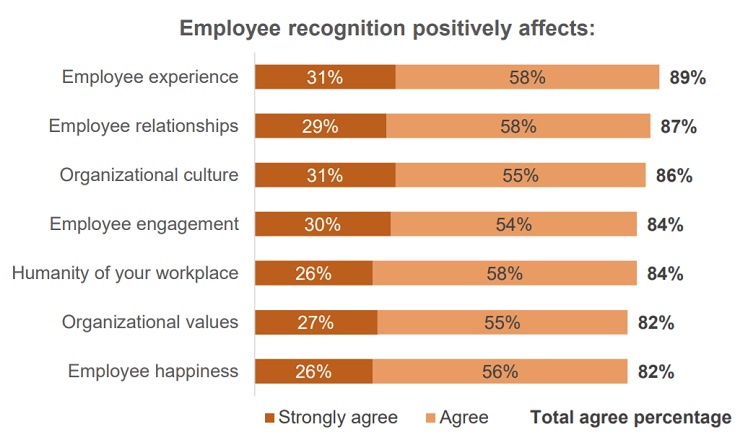
Source
What's more, research shows that recognition also has a massive impact on business outcomes like revenue and profit. Delta Airlines introduced an employee recognition program that resulted in a 564% ROI increase.
Now, the problem is that most leaders spend a ton of money, time, and effort on recognition without actually improving engagement. Why is it important to keep staff glowing? Because engaged employees are tremendously more impactful the company's bottom line.
So—read on, and you will learn how you can create a culture of recognition and enjoy the power that comes with fully engaged employees.
How Often Should You Be Praising Your Employees?
Here are some figures to consider:
Eighty-two percent of employees don't think they are recognized for their work as often as they deserve, according to BambooHR .
This begs the question: How often should you praise your employees to make them more engaged? Every month/quarter/year?
Gallup says you should be praising someone verbally at least once a week. Now, this might seem a lot.
But what you need to understand is the fact that people crave dopamine. And there are several ways to get that dopamine flowing—via drugs or alcohol or through other workplace-appropriate methods like receiving praise.
The problem, however, is that that dopamine wears off. Fast. And that is why you want to regularly expose your people to praise to create a loop of positive feedback. A less creepy, science-experiment way to put this: Praise makes people happy, and you want them to feel happy at work, in a lasting way.
Dropping a casual "thanks" once a month and sending the person back into the mix does not cut it. You need to give recognition to your people on a weekly basis.
—Aleksandra Włodarczyk, HR Specialist / Recruiter at Zety.
On board so far?
Now let's move on to how you can create a stellar employee recognition environment that will help boost engagement in your organization.
Scale Your Business the Richard Branson Way! Click Here to Get a Copy of Our FREE Print Magazine, "Scaling Branson Style".
How to Engage and Retain Employees Through Recognition
Facilitate Peer-To-Peer Recognition
We all feel better when the people we work with recognize our wins, much more than when it comes from a manager, which can seem forced.
Peer-to-peer recognition is 36% more likely to have a positive impact on financial results than manager-only recognition. But you don't need research to prove this point. Our coworkers know the ins and outs of the job so when they give kudos, it just feels authentic.
OK, peer-to-peer recognition is cool, but how do you implement it? Is there some kind of slam-dunk kudos-giving tech? There actually are quite a few tools out there, like a #kudos channel in Slack, for example.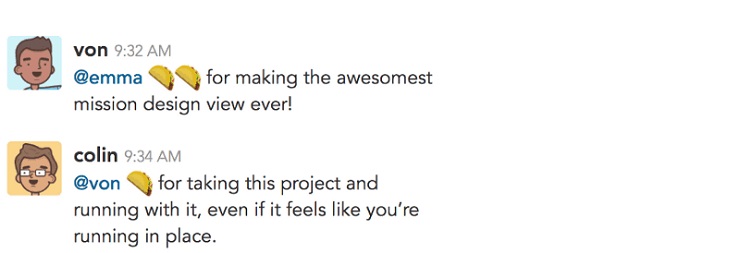
Source
But I'd recommend using Bonusly. This tool allows employees to have an allowance of points, which they can give to coworkers, directs reports, and managers to show recognition.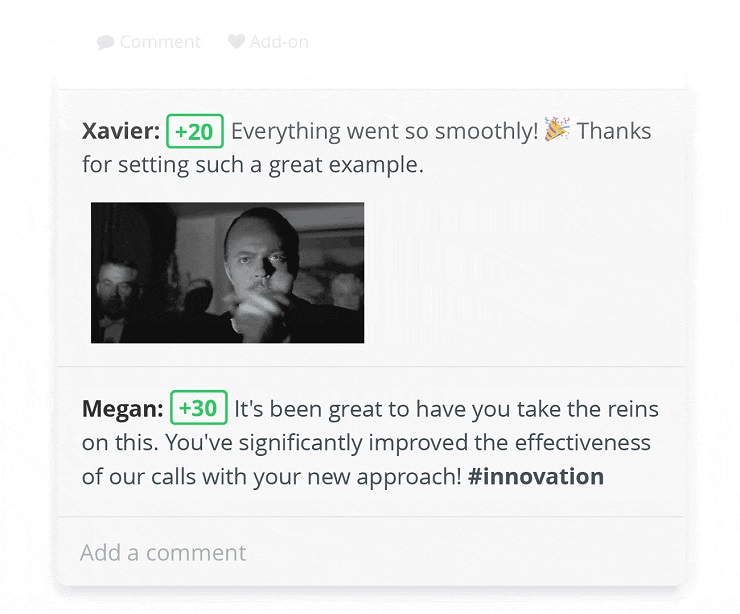
Source
Later, employees can redeem those points and get something of value in a digital catalog (gift cards, a lunch with the CEO, etc.). Pretty cool, huh? And while the dollar value of such gifts is small, the recognition is priceless.
OK, so peer-to-peer recognition is a really nice gem on top of your engagement efforts. But there are other ways you as a leader can up your employee recognition game.
Next up, we'll learn how to recognize employees without coming off as lame.
Match Recognition With Outcome
Now, it's time for you to meet Harper and Victoria—your marketing staff.
Harper is very hardworking, and she stayed up late to tackle some urgent project for the team. Kudos!
Now, Victoria, on the other hand, introduced a major tweak that is going to literally save your company several thousands of dollars. Holy Moly!
The question is, do you praise Harper and Victoria in the same way? Do they both get a $10 Amazon gift card? Nope.
If you want to engage people and inspire them to do great things, your praise should match up with the staffer's outcome. If you fail to recognize the effort appropriately, you will leave the person hanging with a strong feeling that they are not appreciated enough.
And when that happens, disengagement will hit you. And hit you hard.
Recognize both Harper and Victoria's efforts but single out Victoria and present her with something more substantial. After all, the ROI of her contribution was much greater.
Match the Recipient's Interests
If you present a golf store gift card to someone who hates golf, do you think they will appreciate the gesture? Do you think this is something that is going make them feel engaged?
No. They will consider it garbage.
And this is the reason why recognition is not one size fits all. We all have different interests, and you as a leader need to recognize this and offer something that will be of value to the recipient.
The problem? You probably have no idea what your employees are into. This is where online survey tools like Google Forms come into play. So set up a survey, have a look at your findings, and start rewarding your people in smart ways.
Be Prompt
Now, timing is crucial.
Let's imagine you had to fly off to Germany for a couple of days for some bigshot workshop. When you get back, you learn that Harperwent the extra mile and did something that went beyond her responsibilities.
There are two ways you can go about this.
You can approach Harper and say, "Hey, I heard what you did when I was in Germany. Great job! Do you want to take an extra day off on Friday?"
This kind of timely recognition is going to make Harper feel engaged and will encourage her to deliver more to get that dopamine hit later on.
But there is also a scenario in which you take several weeks to recognize Harper's efforts.
Do you know how that will make her feel? One word. Disengaged. So give recognition as early as you possibly can if you want people to keep kicking butt for you.
Be Specific
Do you remember dropping a generic great job the other day to Harper and then rushing off to the next thing?
If so, the value of recognizing Harper's efforts was close to nonexistent, because recognition needs to be tied to a person's specific achievements.
Why? Because otherwise, it won't feel authentic.
The good news is, this an easy fix and all it takes to make your recognition pop with authenticity is explain how the work that Harper did was great.
Here is an example:
Harper, I really appreciate the time you spent over the weekend to proofread Victoria's latest article and offer some suggestions on how she could improve her piece for our blog. I am already seeing how she is improving all thanks to your coaching. Great job!
Employees need to have a crystal clear sense of how their contributions affect their teammates or the company as a whole.
If they do, rest assured they are growing engaged and will stay for the long haul.
Be Inclusive
In every company, there are more and less "sexy"jobs. For example, engineers can create a product that will bring anything from $100 to $1 billion in revenue. Recruiters arguably have just an important role (recruiting engineers, for example), but it's less apparent that their work is hauling in the riches.
Now, if you want to create a recognition-rich environment, the person doing candidate screening should get just as much recognition as the engineer bringing in millions of dollars worth of business, if they are both doing a good job.
If you do not do that, you are missing out on an opportunity to jumpstart company-wide engagement. Worse, you are creating a toxic environment where employees with "small jobs" feel like they can't compete with heavy hitters no matter how hard they try.
And when that idea burns into their minds, they are going to jump ship before you know it.
Be Transparent
When offering financial perks or other rewards for a job well done, your employees need to be in the know about it. Otherwise, they will think that there is some sort of foul play happening, which will not help you jumpstart engagement, to say the least.
That is why you want to be transparent about whose efforts are recognized and why.
Best way to do it?
Let everyone on the team know (e.g, verbally or via email) what the person did and what ROI it had on the team and/or organization as a whole. This will help you showcase what kind of behavior you expect from your employees.
Now, what about private recognition? Should it stay or should it go?
You can still recognize an employee privately (e.g., during a one-on-one session), but keep in mind that public recognition provides stronger motivation.
Employee Recognition Ideas
Looking for some snappy ways to recognize your staff? Here are some battle-tested employee recognition examples.
Get on Social Media
You can show appreciation to your employees by going online and giving them a shout-out via the company's Facebook and/or Twitter accounts. This is something thatSt. Louis Children's hospital did and it worked great.

Want to take it to the next level?
Set up an employee of the week program and post pictures of your employees on social media regularly. It won't take much time, because you can automate things with Buffer.
It's free, but the effect of tagging employees online (especially if you have a boatload of followers) is massive.
Spotlight Them at the Next All-Hands Meeting
As noted earlier, public recognition is extremely powerful.
So take a moment to recognize the successes of your employees at your next all-hands meeting. Have everybody in the company give them a round of applause.
The key here is to be specific (see above).
Offer Extra Time Off
Being all appreciative is nice. A better way, though, is to walk the talk. If one of your employees went above and beyond, why don't you give them an extra day off?
This will make your employee happy and they will be able to recharge their batteries before jumping back into the mix.
Can't do that but you still want to give them a pat on the back? Give your employee one or two remote days.
Give Career-Based Rewards
Want to kill two birds with one stone?
Enter career-based rewards. Send your employees to a (local) workshop, sign them up for an online course, or get them a mentor.
First, you will show your employees that you care about their professional development and growth. This will not only help you reward your people for good work but also keep them invested in the company.
Need proof? A staggering 80% of employees call it quits if they don't receive workplace training.
Second, if you invest in your people, this will benefit your organization as well. They will learn new skills and ultimately take your business to new heights.
It is a win-win.
Scale Your Business the Richard Branson Way! Click Here to Get a Copy of Our FREE Print Magazine, "Scaling Branson Style".
Bottom Line
Giving psychological recognition and monetary rewards to employees should be part of your organization's DNA. If done right, you will have an environment in which everyone will be glowing and delivering their full power to your organization.
Now—what's your experience with recognition at work? Are you giving enough? Getting enough? Let's discuss in the comments below.
The post You're Not Praising Your Team Enough. How to Use Employee Recognition to Boost Your Business appeared first on Foundr.
]]>The post How to Use Extrinsic and Intrinsic Motivation to Start Your Business appeared first on Foundr.
]]>Here's why:
If you want to start your online business and expect to make it through the many difficult challenges ahead of you, you're going to need a ton of motivation. But you don't need just any type of motivation; you need the right kind, that can give you the powerful inner fuel you need to charge ahead with your dreams and start making money.
How to Use Extrinsic and Intrinsic Motivation to Start Your Business
Why Motivation Isn't What It Seems
Understanding Extrinsic Motivation
Understanding Intrinsic Motivation
The Power of Integrating Extrinsic and Intrinsic Motivation
A Final Breakdown of the Motivation Process
What do you usually do at first to motivate yourself? You maybe open your Instagram to read motivational messages. You go to your Facebook feed for the same.
You're not alone. People crave motivation. That's why inspiration blogging is such big business. Like cracking a Red Bull, people are looking for something that will drive them; something that pushes them closer to their goals.
The problem is, that's not how motivation really works.
Forty years ago, a pair of psychologists found motivation has two sides: an extrinsic (or external) one, and an intrinsic (or internal) one. It's a super nerdy distinction, but understanding these two types of motivation will make a big difference in how you inspire yourself to overcome all the challenges that you'll face as you start your business.
In this post, you'll learn how extrinsic and intrinsic motivation work and how you can use them to get your business off the ground once and for all.
Why Motivation Isn't What It Seems
Motivation is often seen as a "thing" you can obtain, like an apple or a car. If you want motivation, you only need to find it and learn how to use it. But is motivation as concrete as that?
Some psychologists would say so.
Around the late 19th century, psychologists from the behaviorist school started to hypothesize that if you don't feel motivated, it's because there's something lacking—a reward (like praise or money) or a punishment. Add that reward (or punishment), and find motivation.
At first sight, that idea seems to make sense. For example, if you want to lose weight and want to motivate yourself to train, you could tell yourself you can eat a small pizza after a workout (your reward). A small pizza wouldn't hurt you, right? You've done your job; now you need the reward.
In a similar vein, you can get a personal trainer who screams in your face every time you go to the gym so you push yourself really hard and burn as many calories as possible. Painful, but that punishment would probably help, at least in the short term.

You can easily see the limitations of this mindset. You don't need to balance the act of eating pizza with training—you should also think of pizza as unhealthy and limit it in your diet. The same applies to punishment. Your sense of motivation shouldn't be someone screaming at you, but from the desire to look thinner, be healthier, and feel better.
In other words, your reward (or lack thereof) isn't stopping you from losing weight; your inner motivation is.
In 1977, Richard Ryan, a soon-to-be clinical psychologist with a philosophy major, and Edward Deci PhD, an experimental psychologist with a background in math, met at the University of Rochester and had a conversation that would change their lives—and the lives of many others.
Ryan and Deci realized that there was a disconnect between the widely accepted behaviorist theory of motivation—the one that uses rewards and punishments as a tool for motivation—and reality.
In execution, these supposedly powerful rewards don't actually work all that well.
So Deci and Ryan developed the Self-Determination Theory (SDT) of motivation, which toppled the dominant the Behaviorist school, and changed the way psychologists think of motivation.
The Self-Determination Theory states that people certainly can be motivated externally—by money, or a desire for social approval, for example—or internally—by passion for the project itself.
They didn't reject external rewards altogether. Instead, they said a reward (or punishment) isn't the only thing that matters, and most importantly, isn't the best way to motivate someone.
In their 1985 book, Intrinsic Motivation and Self-Determination in Human Behavior , which has beencited over 37,000 times according to Google Scholar, Deci and Ryan explain:
We distinguish between different types of motivation based on the different reasons or goals that give rise to an action. The most basic distinction is between intrinsic motivation , which refers to doing something because it is inherently interesting or enjoyable, and extrinsic motivation , which refers to doing something because it leads to a separable outcome. Over three decades of research has shown that the quality of experience and performance can be very different when one is behaving for intrinsic versus extrinsic reasons.
According to the authors, motivation isn't a concrete resource like, say, willpower (as explained by Roy Baumeister), but a broad set of emotional levers whose range can affect the way we act. According to their theory, humans go through three stages of motivation, what they call the "Organismic Integration Theory (OIT)," or "the taxonomy of human motivation."
Stay with me. 🙂
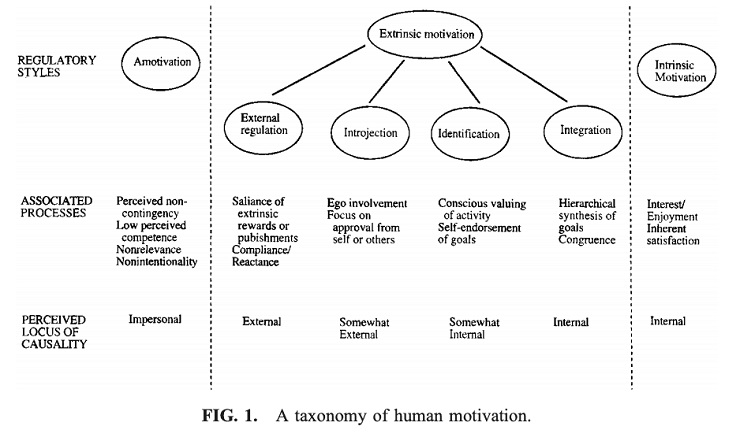
In this image, you can see the range of motivation levels across three stages:
- Amotivation: You don't care about the task.
- Extrinsic motivation: You are motivated by the external factor.
- Intrinsic motivation: You are motivated by your inner satisfaction.
According to the psychologists, amotivation means that you lack an intention to act. When you're told you have to make cold calls to start a business but you feel like it's pointless, you are amotivated. There are multiple reasons why this can happen, but the fact is you have neither an internal nor an external motivation to pick up the phone. You don't know why you have to do it or what you get in return from the activity. And considering cold calling is kind of scary, you're never going to do it.
Deci and Ryan then explain there are three causes for amotivation:
- A lack of value in the activity (Ryan, 1995)
- A feeling of incompetence (Deci, 1975)
- A lack of belief that the task will bring the desired outcome (Seligman, 1975)
So maybe you don't see how the calls are important, or you have no experience doing it and feel like you'll be ineffective, or you don't believe it will work. Whatever the case, there's a reason why you feel like this, and avoiding it will not help you at all.
Amotivation is the one state on which all psychologists can agree. Where it gets interesting is Deci and Ryan's segmentation of motivation; one that separates between extrinsic and intrinsic motivation.
To them, the way you motivate yourself—either extrinsically or intrinsically—is what truly matters.
Let's take a look at how each of these two types of motivation work.
Want to Get MORE Done in Less Time? Download Our FREE Ebook, "The Ultimate Guide to Doubling Your Productivity in 30 Days"
Understanding Extrinsic Motivation
Extrinsic motivation exists when you are motivated by an external factor or a specific outcome. It's what drives you to do things for tangible rewards or pressures rather than for the sake of doing it. When you are extrinsically motivated, you have to explain to yourself why you should do it—that is, for the reward or to avoid the punishment.
Not all extrinsic motivation is alike, however. As you saw in the image above, there are four levels of this motivation, based on the way you process the external factor:
- External regulation: You do the task because you have no choice. In this stage, people feel "controlled or alienated." Most often than not, minimum wage employees and low-level bureaucrats are externally regulated, which is why they're known for their low-quality work and lack of interest in helping others.
- Introjection: You do the task because you feel like it's the best thing for you or your social group. Your intention is to "enhance or maintain your self-esteem and the feeling of worth." Most employees seem to be in this state; while they like their jobs and are willing to do them, they do it for the money, status, or power.
- Identification: You value the task you do and you are somewhat internally motivated to do it, despite the fact you have to do it. A good example is a worker who's happy with their job and likes to work and share time with coworkers, and feels valued. They even go a bit beyond their mandatory responsibilities to help the company move forward.
- Integration: You have absorbed the values of the task you're forced to do, like when someone says they have "the best job in the world." You don't care about the money or the time you spend on your job; you do it because you love it and have integrated the external motivation as your own.
The problem with externally regulated processes is that they decrease the quality of the work done—the subject under this circumstance does the task to gain the reward or avoid the punishment. As you can imagine, you want to avoid this kind of situation, both for yourself and for others.
The more autonomous the extrinsic motivation (the closer it its to the integration phase in the right side of the image above), the better it is for the individual, as it's been associated with:
- Greater engagement (Connell & Wellborn, 1991)
- Better performance (Miserandino, 1996)
- Higher quality learning (Grolnick & Ryan, 1987)
- Greater psychological well-being (Sheldon & Kasser, 1995)
But if extrinsic motivation isn't ideal, we must ask ourselves, why can't we just be intrinsically motivated? Can't we switch that good stuff on? Let's take a closer look.
Understanding Intrinsic Motivation
Intrinsic motivation is when you are motivated by internal factors. You are driven to do things just for the fun of it, or because you believe it is a good or right thing to do.
Most creative hobbies are intrinsically motivated. When someone collects stamps and coins, paints a tiny tin soldier, or learns to dance, they put all their energies and care into it. Few people carry that amount of passion into the workplace.
It's hard to say if there's a way to develop intrinsic motivation—it comes from within yourself, after all. If there was something that could use to trigger your intrinsic motivation, then it would be extrinsic.
The key lies in integrating intrinsic motivation into extrinsically motivated tasks.
That is, if you can bring some intrinsic motivation to work with an otherwise extrinsic form of motivation, you can make yourself (as well as others) more motivated. You will enjoy your tasks more, even though you're doing them for an external reason (like a paycheck).
Let's take a look at how you can integrate intrinsic motivation with an extrinsic one.
The Power of Integrating Extrinsic and Intrinsic Motivation
When you want to start your business, you probably feel an inner motivation to do it. There's something wrong in the world you want to fix. You have something the world needs to see. You want to help others. But then, as soon as you hit the ground running, you feel scared, worried, and doubtful. You feel like you can't do it. Back to amotivation.
Before you try anything, the first thing you need to realize is that there's no real way to manufacture intrinsically motivation.
If you don't feel motivated to do something—do cold calls, set up a meeting with an investor, develop a partnership—you can't magically snap yourself out of your amotivation.
Rather, your goal is to feel an identification and become integrated with the values and processes of any given task. The closer you can get to such a state, the more "self-regulated" your behavior will be; that is, the more intrinsic your motivation will be.
Your goal should be to get as close as possible to the right side of the image below, playing up the intrinsic motivation as much as possible. You want to have a deeper purpose behind your tasks, in other words, not just money.

Deci and Ryan found there are three factors that play into this increased intrinsic motivation.
1. The first one is that the individual feels like his task has a greater purpose. As the authors explain:
The groundwork for facilitating internalization is providing a sense of belongingness and connectedness to the persons, group, or culture disseminating a goal, or what in SDT we call a sense of relatedness .
If you want to feel motivated, start by recognizing that an external motivation is either money, status, recognition, skills, or experience. These goals are the "external regulators," as the authors call them. They are just the beginning, however.
To develop that sense of relatedness, focus on your company's mission, values, and goals. Here's where having core values matter a lot. You need to think about how you can tie your values and goals together with your company's. Such integration will help you develop a productive workplace culture and make both you and your employees happier.
An interesting example of such integration between an employee and a company's values are Apple's geniuses, whoare willing to get paid below industry average just to work for the company.
Ron Johnson, former SVP of retail operations, who was responsible for setting up Apple stores worldwide, explains how they achieved this in a Harvard Business Review interview:
Getting a job on the sales floor at Apple today requires six to eight interviews, including with the person who runs the entire local market. One result of that intensive process is that when people are hired, they feel honored to be on the team, and the team respects them from day one because they've made it through the gauntlet. That's very different from trying to find somebody at the lowest cost who's available on Saturdays from 8 to 12.
Does Apple have to monitor their geniuses and make sure they serve their customers well? Not at all, because they know their geniuses will do it for the pleasure of working for Apple and selling the best products in the industry.
2. After relatedness, the next key to fostering your intrinsic motivation is to develop a feeling of competence.
If you have ever had a boss tell you can do something because "you're are the best at it," or that you have to do something hard because "you can handle it better than anyone else," then unconsciously they were trying to increase your feeling of competence, and therefore, motivation.
3. Finally, you must have autonomy in the tasks you implement, which the researchers defined as:
…the critical element for a regulation being integrated rather than just introjected. Controlling contexts may yield introjected regulation if they support competence and relatedness, but only autonomy supportive contexts will yield integrated self-regulation.
The idea of autonomy is close to US General George S. Patton's advice: "tell people what to do and let them surprise you."
Give yourself (or other people) autonomy to carry out a task, and they'll figure out the best way to do it. Even if they're inefficient—something you can fix later on—they will feel like they have control over the task, and thus feel motivated to do it.
How to Motivate Yourself: A Simple Guide
Let's take these three suggestions Deci and Ryan have come up with and illustrate them in a simple example. Let's go back to our example of having to make cold calls to get a few clients for your consulting business, but you don't feel motivated to do so.
Based on what we know about motivation, some reasons that could explain your behavior include:
- You have a feeling of incompetence towards this skill.
- You don't feel a connection between the task and the goal of generating revenue.
- You feel like cold calling makes you a bad person, something that violates a personal value of yours.
- You don't feel like you have the autonomy to make the cold calls in the way that best suits you (this could mean you have someone telling you how to do them).
To overcome such a state of amotivation, you can start with an extrinsic goal such as revenue. The goal of hitting $10,000 of monthly revenue is a good way to start your motivation.
You can then continue by focusing on developing your sales skills, using research or role playing. You can also get a coach to train you and mentor you in this process so you can increase your feeling of competence.
Then, to develop a feeling of relatedness, you can remind yourself that this exercise is a way to gain experience and skills as a founder, an identity you feel a close personal association with.
Finally, you could develop the autonomy necessary so you can carry the cold calls in a way that makes you feel like an honest salesperson.
The same applies if you want to motivate an employee or partner. Give them a clear sense of a larger purpose (relatedness), assign tasks that best fit their skills (competence), and give them leeway to do it their way (autonomy).
In other words, tell them what you want and why you want it, trust them, and let them do their job. If you hired them correctly, they'll do what you wanted them to do. There's no need to micromanage people or threaten them; if you work with smart people, they'll do it.
To truly push the intrinsic motivation of people, the authors conclude that:
To fully internalize a regulation, and thus to become autonomous with respect to it, people must inwardly grasp its meaning and worth . It is these meanings that become internalized and integrated in environments that provide support for the needs for competence, relatedness, and autonomy.
If you tell someone they must do something because it's the best for the company, they're the best to do it, and they can do it in the way they best deem possible, you will increase their intrinsic motivation, even though they're still being extrinsically motivated.
Give yourself and your employees meaning, and you will open the doors of intrinsic motivation.
Want to Get MORE Done in Less Time? Download Our FREE Ebook, "The Ultimate Guide to Doubling Your Productivity in 30 Days"
A Final Breakdown of the Motivation Process
I can safely say this is the nerdiest post ever published at Foundr. 🤓
After reading so many academic and abstract words, you might still be thinking, "How on earth can I apply this in my life?"
Here's the how to, in summary:
Start with a definition of the goal that motivates you. There's no shame in saying you work for money or you want to lose weight to look hot. If there's something much greater than an external factor, then awesome. What matters is that you define that clearly.
Then, think where you are in the taxonomy of human motivation graphic. Are you intrinsically motivated? Are you barely convinced of the task and are doing it because someone else is telling you to do it?
Based on your answer, and assuming you're not intrinsically motivated, think how you can integrate your own values into the extrinsic goal.
If you're being told to make phone calls and close sales, do you value helping people? If so, think of the sales-closing goal as a way to help people—and make money in the process.
If your loved ones are telling you to quit smoking, do you value playing sports? If so, think of your new habit of not smoking as a way to run longer, faster, and with more enjoyment.
Finally, think how you can find a bigger meaning behind your goal, feel more competent doing it, and be more autonomous while you're working on it.
Mastering motivation is a continuous process that can make you a better human being in every aspect of your life. You only need to find what's stopping you to grasp the inner fire of passion, ignite your full energies, and start and grow your business.
What is it that you are trying to find motivation for? Share your ideas in the comments below.
The post How to Use Extrinsic and Intrinsic Motivation to Start Your Business appeared first on Foundr.
]]>The post How to Find a Reliable Overseas Manufacturer to Bring Your Product Vision to Life appeared first on Foundr.
]]>How to Find Manufacturers
Understanding Your Gross Margins & Business Strategy
Getting to Know the Manufacturing Industry
Questions to Ask Potential Manufacturers
Keeping Communication Open & Friendly
Let's Find Some Great Manufacturers and Start Production
This step is also often the most nerve-wracking, and for good reason. This is essentially the first time in your creative process when you've placed the outcome in someone else's hands, and it's likely that these hands belong to a team of distant strangers in a foreign country.
Young entrepreneurs often underestimate the importance of finding the right manufacturers for their products. Once the development phase is over, they tend to jump at the first manufacturing opportunities that match their budgets without laying down some essential groundwork to ensure a seamless process.
But no quality product has ever been produced without taking the right steps up front to ensure its quality and sustainability.
Believe me, manufacturing is a topic I've been passionate about since I moved to China in 2010. It was then that I saw the sheer power of China's factories and realized that everything we use or wear has to be produced somewhere. Since that turning point, I've worked to bring ideas to life and create unique products, and it's led me to a career in ecommerce, first creating my own products and then working with others through my company Sourcify.
In this post, I'll share with you what I've learned about bringing products to life and running ecommerce brands based on physical products. That includes finding a manufacturer to make your product, what you should ask potential partners, the ins and outs of the industry, step-by-step advice, and proven strategies for entrepreneurial success.
Understanding Your Gross Margins & Business Strategy
First and foremost, any startup entering the stage of finding a manufacturer should be highly conscious of their budget, gross margins, and overall business strategy. Without having a clear idea of your current funding and how much you can spend, it's easy to head down the wrong path when getting your products made.
For example, an apparel company and a tech startup might have very similar budgets going into manufacturing, but will certainly opt for different production routes for obvious reasons. Aside from the difference in products, one might be producing a significantly larger number of products, or merely getting a single component of a gadget made, as opposed to a finished product.
When it comes to planning for costs, many manufacturers will cut into your predetermined margins due to unexpected middlemen. If you neglect to thoroughly research your manufacturer's operation, don't be surprised when you discover you're overpaying for your products.
This is why, from a strategic perspective, every ecommerce entrepreneur needs to know the essential formula below:
Profitability = (Sale Price – Unit Costs) – Cost of Acquisition
If your unit costs are covered by the return of your ad spend, you'll be a profitable ecommerce store. As an example, let's say you sell sunglasses for $100 and produce them for $10. This means you have $90 to make a sale profitably. If it costs you $50 to make that sale, you profit $40.
Profit ($40) = {Sale Price($100) – Unit Costs ($10)} – Cost Per Acquisition ($50)
Knowing this basic ecommerce dynamic will help spearhead your growth.
Want to Learn How to Start & Grow a Profitable Online Store in 12 weeks? Sign Up for Our FREE Masterclass!
Getting to Know the Manufacturing Industry
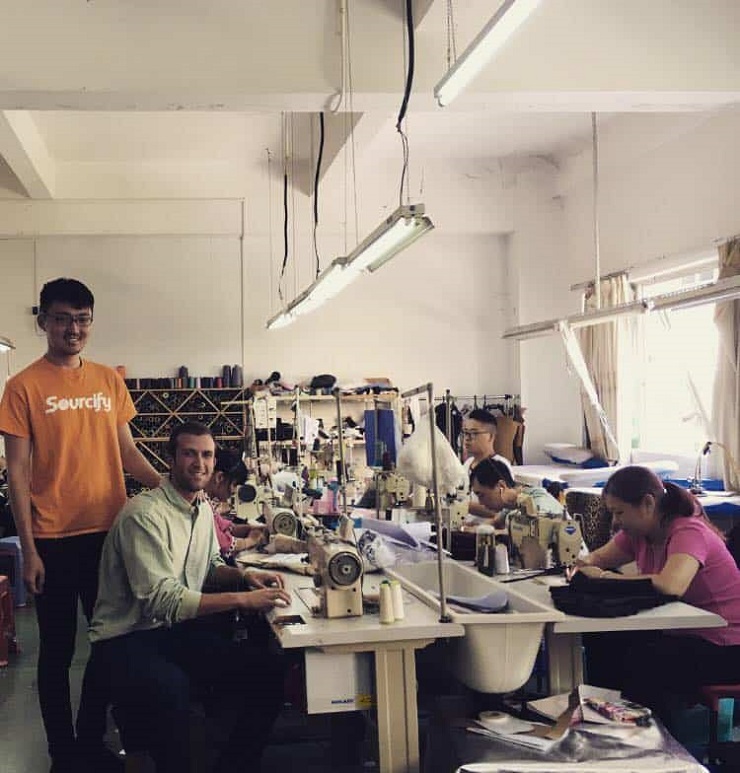
Source: Sourcify
It's crucial to understand the various types of manufacturing services and middlemen out there in order to find a method that works best for you.
Depending on the size of your company and how much you're looking to produce, you will first want to compare domestic versus overseas manufacturing. For almost every product, producing overseas will make more sense, as you need a lower production cost to have a higher margin to grow. Most of the companies that decide to produce domestically do so to align with their brand image. For the sake of brevity, we will cover overseas manufacturers only.
Below we'll cover three categories of manufacturing services: wholesalers, trading companies, and actual factories. While working directly with factories will likely be the most practical option for all startups, let's take a quick look at the alternatives:
Wholesalers
By purchasing products in mass quantity and often storing them in American warehouses, wholesalers can be very appealing to the untrained eye. While it seems convenient for North American companies to receive their products faster and save on shipping expenses, wholesalers make money off upcharging the products significantly. This also makes it hard to know where the product is being made.
Companies that have made the switch from buying from wholesalers to working directly with factories have saved up to 65% on manufacturing expenses. This stems from cutting out the middleman margin that wholesalers take, which adds up to an average of over 30%.
Trading Companies
A trading company has close relationships with multiple factories and produces across a variety of product categories. Most trading companies do not have their own factories.
Trading companies add a percentage to the initial product cost for buyers. As such, they also profit significantly from those who refrain from going straight to the source. While they can be a great resource for getting small orders done, trading companies can also have some negative tendencies.
It is not uncommon for trading companies to claim that they're manufacturers themselves, working out of their own factory. If you're ever suspicious about the credibility of your chosen trading company (or any foreign manufacturing source, for that matter) or are unsure if they have a factory, simply ask them to write your name and date on a piece of paper, and have them send a photo of the paper in the factory where your product would be produced. Though this trick isn't foolproof, it enables you to know that the trading company has access to those facilities that they are claiming to be their own.
Another common difficulty associated with trading companies is holding them liable in the event of a defective product. They tend to be flakey when issues arise, so don't be surprised when communication is lost at a critical moment for your business. Additionally, seeing that you are unsure of the factory they're associated with, contacting the manufacturer directly won't be easy.
Factories
Direct relationships with manufacturers should be every company's ultimate goal for the sake of your product and budget. While it's often difficult to achieve such relationships, there are many resources out there today that can help you pull this off.
My goal isn't to help you immediately find a manufacturer to make your product for some quick turnaround and cash in your pocket. Sure, that is a great perk, but the quality of your product speaks volumes for the credibility and longevity of your brand. Working with a manufacturer directly from the factory will open up so many creative doors, eliminate unwanted middlemen entirely, and ultimately enhance the quality of your product at an affordable cost.
A company's first instinct when attempting to find overseas sourcing is often to use a service like Alibaba. This is a fine tool for gaining English-speaking contacts in the manufacturing business and getting an idea of how much you'll be spending on your products. However, it's important to note that most companies on sites like Alibaba are trading companies—thus, likely not in your best long-term interest.
If you're looking to work with a factory, your first step will be to look at the name of the company. If it includes the terms "trading company" or "industry," chances are this company isn't an actual factory. The next trick is to see what product categories they produce. If they produce in multiple categories that don't stem from the same raw material, chances are they aren't a factory. As an example, a shoe factory won't also produce clothes.
Knowing how to tell if you're working with a factory is a tricky job, and even if you are, a factory may still subcontract certain products. If possible, visit the factory to determine its validity. That's the single best way to know what you are getting into.
Want to Learn How to Start & Grow a Profitable Online Store in 12 weeks? Sign Up for Our FREE Masterclass!
Questions to Ask Potential Manufacturers
We're all eager to cut straight to the chase when initially contacting potential manufacturers. However, do your best to avoid the blatant, "how much?" question upon first interaction, and truly get to know the quality and legitimacy of their service by asking the following:
- What companies have you worked with in the past? – The purpose of this question is to both strike up a natural conversation and gain additional information beyond their response. If they mention several brands you're familiar with or know on a personal level, reach out to them directly for a quick review. Don't be fooled by some fraudulent "name dropping" and go straight to the source for validation. Additionally, don't be turned off by companies you've never heard of. Do your research, as they could be the next big thing.
- Can my company review your business license? – While this might sound a bit intrusive for an introductory email, we assure that it is both legal and expected from foreign manufacturers. Depending on their location, you may need further assistance translating and ensuring its legitimacy, but it's a great way to determine credibility nonetheless. Once you've acquired this information, you can then search their work history via their online records.
- Do you have a minimum order quantity (MOQ)? – This is an essential question to determine your compatibility with this manufacturer from the start. If their minimum does not serve your business model and there's no room for negotiation, don't waste your time and move on. Keep in mind that minimums will vary significantly depending on product.
- What is your average turnaround time? – Although this will be difficult to answer without producing a prototype first, it's best for you and the manufacturer to get on the same page so you can start planning for the future. Time is always of the essence when talking business.
Keep in mind that there's always a possibility you're contacting a non-native English speaker who's using online translators to read your emails. With that in mind, keep your messages brief and simple.
It is also wise to number each question so they can reply easily with a yes/no or a simple numeral answer. Making their job easier will increase the chances of maintaining a positive relationship with your new manufacturer friend overseas.
After getting thorough responses to these essential questions, it is safe to move onto the more pressing financial issues:
- Do you charge for samples? – Note that this question isn't phrased, "How much do you charge for samples." Many manufacturers won't charge if you've proposed a large enough order for them to justify a freebee, or simply come across as a genuine buyer in the midst of needy and overwhelming clients. Always be concise and strategic with your wording to avoid being charged any additional fees. Also, factories will often refund sample costs once your order size hits a certain point.
- What is your standard production pricing? – It is in your best interest to ask the cost of a specific amount of products to gauge how the manufacturer discounts higher quantities. You can then negotiate pricing and discuss with your team about your projected sales and profit margins. This is also a great time to bring up packaging, and whether or not it's included in the cost.
- What are your terms of payment? – This question will determine how you and your company will budget moving forward. Most manufacturers will require 30% paid upfront and 70% once production is complete. All payments are typically complete before product is shipped. The more production runs you go through with a factory, the better payment terms you'll get.
Keeping Communication Open & Friendly

Source: Sourcify
I understand you may have some hesitation when starting to source overseas, as you weigh the potential risks in your head. Needless to say, you're putting a great amount of trust into a source you've never met to provide your company with the products you've been tirelessly working to develop. However, with the proper research, this could be the most financially sound decision your company will make.
That being said, we cannot stress enough the importance of keeping communications open with your manufacturer. Request notifications as soon as production begins as well as updates throughout the process. If possible, find additional contacts with a similar or higher position at the factory in the event that one contact is unresponsive. Weekly communication is mandatory, but strive for daily conversations if you're uncertain or curious about any aspect of your order.
Email will likely be used most frequently, but it's also important to use other methods of communication such as WhatsApp, Skype or WeChat to maintain conversation throughout the week. WeChat tends to be the most popular among Chinese manufacturers, as it's literally their go-to social media platform. WhatsApp has also recently been blocked in China. However, be mindful of the time differences when dealing with manufacturers overseas, as you'll inevitably have to be patient when awaiting a critical response.
Want to Learn How to Start & Grow a Profitable Online Store in 12 weeks? Sign Up for Our FREE Masterclass!
Let's Find Some Great Manufacturers and Start Production
The difficulty of finding manufacturers to represent your brand can make or break your business. I hear manufacturing horror stories everyday from intelligent, young entrepreneurs who've become utterly fed up with the process entirely. By providing your company with the information needed to rule out any fraud, "scammy" or unqualified manufacturers, I hope to help the next generation of groundbreaking companies prevail.
There are some entrepreneurs who take the short-term approach and start dropshipping, but this model isn't sustainable in my experience, and for every dropshipping entrepreneur you hear making it big, there are 10 others who haven't seen their online stores go anywhere.
Luckily for you, the digital age has provided so many great resources that can assist in this trying process of bringing a product to life. Never be too proud to reach out for assistance when dealing with overseas manufacturing, and keep your relationships strong through consistent, amicable conversation.
It's now your turn to ask some questions. After reading this article, what questions about manufacturing do you have? Please leave them in the comments below!
Want to learn how you can start a profitable online store? Check out our exclusive course on starting an online store and learn the skills and tips needed to turn a profit in just 12 weeks.
The post How to Find a Reliable Overseas Manufacturer to Bring Your Product Vision to Life appeared first on Foundr.
]]>The post How to Create a Business Plan (Step-by-Step Walk-Through With Examples) appeared first on Foundr.
]]>But if we're so concerned about success, why is it that so many of us place so much intense focus on our online business ideas , but ignore the tried-and-true business plan? Research has shown that having a business plan can boost your average annual growth by 30% and increase your chances of succeeding by 16%!

EXCLUSIVE FREE TRAINING: Successful Founders Teach You How to Start and Grow an Online Business
There's a lot of debate in the entrepreneurial world about whether business plans are valuable, and while we at Foundr are certainly all about execution, we're not about to argue with what the research clearly shows about the benefits of proper planning.
And before you think, "I'm just starting out—what good is a business plan for me?" I feel you.
When I started my business in 2013, I didn't have a plan, much less a formal business plan. And guess what? Three months into it, I ran out of money. I didn't know who my clients were or how to find them because I had never put much thought into it. I flip-flopped among several seemingly unrelated services (videography, photography, copywriting, and more).
Thankfully, I have since streamlined my services and am about to celebrate six years in business, but I think I could've avoided many mistakes if I had at least made a simple business plan for myself when I started.
To help you have the best chances of succeeding in your business, I'll walk you through the basic components of a business plan.
What Is a Business Plan and Why Do You Need One?
A business plan is a roadmap for where you want your business to go. It can be one page or multiple pages, but at its core, it answers:
- What is your business?
- Who does it serve?
- What does it sell?
- How will it make money?
- How will it stand out in the market?
- What are its plans for growth?
While it's not required when starting a business, having a business plan is helpful for a few reasons:
- It can help you get bank loans. Before approving you for a business loan, banks will want to see that your business is legitimate and able to repay the loan. This will usually require that you provide them with a business plan to review.
- It can help you win over investors. Similar to the banks above, investors want to know that they're making a promising investment when they lend you money.
- It can help you stay focused. Having a business plan that outlines your target audience, your mission, the services you offer, and more, can help you make sure you're staying focused on your overall goals for your business. For example, maybe you're a content marketing agency and you're toying with the idea of adding on branding as a service you provide. A quick glance at your business plan might remind you that that's not why you started this business. Your business plan can prevent you from wasting time and resources on something that isn't aligned with your business goals.
- It can help your business succeed. One study of more than 1,000 aspiring entrepreneurs over a six-year period found that those who created a formal business plan were 16% more likely to achieve viability than those who didn't plan.
As you can see, planning can pay off—especially if you're seeking funding.
Who Are You Writing Your Business Plan for?
Before you begin writing your business plan, consider your audience. A business plan will be written differently depending on who's going to end up reading it. Bankers, for instance, have different motivations than equity investors (venture capital fund managers and angel investors).
In this review of the literature, researchers found that bankers are most concerned about whether you can repay the loan; therefore, they're more likely to scrutinize the financial section, looking for good cash flow and the opportunity for taking collateral.
VCs and angel investors, on the other hand, are more interested in potential growth and return on investment; so they'll likely focus on your capabilities, the service you're offering or the product you're selling, and the market you want to enter.

If you're simply creating a business plan to help you stay focused on your business goals, then you're more likely to write about your plans for the future and milestones you want to reach, rather than any history or track record.
EXCLUSIVE FREE TRAINING: Successful Founders Teach You How to Start and Grow an Online Business
Basic Components of a Business Plan
Business plans vary depending on the business and its audience, but below are some of the basic components of a business plan that apply across the board.
Executive Summary
Begin with an executive summary that introduces the reader to your business and gives them an overview of what's inside the business plan.
Here's an excerpt from the U.S. Small Business Administration's example consulting business plan:
We Can Do It Consulting provides consultation services to small- and medium-sized companies. Our services include office management and business process re engineering to improve efficiency and reduce administrative costs.
Business Description
In this section, you can dive deeper into the elements of your business, including answering:
- What's your business structure? Sole proprietorship, LLC, corporation, etc.
- Where is it located?
- Who owns the business? Does it have employees?
- What problem does it solve, and how?
- What's your mission statement? Your mission statement succinctly describes why you are in business. To write a proper mission statement, brainstorm what your business' core values are and who you serve.
Here's an example of an ecommerce business' mission:
Liquid Culture's mission is to present consumers with designs, styling and clothes that energizes any outdoor activity. Whether it be snowboarding, running along the beach, or drifting down a river, Liquid Culture has comfortable, durable clothing that will look and feel wonderful.
Market Analysis
Before starting a business, you want to make sure you understand the market you're entering. Is your target market large enough that you can make enough money? Is the market already saturated with products and services like yours? How will you stand out? Investors will be interested in seeing what you put here because this will help them become confident that you know what you're getting into and that your business has the potential to grow.
The market analysis section will answer:
- Who are your competitors? Do your research and find out who your competitors are. This is important, because it will help you understand your market and know how you'll differentiate your business from similar ones out there.
- What's your unique value proposition? Your unique value proposition (UVP) is the thing that makes you stand out from your competitors. This is your key to success. If you don't have a UVP, you don't have a way to take on competitors who are already in this space. Here's an example of an ecommerce internet business plan outlining their competitive edge:
FireStarters' competitive advantage is offering product lines that make a statement but won't leave you broke. The major brands are expensive and not distinctive enough to satisfy the changing taste of our target customers. FireStarters offers products that are just ahead of the curve and so affordable that our customers will return to the website often to check out what's new.
- Who's your target audience? This describes the people you serve and sell your product to. Be careful not to go too broad here, thus falling into the common entrepreneurial trap of trying to sell to everyone and thereby not differentiating yourself enough to survive the competition. Below is an excerpt of a market analysis section from this sample consulting business plan. Notice how detailed it gets, including specifying the target customer's business worth and growth rate.
The target customer owns a small business, and is generally dissatisfied with the revenue that the business is generating, or is dissatisfied with the daily management of their business. The customer is likely to operate a business worth between $200K and $10 million, with growth rates of between 1-10%, or even a negative growth rate.
Products and Services
Writing this section is pretty straightforward, detailing exactly what you'll be selling.
- What services will you sell? Describe the services you provide and how these will help your target audience.
- What products will you sell? Describe your products (and types if applicable) and how they will solve a need for your target and provide value.
- How much will you charge for your products and services? If you're selling services, will you charge hourly, per project, retainer, or a mixture of all of these? If you're selling products, what are the price ranges?
Marketing
In this section, you'll outline your marketing strategy to ensure you have a plan to get clients and customers and make money.
- How will you get new clients and customers? Will it involve social media, blogging, cold calling, email marketing, paid advertising, referrals? Here's an excerpt from a custom printed T-shirt business plan sample, in which the company has identified advertising as part of its marketing and sales strategy:
Your T-Shirt! will run ads in several teen/young adult magazines whose readership demographics are similar to Your T-Shirt!'s.
- How will you retain clients and customers? Do you have a plan for increasing your customer loyalty to keep them coming back to you?
- What's your marketing budget?
Financial
This section is particularly important if you wish to secure a bank loan or investors' money. If you've been in business for a while, you can include past revenue. If you're brand new, you'll have to forecast your revenue.
The financial section can include many types of forecasting and graphs, but a few common ones are:
- Profit & Loss (P&L) statement – This details your income and expenses over a given period.
- Expenses – List the expenses you expect your business to incur.
- Cash flow statement – Similar to the P&L, but this one will show all cash that flows into and out of the business each month.
Business Plan Templates and Examples
To better understand what you need to put into each component of your business plan, it can help to look at examples. Here are some free resources that can help:
- PandaDoc has some free business plan templates that include descriptions of what to put in each section.
- The U.S Small Business Administration has example business plans that you can look at for inspiration. There's even an online tool to help you build your business plan.
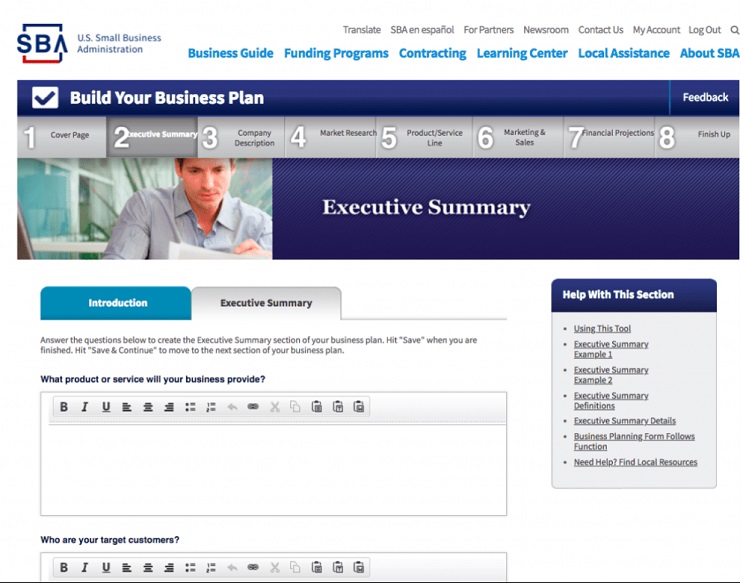
- Bplans has a library of more than 500 sample business plans for almost every industry.
Final Thoughts on Creating a Business Plan
- Don't let creating a business plan hold you back from actually starting your business. If you find you're getting stuck on perfecting your document, opt for a simple one-page business plan—and then get to work.
- Remember, business plans are not a requirement for starting a business. They're only truly essential if a bank or investor is asking to see one.
- Ask people to review your business plan. It can be helpful to have an extra set of eyes on your business plan to make sure it's in the best shape possible. Be sure to ask someone who knows your business, such as a mentor or business partner.
- Businesses change—business plans can too! While, yes, a business plan should guide you as you grow your business, it should not restrict you or dictate your every move. For example, you may find that your mission has changed; in that case, you can and should modify your business plan to reflect that.
EXCLUSIVE FREE TRAINING: Successful Founders Teach You How to Start and Grow an Online Business
Ready to Write Your Business Plan?
By now, I hope you're ready to blast through creating your business plan so you can move on to the fun part: building your business.
To recap, here are the basic components of a business plan:
- Executive summary
- Business description
- Market analysis
- Services
- Marketing
- Financial
Remember, the purpose of a business plan is to secure funding or serve as a guide for you (or both). Don't get stuck on this step. You can always revisit and revise your business plan later. What's most important is that you take action now.
Have you created a business plan? Share any advice you have for your fellow entrepreneurs in the comments below!
The post How to Create a Business Plan (Step-by-Step Walk-Through With Examples) appeared first on Foundr.
]]>The post This Underused Tactic Can Help You Become a Thought Leader (Even If Nobody Knows Who You Are) appeared first on Foundr.
]]>The good news is, it's definitely not too late to establish authority in your niche, and you can get started immediately, even if nobody knows who you are yet. Sure, certain industries might seem saturated, but there's still room at the top!
The challenge is that, yes, content channels like social media, email marketing, and webinarsare all effective ways to get your name out there and convert customers. But precisely because they work, everyone is using them—both the expert with four or five decades of experience, and the total newbie who read one article on Tim Ferriss's blog.
For better or worse, our level digital playing field means expertise does not always win out over hype. Yes, you may know what you're talking about, but upstart competitors with less experience use all the same outreach tactics. How can customers tell the difference—who is the true authority here?
There's one long-term, authority-building strategy, in particular, that can send your credibility and perceived expertise flying out of the park. Wondering what this strategy could possibly be? Simple. You've probably got some near your desk.
Books.
By writing a book that speaks directly to your audience, nailing the intersection of what you know and what they want to know, you can catapult yourself to thought-leader status. I'll show you exactly how to come up with that perfect idea, and how to decide exactly what to cover in your future, authority-building book.
W ant feedback on YOUR authority-building book idea? Comment below, pitch your book idea, and I'll reply and let you know how to "spin" your idea for maximum reach—and book sales.
Table of Contents
Author(ity): How Books Can Position You as a Thought Leader
Step 1: Mind Mapping
Step 2: The Jay Abraham School of Customer Research
Step 3: Process of Elimination (and Inclusion)
BONUS: Get Feedback From Me!

Source
Author(ity): How Books Can Position You as a Thought Leader
My bookshelf holds books that were published 10, 25, 50-plus years ago. I even keep several books in my workspace to reference regularly as needed. You probably do, too. How many times a day do you glance at certain authors' names and book titles? Talk about top-of-mind awareness!
A book has the longest shelf life of all authority-building strategies—pun intended. Nothing else even comes close.
But what about a book's effectivenesscompared to email marketing, webinars, and social media? Whether your readers buy your book or get a free copy as a lead magnet, your book is the one and only place where you display your best lessons, tactics, techniques, tips, and strategies that you've collected over your career.
Short-form content like email newsletters and social media posts don't give you near that much room to deliver quality information. A book is also the one and only place you can self-promote without coming across as self-absorbed. Do that on a webinar, and you'll quickly become the only attendee.
In short, writing a book is the one of the best ways to demonstrate your authority and become a thought leader. You get to say, "I wrote the book on my industry." What is an industry expert if not the person who says that to media-booking producers, conference organizers, and high-ticket prospects?
A book's impact on your authority isn't hypothetical; it's tangible and measurable. For example, in the past couple of years, some of my author clients have:
- Used a book to build a $1,000,000 funnel
- Converted so many readers into consulting clients they needed a waiting list
- Exceeded book sales goals by 200% thanks to top podcast appearances
- Averaged 10,000 copies sold per month
- Achieved a 70X return on their investment
At this point, you're probably thinking, Okay, you've sold me on this authority-building book thing, Joshua. But how am I supposed to write a book?
Great question! Many an aspiring "authorpreneur" I meet believes that all they have to do is copy and paste a few blog posts into Word, buy a Fiverr gig to reformat the manuscript, and slap that sucker onto Amazon.
I get it—the self-publishing bar is set low. Many would-be authors believe a marketable book idea just comes naturally. This might explain why most self-published books sell fewer than a hundred copies! (Ouch…)
Your book builds authority and helps you become a thought leader only when the masses readit. So how do you make that happen?
Think of the business books you like—no, love. You keep coming back to them over and over. You've worn them ragged from flipping back to "highlight" chapters. You've turned excerpts into quotes to live by.
Got a book like that in mind? Great!
The reason that book captivated you, and still does to this day, is the author's intention: They wrote that book for you. Not for them. For you. Spot the difference?
This brings me to another mistake I see entrepreneurs and founders make when writing books. They try to stuff everylesson, tactic, technique, tip, and strategy into one manuscript. The result? Readers quit on you five pages in, fling the book across the room behind a pile of smelly gym socks, or (worst-case scenario) bemoan your ideas with a novella-length one-star review. We don't want that.
The books we cherish deliver content at the intersection of what the author could have written about and what people wanted to read. That kind of book permanently establishes your industry credibility and opens new doors of influence. It's no ego-driven fluff piece; it's a thought leadership masterpiece that converts skeptics into evangelists, readers into customers.
Well, that sounds great, Joshua, but how do I know what to write about? What do people in my industry want to read?
I'm glad you asked! Let me offer three steps to generate your authority-building book idea.
Get 70+ proven shortcuts for growth hacking any business. It's all in our new course, Growth Hacking Playbook . Click below to learn more and join our VIP waitlist to be notified when the course opens for enrollment.
Get 70+ Proven Shortcuts for Growth Hacking any Business! Click To Join Our FREE VIP Waitlist Now.
3 Steps to Come up with an Authority-Building Book Idea
Step 1: Mind Mapping
First, list everything you could write about. Imagine you have as many pages as you could ever need—no word count minimum, no maximum. You can even pen a series of books if you like.
Not a fan of endless lists without rhyme or reason? Me neither. That's why I recommend software like MindMeisterto chart every topic, subtopic, example, and takeaway you could include in your book.
Let's say you're a digital marketing expert, like many of my clients. In MindMeister, you'd write your industry expertise in the first circle (digital marketing). From there, build "spokes" out of your "wheel hub." These are the categories of digital marketing, such as social media marketing, search engine optimization, content marketing, and email marketing.
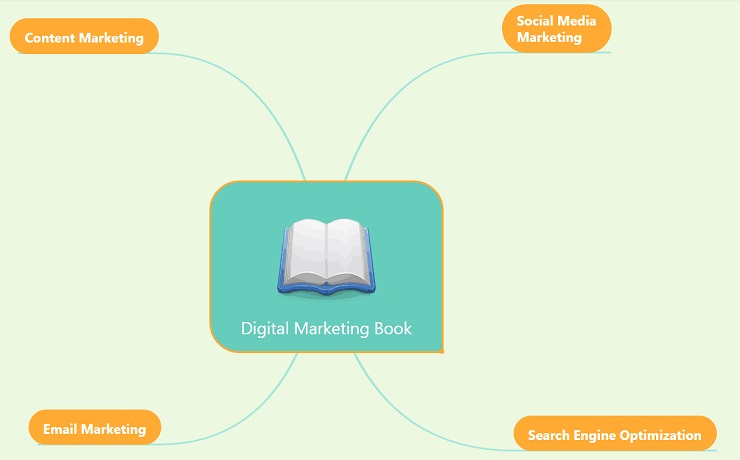
Each subtopic now becomes its own hub with more ideas branching out. As a social media marketer, you're a master Facebook advertiser, Instagram influencer marketing strategist, and LinkedIn lead generator.
On Facebook alone, you could write about campaign objectives like awareness, traffic, and conversion; targeting strategies for both custom and lookalike audiences; and ad copywriting to drive engagement, clickthroughs, and landing-page conversion. Each becomes a new spoke.
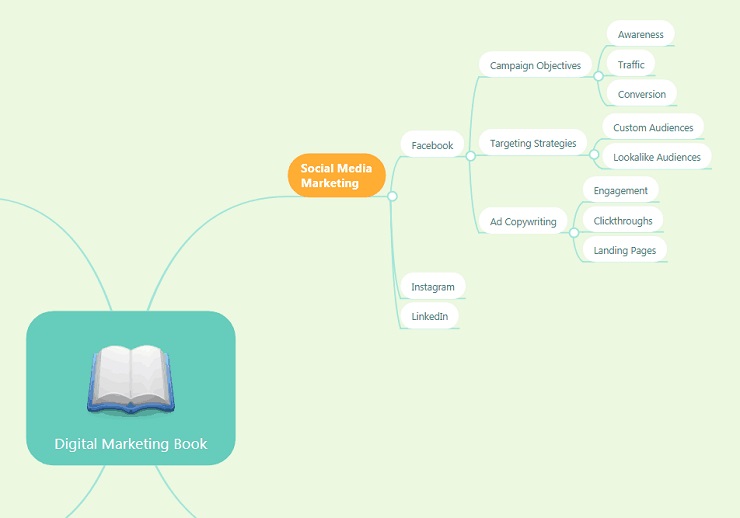
To demonstrate your copywriting expertise, you could offer three examples of digital marketing clients who, using your copy tips, achieved unparalleled ad engagement. Just like that, your copywriting spoke has become yet another hub!
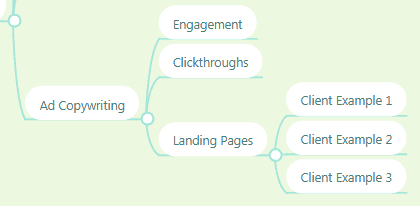
The shape your MindMeister map forms is called a fractal, a geometric figure in which similar patterns recur at progressively smaller scales. If you've ever seen a snowflake up close, you've seen an example of a fractal.
Source
Fractals are naturally occurring structures, which makes it a natural way to organize your complex thoughts into a collection of book ideas. My mind map strategy also lends itself well to a book outline, where you list topics and explore subtopics, examples, and key takeaways.
By the time you've recorded every morsel of expertise in your MindMeister map, you're going to feel overwhelmed. How could I possibly turn all of THIS into a book?! This thing would run a thousand pages, easy.
That's just it—you're notgoing to turn your mind map into a book outline! At least not yet. Keep your mind map handy for the second step of this process.
Savvy marketers promote products they know people already want. That's not something you're going to leave to chance. Right now, your future readers are already reading other books in your category of choice. So let's go find them and see what they have to say about books like yours!
Step 2: The Jay Abraham School of Customer Research
Let's narrow down exactly who your book is for, while also making sure you reach the broadest, most profitable audience possible—a task made easy by a classic Jay Abraham customer research tip. ( Forbescalls Jay "one of the top five executive coaches in the US.")
For our digital marketing expert example, we'll Google, "amazon bestselling marketing books". The first result sends you to Amazon's marketing bestseller list. Change up this keyword based on your industry. For example, I'm ghostwriting a network marketing book right now for a network marketing multi-millionaire. The keyword we used was "amazon bestselling home based business books".
(For the complete Amazon bestseller categories list, click here, scroll down to "Categories with keyword requirements," and click "Amazon.com.")

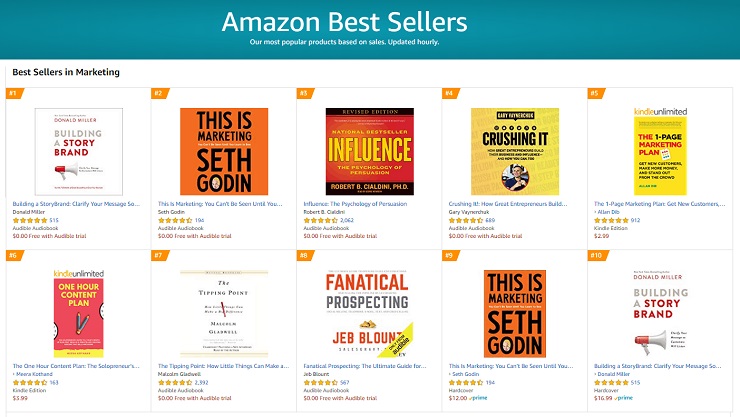
Once you've arrived at your category's bestseller list, take Jay's advice—open a few of the books in new tabs and click customer reviews, an on-page link that appears below the book title. Check the example below.
If you're in a pinch, just check out the top four bestsellers you'll be competing against. Why only four? When you write an industry standard book proposal to get a traditional book publishing deal, acquisition editors want to see how your book idea stacks up against four perennial bestselling titles. Yes, only four!

A ghostwriting client in the reputation management industry once told me that five-star and one-star reviews are the least credible reviews. Research published in Entrepreneurand The New York Times backs him up—people view the digital wall of five-star reviews as too good to be true, while they suspect those trollish one-star ratings are fakes. But those middle-of-the-road four-, three-, and two-star reviews tend to be more thoughtful and fair—so we assume. (That's not to say you should disregard all five-star and one-star reviews. Consider this a shortcut for those of us who don't have time to read all 5,200-plus reviews of The 4-Hour Workweek!)
Step 3: Process of Elimination (and Inclusion)
Now that you've found your future readers' feedback on books like the one you plan to write, it's time to do something with that feedback. Through a process of elimination and inclusion, let your future book buyers decide what goes into your book—and what doesn't. Dig in, start reading, and see what it is your future readers like, dislike, want, and don't want in the book you're going to write for them. Scour those reviews for two types of comments:
- "Hoped they would've's"
- "Wish they hadn't's"
Back to our hypothetical digital marketing book idea. We've clicked on a bestseller, 500 Social Media Marketing Tips, and we've spotted these curious little neutral reviews:



Did you catch that? The reviewer hoped the book would provide Facebook advertising templates, which the author didn't. Another reviewer wished the author had offered more real-life client examples.
Copy and paste these reviewers' feedback into Word along with relevant excerpts from the remaining reviews. And yes, you want the exact words the reviewer used. The words a customer uses means more to them than anything a direct response copywriter could brainstorm.
Once we've gathered precious customer research nuggets, let's polish them—the joint elimination-inclusion process begins!
Remember the 500 Social Media Marketing Tips reviewer who wanted more real-life examples? That reviewer purchased the book assuming these examples would show up given the book's premise, hence the disappointment.
We take a peek at our mind map and confirm, sure enough, client examples make an appearance. Awesome!
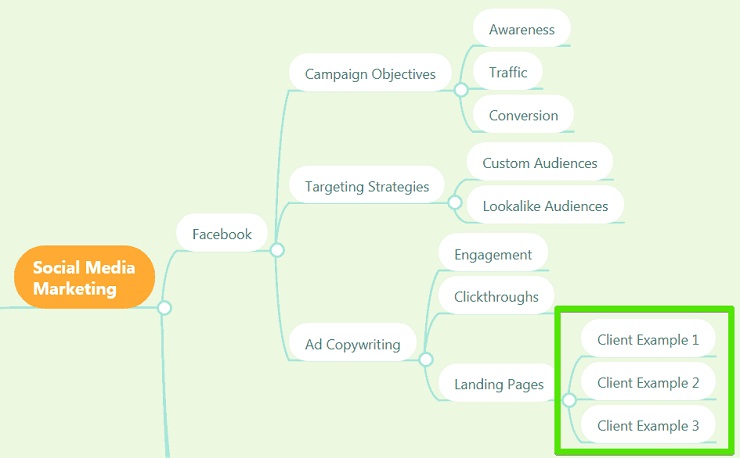
Next come the text-heavy chapters complaint. That reviewer wished the author would've replaced long-winded explanations with exciting visuals and illustrations.
We go back to our MindMeister map. Hmmm…
On second thought, our book outline covers quite a bit of ground—ground which requires text-based explanation. For example, Ad Copywriting would have you writing about ad copy that inspires engagement, copy that gets clicks, and copy that drives on page conversion. That's a recipe for a lot of content without much practical application.
If we listen to the customer (and we have every reason to), we have little choice but to cut those different copywriting purposes from the mind map. Giving customers what they want means giving them their time back—time you otherwise would've made them waste reading about sections in your book they never wanted. So our updated Ad Copywriting hub teams examples up with screenshots. Gone are Engagement, Clickthroughs, and Landing Pages.
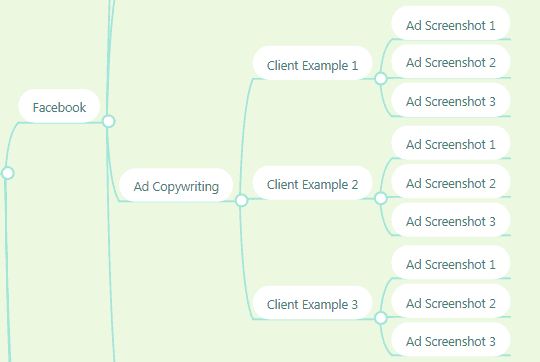
What about the ad template the other 500 Social Media Marketing Tips reviewer expected? We review our mind map and realize templates are not here—yet. Even a digital marketing newbie understands the essentials of a Facebook ad. Maybe you've even created an ad template for a client, which they used to achieve enviable results, results your future readers want to hear about! Thus, a new spoke from the main hub appears—Ad Templates.
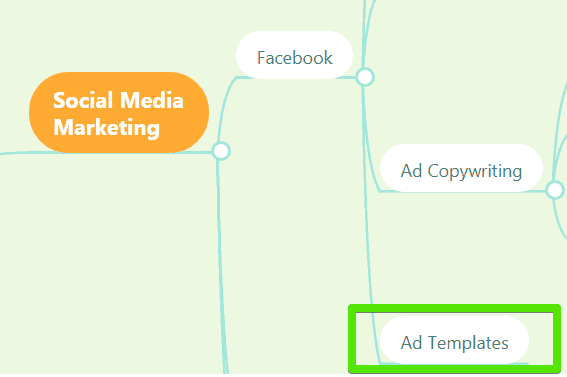
And there we have it! An authority-building book outline that people will want to read! Follow these three steps, and the resulting mind map is somewhat like the Venn diagram below. You've determined the overlap betweenyour book ideas and your buyers' desires. That overlap becomes the outline for your book.
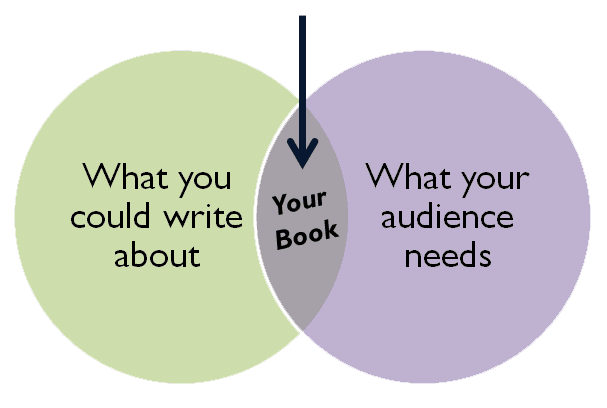
To come up with a title for your book, check out my Book Title Generator, which helps you come up with potential titles that align your expertise with your future readers' interests. Thirty seconds from now, you'll have a book idea that can permanently establish your credibility in the industry AND open new doors of influence for your business!
So before you put your blood, sweat, and tears into writing a book that may sell a mere few dozen copies, open MindMeister, journey onto Amazon, and get busy. I bet you'll sell way more than a hundred copies. And in the process, you'll build your authority in your industry and become known as the only author providing fresh ideas that your readers—and customers—are willing to buy.
Get 70+ proven shortcuts for growth hacking any business. It's all in our new course, Growth Hacking Playbook . Click below to learn more and join our VIP waitlist to be notified when the course opens for enrollment.
Get 70+ Proven Shortcuts for Growth Hacking any Business! Click To Join Our FREE VIP Waitlist Now.
BONUS: Get Feedback From Me!
Want feedback on YOUR authority-building book idea? Comment below and pitch your book idea. I'll reply and let you know (a) what works, (b) what doesn't work, and (c) what new spin you can give your idea to reach the maximum number of readers—and customers!
Feedback limited to the first 20 comments.
The post This Underused Tactic Can Help You Become a Thought Leader (Even If Nobody Knows Who You Are) appeared first on Foundr.
]]>The post I Have No Idea What I'm Doing: Remembering Your Purpose and Taking Control as a New Entrepreneur appeared first on Foundr.
]]>Now what?
I'm a New Entrepreneur But I Have No Idea What I'm Doing
1. Remember Your Purpose
2. Ask for Help
3. Don't Burn Stages
4. Focus on One Thing
5. Relax
Sure, having your own business is great, but it's easy to feel overwhelmed by all the tasks you've got to do, most of which you've never done before. You had never realized how hard it is to hire people, manage employees, market a business, compete with other businesses with more resources and experience, and face negative customer feedback, among other uncomfortable situations.
In short, you just don't know what to do, where to go, or who to call.
It calls to mind that old saying, "Be careful with what you wish for, because it might come true."
If all you ever wanted is to start your business and now you feel like a total impostor, then worry not, because that's a very common problem among first-time entrepreneurs. We all say, "I have no idea what I'm doing." And that's OK!
Today you'll learn five ways to take back the reins of your business, find your focus and purpose, and continue with the same excitement you had when you started. From there, you can evolve as an entrepreneur and keep crushing it.
Let's jump right into it.
1. Remember Your Purpose
You wake up, you go to your coworking space, you open the computer, and you start working.
You pick up the phone and speak to a supplier, you answer customer emails, you negotiate with a business partner, and you discuss new ideas with your employees.
The day ends before you know it, and the next day, you're back to square one.
You may not want to admit it, but if you think about it, you're running in your very own rat race. Instead of working for a corporate executive, you work for your employees, your customers, and your investors (if you have any).
Worse yet, you're working your ass off without the assurance of a healthy paycheck at the end of the month, while in the process you sacrifice your health, your time, your family, and much more.
What's the point of making this many sacrifices for a reward that's so stressful?
One simple reason: You want to make a dent in the world. To change it, improve it, and leave it a little bit better than when you were born in it.
The stress of running your business, however, will often make you lose sight of the reason why you started it in the first place. When everything you're fighting for gets too hard, remember your purpose.
Your purpose is what's behind everything you do, whether you're aware of this or not.
Regardless of your current situation, the clearer your purpose is, the easier all the insurmountable personal and business challenges you face will be.
Simon Sinek explains this at length in his bestselling book Start with Why :
Knowing your WHY is not the only way to be successful, but it is the only way to maintain a lasting success and have a greater blend of innovation and flexibility. When a WHY goes fuzzy, it becomes much more difficult to maintain the growth, loyalty and inspiration that helped drive the original success.
You need to remember your "why"—your purpose—to keep your business alive and thriving. As Sinek explains in his book, there are three levels behind your purpose:

- First, you start with the why, the purpose, the reason
- Then, you have the how, the way you do things, the manifestation of your purpose
- Finally, you have the what, the specific actions you take to reach your why
Before you can know what to do and how to do it—the products you sell, the type of service you offer, etc.—you need to have your why shining within your mind every day. If you feel lost in your business, there's a high likelihood you've forgotten your purpose. Take time to remember it.
Did you ever write a document explaining what you wanted to achieve before you started your business? Do you have a video where you are pitching your business idea? Can you ask people you know what you told them back then, before you started your business?
Ignite your original purpose, the raw energy behind all successful entrepreneurs, and you'll be able to sustain any challenge you face.
Need business help? A trusted mentor can help.
Click To Get Instant Access To Our Free Ebook, the "Ultimate Step-By-Step Guide On How To Find A Mentor"
2. Ask for Help
Sometimes the best solution is the easiest one.
If you are feeling overwhelmed by all the challenges you face, ask for help.
There's no need to be afraid of asking someone more experienced than you, a business mentor, if you will, to help you figure out the best way to solve a problem. If you ask nicely enough, they'll help you.
That's exactly what Alex Turnbull, founder and CEO of GrooveHQ, thinks:
Independent if you are on your way to success or failure, you will encounter challenges. The good news is — you are not alone. There are many other entrepreneurs who know exactly what it's like to feel lost. Find them, invest time in building relationships with them, and don't be afraid to ask for help.
One of the most valuable lessons I have learned is that "you don't get what you don't ask for".
Whether you have no idea how to approach a specific business problem, you are trying to bring a change to your company or you are looking for an investor, make big asks of the people who can help you.
You'll be surprised by how many people say yes.
To get started with asking for help, first define the problem. Having a crystal-clear idea of your problem will make everything much easier down the line. Make your problem concise and specific.
Then, look at your current network, whether in LinkedIn, Facebook, or your old-fashioned phone contacts (the famous "Rolodex") to check for people who are more experienced than you when it comes to the problem at hand.
Continue this process by reaching out and asking for help. That could be an email, a phone call, or a coffee meetup. Since you want to go beyond the problem you're facing and build a relationship with the individual you're asking for help, maybe even becoming a mentee, you'll want to try for a personal meeting. As Turnbull says:
Networking and, as a result, having people I could turn to for guidance has saved me more times than I can count. And even in the good times, those relationships have led to incredible opportunities.
- A relationship with another founder led to one of our key product partnerships
- A relationship with a mentor led to the introduction that launched our popular interview series
- A relationship with a smart advisor helped us commit 100% to being a remote team and stop dwelling on it after weeks of waffling back and forth and losing productivity
Building relationships is a long-term effort, but it's the one that I would recommend to any entrepreneur.
When reaching out, you can use the following template:
Hey ,
It's been a while since the last time we spoke.
I'm reaching out because right now I'm currently .
Because you have , I was wondering, would you want to have some coffee to discuss ?
If you're interested, would work for you? If not, I'm available .
Cheers,
After you've received help from your advisor, follow up a few days later to inform them of your progress. This will help create a deeper connection, showing you've taken their advice seriously.
At the end of the day, you get what you ask for. If you ask for help, you will get it. And with that help, you can break through your problem and continue making progress towards your goals.
3. Don't Burn Stages
When you're just getting started, you want to grow as fast as possible. This is particularly true if you've landed venture capital funding (or any type of funding). You've got the money, so now it's time to put it to good use.
You hire new people, invest heavily in advertising, and move to a bigger office, all with the hopes of making it big, fast.
After a while, however, you realize you are moving too fast, and much like Facebook, breaking too many things at once. Your business is spending money, but the investment doesn't translate into real growth. You don't know what's going on; your investment should be paying off by now, and so far, that's not the case.
The problem is that your new employees aren't boosting your profit margins. Your advertising, your account manager tells you, is helping boost your "brand awareness" (as if that's what you really care about) but not your profit margins. Your office is beautiful, full of perks your employees love, but it's burning your funds faster than you expected.
It seems counterintuitive, but if you grow too fast without making deep changes in your business model, you will hit a wall that will eventually break your business.
According to David Skok, author of forEntrepreneurs, serial entrepreneur, and currently a partner at Matrix Partners, this is the "greatest mistake founders make:"
Startup founders try to force progress by jumping ahead of the stage that they are currently in. That will ramp up their burn rate, while not making the business go any faster, and they will have to return back and complete the phase that they tried to skip.
By "going any faster," he refers to the deep changes I mentioned previously. There are countless startups that grow as fast as possible with the hopes of profiting once they secure a majority piece of a large, profitable industry. Unfortunately, more often than not, such bets don't pay off.
Whether it's the better-funded competition, the lack of a well-defined value proposition, or the unexpected mediocre profits, these startups can't make up for their initial burn rate with the profits they had expected.
Over and over, we see these kinds of "overgrowth" examples in the startup world. On the one hand, you've got the extreme cases of Theranosand the dot-com bubble startups such as Pets.com and Webvan that grew to massive market valuations even though they had nothing to show for it.
On the other, you've got the common case of companies that simply churn through too much money and get nowhere. Check out the list of 1,280 businesses that went through the famous Y Combinator accelerator since its inception, and among the wildly successful startups like Airbnb, Dropbox, and Instacart—all of which are worth over $100 billion—you will also find 158 companies that have closed their doors due to their inability to translate the early investments into real profit.
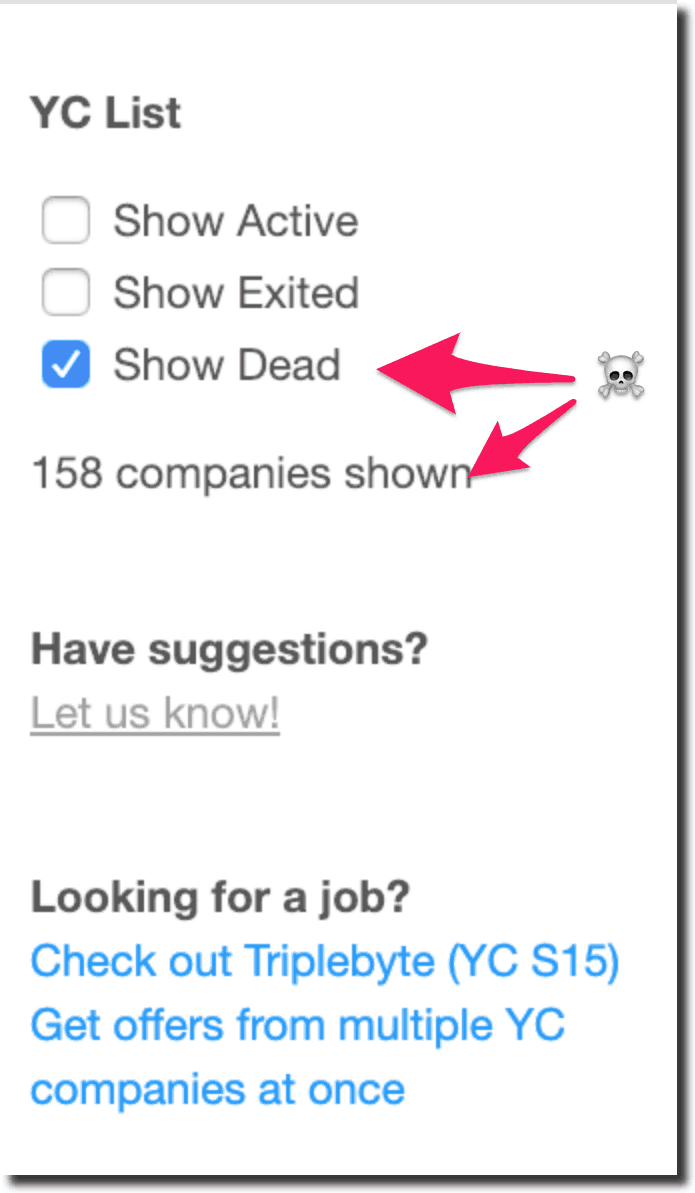
Even though "a startup is a company designed to grow fast," as Paul Graham puts it, you want to make sure your investment (both money and time) translates into actual growth and not just vanity metrics.
Clarity of action comes from clarity of thought. Focus on the key metrics around your business, like:
- Cost of acquisition
- Revenue per user
- Total profit generated
- Lifetime value
These metrics are more precise and business-focused than metrics like the number of users acquired, sales generated, and employees hired.
Also, develop SMART goals. That is, goals that are:
- Specific
- Measurable
- Achievable (or Attainable)
- Relevant
- Time-bound
For example, instead of saying you want to "improve our revenue generated by mid-July," you'd say, "improve our revenue 20% by 1st July 2019."
 Source
Source
The key metric used, the percentage, and the date combined make it "smart."
Finally, make sure to keep an eye on your burn rate, as David Skok indicated above. If you're going to spend money, either guarantee you'll make more money than what you invest or that you know how to recoup it. It's easy to get bogged down developing "awareness" and increasing "reach," while overlooking the profit your investments are delivering.
Focus on the metrics that matter most, be specific with your goals, and check your burn rate, and you will never feel confused again.
4. Focus on One Thing
When you just start your business, you have to do everything yourself.
You've got to do the marketing. You've got to hire new people. You've got to do some of the accounting and customer/supplier management.
Focus? Forget it.
That's an unsustainable situation, but one that you have to take when you're getting started.
Once you start growing, however, you've got to focus your energies on the one big thing that drives your growth. You can't continue doing everything—you'll burn out.
According to John Lee Dumas, author of Entrepreneur on Fire :
What has always helped me in these situations is FOCUS: Following ONE course until success. Your ONE thing is your current MAJOR focus for your business, and throughout the span of your business you'll have many of them.
That "one big thing" can be anything, whatever it is that helps your business grow. Usually, it's the most obvious thing.
For example, if your business has many loyal customers, the one thing that's driving your growth is your word-of-mouth, the customer experience, or the branding. One of those things would be the one you should focus on.
To help you find that "one thing," Jerry Keller, author of the appropriately titled book " The ONE Thing ," recommends you to ask the focusing question. "What's the ONE thing I can do such that by doing it everything else will be easier and unnecessary?"
Once you find that one thing, it will have a "domino effect" on your long-term progress. As Keller says, "success doesn't happen all at once; sequential." This is similar to what the Chinese philosopher Laozi said: "A journey of a thousand miles begins with a single step."
Don't get lost in the monumental goals you've defined for yourself and your business. Focus instead on the few tasks that propel you forward, however small they may be. If customer service is what truly matters for your business, then every chat, email, or phone conversation you have with a customer will be the most important thing you can do. Each one individually won't have a big impact in your future growth, but all of them together will.
5. Relax
Experienced entrepreneurs often say "you can't learn entrepreneurship." A college degree won't be of much use for the unprecedented situations you'll face on a daily basis. You simply need to be ready to take on whatever life throws your way and adapt.
Within the startup community, this is called the "emotional rollercoaster." One day you're at the top of the world; the next one you're about to go bankrupt.
How on earth can you live with so many uncertainties? The freedom of being your own boss isn't of much use when you don't know if your business will survive to see the next day.
No wonder entrepreneurs are stressed out. According to the Gallup Wellbeing Index, 45% of entrepreneurs report being stressed and 34% report being more likely to have "worried a lot."
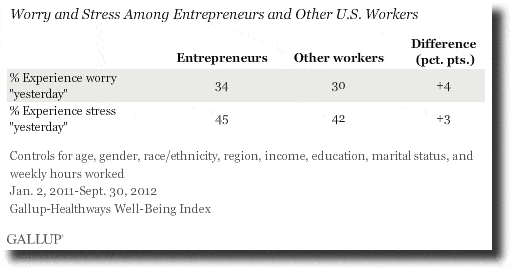
Before you go bonkers with all the pressure you've got in your shoulders, you need to learn to relax. After all, you're the owner of the business, you technically only have to be as stressed as you want to be.
According to Rand Fishkin, founder of Moz and SparkToro, and author of Lost and Founder , this is exactly the attitude entrepreneurs should have on a daily basis:
While the journey can feel daunting, it's often surprising how much of that you get to control. *You* get to set the schedule, get to choose where and how to invest your time, get to choose what parts of your business to pay someone else to handle (finances or customer research or support or admin work or… if you choose… do all those things yourself because you have passion for them and are good at figuring stuff out).
Granted, getting off the ground and making enough money to support yourself and your business' costs can be a challenge, but there are so many inexpensive ways to support a new startup that now is a wonderful time to take the plunge.
Realize you won't end up sleeping in the streets if you fail and make mistakes. Sure, you may suffer, but it's not as bad as you make it seem in your head.
One way you can face those inner demons that are making you doubt yourself is to meditate. Meditation has been proven many times over to reduce stress, help with anxiety issues, improve attention span, and much more.
You don't need to go to a Buddhist temple or download five different meditation apps (although they can be helpful). Start by sitting down for five minutes and focusing on your breathing. Inhale and exhale, and pay attention to your body as you do so. When you feel your mind wander, simply take note of it and bring the focus back to the breath. It takes some practice, but that's all you only need to get started.
Another way to relax is to take breaks from your computer, both throughout the day and every few weeks. In the former case, set a limit to how much you use it. Stop working at, let's say, 8 p.m. every day, and avoid the computer until the following day at 8 a.m. Your eyes and mind will thank you for it.
In the latter case, you'll need to take a few days off from your business. Take a weekend off and avoid focusing on your business at all. Leave the problem solving to your subconscious, which will continue to work on them while you relax.
Remember that if you fail, nothing will change. Life will continue. You will be OK.
Adapt to whatever comes your way. Learn to cope with challenges. It's like Bruce Lee said, "Be like water, my friend."

Relax, enjoy your business, your challenges, and your failures. One day you will look back and laugh about this.
Need business help? A trusted mentor can help.
Click To Get Instant Access To Our Free Ebook, the "Ultimate Step-By-Step Guide On How To Find A Mentor"
Don't Know What You're Doing? It's OK.
When you found this article, you were likely confused, lost, and a bit sad. You didn't know what to do. You felt like you were an impostor, a lucky bastard who got it easy.
You're not. If you've started a business, and especially if it's at all profitable, you're way beyond most people, even if it makes just a few thousand dollars a month.
Now that you've finished this article, you're much more prepared to go back to your business with renewed energy.
What's the main reason you're feeling lost? What business challenges are overwhelming you? Please, share your comments below; I'd love to see what you're going through and how we can help you!
The post I Have No Idea What I'm Doing: Remembering Your Purpose and Taking Control as a New Entrepreneur appeared first on Foundr.
]]>Drawing On The Conflict Perspective, Sociologist Howard Waitzkin Suggests That ________.
Source: https://foundr.com/articles/leadership/feed
Posted by: boothereastill.blogspot.com





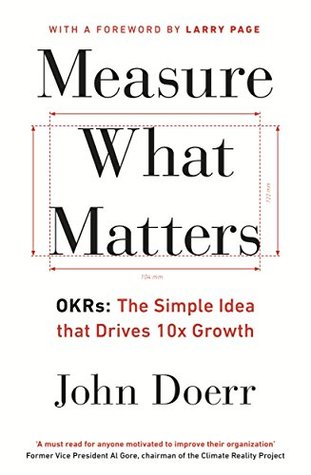
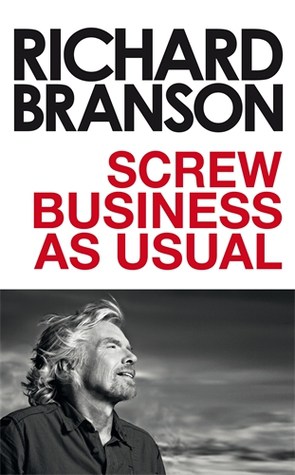
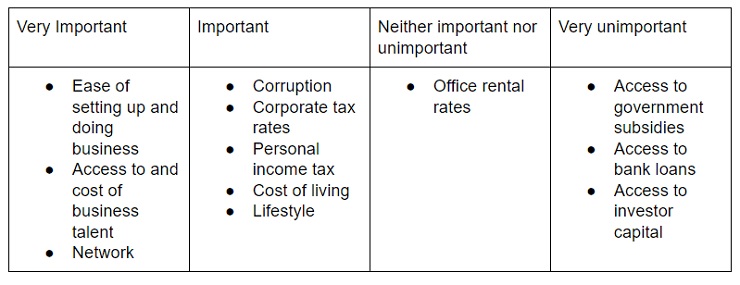
0 Response to "Drawing On The Conflict Perspective, Sociologist Howard Waitzkin Suggests That ________."
Post a Comment